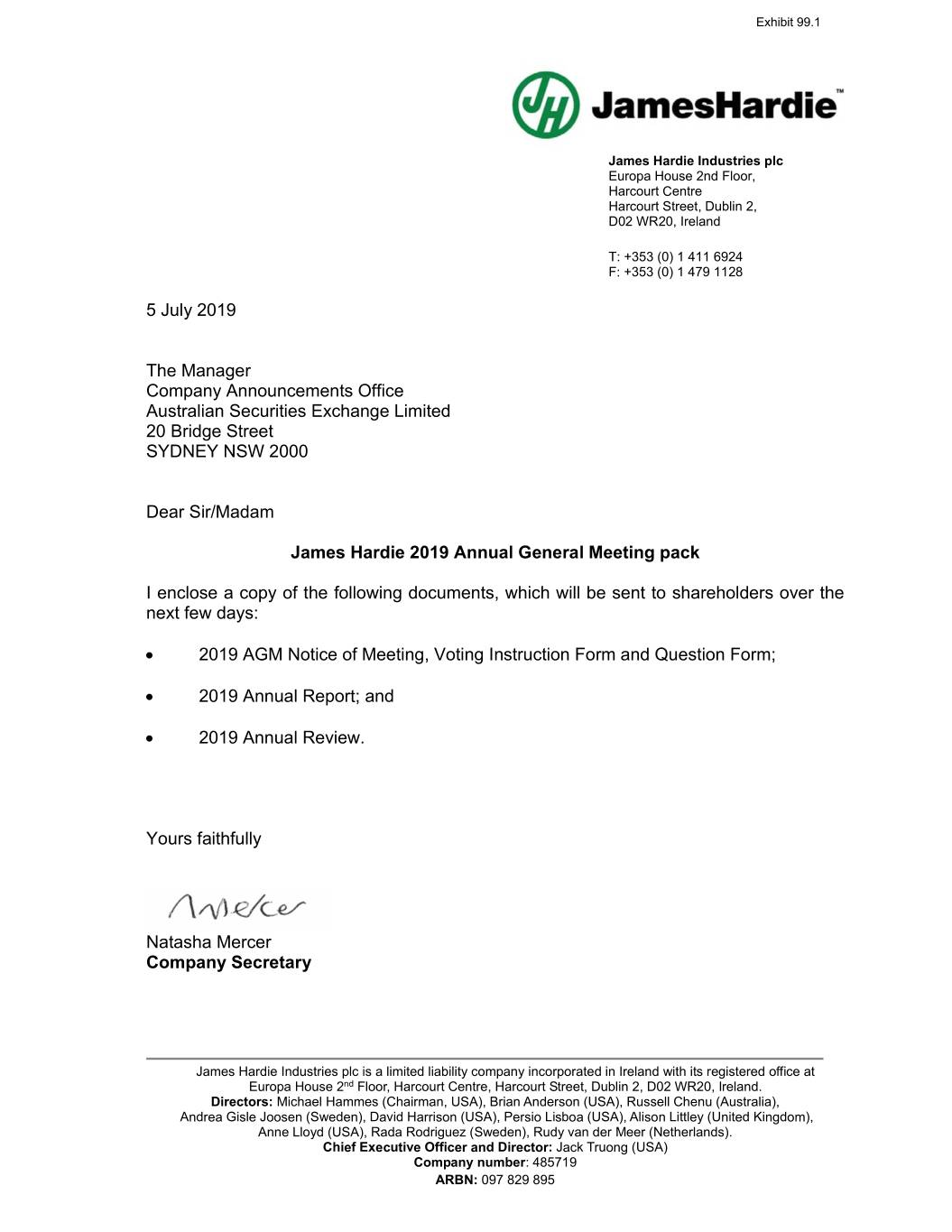
Exhibit 99.1 James Hardie Industries plc Europa House 2nd Floor, Harcourt Centre Harcourt Street, Dublin 2, D02 WR20, Ireland T: +353 (0) 1 411 6924 F: +353 (0) 1 479 1128 5 July 2019 The Manager Company Announcements Office Australian Securities Exchange Limited 20 Bridge Street SYDNEY NSW 2000 Dear Sir/Madam James Hardie 2019 Annual General Meeting pack I enclose a copy of the following documents, which will be sent to shareholders over the next few days: 2019 AGM Notice of Meeting, Voting Instruction Form and Question Form; 2019 Annual Report; and 2019 Annual Review. Yours faithfully Natasha Mercer Company Secretary James Hardie Industries plc is a limited liability company incorporated in Ireland with its registered office at Europa House 2nd Floor, Harcourt Centre, Harcourt Street, Dublin 2, D02 WR20, Ireland. Directors: Michael Hammes (Chairman, USA), Brian Anderson (USA), Russell Chenu (Australia), Andrea Gisle Joosen (Sweden), David Harrison (USA), Persio Lisboa (USA), Alison Littley (United Kingdom), Anne Lloyd (USA), Rada Rodriguez (Sweden), Rudy van der Meer (Netherlands). Chief Executive Officer and Director: Jack Truong (USA) Company number: 485719 ARBN: 097 829 895
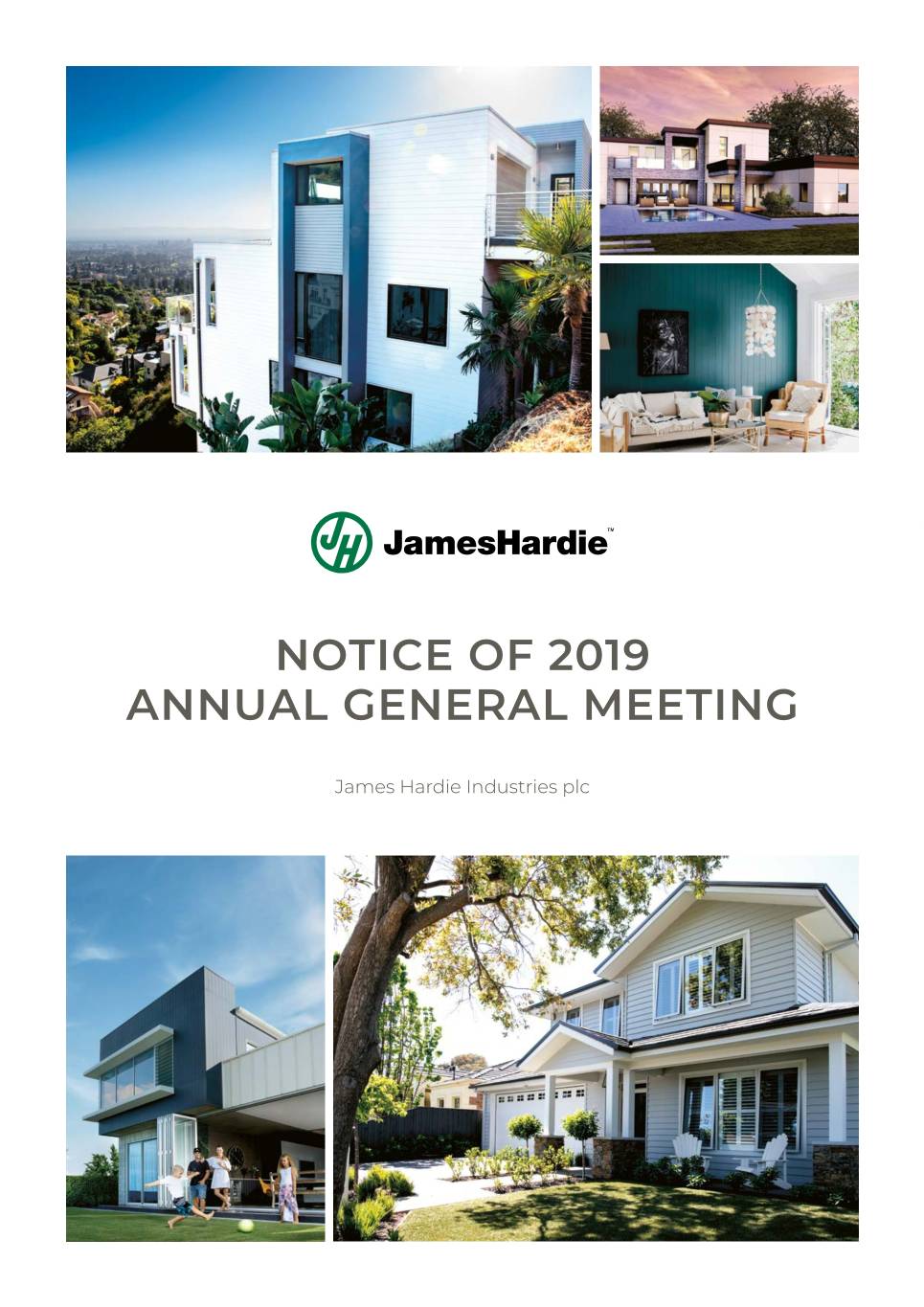
NOTICE OF 2019 ANNUAL GENERAL MEETING James Hardie Industries plc
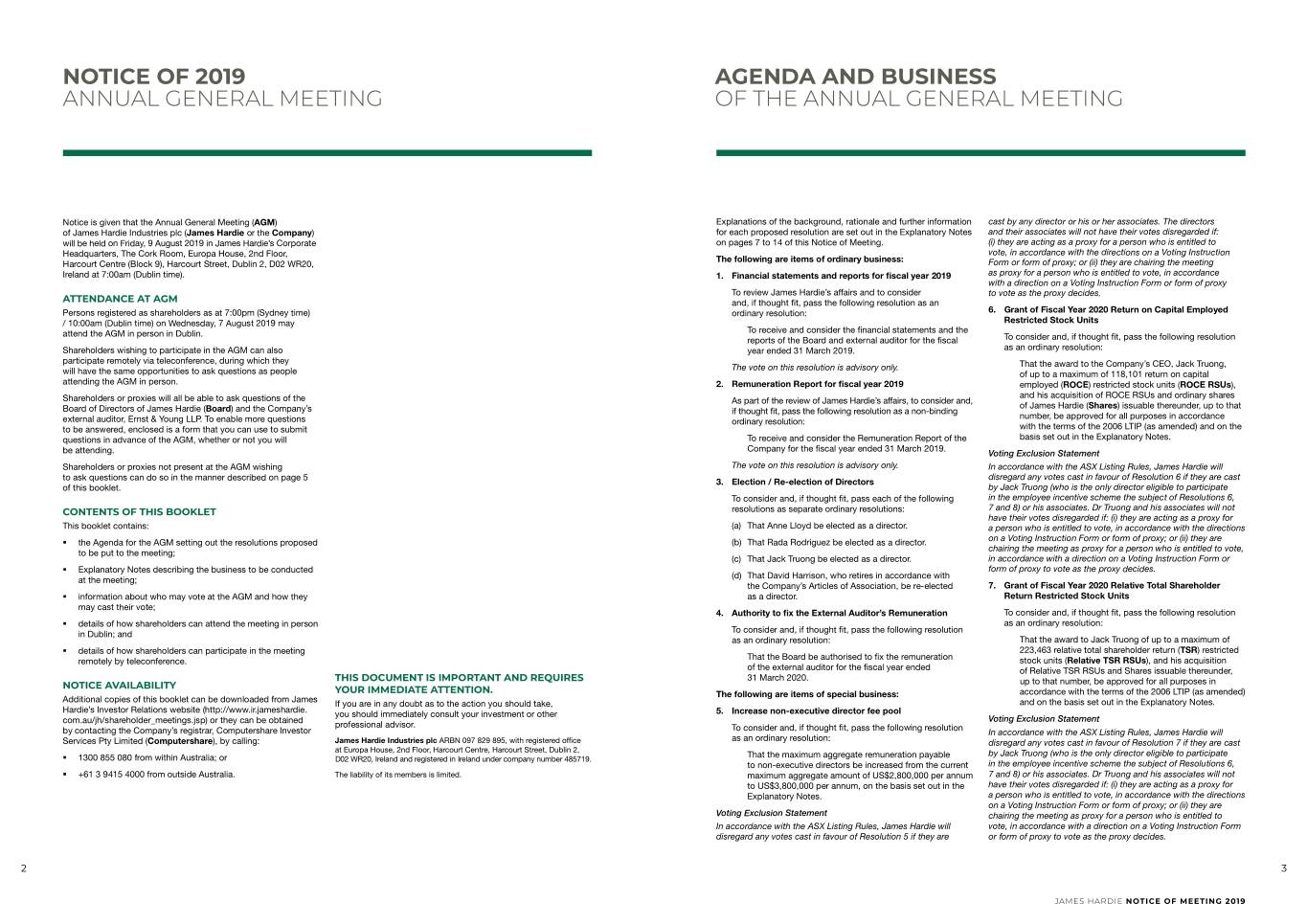
NOTICE OF 2019 AGENDA AND BUSINESS ANNUAL GENERAL MEETING OF THE ANNUAL GENERAL MEETING Notice is given that the Annual General Meeting (AGM) Explanations of the background, rationale and further information cast by any director or his or her associates. The directors of James Hardie Industries plc (James Hardie or the Company) for each proposed resolution are set out in the Explanatory Notes and their associates will not have their votes disregarded if: will be held on Friday, 9 August 2019 in James Hardie’s Corporate on pages 7 to 14 of this Notice of Meeting. (i) they are acting as a proxy for a person who is entitled to Headquarters, The Cork Room, Europa House, 2nd Floor, vote, in accordance with the directions on a Voting Instruction The following are items of ordinary business: Harcourt Centre (Block 9), Harcourt Street, Dublin 2, D02 WR20, Form or form of proxy; or (ii) they are chairing the meeting Ireland at 7:00am (Dublin time). 1. Financial statements and reports for fiscal year 2019 as proxy for a person who is entitled to vote, in accordance with a direction on a Voting Instruction Form or form of proxy To review James Hardie’s affairs and to consider to vote as the proxy decides. ATTENDANCE AT AGM and, if thought fit, pass the following resolution as an Persons registered as shareholders as at 7:00pm (Sydney time) ordinary resolution: 6. Grant of Fiscal Year 2020 Return on Capital Employed / 10:00am (Dublin time) on Wednesday, 7 August 2019 may Restricted Stock Units attend the AGM in person in Dublin. To receive and consider the financial statements and the reports of the Board and external auditor for the fiscal To consider and, if thought fit, pass the following resolution Shareholders wishing to participate in the AGM can also year ended 31 March 2019. as an ordinary resolution: participate remotely via teleconference, during which they The vote on this resolution is advisory only. That the award to the Company’s CEO, Jack Truong, will have the same opportunities to ask questions as people of up to a maximum of 118,101 return on capital attending the AGM in person. 2. Remuneration Report for fiscal year 2019 employed (ROCE) restricted stock units (ROCE RSUs), and his acquisition of ROCE RSUs and ordinary shares Shareholders or proxies will all be able to ask questions of the As part of the review of James Hardie’s affairs, to consider and, of James Hardie (Shares) issuable thereunder, up to that Board of Directors of James Hardie (Board) and the Company’s if thought fit, pass the following resolution as a non‑binding number, be approved for all purposes in accordance external auditor, Ernst & Young LLP. To enable more questions ordinary resolution: to be answered, enclosed is a form that you can use to submit with the terms of the 2006 LTIP (as amended) and on the questions in advance of the AGM, whether or not you will To receive and consider the Remuneration Report of the basis set out in the Explanatory Notes. Company for the fiscal year ended 31 March 2019. be attending. Voting Exclusion Statement Shareholders or proxies not present at the AGM wishing The vote on this resolution is advisory only. In accordance with the ASX Listing Rules, James Hardie will to ask questions can do so in the manner described on page 5 disregard any votes cast in favour of Resolution 6 if they are cast 3. Election / Re-election of Directors of this booklet. by Jack Truong (who is the only director eligible to participate To consider and, if thought fit, pass each of the following in the employee incentive scheme the subject of Resolutions 6, 7 and 8) or his associates. Dr Truong and his associates will not CONTENTS OF THIS BOOKLET resolutions as separate ordinary resolutions: have their votes disregarded if: (i) they are acting as a proxy for This booklet contains: (a) That Anne Lloyd be elected as a director. a person who is entitled to vote, in accordance with the directions §§ the Agenda for the AGM setting out the resolutions proposed (b) That Rada Rodriguez be elected as a director. on a Voting Instruction Form or form of proxy; or (ii) they are chairing the meeting as proxy for a person who is entitled to vote, to be put to the meeting; (c) That Jack Truong be elected as a director. in accordance with a direction on a Voting Instruction Form or §§ Explanatory Notes describing the business to be conducted form of proxy to vote as the proxy decides. (d) That David Harrison, who retires in accordance with at the meeting; the Company’s Articles of Association, be re-elected 7. Grant of Fiscal Year 2020 Relative Total Shareholder §§ information about who may vote at the AGM and how they as a director. Return Restricted Stock Units may cast their vote; 4. Authority to fix the External Auditor’s Remuneration To consider and, if thought fit, pass the following resolution §§ details of how shareholders can attend the meeting in person as an ordinary resolution: To consider and, if thought fit, pass the following resolution in Dublin; and as an ordinary resolution: That the award to Jack Truong of up to a maximum of §§ details of how shareholders can participate in the meeting 223,463 relative total shareholder return (TSR) restricted That the Board be authorised to fix the remuneration remotely by teleconference. stock units (Relative TSR RSUs), and his acquisition of the external auditor for the fiscal year ended of Relative TSR RSUs and Shares issuable thereunder, THIS DOCUMENT IS IMPORTANT AND REQUIRES 31 March 2020. NOTICE AVAILABILITY up to that number, be approved for all purposes in YOUR IMMEDIATE ATTENTION. The following are items of special business: accordance with the terms of the 2006 LTIP (as amended) Additional copies of this booklet can be downloaded from James If you are in any doubt as to the action you should take, and on the basis set out in the Explanatory Notes. Hardie’s Investor Relations website (http://www.ir.jameshardie. you should immediately consult your investment or other 5. Increase non-executive director fee pool com.au/jh/shareholder_meetings.jsp) or they can be obtained Voting Exclusion Statement professional advisor. To consider and, if thought fit, pass the following resolution by contacting the Company’s registrar, Computershare Investor In accordance with the ASX Listing Rules, James Hardie will as an ordinary resolution: Services Pty Limited (Computershare), by calling: James Hardie Industries plc ARBN 097 829 895, with registered office disregard any votes cast in favour of Resolution 7 if they are cast at Europa House, 2nd Floor, Harcourt Centre, Harcourt Street, Dublin 2, That the maximum aggregate remuneration payable by Jack Truong (who is the only director eligible to participate §§ 1300 855 080 from within Australia; or D02 WR20, Ireland and registered in Ireland under company number 485719. to non‑executive directors be increased from the current in the employee incentive scheme the subject of Resolutions 6, §§ +61 3 9415 4000 from outside Australia. The liability of its members is limited. maximum aggregate amount of US$2,800,000 per annum 7 and 8) or his associates. Dr Truong and his associates will not to US$3,800,000 per annum, on the basis set out in the have their votes disregarded if: (i) they are acting as a proxy for Explanatory Notes. a person who is entitled to vote, in accordance with the directions on a Voting Instruction Form or form of proxy; or (ii) they are Voting Exclusion Statement chairing the meeting as proxy for a person who is entitled to In accordance with the ASX Listing Rules, James Hardie will vote, in accordance with a direction on a Voting Instruction Form disregard any votes cast in favour of Resolution 5 if they are or form of proxy to vote as the proxy decides. 2 3 JAMES HARDIE NOTICE OF MEETING 2019
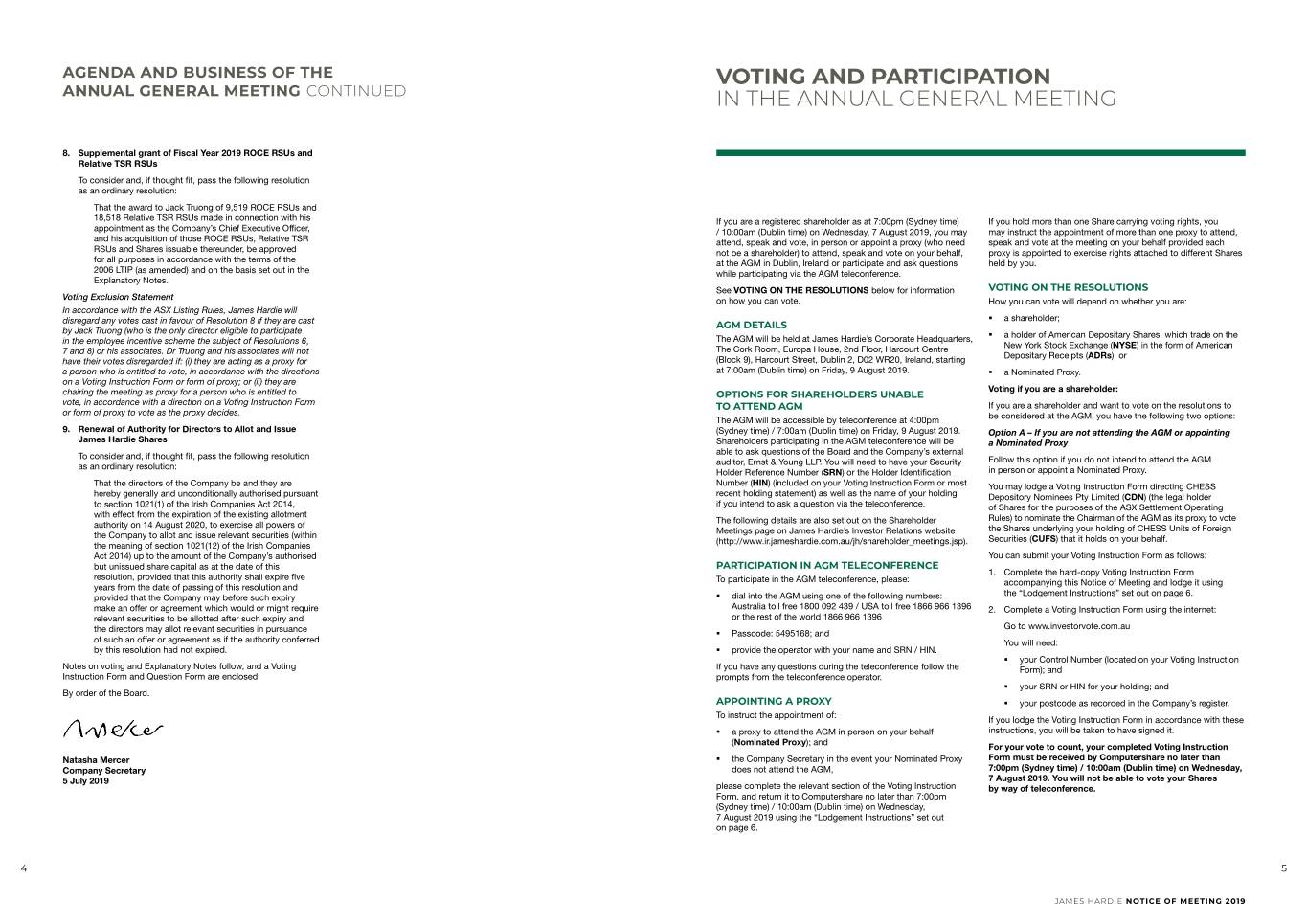
AGENDA AND BUSINESS OF THE VOTING AND PARTICIPATION ANNUAL GENERAL MEETING CONTINUED IN THE ANNUAL GENERAL MEETING 8. Supplemental grant of Fiscal Year 2019 ROCE RSUs and Relative TSR RSUs To consider and, if thought fit, pass the following resolution as an ordinary resolution: That the award to Jack Truong of 9,519 ROCE RSUs and 18,518 Relative TSR RSUs made in connection with his If you are a registered shareholder as at 7:00pm (Sydney time) If you hold more than one Share carrying voting rights, you appointment as the Company’s Chief Executive Officer, / 10:00am (Dublin time) on Wednesday, 7 August 2019, you may may instruct the appointment of more than one proxy to attend, and his acquisition of those ROCE RSUs, Relative TSR attend, speak and vote, in person or appoint a proxy (who need speak and vote at the meeting on your behalf provided each RSUs and Shares issuable thereunder, be approved not be a shareholder) to attend, speak and vote on your behalf, proxy is appointed to exercise rights attached to different Shares for all purposes in accordance with the terms of the at the AGM in Dublin, Ireland or participate and ask questions held by you. 2006 LTIP (as amended) and on the basis set out in the while participating via the AGM teleconference. Explanatory Notes. See VOTING ON THE RESOLUTIONS below for information VOTING ON THE RESOLUTIONS Voting Exclusion Statement on how you can vote. How you can vote will depend on whether you are: In accordance with the ASX Listing Rules, James Hardie will disregard any votes cast in favour of Resolution 8 if they are cast §§ a shareholder; AGM DETAILS by Jack Truong (who is the only director eligible to participate The AGM will be held at James Hardie’s Corporate Headquarters, §§ a holder of American Depositary Shares, which trade on the in the employee incentive scheme the subject of Resolutions 6, New York Stock Exchange (NYSE) in the form of American 7 and 8) or his associates. Dr Truong and his associates will not The Cork Room, Europa House, 2nd Floor, Harcourt Centre Depositary Receipts (ADRs); or have their votes disregarded if: (i) they are acting as a proxy for (Block 9), Harcourt Street, Dublin 2, D02 WR20, Ireland, starting a person who is entitled to vote, in accordance with the directions at 7:00am (Dublin time) on Friday, 9 August 2019. §§ a Nominated Proxy. on a Voting Instruction Form or form of proxy; or (ii) they are Voting if you are a shareholder: chairing the meeting as proxy for a person who is entitled to OPTIONS FOR SHAREHOLDERS UNABLE vote, in accordance with a direction on a Voting Instruction Form TO ATTEND AGM If you are a shareholder and want to vote on the resolutions to or form of proxy to vote as the proxy decides. be considered at the AGM, you have the following two options: The AGM will be accessible by teleconference at 4:00pm 9. Renewal of Authority for Directors to Allot and Issue (Sydney time) / 7:00am (Dublin time) on Friday, 9 August 2019. Option A – If you are not attending the AGM or appointing James Hardie Shares Shareholders participating in the AGM teleconference will be a Nominated Proxy able to ask questions of the Board and the Company’s external To consider and, if thought fit, pass the following resolution auditor, Ernst & Young LLP. You will need to have your Security Follow this option if you do not intend to attend the AGM as an ordinary resolution: Holder Reference Number (SRN) or the Holder Identification in person or appoint a Nominated Proxy. That the directors of the Company be and they are Number (HIN) (included on your Voting Instruction Form or most You may lodge a Voting Instruction Form directing CHESS hereby generally and unconditionally authorised pursuant recent holding statement) as well as the name of your holding Depository Nominees Pty Limited (CDN) (the legal holder to section 1021(1) of the Irish Companies Act 2014, if you intend to ask a question via the teleconference. of Shares for the purposes of the ASX Settlement Operating with effect from the expiration of the existing allotment The following details are also set out on the Shareholder Rules) to nominate the Chairman of the AGM as its proxy to vote authority on 14 August 2020, to exercise all powers of Meetings page on James Hardie’s Investor Relations website the Shares underlying your holding of CHESS Units of Foreign the Company to allot and issue relevant securities (within (http://www.ir.jameshardie.com.au/jh/shareholder_meetings.jsp). Securities (CUFS) that it holds on your behalf. the meaning of section 1021(12) of the Irish Companies Act 2014) up to the amount of the Company’s authorised You can submit your Voting Instruction Form as follows: but unissued share capital as at the date of this PARTICIPATION IN AGM TELECONFERENCE 1. Complete the hard-copy Voting Instruction Form resolution, provided that this authority shall expire five To participate in the AGM teleconference, please: accompanying this Notice of Meeting and lodge it using years from the date of passing of this resolution and the “Lodgement Instructions” set out on page 6. provided that the Company may before such expiry §§ dial into the AGM using one of the following numbers: make an offer or agreement which would or might require Australia toll free 1800 092 439 / USA toll free 1866 966 1396 2. Complete a Voting Instruction Form using the internet: relevant securities to be allotted after such expiry and or the rest of the world 1866 966 1396 Go to www.investorvote.com.au the directors may allot relevant securities in pursuance §§ Passcode: 5495168; and of such an offer or agreement as if the authority conferred You will need: by this resolution had not expired. §§ provide the operator with your name and SRN / HIN. §§ your Control Number (located on your Voting Instruction Notes on voting and Explanatory Notes follow, and a Voting If you have any questions during the teleconference follow the Form); and Instruction Form and Question Form are enclosed. prompts from the teleconference operator. §§ your SRN or HIN for your holding; and By order of the Board. APPOINTING A PROXY §§ your postcode as recorded in the Company’s register. To instruct the appointment of: If you lodge the Voting Instruction Form in accordance with these §§ a proxy to attend the AGM in person on your behalf instructions, you will be taken to have signed it. (Nominated Proxy); and For your vote to count, your completed Voting Instruction Natasha Mercer §§ the Company Secretary in the event your Nominated Proxy Form must be received by Computershare no later than Company Secretary does not attend the AGM, 7:00pm (Sydney time) / 10:00am (Dublin time) on Wednesday, 5 July 2019 7 August 2019. You will not be able to vote your Shares please complete the relevant section of the Voting Instruction by way of teleconference. Form, and return it to Computershare no later than 7:00pm (Sydney time) / 10:00am (Dublin time) on Wednesday, 7 August 2019 using the “Lodgement Instructions” set out on page 6. 4 5 JAMES HARDIE NOTICE OF MEETING 2019
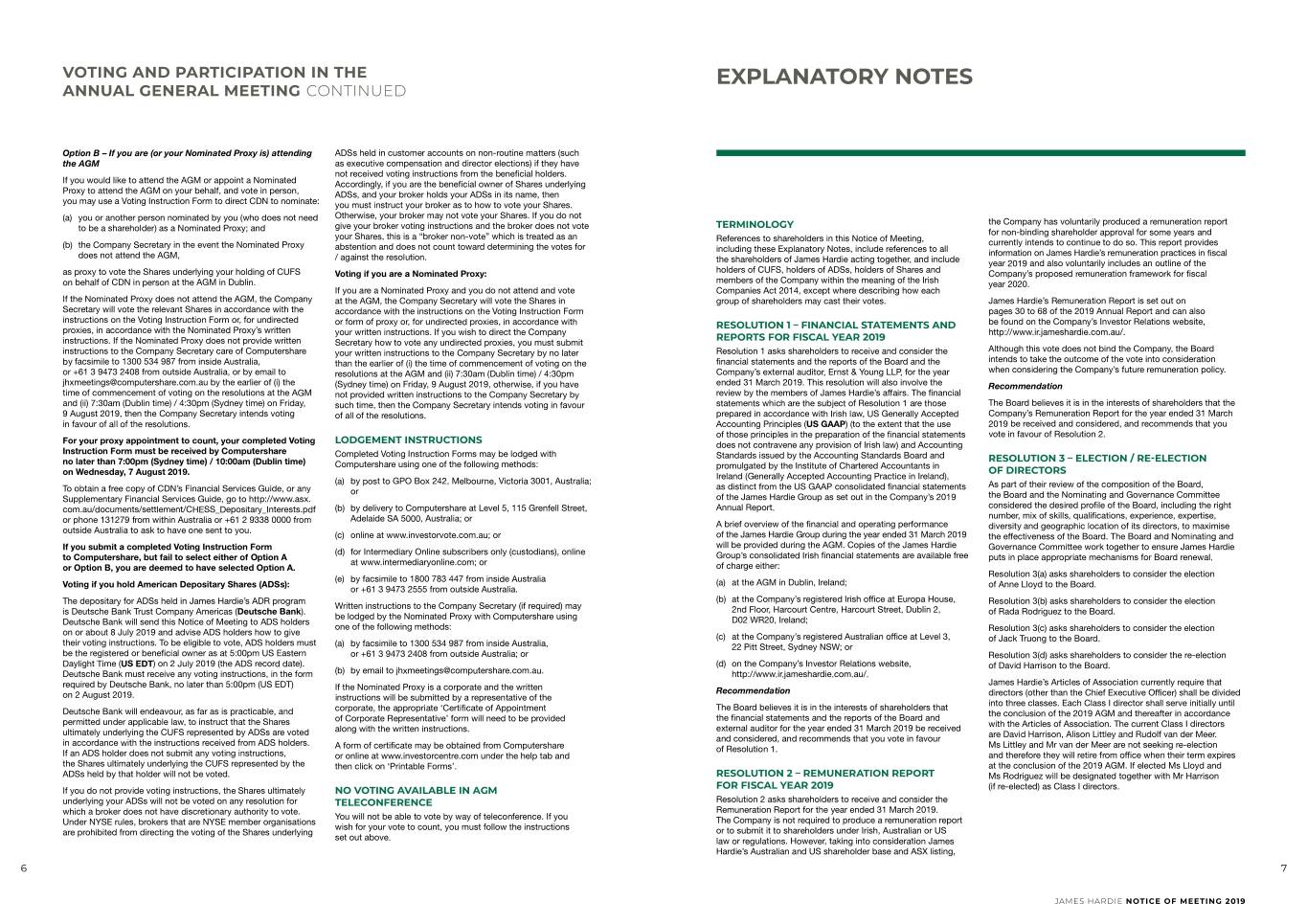
VOTING AND PARTICIPATION IN THE EXPLANATORY NOTES ANNUAL GENERAL MEETING CONTINUED Option B – If you are (or your Nominated Proxy is) attending ADSs held in customer accounts on non-routine matters (such the AGM as executive compensation and director elections) if they have not received voting instructions from the beneficial holders. If you would like to attend the AGM or appoint a Nominated Accordingly, if you are the beneficial owner of Shares underlying Proxy to attend the AGM on your behalf, and vote in person, ADSs, and your broker holds your ADSs in its name, then you may use a Voting Instruction Form to direct CDN to nominate: you must instruct your broker as to how to vote your Shares. Otherwise, your broker may not vote your Shares. If you do not (a) you or another person nominated by you (who does not need the Company has voluntarily produced a remuneration report to be a shareholder) as a Nominated Proxy; and give your broker voting instructions and the broker does not vote TERMINOLOGY your Shares, this is a “broker non-vote” which is treated as an for non-binding shareholder approval for some years and References to shareholders in this Notice of Meeting, currently intends to continue to do so. This report provides (b) the Company Secretary in the event the Nominated Proxy abstention and does not count toward determining the votes for including these Explanatory Notes, include references to all does not attend the AGM, / against the resolution. information on James Hardie’s remuneration practices in fiscal the shareholders of James Hardie acting together, and include year 2019 and also voluntarily includes an outline of the as proxy to vote the Shares underlying your holding of CUFS Voting if you are a Nominated Proxy: holders of CUFS, holders of ADSs, holders of Shares and Company’s proposed remuneration framework for fiscal on behalf of CDN in person at the AGM in Dublin. members of the Company within the meaning of the Irish year 2020. If you are a Nominated Proxy and you do not attend and vote Companies Act 2014, except where describing how each If the Nominated Proxy does not attend the AGM, the Company at the AGM, the Company Secretary will vote the Shares in group of shareholders may cast their votes. James Hardie’s Remuneration Report is set out on Secretary will vote the relevant Shares in accordance with the accordance with the instructions on the Voting Instruction Form pages 30 to 68 of the 2019 Annual Report and can also instructions on the Voting Instruction Form or, for undirected or form of proxy or, for undirected proxies, in accordance with RESOLUTION 1 – FINANCIAL STATEMENTS AND be found on the Company’s Investor Relations website, proxies, in accordance with the Nominated Proxy’s written your written instructions. If you wish to direct the Company http://www.ir.jameshardie.com.au/. instructions. If the Nominated Proxy does not provide written Secretary how to vote any undirected proxies, you must submit REPORTS FOR FISCAL YEAR 2019 instructions to the Company Secretary care of Computershare your written instructions to the Company Secretary by no later Resolution 1 asks shareholders to receive and consider the Although this vote does not bind the Company, the Board by facsimile to 1300 534 987 from inside Australia, than the earlier of (i) the time of commencement of voting on the financial statements and the reports of the Board and the intends to take the outcome of the vote into consideration or +61 3 9473 2408 from outside Australia, or by email to resolutions at the AGM and (ii) 7:30am (Dublin time) / 4:30pm Company’s external auditor, Ernst & Young LLP, for the year when considering the Company’s future remuneration policy. [email protected] by the earlier of (i) the (Sydney time) on Friday, 9 August 2019, otherwise, if you have ended 31 March 2019. This resolution will also involve the Recommendation time of commencement of voting on the resolutions at the AGM not provided written instructions to the Company Secretary by review by the members of James Hardie’s affairs. The financial and (ii) 7:30am (Dublin time) / 4:30pm (Sydney time) on Friday, such time, then the Company Secretary intends voting in favour statements which are the subject of Resolution 1 are those The Board believes it is in the interests of shareholders that the 9 August 2019, then the Company Secretary intends voting of all of the resolutions. prepared in accordance with Irish law, US Generally Accepted Company’s Remuneration Report for the year ended 31 March in favour of all of the resolutions. Accounting Principles (US GAAP) (to the extent that the use 2019 be received and considered, and recommends that you of those principles in the preparation of the financial statements vote in favour of Resolution 2. For your proxy appointment to count, your completed Voting LODGEMENT INSTRUCTIONS does not contravene any provision of Irish law) and Accounting Instruction Form must be received by Computershare Completed Voting Instruction Forms may be lodged with Standards issued by the Accounting Standards Board and RESOLUTION 3 – ELECTION / RE-ELECTION no later than 7:00pm (Sydney time) / 10:00am (Dublin time) Computershare using one of the following methods: promulgated by the Institute of Chartered Accountants in OF DIRECTORS on Wednesday, 7 August 2019. Ireland (Generally Accepted Accounting Practice in Ireland), (a) by post to GPO Box 242, Melbourne, Victoria 3001, Australia; as distinct from the US GAAP consolidated financial statements As part of their review of the composition of the Board, To obtain a free copy of CDN’s Financial Services Guide, or any or Supplementary Financial Services Guide, go to http://www.asx. of the James Hardie Group as set out in the Company’s 2019 the Board and the Nominating and Governance Committee com.au/documents/settlement/CHESS_Depositary_Interests.pdf (b) by delivery to Computershare at Level 5, 115 Grenfell Street, Annual Report. considered the desired profile of the Board, including the right Adelaide SA 5000, Australia; or number, mix of skills, qualifications, experience, expertise, or phone 131279 from within Australia or +61 2 9338 0000 from A brief overview of the financial and operating performance outside Australia to ask to have one sent to you. diversity and geographic location of its directors, to maximise (c) online at www.investorvote.com.au; or of the James Hardie Group during the year ended 31 March 2019 the effectiveness of the Board. The Board and Nominating and If you submit a completed Voting Instruction Form will be provided during the AGM. Copies of the James Hardie Governance Committee work together to ensure James Hardie (d) for Intermediary Online subscribers only (custodians), online to Computershare, but fail to select either of Option A Group’s consolidated Irish financial statements are available free puts in place appropriate mechanisms for Board renewal. at www.intermediaryonline.com; or or Option B, you are deemed to have selected Option A. of charge either: Resolution 3(a) asks shareholders to consider the election (e) by facsimile to 1800 783 447 from inside Australia Voting if you hold American Depositary Shares (ADSs): (a) at the AGM in Dublin, Ireland; of Anne Lloyd to the Board. or +61 3 9473 2555 from outside Australia. The depositary for ADSs held in James Hardie’s ADR program (b) at the Company’s registered Irish office at Europa House, Resolution 3(b) asks shareholders to consider the election Written instructions to the Company Secretary (if required) may is Deutsche Bank Trust Company Americas (Deutsche Bank). 2nd Floor, Harcourt Centre, Harcourt Street, Dublin 2, of Rada Rodriguez to the Board. be lodged by the Nominated Proxy with Computershare using Deutsche Bank will send this Notice of Meeting to ADS holders D02 WR20, Ireland; one of the following methods: on or about 8 July 2019 and advise ADS holders how to give Resolution 3(c) asks shareholders to consider the election (c) at the Company’s registered Australian office at Level 3, of Jack Truong to the Board. their voting instructions. To be eligible to vote, ADS holders must (a) by facsimile to 1300 534 987 from inside Australia, 22 Pitt Street, Sydney NSW; or be the registered or beneficial owner as at 5:00pm US Eastern or +61 3 9473 2408 from outside Australia; or Resolution 3(d) asks shareholders to consider the re-election Daylight Time (US EDT) on 2 July 2019 (the ADS record date). (d) on the Company’s Investor Relations website, of David Harrison to the Board. Deutsche Bank must receive any voting instructions, in the form (b) by email to [email protected]. http://www.ir.jameshardie.com.au/. James Hardie’s Articles of Association currently require that required by Deutsche Bank, no later than 5:00pm (US EDT) If the Nominated Proxy is a corporate and the written Recommendation directors (other than the Chief Executive Officer) shall be divided on 2 August 2019. instructions will be submitted by a representative of the into three classes. Each Class I director shall serve initially until corporate, the appropriate ‘Certificate of Appointment The Board believes it is in the interests of shareholders that Deutsche Bank will endeavour, as far as is practicable, and the conclusion of the 2019 AGM and thereafter in accordance of Corporate Representative’ form will need to be provided the financial statements and the reports of the Board and permitted under applicable law, to instruct that the Shares with the Articles of Association. The current Class I directors along with the written instructions. external auditor for the year ended 31 March 2019 be received ultimately underlying the CUFS represented by ADSs are voted are David Harrison, Alison Littley and Rudolf van der Meer. in accordance with the instructions received from ADS holders. and considered, and recommends that you vote in favour A form of certificate may be obtained from Computershare of Resolution 1. Ms Littley and Mr van der Meer are not seeking re-election If an ADS holder does not submit any voting instructions, or online at www.investorcentre.com under the help tab and and therefore they will retire from office when their term expires the Shares ultimately underlying the CUFS represented by the then click on ‘Printable Forms’. at the conclusion of the 2019 AGM. If elected Ms Lloyd and ADSs held by that holder will not be voted. RESOLUTION 2 – REMUNERATION REPORT Ms Rodriguez will be designated together with Mr Harrison FOR FISCAL YEAR 2019 (if re‑elected) as Class I directors. If you do not provide voting instructions, the Shares ultimately NO VOTING AVAILABLE IN AGM underlying your ADSs will not be voted on any resolution for TELECONFERENCE Resolution 2 asks shareholders to receive and consider the which a broker does not have discretionary authority to vote. Remuneration Report for the year ended 31 March 2019. You will not be able to vote by way of teleconference. If you Under NYSE rules, brokers that are NYSE member organisations The Company is not required to produce a remuneration report wish for your vote to count, you must follow the instructions are prohibited from directing the voting of the Shares underlying or to submit it to shareholders under Irish, Australian or US set out above. law or regulations. However, taking into consideration James Hardie’s Australian and US shareholder base and ASX listing, 6 7 JAMES HARDIE NOTICE OF MEETING 2019
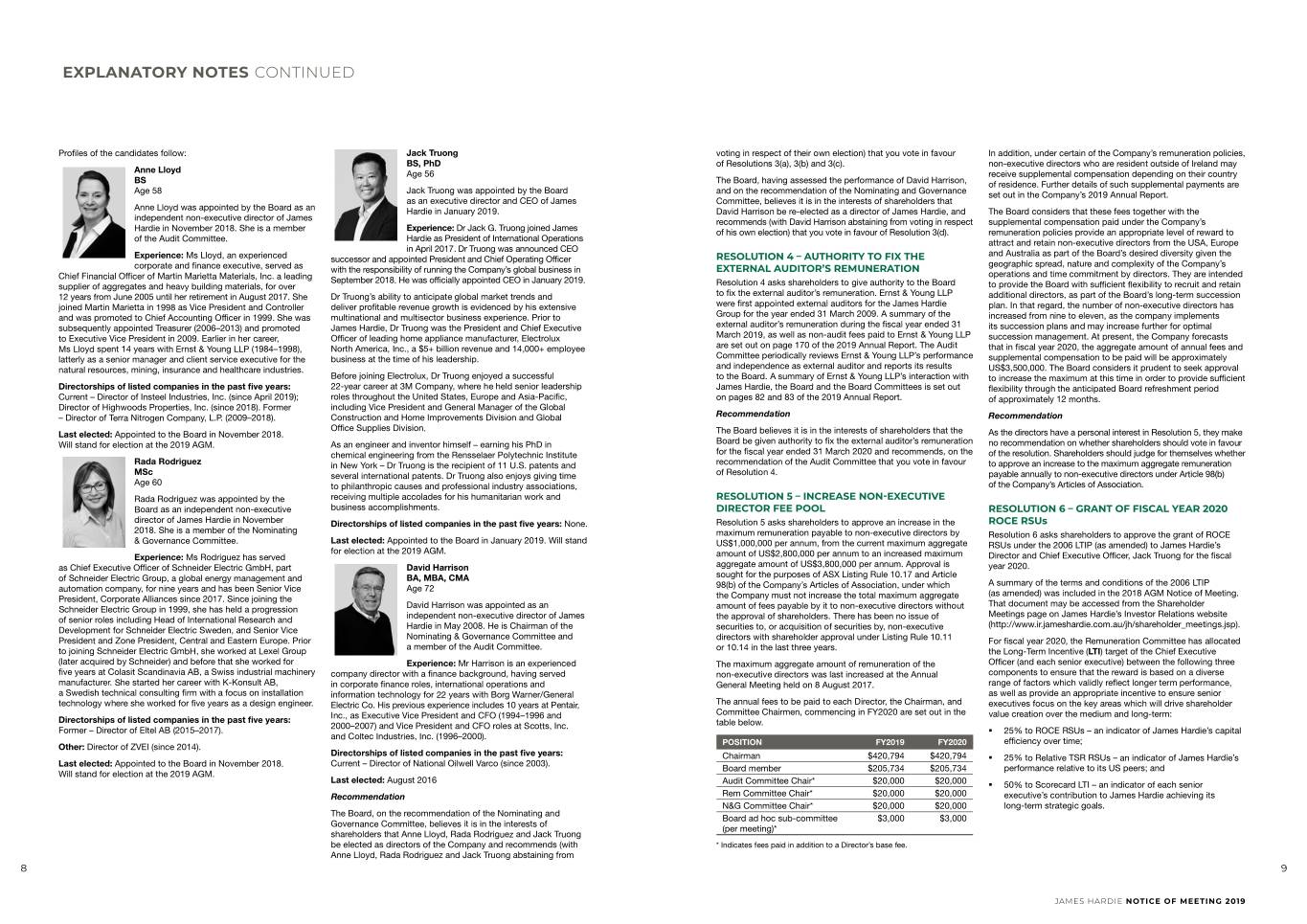
EXPLANATORY NOTES CONTINUED Profiles of the candidates follow: Jack Truong voting in respect of their own election) that you vote in favour In addition, under certain of the Company’s remuneration policies, BS, PhD of Resolutions 3(a), 3(b) and 3(c). non-executive directors who are resident outside of Ireland may Anne Lloyd Age 56 receive supplemental compensation depending on their country BS The Board, having assessed the performance of David Harrison, of residence. Further details of such supplemental payments are Jack Truong was appointed by the Board Age 58 and on the recommendation of the Nominating and Governance set out in the Company’s 2019 Annual Report. as an executive director and CEO of James Committee, believes it is in the interests of shareholders that Anne Lloyd was appointed by the Board as an Hardie in January 2019. David Harrison be re-elected as a director of James Hardie, and The Board considers that these fees together with the independent non-executive director of James recommends (with David Harrison abstaining from voting in respect supplemental compensation paid under the Company’s Dr Jack G. Truong joined James Hardie in November 2018. She is a member Experience: of his own election) that you vote in favour of Resolution 3(d). remuneration policies provide an appropriate level of reward to Hardie as President of International Operations of the Audit Committee. attract and retain non-executive directors from the USA, Europe in April 2017. Dr Truong was announced CEO and Australia as part of the Board’s desired diversity given the Experience: Ms Lloyd, an experienced successor and appointed President and Chief Operating Officer RESOLUTION 4 – AUTHORITY TO FIX THE geographic spread, nature and complexity of the Company’s corporate and finance executive, served as with the responsibility of running the Company’s global business in EXTERNAL AUDITOR’S REMUNERATION operations and time commitment by directors. They are intended Chief Financial Officer of Martin Marietta Materials, Inc. a leading September 2018. He was officially appointed CEO in January 2019. supplier of aggregates and heavy building materials, for over Resolution 4 asks shareholders to give authority to the Board to provide the Board with sufficient flexibility to recruit and retain 12 years from June 2005 until her retirement in August 2017. She Dr Truong’s ability to anticipate global market trends and to fix the external auditor’s remuneration. Ernst & Young LLP additional directors, as part of the Board’s long-term succession joined Martin Marietta in 1998 as Vice President and Controller deliver profitable revenue growth is evidenced by his extensive were first appointed external auditors for the James Hardie plan. In that regard, the number of non-executive directors has and was promoted to Chief Accounting Officer in 1999. She was multinational and multisector business experience. Prior to Group for the year ended 31 March 2009. A summary of the increased from nine to eleven, as the company implements subsequently appointed Treasurer (2006–2013) and promoted James Hardie, Dr Truong was the President and Chief Executive external auditor’s remuneration during the fiscal year ended 31 its succession plans and may increase further for optimal to Executive Vice President in 2009. Earlier in her career, Officer of leading home appliance manufacturer, Electrolux March 2019, as well as non-audit fees paid to Ernst & Young LLP succession management. At present, the Company forecasts Ms Lloyd spent 14 years with Ernst & Young LLP (1984–1998), North America, Inc., a $5+ billion revenue and 14,000+ employee are set out on page 170 of the 2019 Annual Report. The Audit that in fiscal year 2020, the aggregate amount of annual fees and latterly as a senior manager and client service executive for the business at the time of his leadership. Committee periodically reviews Ernst & Young LLP’s performance supplemental compensation to be paid will be approximately natural resources, mining, insurance and healthcare industries. and independence as external auditor and reports its results US$3,500,000. The Board considers it prudent to seek approval Before joining Electrolux, Dr Truong enjoyed a successful to the Board. A summary of Ernst & Young LLP’s interaction with to increase the maximum at this time in order to provide sufficient Directorships of listed companies in the past five years: 22‑year career at 3M Company, where he held senior leadership James Hardie, the Board and the Board Committees is set out flexibility through the anticipated Board refreshment period Current – Director of Insteel Industries, Inc. (since April 2019); roles throughout the United States, Europe and Asia-Pacific, on pages 82 and 83 of the 2019 Annual Report. of approximately 12 months. Director of Highwoods Properties, Inc. (since 2018). Former including Vice President and General Manager of the Global – Director of Terra Nitrogen Company, L.P. (2009–2018). Construction and Home Improvements Division and Global Recommendation Recommendation Office Supplies Division. Last elected: Appointed to the Board in November 2018. The Board believes it is in the interests of shareholders that the As the directors have a personal interest in Resolution 5, they make Will stand for election at the 2019 AGM. As an engineer and inventor himself – earning his PhD in Board be given authority to fix the external auditor’s remuneration no recommendation on whether shareholders should vote in favour chemical engineering from the Rensselaer Polytechnic Institute for the fiscal year ended 31 March 2020 and recommends, on the of the resolution. Shareholders should judge for themselves whether Rada Rodriguez in New York – Dr Truong is the recipient of 11 U.S. patents and recommendation of the Audit Committee that you vote in favour to approve an increase to the maximum aggregate remuneration MSc several international patents. Dr Truong also enjoys giving time of Resolution 4. payable annually to non-executive directors under Article 98(b) Age 60 to philanthropic causes and professional industry associations, of the Company’s Articles of Association. Rada Rodriguez was appointed by the receiving multiple accolades for his humanitarian work and RESOLUTION 5 – INCREASE NON-EXECUTIVE Board as an independent non-executive business accomplishments. DIRECTOR FEE POOL RESOLUTION 6 – GRANT OF FISCAL YEAR 2020 director of James Hardie in November Directorships of listed companies in the past five years: None. Resolution 5 asks shareholders to approve an increase in the ROCE RSUs 2018. She is a member of the Nominating maximum remuneration payable to non-executive directors by Resolution 6 asks shareholders to approve the grant of ROCE & Governance Committee. Last elected: Appointed to the Board in January 2019. Will stand US$1,000,000 per annum, from the current maximum aggregate RSUs under the 2006 LTIP (as amended) to James Hardie’s for election at the 2019 AGM. Experience: Ms Rodriguez has served amount of US$2,800,000 per annum to an increased maximum Director and Chief Executive Officer, Jack Truong for the fiscal as Chief Executive Officer of Schneider Electric GmbH, part David Harrison aggregate amount of US$3,800,000 per annum. Approval is year 2020. of Schneider Electric Group, a global energy management and BA, MBA, CMA sought for the purposes of ASX Listing Rule 10.17 and Article A summary of the terms and conditions of the 2006 LTIP automation company, for nine years and has been Senior Vice Age 72 98(b) of the Company’s Articles of Association, under which (as amended) was included in the 2018 AGM Notice of Meeting. President, Corporate Alliances since 2017. Since joining the the Company must not increase the total maximum aggregate David Harrison was appointed as an That document may be accessed from the Shareholder Schneider Electric Group in 1999, she has held a progression amount of fees payable by it to non-executive directors without independent non-executive director of James Meetings page on James Hardie’s Investor Relations website of senior roles including Head of International Research and the approval of shareholders. There has been no issue of Hardie in May 2008. He is Chairman of the (http://www.ir.jameshardie.com.au/jh/shareholder_meetings.jsp). Development for Schneider Electric Sweden, and Senior Vice securities to, or acquisition of securities by, non-executive Nominating & Governance Committee and President and Zone President, Central and Eastern Europe. Prior directors with shareholder approval under Listing Rule 10.11 For fiscal year 2020, the Remuneration Committee has allocated a member of the Audit Committee. to joining Schneider Electric GmbH, she worked at Lexel Group or 10.14 in the last three years. the Long-Term Incentive (LTI) target of the Chief Executive (later acquired by Schneider) and before that she worked for Experience: Mr Harrison is an experienced The maximum aggregate amount of remuneration of the Officer (and each senior executive) between the following three five years at Colasit Scandinavia AB, a Swiss industrial machinery company director with a finance background, having served non‑executive directors was last increased at the Annual components to ensure that the reward is based on a diverse manufacturer. She started her career with K-Konsult AB, in corporate finance roles, international operations and General Meeting held on 8 August 2017. range of factors which validly reflect longer term performance, a Swedish technical consulting firm with a focus on installation information technology for 22 years with Borg Warner/General as well as provide an appropriate incentive to ensure senior technology where she worked for five years as a design engineer. Electric Co. His previous experience includes 10 years at Pentair, The annual fees to be paid to each Director, the Chairman, and executives focus on the key areas which will drive shareholder Inc., as Executive Vice President and CFO (1994–1996 and Committee Chairmen, commencing in FY2020 are set out in the value creation over the medium and long-term: Directorships of listed companies in the past five years: 2000–2007) and Vice President and CFO roles at Scotts, Inc. table below. Former – Director of Eltel AB (2015–2017). §§ 25% to ROCE RSUs – an indicator of James Hardie’s capital and Coltec Industries, Inc. (1996–2000). POSITION FY2019 FY2020 efficiency over time; Other: Director of ZVEI (since 2014). Directorships of listed companies in the past five years: Chairman $420,794 $420,794 §§ 25% to Relative TSR RSUs – an indicator of James Hardie’s Last elected: Appointed to the Board in November 2018. Current – Director of National Oilwell Varco (since 2003). Board member $205,734 $205,734 performance relative to its US peers; and Will stand for election at the 2019 AGM. Last elected: August 2016 Audit Committee Chair* $20,000 $20,000 §§ 50% to Scorecard LTI – an indicator of each senior Recommendation Rem Committee Chair* $20,000 $20,000 executive’s contribution to James Hardie achieving its N&G Committee Chair* $20,000 $20,000 long‑term strategic goals. The Board, on the recommendation of the Nominating and Board ad hoc sub-committee $3,000 $3,000 Governance Committee, believes it is in the interests of (per meeting)* shareholders that Anne Lloyd, Rada Rodriguez and Jack Truong be elected as directors of the Company and recommends (with * Indicates fees paid in addition to a Director’s base fee. Anne Lloyd, Rada Rodriguez and Jack Truong abstaining from 8 9 JAMES HARDIE NOTICE OF MEETING 2019
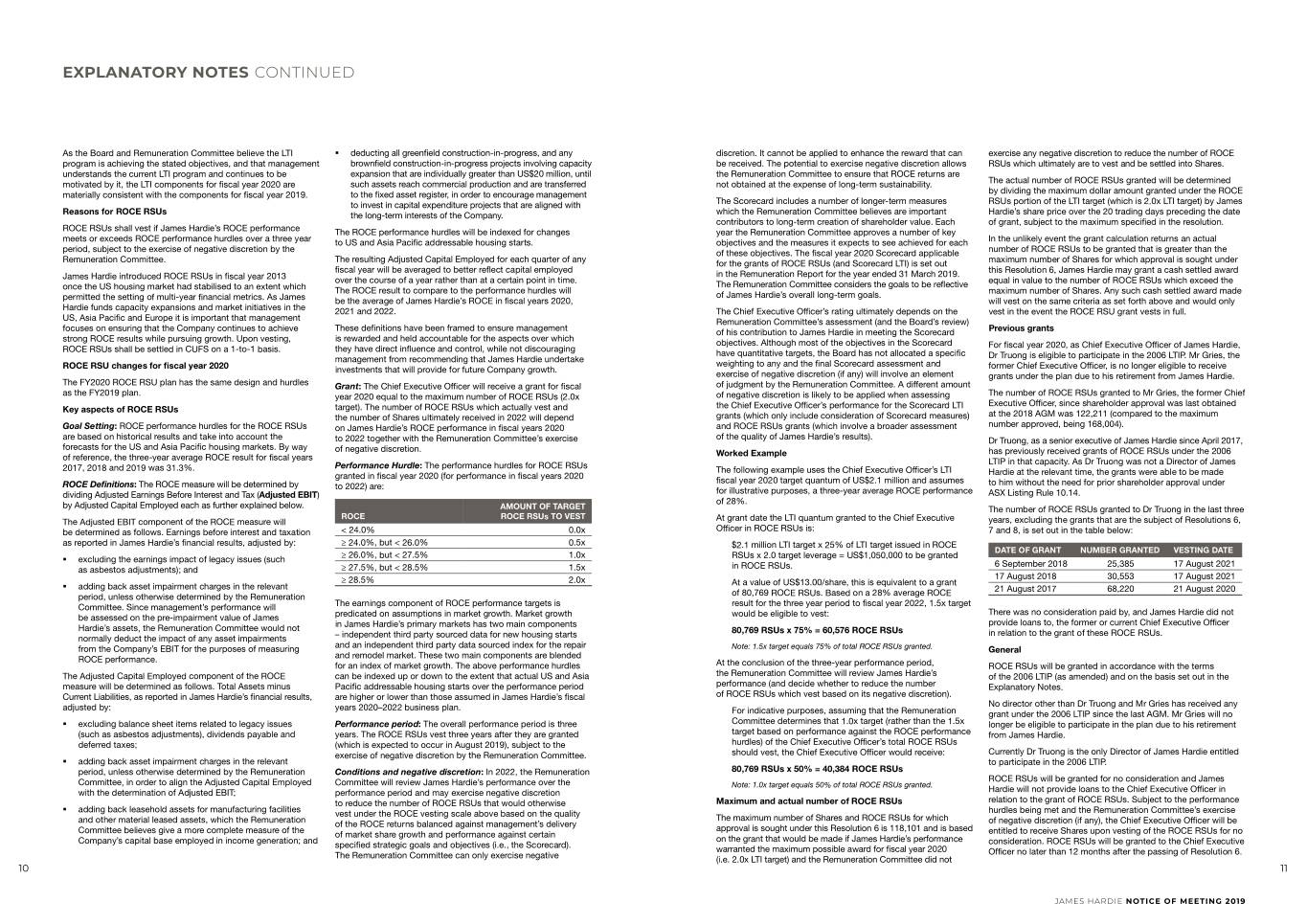
EXPLANATORY NOTES CONTINUED As the Board and Remuneration Committee believe the LTI §§ deducting all greenfield construction-in-progress, and any discretion. It cannot be applied to enhance the reward that can exercise any negative discretion to reduce the number of ROCE program is achieving the stated objectives, and that management brownfield construction-in-progress projects involving capacity be received. The potential to exercise negative discretion allows RSUs which ultimately are to vest and be settled into Shares. understands the current LTI program and continues to be expansion that are individually greater than US$20 million, until the Remuneration Committee to ensure that ROCE returns are motivated by it, the LTI components for fiscal year 2020 are such assets reach commercial production and are transferred not obtained at the expense of long-term sustainability. The actual number of ROCE RSUs granted will be determined materially consistent with the components for fiscal year 2019. to the fixed asset register, in order to encourage management by dividing the maximum dollar amount granted under the ROCE to invest in capital expenditure projects that are aligned with The Scorecard includes a number of longer-term measures RSUs portion of the LTI target (which is 2.0x LTI target) by James Reasons for ROCE RSUs the long-term interests of the Company. which the Remuneration Committee believes are important Hardie’s share price over the 20 trading days preceding the date contributors to long-term creation of shareholder value. Each of grant, subject to the maximum specified in the resolution. ROCE RSUs shall vest if James Hardie’s ROCE performance The ROCE performance hurdles will be indexed for changes year the Remuneration Committee approves a number of key meets or exceeds ROCE performance hurdles over a three year to US and Asia Pacific addressable housing starts. objectives and the measures it expects to see achieved for each In the unlikely event the grant calculation returns an actual period, subject to the exercise of negative discretion by the of these objectives. The fiscal year 2020 Scorecard applicable number of ROCE RSUs to be granted that is greater than the Remuneration Committee. The resulting Adjusted Capital Employed for each quarter of any for the grants of ROCE RSUs (and Scorecard LTI) is set out maximum number of Shares for which approval is sought under fiscal year will be averaged to better reflect capital employed in the Remuneration Report for the year ended 31 March 2019. this Resolution 6, James Hardie may grant a cash settled award James Hardie introduced ROCE RSUs in fiscal year 2013 over the course of a year rather than at a certain point in time. equal in value to the number of ROCE RSUs which exceed the once the US housing market had stabilised to an extent which The Remuneration Committee considers the goals to be reflective The ROCE result to compare to the performance hurdles will of James Hardie’s overall long-term goals. maximum number of Shares. Any such cash settled award made permitted the setting of multi-year financial metrics. As James be the average of James Hardie’s ROCE in fiscal years 2020, will vest on the same criteria as set forth above and would only Hardie funds capacity expansions and market initiatives in the 2021 and 2022. The Chief Executive Officer’s rating ultimately depends on the vest in the event the ROCE RSU grant vests in full. US, Asia Pacific and Europe it is important that management Remuneration Committee’s assessment (and the Board’s review) focuses on ensuring that the Company continues to achieve These definitions have been framed to ensure management of his contribution to James Hardie in meeting the Scorecard Previous grants strong ROCE results while pursuing growth. Upon vesting, is rewarded and held accountable for the aspects over which objectives. Although most of the objectives in the Scorecard ROCE RSUs shall be settled in CUFS on a 1-to-1 basis. they have direct influence and control, while not discouraging For fiscal year 2020, as Chief Executive Officer of James Hardie, have quantitative targets, the Board has not allocated a specific Dr Truong is eligible to participate in the 2006 LTIP. Mr Gries, the management from recommending that James Hardie undertake weighting to any and the final Scorecard assessment and ROCE RSU changes for fiscal year 2020 investments that will provide for future Company growth. former Chief Executive Officer, is no longer eligible to receive exercise of negative discretion (if any) will involve an element grants under the plan due to his retirement from James Hardie. The FY2020 ROCE RSU plan has the same design and hurdles Grant: The Chief Executive Officer will receive a grant for fiscal of judgment by the Remuneration Committee. A different amount as the FY2019 plan. year 2020 equal to the maximum number of ROCE RSUs (2.0x of negative discretion is likely to be applied when assessing The number of ROCE RSUs granted to Mr Gries, the former Chief Executive Officer, since shareholder approval was last obtained Key aspects of ROCE RSUs target). The number of ROCE RSUs which actually vest and the Chief Executive Officer’s performance for the Scorecard LTI the number of Shares ultimately received in 2022 will depend grants (which only include consideration of Scorecard measures) at the 2018 AGM was 122,211 (compared to the maximum Goal Setting: ROCE performance hurdles for the ROCE RSUs on James Hardie’s ROCE performance in fiscal years 2020 and ROCE RSUs grants (which involve a broader assessment number approved, being 168,004). are based on historical results and take into account the to 2022 together with the Remuneration Committee’s exercise of the quality of James Hardie’s results). Dr Truong, as a senior executive of James Hardie since April 2017, forecasts for the US and Asia Pacific housing markets. By way of negative discretion. has previously received grants of ROCE RSUs under the 2006 of reference, the three-year average ROCE result for fiscal years Worked Example Performance Hurdle: The performance hurdles for ROCE RSUs LTIP in that capacity. As Dr Truong was not a Director of James 2017, 2018 and 2019 was 31.3%. The following example uses the Chief Executive Officer’s LTI Hardie at the relevant time, the grants were able to be made granted in fiscal year 2020 (for performance in fiscal years 2020 fiscal year 2020 target quantum of US$2.1 million and assumes ROCE Definitions: The ROCE measure will be determined by to 2022) are: to him without the need for prior shareholder approval under dividing Adjusted Earnings Before Interest and Tax (Adjusted EBIT) for illustrative purposes, a three-year average ROCE performance ASX Listing Rule 10.14. of 28%. by Adjusted Capital Employed each as further explained below. AMOUNT OF TARGET The number of ROCE RSUs granted to Dr Truong in the last three ROCE ROCE RSUs TO VEST The Adjusted EBIT component of the ROCE measure will At grant date the LTI quantum granted to the Chief Executive years, excluding the grants that are the subject of Resolutions 6, be determined as follows. Earnings before interest and taxation < 24.0% 0.0x Officer in ROCE RSUs is: 7 and 8, is set out in the table below: as reported in James Hardie’s financial results, adjusted by: ≥ 24.0%, but < 26.0% 0.5x $2.1 million LTI target x 25% of LTI target issued in ROCE DATE OF GRANT NUMBER GRANTED VESTING DATE ≥ 26.0%, but < 27.5% 1.0x §§ excluding the earnings impact of legacy issues (such RSUs x 2.0 target leverage = US$1,050,000 to be granted 6 September 2018 25,385 17 August 2021 as asbestos adjustments); and ≥ 27.5%, but < 28.5% 1.5x in ROCE RSUs. 17 August 2018 30,553 17 August 2021 ≥ 28.5% 2.0x At a value of US$13.00/share, this is equivalent to a grant §§ adding back asset impairment charges in the relevant 21 August 2017 68,220 21 August 2020 period, unless otherwise determined by the Remuneration of 80,769 ROCE RSUs. Based on a 28% average ROCE Committee. Since management’s performance will The earnings component of ROCE performance targets is result for the three year period to fiscal year 2022, 1.5x target There was no consideration paid by, and James Hardie did not be assessed on the pre-impairment value of James predicated on assumptions in market growth. Market growth would be eligible to vest: provide loans to, the former or current Chief Executive Officer Hardie’s assets, the Remuneration Committee would not in James Hardie’s primary markets has two main components 80,769 RSUs x 75% = 60,576 ROCE RSUs in relation to the grant of these ROCE RSUs. normally deduct the impact of any asset impairments – independent third party sourced data for new housing starts and an independent third party data sourced index for the repair from the Company’s EBIT for the purposes of measuring Note: 1.5x target equals 75% of total ROCE RSUs granted. General ROCE performance. and remodel market. These two main components are blended for an index of market growth. The above performance hurdles At the conclusion of the three-year performance period, ROCE RSUs will be granted in accordance with the terms The Adjusted Capital Employed component of the ROCE can be indexed up or down to the extent that actual US and Asia the Remuneration Committee will review James Hardie’s of the 2006 LTIP (as amended) and on the basis set out in the measure will be determined as follows. Total Assets minus Pacific addressable housing starts over the performance period performance (and decide whether to reduce the number Explanatory Notes. Current Liabilities, as reported in James Hardie’s financial results, are higher or lower than those assumed in James Hardie’s fiscal of ROCE RSUs which vest based on its negative discretion). adjusted by: years 2020–2022 business plan. No director other than Dr Truong and Mr Gries has received any For indicative purposes, assuming that the Remuneration grant under the 2006 LTIP since the last AGM. Mr Gries will no §§ excluding balance sheet items related to legacy issues Performance period: The overall performance period is three Committee determines that 1.0x target (rather than the 1.5x longer be eligible to participate in the plan due to his retirement (such as asbestos adjustments), dividends payable and years. The ROCE RSUs vest three years after they are granted target based on performance against the ROCE performance from James Hardie. deferred taxes; (which is expected to occur in August 2019), subject to the hurdles) of the Chief Executive Officer’s total ROCE RSUs exercise of negative discretion by the Remuneration Committee. should vest, the Chief Executive Officer would receive: Currently Dr Truong is the only Director of James Hardie entitled §§ adding back asset impairment charges in the relevant to participate in the 2006 LTIP. period, unless otherwise determined by the Remuneration Conditions and negative discretion: In 2022, the Remuneration 80,769 RSUs x 50% = 40,384 ROCE RSUs ROCE RSUs will be granted for no consideration and James Committee, in order to align the Adjusted Capital Employed Committee will review James Hardie’s performance over the Note: 1.0x target equals 50% of total ROCE RSUs granted. with the determination of Adjusted EBIT; performance period and may exercise negative discretion Hardie will not provide loans to the Chief Executive Officer in to reduce the number of ROCE RSUs that would otherwise Maximum and actual number of ROCE RSUs relation to the grant of ROCE RSUs. Subject to the performance §§ adding back leasehold assets for manufacturing facilities hurdles being met and the Remuneration Committee’s exercise vest under the ROCE vesting scale above based on the quality The maximum number of Shares and ROCE RSUs for which and other material leased assets, which the Remuneration of the ROCE returns balanced against management’s delivery of negative discretion (if any), the Chief Executive Officer will be Committee believes give a more complete measure of the approval is sought under this Resolution 6 is 118,101 and is based entitled to receive Shares upon vesting of the ROCE RSUs for no of market share growth and performance against certain on the grant that would be made if James Hardie’s performance Company’s capital base employed in income generation; and specified strategic goals and objectives (i.e., the Scorecard). consideration. ROCE RSUs will be granted to the Chief Executive warranted the maximum possible award for fiscal year 2020 Officer no later than 12 months after the passing of Resolution 6. The Remuneration Committee can only exercise negative (i.e. 2.0x LTI target) and the Remuneration Committee did not 10 11 JAMES HARDIE NOTICE OF MEETING 2019
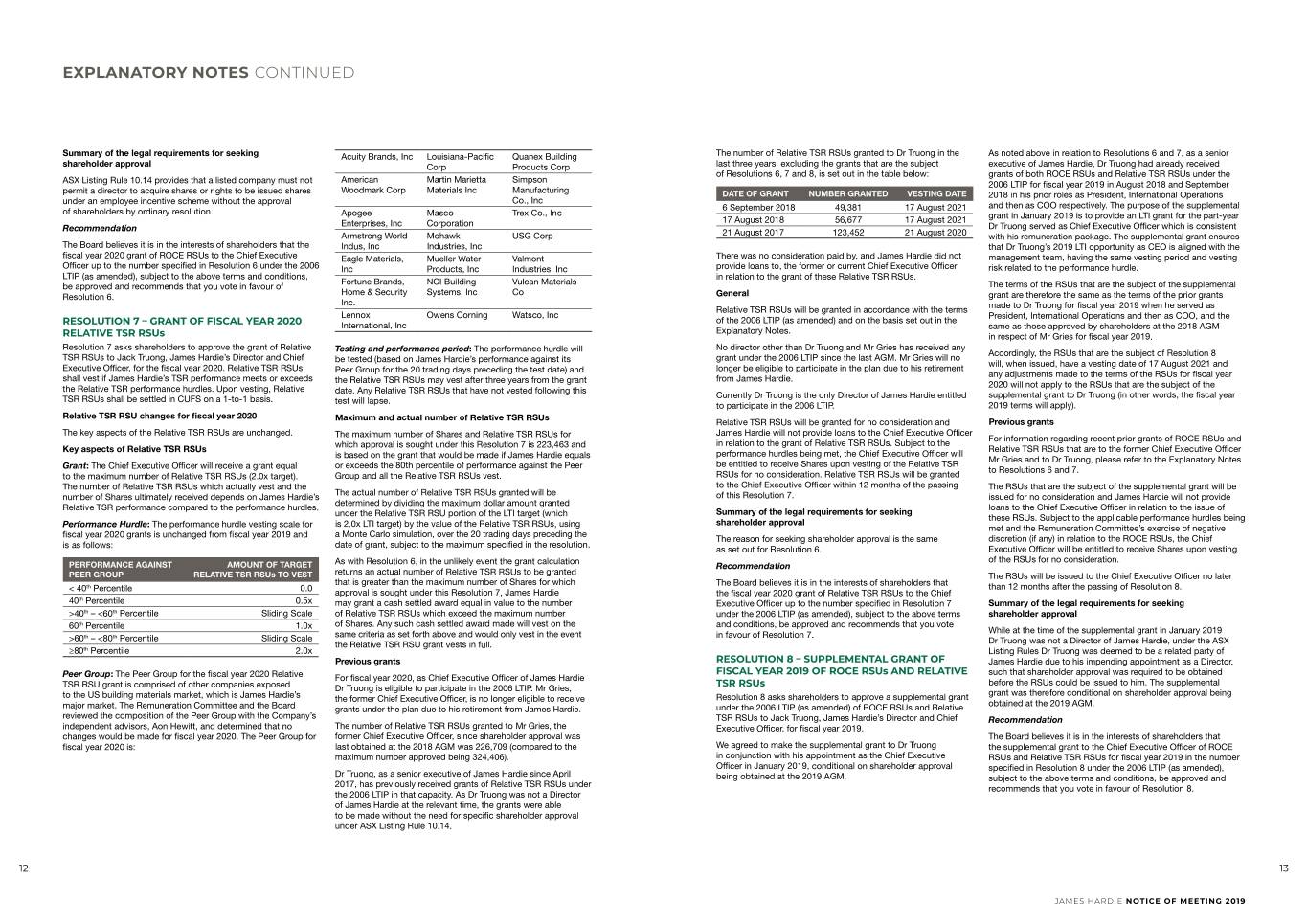
EXPLANATORY NOTES CONTINUED Summary of the legal requirements for seeking Acuity Brands, Inc Louisiana-Pacific Quanex Building The number of Relative TSR RSUs granted to Dr Truong in the As noted above in relation to Resolutions 6 and 7, as a senior shareholder approval Corp Products Corp last three years, excluding the grants that are the subject executive of James Hardie, Dr Truong had already received of Resolutions 6, 7 and 8, is set out in the table below: grants of both ROCE RSUs and Relative TSR RSUs under the American Martin Marietta Simpson ASX Listing Rule 10.14 provides that a listed company must not 2006 LTIP for fiscal year 2019 in August 2018 and September Woodmark Corp Materials Inc Manufacturing permit a director to acquire shares or rights to be issued shares DATE OF GRANT NUMBER GRANTED VESTING DATE 2018 in his prior roles as President, International Operations under an employee incentive scheme without the approval Co., Inc 6 September 2018 49,381 17 August 2021 and then as COO respectively. The purpose of the supplemental of shareholders by ordinary resolution. Apogee Masco Trex Co., Inc grant in January 2019 is to provide an LTI grant for the part-year Enterprises, Inc Corporation 17 August 2018 56,677 17 August 2021 Recommendation Dr Truong served as Chief Executive Officer which is consistent Armstrong World Mohawk USG Corp 21 August 2017 123,452 21 August 2020 with his remuneration package. The supplemental grant ensures The Board believes it is in the interests of shareholders that the Indus, Inc Industries, Inc that Dr Truong’s 2019 LTI opportunity as CEO is aligned with the fiscal year 2020 grant of ROCE RSUs to the Chief Executive Eagle Materials, Mueller Water Valmont There was no consideration paid by, and James Hardie did not management team, having the same vesting period and vesting Officer up to the number specified in Resolution 6 under the 2006 Inc Products, Inc Industries, Inc provide loans to, the former or current Chief Executive Officer risk related to the performance hurdle. LTIP (as amended), subject to the above terms and conditions, in relation to the grant of these Relative TSR RSUs. Fortune Brands, NCI Building Vulcan Materials be approved and recommends that you vote in favour of The terms of the RSUs that are the subject of the supplemental Home & Security Systems, Inc Co Resolution 6. General grant are therefore the same as the terms of the prior grants Inc. made to Dr Truong for fiscal year 2019 when he served as Relative TSR RSUs will be granted in accordance with the terms Lennox Owens Corning Watsco, Inc President, International Operations and then as COO, and the of the 2006 LTIP (as amended) and on the basis set out in the RESOLUTION 7 – GRANT OF FISCAL YEAR 2020 International, Inc same as those approved by shareholders at the 2018 AGM Explanatory Notes. RELATIVE TSR RSUs in respect of Mr Gries for fiscal year 2019. Resolution 7 asks shareholders to approve the grant of Relative Testing and performance period: The performance hurdle will No director other than Dr Truong and Mr Gries has received any Accordingly, the RSUs that are the subject of Resolution 8 TSR RSUs to Jack Truong, James Hardie’s Director and Chief be tested (based on James Hardie’s performance against its grant under the 2006 LTIP since the last AGM. Mr Gries will no will, when issued, have a vesting date of 17 August 2021 and Executive Officer, for the fiscal year 2020. Relative TSR RSUs Peer Group for the 20 trading days preceding the test date) and longer be eligible to participate in the plan due to his retirement any adjustments made to the terms of the RSUs for fiscal year shall vest if James Hardie’s TSR performance meets or exceeds the Relative TSR RSUs may vest after three years from the grant from James Hardie. 2020 will not apply to the RSUs that are the subject of the the Relative TSR performance hurdles. Upon vesting, Relative date. Any Relative TSR RSUs that have not vested following this Currently Dr Truong is the only Director of James Hardie entitled supplemental grant to Dr Truong (in other words, the fiscal year TSR RSUs shall be settled in CUFS on a 1-to-1 basis. test will lapse. to participate in the 2006 LTIP. 2019 terms will apply). Relative TSR RSU changes for fiscal year 2020 Maximum and actual number of Relative TSR RSUs Relative TSR RSUs will be granted for no consideration and Previous grants The key aspects of the Relative TSR RSUs are unchanged. The maximum number of Shares and Relative TSR RSUs for James Hardie will not provide loans to the Chief Executive Officer For information regarding recent prior grants of ROCE RSUs and which approval is sought under this Resolution 7 is 223,463 and in relation to the grant of Relative TSR RSUs. Subject to the Key aspects of Relative TSR RSUs Relative TSR RSUs that are to the former Chief Executive Officer is based on the grant that would be made if James Hardie equals performance hurdles being met, the Chief Executive Officer will Mr Gries and to Dr Truong, please refer to the Explanatory Notes or exceeds the 80th percentile of performance against the Peer be entitled to receive Shares upon vesting of the Relative TSR Grant: The Chief Executive Officer will receive a grant equal to Resolutions 6 and 7. to the maximum number of Relative TSR RSUs (2.0x target). Group and all the Relative TSR RSUs vest. RSUs for no consideration. Relative TSR RSUs will be granted The number of Relative TSR RSUs which actually vest and the to the Chief Executive Officer within 12 months of the passing The RSUs that are the subject of the supplemental grant will be The actual number of Relative TSR RSUs granted will be number of Shares ultimately received depends on James Hardie’s of this Resolution 7. issued for no consideration and James Hardie will not provide determined by dividing the maximum dollar amount granted Relative TSR performance compared to the performance hurdles. loans to the Chief Executive Officer in relation to the issue of under the Relative TSR RSU portion of the LTI target (which Summary of the legal requirements for seeking these RSUs. Subject to the applicable performance hurdles being is 2.0x LTI target) by the value of the Relative TSR RSUs, using shareholder approval Performance Hurdle: The performance hurdle vesting scale for met and the Remuneration Committee’s exercise of negative fiscal year 2020 grants is unchanged from fiscal year 2019 and a Monte Carlo simulation, over the 20 trading days preceding the The reason for seeking shareholder approval is the same discretion (if any) in relation to the ROCE RSUs, the Chief is as follows: date of grant, subject to the maximum specified in the resolution. as set out for Resolution 6. Executive Officer will be entitled to receive Shares upon vesting As with Resolution 6, in the unlikely event the grant calculation of the RSUs for no consideration. PERFORMANCE AGAINST AMOUNT OF TARGET Recommendation returns an actual number of Relative TSR RSUs to be granted PEER GROUP RELATIVE TSR RSUs TO VEST The RSUs will be issued to the Chief Executive Officer no later that is greater than the maximum number of Shares for which The Board believes it is in the interests of shareholders that < 40th Percentile 0.0 than 12 months after the passing of Resolution 8. approval is sought under this Resolution 7, James Hardie the fiscal year 2020 grant of Relative TSR RSUs to the Chief th 40 Percentile 0.5x may grant a cash settled award equal in value to the number Executive Officer up to the number specified in Resolution 7 Summary of the legal requirements for seeking >40th – <60th Percentile Sliding Scale of Relative TSR RSUs which exceed the maximum number under the 2006 LTIP (as amended), subject to the above terms shareholder approval 60th Percentile 1.0x of Shares. Any such cash settled award made will vest on the and conditions, be approved and recommends that you vote While at the time of the supplemental grant in January 2019 >60th – <80th Percentile Sliding Scale same criteria as set forth above and would only vest in the event in favour of Resolution 7. the Relative TSR RSU grant vests in full. Dr Truong was not a Director of James Hardie, under the ASX ≥80th Percentile 2.0x Listing Rules Dr Truong was deemed to be a related party of Previous grants RESOLUTION 8 – SUPPLEMENTAL GRANT OF James Hardie due to his impending appointment as a Director, FISCAL YEAR 2019 OF ROCE RSUs AND RELATIVE such that shareholder approval was required to be obtained Peer Group: The Peer Group for the fiscal year 2020 Relative For fiscal year 2020, as Chief Executive Officer of James Hardie before the RSUs could be issued to him. The supplemental TSR RSU grant is comprised of other companies exposed Dr Truong is eligible to participate in the 2006 LTIP. Mr Gries, TSR RSUs grant was therefore conditional on shareholder approval being to the US building materials market, which is James Hardie’s the former Chief Executive Officer, is no longer eligible to receive Resolution 8 asks shareholders to approve a supplemental grant obtained at the 2019 AGM. major market. The Remuneration Committee and the Board grants under the plan due to his retirement from James Hardie. under the 2006 LTIP (as amended) of ROCE RSUs and Relative reviewed the composition of the Peer Group with the Company’s TSR RSUs to Jack Truong, James Hardie’s Director and Chief Recommendation independent advisors, Aon Hewitt, and determined that no The number of Relative TSR RSUs granted to Mr Gries, the Executive Officer, for fiscal year 2019. changes would be made for fiscal year 2020. The Peer Group for former Chief Executive Officer, since shareholder approval was The Board believes it is in the interests of shareholders that fiscal year 2020 is: last obtained at the 2018 AGM was 226,709 (compared to the We agreed to make the supplemental grant to Dr Truong the supplemental grant to the Chief Executive Officer of ROCE maximum number approved being 324,406). in conjunction with his appointment as the Chief Executive RSUs and Relative TSR RSUs for fiscal year 2019 in the number Officer in January 2019, conditional on shareholder approval specified in Resolution 8 under the 2006 LTIP (as amended), Dr Truong, as a senior executive of James Hardie since April being obtained at the 2019 AGM. subject to the above terms and conditions, be approved and 2017, has previously received grants of Relative TSR RSUs under recommends that you vote in favour of Resolution 8. the 2006 LTIP in that capacity. As Dr Truong was not a Director of James Hardie at the relevant time, the grants were able to be made without the need for specific shareholder approval under ASX Listing Rule 10.14. 12 13 JAMES HARDIE NOTICE OF MEETING 2019
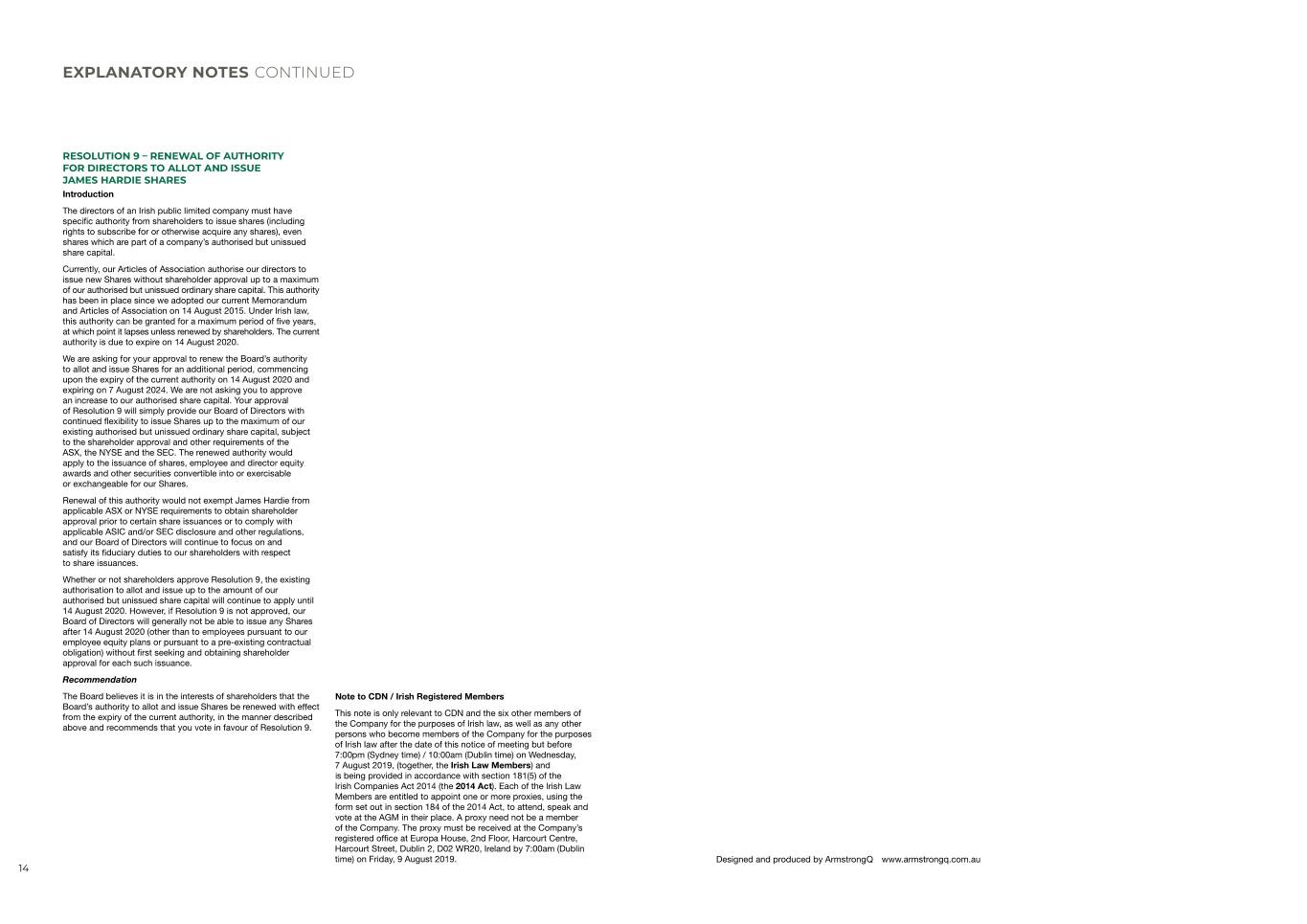
EXPLANATORY NOTES CONTINUED RESOLUTION 9 – RENEWAL OF AUTHORITY FOR DIRECTORS TO ALLOT AND ISSUE JAMES HARDIE SHARES Introduction The directors of an Irish public limited company must have specific authority from shareholders to issue shares (including rights to subscribe for or otherwise acquire any shares), even shares which are part of a company’s authorised but unissued share capital. Currently, our Articles of Association authorise our directors to issue new Shares without shareholder approval up to a maximum of our authorised but unissued ordinary share capital. This authority has been in place since we adopted our current Memorandum and Articles of Association on 14 August 2015. Under Irish law, this authority can be granted for a maximum period of five years, at which point it lapses unless renewed by shareholders. The current authority is due to expire on 14 August 2020. We are asking for your approval to renew the Board’s authority to allot and issue Shares for an additional period, commencing upon the expiry of the current authority on 14 August 2020 and expiring on 7 August 2024. We are not asking you to approve an increase to our authorised share capital. Your approval of Resolution 9 will simply provide our Board of Directors with continued flexibility to issue Shares up to the maximum of our existing authorised but unissued ordinary share capital, subject to the shareholder approval and other requirements of the ASX, the NYSE and the SEC. The renewed authority would apply to the issuance of shares, employee and director equity awards and other securities convertible into or exercisable or exchangeable for our Shares. Renewal of this authority would not exempt James Hardie from applicable ASX or NYSE requirements to obtain shareholder approval prior to certain share issuances or to comply with applicable ASIC and/or SEC disclosure and other regulations, and our Board of Directors will continue to focus on and satisfy its fiduciary duties to our shareholders with respect to share issuances. Whether or not shareholders approve Resolution 9, the existing authorisation to allot and issue up to the amount of our authorised but unissued share capital will continue to apply until 14 August 2020. However, if Resolution 9 is not approved, our Board of Directors will generally not be able to issue any Shares after 14 August 2020 (other than to employees pursuant to our employee equity plans or pursuant to a pre-existing contractual obligation) without first seeking and obtaining shareholder approval for each such issuance. Recommendation The Board believes it is in the interests of shareholders that the Note to CDN / Irish Registered Members Board’s authority to allot and issue Shares be renewed with effect from the expiry of the current authority, in the manner described This note is only relevant to CDN and the six other members of above and recommends that you vote in favour of Resolution 9. the Company for the purposes of Irish law, as well as any other persons who become members of the Company for the purposes of Irish law after the date of this notice of meeting but before 7:00pm (Sydney time) / 10:00am (Dublin time) on Wednesday, 7 August 2019, (together, the Irish Law Members) and is being provided in accordance with section 181(5) of the Irish Companies Act 2014 (the 2014 Act). Each of the Irish Law Members are entitled to appoint one or more proxies, using the form set out in section 184 of the 2014 Act, to attend, speak and vote at the AGM in their place. A proxy need not be a member of the Company. The proxy must be received at the Company’s registered office at Europa House, 2nd Floor, Harcourt Centre, Harcourt Street, Dublin 2, D02 WR20, Ireland by 7:00am (Dublin time) on Friday, 9 August 2019. Designed and produced by ArmstrongQ www.armstrongq.com.au 14

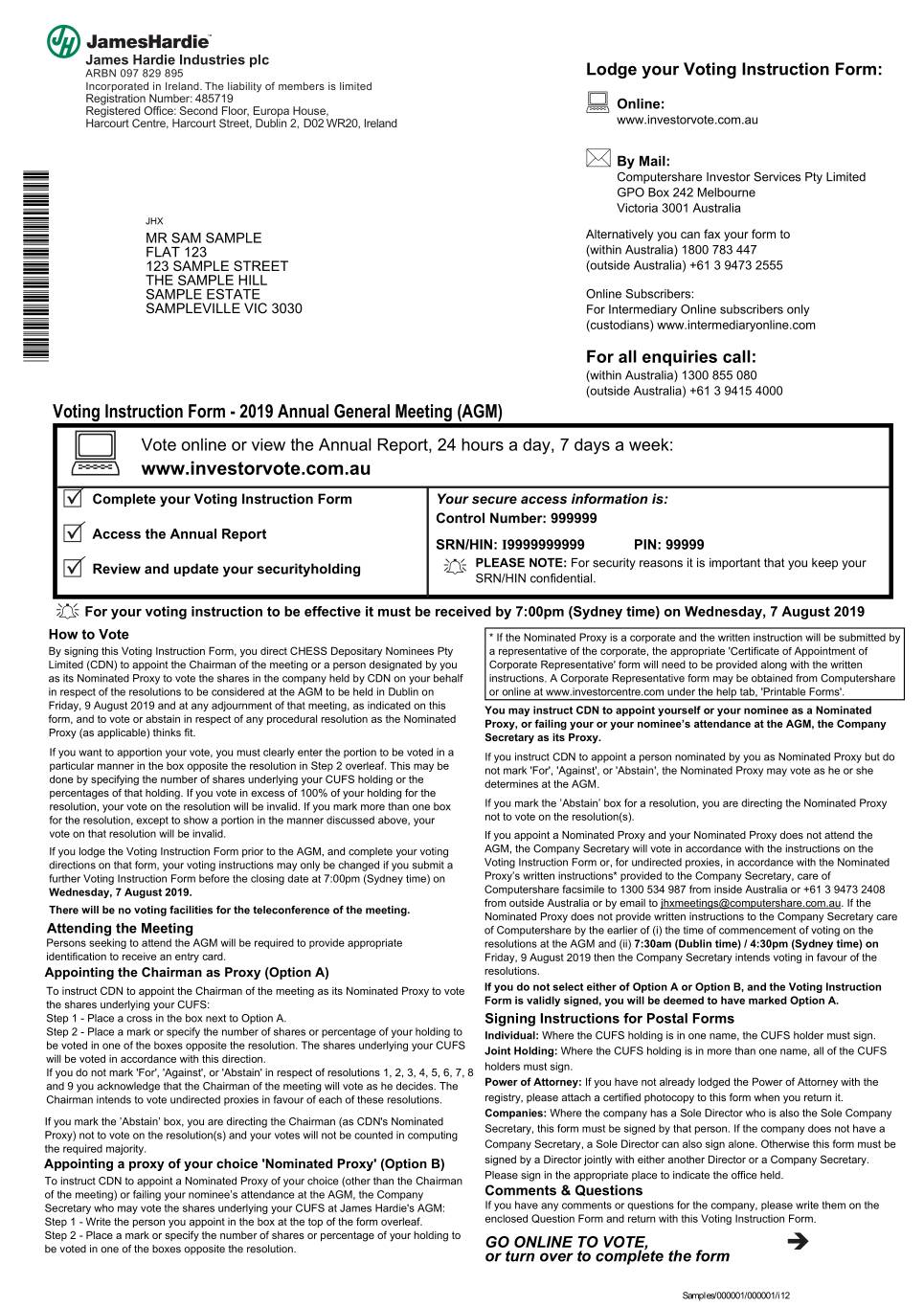
Lodge your Voting Instruction Form: Online: www.investorvote.com.au By Mail: Computershare Investor Services Pty Limited GPO Box 242 Melbourne Victoria 3001 Australia JHX MR SAM SAMPLE Alternatively you can fax your form to FLAT 123 (within Australia) 1800 783 447 123 SAMPLE STREET (outside Australia) +61 3 9473 2555 THE SAMPLE HILL SAMPLE ESTATE Online Subscribers: SAMPLEVILLE VIC 3030 For Intermediary Online subscribers only (custodians) www.intermediaryonline.com *S00000112Q01* For all enquiries call: (within Australia) 1300 855 080 (outside Australia) +61 3 9415 4000 Voting Instruction Form - 2019 Annual General Meeting (AGM) Vote online or view the Annual Report, 24 hours a day, 7 days a week: www.investorvote.com.au Complete your Voting Instruction Form Your secure access information is: Control Number: 999999 Access the Annual Report SRN/HIN: I9999999999 PIN: 99999 Review and update your securityholding PLEASE NOTE: For security reasons it is important that you keep your SRN/HIN confidential. For your voting instruction to be effective it must be received by 7:00pm (Sydney time) on Wednesday, 7 August 2019 How to Vote * If the Nominated Proxy is a corporate and the written instruction will be submitted by By signing this Voting Instruction Form, you direct CHESS Depositary Nominees Pty a representative of the corporate, the appropriate 'Certificate of Appointment of Limited (CDN) to appoint the Chairman of the meeting or a person designated by you Corporate Representative' form will need to be provided along with the written as its Nominated Proxy to vote the shares in the company held by CDN on your behalf instructions. A Corporate Representative form may be obtained from Computershare in respect of the resolutions to be considered at the AGM to be held in Dublin on or online at www.investorcentre.com under the help tab, 'Printable Forms'. Friday, 9 August 2019 and at any adjournment of that meeting, as indicated on this You may instruct CDN to appoint yourself or your nominee as a Nominated form, and to vote or abstain in respect of any procedural resolution as the Nominated Proxy, or failing your or your nominee’s attendance at the AGM, the Company Proxy (as applicable) thinks fit. Secretary as its Proxy. If you want to apportion your vote, you must clearly enter the portion to be voted in a If you instruct CDN to appoint a person nominated by you as Nominated Proxy but do particular manner in the box opposite the resolution in Step 2 overleaf. This may be not mark 'For', 'Against', or 'Abstain', the Nominated Proxy may vote as he or she done by specifying the number of shares underlying your CUFS holding or the determines at the AGM. percentages of that holding. If you vote in excess of 100% of your holding for the resolution, your vote on the resolution will be invalid. If you mark more than one box If you mark the ’Abstain’ box for a resolution, you are directing the Nominated Proxy for the resolution, except to show a portion in the manner discussed above, your not to vote on the resolution(s). vote on that resolution will be invalid. If you appoint a Nominated Proxy and your Nominated Proxy does not attend the If you lodge the Voting Instruction Form prior to the AGM, and complete your voting AGM, the Company Secretary will vote in accordance with the instructions on the directions on that form, your voting instructions may only be changed if you submit a Voting Instruction Form or, for undirected proxies, in accordance with the Nominated further Voting Instruction Form before the closing date at 7:00pm (Sydney time) on Proxy’s written instructions* provided to the Company Secretary, care of Wednesday, 7 August 2019. Computershare facsimile to 1300 534 987 from inside Australia or +61 3 9473 2408 from outside Australia or by email to [email protected]. If the There will be no voting facilities for the teleconference of the meeting. Nominated Proxy does not provide written instructions to the Company Secretary care Attending the Meeting of Computershare by the earlier of (i) the time of commencement of voting on the Persons seeking to attend the AGM will be required to provide appropriate resolutions at the AGM and (ii) 7:30am (Dublin time) / 4:30pm (Sydney time) on identification to receive an entry card. Friday, 9 August 2019 then the Company Secretary intends voting in favour of the Appointing the Chairman as Proxy (Option A) resolutions. To instruct CDN to appoint the Chairman of the meeting as its Nominated Proxy to vote If you do not select either of Option A or Option B, and the Voting Instruction the shares underlying your CUFS: Form is validly signed, you will be deemed to have marked Option A. Step 1 - Place a cross in the box next to Option A. Signing Instructions for Postal Forms Step 2 - Place a mark or specify the number of shares or percentage of your holding to Individual: Where the CUFS holding is in one name, the CUFS holder must sign. be voted in one of the boxes opposite the resolution. The shares underlying your CUFS Joint Holding: Where the CUFS holding is in more than one name, all of the CUFS will be voted in accordance with this direction. holders must sign. If you do not mark 'For', 'Against', or 'Abstain' in respect of resolutions 1, 2, 3, 4, 5, 6, 7, 8 and 9 you acknowledge that the Chairman of the meeting will vote as he decides. The Power of Attorney: If you have not already lodged the Power of Attorney with the Chairman intends to vote undirected proxies in favour of each of these resolutions. registry, please attach a certified photocopy to this form when you return it. Companies: Where the company has a Sole Director who is also the Sole Company If you mark the ’Abstain’ box, you are directing the Chairman (as CDN's Nominated Secretary, this form must be signed by that person. If the company does not have a Proxy) not to vote on the resolution(s) and your votes will not be counted in computing the required majority. Company Secretary, a Sole Director can also sign alone. Otherwise this form must be Appointing a proxy of your choice 'Nominated Proxy' (Option B) signed by a Director jointly with either another Director or a Company Secretary. Please sign in the appropriate place to indicate the office held. To instruct CDN to appoint a Nominated Proxy of your choice (other than the Chairman of the meeting) or failing your nominee’s attendance at the AGM, the Company Comments & Questions Secretary who may vote the shares underlying your CUFS at James Hardie's AGM: If you have any comments or questions for the company, please write them on the Step 1 - Write the person you appoint in the box at the top of the form overleaf. enclosed Question Form and return with this Voting Instruction Form. Step 2 - Place a mark or specify the number of shares or percentage of your holding to GO ONLINE TO VOTE, be voted in one of the boxes opposite the resolution. or turn over to complete the form Samples/000001/000001/i12
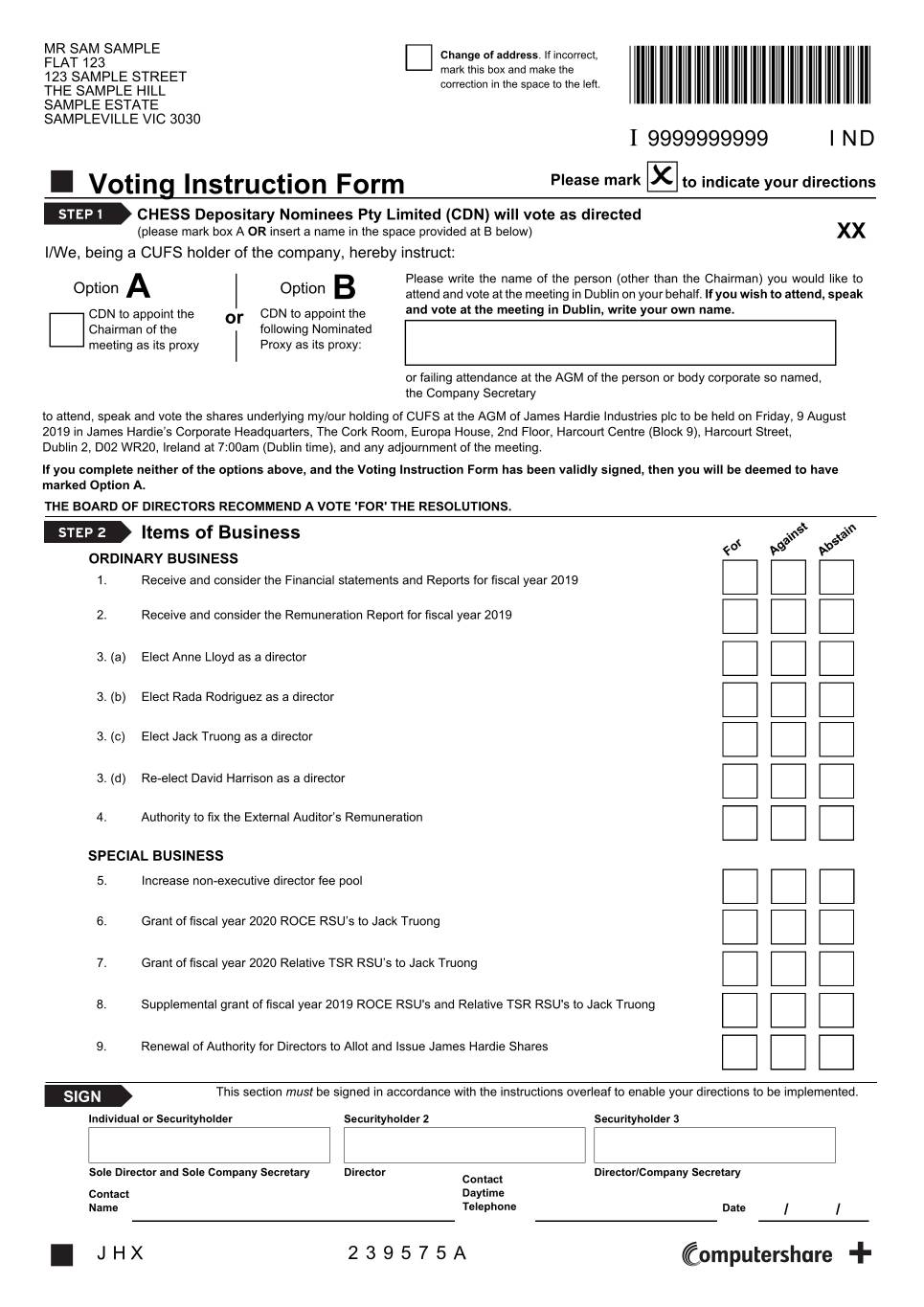
MR SAM SAMPLE Change of address. If incorrect, FLAT 123 mark this box and make the 123 SAMPLE STREET THE SAMPLE HILL correction in the space to the left. SAMPLE ESTATE SAMPLEVILLE VIC 3030 I 9999999999 I ND Voting Instruction Form Please mark to indicate your directions STEP 1 CHESS Depositary Nominees Pty Limited (CDN) will vote as directed (please mark box A OR insert a name in the space provided at B below) XX I/We, being a CUFS holder of the company, hereby instruct: Please write the name of the person (other than the Chairman) you would like to Option A Option B attend and vote at the meeting in Dublin on your behalf. If you wish to attend, speak CDN to appoint the or CDN to appoint the and vote at the meeting in Dublin, write your own name. Chairman of the following Nominated meeting as its proxy Proxy as its proxy: or failing attendance at the AGM of the person or body corporate so named, the Company Secretary to attend, speak and vote the shares underlying my/our holding of CUFS at the AGM of James Hardie Industries plc to be held on Friday, 9 August 2019 in James Hardie’s Corporate Headquarters, The Cork Room, Europa House, 2nd Floor, Harcourt Centre (Block 9), Harcourt Street, Dublin 2, D02 WR20, Ireland at 7:00am (Dublin time), and any adjournment of the meeting. If you complete neither of the options above, and the Voting Instruction Form has been validly signed, then you will be deemed to have marked Option A. THE BOARD OF DIRECTORS RECOMMEND A VOTE 'FOR' THE RESOLUTIONS. STEP 2 Items of Business ORDINARY BUSINESS 1. Receive and consider the Financial statements and Reports for fiscal year 2019 2. Receive and consider the Remuneration Report for fiscal year 2019 3. (a) Elect Anne Lloyd as a director 3. (b) Elect Rada Rodriguez as a director 3. (c) Elect Jack Truong as a director 3. (d) Re-elect David Harrison as a director 4. Authority to fix the External Auditor’s Remuneration SPECIAL BUSINESS 5. Increase non-executive director fee pool 6. Grant of fiscal year 2020 ROCE RSU’s to Jack Truong 7. Grant of fiscal year 2020 Relative TSR RSU’s to Jack Truong 8. Supplemental grant of fiscal year 2019 ROCE RSU's and Relative TSR RSU's to Jack Truong 9. Renewal of Authority for Directors to Allot and Issue James Hardie Shares SIGN This section must be signed in accordance with the instructions overleaf to enable your directions to be implemented. Individual or Securityholder Securityholder 2 Securityholder 3 Sole Director and Sole Company Secretary Director Director/Company Secretary Contact Contact Daytime Name Telephone Date / / J H X 2 3 9 5 7 5 A

WE WELCOME YOUR QUESTIONS QUESTION FORM We want to make it easy for as many James Hardie shareholders PLEASE PROVIDE YOUR DETAILS BELOW: as possible to ask questions of the Company’s Directors. Please use the other side of this form to send us any questions you would Holder’s name: like answered at the Annual General Meeting to be held on Friday, 9 August 2019, in Dublin, Ireland. We believe this process will make it easier for more shareholders to have questions answered, whether or not they can attend the meeting. You will also be able to ask questions from the floor at the meeting or through the teleconference facility. Address: We will attempt to answer as many questions as possible in the addresses by the Chairman and the CEO. If we receive a large number of questions from holders, we may not be able to reply individually. Please use this form even if you will be attending the meeting. To return this form to us, please: Fax this form by Wednesday, 7 August 2019 to: (02) 9251 9805 or +61 2 9251 9805 OR Mail this form by Monday, 5 August 2019: Security Holder Reference Number or Holder Identification Number: using the Business Reply Envelope enclosed OR Email this form by Wednesday, 7 August 2019 to: [email protected]
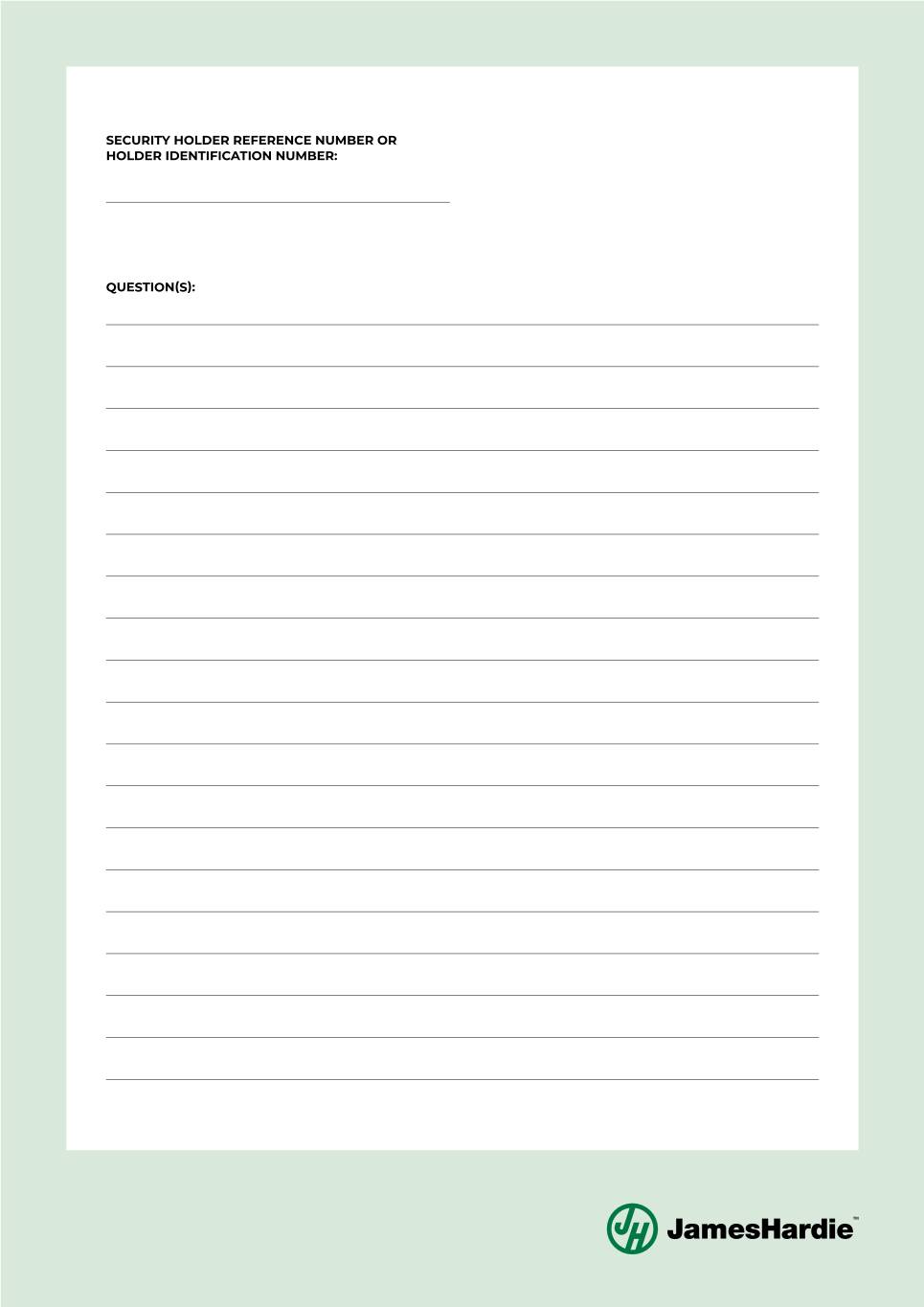
SECURITY HOLDER REFERENCE NUMBER OR HOLDER IDENTIFICATION NUMBER: QUESTION(S):
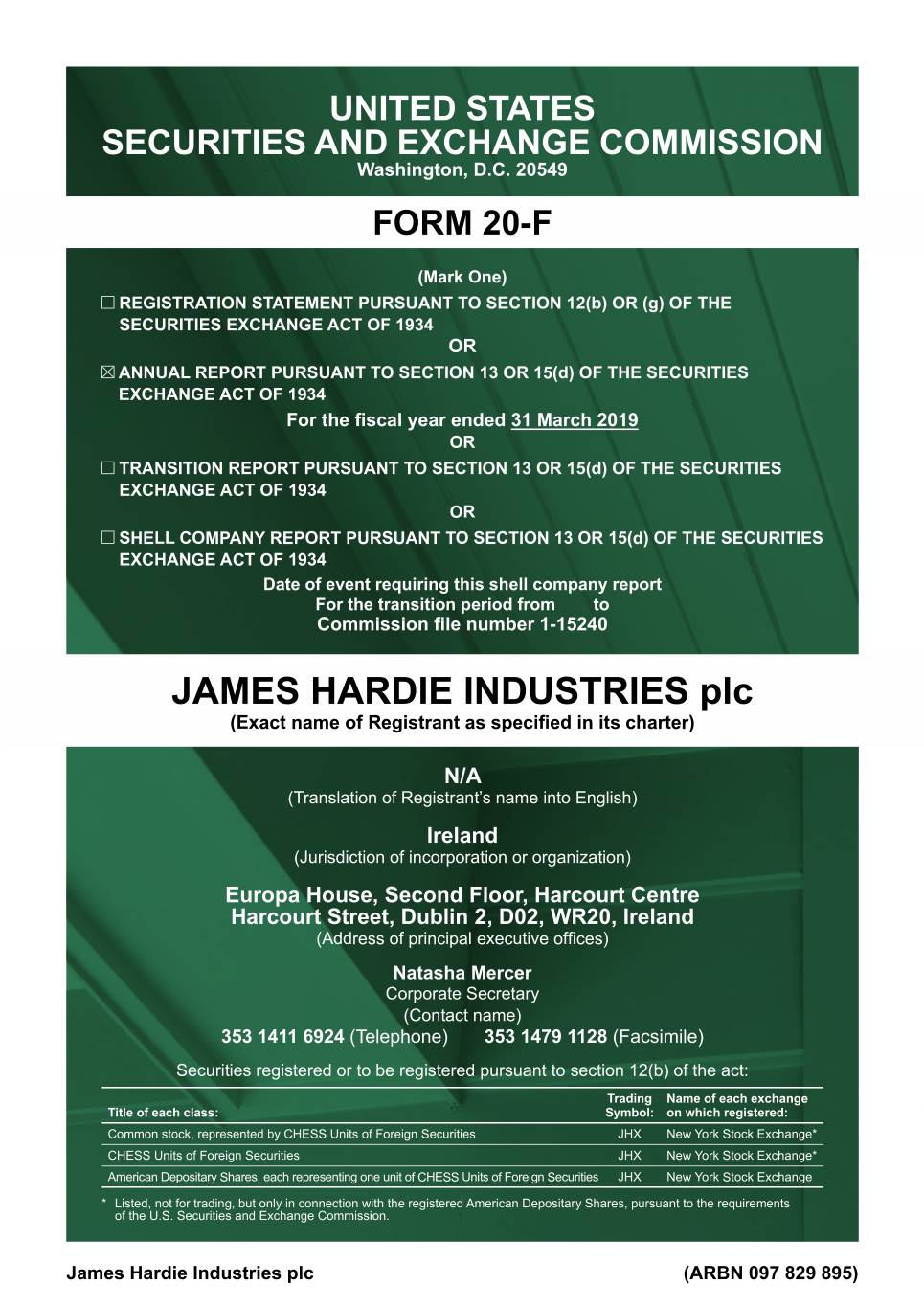
UNITED STATES SECURITIES AND EXCHANGE COMMISSION Washington, D.C. 20549 FORM 20-F (Mark One) REGISTRATION STATEMENT PURSUANT TO SECTION 12(b) OR (g) OF THE SECURITIES EXCHANGE ACT OF 1934 OR ANNUAL REPORT PURSUANT TO SECTION 13 OR 15(d) OF THE SECURITIES EXCHANGE ACT OF 1934 For the fiscal year ended 31 March 2019 OR TRANSITION REPORT PURSUANT TO SECTION 13 OR 15(d) OF THE SECURITIES EXCHANGE ACT OF 1934 OR SHELL COMPANY REPORT PURSUANT TO SECTION 13 OR 15(d) OF THE SECURITIES EXCHANGE ACT OF 1934 Date of event requiring this shell company report For the transition period from to Commission file number 1-15240 JAMES HARDIE INDUSTRIES plc (Exact name of Registrant as specified in its charter) N/A (Translation of Registrant’s name into English) Ireland (Jurisdiction of incorporation or organization) Europa House, Second Floor, Harcourt Centre Harcourt Street, Dublin 2, D02, WR20, Ireland (Address of principal executive offices) Natasha Mercer Corporate Secretary (Contact name) 353 1411 6924 (Telephone) 353 1479 1128 (Facsimile) Securities registered or to be registered pursuant to section 12(b) of the act: Trading Name of each exchange Title of each class: Symbol: on which registered: Common stock, represented by CHESS Units of Foreign Securities JHX New York Stock Exchange* CHESS Units of Foreign Securities JHX New York Stock Exchange* American Depositary Shares, each representing one unit of CHESS Units of Foreign Securities JHX New York Stock Exchange * Listed, not for trading, but only in connection with the registered American Depositary Shares, pursuant to the requirements of the U.S. Securities and Exchange Commission. James Hardie Industries plc (ARBN 097 829 895)
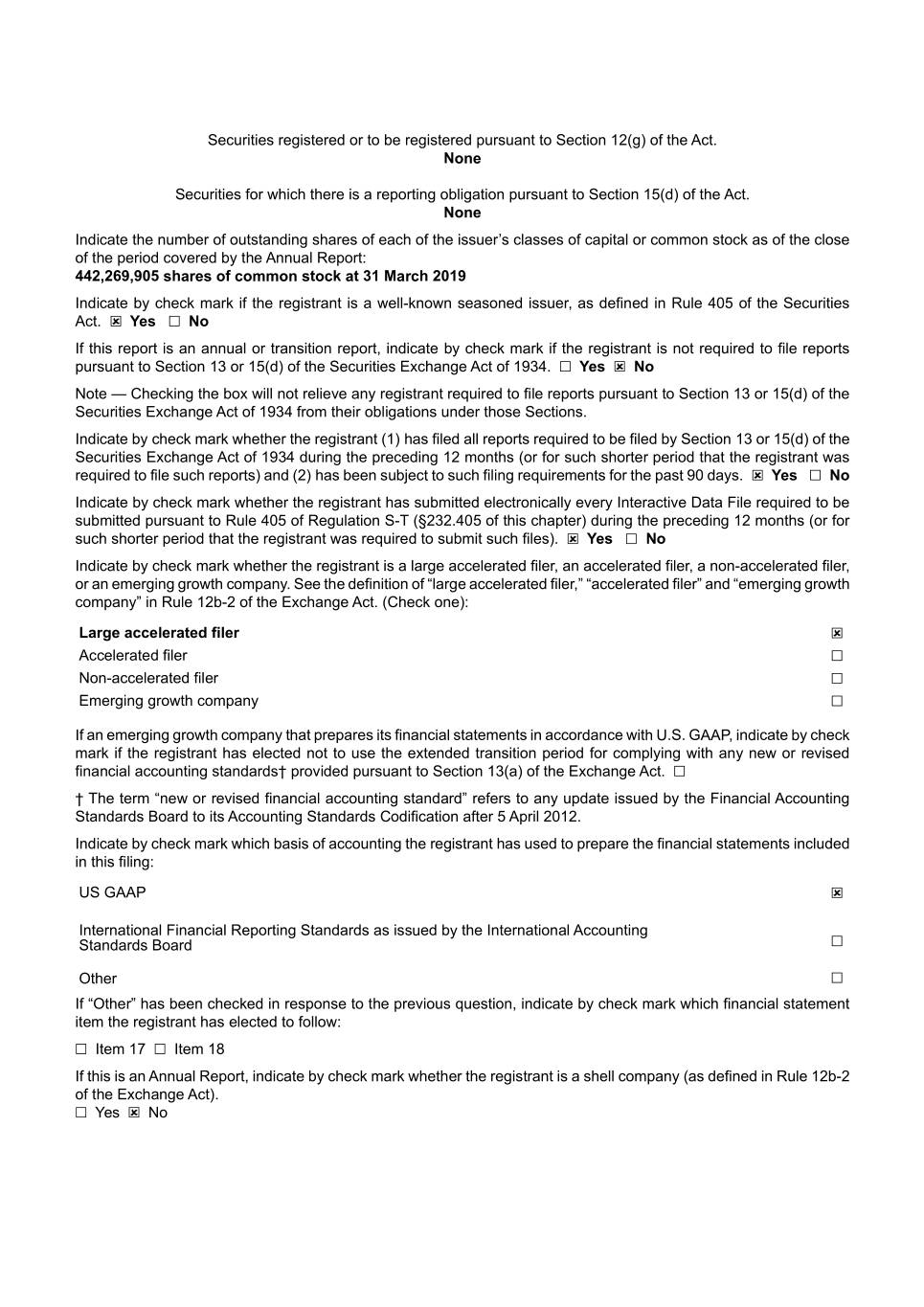
Table of Contents Securities registered or to be registered pursuant to Section 12(g) of the Act. None Securities for which there is a reporting obligation pursuant to Section 15(d) of the Act. None Indicate the number of outstanding shares of each of the issuer’s classes of capital or common stock as of the close of the period covered by the Annual Report: 442,269,905 shares of common stock at 31 March 2019 Indicate by check mark if the registrant is a well-known seasoned issuer, as defined in Rule 405 of the Securities Act. ☒ Yes ☐ No If this report is an annual or transition report, indicate by check mark if the registrant is not required to file reports pursuant to Section 13 or 15(d) of the Securities Exchange Act of 1934. ☐ Yes ☒ No Note — Checking the box will not relieve any registrant required to file reports pursuant to Section 13 or 15(d) of the Securities Exchange Act of 1934 from their obligations under those Sections. Indicate by check mark whether the registrant (1) has filed all reports required to be filed by Section 13 or 15(d) of the Securities Exchange Act of 1934 during the preceding 12 months (or for such shorter period that the registrant was required to file such reports) and (2) has been subject to such filing requirements for the past 90 days. ☒ Yes ☐ No Indicate by check mark whether the registrant has submitted electronically every Interactive Data File required to be submitted pursuant to Rule 405 of Regulation S-T (§232.405 of this chapter) during the preceding 12 months (or for such shorter period that the registrant was required to submit such files). ☒ Yes ☐ No Indicate by check mark whether the registrant is a large accelerated filer, an accelerated filer, a non-accelerated filer, or an emerging growth company. See the definition of “large accelerated filer,” “accelerated filer” and “emerging growth company” in Rule 12b-2 of the Exchange Act. (Check one): Large accelerated filer ☒ Accelerated filer ☐ Non-accelerated filer ☐ Emerging growth company ☐ If an emerging growth company that prepares its financial statements in accordance with U.S. GAAP, indicate by check mark if the registrant has elected not to use the extended transition period for complying with any new or revised financial accounting standards† provided pursuant to Section 13(a) of the Exchange Act. ☐ † The term “new or revised financial accounting standard” refers to any update issued by the Financial Accounting Standards Board to its Accounting Standards Codification after 5 April 2012. Indicate by check mark which basis of accounting the registrant has used to prepare the financial statements included in this filing: US GAAP ☒ International Financial Reporting Standards as issued by the International Accounting Standards Board ☐ Other ☐ If “Other” has been checked in response to the previous question, indicate by check mark which financial statement item the registrant has elected to follow: ☐ Item 17 ☐ Item 18 If this is an Annual Report, indicate by check mark whether the registrant is a shell company (as defined in Rule 12b-2 of the Exchange Act). ☐ Yes ☒ No
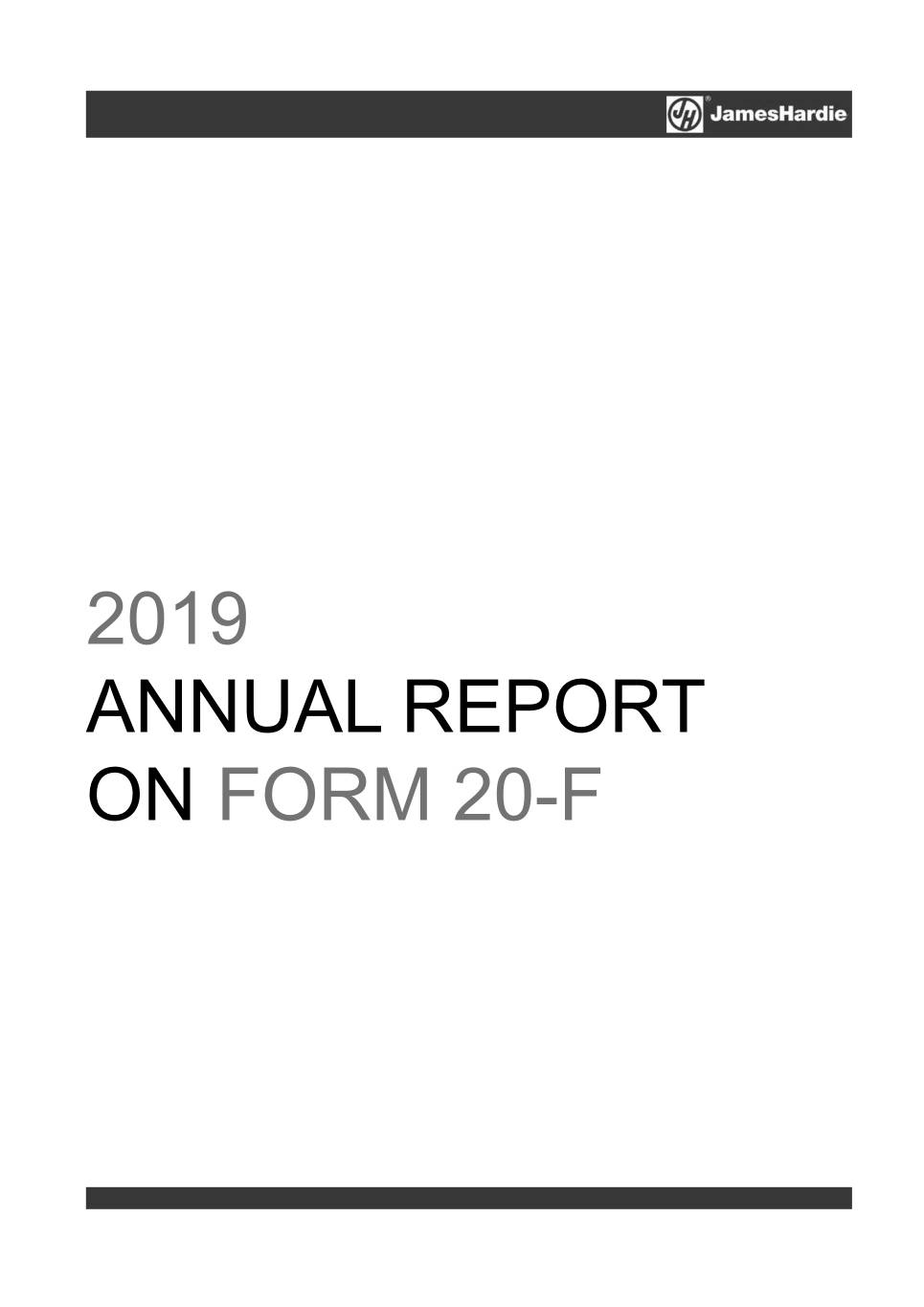
2019 ANNUAL REPORT ON FORM 20-F
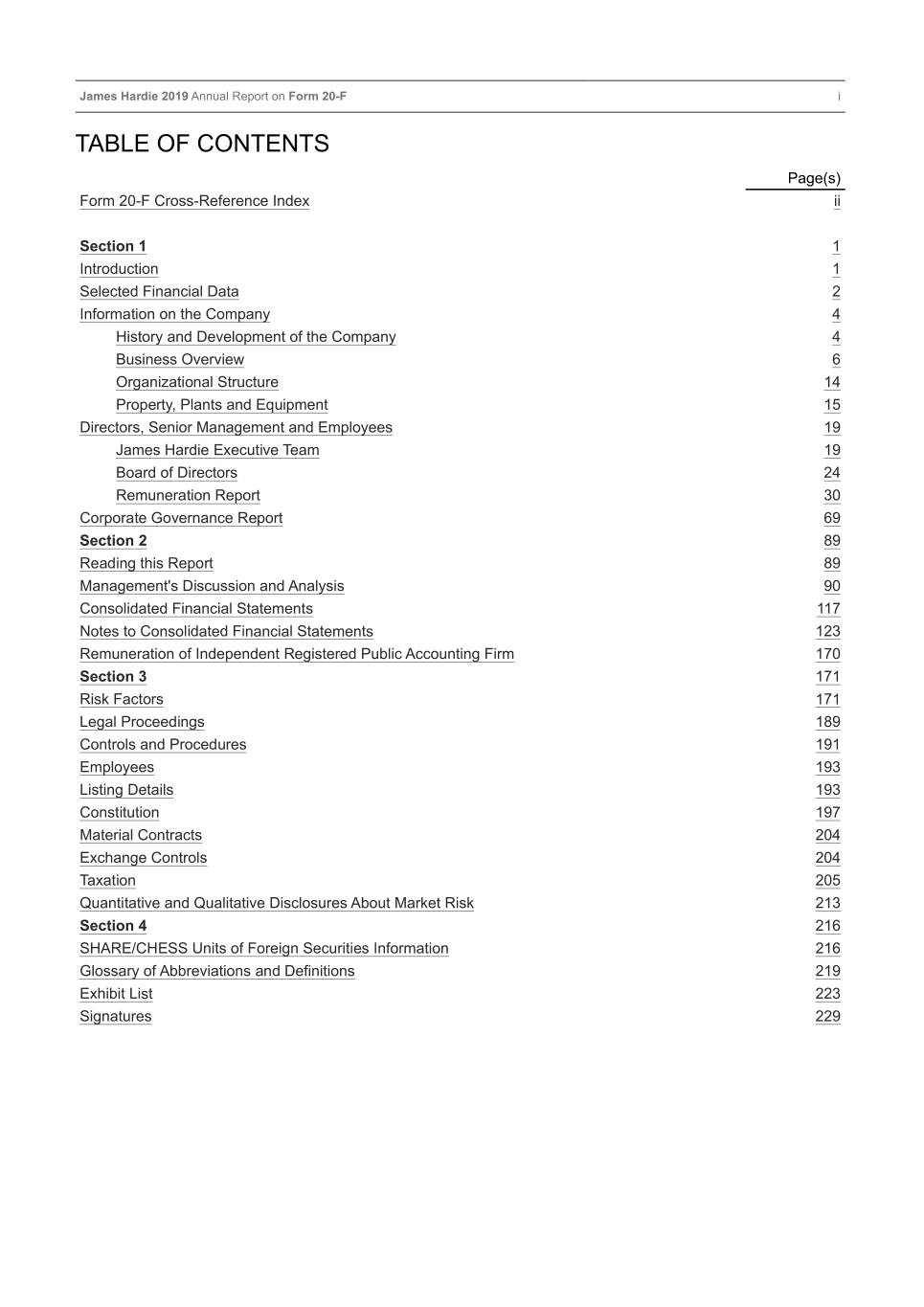
Table of Contents James Hardie 2019 Annual Report on Form 20-F i TABLE OF CONTENTS Page(s) Form 20-F Cross-Reference Index ii Section 1 1 Introduction 1 Selected Financial Data 2 Information on the Company 4 History and Development of the Company 4 Business Overview 6 Organizational Structure 14 Property, Plants and Equipment 15 Directors, Senior Management and Employees 19 James Hardie Executive Team 19 Board of Directors 24 Remuneration Report 30 Corporate Governance Report 69 Section 2 89 Reading this Report 89 Management's Discussion and Analysis 90 Consolidated Financial Statements 117 Notes to Consolidated Financial Statements 123 Remuneration of Independent Registered Public Accounting Firm 170 Section 3 171 Risk Factors 171 Legal Proceedings 189 Controls and Procedures 191 Employees 193 Listing Details 193 Constitution 197 Material Contracts 204 Exchange Controls 204 Taxation 205 Quantitative and Qualitative Disclosures About Market Risk 213 Section 4 216 SHARE/CHESS Units of Foreign Securities Information 216 Glossary of Abbreviations and Definitions 219 Exhibit List 223 Signatures 229

Table of Contents James Hardie 2019 Annual Report on Form 20-F ii FORM 20-F CROSS REFERENCE Page(s) PART 1 Item 1. Identity of Directors, Senior Management and Advisers Not applicable Item 2. Offer Statistics and Expected Timetable Not applicable Item 3. Key Information A. Selected Financial Data 2-3 B. Capitalization and Indebtedness Not applicable C. Reasons for the Offer and Use of Proceeds Not applicable D. Risk Factors 171-188 Item 4. Information on the Company A. History and Development of the Company 4-5; 17-18; 212 B. Business Overview 6-13 C. Organizational Structure 5; 14 D. Property, Plants and Equipment 15-18; 114 Item 4A. Unresolved Staff Comments None Item 5. Operating and Financial Review and Prospects A. Operating Results 95-110 B. Liquidity and Capital Resources 111-115 C. Research and Development, Patents and Licenses, etc. 12 D. Trend Information 115 E. Off-Balance Sheet Arrangements 115-116 F. Tabular Disclosure of Contractual Obligations 116 G. Safe Harbor 89-90 Item 6. Directors, Senior Management and Employees A. Directors and Senior Management 19-29 B. Compensation 30-68 C. Board Practices 24-29; 69-88 D. Employees 193 E. Share Ownership 58-61; 64-68 Item 7. Major Shareholders and Related Party Transactions A. Major Shareholders 216-218 B. Related Party Transactions 80 C. Interests of Experts and Counsel Not Applicable Item 8. Financial Information A. Consolidated Statements and Other Financial Information 117-169; 201-202 B. Significant Changes None Item 9. The Offer and Listing A. Offer and Listing Details 193-196 B. Plan of Distribution Not Applicable C. Markets 194-195 D. Selling Shareholders Not Applicable
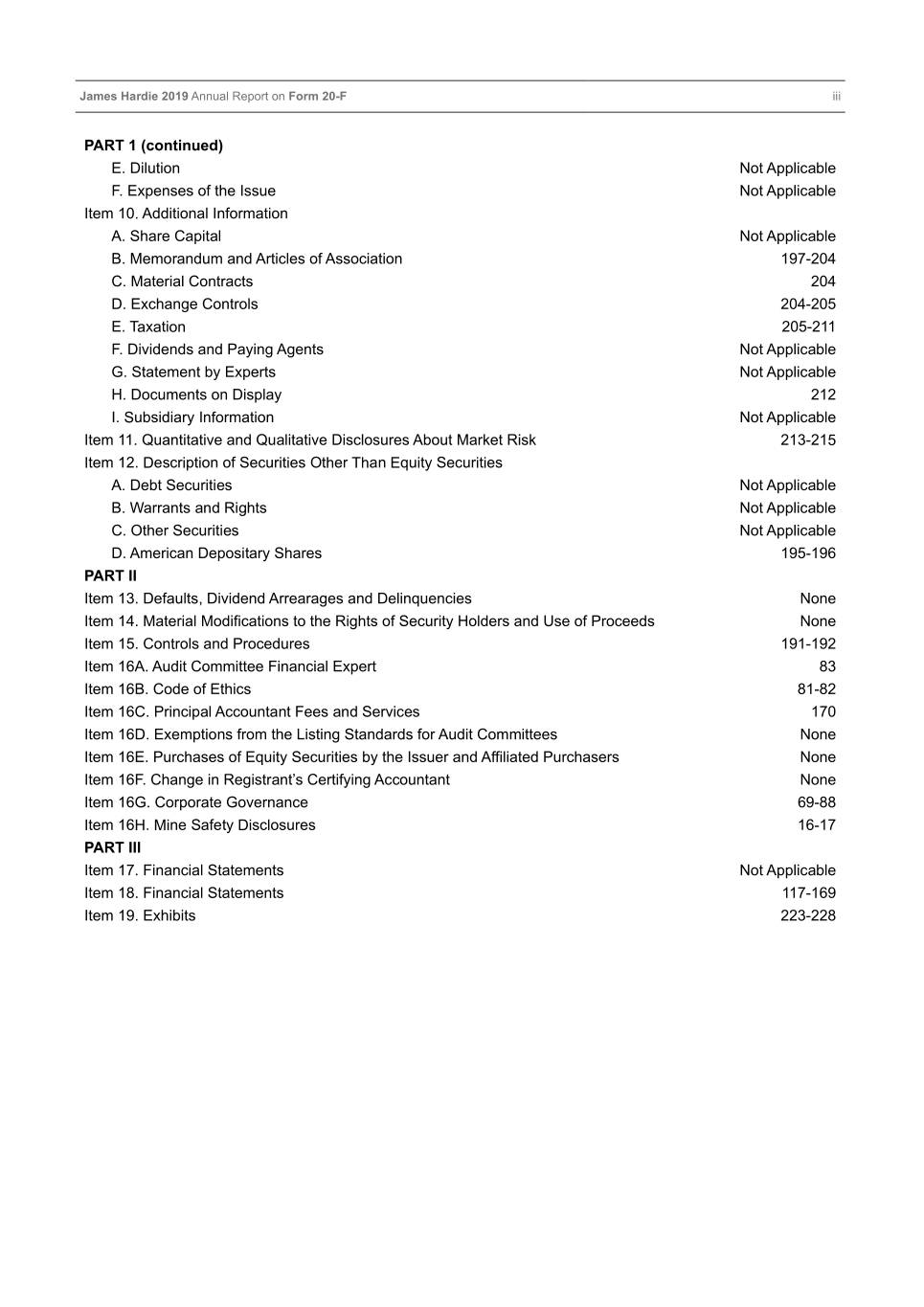
Table of Contents James Hardie 2019 Annual Report on Form 20-F iii PART 1 (continued) E. Dilution Not Applicable F. Expenses of the Issue Not Applicable Item 10. Additional Information A. Share Capital Not Applicable B. Memorandum and Articles of Association 197-204 C. Material Contracts 204 D. Exchange Controls 204-205 E. Taxation 205-211 F. Dividends and Paying Agents Not Applicable G. Statement by Experts Not Applicable H. Documents on Display 212 I. Subsidiary Information Not Applicable Item 11. Quantitative and Qualitative Disclosures About Market Risk 213-215 Item 12. Description of Securities Other Than Equity Securities A. Debt Securities Not Applicable B. Warrants and Rights Not Applicable C. Other Securities Not Applicable D. American Depositary Shares 195-196 PART II Item 13. Defaults, Dividend Arrearages and Delinquencies None Item 14. Material Modifications to the Rights of Security Holders and Use of Proceeds None Item 15. Controls and Procedures 191-192 Item 16A. Audit Committee Financial Expert 83 Item 16B. Code of Ethics 81-82 Item 16C. Principal Accountant Fees and Services 170 Item 16D. Exemptions from the Listing Standards for Audit Committees None Item 16E. Purchases of Equity Securities by the Issuer and Affiliated Purchasers None Item 16F. Change in Registrant’s Certifying Accountant None Item 16G. Corporate Governance 69-88 Item 16H. Mine Safety Disclosures 16-17 PART III Item 17. Financial Statements Not Applicable Item 18. Financial Statements 117-169 Item 19. Exhibits 223-228

Table of Contents James Hardie 2019 Annual Report on Form 20-F 1 SECTION 1 INTRODUCTION James Hardie Industries plc is a world leader in the manufacture of fiber cement siding and backerboard and a market leader in Europe for fiber gypsum products. Our products are used in a number of markets, including new residential construction (single and multi-family housing), manufactured housing, repair and remodeling and a variety of commercial and industrial applications. We manufacture numerous types of fiber cement products with a variety of patterned profiles and surface finishes for a range of applications, including external siding and trim and soffit lining, internal linings, facades and floor and tile underlay. We also manufacture fiber gypsum products that are used in a variety of applications such as dry lining walls, timber frame walls and flooring applications. Our current primary geographic markets include the United States of America (“US,” “USA” or the “United States”), Canada, Australia, New Zealand, the Philippines and Europe. James Hardie Industries plc is a “public limited company,” incorporated and existing under the laws of Ireland. Except as the context otherwise may require, references in this Annual Report on Form 20-F (this “Annual Report”) to “James Hardie,” the “James Hardie Group,” the “Company,” “JHI plc,” “we,” “our” or “us” refer to James Hardie Industries plc, together with its direct and indirect wholly owned subsidiaries as of the time relevant to the applicable reference. For certain information about the basis of preparing the financial information in this Annual Report, see “Section 2 – Reading this Report.” In addition, this Annual Report contains statements that constitute “forward-looking statements.” For an explanation of forward-looking statements and the risks, uncertainties and assumptions to which they are subject, see “Section 2 – Reading this Report.” Further, a “Glossary of Abbreviations and Definitions” has also been included under Section 4 of this Annual Report. The term “fiscal year” refers to our fiscal year ended 31 March of such year; the term “dollars,” “US$” or “$” refers to US dollars; the term “A$” refers to Australian dollars; and the term "EUR" or “€” refers to Euro. On 3 April 2018, the Company completed the acquisition of German-based XI (DL) Holdings GmbH (n/k/a James Hardie Europe Holdings 2 GmbH) and its subsidiaries (including, but not limited to, Fermacell GmbH (n/k/a James Hardie Europe GmbH)) (collectively, "Fermacell") and began consolidating the results of Fermacell as of and from that date. As a result, the James Hardie Group's historical financial information does not include any results of Fermacell and is not directly comparable to fiscal year 2019. Readers are referred to Note 20 to our consolidated financial statements for further information on the Fermacell acquisition. During the first quarter of fiscal year 2019, the Company changed its reportable operating segments. Previously, the Company maintained four operating segments: (i) North America Fiber Cement; (ii) International Fiber Cement; (iii) Other Businesses; and (iv) Research and Development. Beginning in the first quarter of fiscal year 2019, the Company replaced the International Fiber Cement segment with two new segments: (i) Asia Pacific Fiber Cement; and (ii) Europe Building Products. There were no changes to the North America Fiber Cement; Other Businesses; and Research and Development segments. The Company has provided its historical segment information to be consistent with the new reportable segment structure. The change in reportable segments had no effect on the Company’s financial position, results of operations or cash flows for the periods presented. Readers are referred to Note 18 of our consolidated financial statements in Section 2 for further information on our segments.
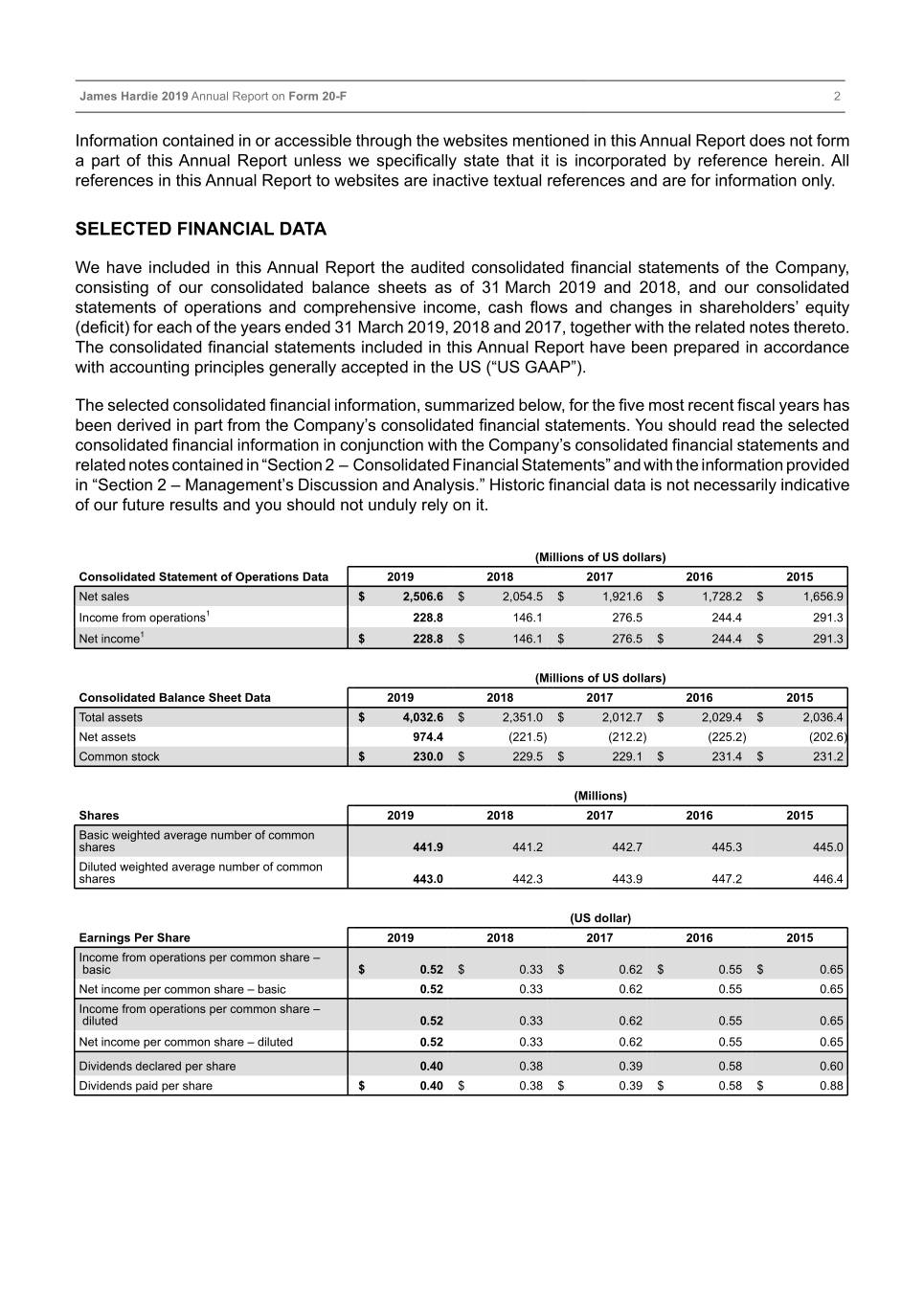
Table of Contents James Hardie 2019 Annual Report on Form 20-F 2 Information contained in or accessible through the websites mentioned in this Annual Report does not form a part of this Annual Report unless we specifically state that it is incorporated by reference herein. All references in this Annual Report to websites are inactive textual references and are for information only. SELECTED FINANCIAL DATA We have included in this Annual Report the audited consolidated financial statements of the Company, consisting of our consolidated balance sheets as of 31 March 2019 and 2018, and our consolidated statements of operations and comprehensive income, cash flows and changes in shareholders’ equity (deficit) for each of the years ended 31 March 2019, 2018 and 2017, together with the related notes thereto. The consolidated financial statements included in this Annual Report have been prepared in accordance with accounting principles generally accepted in the US (“US GAAP”). The selected consolidated financial information, summarized below, for the five most recent fiscal years has been derived in part from the Company’s consolidated financial statements. You should read the selected consolidated financial information in conjunction with the Company’s consolidated financial statements and related notes contained in “Section 2 – Consolidated Financial Statements” and with the information provided in “Section 2 – Management’s Discussion and Analysis.” Historic financial data is not necessarily indicative of our future results and you should not unduly rely on it. (Millions of US dollars) Consolidated Statement of Operations Data 2019 2018 2017 2016 2015 Net sales $ 2,506.6 $ 2,054.5 $ 1,921.6 $ 1,728.2 $ 1,656.9 Income from operations1 228.8 146.1 276.5 244.4 291.3 Net income1 $ 228.8 $ 146.1 $ 276.5 $ 244.4 $ 291.3 (Millions of US dollars) Consolidated Balance Sheet Data 2019 2018 2017 2016 2015 Total assets $ 4,032.6 $ 2,351.0 $ 2,012.7 $ 2,029.4 $ 2,036.4 Net assets 974.4 (221.5) (212.2) (225.2) (202.6) Common stock $ 230.0 $ 229.5 $ 229.1 $ 231.4 $ 231.2 (Millions) Shares 2019 2018 2017 2016 2015 Basic weighted average number of common shares 441.9 441.2 442.7 445.3 445.0 Diluted weighted average number of common shares 443.0 442.3 443.9 447.2 446.4 (US dollar) Earnings Per Share 2019 2018 2017 2016 2015 Income from operations per common share – basic $ 0.52 $ 0.33 $ 0.62 $ 0.55 $ 0.65 Net income per common share – basic 0.52 0.33 0.62 0.55 0.65 Income from operations per common share – diluted 0.52 0.33 0.62 0.55 0.65 Net income per common share – diluted 0.52 0.33 0.62 0.55 0.65 Dividends declared per share 0.40 0.38 0.39 0.58 0.60 Dividends paid per share $ 0.40 $ 0.38 $ 0.39 $ 0.58 $ 0.88
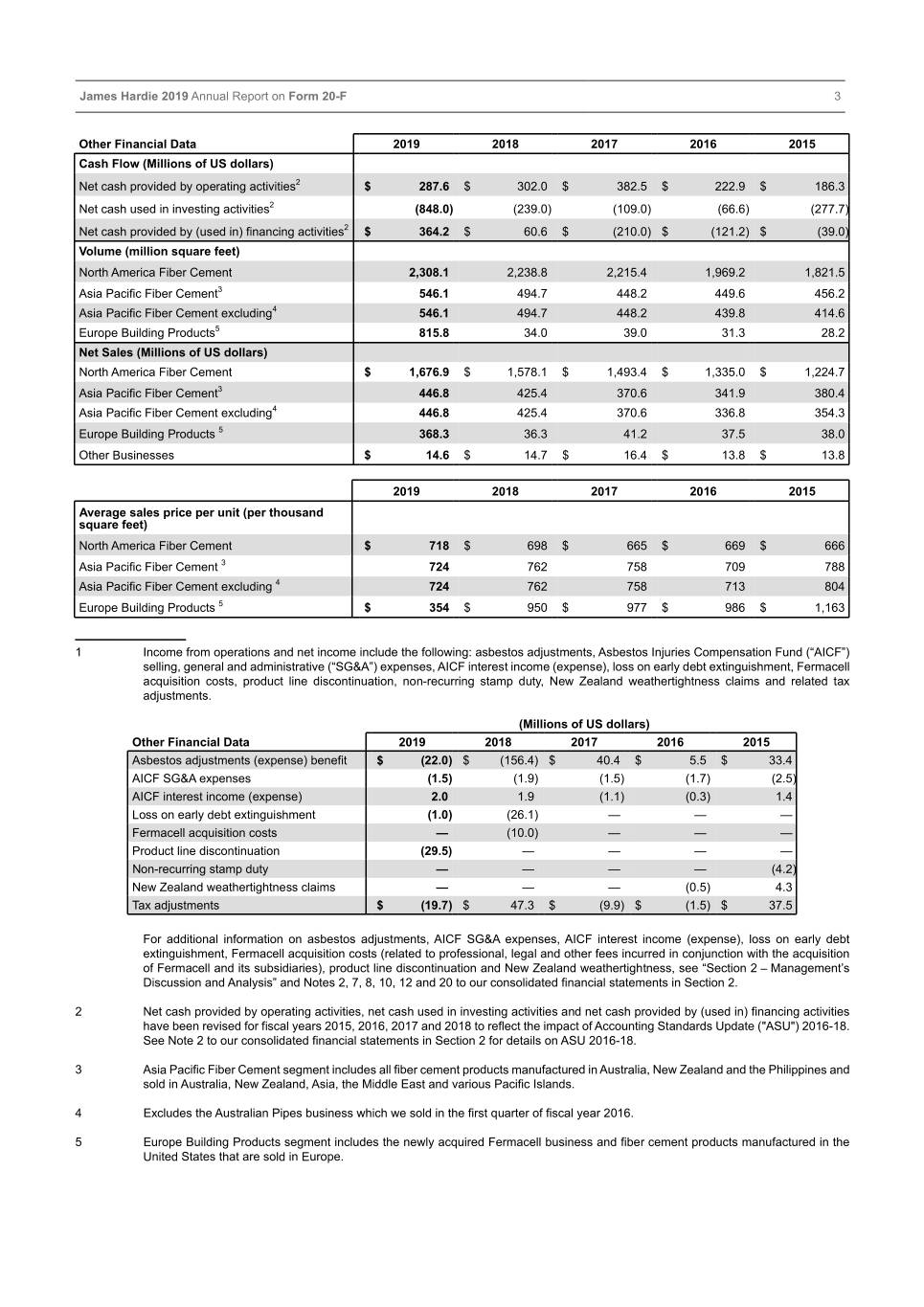
Table of Contents James Hardie 2019 Annual Report on Form 20-F 3 Other Financial Data 2019 2018 2017 2016 2015 Cash Flow (Millions of US dollars) Net cash provided by operating activities2 $ 287.6 $ 302.0 $ 382.5 $ 222.9 $ 186.3 Net cash used in investing activities2 (848.0) (239.0) (109.0) (66.6) (277.7) Net cash provided by (used in) financing activities2 $ 364.2 $ 60.6 $ (210.0)$ (121.2)$ (39.0) Volume (million square feet) North America Fiber Cement 2,308.1 2,238.8 2,215.4 1,969.2 1,821.5 Asia Pacific Fiber Cement3 546.1 494.7 448.2 449.6 456.2 Asia Pacific Fiber Cement excluding4 546.1 494.7 448.2 439.8 414.6 Europe Building Products5 815.8 34.0 39.0 31.3 28.2 Net Sales (Millions of US dollars) North America Fiber Cement $ 1,676.9 $ 1,578.1 $ 1,493.4 $ 1,335.0 $ 1,224.7 Asia Pacific Fiber Cement3 446.8 425.4 370.6 341.9 380.4 Asia Pacific Fiber Cement excluding4 446.8 425.4 370.6 336.8 354.3 Europe Building Products 5 368.3 36.3 41.2 37.5 38.0 Other Businesses $ 14.6 $ 14.7 $ 16.4 $ 13.8 $ 13.8 2019 2018 2017 2016 2015 Average sales price per unit (per thousand square feet) North America Fiber Cement $ 718 $ 698 $ 665 $ 669 $ 666 Asia Pacific Fiber Cement 3 724 762 758 709 788 Asia Pacific Fiber Cement excluding 4 724 762 758 713 804 Europe Building Products 5 $ 354 $ 950 $ 977 $ 986 $ 1,163 ____________ 1 Income from operations and net income include the following: asbestos adjustments, Asbestos Injuries Compensation Fund (“AICF”) selling, general and administrative (“SG&A”) expenses, AICF interest income (expense), loss on early debt extinguishment, Fermacell acquisition costs, product line discontinuation, non-recurring stamp duty, New Zealand weathertightness claims and related tax adjustments. (Millions of US dollars) Other Financial Data 2019 2018 2017 2016 2015 Asbestos adjustments (expense) benefit $ (22.0) $ (156.4) $ 40.4 $ 5.5 $ 33.4 AICF SG&A expenses (1.5) (1.9) (1.5) (1.7) (2.5) AICF interest income (expense) 2.0 1.9 (1.1) (0.3) 1.4 Loss on early debt extinguishment (1.0) (26.1) — — — Fermacell acquisition costs — (10.0) — — — Product line discontinuation (29.5) — — — — Non-recurring stamp duty — — — — (4.2) New Zealand weathertightness claims — — — (0.5) 4.3 Tax adjustments $ (19.7) $ 47.3 $ (9.9) $ (1.5) $ 37.5 For additional information on asbestos adjustments, AICF SG&A expenses, AICF interest income (expense), loss on early debt extinguishment, Fermacell acquisition costs (related to professional, legal and other fees incurred in conjunction with the acquisition of Fermacell and its subsidiaries), product line discontinuation and New Zealand weathertightness, see “Section 2 – Management’s Discussion and Analysis” and Notes 2, 7, 8, 10, 12 and 20 to our consolidated financial statements in Section 2. 2 Net cash provided by operating activities, net cash used in investing activities and net cash provided by (used in) financing activities have been revised for fiscal years 2015, 2016, 2017 and 2018 to reflect the impact of Accounting Standards Update ("ASU") 2016-18. See Note 2 to our consolidated financial statements in Section 2 for details on ASU 2016-18. 3 Asia Pacific Fiber Cement segment includes all fiber cement products manufactured in Australia, New Zealand and the Philippines and sold in Australia, New Zealand, Asia, the Middle East and various Pacific Islands. 4 Excludes the Australian Pipes business which we sold in the first quarter of fiscal year 2016. 5 Europe Building Products segment includes the newly acquired Fermacell business and fiber cement products manufactured in the United States that are sold in Europe.
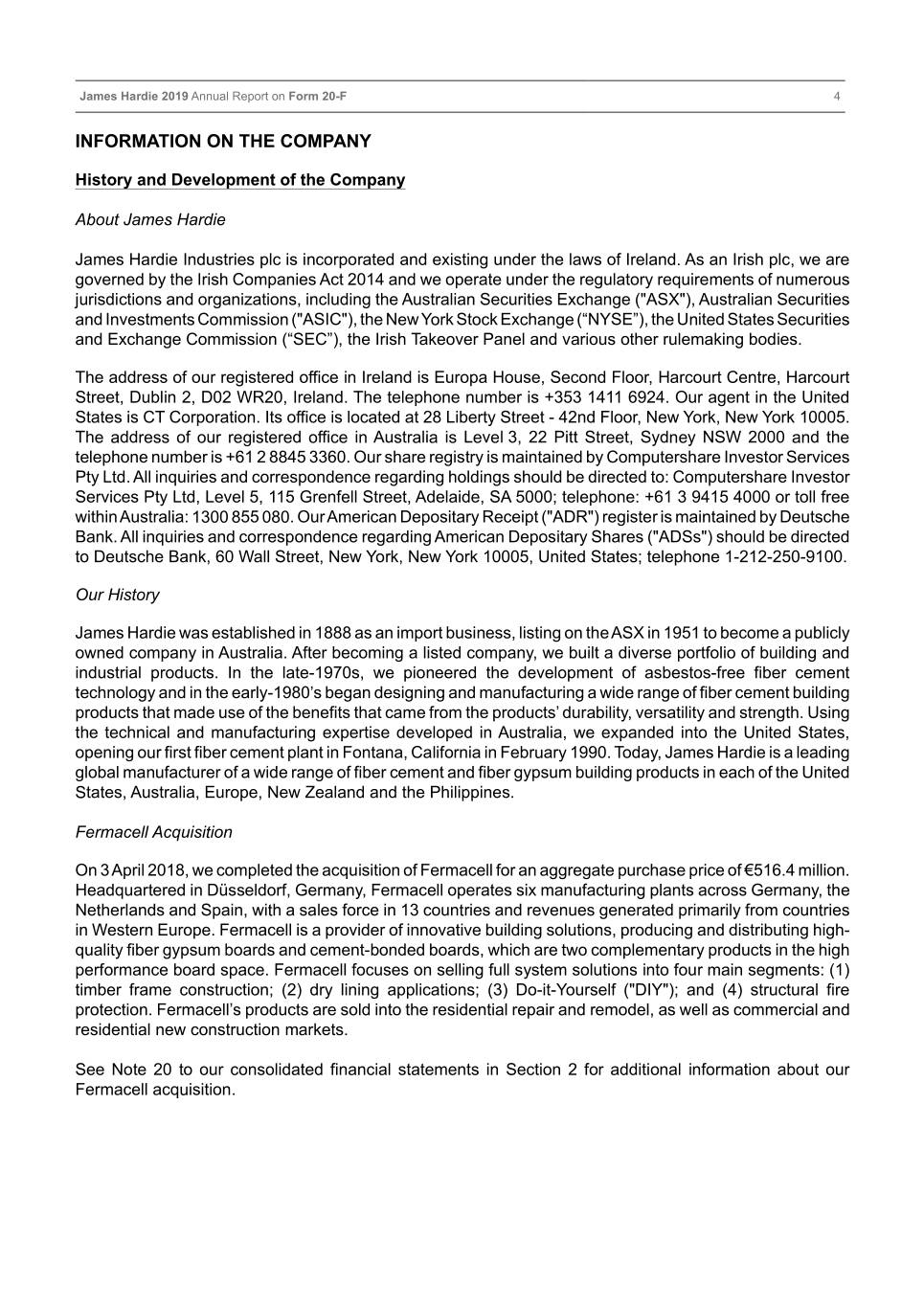
Table of Contents James Hardie 2019 Annual Report on Form 20-F 4 INFORMATION ON THE COMPANY History and Development of the Company About James Hardie James Hardie Industries plc is incorporated and existing under the laws of Ireland. As an Irish plc, we are governed by the Irish Companies Act 2014 and we operate under the regulatory requirements of numerous jurisdictions and organizations, including the Australian Securities Exchange ("ASX"), Australian Securities and Investments Commission ("ASIC"), the New York Stock Exchange (“NYSE”), the United States Securities and Exchange Commission (“SEC”), the Irish Takeover Panel and various other rulemaking bodies. The address of our registered office in Ireland is Europa House, Second Floor, Harcourt Centre, Harcourt Street, Dublin 2, D02 WR20, Ireland. The telephone number is +353 1411 6924. Our agent in the United States is CT Corporation. Its office is located at 28 Liberty Street - 42nd Floor, New York, New York 10005. The address of our registered office in Australia is Level 3, 22 Pitt Street, Sydney NSW 2000 and the telephone number is +61 2 8845 3360. Our share registry is maintained by Computershare Investor Services Pty Ltd. All inquiries and correspondence regarding holdings should be directed to: Computershare Investor Services Pty Ltd, Level 5, 115 Grenfell Street, Adelaide, SA 5000; telephone: +61 3 9415 4000 or toll free within Australia: 1300 855 080. Our American Depositary Receipt ("ADR") register is maintained by Deutsche Bank. All inquiries and correspondence regarding American Depositary Shares ("ADSs") should be directed to Deutsche Bank, 60 Wall Street, New York, New York 10005, United States; telephone 1-212-250-9100. Our History James Hardie was established in 1888 as an import business, listing on the ASX in 1951 to become a publicly owned company in Australia. After becoming a listed company, we built a diverse portfolio of building and industrial products. In the late-1970s, we pioneered the development of asbestos-free fiber cement technology and in the early-1980’s began designing and manufacturing a wide range of fiber cement building products that made use of the benefits that came from the products’ durability, versatility and strength. Using the technical and manufacturing expertise developed in Australia, we expanded into the United States, opening our first fiber cement plant in Fontana, California in February 1990. Today, James Hardie is a leading global manufacturer of a wide range of fiber cement and fiber gypsum building products in each of the United States, Australia, Europe, New Zealand and the Philippines. Fermacell Acquisition On 3 April 2018, we completed the acquisition of Fermacell for an aggregate purchase price of €516.4 million. Headquartered in Düsseldorf, Germany, Fermacell operates six manufacturing plants across Germany, the Netherlands and Spain, with a sales force in 13 countries and revenues generated primarily from countries in Western Europe. Fermacell is a provider of innovative building solutions, producing and distributing high- quality fiber gypsum boards and cement-bonded boards, which are two complementary products in the high performance board space. Fermacell focuses on selling full system solutions into four main segments: (1) timber frame construction; (2) dry lining applications; (3) Do-it-Yourself ("DIY"); and (4) structural fire protection. Fermacell’s products are sold into the residential repair and remodel, as well as commercial and residential new construction markets. See Note 20 to our consolidated financial statements in Section 2 for additional information about our Fermacell acquisition.
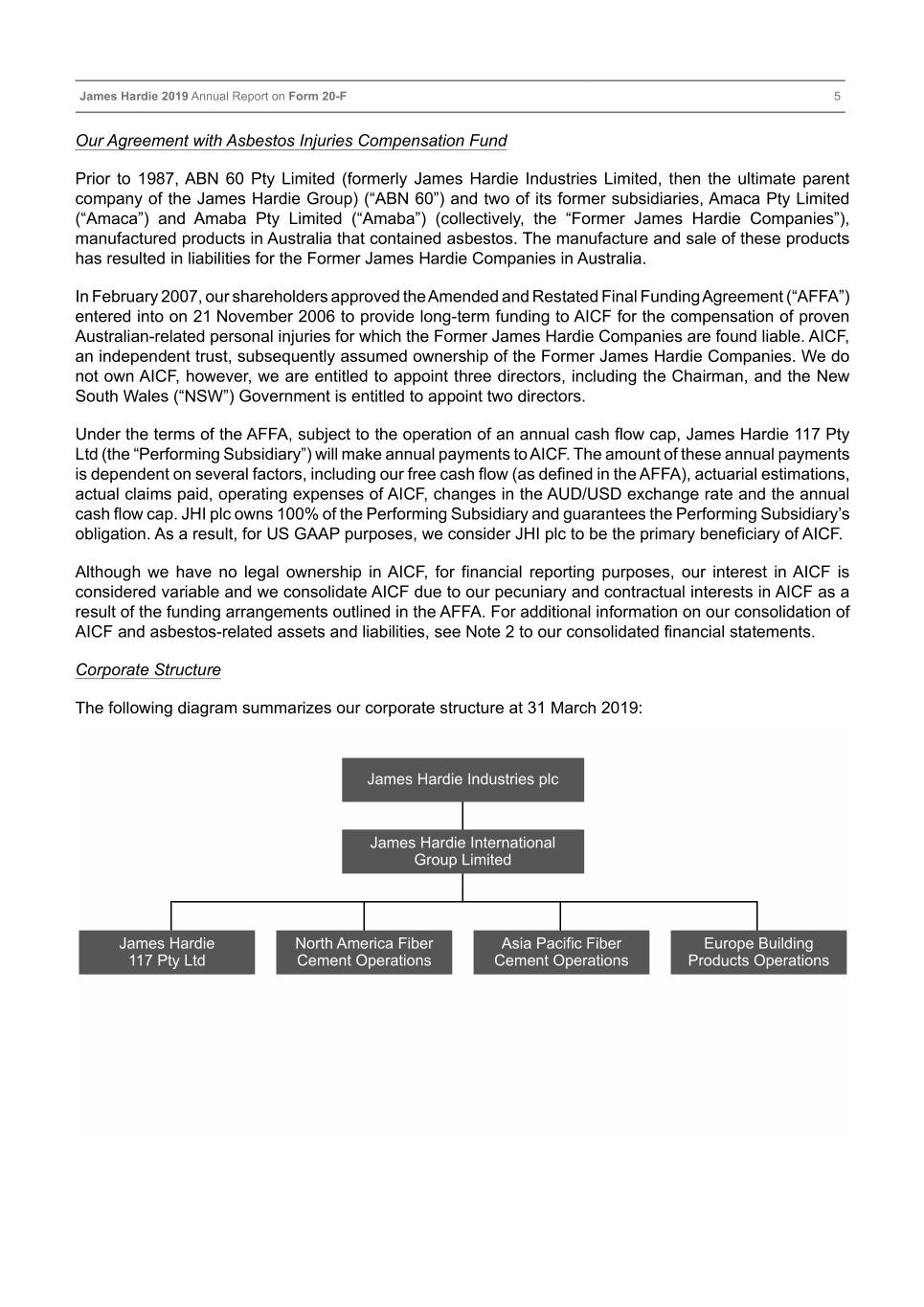
Table of Contents James Hardie 2019 Annual Report on Form 20-F 5 Our Agreement with Asbestos Injuries Compensation Fund Prior to 1987, ABN 60 Pty Limited (formerly James Hardie Industries Limited, then the ultimate parent company of the James Hardie Group) (“ABN 60”) and two of its former subsidiaries, Amaca Pty Limited (“Amaca”) and Amaba Pty Limited (“Amaba”) (collectively, the “Former James Hardie Companies”), manufactured products in Australia that contained asbestos. The manufacture and sale of these products has resulted in liabilities for the Former James Hardie Companies in Australia. In February 2007, our shareholders approved the Amended and Restated Final Funding Agreement (“AFFA”) entered into on 21 November 2006 to provide long-term funding to AICF for the compensation of proven Australian-related personal injuries for which the Former James Hardie Companies are found liable. AICF, an independent trust, subsequently assumed ownership of the Former James Hardie Companies. We do not own AICF, however, we are entitled to appoint three directors, including the Chairman, and the New South Wales (“NSW”) Government is entitled to appoint two directors. Under the terms of the AFFA, subject to the operation of an annual cash flow cap, James Hardie 117 Pty Ltd (the “Performing Subsidiary”) will make annual payments to AICF. The amount of these annual payments is dependent on several factors, including our free cash flow (as defined in the AFFA), actuarial estimations, actual claims paid, operating expenses of AICF, changes in the AUD/USD exchange rate and the annual cash flow cap. JHI plc owns 100% of the Performing Subsidiary and guarantees the Performing Subsidiary’s obligation. As a result, for US GAAP purposes, we consider JHI plc to be the primary beneficiary of AICF. Although we have no legal ownership in AICF, for financial reporting purposes, our interest in AICF is considered variable and we consolidate AICF due to our pecuniary and contractual interests in AICF as a result of the funding arrangements outlined in the AFFA. For additional information on our consolidation of AICF and asbestos-related assets and liabilities, see Note 2 to our consolidated financial statements. Corporate Structure The following diagram summarizes our corporate structure at 31 March 2019: James Hardie �ndustries plc James Hardie �nternational �roup Limited James Hardie North America Fiber Asia �acific Fiber Europe �uilding 11� �ty Ltd Cement �perations Cement �perations �roducts �perations
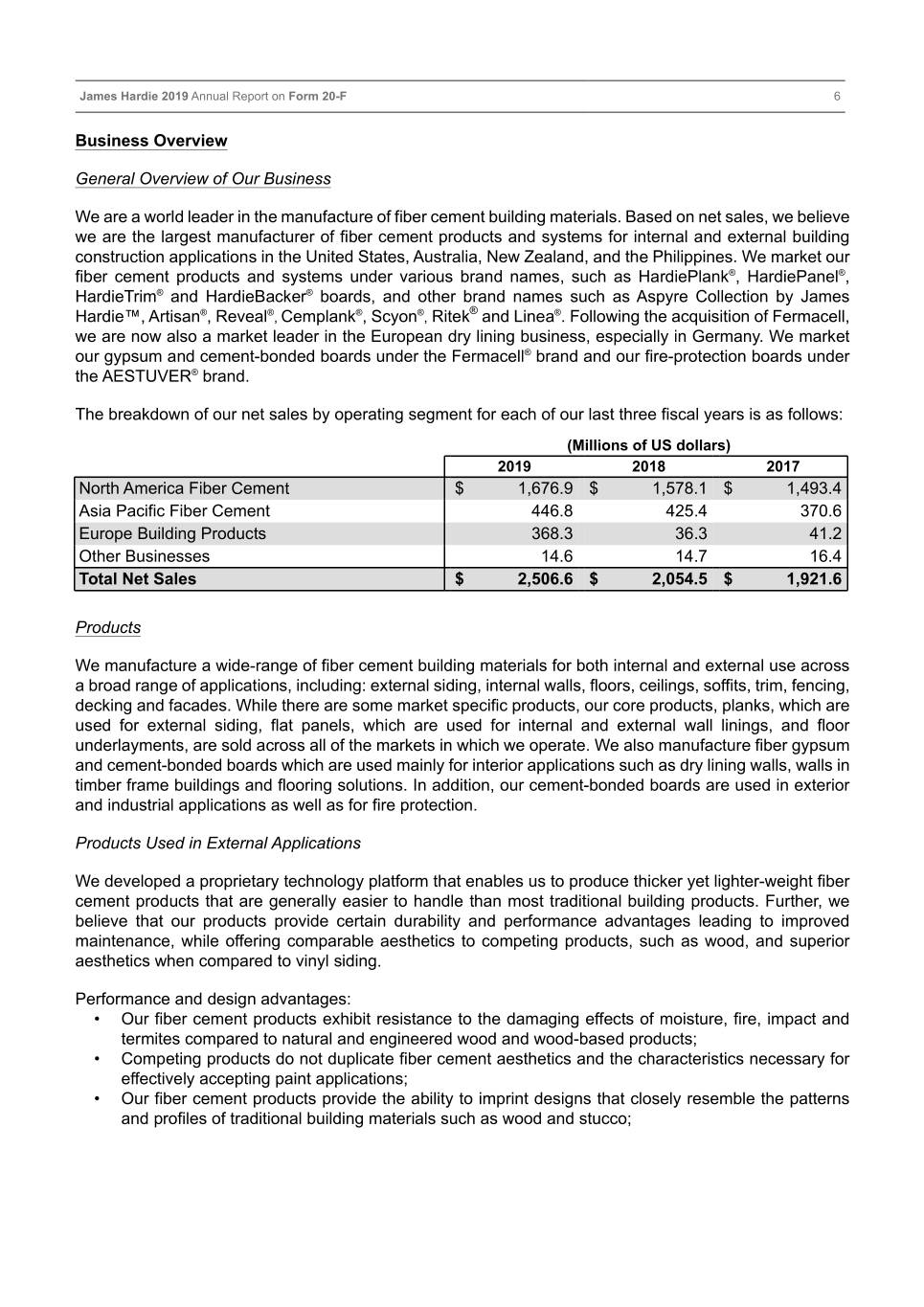
Table of Contents James Hardie 2019 Annual Report on Form 20-F 6 Business Overview General Overview of Our Business We are a world leader in the manufacture of fiber cement building materials. Based on net sales, we believe we are the largest manufacturer of fiber cement products and systems for internal and external building construction applications in the United States, Australia, New Zealand, and the Philippines. We market our fiber cement products and systems under various brand names, such as HardiePlank®, HardiePanel®, HardieTrim® and HardieBacker® boards, and other brand names such as Aspyre Collection by James ® Hardie™, Artisan®, Reveal®, Cemplank®, Scyon®, Ritek and Linea®. Following the acquisition of Fermacell, we are now also a market leader in the European dry lining business, especially in Germany. We market our gypsum and cement-bonded boards under the Fermacell® brand and our fire-protection boards under the AESTUVER® brand. The breakdown of our net sales by operating segment for each of our last three fiscal years is as follows: (Millions of US dollars) 2019 2018 2017 North America Fiber Cement $ 1,676.9 $ 1,578.1 $ 1,493.4 Asia Pacific Fiber Cement 446.8 425.4 370.6 Europe Building Products 368.3 36.3 41.2 Other Businesses 14.6 14.7 16.4 Total Net Sales $ 2,506.6 $ 2,054.5 $ 1,921.6 Products We manufacture a wide-range of fiber cement building materials for both internal and external use across a broad range of applications, including: external siding, internal walls, floors, ceilings, soffits, trim, fencing, decking and facades. While there are some market specific products, our core products, planks, which are used for external siding, flat panels, which are used for internal and external wall linings, and floor underlayments, are sold across all of the markets in which we operate. We also manufacture fiber gypsum and cement-bonded boards which are used mainly for interior applications such as dry lining walls, walls in timber frame buildings and flooring solutions. In addition, our cement-bonded boards are used in exterior and industrial applications as well as for fire protection. Products Used in External Applications We developed a proprietary technology platform that enables us to produce thicker yet lighter-weight fiber cement products that are generally easier to handle than most traditional building products. Further, we believe that our products provide certain durability and performance advantages leading to improved maintenance, while offering comparable aesthetics to competing products, such as wood, and superior aesthetics when compared to vinyl siding. Performance and design advantages: • Our fiber cement products exhibit resistance to the damaging effects of moisture, fire, impact and termites compared to natural and engineered wood and wood-based products; • Competing products do not duplicate fiber cement aesthetics and the characteristics necessary for effectively accepting paint applications; • Our fiber cement products provide the ability to imprint designs that closely resemble the patterns and profiles of traditional building materials such as wood and stucco;
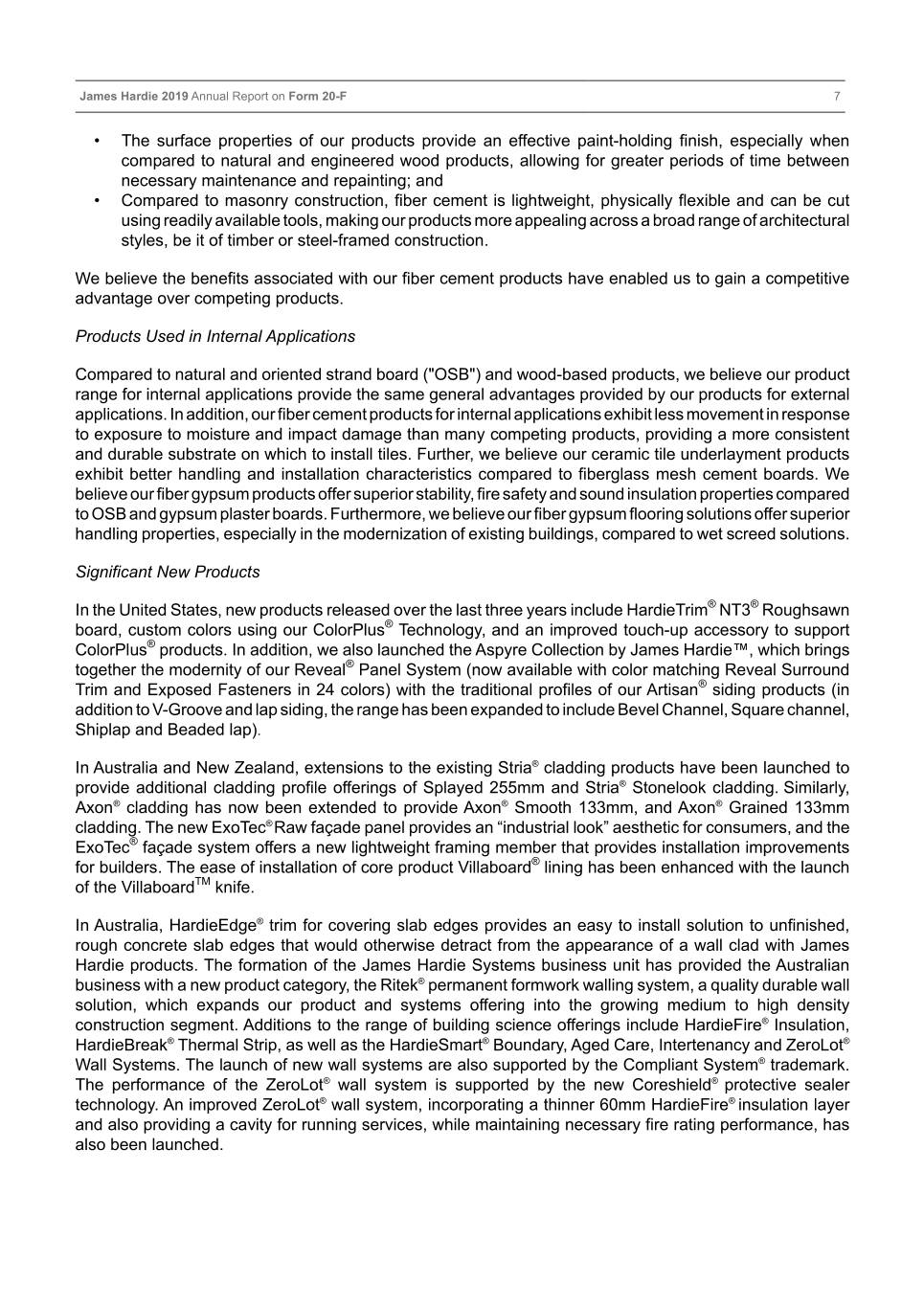
Table of Contents James Hardie 2019 Annual Report on Form 20-F 7 • The surface properties of our products provide an effective paint-holding finish, especially when compared to natural and engineered wood products, allowing for greater periods of time between necessary maintenance and repainting; and • Compared to masonry construction, fiber cement is lightweight, physically flexible and can be cut using readily available tools, making our products more appealing across a broad range of architectural styles, be it of timber or steel-framed construction. We believe the benefits associated with our fiber cement products have enabled us to gain a competitive advantage over competing products. Products Used in Internal Applications Compared to natural and oriented strand board ("OSB") and wood-based products, we believe our product range for internal applications provide the same general advantages provided by our products for external applications. In addition, our fiber cement products for internal applications exhibit less movement in response to exposure to moisture and impact damage than many competing products, providing a more consistent and durable substrate on which to install tiles. Further, we believe our ceramic tile underlayment products exhibit better handling and installation characteristics compared to fiberglass mesh cement boards. We believe our fiber gypsum products offer superior stability, fire safety and sound insulation properties compared to OSB and gypsum plaster boards. Furthermore, we believe our fiber gypsum flooring solutions offer superior handling properties, especially in the modernization of existing buildings, compared to wet screed solutions. Significant New Products In the United States, new products released over the last three years include HardieTrim® NT3® Roughsawn board, custom colors using our ColorPlus® Technology, and an improved touch-up accessory to support ColorPlus® products. In addition, we also launched the Aspyre Collection by James Hardie™, which brings together the modernity of our Reveal® Panel System (now available with color matching Reveal Surround Trim and Exposed Fasteners in 24 colors) with the traditional profiles of our Artisan® siding products (in addition to V-Groove and lap siding, the range has been expanded to include Bevel Channel, Square channel, Shiplap and Beaded lap). In Australia and New Zealand, extensions to the existing Stria® cladding products have been launched to provide additional cladding profile offerings of Splayed 255mm and Stria® Stonelook cladding. Similarly, Axon® cladding has now been extended to provide Axon® Smooth 133mm, and Axon® Grained 133mm cladding. The new ExoTec® Raw façade panel provides an “industrial look” aesthetic for consumers, and the ExoTec® façade system offers a new lightweight framing member that provides installation improvements for builders. The ease of installation of core product Villaboard® lining has been enhanced with the launch of the VillaboardTM knife. In Australia, HardieEdge® trim for covering slab edges provides an easy to install solution to unfinished, rough concrete slab edges that would otherwise detract from the appearance of a wall clad with James Hardie products. The formation of the James Hardie Systems business unit has provided the Australian business with a new product category, the Ritek® permanent formwork walling system, a quality durable wall solution, which expands our product and systems offering into the growing medium to high density construction segment. Additions to the range of building science offerings include HardieFire® Insulation, HardieBreak® Thermal Strip, as well as the HardieSmart® Boundary, Aged Care, Intertenancy and ZeroLot® Wall Systems. The launch of new wall systems are also supported by the Compliant System® trademark. The performance of the ZeroLot® wall system is supported by the new Coreshield® protective sealer technology. An improved ZeroLot® wall system, incorporating a thinner 60mm HardieFire® insulation layer and also providing a cavity for running services, while maintaining necessary fire rating performance, has also been launched.
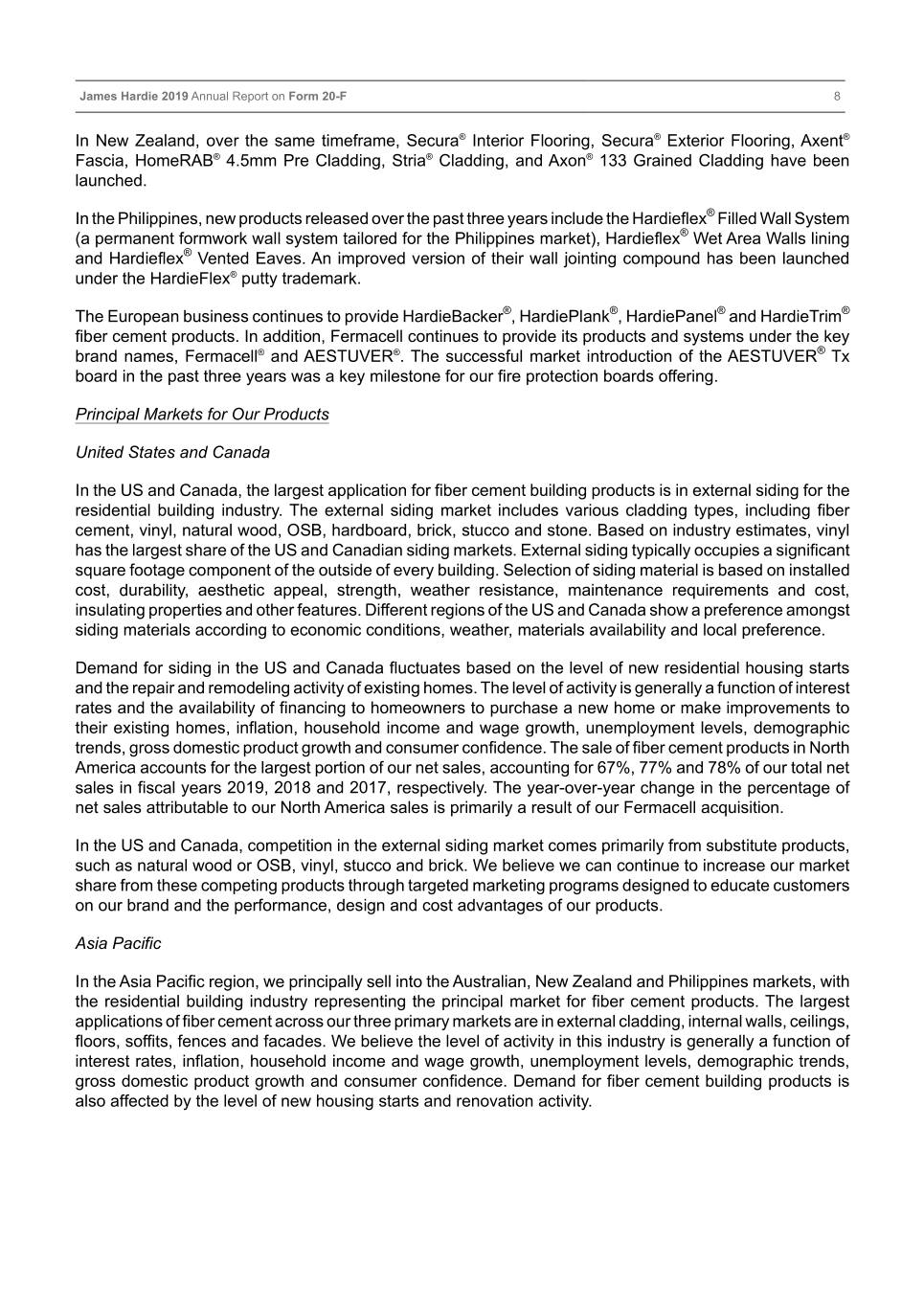
Table of Contents James Hardie 2019 Annual Report on Form 20-F 8 In New Zealand, over the same timeframe, Secura® Interior Flooring, Secura® Exterior Flooring, Axent® Fascia, HomeRAB® 4.5mm Pre Cladding, Stria® Cladding, and Axon® 133 Grained Cladding have been launched. In the Philippines, new products released over the past three years include the Hardieflex® Filled Wall System (a permanent formwork wall system tailored for the Philippines market), Hardieflex® Wet Area Walls lining and Hardieflex® Vented Eaves. An improved version of their wall jointing compound has been launched under the HardieFlex® putty trademark. The European business continues to provide HardieBacker®, HardiePlank®, HardiePanel® and HardieTrim® fiber cement products. In addition, Fermacell continues to provide its products and systems under the key brand names, Fermacell® and AESTUVER®. The successful market introduction of the AESTUVER® Tx board in the past three years was a key milestone for our fire protection boards offering. Principal Markets for Our Products United States and Canada In the US and Canada, the largest application for fiber cement building products is in external siding for the residential building industry. The external siding market includes various cladding types, including fiber cement, vinyl, natural wood, OSB, hardboard, brick, stucco and stone. Based on industry estimates, vinyl has the largest share of the US and Canadian siding markets. External siding typically occupies a significant square footage component of the outside of every building. Selection of siding material is based on installed cost, durability, aesthetic appeal, strength, weather resistance, maintenance requirements and cost, insulating properties and other features. Different regions of the US and Canada show a preference amongst siding materials according to economic conditions, weather, materials availability and local preference. Demand for siding in the US and Canada fluctuates based on the level of new residential housing starts and the repair and remodeling activity of existing homes. The level of activity is generally a function of interest rates and the availability of financing to homeowners to purchase a new home or make improvements to their existing homes, inflation, household income and wage growth, unemployment levels, demographic trends, gross domestic product growth and consumer confidence. The sale of fiber cement products in North America accounts for the largest portion of our net sales, accounting for 67%, 77% and 78% of our total net sales in fiscal years 2019, 2018 and 2017, respectively. The year-over-year change in the percentage of net sales attributable to our North America sales is primarily a result of our Fermacell acquisition. In the US and Canada, competition in the external siding market comes primarily from substitute products, such as natural wood or OSB, vinyl, stucco and brick. We believe we can continue to increase our market share from these competing products through targeted marketing programs designed to educate customers on our brand and the performance, design and cost advantages of our products. Asia Pacific In the Asia Pacific region, we principally sell into the Australian, New Zealand and Philippines markets, with the residential building industry representing the principal market for fiber cement products. The largest applications of fiber cement across our three primary markets are in external cladding, internal walls, ceilings, floors, soffits, fences and facades. We believe the level of activity in this industry is generally a function of interest rates, inflation, household income and wage growth, unemployment levels, demographic trends, gross domestic product growth and consumer confidence. Demand for fiber cement building products is also affected by the level of new housing starts and renovation activity.
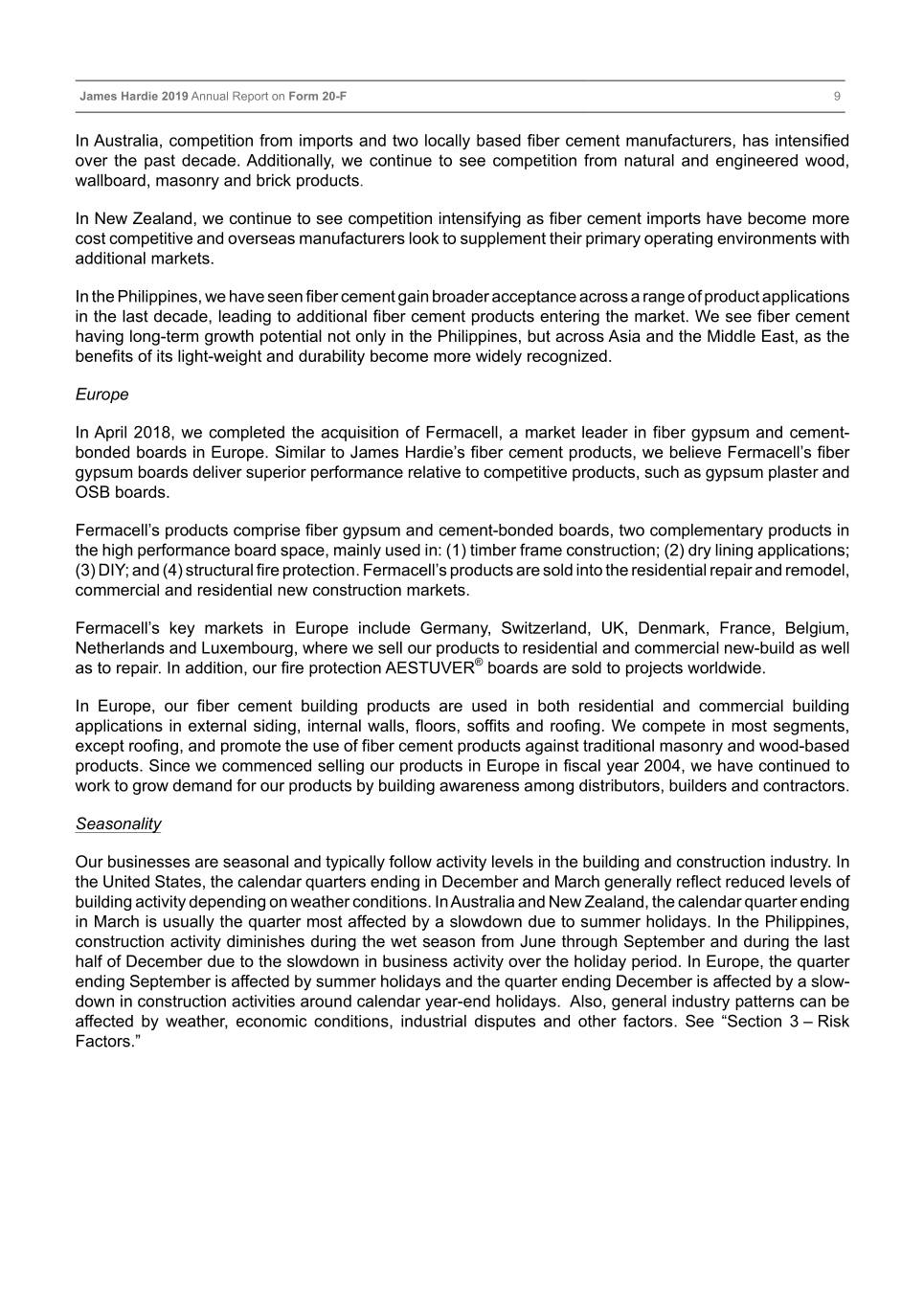
Table of Contents James Hardie 2019 Annual Report on Form 20-F 9 In Australia, competition from imports and two locally based fiber cement manufacturers, has intensified over the past decade. Additionally, we continue to see competition from natural and engineered wood, wallboard, masonry and brick products. In New Zealand, we continue to see competition intensifying as fiber cement imports have become more cost competitive and overseas manufacturers look to supplement their primary operating environments with additional markets. In the Philippines, we have seen fiber cement gain broader acceptance across a range of product applications in the last decade, leading to additional fiber cement products entering the market. We see fiber cement having long-term growth potential not only in the Philippines, but across Asia and the Middle East, as the benefits of its light-weight and durability become more widely recognized. Europe In April 2018, we completed the acquisition of Fermacell, a market leader in fiber gypsum and cement- bonded boards in Europe. Similar to James Hardie’s fiber cement products, we believe Fermacell’s fiber gypsum boards deliver superior performance relative to competitive products, such as gypsum plaster and OSB boards. Fermacell’s products comprise fiber gypsum and cement-bonded boards, two complementary products in the high performance board space, mainly used in: (1) timber frame construction; (2) dry lining applications; (3) DIY; and (4) structural fire protection. Fermacell’s products are sold into the residential repair and remodel, commercial and residential new construction markets. Fermacell’s key markets in Europe include Germany, Switzerland, UK, Denmark, France, Belgium, Netherlands and Luxembourg, where we sell our products to residential and commercial new-build as well as to repair. In addition, our fire protection AESTUVER® boards are sold to projects worldwide. In Europe, our fiber cement building products are used in both residential and commercial building applications in external siding, internal walls, floors, soffits and roofing. We compete in most segments, except roofing, and promote the use of fiber cement products against traditional masonry and wood-based products. Since we commenced selling our products in Europe in fiscal year 2004, we have continued to work to grow demand for our products by building awareness among distributors, builders and contractors. Seasonality Our businesses are seasonal and typically follow activity levels in the building and construction industry. In the United States, the calendar quarters ending in December and March generally reflect reduced levels of building activity depending on weather conditions. In Australia and New Zealand, the calendar quarter ending in March is usually the quarter most affected by a slowdown due to summer holidays. In the Philippines, construction activity diminishes during the wet season from June through September and during the last half of December due to the slowdown in business activity over the holiday period. In Europe, the quarter ending September is affected by summer holidays and the quarter ending December is affected by a slow- down in construction activities around calendar year-end holidays. Also, general industry patterns can be affected by weather, economic conditions, industrial disputes and other factors. See “Section 3 – Risk Factors.”
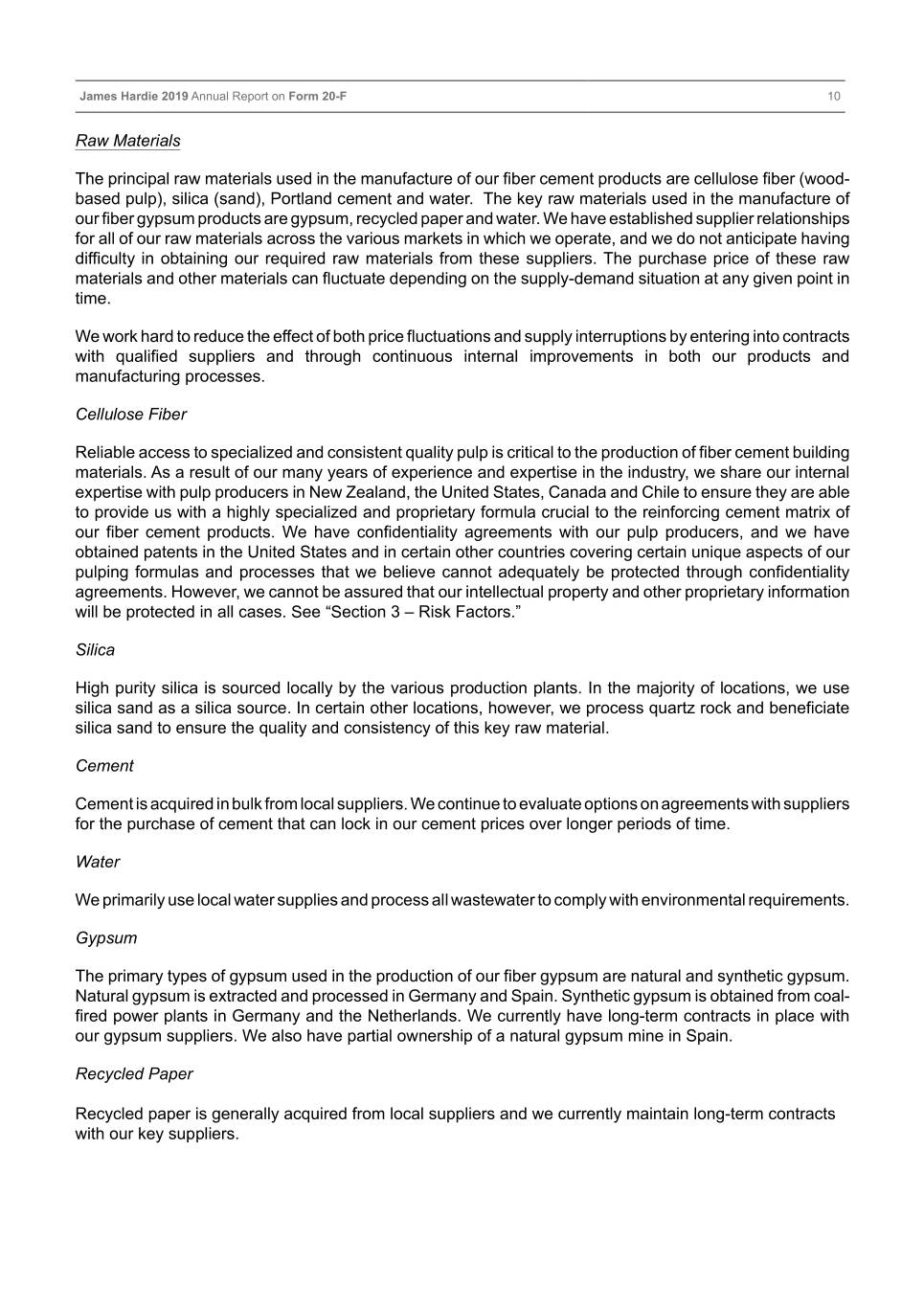
Table of Contents James Hardie 2019 Annual Report on Form 20-F 10 Raw Materials The principal raw materials used in the manufacture of our fiber cement products are cellulose fiber (wood- based pulp), silica (sand), Portland cement and water. The key raw materials used in the manufacture of our fiber gypsum products are gypsum, recycled paper and water. We have established supplier relationships for all of our raw materials across the various markets in which we operate, and we do not anticipate having difficulty in obtaining our required raw materials from these suppliers. The purchase price of these raw materials and other materials can fluctuate depending on the supply-demand situation at any given point in time. We work hard to reduce the effect of both price fluctuations and supply interruptions by entering into contracts with qualified suppliers and through continuous internal improvements in both our products and manufacturing processes. Cellulose Fiber Reliable access to specialized and consistent quality pulp is critical to the production of fiber cement building materials. As a result of our many years of experience and expertise in the industry, we share our internal expertise with pulp producers in New Zealand, the United States, Canada and Chile to ensure they are able to provide us with a highly specialized and proprietary formula crucial to the reinforcing cement matrix of our fiber cement products. We have confidentiality agreements with our pulp producers, and we have obtained patents in the United States and in certain other countries covering certain unique aspects of our pulping formulas and processes that we believe cannot adequately be protected through confidentiality agreements. However, we cannot be assured that our intellectual property and other proprietary information will be protected in all cases. See “Section 3 – Risk Factors.” Silica High purity silica is sourced locally by the various production plants. In the majority of locations, we use silica sand as a silica source. In certain other locations, however, we process quartz rock and beneficiate silica sand to ensure the quality and consistency of this key raw material. Cement Cement is acquired in bulk from local suppliers. We continue to evaluate options on agreements with suppliers for the purchase of cement that can lock in our cement prices over longer periods of time. Water We primarily use local water supplies and process all wastewater to comply with environmental requirements. Gypsum The primary types of gypsum used in the production of our fiber gypsum are natural and synthetic gypsum. Natural gypsum is extracted and processed in Germany and Spain. Synthetic gypsum is obtained from coal- fired power plants in Germany and the Netherlands. We currently have long-term contracts in place with our gypsum suppliers. We also have partial ownership of a natural gypsum mine in Spain. Recycled Paper Recycled paper is generally acquired from local suppliers and we currently maintain long-term contracts with our key suppliers.
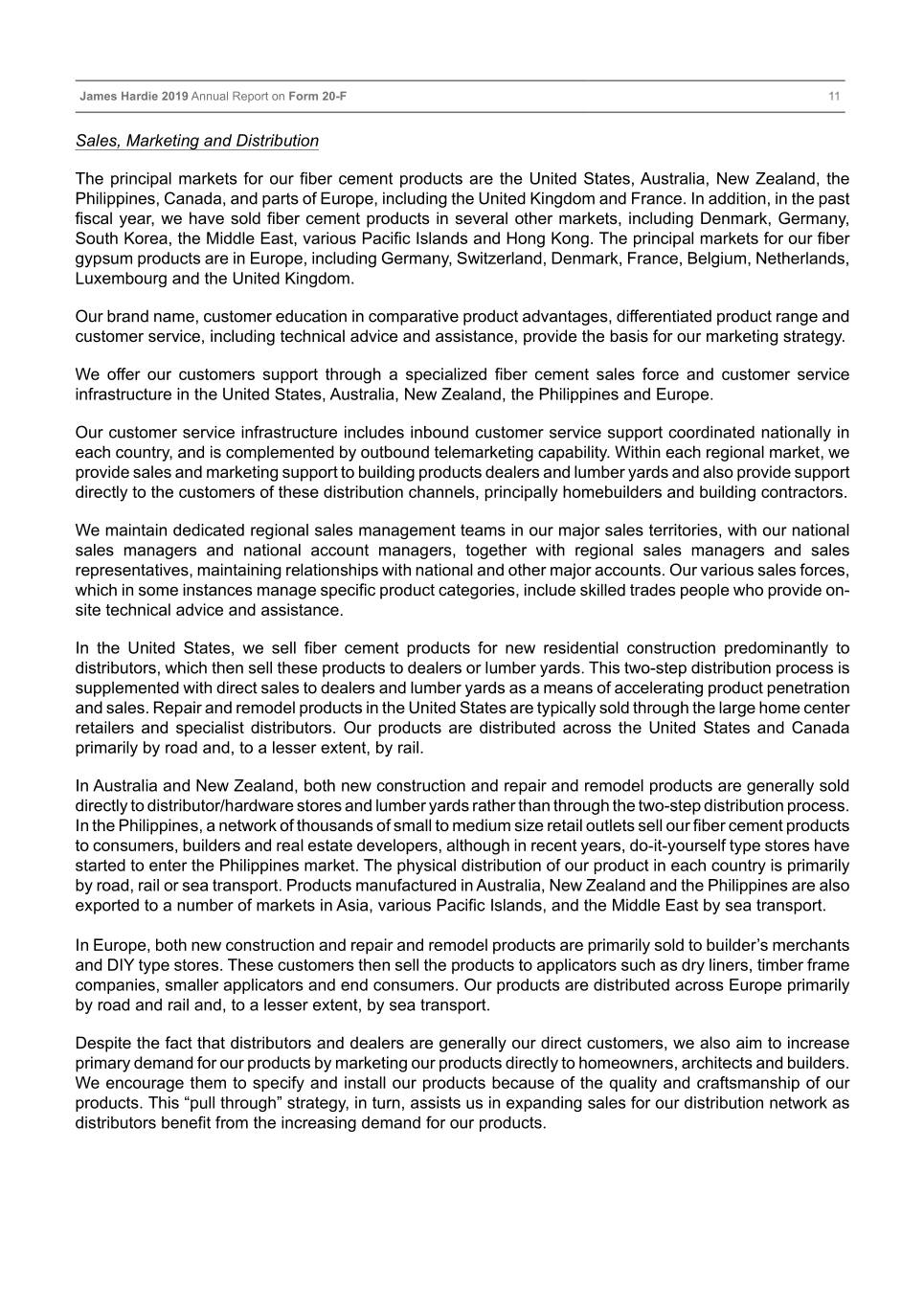
Table of Contents James Hardie 2019 Annual Report on Form 20-F 11 Sales, Marketing and Distribution The principal markets for our fiber cement products are the United States, Australia, New Zealand, the Philippines, Canada, and parts of Europe, including the United Kingdom and France. In addition, in the past fiscal year, we have sold fiber cement products in several other markets, including Denmark, Germany, South Korea, the Middle East, various Pacific Islands and Hong Kong. The principal markets for our fiber gypsum products are in Europe, including Germany, Switzerland, Denmark, France, Belgium, Netherlands, Luxembourg and the United Kingdom. Our brand name, customer education in comparative product advantages, differentiated product range and customer service, including technical advice and assistance, provide the basis for our marketing strategy. We offer our customers support through a specialized fiber cement sales force and customer service infrastructure in the United States, Australia, New Zealand, the Philippines and Europe. Our customer service infrastructure includes inbound customer service support coordinated nationally in each country, and is complemented by outbound telemarketing capability. Within each regional market, we provide sales and marketing support to building products dealers and lumber yards and also provide support directly to the customers of these distribution channels, principally homebuilders and building contractors. We maintain dedicated regional sales management teams in our major sales territories, with our national sales managers and national account managers, together with regional sales managers and sales representatives, maintaining relationships with national and other major accounts. Our various sales forces, which in some instances manage specific product categories, include skilled trades people who provide on- site technical advice and assistance. In the United States, we sell fiber cement products for new residential construction predominantly to distributors, which then sell these products to dealers or lumber yards. This two-step distribution process is supplemented with direct sales to dealers and lumber yards as a means of accelerating product penetration and sales. Repair and remodel products in the United States are typically sold through the large home center retailers and specialist distributors. Our products are distributed across the United States and Canada primarily by road and, to a lesser extent, by rail. In Australia and New Zealand, both new construction and repair and remodel products are generally sold directly to distributor/hardware stores and lumber yards rather than through the two-step distribution process. In the Philippines, a network of thousands of small to medium size retail outlets sell our fiber cement products to consumers, builders and real estate developers, although in recent years, do-it-yourself type stores have started to enter the Philippines market. The physical distribution of our product in each country is primarily by road, rail or sea transport. Products manufactured in Australia, New Zealand and the Philippines are also exported to a number of markets in Asia, various Pacific Islands, and the Middle East by sea transport. In Europe, both new construction and repair and remodel products are primarily sold to builder’s merchants and DIY type stores. These customers then sell the products to applicators such as dry liners, timber frame companies, smaller applicators and end consumers. Our products are distributed across Europe primarily by road and rail and, to a lesser extent, by sea transport. Despite the fact that distributors and dealers are generally our direct customers, we also aim to increase primary demand for our products by marketing our products directly to homeowners, architects and builders. We encourage them to specify and install our products because of the quality and craftsmanship of our products. This “pull through” strategy, in turn, assists us in expanding sales for our distribution network as distributors benefit from the increasing demand for our products.
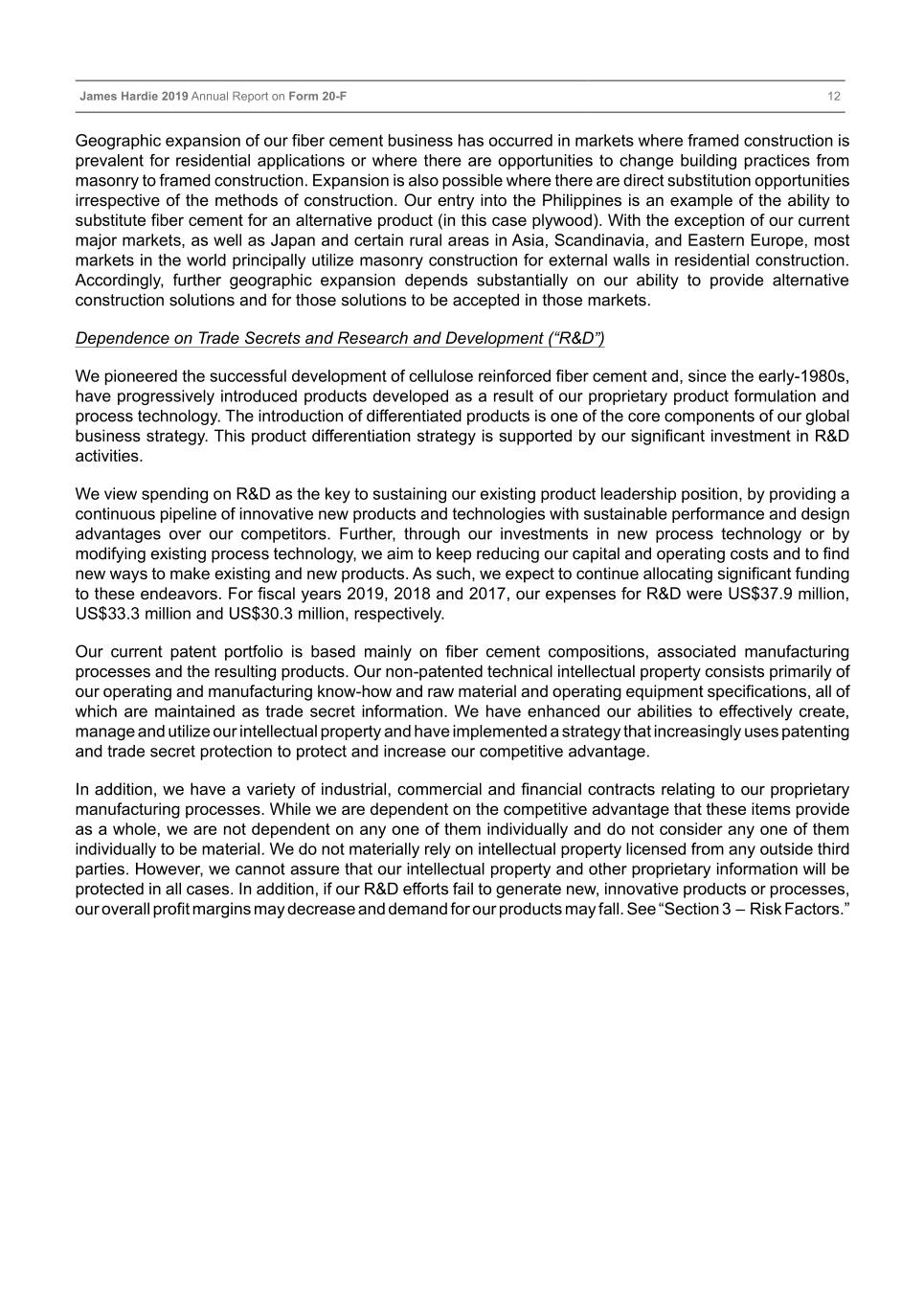
Table of Contents James Hardie 2019 Annual Report on Form 20-F 12 Geographic expansion of our fiber cement business has occurred in markets where framed construction is prevalent for residential applications or where there are opportunities to change building practices from masonry to framed construction. Expansion is also possible where there are direct substitution opportunities irrespective of the methods of construction. Our entry into the Philippines is an example of the ability to substitute fiber cement for an alternative product (in this case plywood). With the exception of our current major markets, as well as Japan and certain rural areas in Asia, Scandinavia, and Eastern Europe, most markets in the world principally utilize masonry construction for external walls in residential construction. Accordingly, further geographic expansion depends substantially on our ability to provide alternative construction solutions and for those solutions to be accepted in those markets. Dependence on Trade Secrets and Research and Development (“R&D”) We pioneered the successful development of cellulose reinforced fiber cement and, since the early-1980s, have progressively introduced products developed as a result of our proprietary product formulation and process technology. The introduction of differentiated products is one of the core components of our global business strategy. This product differentiation strategy is supported by our significant investment in R&D activities. We view spending on R&D as the key to sustaining our existing product leadership position, by providing a continuous pipeline of innovative new products and technologies with sustainable performance and design advantages over our competitors. Further, through our investments in new process technology or by modifying existing process technology, we aim to keep reducing our capital and operating costs and to find new ways to make existing and new products. As such, we expect to continue allocating significant funding to these endeavors. For fiscal years 2019, 2018 and 2017, our expenses for R&D were US$37.9 million, US$33.3 million and US$30.3 million, respectively. Our current patent portfolio is based mainly on fiber cement compositions, associated manufacturing processes and the resulting products. Our non-patented technical intellectual property consists primarily of our operating and manufacturing know-how and raw material and operating equipment specifications, all of which are maintained as trade secret information. We have enhanced our abilities to effectively create, manage and utilize our intellectual property and have implemented a strategy that increasingly uses patenting and trade secret protection to protect and increase our competitive advantage. In addition, we have a variety of industrial, commercial and financial contracts relating to our proprietary manufacturing processes. While we are dependent on the competitive advantage that these items provide as a whole, we are not dependent on any one of them individually and do not consider any one of them individually to be material. We do not materially rely on intellectual property licensed from any outside third parties. However, we cannot assure that our intellectual property and other proprietary information will be protected in all cases. In addition, if our R&D efforts fail to generate new, innovative products or processes, our overall profit margins may decrease and demand for our products may fall. See “Section 3 – Risk Factors.”

Table of Contents James Hardie 2019 Annual Report on Form 20-F 13 Governmental Regulation As an Irish plc, we are governed by the Irish Companies Act 2014 and are also subject to all applicable European Union level legislation. We also operate under the regulatory requirements of numerous jurisdictions and organizations, including the ASX, ASIC, the NYSE, the SEC, the Irish Takeover Panel and various other federal, state, local and foreign rulemaking bodies. See “Section 3 – Constitution” for additional information regarding the Irish Companies Act 2014 and regulations to which we are subject. Environmental, Health and Safety Regulation Our operations and properties are subject to extensive federal, state, local and foreign environmental protection, health and safety laws, regulations and ordinances governing activities and operations that may have adverse environmental effects. As it relates to our operations, some of our manufacturing plants produce regulated materials, including wastewater and air emissions. The wastewater produced from our fiber cement manufacturing plants is internally recycled and reused before eventually being discharged to publicly owned treatment works, a process which is monitored by us, as well as by regulators. In addition, we actively monitor air emissions and other regulated materials produced by our plants so as to ensure compliance with the various environmental regulations under which we operate. Some environmental laws provide that a current or previous owner or operator of real property may be liable for the costs of investigation, removal or remediation of certain regulated materials on, under, or in that property or other impacted properties. In addition, persons who arrange, or are deemed to have arranged, for the disposal or treatment of certain regulated materials may also be liable for the costs of investigation, removal or remediation of the regulated materials at the disposal or treatment site, regardless of whether the affected site is owned or operated by such person. Environmental laws often impose liability whether or not the owner, operator, transporter or arranger knew of, or was responsible for, the presence of such regulated materials. Also, third parties may make claims against owners or operators of properties for personal injuries, property damage and/or for clean-up associated with releases of certain regulated materials pursuant to applicable environmental laws and common law tort theories, including strict liability. In the past, from time to time, we have received notices of alleged discharges in excess of our water and air permit limits. In each case, and in compliance with our Environmental Policy, we have addressed the concerns raised in those notices, in part, through enhanced administrative controls and/or capital expenditures intended to prevent future discharges in excess of permitted levels and, on occasion, the payment of associated minor fines. Environmental compliance costs in the future will depend, in part, on continued oversight of operations, expansion of operations and manufacturing activities, regulatory developments and future requirements that cannot presently be predicted.
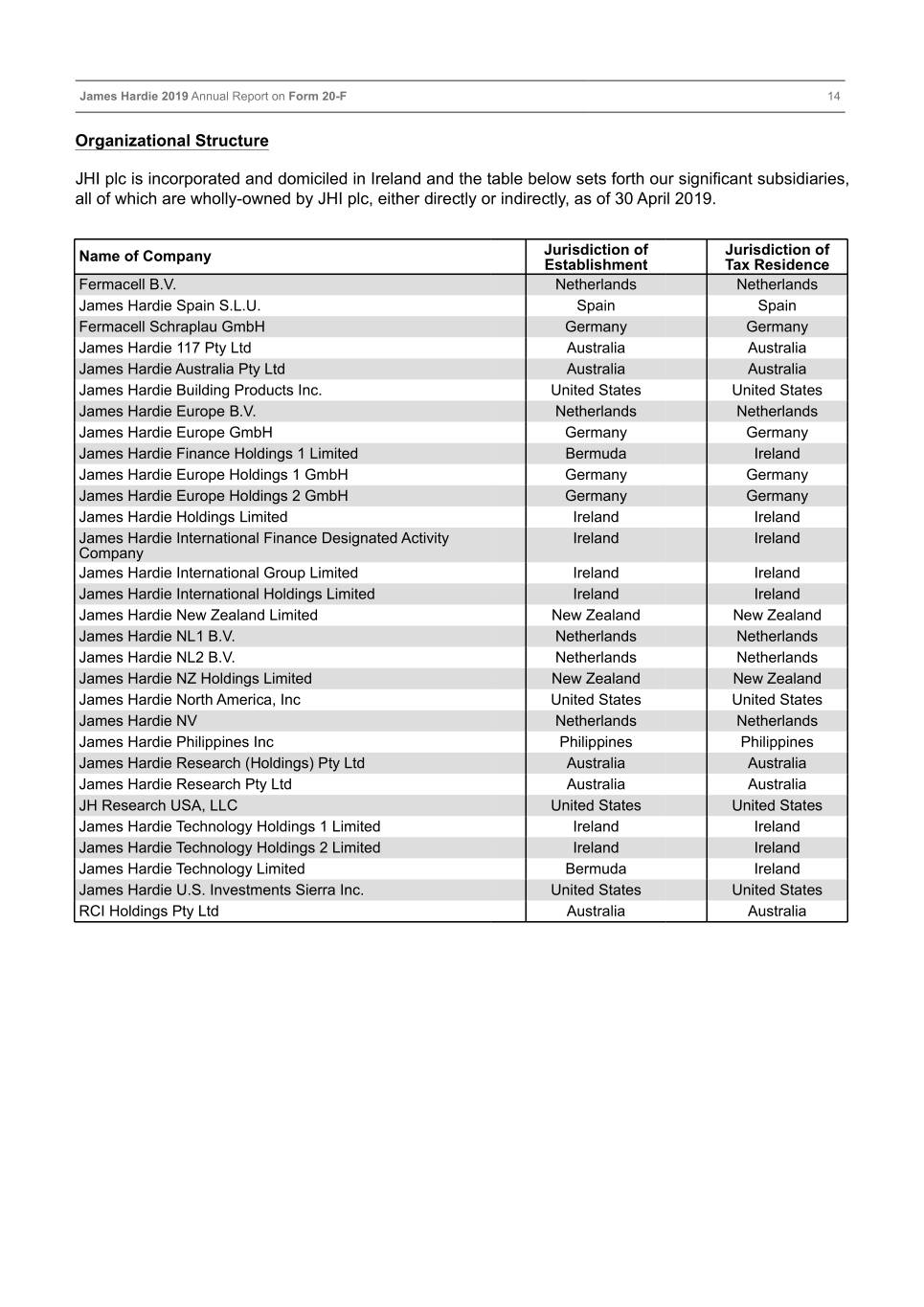
Table of Contents James Hardie 2019 Annual Report on Form 20-F 14 Organizational Structure JHI plc is incorporated and domiciled in Ireland and the table below sets forth our significant subsidiaries, all of which are wholly-owned by JHI plc, either directly or indirectly, as of 30 April 2019. Name of Company Jurisdiction of Jurisdiction of Establishment Tax Residence Fermacell B.V. Netherlands Netherlands James Hardie Spain S.L.U. Spain Spain Fermacell Schraplau GmbH Germany Germany James Hardie 117 Pty Ltd Australia Australia James Hardie Australia Pty Ltd Australia Australia James Hardie Building Products Inc. United States United States James Hardie Europe B.V. Netherlands Netherlands James Hardie Europe GmbH Germany Germany James Hardie Finance Holdings 1 Limited Bermuda Ireland James Hardie Europe Holdings 1 GmbH Germany Germany James Hardie Europe Holdings 2 GmbH Germany Germany James Hardie Holdings Limited Ireland Ireland James Hardie International Finance Designated Activity Ireland Ireland Company James Hardie International Group Limited Ireland Ireland James Hardie International Holdings Limited Ireland Ireland James Hardie New Zealand Limited New Zealand New Zealand James Hardie NL1 B.V. Netherlands Netherlands James Hardie NL2 B.V. Netherlands Netherlands James Hardie NZ Holdings Limited New Zealand New Zealand James Hardie North America, Inc United States United States James Hardie NV Netherlands Netherlands James Hardie Philippines Inc Philippines Philippines James Hardie Research (Holdings) Pty Ltd Australia Australia James Hardie Research Pty Ltd Australia Australia JH Research USA, LLC United States United States James Hardie Technology Holdings 1 Limited Ireland Ireland James Hardie Technology Holdings 2 Limited Ireland Ireland James Hardie Technology Limited Bermuda Ireland James Hardie U.S. Investments Sierra Inc. United States United States RCI Holdings Pty Ltd Australia Australia
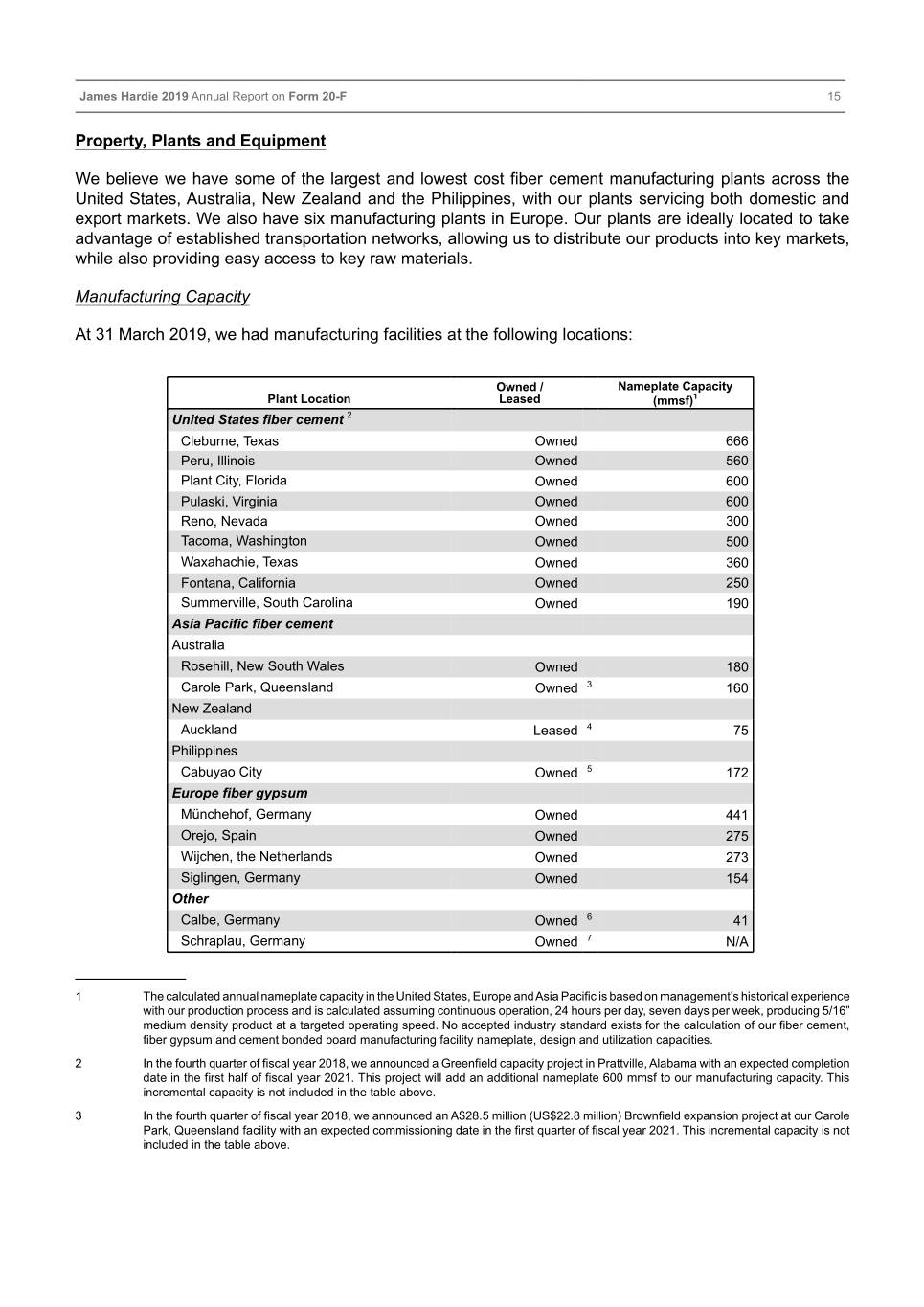
Table of Contents James Hardie 2019 Annual Report on Form 20-F 15 Property, Plants and Equipment We believe we have some of the largest and lowest cost fiber cement manufacturing plants across the United States, Australia, New Zealand and the Philippines, with our plants servicing both domestic and export markets. We also have six manufacturing plants in Europe. Our plants are ideally located to take advantage of established transportation networks, allowing us to distribute our products into key markets, while also providing easy access to key raw materials. Manufacturing Capacity At 31 March 2019, we had manufacturing facilities at the following locations: Owned / Nameplate Capacity Plant Location Leased (mmsf)1 United States fiber cement 2 Cleburne, Texas Owned 666 Peru, Illinois Owned 560 Plant City, Florida Owned 600 Pulaski, Virginia Owned 600 Reno, Nevada Owned 300 Tacoma, Washington Owned 500 Waxahachie, Texas Owned 360 Fontana, California Owned 250 Summerville, South Carolina Owned 190 Asia Pacific fiber cement Australia Rosehill, New South Wales Owned 180 Carole Park, Queensland Owned 3 160 New Zealand Auckland Leased 4 75 Philippines Cabuyao City Owned 5 172 Europe fiber gypsum Münchehof, Germany Owned 441 Orejo, Spain Owned 275 Wijchen, the Netherlands Owned 273 Siglingen, Germany Owned 154 Other Calbe, Germany Owned 6 41 Schraplau, Germany Owned 7 N/A ____________ 1 The calculated annual nameplate capacity in the United States, Europe and Asia Pacific is based on management’s historical experience with our production process and is calculated assuming continuous operation, 24 hours per day, seven days per week, producing 5/16” medium density product at a targeted operating speed. No accepted industry standard exists for the calculation of our fiber cement, fiber gypsum and cement bonded board manufacturing facility nameplate, design and utilization capacities. 2 In the fourth quarter of fiscal year 2018, we announced a Greenfield capacity project in Prattville, Alabama with an expected completion date in the first half of fiscal year 2021. This project will add an additional nameplate 600 mmsf to our manufacturing capacity. This incremental capacity is not included in the table above. 3 In the fourth quarter of fiscal year 2018, we announced an A$28.5 million (US$22.8 million) Brownfield expansion project at our Carole Park, Queensland facility with an expected commissioning date in the first quarter of fiscal year 2021. This incremental capacity is not included in the table above.
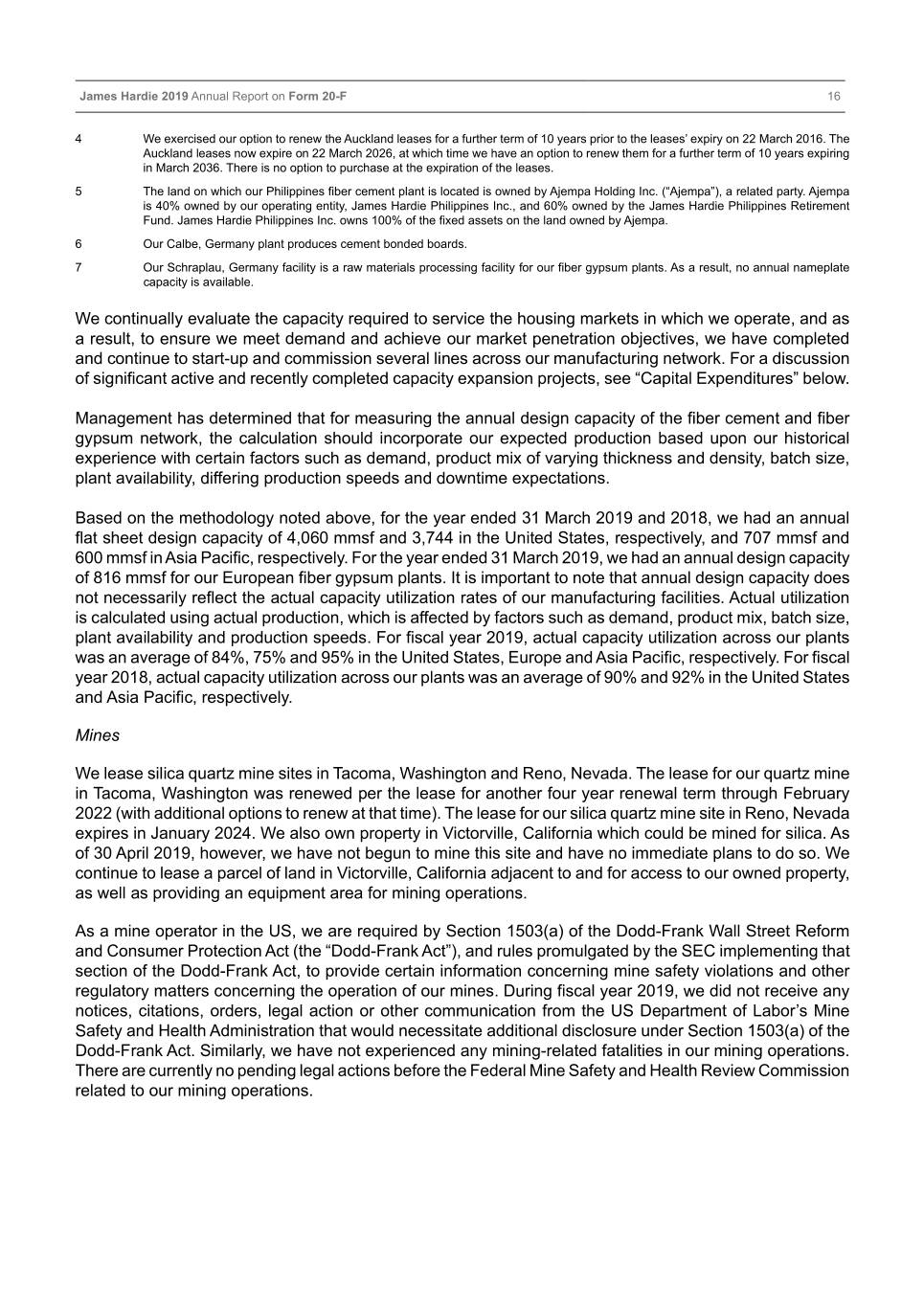
Table of Contents James Hardie 2019 Annual Report on Form 20-F 16 4 We exercised our option to renew the Auckland leases for a further term of 10 years prior to the leases’ expiry on 22 March 2016. The Auckland leases now expire on 22 March 2026, at which time we have an option to renew them for a further term of 10 years expiring in March 2036. There is no option to purchase at the expiration of the leases. 5 The land on which our Philippines fiber cement plant is located is owned by Ajempa Holding Inc. (“Ajempa”), a related party. Ajempa is 40% owned by our operating entity, James Hardie Philippines Inc., and 60% owned by the James Hardie Philippines Retirement Fund. James Hardie Philippines Inc. owns 100% of the fixed assets on the land owned by Ajempa. 6 Our Calbe, Germany plant produces cement bonded boards. 7 Our Schraplau, Germany facility is a raw materials processing facility for our fiber gypsum plants. As a result, no annual nameplate capacity is available. We continually evaluate the capacity required to service the housing markets in which we operate, and as a result, to ensure we meet demand and achieve our market penetration objectives, we have completed and continue to start-up and commission several lines across our manufacturing network. For a discussion of significant active and recently completed capacity expansion projects, see “Capital Expenditures” below. Management has determined that for measuring the annual design capacity of the fiber cement and fiber gypsum network, the calculation should incorporate our expected production based upon our historical experience with certain factors such as demand, product mix of varying thickness and density, batch size, plant availability, differing production speeds and downtime expectations. Based on the methodology noted above, for the year ended 31 March 2019 and 2018, we had an annual flat sheet design capacity of 4,060 mmsf and 3,744 in the United States, respectively, and 707 mmsf and 600 mmsf in Asia Pacific, respectively. For the year ended 31 March 2019, we had an annual design capacity of 816 mmsf for our European fiber gypsum plants. It is important to note that annual design capacity does not necessarily reflect the actual capacity utilization rates of our manufacturing facilities. Actual utilization is calculated using actual production, which is affected by factors such as demand, product mix, batch size, plant availability and production speeds. For fiscal year 2019, actual capacity utilization across our plants was an average of 84%, 75% and 95% in the United States, Europe and Asia Pacific, respectively. For fiscal year 2018, actual capacity utilization across our plants was an average of 90% and 92% in the United States and Asia Pacific, respectively. Mines We lease silica quartz mine sites in Tacoma, Washington and Reno, Nevada. The lease for our quartz mine in Tacoma, Washington was renewed per the lease for another four year renewal term through February 2022 (with additional options to renew at that time). The lease for our silica quartz mine site in Reno, Nevada expires in January 2024. We also own property in Victorville, California which could be mined for silica. As of 30 April 2019, however, we have not begun to mine this site and have no immediate plans to do so. We continue to lease a parcel of land in Victorville, California adjacent to and for access to our owned property, as well as providing an equipment area for mining operations. As a mine operator in the US, we are required by Section 1503(a) of the Dodd-Frank Wall Street Reform and Consumer Protection Act (the “Dodd-Frank Act”), and rules promulgated by the SEC implementing that section of the Dodd-Frank Act, to provide certain information concerning mine safety violations and other regulatory matters concerning the operation of our mines. During fiscal year 2019, we did not receive any notices, citations, orders, legal action or other communication from the US Department of Labor’s Mine Safety and Health Administration that would necessitate additional disclosure under Section 1503(a) of the Dodd-Frank Act. Similarly, we have not experienced any mining-related fatalities in our mining operations. There are currently no pending legal actions before the Federal Mine Safety and Health Review Commission related to our mining operations.
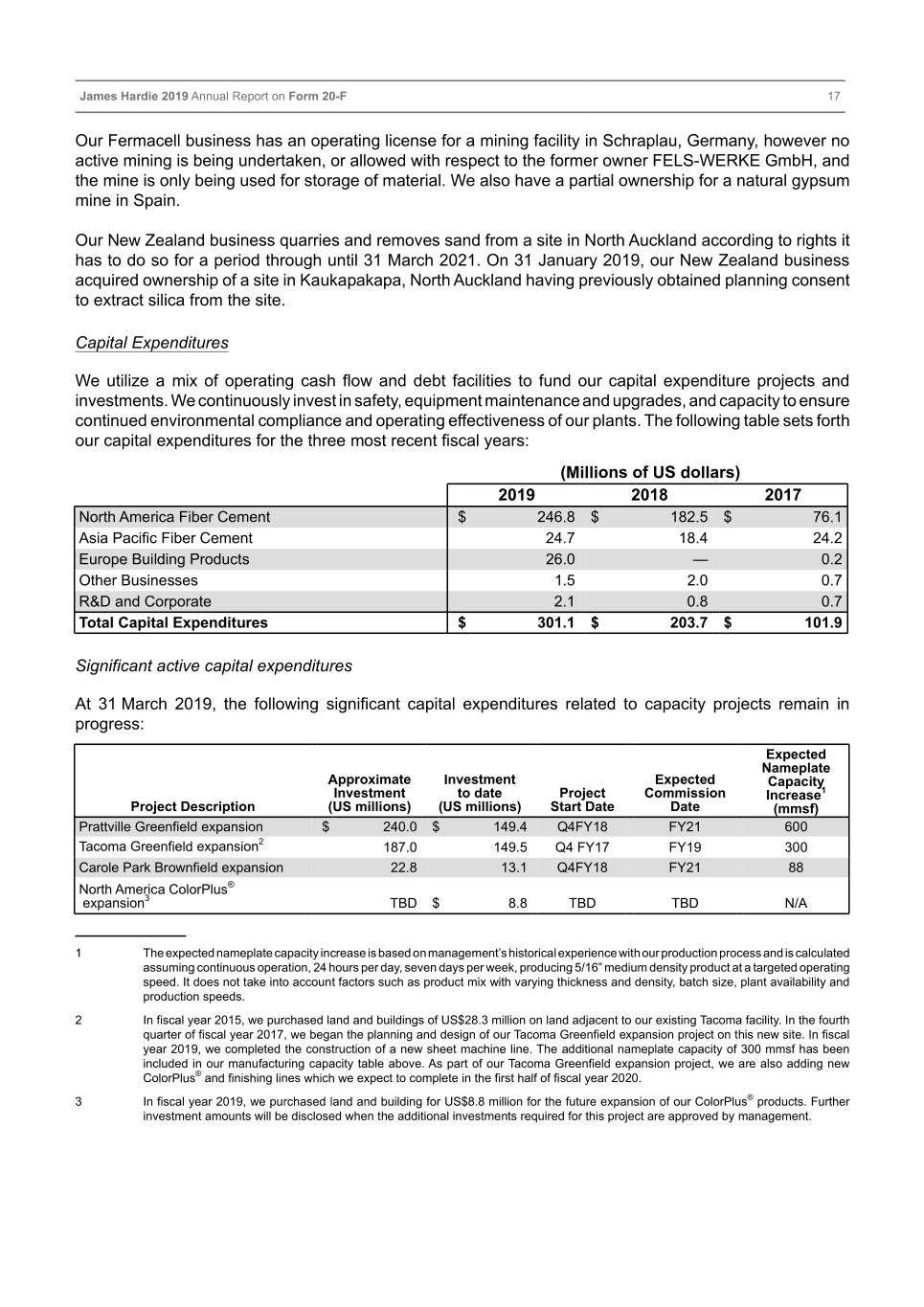
Table of Contents James Hardie 2019 Annual Report on Form 20-F 17 Our Fermacell business has an operating license for a mining facility in Schraplau, Germany, however no active mining is being undertaken, or allowed with respect to the former owner FELS-WERKE GmbH, and the mine is only being used for storage of material. We also have a partial ownership for a natural gypsum mine in Spain. Our New Zealand business quarries and removes sand from a site in North Auckland according to rights it has to do so for a period through until 31 March 2021. On 31 January 2019, our New Zealand business acquired ownership of a site in Kaukapakapa, North Auckland having previously obtained planning consent to extract silica from the site. Capital Expenditures We utilize a mix of operating cash flow and debt facilities to fund our capital expenditure projects and investments. We continuously invest in safety, equipment maintenance and upgrades, and capacity to ensure continued environmental compliance and operating effectiveness of our plants. The following table sets forth our capital expenditures for the three most recent fiscal years: (Millions of US dollars) 2019 2018 2017 North America Fiber Cement $ 246.8 $ 182.5 $ 76.1 Asia Pacific Fiber Cement 24.7 18.4 24.2 Europe Building Products 26.0 — 0.2 Other Businesses 1.5 2.0 0.7 R&D and Corporate 2.1 0.8 0.7 Total Capital Expenditures $ 301.1 $ 203.7 $ 101.9 Significant active capital expenditures At 31 March 2019, the following significant capital expenditures related to capacity projects remain in progress: Expected Nameplate Approximate Investment Expected Capacity Investment to date Project Commission Increase1 Project Description (US millions) (US millions) Start Date Date (mmsf) Prattville Greenfield expansion $ 240.0 $ 149.4 Q4FY18 FY21 600 Tacoma Greenfield expansion2 187.0 149.5 Q4 FY17 FY19 300 Carole Park Brownfield expansion 22.8 13.1 Q4FY18 FY21 88 North America ColorPlus® expansion3 TBD $ 8.8 TBD TBD N/A ____________ 1 The expected nameplate capacity increase is based on management’s historical experience with our production process and is calculated assuming continuous operation, 24 hours per day, seven days per week, producing 5/16” medium density product at a targeted operating speed. It does not take into account factors such as product mix with varying thickness and density, batch size, plant availability and production speeds. 2 In fiscal year 2015, we purchased land and buildings of US$28.3 million on land adjacent to our existing Tacoma facility. In the fourth quarter of fiscal year 2017, we began the planning and design of our Tacoma Greenfield expansion project on this new site. In fiscal year 2019, we completed the construction of a new sheet machine line. The additional nameplate capacity of 300 mmsf has been included in our manufacturing capacity table above. As part of our Tacoma Greenfield expansion project, we are also adding new ColorPlus® and finishing lines which we expect to complete in the first half of fiscal year 2020. 3 In fiscal year 2019, we purchased land and building for US$8.8 million for the future expansion of our ColorPlus® products. Further investment amounts will be disclosed when the additional investments required for this project are approved by management.
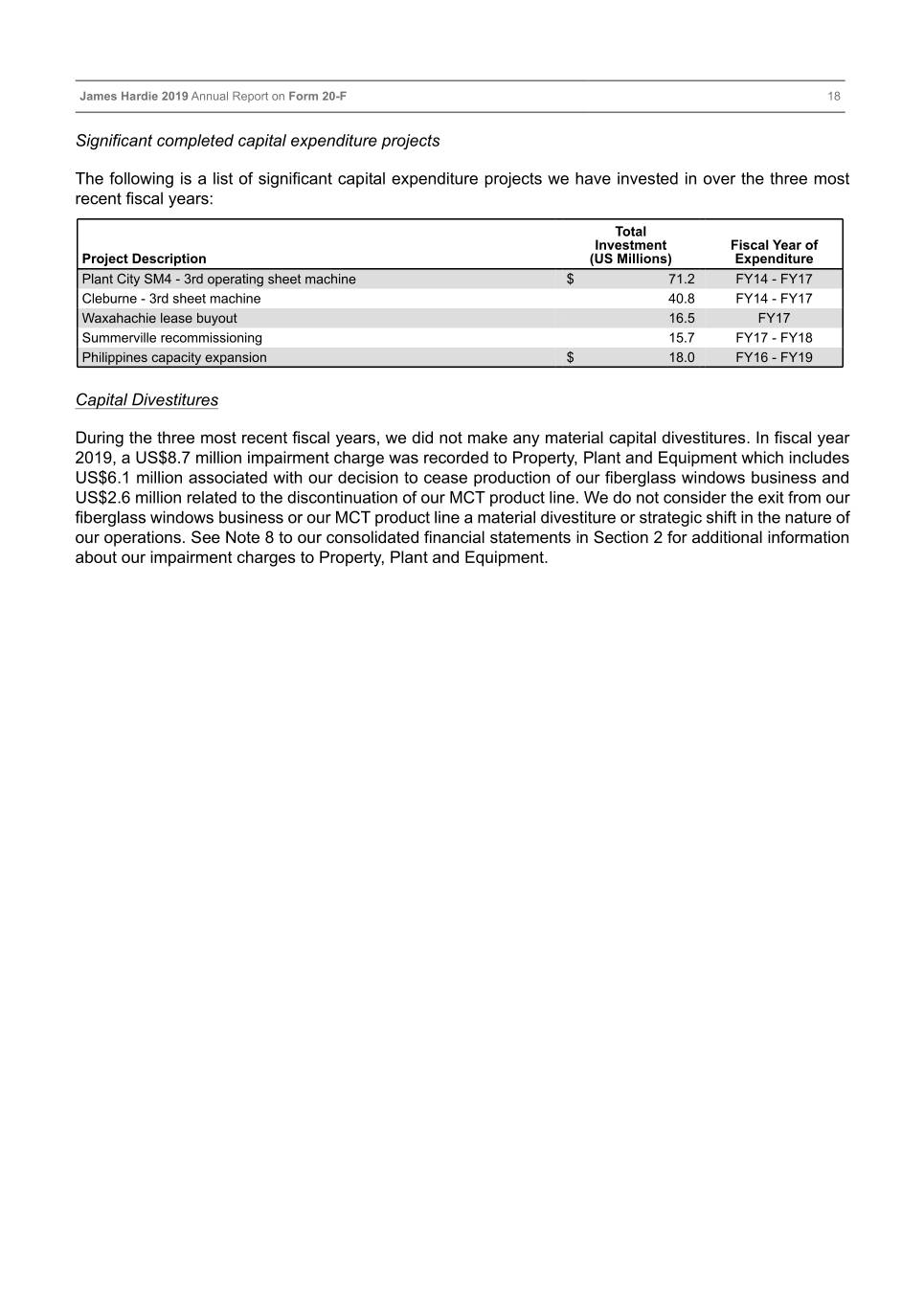
Table of Contents James Hardie 2019 Annual Report on Form 20-F 18 Significant completed capital expenditure projects The following is a list of significant capital expenditure projects we have invested in over the three most recent fiscal years: Total Investment Fiscal Year of Project Description (US Millions) Expenditure Plant City SM4 - 3rd operating sheet machine $ 71.2 FY14 - FY17 Cleburne - 3rd sheet machine 40.8 FY14 - FY17 Waxahachie lease buyout 16.5 FY17 Summerville recommissioning 15.7 FY17 - FY18 Philippines capacity expansion $ 18.0 FY16 - FY19 Capital Divestitures During the three most recent fiscal years, we did not make any material capital divestitures. In fiscal year 2019, a US$8.7 million impairment charge was recorded to Property, Plant and Equipment which includes US$6.1 million associated with our decision to cease production of our fiberglass windows business and US$2.6 million related to the discontinuation of our MCT product line. We do not consider the exit from our fiberglass windows business or our MCT product line a material divestiture or strategic shift in the nature of our operations. See Note 8 to our consolidated financial statements in Section 2 for additional information about our impairment charges to Property, Plant and Equipment.
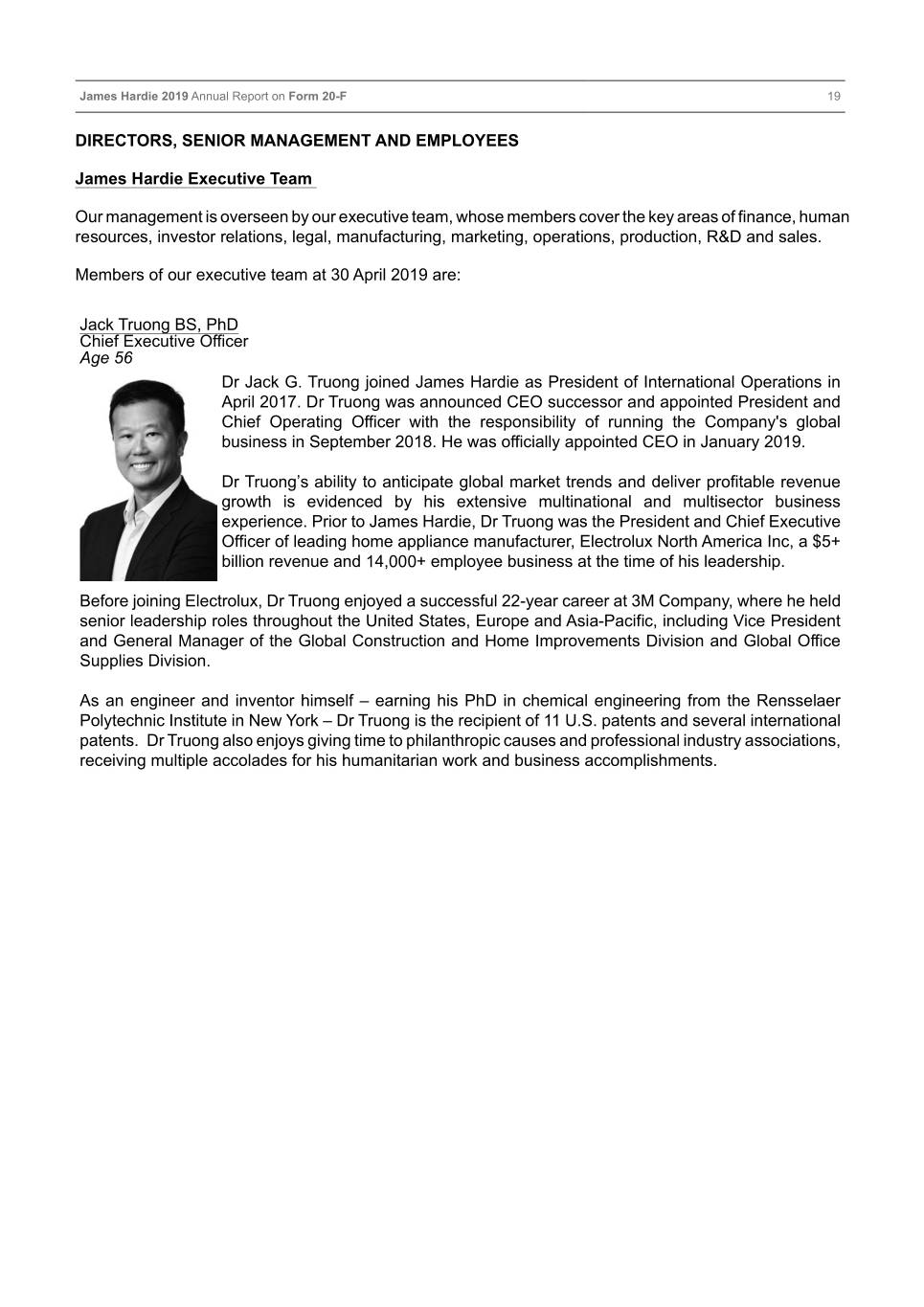
Table of Contents James Hardie 2019 Annual Report on Form 20-F 19 DIRECTORS, SENIOR MANAGEMENT AND EMPLOYEES James Hardie Executive Team Our management is overseen by our executive team, whose members cover the key areas of finance, human resources, investor relations, legal, manufacturing, marketing, operations, production, R&D and sales. Members of our executive team at 30 April 2019 are: Jack Truong BS, PhD Chief Executive Officer Age 56 Dr Jack G. Truong joined James Hardie as President of International Operations in April 2017. Dr Truong was announced CEO successor and appointed President and Chief Operating Officer with the responsibility of running the Company's global business in September 2018. He was officially appointed CEO in January 2019. Dr Truong’s ability to anticipate global market trends and deliver profitable revenue growth is evidenced by his extensive multinational and multisector business experience. Prior to James Hardie, Dr Truong was the President and Chief Executive Officer of leading home appliance manufacturer, Electrolux North America Inc, a $5+ billion revenue and 14,000+ employee business at the time of his leadership. Before joining Electrolux, Dr Truong enjoyed a successful 22-year career at 3M Company, where he held senior leadership roles throughout the United States, Europe and Asia-Pacific, including Vice President and General Manager of the Global Construction and Home Improvements Division and Global Office Supplies Division. As an engineer and inventor himself – earning his PhD in chemical engineering from the Rensselaer Polytechnic Institute in New York – Dr Truong is the recipient of 11 U.S. patents and several international patents. Dr Truong also enjoys giving time to philanthropic causes and professional industry associations, receiving multiple accolades for his humanitarian work and business accomplishments.
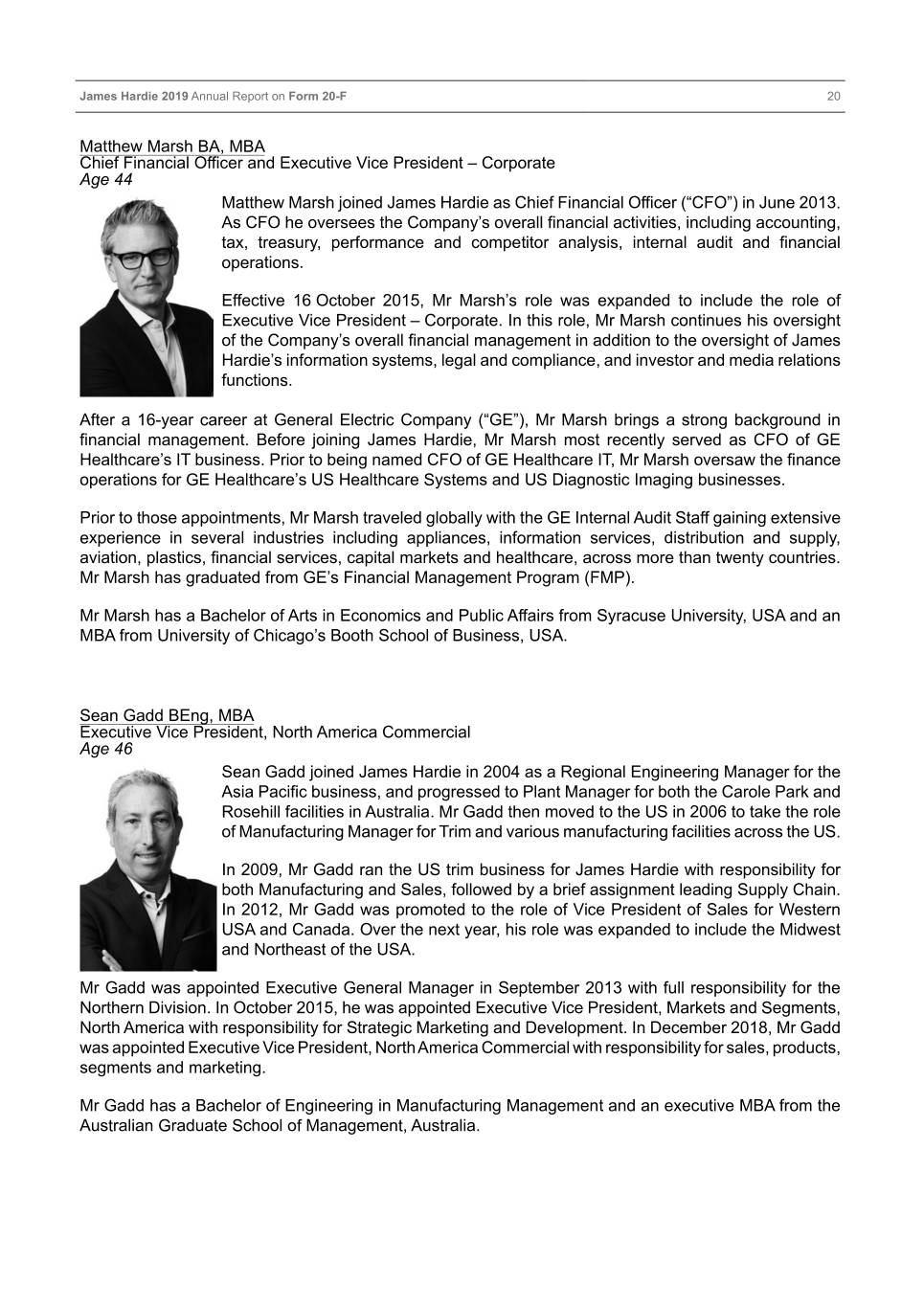
Table of Contents James Hardie 2019 Annual Report on Form 20-F 20 Matthew Marsh BA, MBA Chief Financial Officer and Executive Vice President – Corporate Age 44 Matthew Marsh joined James Hardie as Chief Financial Officer (“CFO”) in June 2013. As CFO he oversees the Company’s overall financial activities, including accounting, tax, treasury, performance and competitor analysis, internal audit and financial operations. Effective 16 October 2015, Mr Marsh’s role was expanded to include the role of Executive Vice President – Corporate. In this role, Mr Marsh continues his oversight of the Company’s overall financial management in addition to the oversight of James Hardie’s information systems, legal and compliance, and investor and media relations functions. After a 16-year career at General Electric Company (“GE”), Mr Marsh brings a strong background in financial management. Before joining James Hardie, Mr Marsh most recently served as CFO of GE Healthcare’s IT business. Prior to being named CFO of GE Healthcare IT, Mr Marsh oversaw the finance operations for GE Healthcare’s US Healthcare Systems and US Diagnostic Imaging businesses. Prior to those appointments, Mr Marsh traveled globally with the GE Internal Audit Staff gaining extensive experience in several industries including appliances, information services, distribution and supply, aviation, plastics, financial services, capital markets and healthcare, across more than twenty countries. Mr Marsh has graduated from GE’s Financial Management Program (FMP). Mr Marsh has a Bachelor of Arts in Economics and Public Affairs from Syracuse University, USA and an MBA from University of Chicago’s Booth School of Business, USA. Sean Gadd BEng, MBA Executive Vice President, North America Commercial Age 46 Sean Gadd joined James Hardie in 2004 as a Regional Engineering Manager for the Asia Pacific business, and progressed to Plant Manager for both the Carole Park and Rosehill facilities in Australia. Mr Gadd then moved to the US in 2006 to take the role of Manufacturing Manager for Trim and various manufacturing facilities across the US. In 2009, Mr Gadd ran the US trim business for James Hardie with responsibility for both Manufacturing and Sales, followed by a brief assignment leading Supply Chain. In 2012, Mr Gadd was promoted to the role of Vice President of Sales for Western USA and Canada. Over the next year, his role was expanded to include the Midwest and Northeast of the USA. Mr Gadd was appointed Executive General Manager in September 2013 with full responsibility for the Northern Division. In October 2015, he was appointed Executive Vice President, Markets and Segments, North America with responsibility for Strategic Marketing and Development. In December 2018, Mr Gadd was appointed Executive Vice President, North America Commercial with responsibility for sales, products, segments and marketing. Mr Gadd has a Bachelor of Engineering in Manufacturing Management and an executive MBA from the Australian Graduate School of Management, Australia.
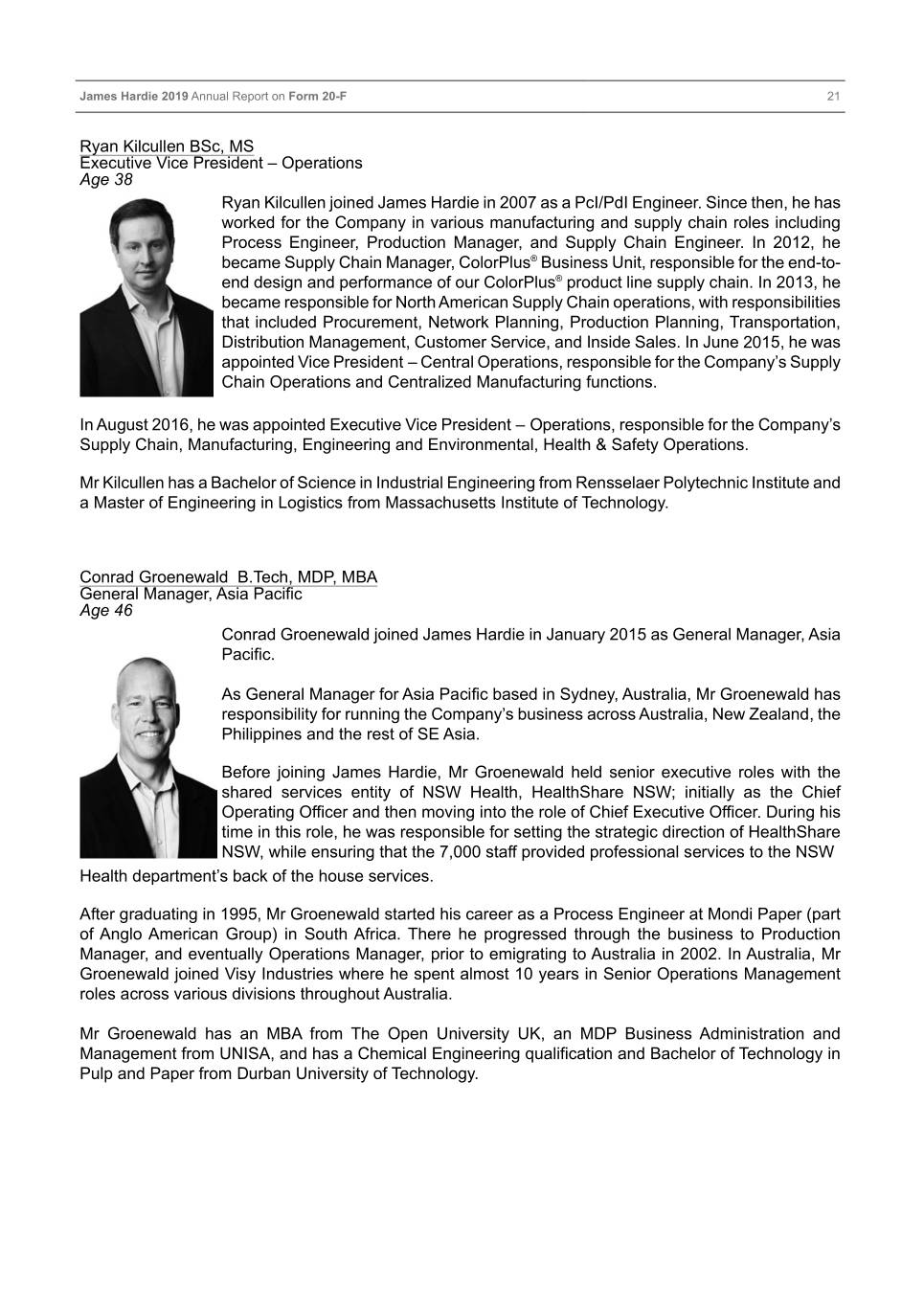
Table of Contents James Hardie 2019 Annual Report on Form 20-F 21 Ryan Kilcullen BSc, MS Executive Vice President – Operations Age 38 Ryan Kilcullen joined James Hardie in 2007 as a PcI/PdI Engineer. Since then, he has worked for the Company in various manufacturing and supply chain roles including Process Engineer, Production Manager, and Supply Chain Engineer. In 2012, he became Supply Chain Manager, ColorPlus® Business Unit, responsible for the end-to- end design and performance of our ColorPlus® product line supply chain. In 2013, he became responsible for North American Supply Chain operations, with responsibilities that included Procurement, Network Planning, Production Planning, Transportation, Distribution Management, Customer Service, and Inside Sales. In June 2015, he was appointed Vice President – Central Operations, responsible for the Company’s Supply Chain Operations and Centralized Manufacturing functions. In August 2016, he was appointed Executive Vice President – Operations, responsible for the Company’s Supply Chain, Manufacturing, Engineering and Environmental, Health & Safety Operations. Mr Kilcullen has a Bachelor of Science in Industrial Engineering from Rensselaer Polytechnic Institute and a Master of Engineering in Logistics from Massachusetts Institute of Technology. Conrad Groenewald B.Tech, MDP, MBA General Manager, Asia Pacific Age 46 Conrad Groenewald joined James Hardie in January 2015 as General Manager, Asia Pacific. As General Manager for Asia Pacific based in Sydney, Australia, Mr Groenewald has responsibility for running the Company’s business across Australia, New Zealand, the Philippines and the rest of SE Asia. Before joining James Hardie, Mr Groenewald held senior executive roles with the shared services entity of NSW Health, HealthShare NSW; initially as the Chief Operating Officer and then moving into the role of Chief Executive Officer. During his time in this role, he was responsible for setting the strategic direction of HealthShare NSW, while ensuring that the 7,000 staff provided professional services to the NSW Health department’s back of the house services. After graduating in 1995, Mr Groenewald started his career as a Process Engineer at Mondi Paper (part of Anglo American Group) in South Africa. There he progressed through the business to Production Manager, and eventually Operations Manager, prior to emigrating to Australia in 2002. In Australia, Mr Groenewald joined Visy Industries where he spent almost 10 years in Senior Operations Management roles across various divisions throughout Australia. Mr Groenewald has an MBA from The Open University UK, an MDP Business Administration and Management from UNISA, and has a Chemical Engineering qualification and Bachelor of Technology in Pulp and Paper from Durban University of Technology.
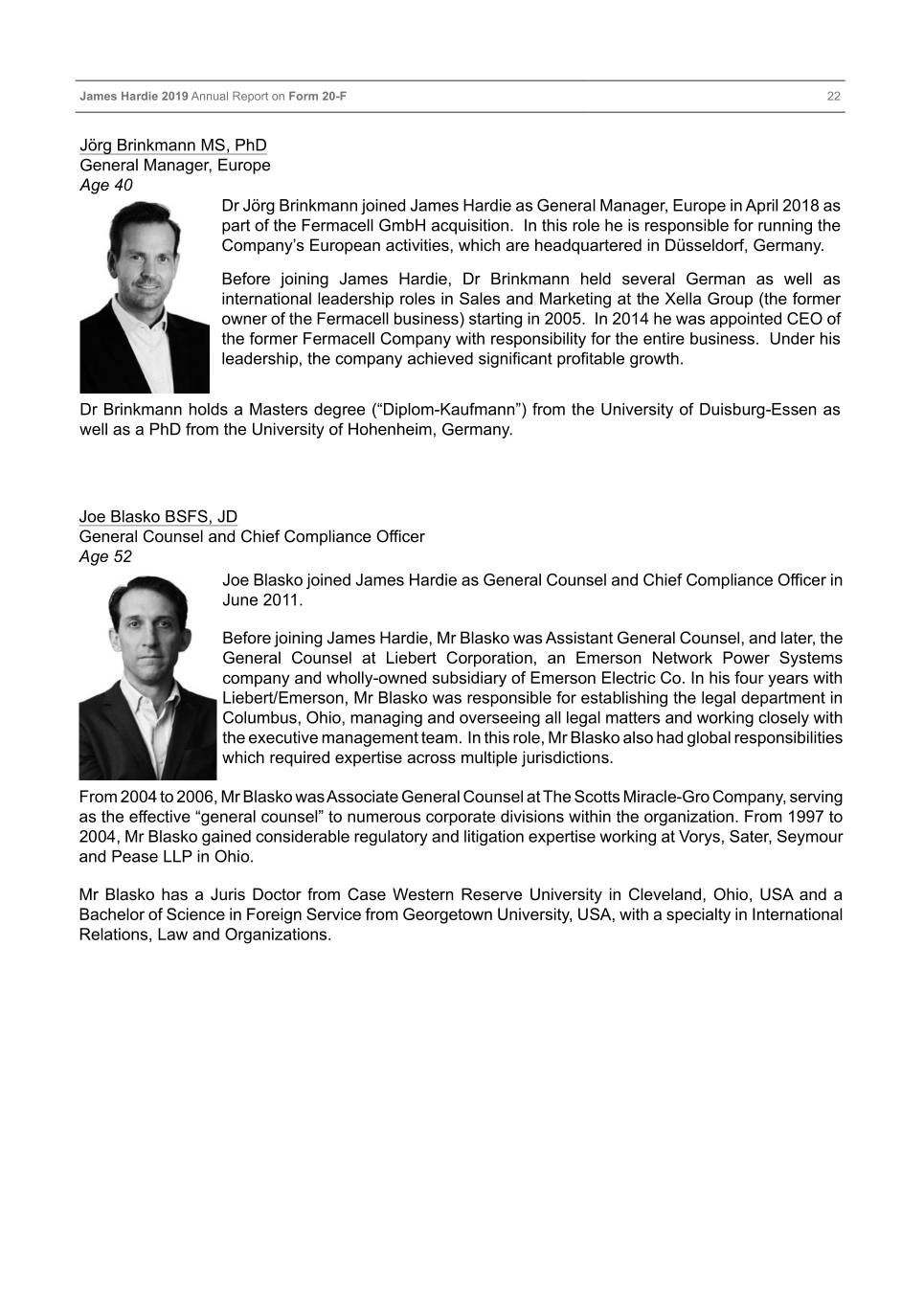
Table of Contents James Hardie 2019 Annual Report on Form 20-F 22 Jörg Brinkmann MS, PhD General Manager, Europe Age 40 Dr Jörg Brinkmann joined James Hardie as General Manager, Europe in April 2018 as part of the Fermacell GmbH acquisition. In this role he is responsible for running the Company’s European activities, which are headquartered in Düsseldorf, Germany. Before joining James Hardie, Dr Brinkmann held several German as well as international leadership roles in Sales and Marketing at the Xella Group (the former owner of the Fermacell business) starting in 2005. In 2014 he was appointed CEO of the former Fermacell Company with responsibility for the entire business. Under his leadership, the company achieved significant profitable growth. Dr Brinkmann holds a Masters degree (“Diplom-Kaufmann”) from the University of Duisburg-Essen as well as a PhD from the University of Hohenheim, Germany. Joe Blasko BSFS, JD General Counsel and Chief Compliance Officer Age 52 Joe Blasko joined James Hardie as General Counsel and Chief Compliance Officer in June 2011. Before joining James Hardie, Mr Blasko was Assistant General Counsel, and later, the General Counsel at Liebert Corporation, an Emerson Network Power Systems company and wholly-owned subsidiary of Emerson Electric Co. In his four years with Liebert/Emerson, Mr Blasko was responsible for establishing the legal department in Columbus, Ohio, managing and overseeing all legal matters and working closely with the executive management team. In this role, Mr Blasko also had global responsibilities which required expertise across multiple jurisdictions. From 2004 to 2006, Mr Blasko was Associate General Counsel at The Scotts Miracle-Gro Company, serving as the effective “general counsel” to numerous corporate divisions within the organization. From 1997 to 2004, Mr Blasko gained considerable regulatory and litigation expertise working at Vorys, Sater, Seymour and Pease LLP in Ohio. Mr Blasko has a Juris Doctor from Case Western Reserve University in Cleveland, Ohio, USA and a Bachelor of Science in Foreign Service from Georgetown University, USA, with a specialty in International Relations, Law and Organizations.
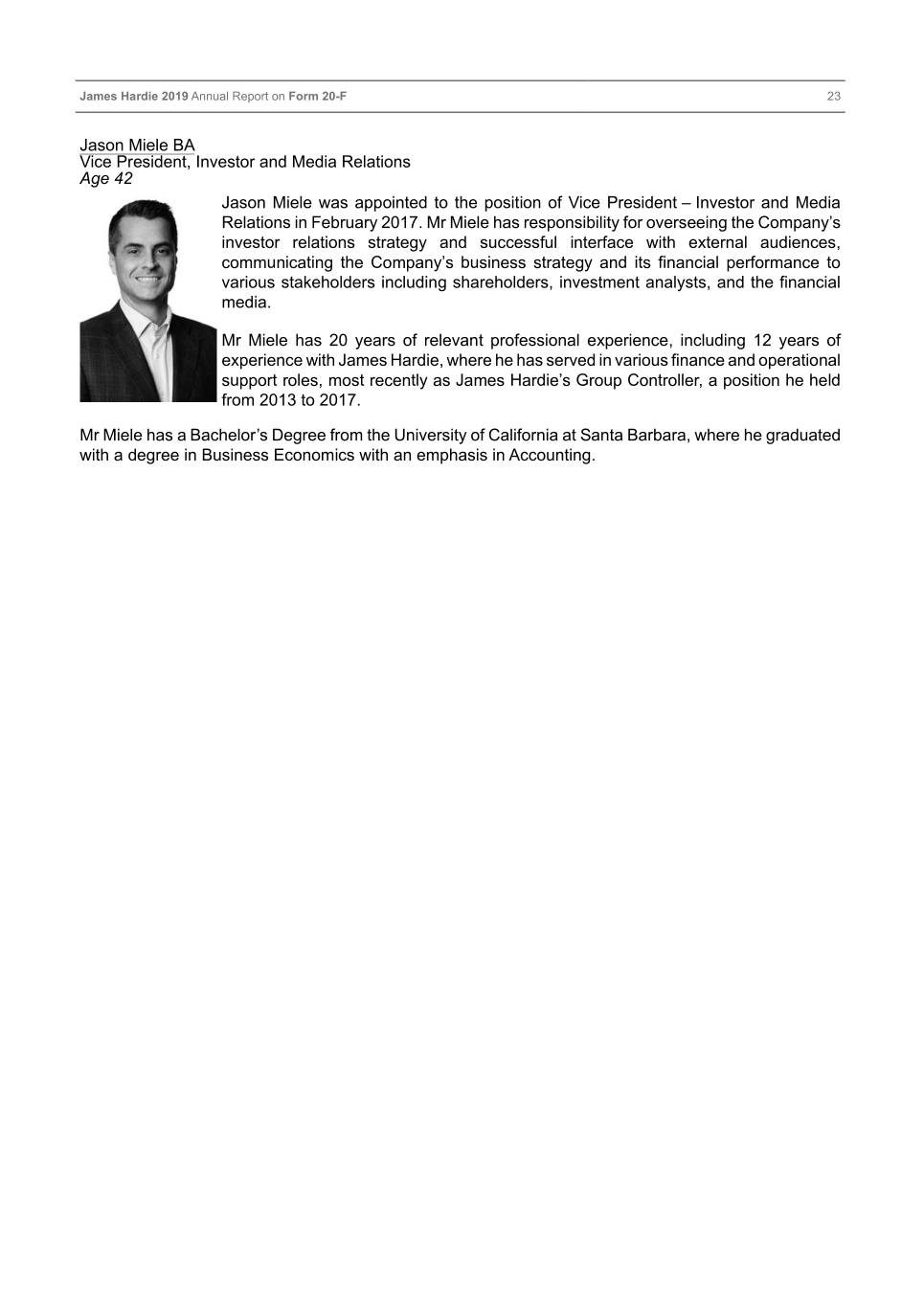
Table of Contents James Hardie 2019 Annual Report on Form 20-F 23 Jason Miele BA Vice President, Investor and Media Relations Age 42 Jason Miele was appointed to the position of Vice President – Investor and Media Relations in February 2017. Mr Miele has responsibility for overseeing the Company’s investor relations strategy and successful interface with external audiences, communicating the Company’s business strategy and its financial performance to various stakeholders including shareholders, investment analysts, and the financial media. Mr Miele has 20 years of relevant professional experience, including 12 years of experience with James Hardie, where he has served in various finance and operational support roles, most recently as James Hardie’s Group Controller, a position he held from 2013 to 2017. Mr Miele has a Bachelor’s Degree from the University of California at Santa Barbara, where he graduated with a degree in Business Economics with an emphasis in Accounting.
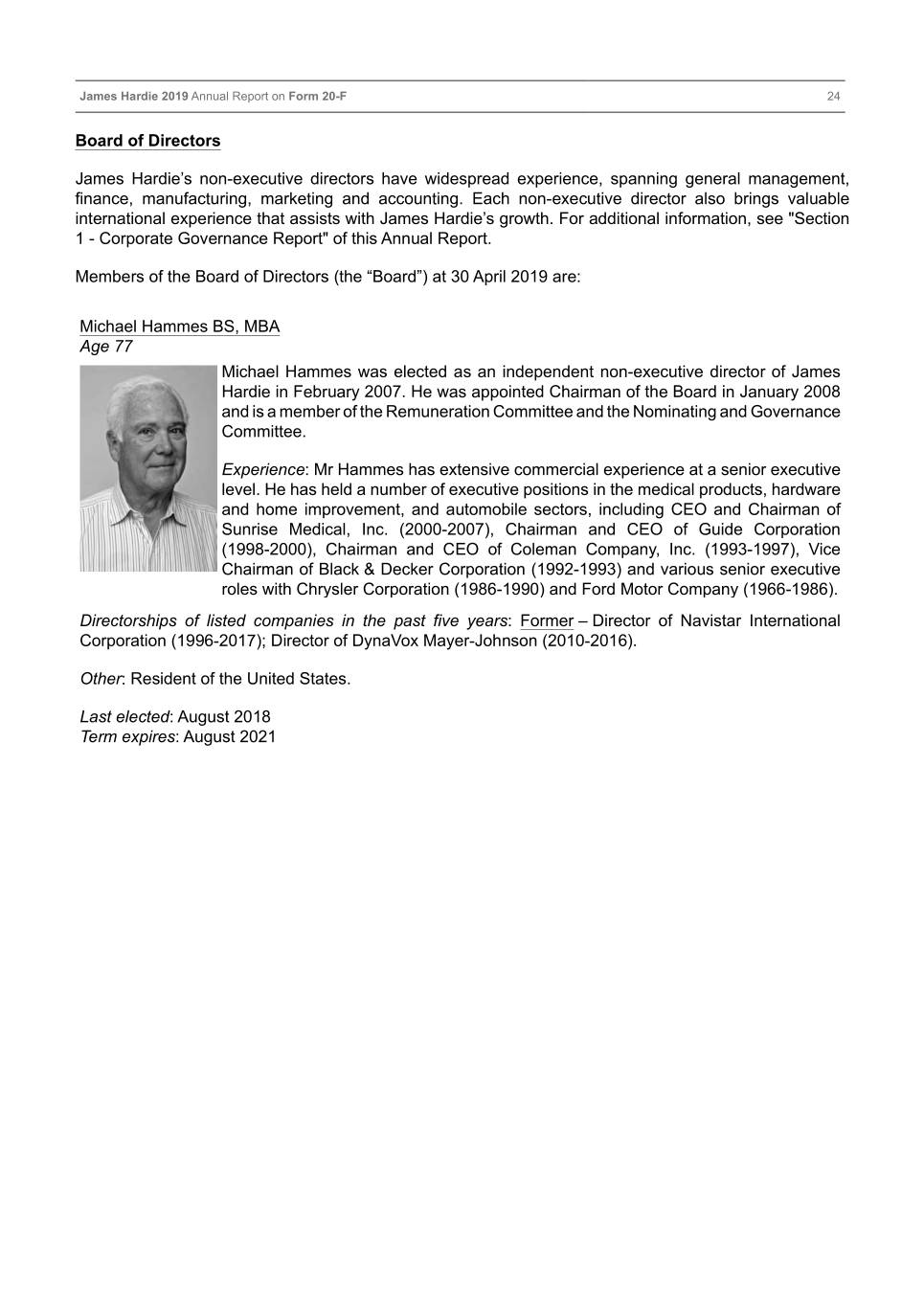
Table of Contents James Hardie 2019 Annual Report on Form 20-F 24 Board of Directors James Hardie’s non-executive directors have widespread experience, spanning general management, finance, manufacturing, marketing and accounting. Each non-executive director also brings valuable international experience that assists with James Hardie’s growth. For additional information, see "Section 1 - Corporate Governance Report" of this Annual Report. Members of the Board of Directors (the “Board”) at 30 April 2019 are: Michael Hammes BS, MBA Age 77 Michael Hammes was elected as an independent non-executive director of James Hardie in February 2007. He was appointed Chairman of the Board in January 2008 and is a member of the Remuneration Committee and the Nominating and Governance Committee. Experience: Mr Hammes has extensive commercial experience at a senior executive level. He has held a number of executive positions in the medical products, hardware and home improvement, and automobile sectors, including CEO and Chairman of Sunrise Medical, Inc. (2000-2007), Chairman and CEO of Guide Corporation (1998-2000), Chairman and CEO of Coleman Company, Inc. (1993-1997), Vice Chairman of Black & Decker Corporation (1992-1993) and various senior executive roles with Chrysler Corporation (1986-1990) and Ford Motor Company (1966-1986). Directorships of listed companies in the past five years: Former – Director of Navistar International Corporation (1996-2017); Director of DynaVox Mayer-Johnson (2010-2016). Other: Resident of the United States. Last elected: August 2018 Term expires: August 2021
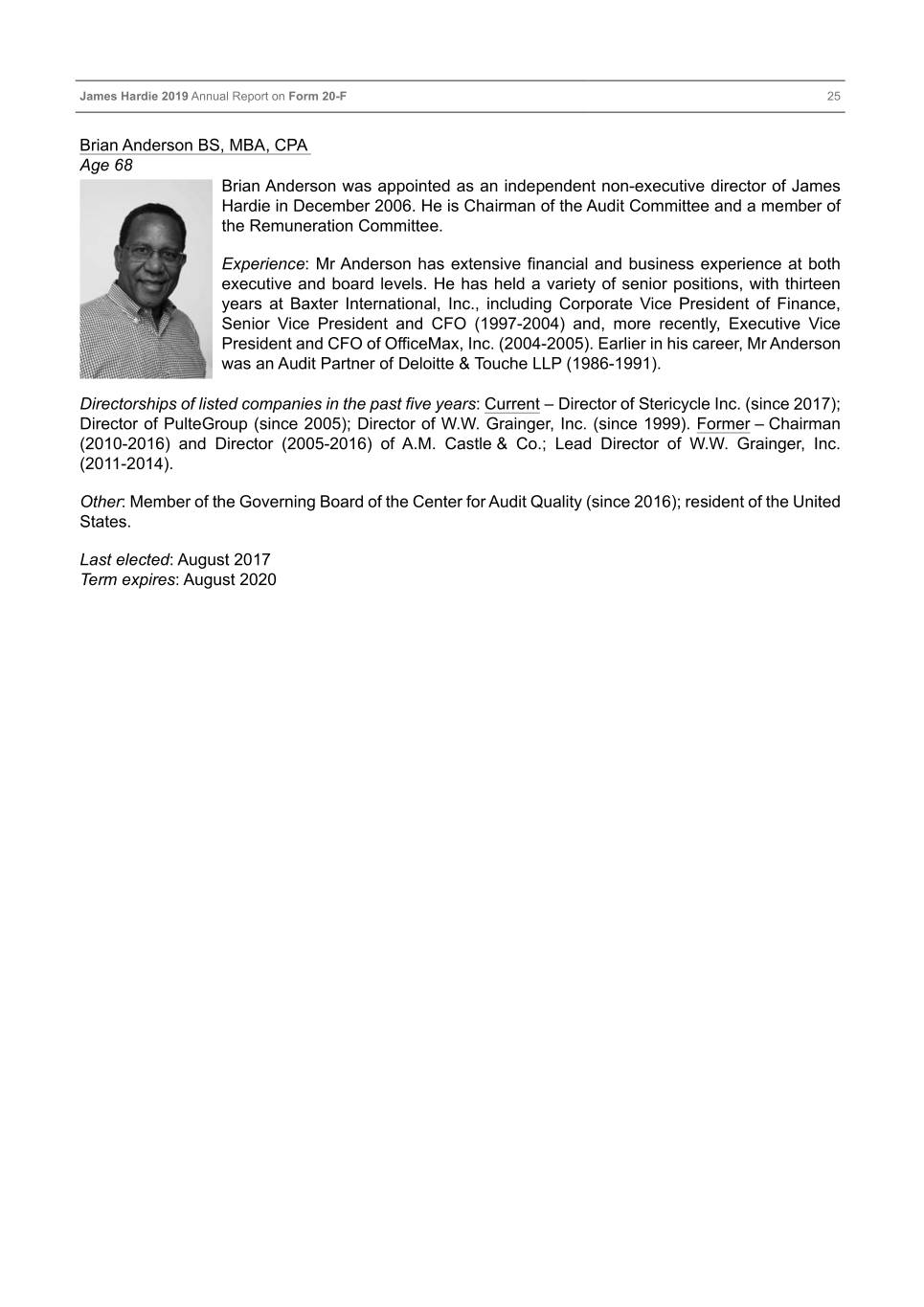
Table of Contents James Hardie 2019 Annual Report on Form 20-F 25 Brian Anderson BS, MBA, CPA Age 68 Brian Anderson was appointed as an independent non-executive director of James Hardie in December 2006. He is Chairman of the Audit Committee and a member of the Remuneration Committee. Experience: Mr Anderson has extensive financial and business experience at both executive and board levels. He has held a variety of senior positions, with thirteen years at Baxter International, Inc., including Corporate Vice President of Finance, Senior Vice President and CFO (1997-2004) and, more recently, Executive Vice President and CFO of OfficeMax, Inc. (2004-2005). Earlier in his career, Mr Anderson was an Audit Partner of Deloitte & Touche LLP (1986-1991). Directorships of listed companies in the past five years: Current – Director of Stericycle Inc. (since 2017); Director of PulteGroup (since 2005); Director of W.W. Grainger, Inc. (since 1999). Former – Chairman (2010-2016) and Director (2005-2016) of A.M. Castle & Co.; Lead Director of W.W. Grainger, Inc. (2011-2014). Other: Member of the Governing Board of the Center for Audit Quality (since 2016); resident of the United States. Last elected: August 2017 Term expires: August 2020
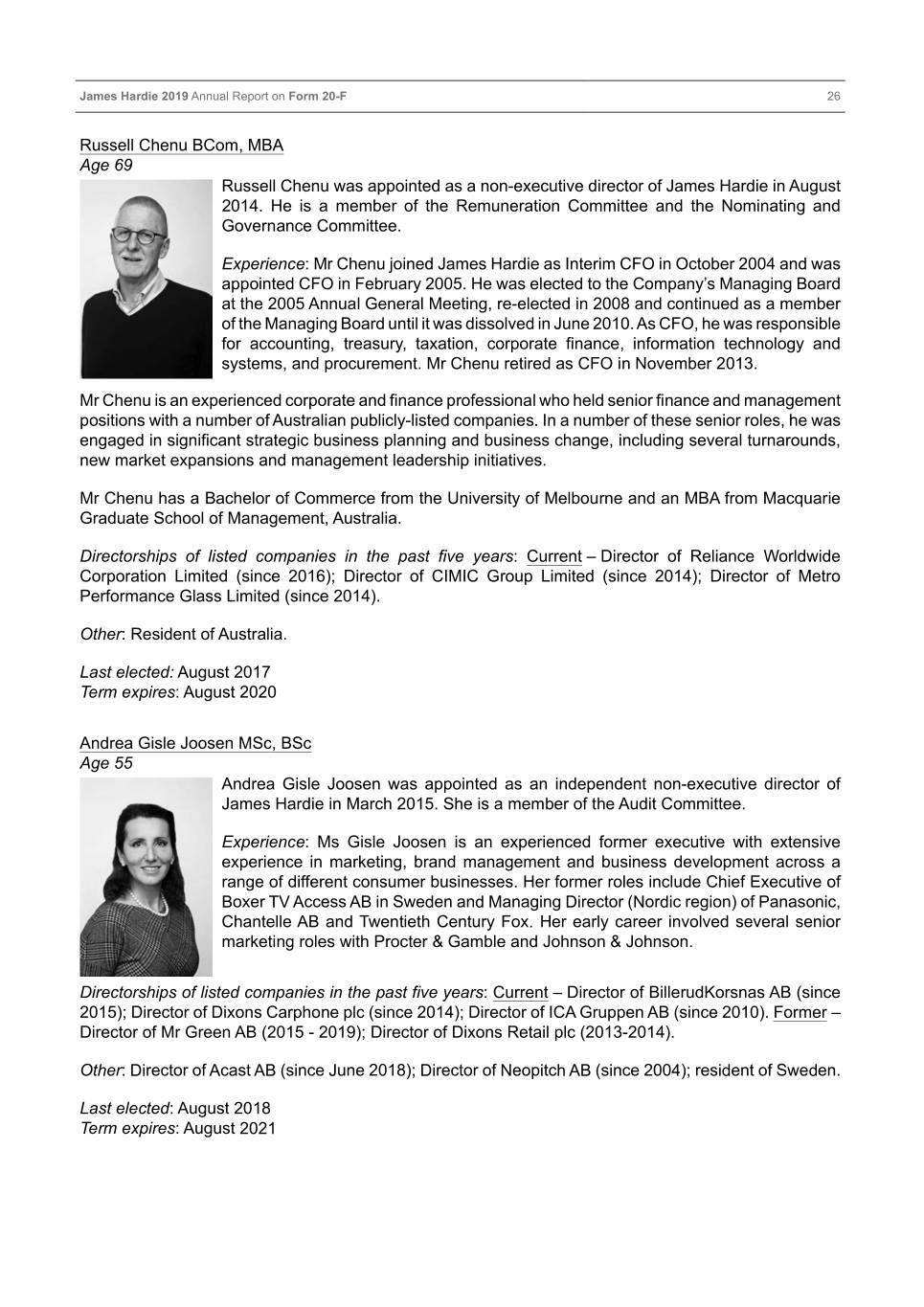
Table of Contents James Hardie 2019 Annual Report on Form 20-F 26 Russell Chenu BCom, MBA Age 69 Russell Chenu was appointed as a non-executive director of James Hardie in August 2014. He is a member of the Remuneration Committee and the Nominating and Governance Committee. Experience: Mr Chenu joined James Hardie as Interim CFO in October 2004 and was appointed CFO in February 2005. He was elected to the Company’s Managing Board at the 2005 Annual General Meeting, re-elected in 2008 and continued as a member of the Managing Board until it was dissolved in June 2010. As CFO, he was responsible for accounting, treasury, taxation, corporate finance, information technology and systems, and procurement. Mr Chenu retired as CFO in November 2013. Mr Chenu is an experienced corporate and finance professional who held senior finance and management positions with a number of Australian publicly-listed companies. In a number of these senior roles, he was engaged in significant strategic business planning and business change, including several turnarounds, new market expansions and management leadership initiatives. Mr Chenu has a Bachelor of Commerce from the University of Melbourne and an MBA from Macquarie Graduate School of Management, Australia. Directorships of listed companies in the past five years: Current – Director of Reliance Worldwide Corporation Limited (since 2016); Director of CIMIC Group Limited (since 2014); Director of Metro Performance Glass Limited (since 2014). Other: Resident of Australia. Last elected: August 2017 Term expires: August 2020 Andrea Gisle Joosen MSc, BSc Age 55 Andrea Gisle Joosen was appointed as an independent non-executive director of James Hardie in March 2015. She is a member of the Audit Committee. Experience: Ms Gisle Joosen is an experienced former executive with extensive experience in marketing, brand management and business development across a range of different consumer businesses. Her former roles include Chief Executive of Boxer TV Access AB in Sweden and Managing Director (Nordic region) of Panasonic, Chantelle AB and Twentieth Century Fox. Her early career involved several senior marketing roles with Procter & Gamble and Johnson & Johnson. Directorships of listed companies in the past five years: Current – Director of BillerudKorsnas AB (since 2015); Director of Dixons Carphone plc (since 2014); Director of ICA Gruppen AB (since 2010). Former – Director of Mr Green AB (2015 - 2019); Director of Dixons Retail plc (2013-2014). Other: Director of Acast AB (since June 2018); Director of Neopitch AB (since 2004); resident of Sweden. Last elected: August 2018 Term expires: August 2021
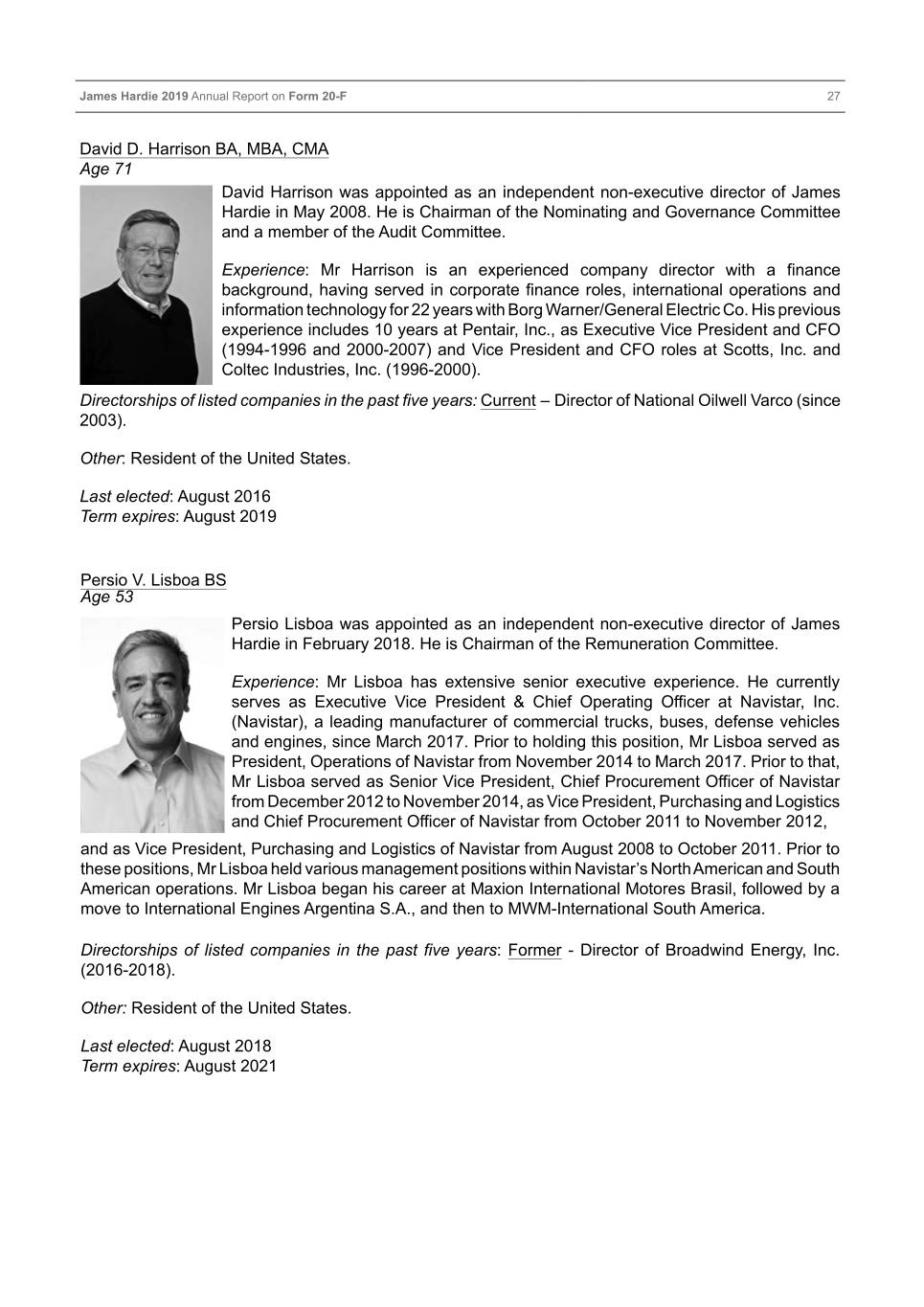
Table of Contents James Hardie 2019 Annual Report on Form 20-F 27 David D. Harrison BA, MBA, CMA Age 71 David Harrison was appointed as an independent non-executive director of James Hardie in May 2008. He is Chairman of the Nominating and Governance Committee and a member of the Audit Committee. Experience: Mr Harrison is an experienced company director with a finance background, having served in corporate finance roles, international operations and information technology for 22 years with Borg Warner/General Electric Co. His previous experience includes 10 years at Pentair, Inc., as Executive Vice President and CFO (1994-1996 and 2000-2007) and Vice President and CFO roles at Scotts, Inc. and Coltec Industries, Inc. (1996-2000). Directorships of listed companies in the past five years: Current – Director of National Oilwell Varco (since 2003). Other: Resident of the United States. Last elected: August 2016 Term expires: August 2019 Persio V. Lisboa BS Age 53 Persio Lisboa was appointed as an independent non-executive director of James Hardie in February 2018. He is Chairman of the Remuneration Committee. Experience: Mr Lisboa has extensive senior executive experience. He currently serves as Executive Vice President & Chief Operating Officer at Navistar, Inc. (Navistar), a leading manufacturer of commercial trucks, buses, defense vehicles and engines, since March 2017. Prior to holding this position, Mr Lisboa served as President, Operations of Navistar from November 2014 to March 2017. Prior to that, Mr Lisboa served as Senior Vice President, Chief Procurement Officer of Navistar from December 2012 to November 2014, as Vice President, Purchasing and Logistics and Chief Procurement Officer of Navistar from October 2011 to November 2012, and as Vice President, Purchasing and Logistics of Navistar from August 2008 to October 2011. Prior to these positions, Mr Lisboa held various management positions within Navistar’s North American and South American operations. Mr Lisboa began his career at Maxion International Motores Brasil, followed by a move to International Engines Argentina S.A., and then to MWM-International South America. Directorships of listed companies in the past five years: Former - Director of Broadwind Energy, Inc. (2016-2018). Other: Resident of the United States. Last elected: August 2018 Term expires: August 2021
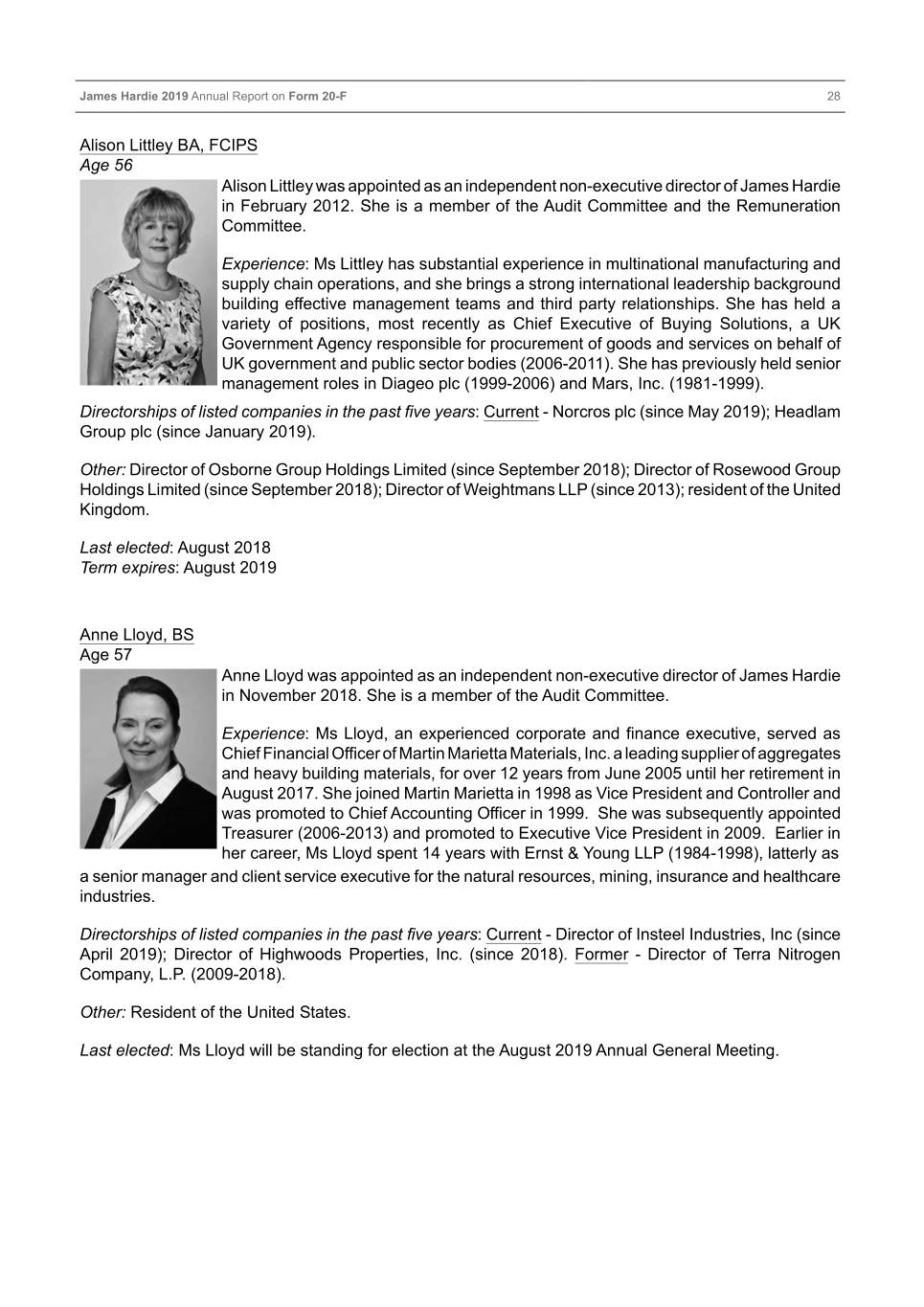
Table of Contents James Hardie 2019 Annual Report on Form 20-F 28 Alison Littley BA, FCIPS Age 56 Alison Littley was appointed as an independent non-executive director of James Hardie in February 2012. She is a member of the Audit Committee and the Remuneration Committee. Experience: Ms Littley has substantial experience in multinational manufacturing and supply chain operations, and she brings a strong international leadership background building effective management teams and third party relationships. She has held a variety of positions, most recently as Chief Executive of Buying Solutions, a UK Government Agency responsible for procurement of goods and services on behalf of UK government and public sector bodies (2006-2011). She has previously held senior management roles in Diageo plc (1999-2006) and Mars, Inc. (1981-1999). Directorships of listed companies in the past five years: Current - Norcros plc (since May 2019); Headlam Group plc (since January 2019). Other: Director of Osborne Group Holdings Limited (since September 2018); Director of Rosewood Group Holdings Limited (since September 2018); Director of Weightmans LLP (since 2013); resident of the United Kingdom. Last elected: August 2018 Term expires: August 2019 Anne Lloyd, BS Age 57 Anne Lloyd was appointed as an independent non-executive director of James Hardie in November 2018. She is a member of the Audit Committee. Experience: Ms Lloyd, an experienced corporate and finance executive, served as Chief Financial Officer of Martin Marietta Materials, Inc. a leading supplier of aggregates and heavy building materials, for over 12 years from June 2005 until her retirement in August 2017. She joined Martin Marietta in 1998 as Vice President and Controller and was promoted to Chief Accounting Officer in 1999. She was subsequently appointed Treasurer (2006-2013) and promoted to Executive Vice President in 2009. Earlier in her career, Ms Lloyd spent 14 years with Ernst & Young LLP (1984-1998), latterly as a senior manager and client service executive for the natural resources, mining, insurance and healthcare industries. Directorships of listed companies in the past five years: Current - Director of Insteel Industries, Inc (since April 2019); Director of Highwoods Properties, Inc. (since 2018). Former - Director of Terra Nitrogen Company, L.P. (2009-2018). Other: Resident of the United States. Last elected: Ms Lloyd will be standing for election at the August 2019 Annual General Meeting.
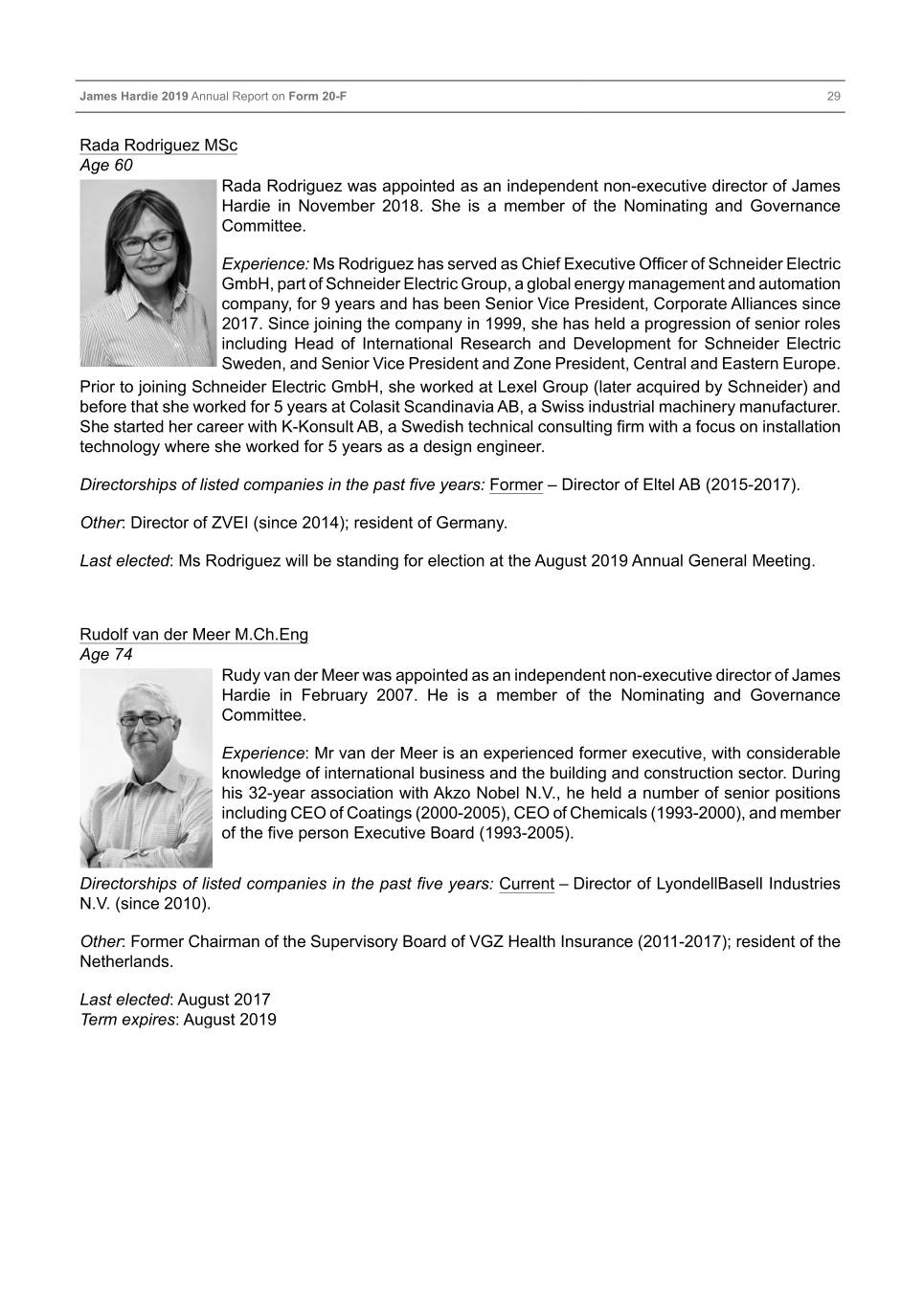
Table of Contents James Hardie 2019 Annual Report on Form 20-F 29 Rada Rodriguez MSc Age 60 Rada Rodriguez was appointed as an independent non-executive director of James Hardie in November 2018. She is a member of the Nominating and Governance Committee. Experience: Ms Rodriguez has served as Chief Executive Officer of Schneider Electric GmbH, part of Schneider Electric Group, a global energy management and automation company, for 9 years and has been Senior Vice President, Corporate Alliances since 2017. Since joining the company in 1999, she has held a progression of senior roles including Head of International Research and Development for Schneider Electric Sweden, and Senior Vice President and Zone President, Central and Eastern Europe. Prior to joining Schneider Electric GmbH, she worked at Lexel Group (later acquired by Schneider) and before that she worked for 5 years at Colasit Scandinavia AB, a Swiss industrial machinery manufacturer. She started her career with K-Konsult AB, a Swedish technical consulting firm with a focus on installation technology where she worked for 5 years as a design engineer. Directorships of listed companies in the past five years: Former – Director of Eltel AB (2015-2017). Other: Director of ZVEI (since 2014); resident of Germany. Last elected: Ms Rodriguez will be standing for election at the August 2019 Annual General Meeting. Rudolf van der Meer M.Ch.Eng Age 74 Rudy van der Meer was appointed as an independent non-executive director of James Hardie in February 2007. He is a member of the Nominating and Governance Committee. Experience: Mr van der Meer is an experienced former executive, with considerable knowledge of international business and the building and construction sector. During his 32-year association with Akzo Nobel N.V., he held a number of senior positions including CEO of Coatings (2000-2005), CEO of Chemicals (1993-2000), and member of the five person Executive Board (1993-2005). Directorships of listed companies in the past five years: Current – Director of LyondellBasell Industries N.V. (since 2010). Other: Former Chairman of the Supervisory Board of VGZ Health Insurance (2011-2017); resident of the Netherlands. Last elected: August 2017 Term expires: August 2019
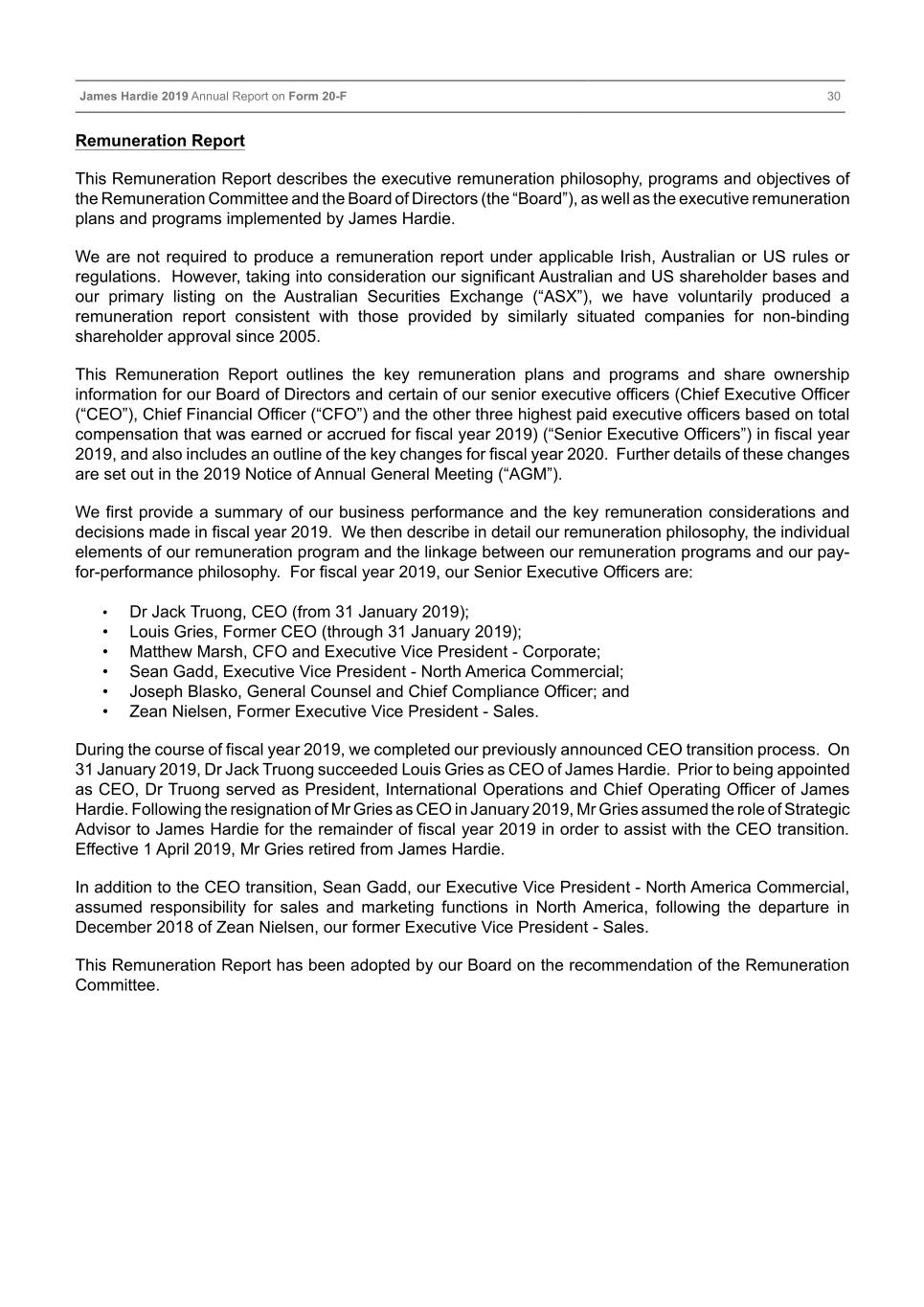
Table of Contents James Hardie 2019 Annual Report on Form 20-F 30 Remuneration Report This Remuneration Report describes the executive remuneration philosophy, programs and objectives of the Remuneration Committee and the Board of Directors (the “Board”), as well as the executive remuneration plans and programs implemented by James Hardie. We are not required to produce a remuneration report under applicable Irish, Australian or US rules or regulations. However, taking into consideration our significant Australian and US shareholder bases and our primary listing on the Australian Securities Exchange (“ASX”), we have voluntarily produced a remuneration report consistent with those provided by similarly situated companies for non-binding shareholder approval since 2005. This Remuneration Report outlines the key remuneration plans and programs and share ownership information for our Board of Directors and certain of our senior executive officers (Chief Executive Officer (“CEO”), Chief Financial Officer (“CFO”) and the other three highest paid executive officers based on total compensation that was earned or accrued for fiscal year 2019) (“Senior Executive Officers”) in fiscal year 2019, and also includes an outline of the key changes for fiscal year 2020. Further details of these changes are set out in the 2019 Notice of Annual General Meeting (“AGM”). We first provide a summary of our business performance and the key remuneration considerations and decisions made in fiscal year 2019. We then describe in detail our remuneration philosophy, the individual elements of our remuneration program and the linkage between our remuneration programs and our pay- for-performance philosophy. For fiscal year 2019, our Senior Executive Officers are: • Dr Jack Truong, CEO (from 31 January 2019); • Louis Gries, Former CEO (through 31 January 2019); • Matthew Marsh, CFO and Executive Vice President - Corporate; • Sean Gadd, Executive Vice President - North America Commercial; • Joseph Blasko, General Counsel and Chief Compliance Officer; and • Zean Nielsen, Former Executive Vice President - Sales. During the course of fiscal year 2019, we completed our previously announced CEO transition process. On 31 January 2019, Dr Jack Truong succeeded Louis Gries as CEO of James Hardie. Prior to being appointed as CEO, Dr Truong served as President, International Operations and Chief Operating Officer of James Hardie. Following the resignation of Mr Gries as CEO in January 2019, Mr Gries assumed the role of Strategic Advisor to James Hardie for the remainder of fiscal year 2019 in order to assist with the CEO transition. Effective 1 April 2019, Mr Gries retired from James Hardie. In addition to the CEO transition, Sean Gadd, our Executive Vice President - North America Commercial, assumed responsibility for sales and marketing functions in North America, following the departure in December 2018 of Zean Nielsen, our former Executive Vice President - Sales. This Remuneration Report has been adopted by our Board on the recommendation of the Remuneration Committee.

Table of Contents James Hardie 2019 Annual Report on Form 20-F 31 EXECUTIVE SUMMARY Fiscal Year 2019 Business Highlights1 Our operating results for fiscal year 2019 reflected good and disciplined financial performance in a significant inflationary cost environment, highlighted by adjusted net operating profit of US$300.5 million and adjusted earnings before interest and taxes (“EBIT”) of US$404.6 million, an increase of 3% and 2%, respectively, compared to fiscal year 2018. In addition, we achieved net sales of US$2.5 billion, an increase of 22% compared to fiscal year 2018, and US$0.68 adjusted diluted earnings per share. The following graphs show our performance for key financial measures during fiscal year 2019, with a comparison to prior corresponding periods: ADJUSTED NET NET SALES ADJUSTED EBIT ADJUSTED DILUTED OPERATING (US$Million) (US$Million) EARNINGS PER SHARE PROFIT (US$Million) (US cents) $301M $2,507M $405M 68cents 68 301 66 405 398 291 2,507 351 354 56 249 54 243 2,055 50 304 221 1,922 44 1,728 1,657 253 1,494 197 14 15 16 17 18 19 14 15 16 17 18 19 14 15 16 17 18 19 14 15 16 17 18 19 ____________ 1 Please see the “Glossary of Abbreviations and Definitions” in Section 4 of this Annual Report for a reconciliation of non-GAAP financial measures used in this Remuneration Report to the most directly comparable US GAAP financial measure.

Table of Contents James Hardie 2019 Annual Report on Form 20-F 32 Fiscal Year 2019 Compensation Highlights Our fiscal year 2019 compensation continued to reflect and promote our pay-for-performance philosophy and our stated goal to position Senior Executive Officer fixed base salary and benefits at the median and total target direct remuneration (comprising fixed and target variable remuneration) at the 75th percentile of our Peer Group (defined herein), if stretch short- and long-term target performance goals are met. The following is a summary of the key aspects and events that occurred relative to the Company’s remuneration policies, programs and arrangements during the course of fiscal year 2019: • Dr Truong’s fixed and variable compensation were increased in conjunction with his transition to the role of CEO (see page 52 for further details). • A base salary increase for Mr Marsh was made to continue to align his compensation package with our CEO succession plan and our need to retain key senior executives through the CEO transition process. • A base salary increase for Mr Gadd was made to properly align his compensation with the increase in his role scope and accountability that occurred during fiscal year 2019. • There were no changes to Mr Gries’ fixed or variable compensation. Mr Gries’ base salary, target short-term incentive (“STI”), and target long-term incentive (“LTI”) remained the same in fiscal year 2019 as they were for fiscal year 2018. • No changes were made to the operation or components of the company performance plan (“CP Plan”) or individual performance plan (“IP Plan”) for our annual STI program for fiscal year 2019, other than to establish new targets which align with our strategic initiatives as we do every year. A complete description of the performance hurdles applicable for fiscal year 2019 for the CP Plan is set out in the section titled “Incentive Arrangements” later in this Remuneration Report. • No changes were made to the design of the LTI Plan for fiscal year 2019. The LTI plan remains similar to the fiscal year 2018 plan with updated financial targets. A complete description of the LTI program, including the applicable performance hurdles is set out in the section titled “Incentive Arrangements” later in this Remuneration Report. Fiscal Year 2019 Total Target Compensation Remuneration packages for Senior Executive Officers reflect our remuneration philosophy and comprise a mixture of fixed base salary and benefits and variable performance-based incentives. The Remuneration Committee seeks to appropriately balance fixed and variable remuneration in order to align our total compensation structure with our pay-for-performance philosophy. The following chart summarizes total target compensation awarded to each Senior Executive Officer in fiscal year 2019: Summary of Fiscal Year 2019 Senior Executive Officer Target Compensation FY2019 Total FY2019 Annual FY2019 STI FY2019 LTI Target Senior Executive Base Salary Target Value Target Value Compensation Officer (US$) (US$) (US$) (US$) J Truong* 678,658 589,767 1,950,000 3,218,425 L Gries 950,000 1,187,500 4,000,000 6,137,500 M Marsh 630,000 472,500 1,200,000 2,302,500 S Gadd 550,000 330,000 800,000 1,680,000 J Blasko 437,750 262,650 500,000 1,200,400 Z Nielsen 525,000 315,000 1,000,000 1,840,000 * Base salary and STI Target is pro-rated based on the time Dr Truong was President - International Operation (5 months), Chief Operating Officer (5 months) and Chief Executive Officer (2 months) during fiscal year 2019.
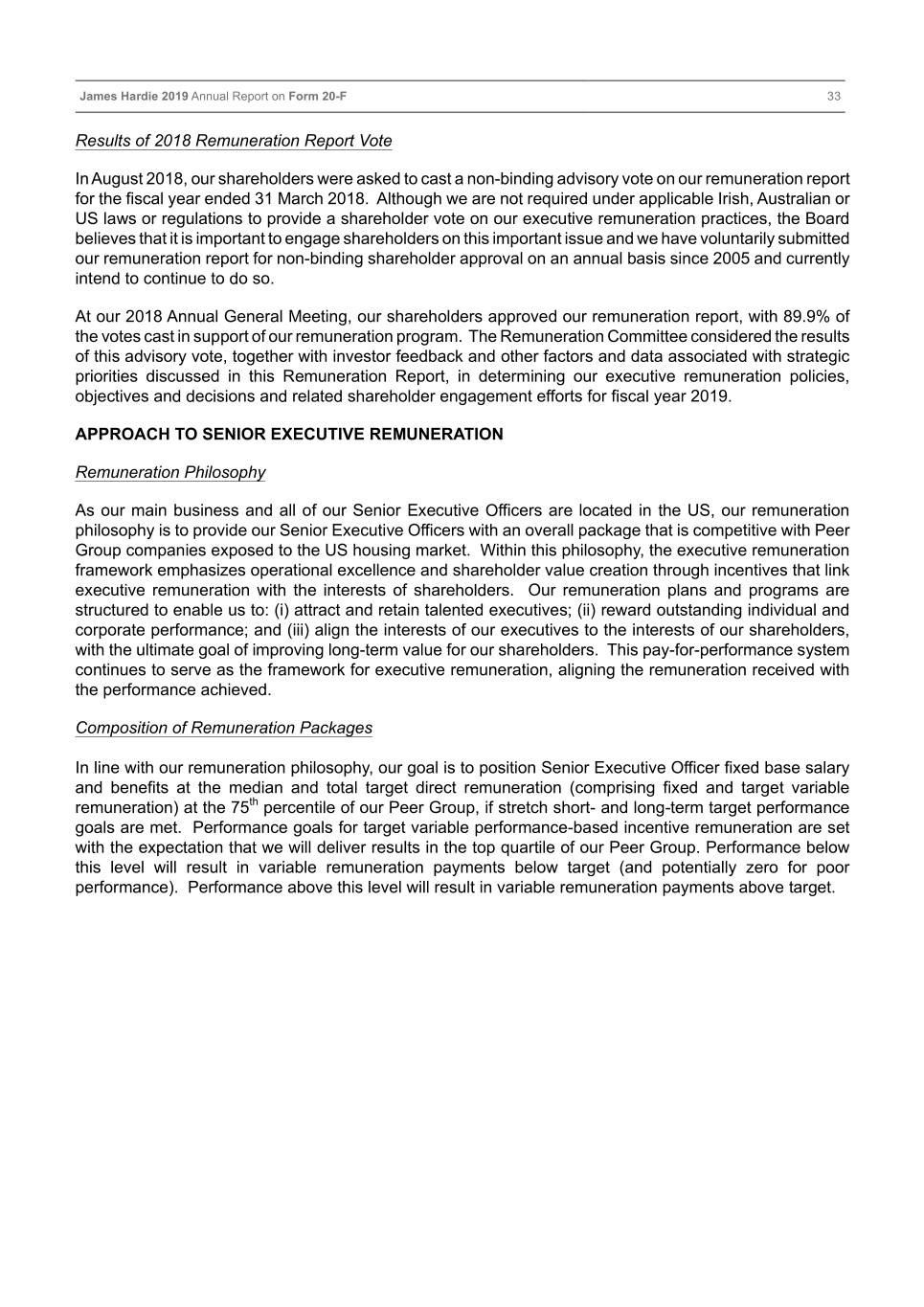
Table of Contents James Hardie 2019 Annual Report on Form 20-F 33 Results of 2018 Remuneration Report Vote In August 2018, our shareholders were asked to cast a non-binding advisory vote on our remuneration report for the fiscal year ended 31 March 2018. Although we are not required under applicable Irish, Australian or US laws or regulations to provide a shareholder vote on our executive remuneration practices, the Board believes that it is important to engage shareholders on this important issue and we have voluntarily submitted our remuneration report for non-binding shareholder approval on an annual basis since 2005 and currently intend to continue to do so. At our 2018 Annual General Meeting, our shareholders approved our remuneration report, with 89.9% of the votes cast in support of our remuneration program. The Remuneration Committee considered the results of this advisory vote, together with investor feedback and other factors and data associated with strategic priorities discussed in this Remuneration Report, in determining our executive remuneration policies, objectives and decisions and related shareholder engagement efforts for fiscal year 2019. APPROACH TO SENIOR EXECUTIVE REMUNERATION Remuneration Philosophy As our main business and all of our Senior Executive Officers are located in the US, our remuneration philosophy is to provide our Senior Executive Officers with an overall package that is competitive with Peer Group companies exposed to the US housing market. Within this philosophy, the executive remuneration framework emphasizes operational excellence and shareholder value creation through incentives that link executive remuneration with the interests of shareholders. Our remuneration plans and programs are structured to enable us to: (i) attract and retain talented executives; (ii) reward outstanding individual and corporate performance; and (iii) align the interests of our executives to the interests of our shareholders, with the ultimate goal of improving long-term value for our shareholders. This pay-for-performance system continues to serve as the framework for executive remuneration, aligning the remuneration received with the performance achieved. Composition of Remuneration Packages In line with our remuneration philosophy, our goal is to position Senior Executive Officer fixed base salary and benefits at the median and total target direct remuneration (comprising fixed and target variable remuneration) at the 75th percentile of our Peer Group, if stretch short- and long-term target performance goals are met. Performance goals for target variable performance-based incentive remuneration are set with the expectation that we will deliver results in the top quartile of our Peer Group. Performance below this level will result in variable remuneration payments below target (and potentially zero for poor performance). Performance above this level will result in variable remuneration payments above target.
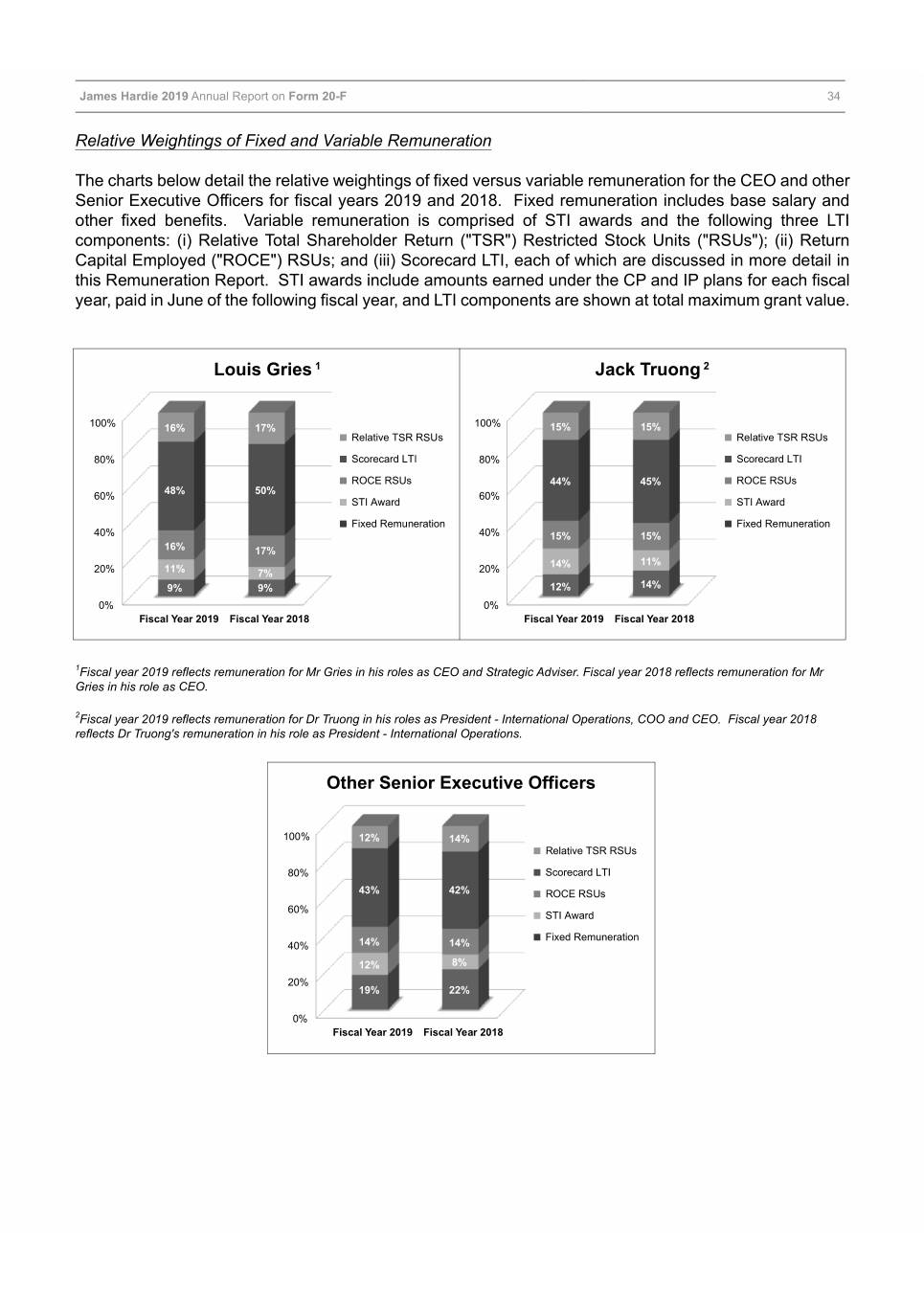
Table of Contents James Hardie 2019 Annual Report on Form 20-F 34 Relative Weightings of Fixed and Variable Remuneration The charts below detail the relative weightings of fixed versus variable remuneration for the CEO and other Senior Executive Officers for fiscal years 2019 and 2018. Fixed remuneration includes base salary and other fixed benefits. Variable remuneration is comprised of STI awards and the following three LTI components: (i) Relative Total Shareholder Return ("TSR") Restricted Stock Units ("RSUs"); (ii) Return Capital Employed ("ROCE") RSUs; and (iii) Scorecard LTI, each of which are discussed in more detail in this Remuneration Report. STI awards include amounts earned under the CP and IP plans for each fiscal year, paid in June of the following fiscal year, and LTI components are shown at total maximum grant value. Lo�is Gries 1 �a�k Tr�ong 2 1��� 1��� 16� 17� 15� 15� Relati�e TSR RSUs Relati�e TSR RSUs ��� Scorecard LT� ��� Scorecard LT� R�CE RSUs 44� 45� R�CE RSUs ��� 48� 50� ��� ST� Award ST� Award Fixed Remuneration Fixed Remuneration ��� ��� 15� 15� 16� 17� 14� 11� 2�� 11� 7� 2�� 9� 9� 12� 14� �� �� Fis�a� Year 2019 Fis�a� Year 2018 Fis�a� Year 2019 Fis�a� Year 2018 1Fiscal year 2019 reflects remuneration for Mr Gries in his roles as CEO and Strategic Adviser. Fiscal year 2018 reflects remuneration for Mr Gries in his role as CEO. 2Fiscal year 2019 reflects remuneration for Dr Truong in his roles as President - International Operations, COO and CEO. Fiscal year 2018 reflects Dr Truong's remuneration in his role as President - International Operations. Other Senior E�e��ti�e O��i�ers 1��� 12� 14� Relati�e TSR RSUs ��� Scorecard LT� 43� 42� R�CE RSUs ��� ST� Award Fixed Remuneration ��� 14� 14� 12� 8� 2�� 19� 22� �� Fis�a� Year 2019 Fis�a� Year 2018
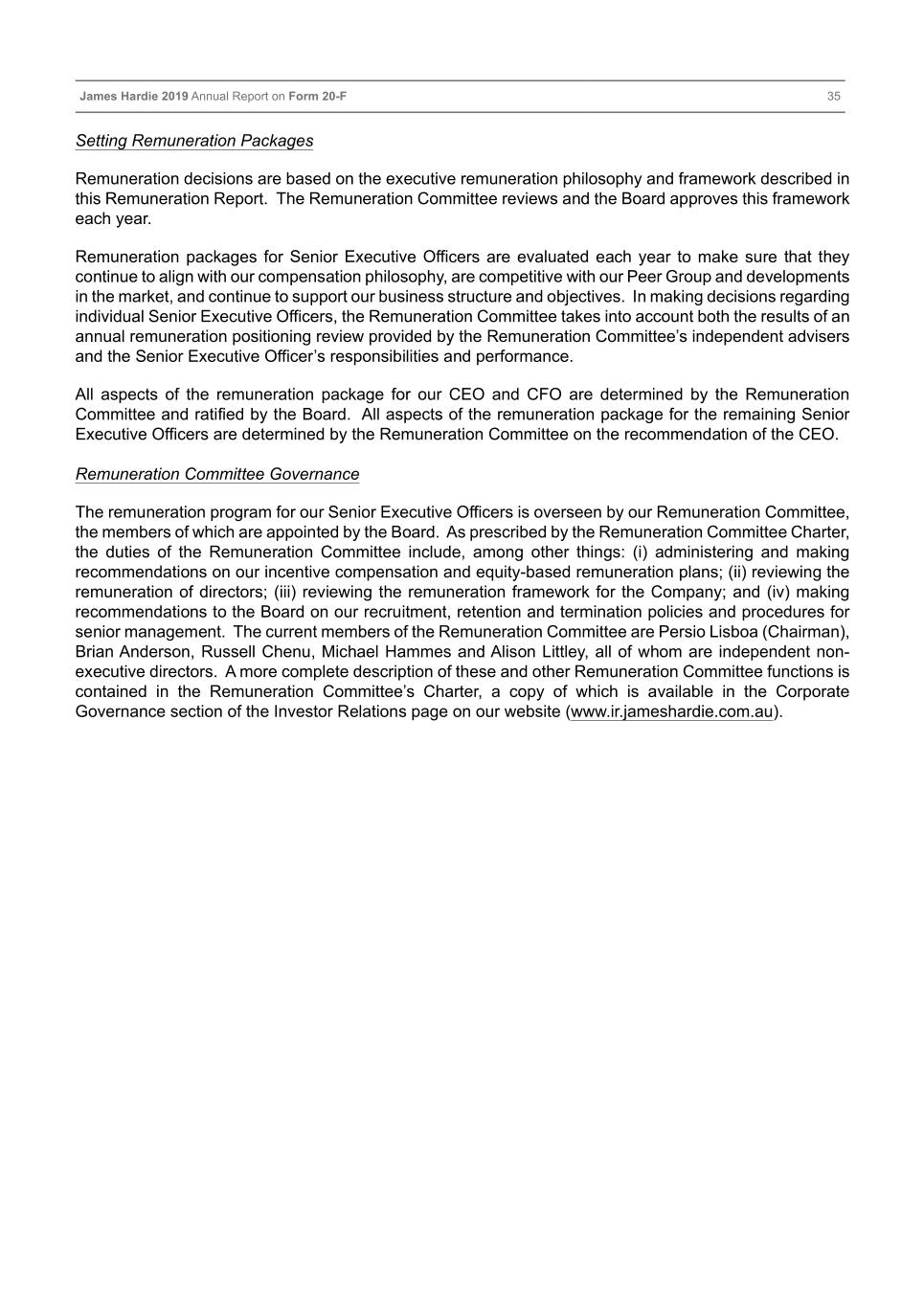
Table of Contents James Hardie 2019 Annual Report on Form 20-F 35 Setting Remuneration Packages Remuneration decisions are based on the executive remuneration philosophy and framework described in this Remuneration Report. The Remuneration Committee reviews and the Board approves this framework each year. Remuneration packages for Senior Executive Officers are evaluated each year to make sure that they continue to align with our compensation philosophy, are competitive with our Peer Group and developments in the market, and continue to support our business structure and objectives. In making decisions regarding individual Senior Executive Officers, the Remuneration Committee takes into account both the results of an annual remuneration positioning review provided by the Remuneration Committee’s independent advisers and the Senior Executive Officer’s responsibilities and performance. All aspects of the remuneration package for our CEO and CFO are determined by the Remuneration Committee and ratified by the Board. All aspects of the remuneration package for the remaining Senior Executive Officers are determined by the Remuneration Committee on the recommendation of the CEO. Remuneration Committee Governance The remuneration program for our Senior Executive Officers is overseen by our Remuneration Committee, the members of which are appointed by the Board. As prescribed by the Remuneration Committee Charter, the duties of the Remuneration Committee include, among other things: (i) administering and making recommendations on our incentive compensation and equity-based remuneration plans; (ii) reviewing the remuneration of directors; (iii) reviewing the remuneration framework for the Company; and (iv) making recommendations to the Board on our recruitment, retention and termination policies and procedures for senior management. The current members of the Remuneration Committee are Persio Lisboa (Chairman), Brian Anderson, Russell Chenu, Michael Hammes and Alison Littley, all of whom are independent non- executive directors. A more complete description of these and other Remuneration Committee functions is contained in the Remuneration Committee’s Charter, a copy of which is available in the Corporate Governance section of the Investor Relations page on our website (www.ir.jameshardie.com.au).
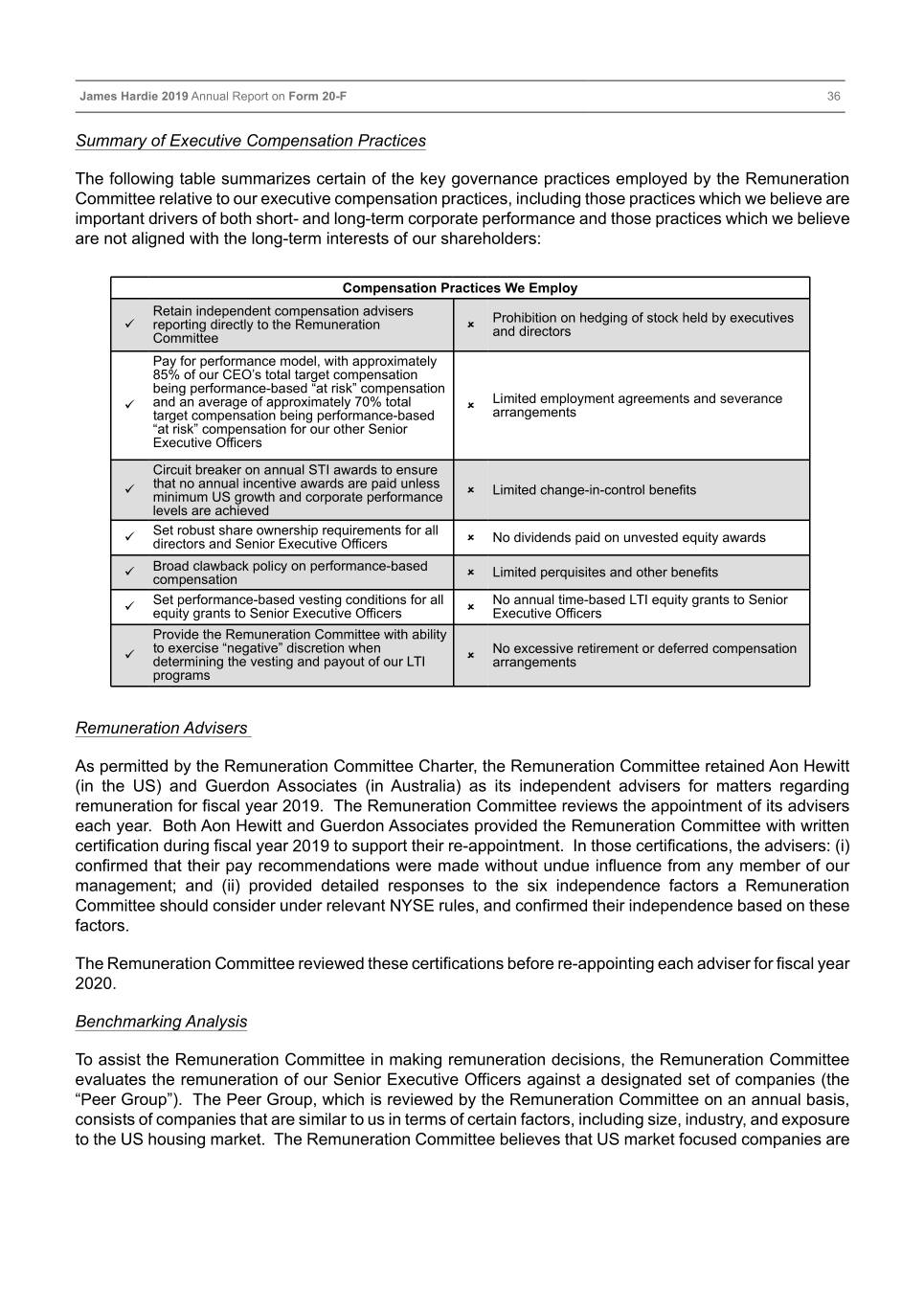
Table of Contents James Hardie 2019 Annual Report on Form 20-F 36 Summary of Executive Compensation Practices The following table summarizes certain of the key governance practices employed by the Remuneration Committee relative to our executive compensation practices, including those practices which we believe are important drivers of both short- and long-term corporate performance and those practices which we believe are not aligned with the long-term interests of our shareholders: Compensation Practices We Employ Retain independent compensation advisers ü reporting directly to the Remuneration û Prohibition on hedging of stock held by executives Committee and directors Pay for performance model, with approximately 85% of our CEO’s total target compensation being performance-based “at risk” compensation ü and an average of approximately 70% total û Limited employment agreements and severance target compensation being performance-based arrangements “at risk” compensation for our other Senior Executive Officers Circuit breaker on annual STI awards to ensure ü that no annual incentive awards are paid unless û Limited change-in-control benefits minimum US growth and corporate performance levels are achieved ü Set robust share ownership requirements for all û directors and Senior Executive Officers No dividends paid on unvested equity awards ü Broad clawback policy on performance-based û Limited perquisites and other benefits compensation ü Set performance-based vesting conditions for all û No annual time-based LTI equity grants to Senior equity grants to Senior Executive Officers Executive Officers Provide the Remuneration Committee with ability ü to exercise “negative” discretion when û No excessive retirement or deferred compensation determining the vesting and payout of our LTI arrangements programs Remuneration Advisers As permitted by the Remuneration Committee Charter, the Remuneration Committee retained Aon Hewitt (in the US) and Guerdon Associates (in Australia) as its independent advisers for matters regarding remuneration for fiscal year 2019. The Remuneration Committee reviews the appointment of its advisers each year. Both Aon Hewitt and Guerdon Associates provided the Remuneration Committee with written certification during fiscal year 2019 to support their re-appointment. In those certifications, the advisers: (i) confirmed that their pay recommendations were made without undue influence from any member of our management; and (ii) provided detailed responses to the six independence factors a Remuneration Committee should consider under relevant NYSE rules, and confirmed their independence based on these factors. The Remuneration Committee reviewed these certifications before re-appointing each adviser for fiscal year 2020. Benchmarking Analysis To assist the Remuneration Committee in making remuneration decisions, the Remuneration Committee evaluates the remuneration of our Senior Executive Officers against a designated set of companies (the “Peer Group”). The Peer Group, which is reviewed by the Remuneration Committee on an annual basis, consists of companies that are similar to us in terms of certain factors, including size, industry, and exposure to the US housing market. The Remuneration Committee believes that US market focused companies are
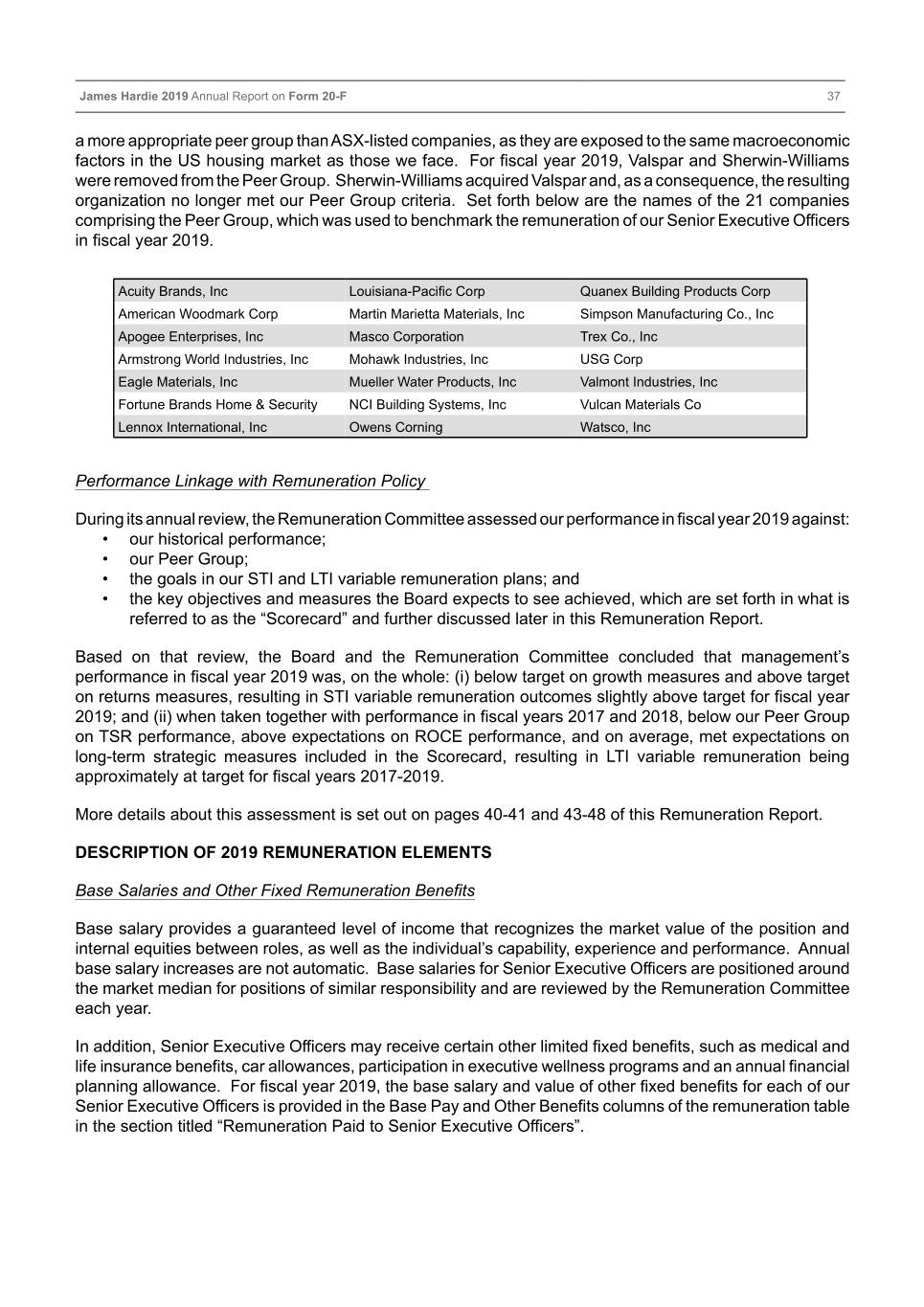
Table of Contents James Hardie 2019 Annual Report on Form 20-F 37 a more appropriate peer group than ASX-listed companies, as they are exposed to the same macroeconomic factors in the US housing market as those we face. For fiscal year 2019, Valspar and Sherwin-Williams were removed from the Peer Group. Sherwin-Williams acquired Valspar and, as a consequence, the resulting organization no longer met our Peer Group criteria. Set forth below are the names of the 21 companies comprising the Peer Group, which was used to benchmark the remuneration of our Senior Executive Officers in fiscal year 2019. Acuity Brands, Inc Louisiana-Pacific Corp Quanex Building Products Corp American Woodmark Corp Martin Marietta Materials, Inc Simpson Manufacturing Co., Inc Apogee Enterprises, Inc Masco Corporation Trex Co., Inc Armstrong World Industries, Inc Mohawk Industries, Inc USG Corp Eagle Materials, Inc Mueller Water Products, Inc Valmont Industries, Inc Fortune Brands Home & Security NCI Building Systems, Inc Vulcan Materials Co Lennox International, Inc Owens Corning Watsco, Inc Performance Linkage with Remuneration Policy During its annual review, the Remuneration Committee assessed our performance in fiscal year 2019 against: • our historical performance; • our Peer Group; • the goals in our STI and LTI variable remuneration plans; and • the key objectives and measures the Board expects to see achieved, which are set forth in what is referred to as the “Scorecard” and further discussed later in this Remuneration Report. Based on that review, the Board and the Remuneration Committee concluded that management’s performance in fiscal year 2019 was, on the whole: (i) below target on growth measures and above target on returns measures, resulting in STI variable remuneration outcomes slightly above target for fiscal year 2019; and (ii) when taken together with performance in fiscal years 2017 and 2018, below our Peer Group on TSR performance, above expectations on ROCE performance, and on average, met expectations on long-term strategic measures included in the Scorecard, resulting in LTI variable remuneration being approximately at target for fiscal years 2017-2019. More details about this assessment is set out on pages 40-41 and 43-48 of this Remuneration Report. DESCRIPTION OF 2019 REMUNERATION ELEMENTS Base Salaries and Other Fixed Remuneration Benefits Base salary provides a guaranteed level of income that recognizes the market value of the position and internal equities between roles, as well as the individual’s capability, experience and performance. Annual base salary increases are not automatic. Base salaries for Senior Executive Officers are positioned around the market median for positions of similar responsibility and are reviewed by the Remuneration Committee each year. In addition, Senior Executive Officers may receive certain other limited fixed benefits, such as medical and life insurance benefits, car allowances, participation in executive wellness programs and an annual financial planning allowance. For fiscal year 2019, the base salary and value of other fixed benefits for each of our Senior Executive Officers is provided in the Base Pay and Other Benefits columns of the remuneration table in the section titled “Remuneration Paid to Senior Executive Officers”.
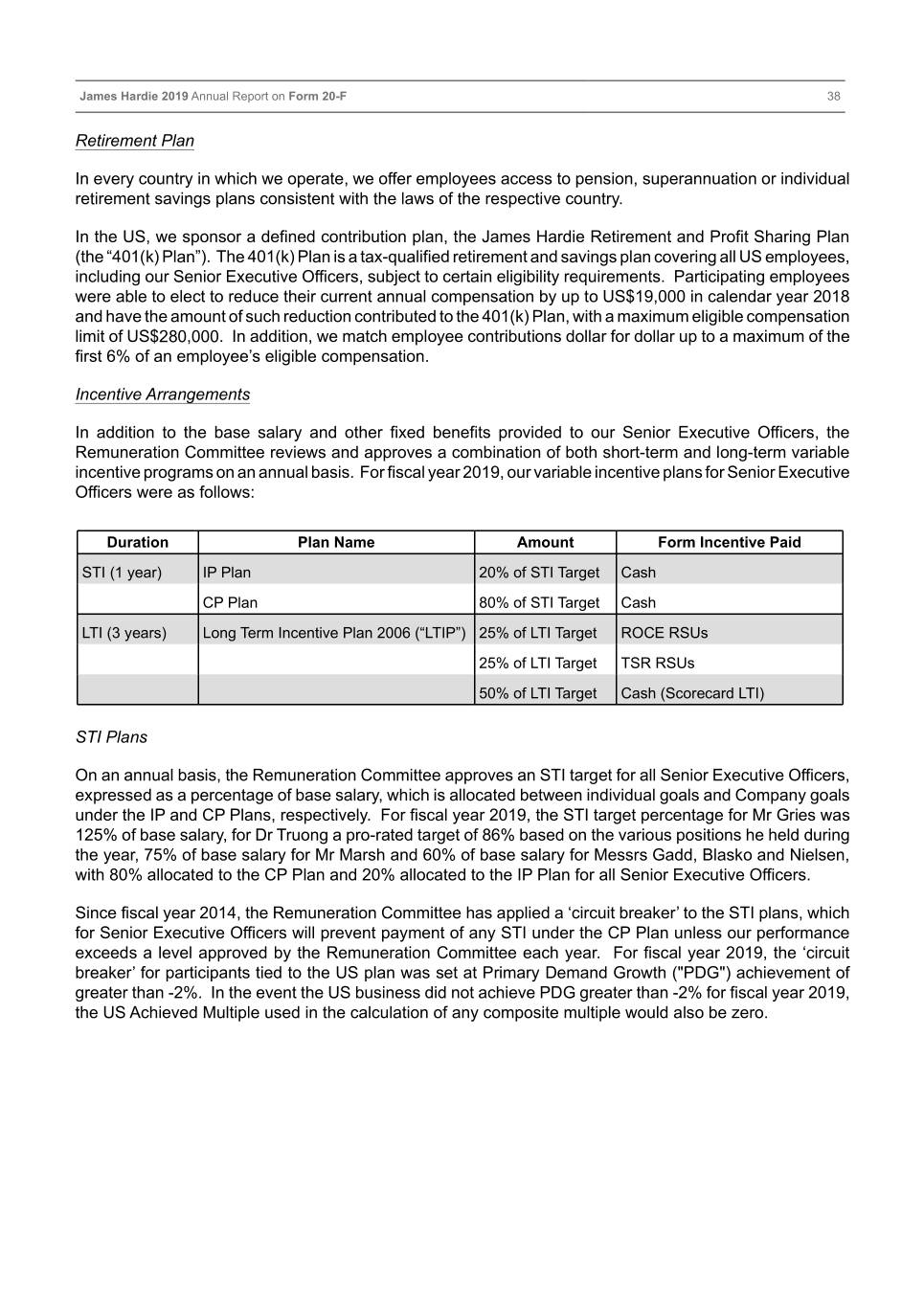
Table of Contents James Hardie 2019 Annual Report on Form 20-F 38 Retirement Plan In every country in which we operate, we offer employees access to pension, superannuation or individual retirement savings plans consistent with the laws of the respective country. In the US, we sponsor a defined contribution plan, the James Hardie Retirement and Profit Sharing Plan (the “401(k) Plan”). The 401(k) Plan is a tax-qualified retirement and savings plan covering all US employees, including our Senior Executive Officers, subject to certain eligibility requirements. Participating employees were able to elect to reduce their current annual compensation by up to US$19,000 in calendar year 2018 and have the amount of such reduction contributed to the 401(k) Plan, with a maximum eligible compensation limit of US$280,000. In addition, we match employee contributions dollar for dollar up to a maximum of the first 6% of an employee’s eligible compensation. Incentive Arrangements In addition to the base salary and other fixed benefits provided to our Senior Executive Officers, the Remuneration Committee reviews and approves a combination of both short-term and long-term variable incentive programs on an annual basis. For fiscal year 2019, our variable incentive plans for Senior Executive Officers were as follows: Duration Plan Name Amount Form Incentive Paid STI (1 year) IP Plan 20% of STI Target Cash CP Plan 80% of STI Target Cash LTI (3 years) Long Term Incentive Plan 2006 (“LTIP”) 25% of LTI Target ROCE RSUs 25% of LTI Target TSR RSUs 50% of LTI Target Cash (Scorecard LTI) STI Plans On an annual basis, the Remuneration Committee approves an STI target for all Senior Executive Officers, expressed as a percentage of base salary, which is allocated between individual goals and Company goals under the IP and CP Plans, respectively. For fiscal year 2019, the STI target percentage for Mr Gries was 125% of base salary, for Dr Truong a pro-rated target of 86% based on the various positions he held during the year, 75% of base salary for Mr Marsh and 60% of base salary for Messrs Gadd, Blasko and Nielsen, with 80% allocated to the CP Plan and 20% allocated to the IP Plan for all Senior Executive Officers. Since fiscal year 2014, the Remuneration Committee has applied a ‘circuit breaker’ to the STI plans, which for Senior Executive Officers will prevent payment of any STI under the CP Plan unless our performance exceeds a level approved by the Remuneration Committee each year. For fiscal year 2019, the ‘circuit breaker’ for participants tied to the US plan was set at Primary Demand Growth ("PDG") achievement of greater than -2%. In the event the US business did not achieve PDG greater than -2% for fiscal year 2019, the US Achieved Multiple used in the calculation of any composite multiple would also be zero.
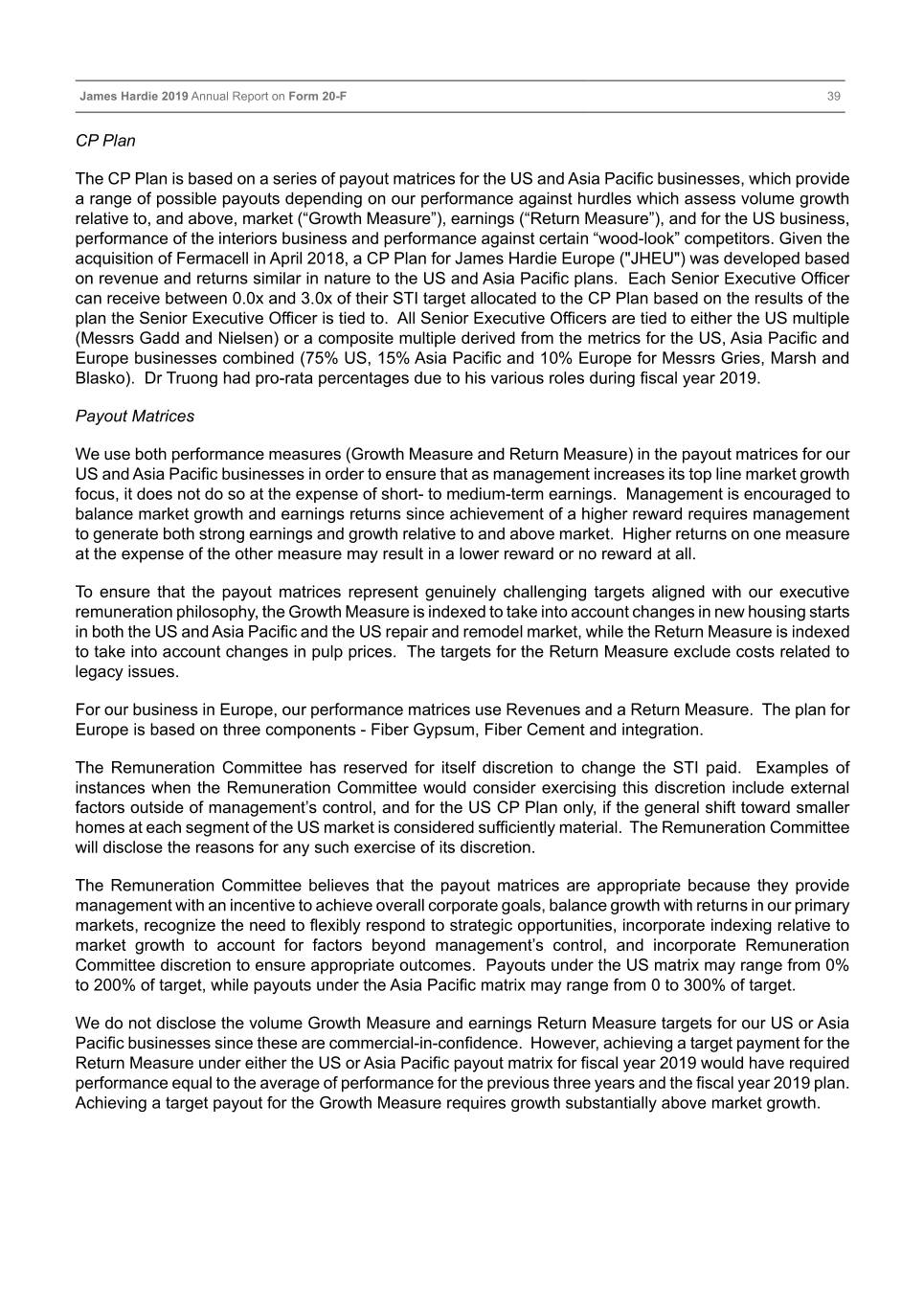
Table of Contents James Hardie 2019 Annual Report on Form 20-F 39 CP Plan The CP Plan is based on a series of payout matrices for the US and Asia Pacific businesses, which provide a range of possible payouts depending on our performance against hurdles which assess volume growth relative to, and above, market (“Growth Measure”), earnings (“Return Measure”), and for the US business, performance of the interiors business and performance against certain “wood-look” competitors. Given the acquisition of Fermacell in April 2018, a CP Plan for James Hardie Europe ("JHEU") was developed based on revenue and returns similar in nature to the US and Asia Pacific plans. Each Senior Executive Officer can receive between 0.0x and 3.0x of their STI target allocated to the CP Plan based on the results of the plan the Senior Executive Officer is tied to. All Senior Executive Officers are tied to either the US multiple (Messrs Gadd and Nielsen) or a composite multiple derived from the metrics for the US, Asia Pacific and Europe businesses combined (75% US, 15% Asia Pacific and 10% Europe for Messrs Gries, Marsh and Blasko). Dr Truong had pro-rata percentages due to his various roles during fiscal year 2019. Payout Matrices We use both performance measures (Growth Measure and Return Measure) in the payout matrices for our US and Asia Pacific businesses in order to ensure that as management increases its top line market growth focus, it does not do so at the expense of short- to medium-term earnings. Management is encouraged to balance market growth and earnings returns since achievement of a higher reward requires management to generate both strong earnings and growth relative to and above market. Higher returns on one measure at the expense of the other measure may result in a lower reward or no reward at all. To ensure that the payout matrices represent genuinely challenging targets aligned with our executive remuneration philosophy, the Growth Measure is indexed to take into account changes in new housing starts in both the US and Asia Pacific and the US repair and remodel market, while the Return Measure is indexed to take into account changes in pulp prices. The targets for the Return Measure exclude costs related to legacy issues. For our business in Europe, our performance matrices use Revenues and a Return Measure. The plan for Europe is based on three components - Fiber Gypsum, Fiber Cement and integration. The Remuneration Committee has reserved for itself discretion to change the STI paid. Examples of instances when the Remuneration Committee would consider exercising this discretion include external factors outside of management’s control, and for the US CP Plan only, if the general shift toward smaller homes at each segment of the US market is considered sufficiently material. The Remuneration Committee will disclose the reasons for any such exercise of its discretion. The Remuneration Committee believes that the payout matrices are appropriate because they provide management with an incentive to achieve overall corporate goals, balance growth with returns in our primary markets, recognize the need to flexibly respond to strategic opportunities, incorporate indexing relative to market growth to account for factors beyond management’s control, and incorporate Remuneration Committee discretion to ensure appropriate outcomes. Payouts under the US matrix may range from 0% to 200% of target, while payouts under the Asia Pacific matrix may range from 0 to 300% of target. We do not disclose the volume Growth Measure and earnings Return Measure targets for our US or Asia Pacific businesses since these are commercial-in-confidence. However, achieving a target payment for the Return Measure under either the US or Asia Pacific payout matrix for fiscal year 2019 would have required performance equal to the average of performance for the previous three years and the fiscal year 2019 plan. Achieving a target payout for the Growth Measure requires growth substantially above market growth.
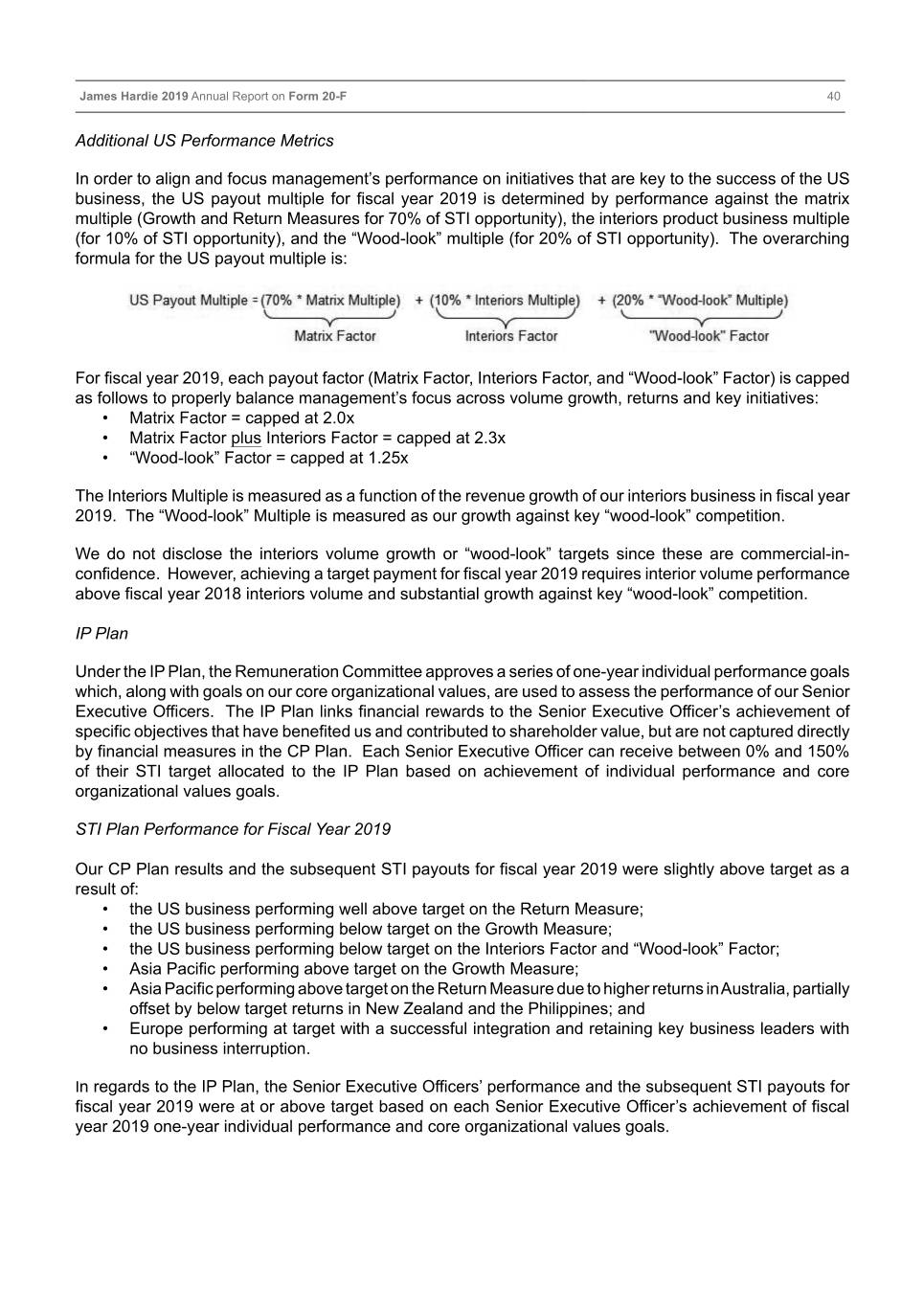
Table of Contents James Hardie 2019 Annual Report on Form 20-F 40 Additional US Performance Metrics In order to align and focus management’s performance on initiatives that are key to the success of the US business, the US payout multiple for fiscal year 2019 is determined by performance against the matrix multiple (Growth and Return Measures for 70% of STI opportunity), the interiors product business multiple (for 10% of STI opportunity), and the “Wood-look” multiple (for 20% of STI opportunity). The overarching formula for the US payout multiple is: For fiscal year 2019, each payout factor (Matrix Factor, Interiors Factor, and “Wood-look” Factor) is capped as follows to properly balance management’s focus across volume growth, returns and key initiatives: • Matrix Factor = capped at 2.0x • Matrix Factor plus Interiors Factor = capped at 2.3x • “Wood-look” Factor = capped at 1.25x The Interiors Multiple is measured as a function of the revenue growth of our interiors business in fiscal year 2019. The “Wood-look” Multiple is measured as our growth against key “wood-look” competition. We do not disclose the interiors volume growth or “wood-look” targets since these are commercial-in- confidence. However, achieving a target payment for fiscal year 2019 requires interior volume performance above fiscal year 2018 interiors volume and substantial growth against key “wood-look” competition. IP Plan Under the IP Plan, the Remuneration Committee approves a series of one-year individual performance goals which, along with goals on our core organizational values, are used to assess the performance of our Senior Executive Officers. The IP Plan links financial rewards to the Senior Executive Officer’s achievement of specific objectives that have benefited us and contributed to shareholder value, but are not captured directly by financial measures in the CP Plan. Each Senior Executive Officer can receive between 0% and 150% of their STI target allocated to the IP Plan based on achievement of individual performance and core organizational values goals. STI Plan Performance for Fiscal Year 2019 Our CP Plan results and the subsequent STI payouts for fiscal year 2019 were slightly above target as a result of: • the US business performing well above target on the Return Measure; • the US business performing below target on the Growth Measure; • the US business performing below target on the Interiors Factor and “Wood-look” Factor; • Asia Pacific performing above target on the Growth Measure; • Asia Pacific performing above target on the Return Measure due to higher returns in Australia, partially offset by below target returns in New Zealand and the Philippines; and • Europe performing at target with a successful integration and retaining key business leaders with no business interruption. In regards to the IP Plan, the Senior Executive Officers’ performance and the subsequent STI payouts for fiscal year 2019 were at or above target based on each Senior Executive Officer’s achievement of fiscal year 2019 one-year individual performance and core organizational values goals.
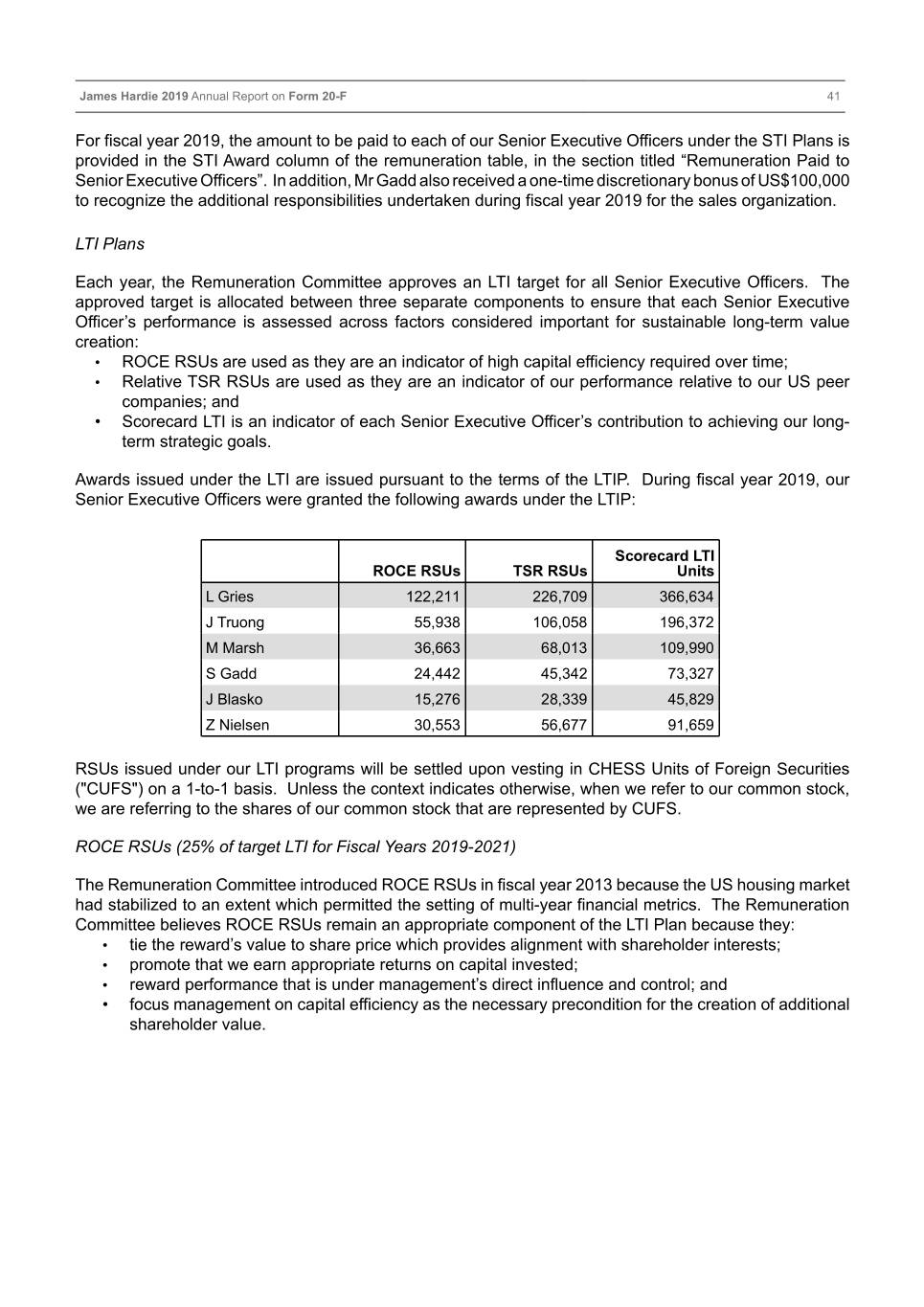
Table of Contents James Hardie 2019 Annual Report on Form 20-F 41 For fiscal year 2019, the amount to be paid to each of our Senior Executive Officers under the STI Plans is provided in the STI Award column of the remuneration table, in the section titled “Remuneration Paid to Senior Executive Officers”. In addition, Mr Gadd also received a one-time discretionary bonus of US$100,000 to recognize the additional responsibilities undertaken during fiscal year 2019 for the sales organization. LTI Plans Each year, the Remuneration Committee approves an LTI target for all Senior Executive Officers. The approved target is allocated between three separate components to ensure that each Senior Executive Officer’s performance is assessed across factors considered important for sustainable long-term value creation: • ROCE RSUs are used as they are an indicator of high capital efficiency required over time; • Relative TSR RSUs are used as they are an indicator of our performance relative to our US peer companies; and • Scorecard LTI is an indicator of each Senior Executive Officer’s contribution to achieving our long- term strategic goals. Awards issued under the LTI are issued pursuant to the terms of the LTIP. During fiscal year 2019, our Senior Executive Officers were granted the following awards under the LTIP: Scorecard LTI ROCE RSUs TSR RSUs Units L Gries 122,211 226,709 366,634 J Truong 55,938 106,058 196,372 M Marsh 36,663 68,013 109,990 S Gadd 24,442 45,342 73,327 J Blasko 15,276 28,339 45,829 Z Nielsen 30,553 56,677 91,659 RSUs issued under our LTI programs will be settled upon vesting in CHESS Units of Foreign Securities ("CUFS") on a 1-to-1 basis. Unless the context indicates otherwise, when we refer to our common stock, we are referring to the shares of our common stock that are represented by CUFS. ROCE RSUs (25% of target LTI for Fiscal Years 2019-2021) The Remuneration Committee introduced ROCE RSUs in fiscal year 2013 because the US housing market had stabilized to an extent which permitted the setting of multi-year financial metrics. The Remuneration Committee believes ROCE RSUs remain an appropriate component of the LTI Plan because they: • tie the reward’s value to share price which provides alignment with shareholder interests; • promote that we earn appropriate returns on capital invested; • reward performance that is under management’s direct influence and control; and • focus management on capital efficiency as the necessary precondition for the creation of additional shareholder value.
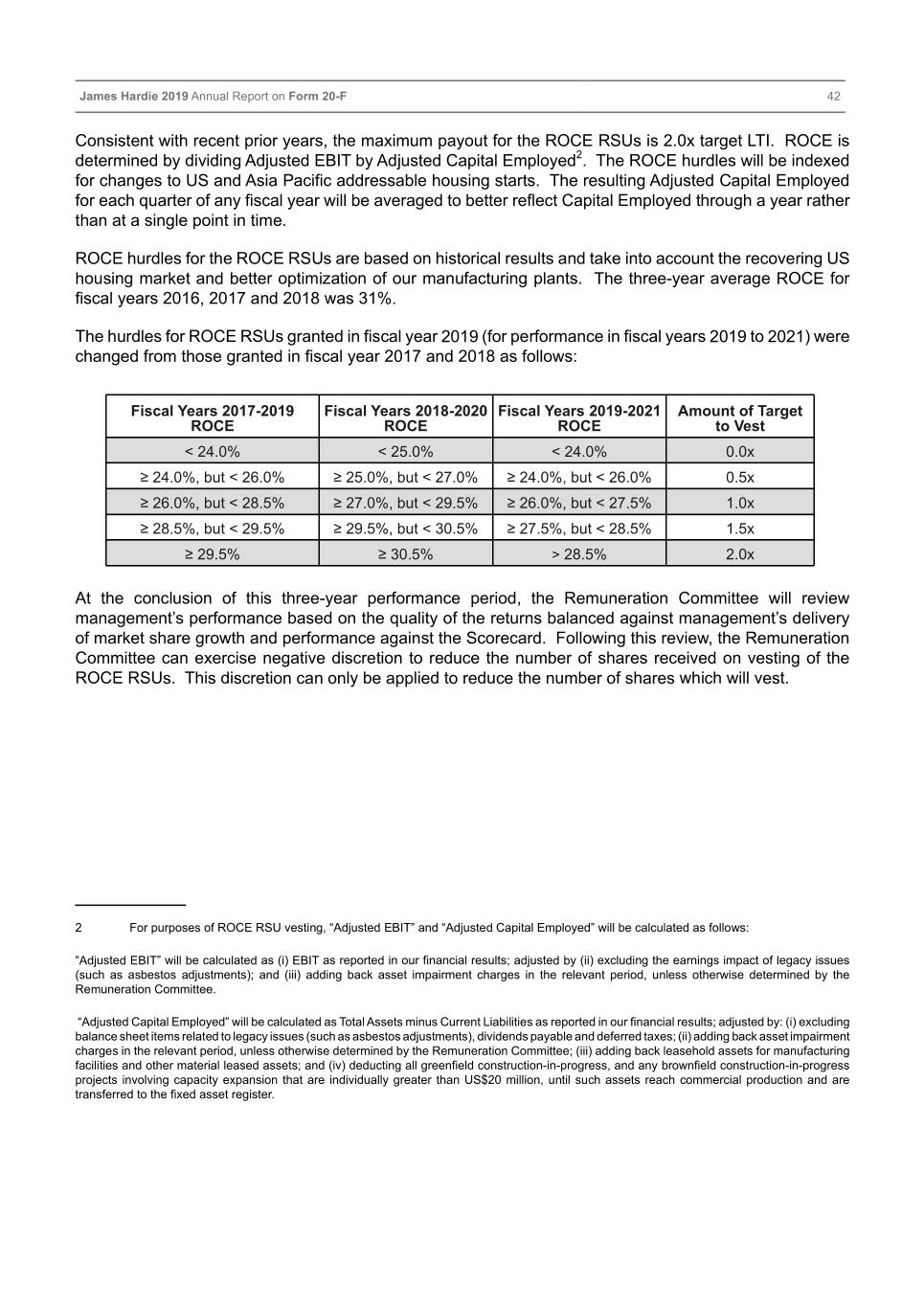
Table of Contents James Hardie 2019 Annual Report on Form 20-F 42 Consistent with recent prior years, the maximum payout for the ROCE RSUs is 2.0x target LTI. ROCE is determined by dividing Adjusted EBIT by Adjusted Capital Employed2. The ROCE hurdles will be indexed for changes to US and Asia Pacific addressable housing starts. The resulting Adjusted Capital Employed for each quarter of any fiscal year will be averaged to better reflect Capital Employed through a year rather than at a single point in time. ROCE hurdles for the ROCE RSUs are based on historical results and take into account the recovering US housing market and better optimization of our manufacturing plants. The three-year average ROCE for fiscal years 2016, 2017 and 2018 was 31%. The hurdles for ROCE RSUs granted in fiscal year 2019 (for performance in fiscal years 2019 to 2021) were changed from those granted in fiscal year 2017 and 2018 as follows: Fiscal Years 2017-2019 Fiscal Years 2018-2020 Fiscal Years 2019-2021 Amount of Target ROCE ROCE ROCE to Vest < 24.0% < 25.0% < 24.0% 0.0x ≥ 24.0%, but < 26.0% ≥ 25.0%, but < 27.0% ≥ 24.0%, but < 26.0% 0.5x ≥ 26.0%, but < 28.5% ≥ 27.0%, but < 29.5% ≥ 26.0%, but < 27.5% 1.0x ≥ 28.5%, but < 29.5% ≥ 29.5%, but < 30.5% ≥ 27.5%, but < 28.5% 1.5x ≥ 29.5% ≥ 30.5% > 28.5% 2.0x At the conclusion of this three-year performance period, the Remuneration Committee will review management’s performance based on the quality of the returns balanced against management’s delivery of market share growth and performance against the Scorecard. Following this review, the Remuneration Committee can exercise negative discretion to reduce the number of shares received on vesting of the ROCE RSUs. This discretion can only be applied to reduce the number of shares which will vest. ____________ 2 For purposes of ROCE RSU vesting, “Adjusted EBIT” and “Adjusted Capital Employed” will be calculated as follows: “Adjusted EBIT” will be calculated as (i) EBIT as reported in our financial results; adjusted by (ii) excluding the earnings impact of legacy issues (such as asbestos adjustments); and (iii) adding back asset impairment charges in the relevant period, unless otherwise determined by the Remuneration Committee. “Adjusted Capital Employed” will be calculated as Total Assets minus Current Liabilities as reported in our financial results; adjusted by: (i) excluding balance sheet items related to legacy issues (such as asbestos adjustments), dividends payable and deferred taxes; (ii) adding back asset impairment charges in the relevant period, unless otherwise determined by the Remuneration Committee; (iii) adding back leasehold assets for manufacturing facilities and other material leased assets; and (iv) deducting all greenfield construction-in-progress, and any brownfield construction-in-progress projects involving capacity expansion that are individually greater than US$20 million, until such assets reach commercial production and are transferred to the fixed asset register.
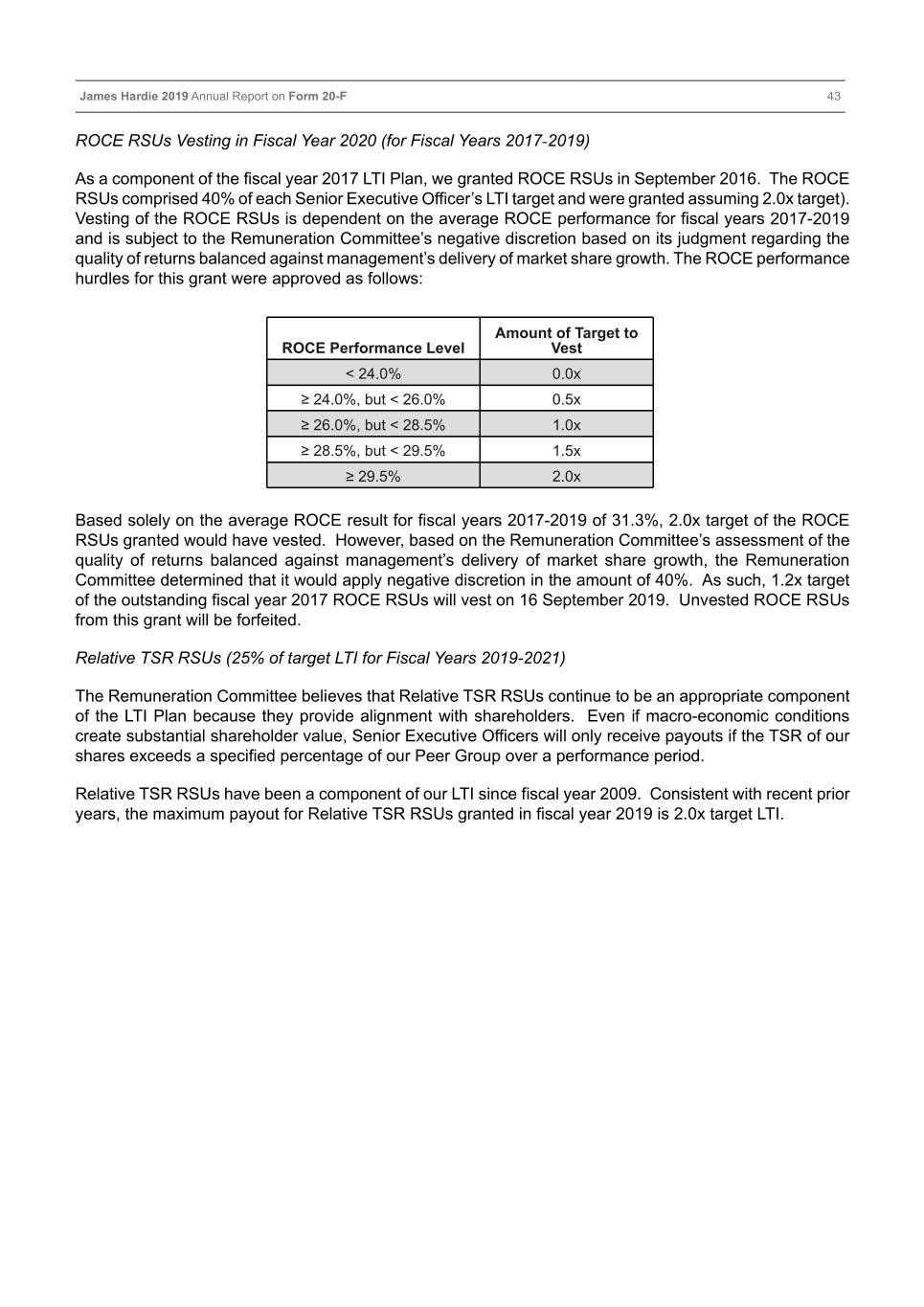
Table of Contents James Hardie 2019 Annual Report on Form 20-F 43 ROCE RSUs Vesting in Fiscal Year 2020 (for Fiscal Years 2017-2019) As a component of the fiscal year 2017 LTI Plan, we granted ROCE RSUs in September 2016. The ROCE RSUs comprised 40% of each Senior Executive Officer’s LTI target and were granted assuming 2.0x target). Vesting of the ROCE RSUs is dependent on the average ROCE performance for fiscal years 2017-2019 and is subject to the Remuneration Committee’s negative discretion based on its judgment regarding the quality of returns balanced against management’s delivery of market share growth. The ROCE performance hurdles for this grant were approved as follows: Amount of Target to ROCE Performance Level Vest < 24.0% 0.0x ≥ 24.0%, but < 26.0% 0.5x ≥ 26.0%, but < 28.5% 1.0x ≥ 28.5%, but < 29.5% 1.5x ≥ 29.5% 2.0x Based solely on the average ROCE result for fiscal years 2017-2019 of 31.3%, 2.0x target of the ROCE RSUs granted would have vested. However, based on the Remuneration Committee’s assessment of the quality of returns balanced against management’s delivery of market share growth, the Remuneration Committee determined that it would apply negative discretion in the amount of 40%. As such, 1.2x target of the outstanding fiscal year 2017 ROCE RSUs will vest on 16 September 2019. Unvested ROCE RSUs from this grant will be forfeited. Relative TSR RSUs (25% of target LTI for Fiscal Years 2019-2021) The Remuneration Committee believes that Relative TSR RSUs continue to be an appropriate component of the LTI Plan because they provide alignment with shareholders. Even if macro-economic conditions create substantial shareholder value, Senior Executive Officers will only receive payouts if the TSR of our shares exceeds a specified percentage of our Peer Group over a performance period. Relative TSR RSUs have been a component of our LTI since fiscal year 2009. Consistent with recent prior years, the maximum payout for Relative TSR RSUs granted in fiscal year 2019 is 2.0x target LTI.
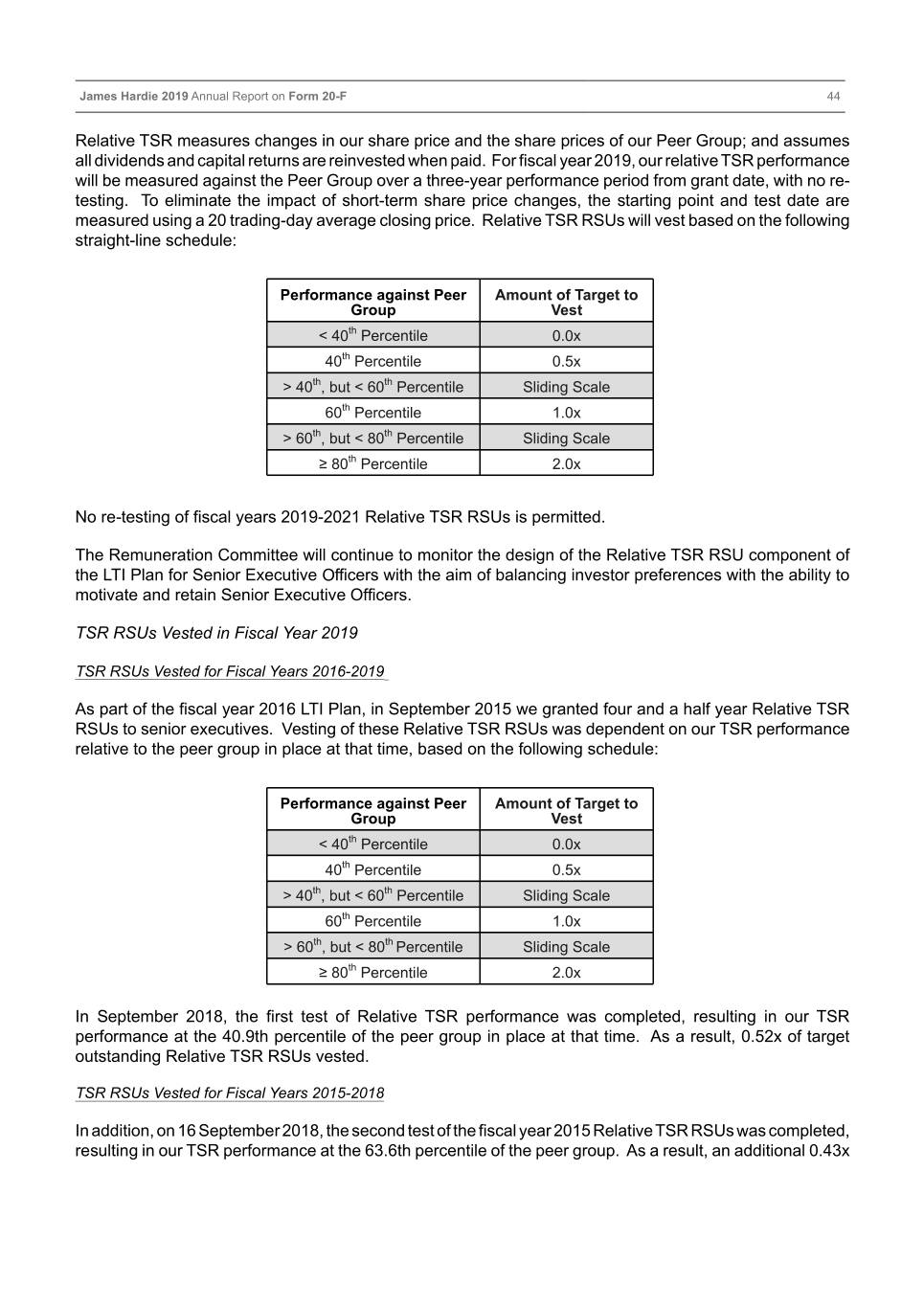
Table of Contents James Hardie 2019 Annual Report on Form 20-F 44 Relative TSR measures changes in our share price and the share prices of our Peer Group; and assumes all dividends and capital returns are reinvested when paid. For fiscal year 2019, our relative TSR performance will be measured against the Peer Group over a three-year performance period from grant date, with no re- testing. To eliminate the impact of short-term share price changes, the starting point and test date are measured using a 20 trading-day average closing price. Relative TSR RSUs will vest based on the following straight-line schedule: Performance against Peer Amount of Target to Group Vest < 40th Percentile 0.0x 40th Percentile 0.5x > 40th, but < 60th Percentile Sliding Scale 60th Percentile 1.0x > 60th, but < 80th Percentile Sliding Scale ≥ 80th Percentile 2.0x No re-testing of fiscal years 2019-2021 Relative TSR RSUs is permitted. The Remuneration Committee will continue to monitor the design of the Relative TSR RSU component of the LTI Plan for Senior Executive Officers with the aim of balancing investor preferences with the ability to motivate and retain Senior Executive Officers. TSR RSUs Vested in Fiscal Year 2019 TSR RSUs Vested for Fiscal Years 2016-2019 As part of the fiscal year 2016 LTI Plan, in September 2015 we granted four and a half year Relative TSR RSUs to senior executives. Vesting of these Relative TSR RSUs was dependent on our TSR performance relative to the peer group in place at that time, based on the following schedule: Performance against Peer Amount of Target to Group Vest < 40th Percentile 0.0x 40th Percentile 0.5x > 40th, but < 60th Percentile Sliding Scale 60th Percentile 1.0x > 60th, but < 80th Percentile Sliding Scale ≥ 80th Percentile 2.0x In September 2018, the first test of Relative TSR performance was completed, resulting in our TSR performance at the 40.9th percentile of the peer group in place at that time. As a result, 0.52x of target outstanding Relative TSR RSUs vested. TSR RSUs Vested for Fiscal Years 2015-2018 In addition, on 16 September 2018, the second test of the fiscal year 2015 Relative TSR RSUs was completed, resulting in our TSR performance at the 63.6th percentile of the peer group. As a result, an additional 0.43x

Table of Contents James Hardie 2019 Annual Report on Form 20-F 45 target of the outstanding TSR RSUs vested. The third test of this award was on 16 March 2019. The results were at the 59th percentile of the peer group; therefore, no further Relative TSR RSUs vested and the unvested balances were cancelled. Scorecard LTI (50% of target LTI for Fiscal Years 2019-2021) Scorecard LTI have been a component of our LTI Plan since fiscal year 2010. Each year, the Remuneration Committee approves a number of key management objectives and the results it expects to see achieved in relation to these objectives. These objectives are incorporated into that year’s grant of Scorecard LTI. At the end of the three-year performance period, the Remuneration Committee assesses our Senior Executive Officers’ collective performance on each key objective and each individual Senior Executive Officer’s contribution to those achievements and the Board reviews this assessment. Senior Executive Officers may receive different ratings depending on the contribution they have made during the three-year performance period. Although most of the objectives in the Scorecard have quantitative targets, we consider some of the targets to be commercial-in-confidence. Consistent from fiscal year 2010, the maximum payout for Scorecard LTI is 3.0x target LTI. The Remuneration Committee believes that the Scorecard LTI continues to be an appropriate component of its LTI Plan because it: • allows the Remuneration Committee to set targets for and reward executives on a balance of longer- term financial, strategic, business, customer and organizational development goals which it believes are important contributors to long-term creation of shareholder value; • ties the reward’s value to our share price over the medium-term; and • allows flexibility to apply rewards across different countries, while providing Senior Executive Officers with liquidity to pay tax or other material commitments at a time that coincides with vesting of shares (via the other components of the LTI Plan) as payment is in cash. No specific weighting is applied to any single objective and the final Scorecard assessment reflects an element of judgment by the Board. The Board may only exercise negative discretion (i.e., to reduce the amount of Scorecard LTI that will ultimately vest). It cannot enhance the maximum reward that can be received. The amount received by Senior Executive Officers is based on both our share price performance over the three-year performance period and the Senior Executive Officer’s Scorecard rating. At the start of the three- year performance period, we calculate the number of units each Senior Executive Officer could have acquired if they received a maximum payout on the Scorecard LTI at that time (based on a 20 trading-day average closing price). Depending on the Senior Executive Officer’s rating (between 0 and 100), between 0.0x and 3.0x of the Senior Executive Officer’s Scorecard LTI awards will vest at the end of the three-year performance period. Each Senior Executive Officer will receive a cash payment based on our share price at the end of the period (based on a 20 trading-day average closing price) multiplied by the number of units they could have acquired at the start of the performance period, adjusted downward in accordance with their Scorecard rating. Further details related to the Scorecard for fiscal year 2019, including the method of measurement, historical performance against the proposed measures and the Board of Director’s expectations, were previously set out in our Remuneration Report for fiscal year 2018. An assessment of our Scorecard performance for fiscal years 2017-2019 is set out below. We will provide an explanation of the final assessment of performance under the Scorecard for fiscal years 2019-2021 at the conclusion of fiscal year 2021.

Table of Contents James Hardie 2019 Annual Report on Form 20-F 46 Scorecard LTI Vesting in Fiscal Year 2020 (for Fiscal Years 2017-2019) After fiscal year 2019, the Remuneration Committee reviewed our performance over fiscal years 2017-2019 against the Scorecard objectives set forth in fiscal year 2017, and the contribution of individual Senior Executive Officers towards the achievement of such objectives. As a result of this evaluation, the Remuneration Committee determined that Senior Executive Officers would receive a weighted average Scorecard rating of 1.0x target. Board Assessment for Performance Measure/Rationale Performance Metric/Results the Three-year Period Grow exterior cladding market share Goal: PDG above market. Our performance Performance below and maintain category share in the US against ‘wood-look’ competition. expectations business A key strategy for the Company is to Result: Average annual PDG performance maximize its market share growth/retention for the three year period of 2.8% was well of the exterior cladding market for new below the Board target. Growth above vinyl housing starts and for repair & remodel but below close alternatives also did not markets. meet Board expectations. . Interiors Market Strategy Goal: Growth above market of 2% per Performance below Implementation annum. expectations Result: Interiors volume growth averaged negative 7% per annum during the three year period, not meeting the Board requirement. Build US organizational and leadership Goal: Continued focus on turnover, driving Performance met capability in support of the 35/90 growth the North American turnover to below 15% expectations target by the end of the three year period. Execute The amount of growth that 35/90 entails a successful succession plan. Successful requires lower turnover levels and an recruitment, hiring and onboarding of increase in management depth and business leaders and development of bench organizational capability. strength. Result:Succession plan successfully executed resulting in appointment of Dr Jack Truong as CEO on 31 January 2019. Significant improvements in the hiring of key talent at the executive level and Average annual turnover of 18.9% did not meet the Board target. Demonstrated improvement in the critical areas of leadership development, recruitment and onboarding of bench strength talent and employee engagement.
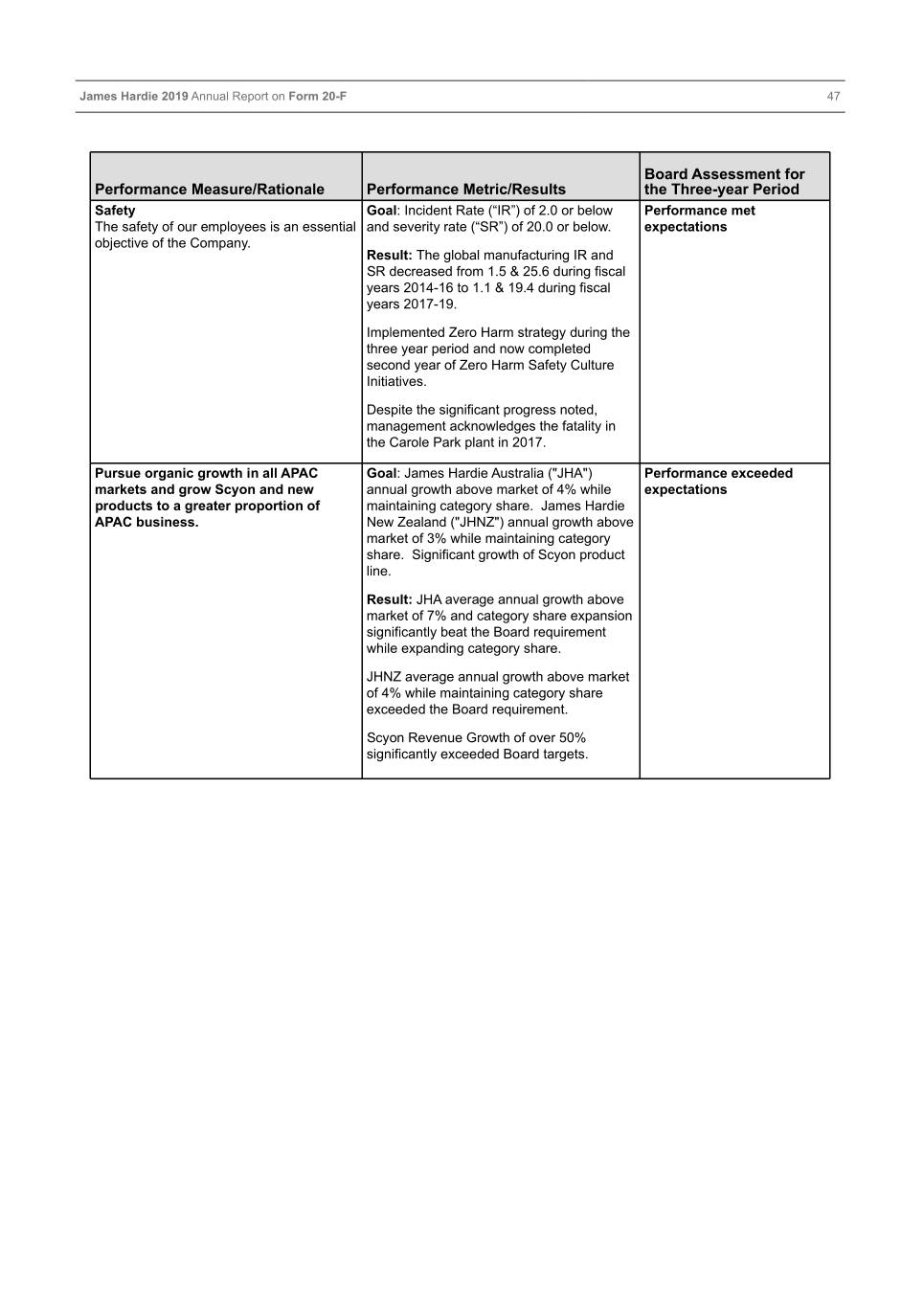
Table of Contents James Hardie 2019 Annual Report on Form 20-F 47 Board Assessment for Performance Measure/Rationale Performance Metric/Results the Three-year Period Safety Goal: Incident Rate (“IR”) of 2.0 or below Performance met The safety of our employees is an essential and severity rate (“SR”) of 20.0 or below. expectations objective of the Company. Result: The global manufacturing IR and SR decreased from 1.5 & 25.6 during fiscal years 2014-16 to 1.1 & 19.4 during fiscal years 2017-19. Implemented Zero Harm strategy during the three year period and now completed second year of Zero Harm Safety Culture Initiatives. Despite the significant progress noted, management acknowledges the fatality in the Carole Park plant in 2017. Pursue organic growth in all APAC Goal: James Hardie Australia ("JHA") Performance exceeded markets and grow Scyon and new annual growth above market of 4% while expectations products to a greater proportion of maintaining category share. James Hardie APAC business. New Zealand ("JHNZ") annual growth above market of 3% while maintaining category share. Significant growth of Scyon product line. Result: JHA average annual growth above market of 7% and category share expansion significantly beat the Board requirement while expanding category share. JHNZ average annual growth above market of 4% while maintaining category share exceeded the Board requirement. Scyon Revenue Growth of over 50% significantly exceeded Board targets.
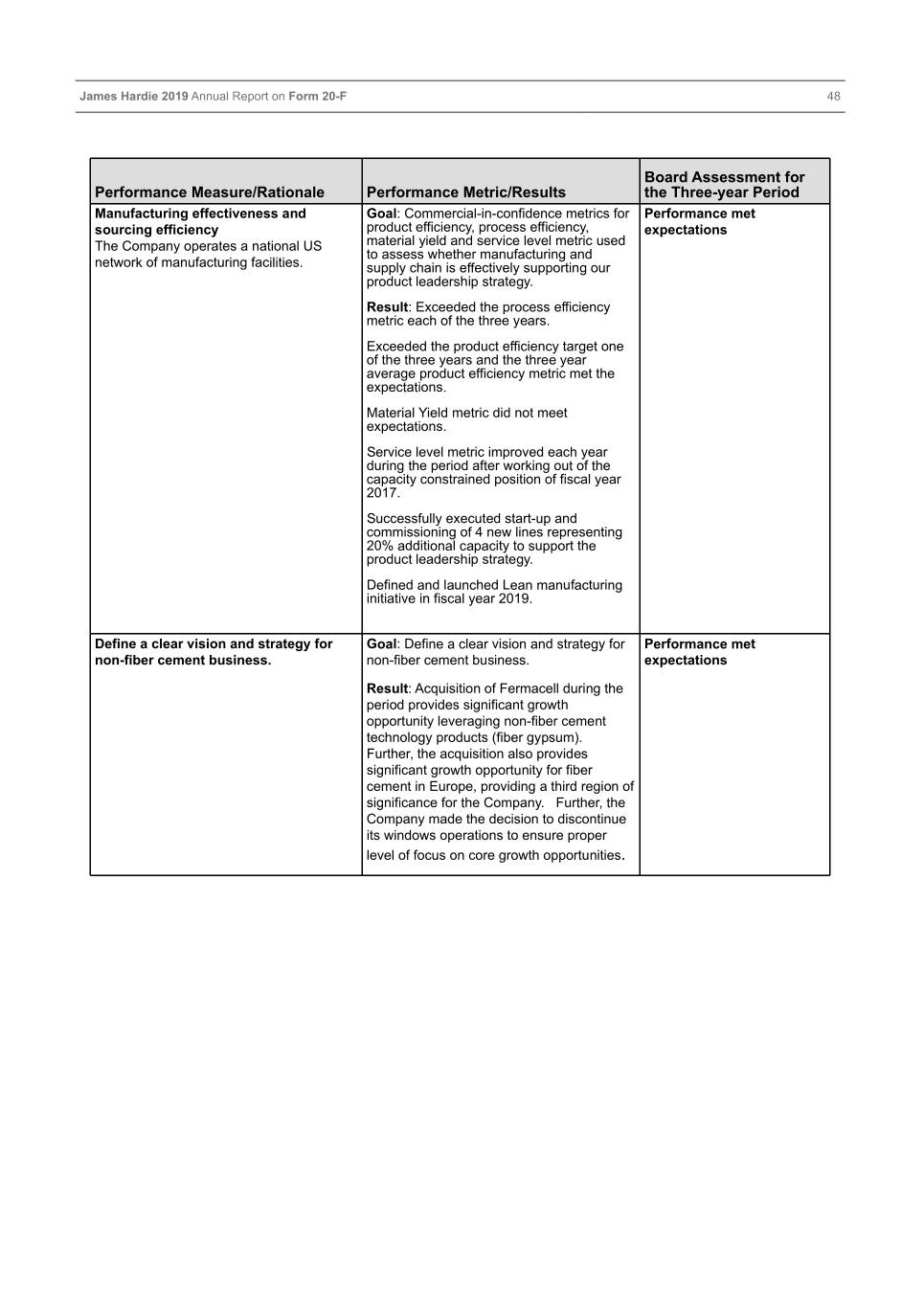
Table of Contents James Hardie 2019 Annual Report on Form 20-F 48 Board Assessment for Performance Measure/Rationale Performance Metric/Results the Three-year Period Manufacturing effectiveness and Goal: Commercial-in-confidence metrics for Performance met sourcing efficiency product efficiency, process efficiency, expectations The Company operates a national US material yield and service level metric used to assess whether manufacturing and network of manufacturing facilities. supply chain is effectively supporting our product leadership strategy. Result: Exceeded the process efficiency metric each of the three years. Exceeded the product efficiency target one of the three years and the three year average product efficiency metric met the expectations. Material Yield metric did not meet expectations. Service level metric improved each year during the period after working out of the capacity constrained position of fiscal year 2017. Successfully executed start-up and commissioning of 4 new lines representing 20% additional capacity to support the product leadership strategy. Defined and launched Lean manufacturing initiative in fiscal year 2019. Define a clear vision and strategy for Goal: Define a clear vision and strategy for Performance met non-fiber cement business. non-fiber cement business. expectations Result: Acquisition of Fermacell during the period provides significant growth opportunity leveraging non-fiber cement technology products (fiber gypsum). Further, the acquisition also provides significant growth opportunity for fiber cement in Europe, providing a third region of significance for the Company. Further, the Company made the decision to discontinue its windows operations to ensure proper level of focus on core growth opportunities.
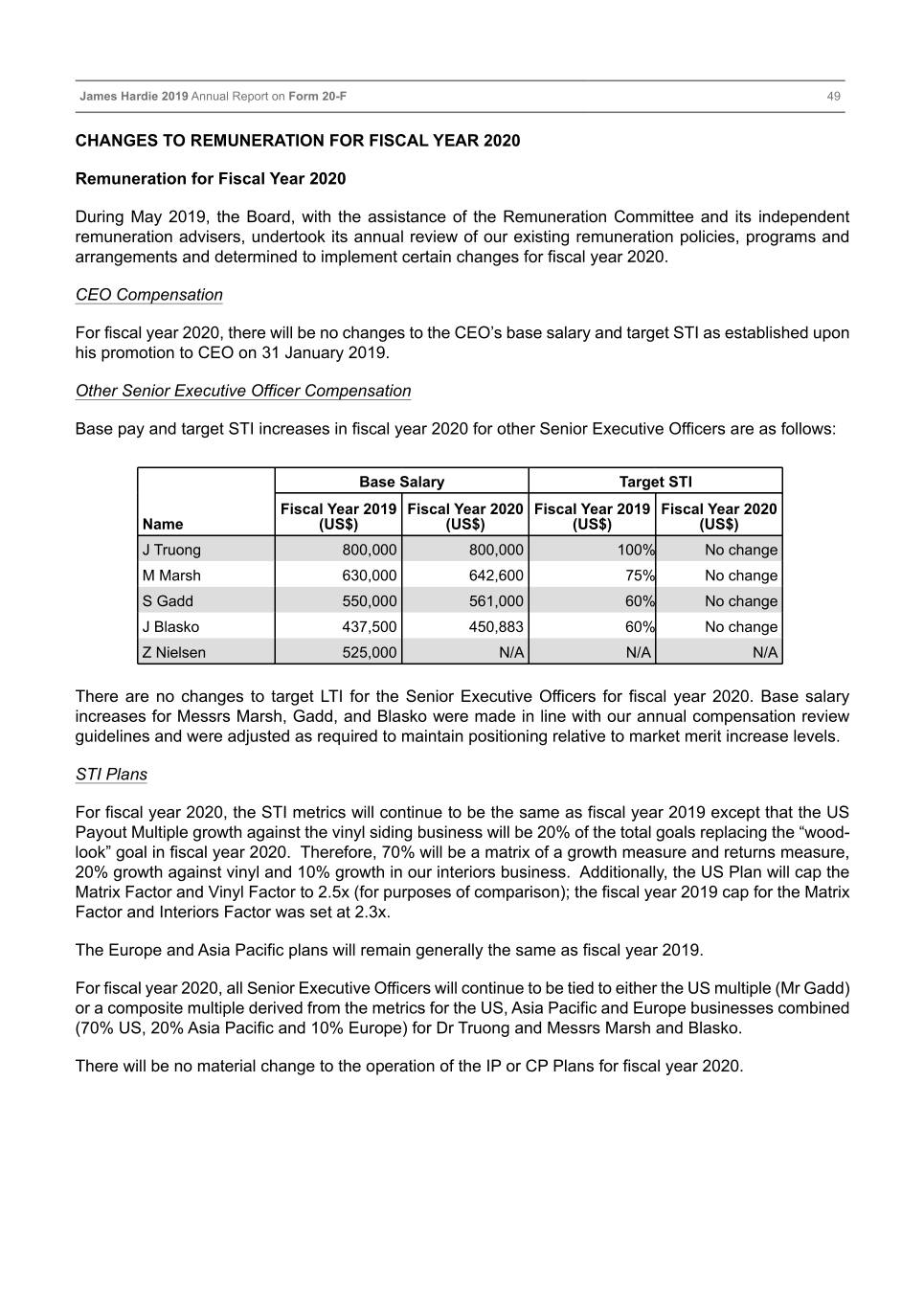
Table of Contents James Hardie 2019 Annual Report on Form 20-F 49 CHANGES TO REMUNERATION FOR FISCAL YEAR 2020 Remuneration for Fiscal Year 2020 During May 2019, the Board, with the assistance of the Remuneration Committee and its independent remuneration advisers, undertook its annual review of our existing remuneration policies, programs and arrangements and determined to implement certain changes for fiscal year 2020. CEO Compensation For fiscal year 2020, there will be no changes to the CEO’s base salary and target STI as established upon his promotion to CEO on 31 January 2019. Other Senior Executive Officer Compensation Base pay and target STI increases in fiscal year 2020 for other Senior Executive Officers are as follows: Base Salary Target STI Fiscal Year 2019 Fiscal Year 2020 Fiscal Year 2019 Fiscal Year 2020 Name (US$) (US$) (US$) (US$) J Truong 800,000 800,000 100% No change M Marsh 630,000 642,600 75% No change S Gadd 550,000 561,000 60% No change J Blasko 437,500 450,883 60% No change Z Nielsen 525,000 N/A N/A N/A There are no changes to target LTI for the Senior Executive Officers for fiscal year 2020. Base salary increases for Messrs Marsh, Gadd, and Blasko were made in line with our annual compensation review guidelines and were adjusted as required to maintain positioning relative to market merit increase levels. STI Plans For fiscal year 2020, the STI metrics will continue to be the same as fiscal year 2019 except that the US Payout Multiple growth against the vinyl siding business will be 20% of the total goals replacing the “wood- look” goal in fiscal year 2020. Therefore, 70% will be a matrix of a growth measure and returns measure, 20% growth against vinyl and 10% growth in our interiors business. Additionally, the US Plan will cap the Matrix Factor and Vinyl Factor to 2.5x (for purposes of comparison); the fiscal year 2019 cap for the Matrix Factor and Interiors Factor was set at 2.3x. The Europe and Asia Pacific plans will remain generally the same as fiscal year 2019. For fiscal year 2020, all Senior Executive Officers will continue to be tied to either the US multiple (Mr Gadd) or a composite multiple derived from the metrics for the US, Asia Pacific and Europe businesses combined (70% US, 20% Asia Pacific and 10% Europe) for Dr Truong and Messrs Marsh and Blasko. There will be no material change to the operation of the IP or CP Plans for fiscal year 2020.
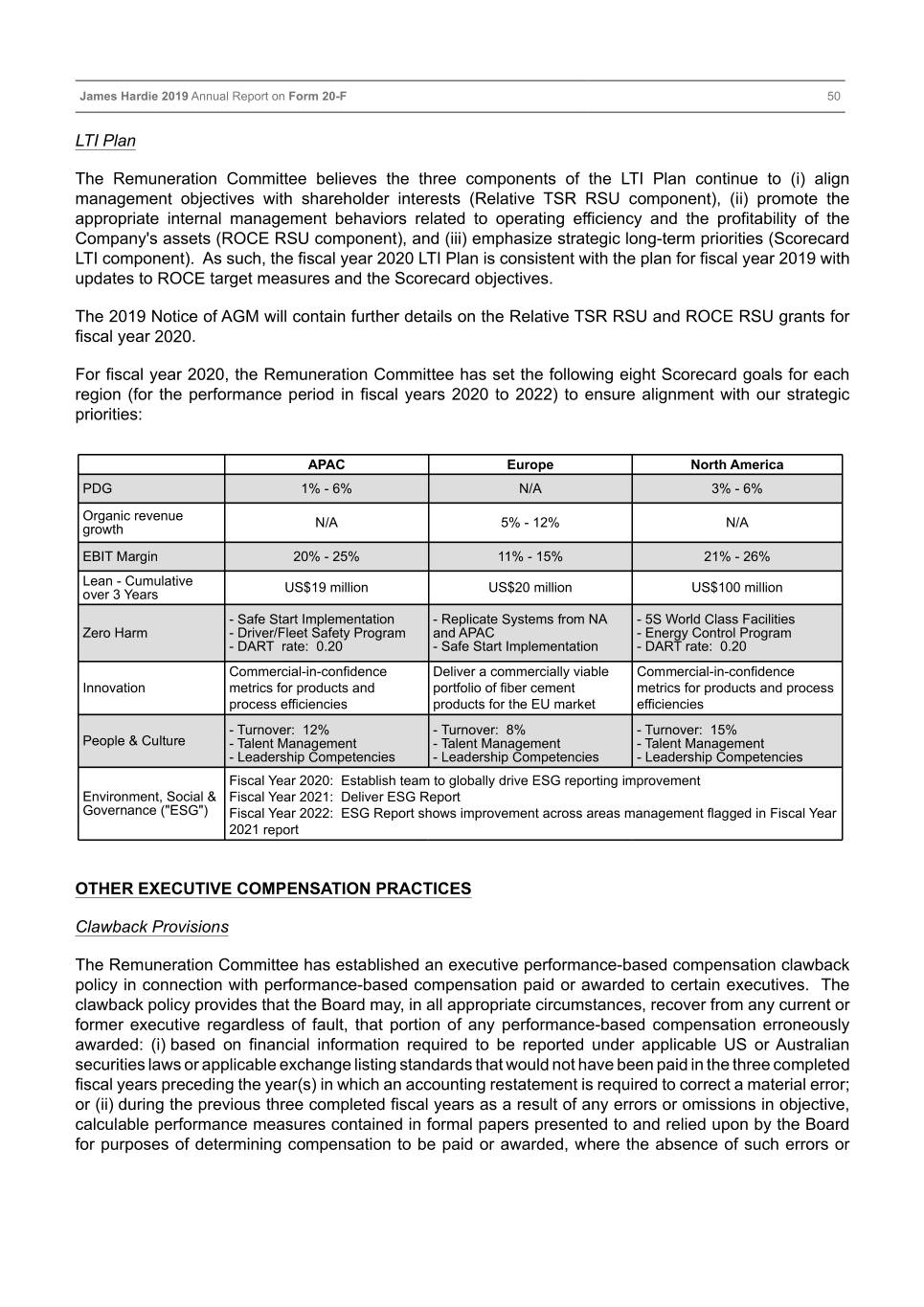
Table of Contents James Hardie 2019 Annual Report on Form 20-F 50 LTI Plan The Remuneration Committee believes the three components of the LTI Plan continue to (i) align management objectives with shareholder interests (Relative TSR RSU component), (ii) promote the appropriate internal management behaviors related to operating efficiency and the profitability of the Company's assets (ROCE RSU component), and (iii) emphasize strategic long-term priorities (Scorecard LTI component). As such, the fiscal year 2020 LTI Plan is consistent with the plan for fiscal year 2019 with updates to ROCE target measures and the Scorecard objectives. The 2019 Notice of AGM will contain further details on the Relative TSR RSU and ROCE RSU grants for fiscal year 2020. For fiscal year 2020, the Remuneration Committee has set the following eight Scorecard goals for each region (for the performance period in fiscal years 2020 to 2022) to ensure alignment with our strategic priorities: APAC Europe North America PDG 1% - 6% N/A 3% - 6% Organic revenue growth N/A 5% - 12% N/A EBIT Margin 20% - 25% 11% - 15% 21% - 26% Lean - Cumulative US$19 million US$20 million US$100 million over 3 Years - Safe Start Implementation - Replicate Systems from NA - 5S World Class Facilities Zero Harm - Driver/Fleet Safety Program and APAC - Energy Control Program - DART rate: 0.20 - Safe Start Implementation - DART rate: 0.20 Commercial-in-confidence Deliver a commercially viable Commercial-in-confidence Innovation metrics for products and portfolio of fiber cement metrics for products and process process efficiencies products for the EU market efficiencies - Turnover: 12% - Turnover: 8% - Turnover: 15% People & Culture - Talent Management - Talent Management - Talent Management - Leadership Competencies - Leadership Competencies - Leadership Competencies Fiscal Year 2020: Establish team to globally drive ESG reporting improvement Environment, Social & Fiscal Year 2021: Deliver ESG Report Governance ("ESG") Fiscal Year 2022: ESG Report shows improvement across areas management flagged in Fiscal Year 2021 report OTHER EXECUTIVE COMPENSATION PRACTICES Clawback Provisions The Remuneration Committee has established an executive performance-based compensation clawback policy in connection with performance-based compensation paid or awarded to certain executives. The clawback policy provides that the Board may, in all appropriate circumstances, recover from any current or former executive regardless of fault, that portion of any performance-based compensation erroneously awarded: (i) based on financial information required to be reported under applicable US or Australian securities laws or applicable exchange listing standards that would not have been paid in the three completed fiscal years preceding the year(s) in which an accounting restatement is required to correct a material error; or (ii) during the previous three completed fiscal years as a result of any errors or omissions in objective, calculable performance measures contained in formal papers presented to and relied upon by the Board for purposes of determining compensation to be paid or awarded, where the absence of such errors or

Table of Contents James Hardie 2019 Annual Report on Form 20-F 51 omissions would have resulted in there being a material negative impact on the amount of performance- based compensation paid or awarded. The clawback policy applies to any person designated as a participant by the Board in the annual LTI Plan and applies to any compensation that is granted, earned or vested based wholly or in part upon the attainment of any financial or other objective, calculable performance measure under any incentive, bonus, retirement or equity compensation plan maintained by the Company, including, without limitation, the STI Plan and LTI Plan. Salaries, discretionary bonuses, time-based equity awards and bonuses or equity awards based on subjective, non-financial measures, including strategic or personal performance metrics, are excluded. The excess compensation requiring recovery shall be the amount of performance-based compensation that an executive received, based on the erroneous data, less the amount that would have been paid to the executive based on the restated or corrected data. All recoverable amounts shall be calculated on a pre- tax basis. For equity awards still held at the time of the recovery, the recoverable amount shall be the amount vested in excess of the number that should have vested under the restated or corrected financial reporting measure. For vested equity awards which have already been sold, the recoverable amount shall be the sale proceeds the executive received with respect to the excess number of shares. In addition, all fiscal year 2019 LTI grants made to Dr Truong and Messrs Gries, Marsh, Gadd and Nielsen, are subject to a specific clawback provision for violation of a limited non-compete provision that specifically prohibits executives from working for designated competitors or for any company that may enter the fiber cement market within two years of departure. For fiscal year 2020, all LTI grants made to Senior Executive Officers will be subject to the clawback provision. Stock Ownership Guidelines The Remuneration Committee believes that Senior Executive Officers should hold a meaningful level of our stock to further align their interests with those of our shareholders. We have adopted stock ownership guidelines for the CEO and other Senior Executive Officers, respectively, which require them to accumulate holdings of three times and one times their base salary, respectively, in our stock over a period of five years from the effective date of the guidelines (1 April 2009) or the date the Senior Executive Officer first becomes subject to the applicable guideline. Until the stock ownership guidelines have been met, Senior Executive Officers are required to retain at least 75% of shares obtained under our LTI Plans (net of taxes and other costs). Once Senior Executive Officers have met or exceeded their stock ownership guidelines, they are required to retain at least 25% of shares issued under our LTI Plans through the vesting of RSUs (net of taxes and other costs) for a period of two years (by way of a holding lock), after which time those shares can be sold (provided the Senior Executive Officer remains at or above the stock ownership guideline). As of 31 March 2019, all Senior Executive Officers have either achieved the minimum share ownership threshold or are within the initial five year accumulation period. Equity Award Practices Annual equity awards under the LTI Plan are generally approved by the Remuneration Committee in May of each year with awards generally issued in August of each year. We do not time the granting of equity awards to the disclosure of material information. For details of the application of our insider-trading policy for equity award grant participants, including our prohibition on employee hedging transactions, see the “Insider Trading” section of this Annual Report.
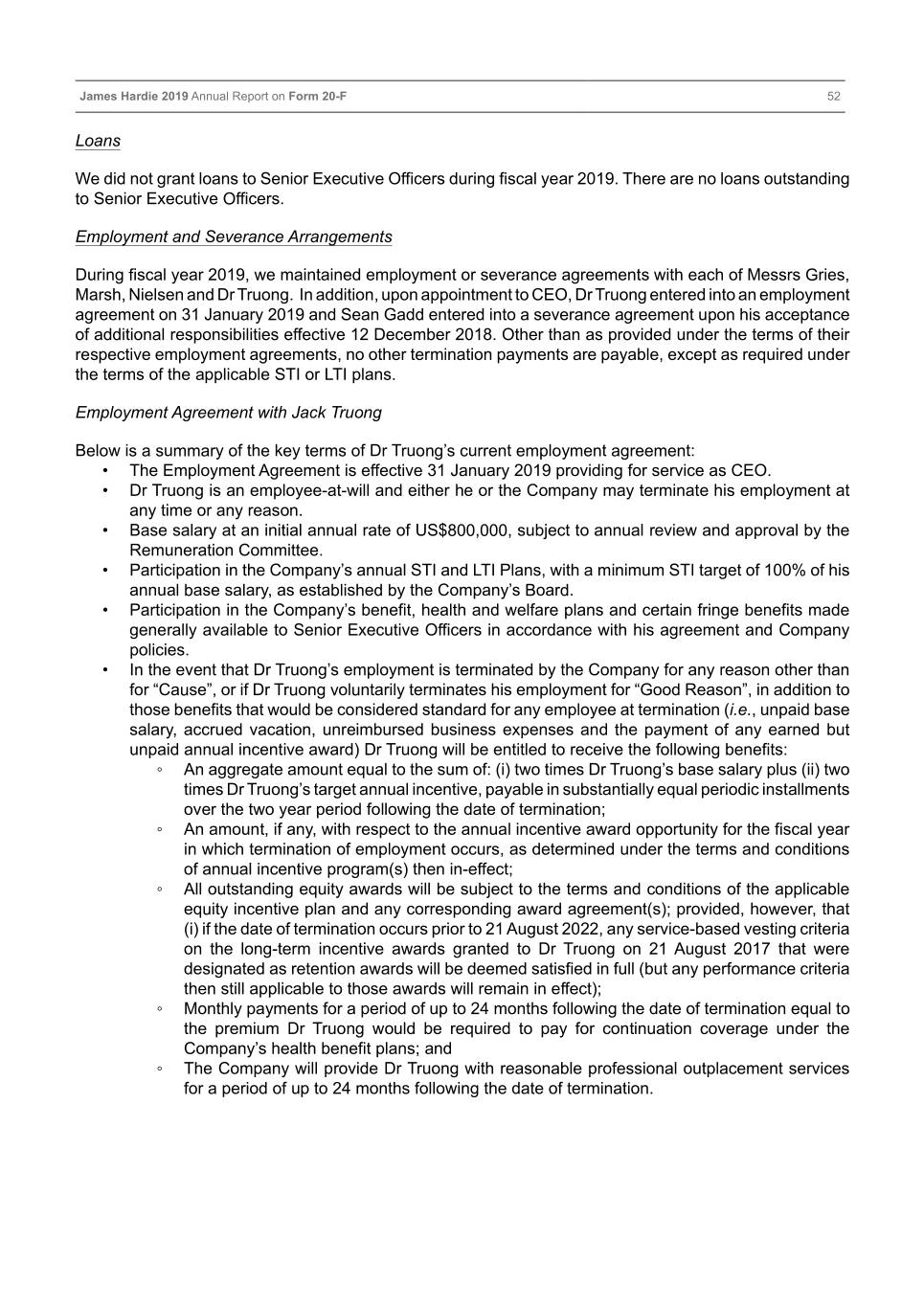
Table of Contents James Hardie 2019 Annual Report on Form 20-F 52 Loans We did not grant loans to Senior Executive Officers during fiscal year 2019. There are no loans outstanding to Senior Executive Officers. Employment and Severance Arrangements During fiscal year 2019, we maintained employment or severance agreements with each of Messrs Gries, Marsh, Nielsen and Dr Truong. In addition, upon appointment to CEO, Dr Truong entered into an employment agreement on 31 January 2019 and Sean Gadd entered into a severance agreement upon his acceptance of additional responsibilities effective 12 December 2018. Other than as provided under the terms of their respective employment agreements, no other termination payments are payable, except as required under the terms of the applicable STI or LTI plans. Employment Agreement with Jack Truong Below is a summary of the key terms of Dr Truong’s current employment agreement: • The Employment Agreement is effective 31 January 2019 providing for service as CEO. • Dr Truong is an employee-at-will and either he or the Company may terminate his employment at any time or any reason. • Base salary at an initial annual rate of US$800,000, subject to annual review and approval by the Remuneration Committee. • Participation in the Company’s annual STI and LTI Plans, with a minimum STI target of 100% of his annual base salary, as established by the Company’s Board. • Participation in the Company’s benefit, health and welfare plans and certain fringe benefits made generally available to Senior Executive Officers in accordance with his agreement and Company policies. • In the event that Dr Truong’s employment is terminated by the Company for any reason other than for “Cause”, or if Dr Truong voluntarily terminates his employment for “Good Reason”, in addition to those benefits that would be considered standard for any employee at termination (i.e., unpaid base salary, accrued vacation, unreimbursed business expenses and the payment of any earned but unpaid annual incentive award) Dr Truong will be entitled to receive the following benefits: ◦ An aggregate amount equal to the sum of: (i) two times Dr Truong’s base salary plus (ii) two times Dr Truong’s target annual incentive, payable in substantially equal periodic installments over the two year period following the date of termination; ◦ An amount, if any, with respect to the annual incentive award opportunity for the fiscal year in which termination of employment occurs, as determined under the terms and conditions of annual incentive program(s) then in-effect; ◦ All outstanding equity awards will be subject to the terms and conditions of the applicable equity incentive plan and any corresponding award agreement(s); provided, however, that (i) if the date of termination occurs prior to 21 August 2022, any service-based vesting criteria on the long-term incentive awards granted to Dr Truong on 21 August 2017 that were designated as retention awards will be deemed satisfied in full (but any performance criteria then still applicable to those awards will remain in effect); ◦ Monthly payments for a period of up to 24 months following the date of termination equal to the premium Dr Truong would be required to pay for continuation coverage under the Company’s health benefit plans; and ◦ The Company will provide Dr Truong with reasonable professional outplacement services for a period of up to 24 months following the date of termination.
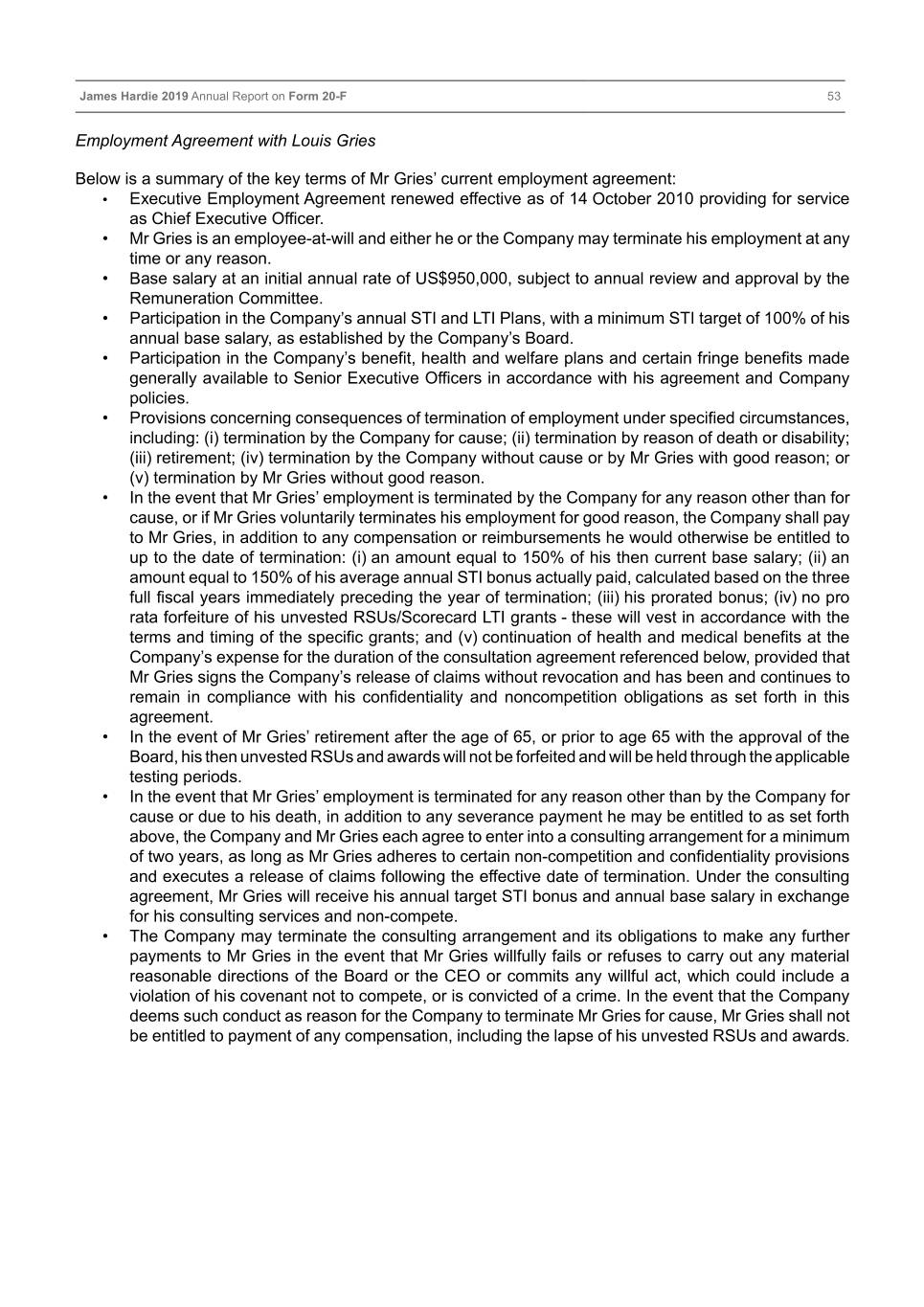
Table of Contents James Hardie 2019 Annual Report on Form 20-F 53 Employment Agreement with Louis Gries Below is a summary of the key terms of Mr Gries’ current employment agreement: • Executive Employment Agreement renewed effective as of 14 October 2010 providing for service as Chief Executive Officer. • Mr Gries is an employee-at-will and either he or the Company may terminate his employment at any time or any reason. • Base salary at an initial annual rate of US$950,000, subject to annual review and approval by the Remuneration Committee. • Participation in the Company’s annual STI and LTI Plans, with a minimum STI target of 100% of his annual base salary, as established by the Company’s Board. • Participation in the Company’s benefit, health and welfare plans and certain fringe benefits made generally available to Senior Executive Officers in accordance with his agreement and Company policies. • Provisions concerning consequences of termination of employment under specified circumstances, including: (i) termination by the Company for cause; (ii) termination by reason of death or disability; (iii) retirement; (iv) termination by the Company without cause or by Mr Gries with good reason; or (v) termination by Mr Gries without good reason. • In the event that Mr Gries’ employment is terminated by the Company for any reason other than for cause, or if Mr Gries voluntarily terminates his employment for good reason, the Company shall pay to Mr Gries, in addition to any compensation or reimbursements he would otherwise be entitled to up to the date of termination: (i) an amount equal to 150% of his then current base salary; (ii) an amount equal to 150% of his average annual STI bonus actually paid, calculated based on the three full fiscal years immediately preceding the year of termination; (iii) his prorated bonus; (iv) no pro rata forfeiture of his unvested RSUs/Scorecard LTI grants - these will vest in accordance with the terms and timing of the specific grants; and (v) continuation of health and medical benefits at the Company’s expense for the duration of the consultation agreement referenced below, provided that Mr Gries signs the Company’s release of claims without revocation and has been and continues to remain in compliance with his confidentiality and noncompetition obligations as set forth in this agreement. • In the event of Mr Gries’ retirement after the age of 65, or prior to age 65 with the approval of the Board, his then unvested RSUs and awards will not be forfeited and will be held through the applicable testing periods. • In the event that Mr Gries’ employment is terminated for any reason other than by the Company for cause or due to his death, in addition to any severance payment he may be entitled to as set forth above, the Company and Mr Gries each agree to enter into a consulting arrangement for a minimum of two years, as long as Mr Gries adheres to certain non-competition and confidentiality provisions and executes a release of claims following the effective date of termination. Under the consulting agreement, Mr Gries will receive his annual target STI bonus and annual base salary in exchange for his consulting services and non-compete. • The Company may terminate the consulting arrangement and its obligations to make any further payments to Mr Gries in the event that Mr Gries willfully fails or refuses to carry out any material reasonable directions of the Board or the CEO or commits any willful act, which could include a violation of his covenant not to compete, or is convicted of a crime. In the event that the Company deems such conduct as reason for the Company to terminate Mr Gries for cause, Mr Gries shall not be entitled to payment of any compensation, including the lapse of his unvested RSUs and awards.

Table of Contents James Hardie 2019 Annual Report on Form 20-F 54 Employment Agreement with Matt Marsh Below is a summary of the key terms of Mr Marsh’s current employment agreement: • Effective 15 May 2016, the Company entered into an employment agreement with Mr Marsh (the “Marsh Agreement”), which has an initial term of three years and automatic one year renewals thereafter unless either Mr Marsh or the Company notifies the other party at least 90 days before the expiration date that the Marsh Agreement is not to be renewed. In the event that the Company is the party that determines not to renew, such non-renewal shall be treated as a termination without “Cause” (as defined in the Marsh Agreement) and subject to the termination without “Cause” provisions of the Marsh Agreement. • The Marsh Agreement provides for a base salary of not less than US$560,000, or such greater amount as may be established by the Remuneration Committee, for Mr Marsh. The base salary shall be reviewed annually for increase in the discretion of the Remuneration Committee. Additionally, Mr Marsh shall be eligible for an annual STI award with payout opportunities that are commensurate with his position and duties, with a minimum target annual STI award opportunity of not less than 70% of the current base salary. Mr Marsh shall also be eligible to participate in our annual LTI plan on terms commensurate with his position and duties, with a minimum annual target LTI award opportunity of not less than US$1,200,000. • Mr Marsh shall be eligible for participation in our employee benefit, health and welfare plans and certain fringe benefits made generally available to Senior Executive Officers in accordance with Company policies. • The Marsh Agreement contains provisions concerning the consequences of termination of employment under specified circumstances, including: (i) termination by the Company for Cause; (ii) termination by reason of death or disability; (iii) termination by the Company without Cause or by Mr Marsh with “Good Reason” (as defined in the Marsh Agreement); or (iv) termination by Mr Marsh without Good Reason. In particular, in the event the Company terminates Mr Marsh without Cause or Mr Marsh voluntarily terminates for Good Reason, Mr Marsh shall be entitled to: (i) a lump-sum amount equal to his unpaid base salary through and including the date of termination, as well as accrued, unused vacation pay and unreimbursed business expenses; (ii) a payment for any earned but unpaid annual incentive award for a completed calendar year prior to the date of termination; (iii) salary continuation for the two year period following the date of termination, provided the aggregate amount of such continuation payments shall be equal to the sum of (A) two times the base salary plus (B) one times the annual incentive award opportunity, as then in effect; (iv) an amount, if any, with respect to the annual incentive award opportunity for the year in which such termination of employment occurs, as determined under the terms and conditions of the Company’s annual incentive program(s); (v) all outstanding equity awards will remain subject to the terms and conditions of the applicable equity incentive plan and any corresponding award agreement(s); (vi) monthly payments for a period of 18 months equal to the premium Mr Marsh would be required to pay for COBRA continuation coverage under James Hardie’s health benefit plans, determined using the COBRA premium rate in effect for the level of coverage that Mr Marsh has in place immediately prior to termination; and (vii) the Company will assist Mr Marsh in finding other employment opportunities by providing to him, at James Hardie’s limited expense, reasonable professional outplacement services through the provider of James Hardie’s choice for a period of up to 24 months. • Pursuant to the confidentiality, non-competition and non-solicitation provisions of the Marsh Agreement, for a period of 24 months following any termination of Mr Marsh’s employment, Mr Marsh shall be prohibited from: (i) directly or indirectly acting, engaging in, have a financial or other interest in, or otherwise serving as an employee, agent, partner, shareholder, director, or consultant for certain designated competitors of the Company; and (ii) employing or retaining or soliciting for employment any person who is an employee or consultant of the Company or soliciting suppliers or customers of the Company or inducing any such person to terminate his, her, or its relationship with the Company.
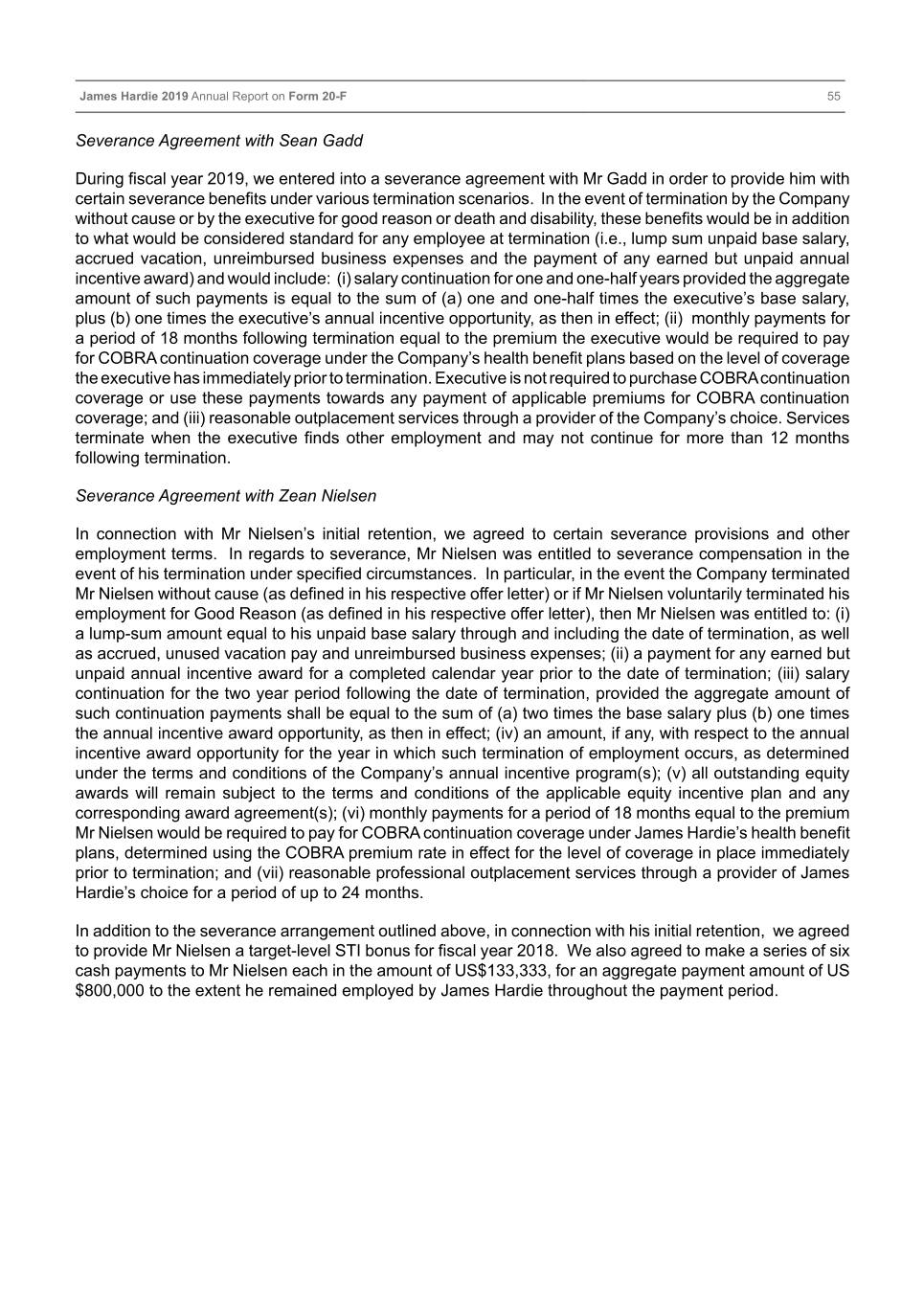
Table of Contents James Hardie 2019 Annual Report on Form 20-F 55 Severance Agreement with Sean Gadd During fiscal year 2019, we entered into a severance agreement with Mr Gadd in order to provide him with certain severance benefits under various termination scenarios. In the event of termination by the Company without cause or by the executive for good reason or death and disability, these benefits would be in addition to what would be considered standard for any employee at termination (i.e., lump sum unpaid base salary, accrued vacation, unreimbursed business expenses and the payment of any earned but unpaid annual incentive award) and would include: (i) salary continuation for one and one-half years provided the aggregate amount of such payments is equal to the sum of (a) one and one-half times the executive’s base salary, plus (b) one times the executive’s annual incentive opportunity, as then in effect; (ii) monthly payments for a period of 18 months following termination equal to the premium the executive would be required to pay for COBRA continuation coverage under the Company’s health benefit plans based on the level of coverage the executive has immediately prior to termination. Executive is not required to purchase COBRA continuation coverage or use these payments towards any payment of applicable premiums for COBRA continuation coverage; and (iii) reasonable outplacement services through a provider of the Company’s choice. Services terminate when the executive finds other employment and may not continue for more than 12 months following termination. Severance Agreement with Zean Nielsen In connection with Mr Nielsen’s initial retention, we agreed to certain severance provisions and other employment terms. In regards to severance, Mr Nielsen was entitled to severance compensation in the event of his termination under specified circumstances. In particular, in the event the Company terminated Mr Nielsen without cause (as defined in his respective offer letter) or if Mr Nielsen voluntarily terminated his employment for Good Reason (as defined in his respective offer letter), then Mr Nielsen was entitled to: (i) a lump-sum amount equal to his unpaid base salary through and including the date of termination, as well as accrued, unused vacation pay and unreimbursed business expenses; (ii) a payment for any earned but unpaid annual incentive award for a completed calendar year prior to the date of termination; (iii) salary continuation for the two year period following the date of termination, provided the aggregate amount of such continuation payments shall be equal to the sum of (a) two times the base salary plus (b) one times the annual incentive award opportunity, as then in effect; (iv) an amount, if any, with respect to the annual incentive award opportunity for the year in which such termination of employment occurs, as determined under the terms and conditions of the Company’s annual incentive program(s); (v) all outstanding equity awards will remain subject to the terms and conditions of the applicable equity incentive plan and any corresponding award agreement(s); (vi) monthly payments for a period of 18 months equal to the premium Mr Nielsen would be required to pay for COBRA continuation coverage under James Hardie’s health benefit plans, determined using the COBRA premium rate in effect for the level of coverage in place immediately prior to termination; and (vii) reasonable professional outplacement services through a provider of James Hardie’s choice for a period of up to 24 months. In addition to the severance arrangement outlined above, in connection with his initial retention, we agreed to provide Mr Nielsen a target-level STI bonus for fiscal year 2018. We also agreed to make a series of six cash payments to Mr Nielsen each in the amount of US$133,333, for an aggregate payment amount of US $800,000 to the extent he remained employed by James Hardie throughout the payment period.
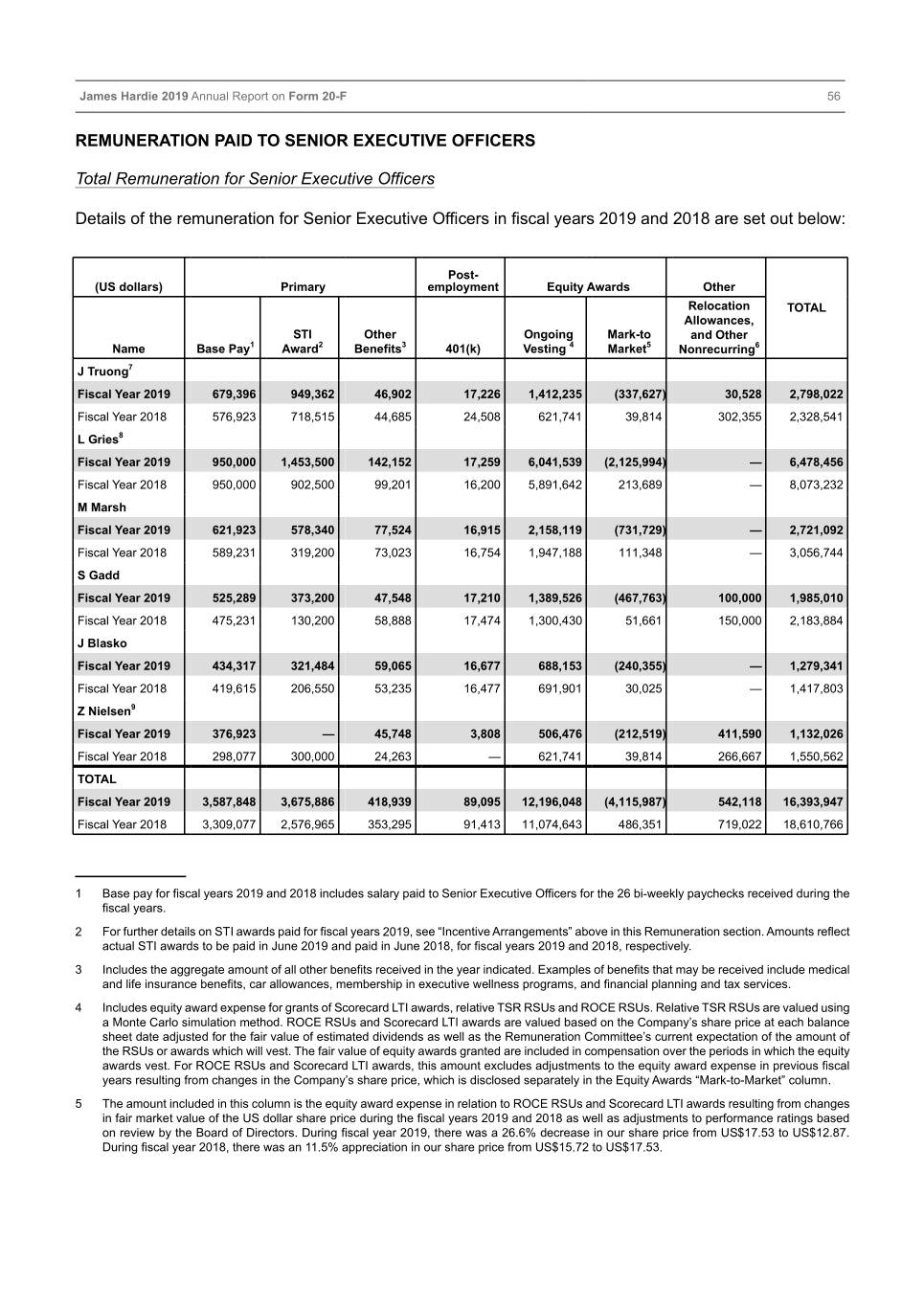
Table of Contents James Hardie 2019 Annual Report on Form 20-F 56 REMUNERATION PAID TO SENIOR EXECUTIVE OFFICERS Total Remuneration for Senior Executive Officers Details of the remuneration for Senior Executive Officers in fiscal years 2019 and 2018 are set out below: Post- (US dollars) Primary employment Equity Awards Other Relocation TOTAL Allowances, STI Other Ongoing Mark-to and Other Name Base Pay1 Award2 Benefits3 401(k) Vesting 4 Market5 Nonrecurring6 J Truong7 Fiscal Year 2019 679,396 949,362 46,902 17,226 1,412,235 (337,627) 30,528 2,798,022 Fiscal Year 2018 576,923 718,515 44,685 24,508 621,741 39,814 302,355 2,328,541 L Gries8 Fiscal Year 2019 950,000 1,453,500 142,152 17,259 6,041,539 (2,125,994) — 6,478,456 Fiscal Year 2018 950,000 902,500 99,201 16,200 5,891,642 213,689 — 8,073,232 M Marsh Fiscal Year 2019 621,923 578,340 77,524 16,915 2,158,119 (731,729) — 2,721,092 Fiscal Year 2018 589,231 319,200 73,023 16,754 1,947,188 111,348 — 3,056,744 S Gadd Fiscal Year 2019 525,289 373,200 47,548 17,210 1,389,526 (467,763) 100,000 1,985,010 Fiscal Year 2018 475,231 130,200 58,888 17,474 1,300,430 51,661 150,000 2,183,884 J Blasko Fiscal Year 2019 434,317 321,484 59,065 16,677 688,153 (240,355) — 1,279,341 Fiscal Year 2018 419,615 206,550 53,235 16,477 691,901 30,025 — 1,417,803 Z Nielsen9 Fiscal Year 2019 376,923 — 45,748 3,808 506,476 (212,519) 411,590 1,132,026 Fiscal Year 2018 298,077 300,000 24,263 — 621,741 39,814 266,667 1,550,562 TOTAL Fiscal Year 2019 3,587,848 3,675,886 418,939 89,095 12,196,048 (4,115,987) 542,118 16,393,947 Fiscal Year 2018 3,309,077 2,576,965 353,295 91,413 11,074,643 486,351 719,022 18,610,766 ____________ 1 Base pay for fiscal years 2019 and 2018 includes salary paid to Senior Executive Officers for the 26 bi-weekly paychecks received during the fiscal years. 2 For further details on STI awards paid for fiscal years 2019, see “Incentive Arrangements” above in this Remuneration section. Amounts reflect actual STI awards to be paid in June 2019 and paid in June 2018, for fiscal years 2019 and 2018, respectively. 3 Includes the aggregate amount of all other benefits received in the year indicated. Examples of benefits that may be received include medical and life insurance benefits, car allowances, membership in executive wellness programs, and financial planning and tax services. 4 Includes equity award expense for grants of Scorecard LTI awards, relative TSR RSUs and ROCE RSUs. Relative TSR RSUs are valued using a Monte Carlo simulation method. ROCE RSUs and Scorecard LTI awards are valued based on the Company’s share price at each balance sheet date adjusted for the fair value of estimated dividends as well as the Remuneration Committee’s current expectation of the amount of the RSUs or awards which will vest. The fair value of equity awards granted are included in compensation over the periods in which the equity awards vest. For ROCE RSUs and Scorecard LTI awards, this amount excludes adjustments to the equity award expense in previous fiscal years resulting from changes in the Company’s share price, which is disclosed separately in the Equity Awards “Mark-to-Market” column. 5 The amount included in this column is the equity award expense in relation to ROCE RSUs and Scorecard LTI awards resulting from changes in fair market value of the US dollar share price during the fiscal years 2019 and 2018 as well as adjustments to performance ratings based on review by the Board of Directors. During fiscal year 2019, there was a 26.6% decrease in our share price from US$17.53 to US$12.87. During fiscal year 2018, there was an 11.5% appreciation in our share price from US$15.72 to US$17.53.
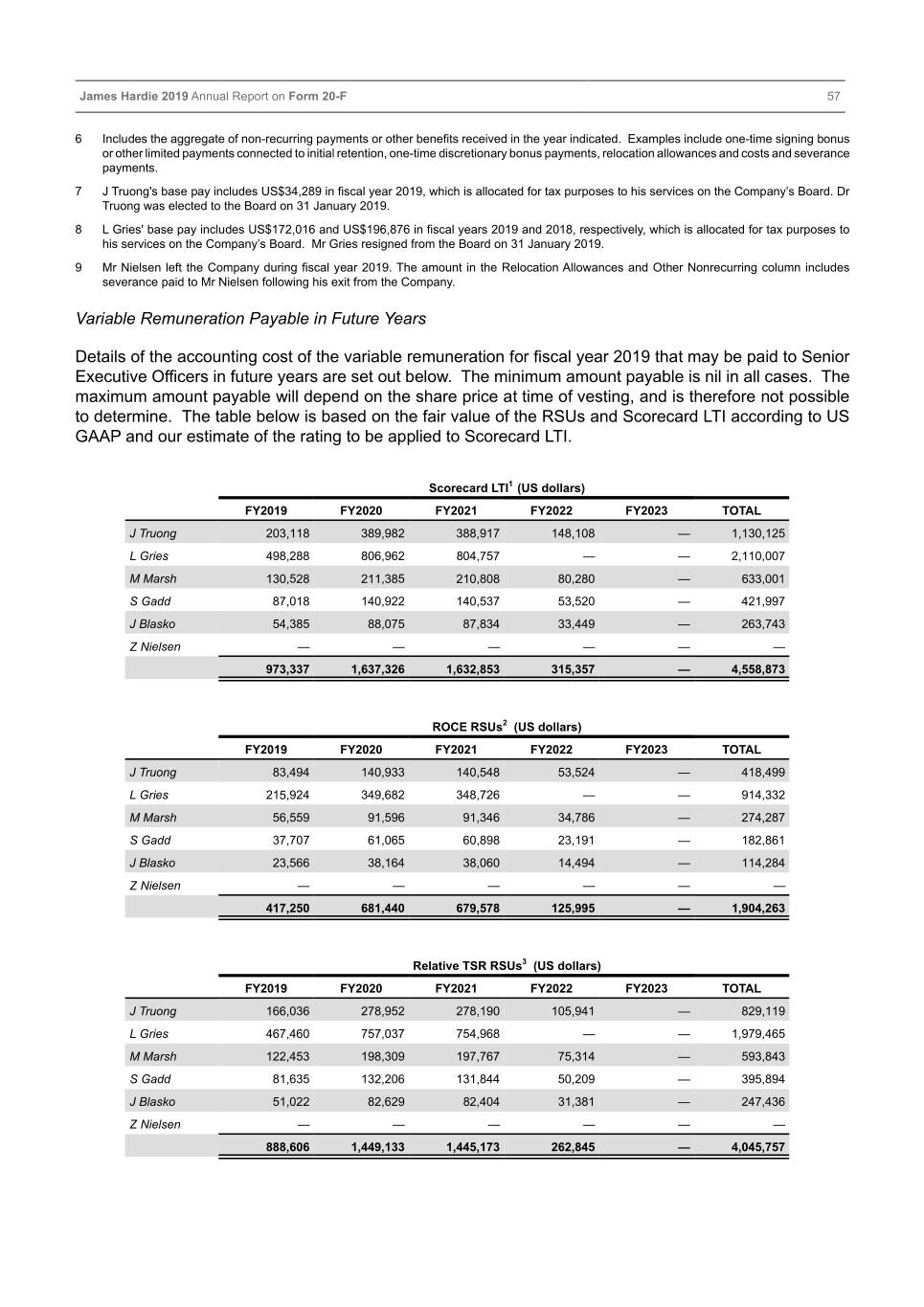
Table of Contents James Hardie 2019 Annual Report on Form 20-F 57 6 Includes the aggregate of non-recurring payments or other benefits received in the year indicated. Examples include one-time signing bonus or other limited payments connected to initial retention, one-time discretionary bonus payments, relocation allowances and costs and severance payments. 7 J Truong's base pay includes US$34,289 in fiscal year 2019, which is allocated for tax purposes to his services on the Company’s Board. Dr Truong was elected to the Board on 31 January 2019. 8 L Gries' base pay includes US$172,016 and US$196,876 in fiscal years 2019 and 2018, respectively, which is allocated for tax purposes to his services on the Company’s Board. Mr Gries resigned from the Board on 31 January 2019. 9 Mr Nielsen left the Company during fiscal year 2019. The amount in the Relocation Allowances and Other Nonrecurring column includes severance paid to Mr Nielsen following his exit from the Company. Variable Remuneration Payable in Future Years Details of the accounting cost of the variable remuneration for fiscal year 2019 that may be paid to Senior Executive Officers in future years are set out below. The minimum amount payable is nil in all cases. The maximum amount payable will depend on the share price at time of vesting, and is therefore not possible to determine. The table below is based on the fair value of the RSUs and Scorecard LTI according to US GAAP and our estimate of the rating to be applied to Scorecard LTI. Scorecard LTI1 (US dollars) FY2019 FY2020 FY2021 FY2022 FY2023 TOTAL J Truong 203,118 389,982 388,917 148,108 — 1,130,125 L Gries 498,288 806,962 804,757 — — 2,110,007 M Marsh 130,528 211,385 210,808 80,280 — 633,001 S Gadd 87,018 140,922 140,537 53,520 — 421,997 J Blasko 54,385 88,075 87,834 33,449 — 263,743 Z Nielsen — — — — — — 973,337 1,637,326 1,632,853 315,357 — 4,558,873 ROCE RSUs2 (US dollars) FY2019 FY2020 FY2021 FY2022 FY2023 TOTAL J Truong 83,494 140,933 140,548 53,524 — 418,499 L Gries 215,924 349,682 348,726 — — 914,332 M Marsh 56,559 91,596 91,346 34,786 — 274,287 S Gadd 37,707 61,065 60,898 23,191 — 182,861 J Blasko 23,566 38,164 38,060 14,494 — 114,284 Z Nielsen — — — — — — 417,250 681,440 679,578 125,995 — 1,904,263 Relative TSR RSUs3 (US dollars) FY2019 FY2020 FY2021 FY2022 FY2023 TOTAL J Truong 166,036 278,952 278,190 105,941 — 829,119 L Gries 467,460 757,037 754,968 — — 1,979,465 M Marsh 122,453 198,309 197,767 75,314 — 593,843 S Gadd 81,635 132,206 131,844 50,209 — 395,894 J Blasko 51,022 82,629 82,404 31,381 — 247,436 Z Nielsen — — — — — — 888,606 1,449,133 1,445,173 262,845 — 4,045,757
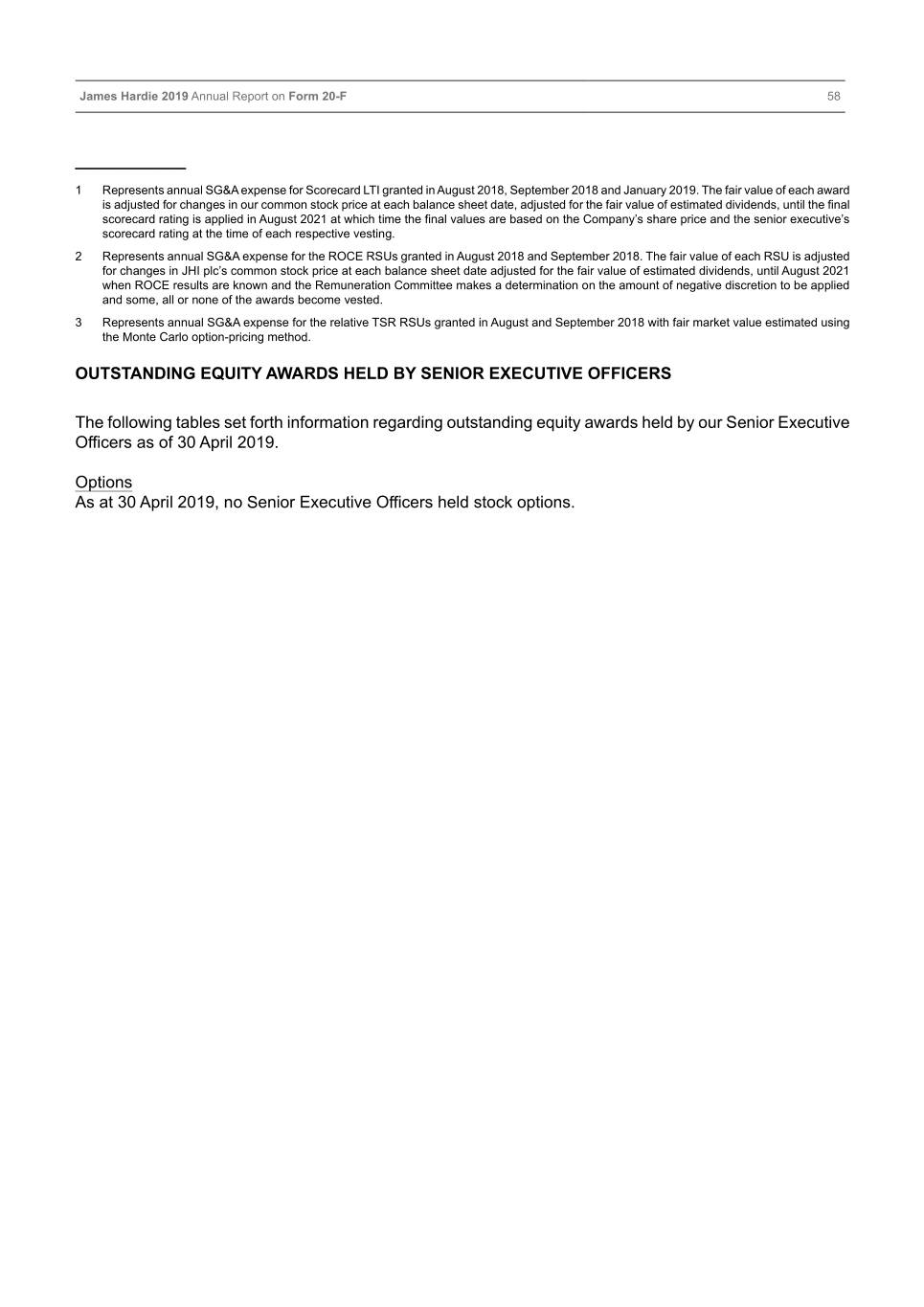
Table of Contents James Hardie 2019 Annual Report on Form 20-F 58 ____________ 1 Represents annual SG&A expense for Scorecard LTI granted in August 2018, September 2018 and January 2019. The fair value of each award is adjusted for changes in our common stock price at each balance sheet date, adjusted for the fair value of estimated dividends, until the final scorecard rating is applied in August 2021 at which time the final values are based on the Company’s share price and the senior executive’s scorecard rating at the time of each respective vesting. 2 Represents annual SG&A expense for the ROCE RSUs granted in August 2018 and September 2018. The fair value of each RSU is adjusted for changes in JHI plc’s common stock price at each balance sheet date adjusted for the fair value of estimated dividends, until August 2021 when ROCE results are known and the Remuneration Committee makes a determination on the amount of negative discretion to be applied and some, all or none of the awards become vested. 3 Represents annual SG&A expense for the relative TSR RSUs granted in August and September 2018 with fair market value estimated using the Monte Carlo option-pricing method. OUTSTANDING EQUITY AWARDS HELD BY SENIOR EXECUTIVE OFFICERS The following tables set forth information regarding outstanding equity awards held by our Senior Executive Officers as of 30 April 2019. Options As at 30 April 2019, no Senior Executive Officers held stock options.
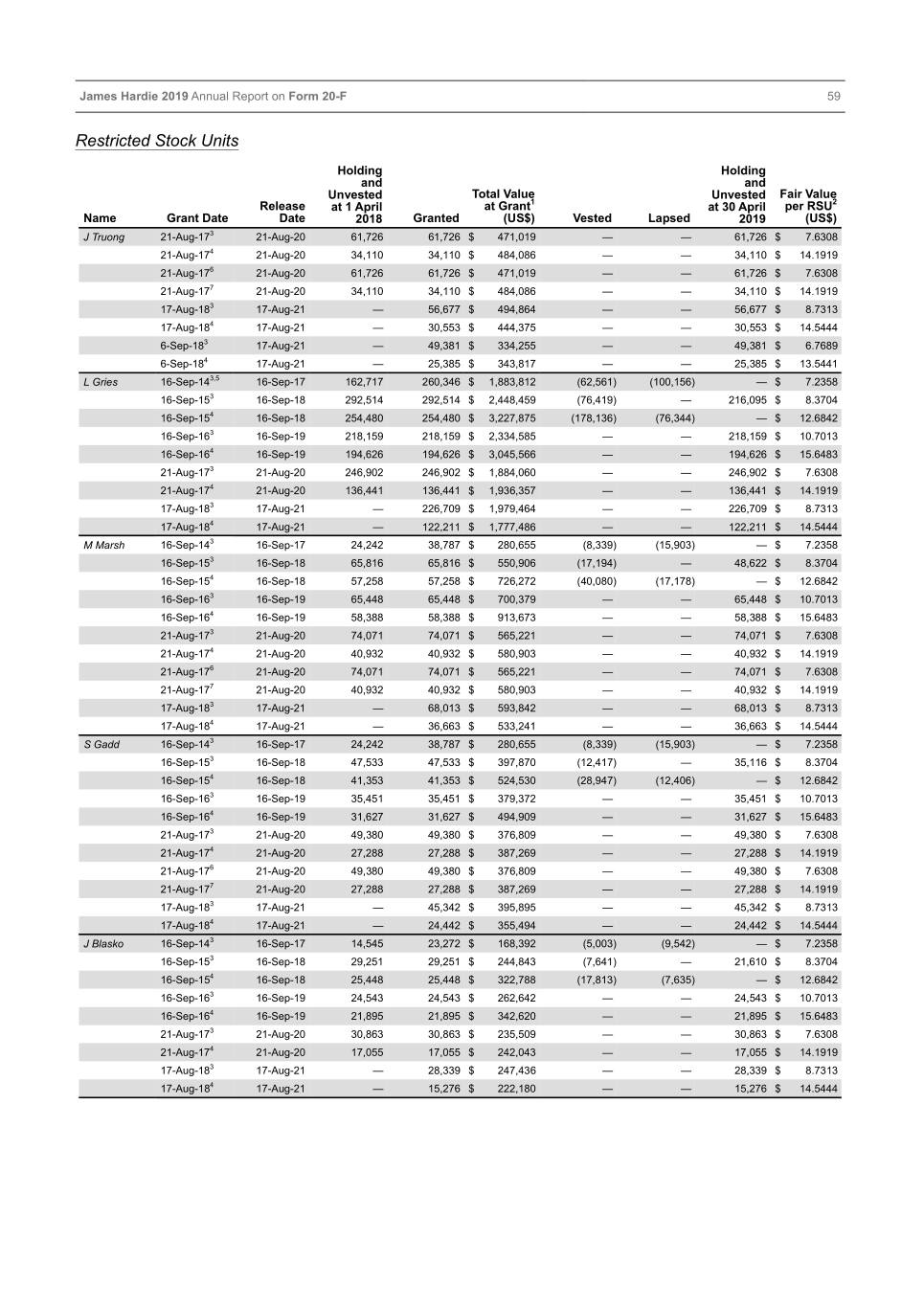
Table of Contents James Hardie 2019 Annual Report on Form 20-F 59 Restricted Stock Units Holding Holding and and Unvested Total Value Unvested Fair Value Release at 1 April at Grant1 at 30 April per RSU2 Name Grant Date Date 2018 Granted (US$) Vested Lapsed 2019 (US$) J Truong 21-Aug-173 21-Aug-20 61,726 61,726 $ 471,019 — — 61,726 $ 7.6308 21-Aug-174 21-Aug-20 34,110 34,110 $ 484,086 — — 34,110 $ 14.1919 21-Aug-176 21-Aug-20 61,726 61,726 $ 471,019 — — 61,726 $ 7.6308 21-Aug-177 21-Aug-20 34,110 34,110 $ 484,086 — — 34,110 $ 14.1919 17-Aug-183 17-Aug-21 — 56,677 $ 494,864 — — 56,677 $ 8.7313 17-Aug-184 17-Aug-21 — 30,553 $ 444,375 — — 30,553 $ 14.5444 6-Sep-183 17-Aug-21 — 49,381 $ 334,255 — — 49,381 $ 6.7689 6-Sep-184 17-Aug-21 — 25,385 $ 343,817 — — 25,385 $ 13.5441 L Gries 16-Sep-143,5 16-Sep-17 162,717 260,346 $ 1,883,812 (62,561) (100,156) — $ 7.2358 16-Sep-153 16-Sep-18 292,514 292,514 $ 2,448,459 (76,419) — 216,095 $ 8.3704 16-Sep-154 16-Sep-18 254,480 254,480 $ 3,227,875 (178,136) (76,344) — $ 12.6842 16-Sep-163 16-Sep-19 218,159 218,159 $ 2,334,585 — — 218,159 $ 10.7013 16-Sep-164 16-Sep-19 194,626 194,626 $ 3,045,566 — — 194,626 $ 15.6483 21-Aug-173 21-Aug-20 246,902 246,902 $ 1,884,060 — — 246,902 $ 7.6308 21-Aug-174 21-Aug-20 136,441 136,441 $ 1,936,357 — — 136,441 $ 14.1919 17-Aug-183 17-Aug-21 — 226,709 $ 1,979,464 — — 226,709 $ 8.7313 17-Aug-184 17-Aug-21 — 122,211 $ 1,777,486 — — 122,211 $ 14.5444 M Marsh 16-Sep-143 16-Sep-17 24,242 38,787 $ 280,655 (8,339) (15,903) — $ 7.2358 16-Sep-153 16-Sep-18 65,816 65,816 $ 550,906 (17,194) — 48,622 $ 8.3704 16-Sep-154 16-Sep-18 57,258 57,258 $ 726,272 (40,080) (17,178) — $ 12.6842 16-Sep-163 16-Sep-19 65,448 65,448 $ 700,379 — — 65,448 $ 10.7013 16-Sep-164 16-Sep-19 58,388 58,388 $ 913,673 — — 58,388 $ 15.6483 21-Aug-173 21-Aug-20 74,071 74,071 $ 565,221 — — 74,071 $ 7.6308 21-Aug-174 21-Aug-20 40,932 40,932 $ 580,903 — — 40,932 $ 14.1919 21-Aug-176 21-Aug-20 74,071 74,071 $ 565,221 — — 74,071 $ 7.6308 21-Aug-177 21-Aug-20 40,932 40,932 $ 580,903 — — 40,932 $ 14.1919 17-Aug-183 17-Aug-21 — 68,013 $ 593,842 — — 68,013 $ 8.7313 17-Aug-184 17-Aug-21 — 36,663 $ 533,241 — — 36,663 $ 14.5444 S Gadd 16-Sep-143 16-Sep-17 24,242 38,787 $ 280,655 (8,339) (15,903) — $ 7.2358 16-Sep-153 16-Sep-18 47,533 47,533 $ 397,870 (12,417) — 35,116 $ 8.3704 16-Sep-154 16-Sep-18 41,353 41,353 $ 524,530 (28,947) (12,406) — $ 12.6842 16-Sep-163 16-Sep-19 35,451 35,451 $ 379,372 — — 35,451 $ 10.7013 16-Sep-164 16-Sep-19 31,627 31,627 $ 494,909 — — 31,627 $ 15.6483 21-Aug-173 21-Aug-20 49,380 49,380 $ 376,809 — — 49,380 $ 7.6308 21-Aug-174 21-Aug-20 27,288 27,288 $ 387,269 — — 27,288 $ 14.1919 21-Aug-176 21-Aug-20 49,380 49,380 $ 376,809 — — 49,380 $ 7.6308 21-Aug-177 21-Aug-20 27,288 27,288 $ 387,269 — — 27,288 $ 14.1919 17-Aug-183 17-Aug-21 — 45,342 $ 395,895 — — 45,342 $ 8.7313 17-Aug-184 17-Aug-21 — 24,442 $ 355,494 — — 24,442 $ 14.5444 J Blasko 16-Sep-143 16-Sep-17 14,545 23,272 $ 168,392 (5,003) (9,542) — $ 7.2358 16-Sep-153 16-Sep-18 29,251 29,251 $ 244,843 (7,641) — 21,610 $ 8.3704 16-Sep-154 16-Sep-18 25,448 25,448 $ 322,788 (17,813) (7,635) — $ 12.6842 16-Sep-163 16-Sep-19 24,543 24,543 $ 262,642 — — 24,543 $ 10.7013 16-Sep-164 16-Sep-19 21,895 21,895 $ 342,620 — — 21,895 $ 15.6483 21-Aug-173 21-Aug-20 30,863 30,863 $ 235,509 — — 30,863 $ 7.6308 21-Aug-174 21-Aug-20 17,055 17,055 $ 242,043 — — 17,055 $ 14.1919 17-Aug-183 17-Aug-21 — 28,339 $ 247,436 — — 28,339 $ 8.7313 17-Aug-184 17-Aug-21 — 15,276 $ 222,180 — — 15,276 $ 14.5444
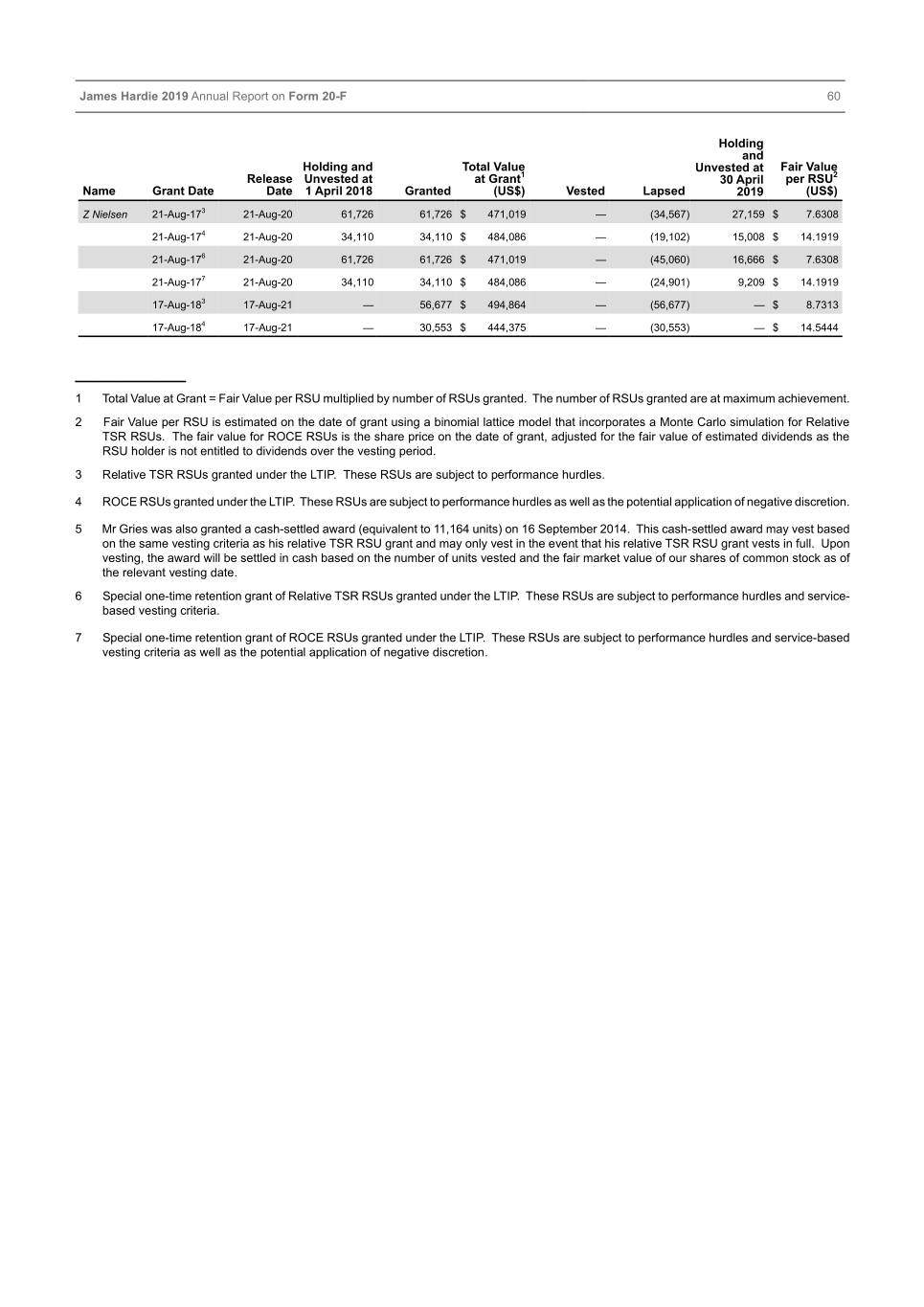
Table of Contents James Hardie 2019 Annual Report on Form 20-F 60 Holding and Holding and Total Value Unvested at Fair Value Release Unvested at at Grant1 30 April per RSU2 Name Grant Date Date 1 April 2018 Granted (US$) Vested Lapsed 2019 (US$) Z Nielsen 21-Aug-173 21-Aug-20 61,726 61,726 $ 471,019 — (34,567) 27,159 $ 7.6308 21-Aug-174 21-Aug-20 34,110 34,110 $ 484,086 — (19,102) 15,008 $ 14.1919 21-Aug-176 21-Aug-20 61,726 61,726 $ 471,019 — (45,060) 16,666 $ 7.6308 21-Aug-177 21-Aug-20 34,110 34,110 $ 484,086 — (24,901) 9,209 $ 14.1919 17-Aug-183 17-Aug-21 — 56,677 $ 494,864 — (56,677) — $ 8.7313 17-Aug-184 17-Aug-21 — 30,553 $ 444,375 — (30,553) — $ 14.5444 ____________ 1 Total Value at Grant = Fair Value per RSU multiplied by number of RSUs granted. The number of RSUs granted are at maximum achievement. 2 Fair Value per RSU is estimated on the date of grant using a binomial lattice model that incorporates a Monte Carlo simulation for Relative TSR RSUs. The fair value for ROCE RSUs is the share price on the date of grant, adjusted for the fair value of estimated dividends as the RSU holder is not entitled to dividends over the vesting period. 3 Relative TSR RSUs granted under the LTIP. These RSUs are subject to performance hurdles. 4 ROCE RSUs granted under the LTIP. These RSUs are subject to performance hurdles as well as the potential application of negative discretion. 5 Mr Gries was also granted a cash-settled award (equivalent to 11,164 units) on 16 September 2014. This cash-settled award may vest based on the same vesting criteria as his relative TSR RSU grant and may only vest in the event that his relative TSR RSU grant vests in full. Upon vesting, the award will be settled in cash based on the number of units vested and the fair market value of our shares of common stock as of the relevant vesting date. 6 Special one-time retention grant of Relative TSR RSUs granted under the LTIP. These RSUs are subject to performance hurdles and service- based vesting criteria. 7 Special one-time retention grant of ROCE RSUs granted under the LTIP. These RSUs are subject to performance hurdles and service-based vesting criteria as well as the potential application of negative discretion.
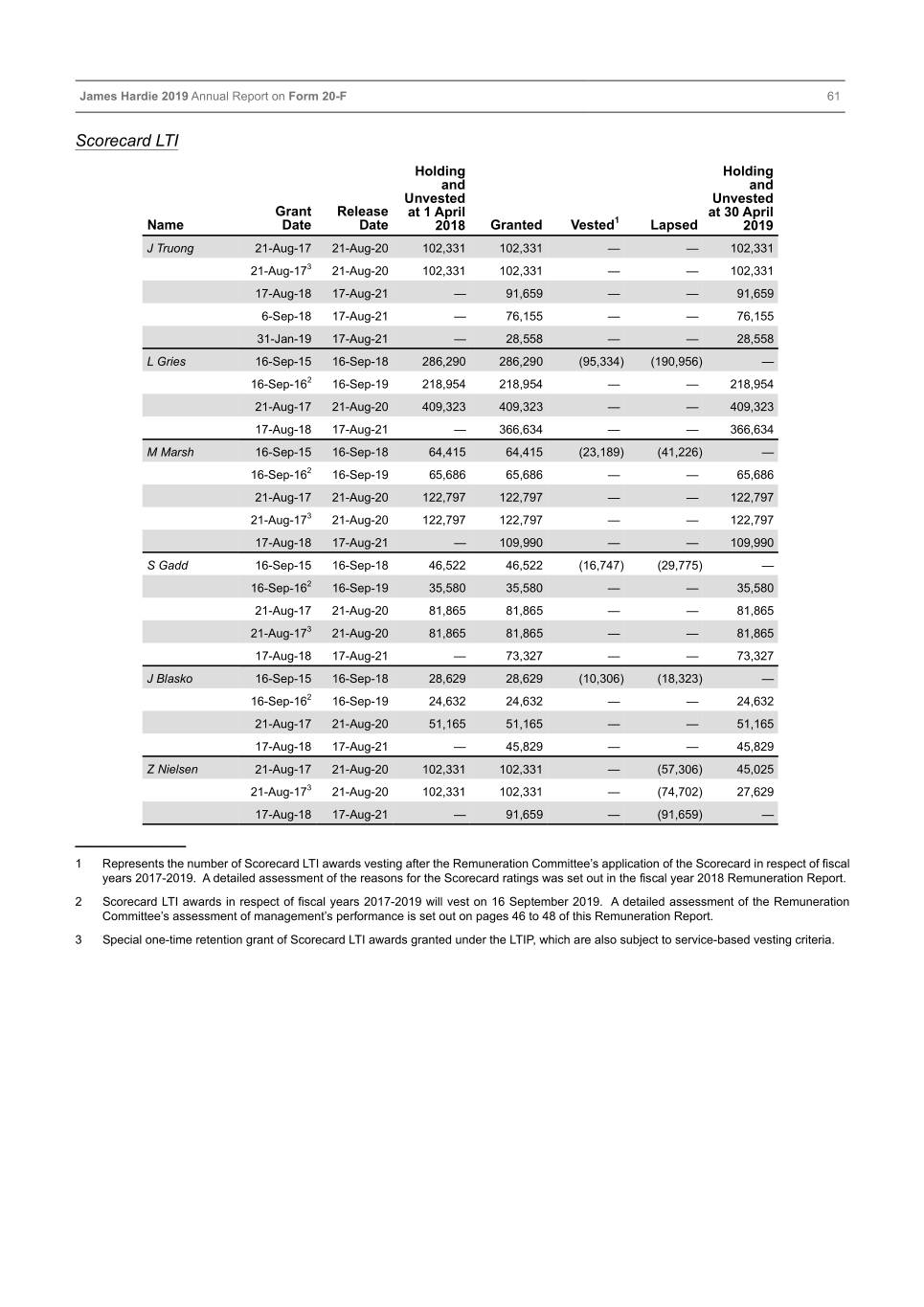
Table of Contents James Hardie 2019 Annual Report on Form 20-F 61 Scorecard LTI Holding Holding and and Unvested Unvested Grant Release at 1 April at 30 April Name Date Date 2018 Granted Vested1 Lapsed 2019 J Truong 21-Aug-17 21-Aug-20 102,331 102,331 — — 102,331 21-Aug-173 21-Aug-20 102,331 102,331 — — 102,331 17-Aug-18 17-Aug-21 — 91,659 — — 91,659 6-Sep-18 17-Aug-21 — 76,155 — — 76,155 31-Jan-19 17-Aug-21 — 28,558 — — 28,558 L Gries 16-Sep-15 16-Sep-18 286,290 286,290 (95,334) (190,956) — 16-Sep-162 16-Sep-19 218,954 218,954 — — 218,954 21-Aug-17 21-Aug-20 409,323 409,323 — — 409,323 17-Aug-18 17-Aug-21 — 366,634 — — 366,634 M Marsh 16-Sep-15 16-Sep-18 64,415 64,415 (23,189) (41,226) — 16-Sep-162 16-Sep-19 65,686 65,686 — — 65,686 21-Aug-17 21-Aug-20 122,797 122,797 — — 122,797 21-Aug-173 21-Aug-20 122,797 122,797 — — 122,797 17-Aug-18 17-Aug-21 — 109,990 — — 109,990 S Gadd 16-Sep-15 16-Sep-18 46,522 46,522 (16,747) (29,775) — 16-Sep-162 16-Sep-19 35,580 35,580 — — 35,580 21-Aug-17 21-Aug-20 81,865 81,865 — — 81,865 21-Aug-173 21-Aug-20 81,865 81,865 — — 81,865 17-Aug-18 17-Aug-21 — 73,327 — — 73,327 J Blasko 16-Sep-15 16-Sep-18 28,629 28,629 (10,306) (18,323) — 16-Sep-162 16-Sep-19 24,632 24,632 — — 24,632 21-Aug-17 21-Aug-20 51,165 51,165 — — 51,165 17-Aug-18 17-Aug-21 — 45,829 — — 45,829 Z Nielsen 21-Aug-17 21-Aug-20 102,331 102,331 — (57,306) 45,025 21-Aug-173 21-Aug-20 102,331 102,331 — (74,702) 27,629 17-Aug-18 17-Aug-21 — 91,659 — (91,659) — ____________ 1 Represents the number of Scorecard LTI awards vesting after the Remuneration Committee’s application of the Scorecard in respect of fiscal years 2017-2019. A detailed assessment of the reasons for the Scorecard ratings was set out in the fiscal year 2018 Remuneration Report. 2 Scorecard LTI awards in respect of fiscal years 2017-2019 will vest on 16 September 2019. A detailed assessment of the Remuneration Committee’s assessment of management’s performance is set out on pages 46 to 48 of this Remuneration Report. 3 Special one-time retention grant of Scorecard LTI awards granted under the LTIP, which are also subject to service-based vesting criteria.
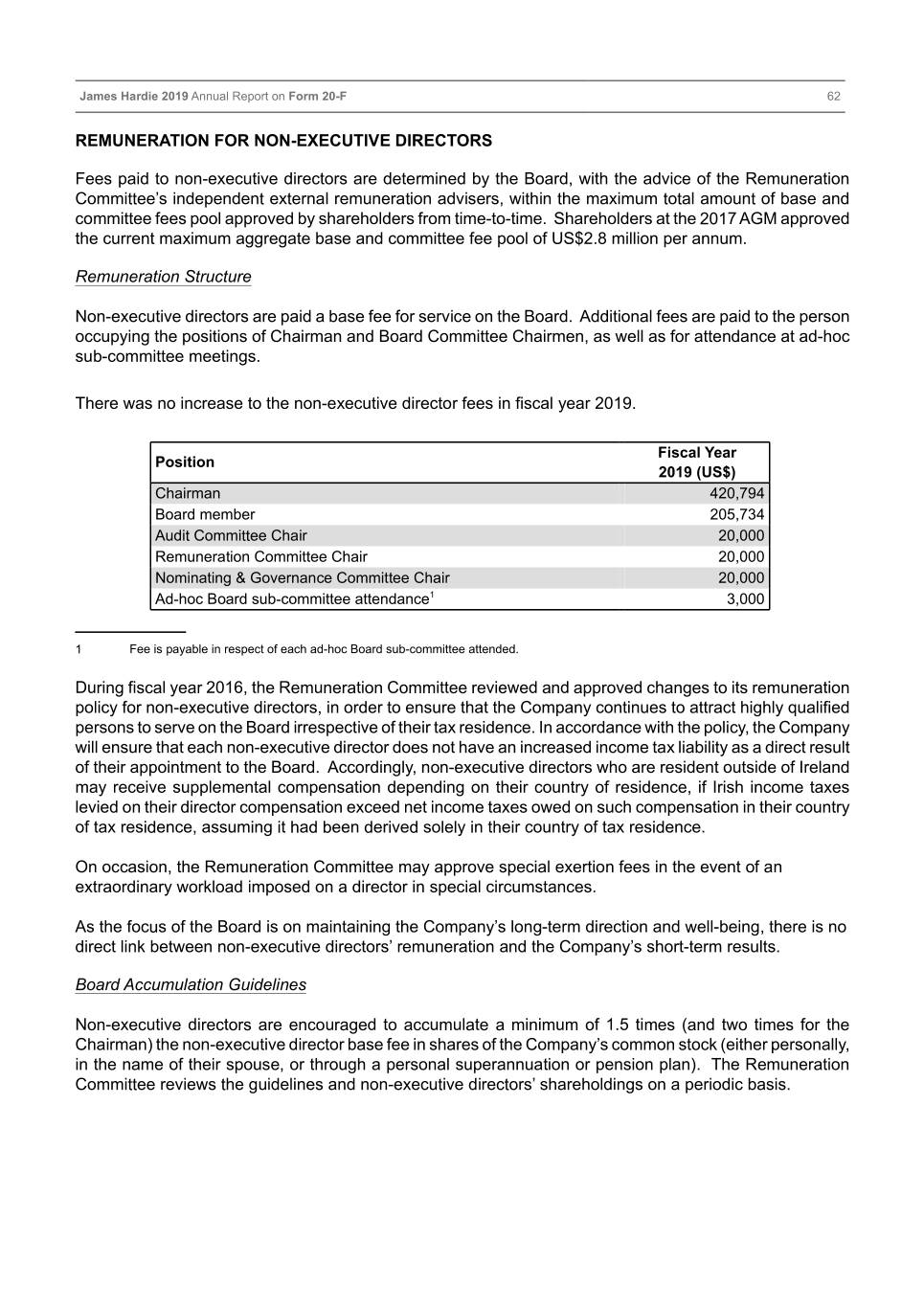
Table of Contents James Hardie 2019 Annual Report on Form 20-F 62 REMUNERATION FOR NON-EXECUTIVE DIRECTORS Fees paid to non-executive directors are determined by the Board, with the advice of the Remuneration Committee’s independent external remuneration advisers, within the maximum total amount of base and committee fees pool approved by shareholders from time-to-time. Shareholders at the 2017 AGM approved the current maximum aggregate base and committee fee pool of US$2.8 million per annum. Remuneration Structure Non-executive directors are paid a base fee for service on the Board. Additional fees are paid to the person occupying the positions of Chairman and Board Committee Chairmen, as well as for attendance at ad-hoc sub-committee meetings. There was no increase to the non-executive director fees in fiscal year 2019. Fiscal Year Position 2019 (US$) Chairman 420,794 Board member 205,734 Audit Committee Chair 20,000 Remuneration Committee Chair 20,000 Nominating & Governance Committee Chair 20,000 Ad-hoc Board sub-committee attendance1 3,000 ____________ 1 Fee is payable in respect of each ad-hoc Board sub-committee attended. During fiscal year 2016, the Remuneration Committee reviewed and approved changes to its remuneration policy for non-executive directors, in order to ensure that the Company continues to attract highly qualified persons to serve on the Board irrespective of their tax residence. In accordance with the policy, the Company will ensure that each non-executive director does not have an increased income tax liability as a direct result of their appointment to the Board. Accordingly, non-executive directors who are resident outside of Ireland may receive supplemental compensation depending on their country of residence, if Irish income taxes levied on their director compensation exceed net income taxes owed on such compensation in their country of tax residence, assuming it had been derived solely in their country of tax residence. On occasion, the Remuneration Committee may approve special exertion fees in the event of an extraordinary workload imposed on a director in special circumstances. As the focus of the Board is on maintaining the Company’s long-term direction and well-being, there is no direct link between non-executive directors’ remuneration and the Company’s short-term results. Board Accumulation Guidelines Non-executive directors are encouraged to accumulate a minimum of 1.5 times (and two times for the Chairman) the non-executive director base fee in shares of the Company’s common stock (either personally, in the name of their spouse, or through a personal superannuation or pension plan). The Remuneration Committee reviews the guidelines and non-executive directors’ shareholdings on a periodic basis.
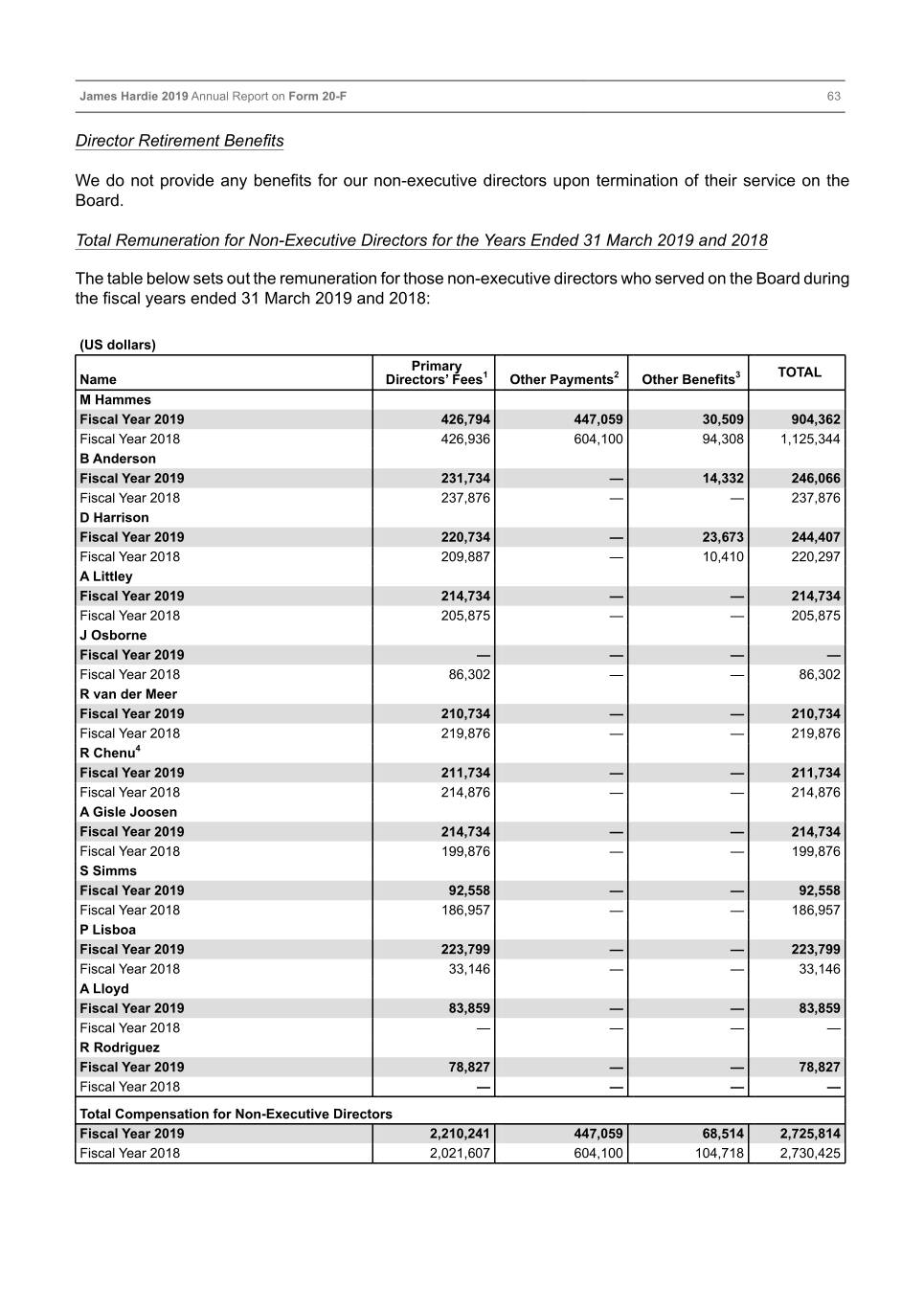
Table of Contents James Hardie 2019 Annual Report on Form 20-F 63 Director Retirement Benefits We do not provide any benefits for our non-executive directors upon termination of their service on the Board. Total Remuneration for Non-Executive Directors for the Years Ended 31 March 2019 and 2018 The table below sets out the remuneration for those non-executive directors who served on the Board during the fiscal years ended 31 March 2019 and 2018: (US dollars) Primary 1 2 3 TOTAL Name Directors’ Fees Other Payments Other Benefits M Hammes Fiscal Year 2019 426,794 447,059 30,509 904,362 Fiscal Year 2018 426,936 604,100 94,308 1,125,344 B Anderson Fiscal Year 2019 231,734 — 14,332 246,066 Fiscal Year 2018 237,876 — — 237,876 D Harrison Fiscal Year 2019 220,734 — 23,673 244,407 Fiscal Year 2018 209,887 — 10,410 220,297 A Littley Fiscal Year 2019 214,734 — — 214,734 Fiscal Year 2018 205,875 — — 205,875 J Osborne Fiscal Year 2019 — — — — Fiscal Year 2018 86,302 — — 86,302 R van der Meer Fiscal Year 2019 210,734 — — 210,734 Fiscal Year 2018 219,876 — — 219,876 R Chenu4 Fiscal Year 2019 211,734 — — 211,734 Fiscal Year 2018 214,876 — — 214,876 A Gisle Joosen Fiscal Year 2019 214,734 — — 214,734 Fiscal Year 2018 199,876 — — 199,876 S Simms Fiscal Year 2019 92,558 — — 92,558 Fiscal Year 2018 186,957 — — 186,957 P Lisboa Fiscal Year 2019 223,799 — — 223,799 Fiscal Year 2018 33,146 — — 33,146 A Lloyd Fiscal Year 2019 83,859 — — 83,859 Fiscal Year 2018 — — — — R Rodriguez Fiscal Year 2019 78,827 — — 78,827 Fiscal Year 2018 — — — — Total Compensation for Non-Executive Directors Fiscal Year 2019 2,210,241 447,059 68,514 2,725,814 Fiscal Year 2018 2,021,607 604,100 104,718 2,730,425
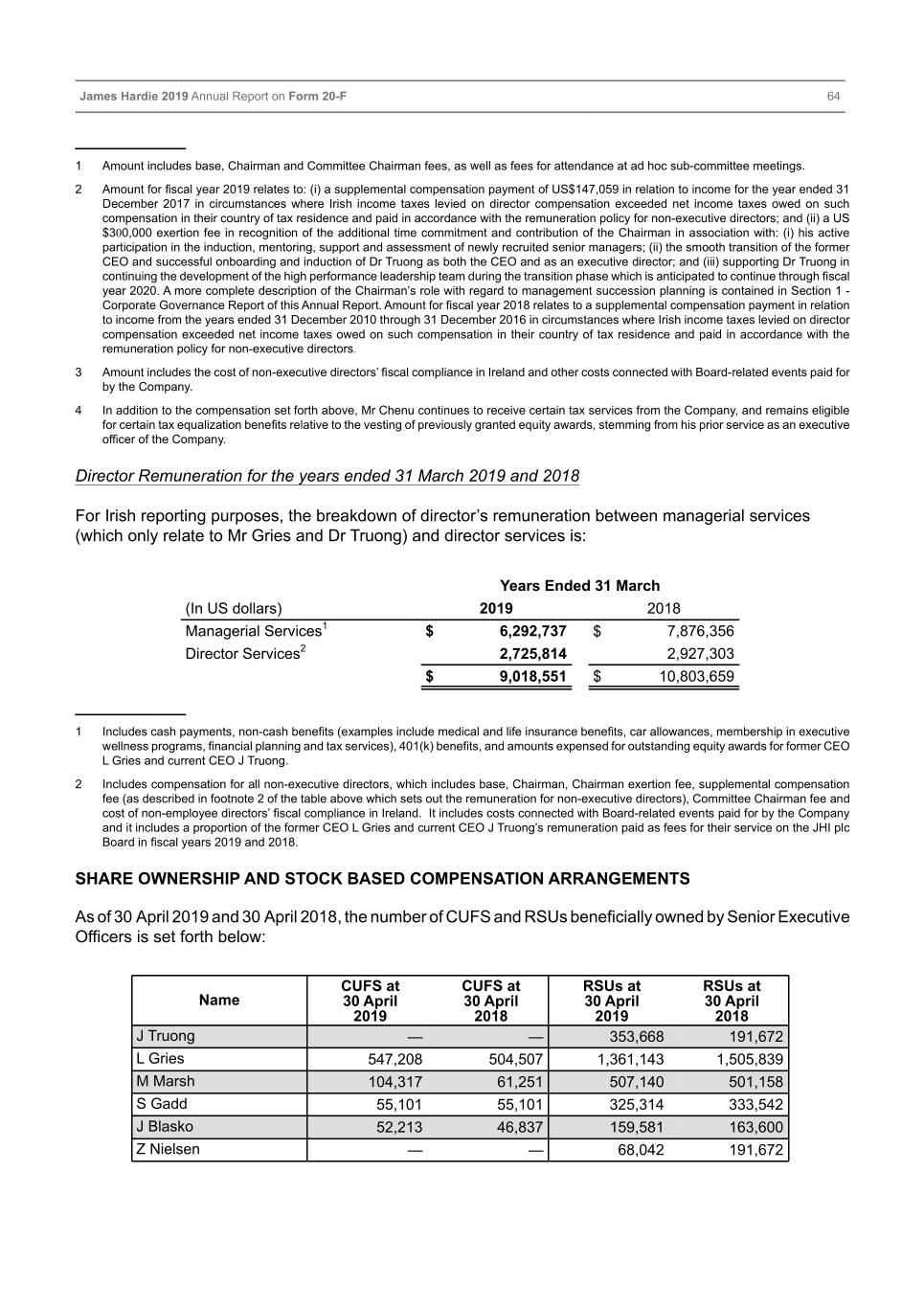
Table of Contents James Hardie 2019 Annual Report on Form 20-F 64 ____________ 1 Amount includes base, Chairman and Committee Chairman fees, as well as fees for attendance at ad hoc sub-committee meetings. 2 Amount for fiscal year 2019 relates to: (i) a supplemental compensation payment of US$147,059 in relation to income for the year ended 31 December 2017 in circumstances where Irish income taxes levied on director compensation exceeded net income taxes owed on such compensation in their country of tax residence and paid in accordance with the remuneration policy for non-executive directors; and (ii) a US $300,000 exertion fee in recognition of the additional time commitment and contribution of the Chairman in association with: (i) his active participation in the induction, mentoring, support and assessment of newly recruited senior managers; (ii) the smooth transition of the former CEO and successful onboarding and induction of Dr Truong as both the CEO and as an executive director; and (iii) supporting Dr Truong in continuing the development of the high performance leadership team during the transition phase which is anticipated to continue through fiscal year 2020. A more complete description of the Chairman’s role with regard to management succession planning is contained in Section 1 - Corporate Governance Report of this Annual Report. Amount for fiscal year 2018 relates to a supplemental compensation payment in relation to income from the years ended 31 December 2010 through 31 December 2016 in circumstances where Irish income taxes levied on director compensation exceeded net income taxes owed on such compensation in their country of tax residence and paid in accordance with the remuneration policy for non-executive directors. 3 Amount includes the cost of non-executive directors’ fiscal compliance in Ireland and other costs connected with Board-related events paid for by the Company. 4 In addition to the compensation set forth above, Mr Chenu continues to receive certain tax services from the Company, and remains eligible for certain tax equalization benefits relative to the vesting of previously granted equity awards, stemming from his prior service as an executive officer of the Company. Director Remuneration for the years ended 31 March 2019 and 2018 For Irish reporting purposes, the breakdown of director’s remuneration between managerial services (which only relate to Mr Gries and Dr Truong) and director services is: Years Ended 31 March (In US dollars) 2019 2018 Managerial Services1 $ 6,292,737 $ 7,876,356 Director Services2 2,725,814 2,927,303 $ 9,018,551 $ 10,803,659 ____________ 1 Includes cash payments, non-cash benefits (examples include medical and life insurance benefits, car allowances, membership in executive wellness programs, financial planning and tax services), 401(k) benefits, and amounts expensed for outstanding equity awards for former CEO L Gries and current CEO J Truong. 2 Includes compensation for all non-executive directors, which includes base, Chairman, Chairman exertion fee, supplemental compensation fee (as described in footnote 2 of the table above which sets out the remuneration for non-executive directors), Committee Chairman fee and cost of non-employee directors’ fiscal compliance in Ireland. It includes costs connected with Board-related events paid for by the Company and it includes a proportion of the former CEO L Gries and current CEO J Truong’s remuneration paid as fees for their service on the JHI plc Board in fiscal years 2019 and 2018. SHARE OWNERSHIP AND STOCK BASED COMPENSATION ARRANGEMENTS As of 30 April 2019 and 30 April 2018, the number of CUFS and RSUs beneficially owned by Senior Executive Officers is set forth below: CUFS at CUFS at RSUs at RSUs at Name 30 April 30 April 30 April 30 April 2019 2018 2019 2018 J Truong — — 353,668 191,672 L Gries 547,208 504,507 1,361,143 1,505,839 M Marsh 104,317 61,251 507,140 501,158 S Gadd 55,101 55,101 325,314 333,542 J Blasko 52,213 46,837 159,581 163,600 Z Nielsen — — 68,042 191,672

Table of Contents James Hardie 2019 Annual Report on Form 20-F 65 As of 30 April 2019 and 30 April 2018, the number of CUFS and RSUs beneficially owned by non-executive directors is set forth below: CUFS at CUFS at Name 30 April 30 April 2019 2018 M Hammes 1 44,109 44,109 B Anderson 2 18,920 18,920 R Chenu 105,518 105,518 A Gisle Joosen 3,420 2,480 D Harrison 3 19,259 19,259 P Lisboa 4 2,389 — A Littley 5 2,045 2,045 A Lloyd 6 18,000 — J Osborne 7 — — R Rodriguez — — S Simms 8 — — R van der Meer 17,290 17,290 ____________ 1 35,109 CUFS held in the name of Mr and Mrs Hammes and 9,000 CUFS held as American Depositary Shares (“ADSs”) in the name of Mr and Mrs Hammes. 2 7,635 CUFS held in the name of Mr Anderson, 390 CUFS held as ADSs in the name of Mr Anderson and 10,895 CUFS held as ADSs in the name of Mr and Mrs Anderson. 3 2,384 CUFS held in the name of Mr Harrison, 1,000 CUFS held as ADSs in the name of Mr Harrison and 15,875 CUFS held as ADSs in the name of Mr and Mrs Harrison. 4 2,389 CUFS held as ADSs in the name of Mr Lisboa. 5 2,045 CUFS held as ADSs in the name of Ms Littley. 6 18,000 CUFS held as ADSs in the name of Ms Lloyd. 7 Ceased to be a director on 18 August 2017. 8 Resigned from the Board on 24 August 2018. Based on 442,269,905 shares of common stock outstanding at 30 April 2019 (all of which are subject to CUFS), no director or Senior Executive Officer beneficially owned 1% or more of the outstanding shares of the Company at 30 April 2019 and none of the shares held by directors or Senior Executive Officers have any special voting rights. As of 30 April 2019, there were no options outstanding under any of the Company’s stock-based compensation arrangements. Individual’s holding RSUs have no voting or investment power over these units. Stock-Based Compensation Arrangements At 31 March 2019, we had the following equity award plans: • the LTIP; and • the 2001 Plan. LTIP The Company uses the LTIP as the plan for LTI grants to Senior Executive Officers and selected members of executive management. Participants in the LTIP receive grants of RSUs and Scorecard LTI, each of which is subject to performance goals. Participants and award levels are approved by the Remuneration Committee
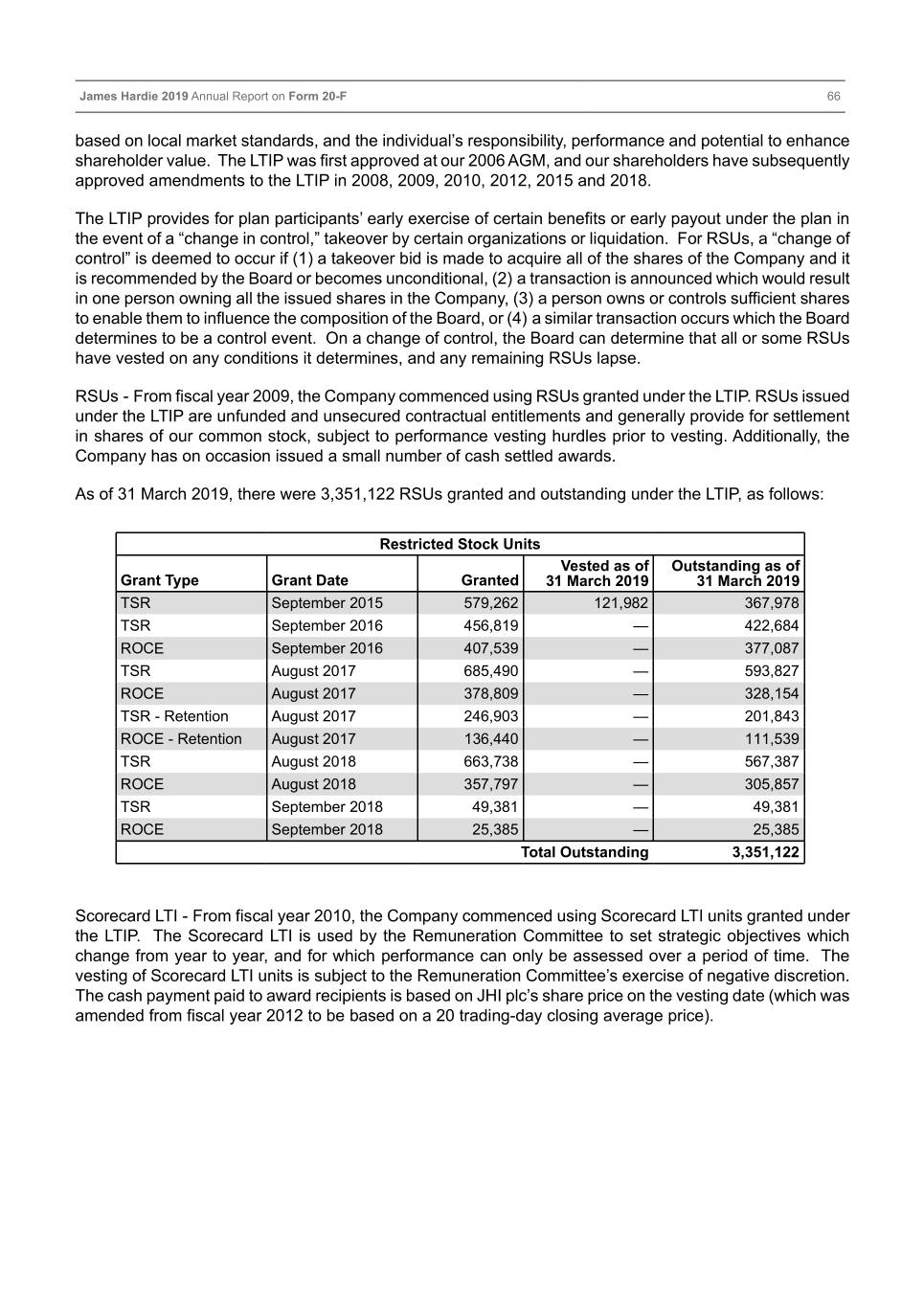
Table of Contents James Hardie 2019 Annual Report on Form 20-F 66 based on local market standards, and the individual’s responsibility, performance and potential to enhance shareholder value. The LTIP was first approved at our 2006 AGM, and our shareholders have subsequently approved amendments to the LTIP in 2008, 2009, 2010, 2012, 2015 and 2018. The LTIP provides for plan participants’ early exercise of certain benefits or early payout under the plan in the event of a “change in control,” takeover by certain organizations or liquidation. For RSUs, a “change of control” is deemed to occur if (1) a takeover bid is made to acquire all of the shares of the Company and it is recommended by the Board or becomes unconditional, (2) a transaction is announced which would result in one person owning all the issued shares in the Company, (3) a person owns or controls sufficient shares to enable them to influence the composition of the Board, or (4) a similar transaction occurs which the Board determines to be a control event. On a change of control, the Board can determine that all or some RSUs have vested on any conditions it determines, and any remaining RSUs lapse. RSUs - From fiscal year 2009, the Company commenced using RSUs granted under the LTIP. RSUs issued under the LTIP are unfunded and unsecured contractual entitlements and generally provide for settlement in shares of our common stock, subject to performance vesting hurdles prior to vesting. Additionally, the Company has on occasion issued a small number of cash settled awards. As of 31 March 2019, there were 3,351,122 RSUs granted and outstanding under the LTIP, as follows: Restricted Stock Units Vested as of Outstanding as of Grant Type Grant Date Granted 31 March 2019 31 March 2019 TSR September 2015 579,262 121,982 367,978 TSR September 2016 456,819 — 422,684 ROCE September 2016 407,539 — 377,087 TSR August 2017 685,490 — 593,827 ROCE August 2017 378,809 — 328,154 TSR - Retention August 2017 246,903 — 201,843 ROCE - Retention August 2017 136,440 — 111,539 TSR August 2018 663,738 — 567,387 ROCE August 2018 357,797 — 305,857 TSR September 2018 49,381 — 49,381 ROCE September 2018 25,385 — 25,385 Total Outstanding 3,351,122 Scorecard LTI - From fiscal year 2010, the Company commenced using Scorecard LTI units granted under the LTIP. The Scorecard LTI is used by the Remuneration Committee to set strategic objectives which change from year to year, and for which performance can only be assessed over a period of time. The vesting of Scorecard LTI units is subject to the Remuneration Committee’s exercise of negative discretion. The cash payment paid to award recipients is based on JHI plc’s share price on the vesting date (which was amended from fiscal year 2012 to be based on a 20 trading-day closing average price).
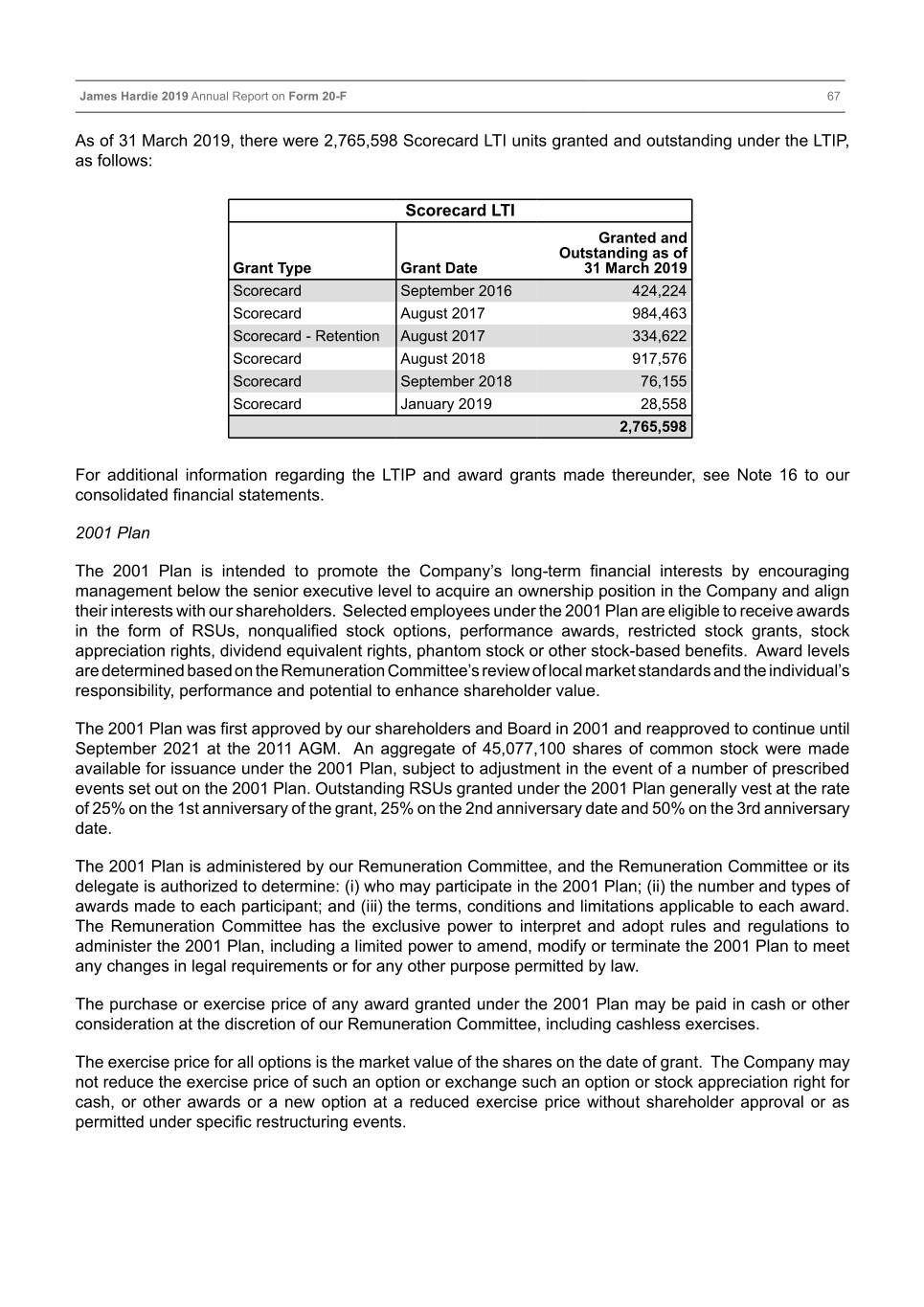
Table of Contents James Hardie 2019 Annual Report on Form 20-F 67 As of 31 March 2019, there were 2,765,598 Scorecard LTI units granted and outstanding under the LTIP, as follows: Scorecard LTI Granted and Outstanding as of Grant Type Grant Date 31 March 2019 Scorecard September 2016 424,224 Scorecard August 2017 984,463 Scorecard - Retention August 2017 334,622 Scorecard August 2018 917,576 Scorecard September 2018 76,155 Scorecard January 2019 28,558 2,765,598 For additional information regarding the LTIP and award grants made thereunder, see Note 16 to our consolidated financial statements. 2001 Plan The 2001 Plan is intended to promote the Company’s long-term financial interests by encouraging management below the senior executive level to acquire an ownership position in the Company and align their interests with our shareholders. Selected employees under the 2001 Plan are eligible to receive awards in the form of RSUs, nonqualified stock options, performance awards, restricted stock grants, stock appreciation rights, dividend equivalent rights, phantom stock or other stock-based benefits. Award levels are determined based on the Remuneration Committee’s review of local market standards and the individual’s responsibility, performance and potential to enhance shareholder value. The 2001 Plan was first approved by our shareholders and Board in 2001 and reapproved to continue until September 2021 at the 2011 AGM. An aggregate of 45,077,100 shares of common stock were made available for issuance under the 2001 Plan, subject to adjustment in the event of a number of prescribed events set out on the 2001 Plan. Outstanding RSUs granted under the 2001 Plan generally vest at the rate of 25% on the 1st anniversary of the grant, 25% on the 2nd anniversary date and 50% on the 3rd anniversary date. The 2001 Plan is administered by our Remuneration Committee, and the Remuneration Committee or its delegate is authorized to determine: (i) who may participate in the 2001 Plan; (ii) the number and types of awards made to each participant; and (iii) the terms, conditions and limitations applicable to each award. The Remuneration Committee has the exclusive power to interpret and adopt rules and regulations to administer the 2001 Plan, including a limited power to amend, modify or terminate the 2001 Plan to meet any changes in legal requirements or for any other purpose permitted by law. The purchase or exercise price of any award granted under the 2001 Plan may be paid in cash or other consideration at the discretion of our Remuneration Committee, including cashless exercises. The exercise price for all options is the market value of the shares on the date of grant. The Company may not reduce the exercise price of such an option or exchange such an option or stock appreciation right for cash, or other awards or a new option at a reduced exercise price without shareholder approval or as permitted under specific restructuring events.
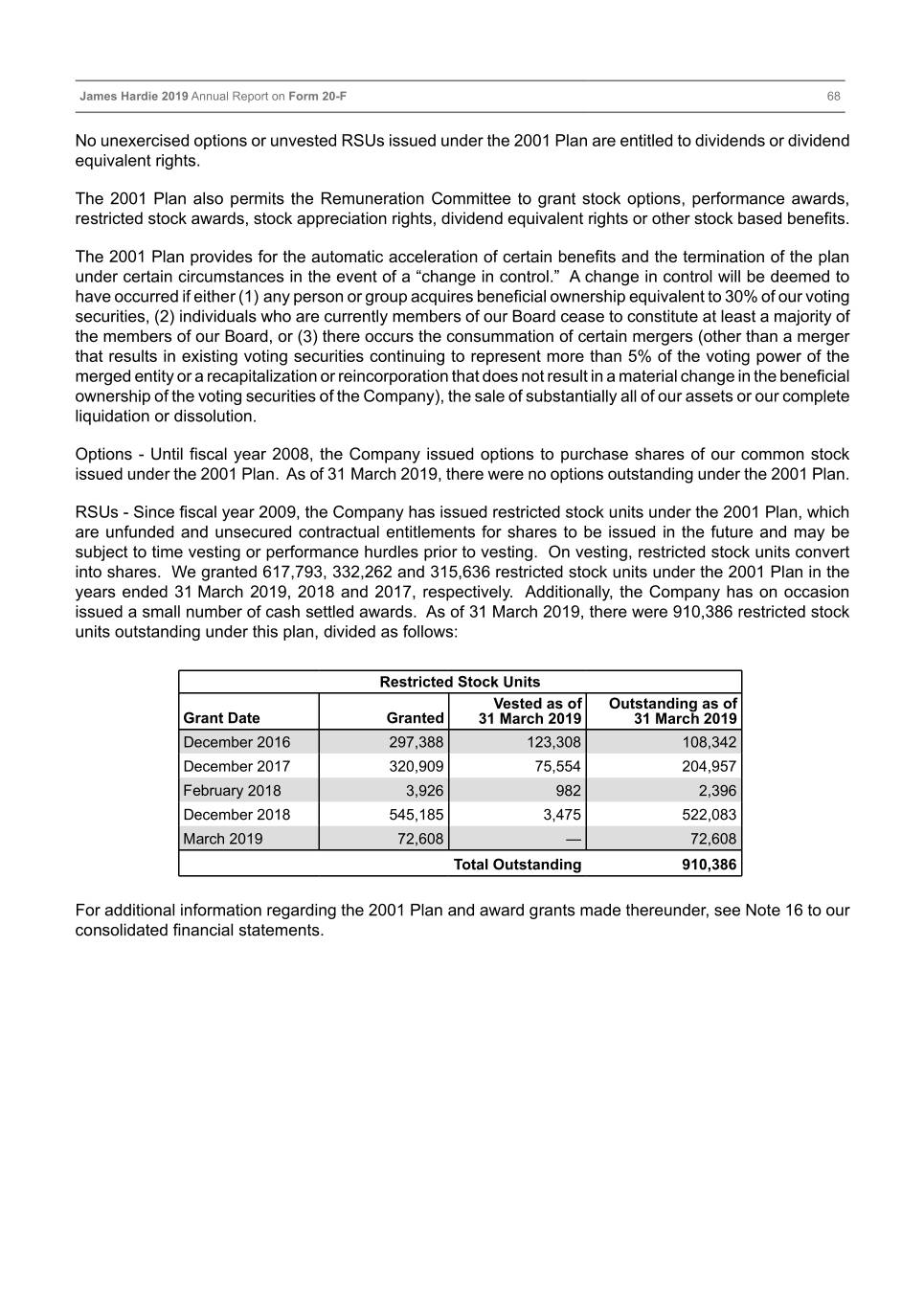
Table of Contents James Hardie 2019 Annual Report on Form 20-F 68 No unexercised options or unvested RSUs issued under the 2001 Plan are entitled to dividends or dividend equivalent rights. The 2001 Plan also permits the Remuneration Committee to grant stock options, performance awards, restricted stock awards, stock appreciation rights, dividend equivalent rights or other stock based benefits. The 2001 Plan provides for the automatic acceleration of certain benefits and the termination of the plan under certain circumstances in the event of a “change in control.” A change in control will be deemed to have occurred if either (1) any person or group acquires beneficial ownership equivalent to 30% of our voting securities, (2) individuals who are currently members of our Board cease to constitute at least a majority of the members of our Board, or (3) there occurs the consummation of certain mergers (other than a merger that results in existing voting securities continuing to represent more than 5% of the voting power of the merged entity or a recapitalization or reincorporation that does not result in a material change in the beneficial ownership of the voting securities of the Company), the sale of substantially all of our assets or our complete liquidation or dissolution. Options - Until fiscal year 2008, the Company issued options to purchase shares of our common stock issued under the 2001 Plan. As of 31 March 2019, there were no options outstanding under the 2001 Plan. RSUs - Since fiscal year 2009, the Company has issued restricted stock units under the 2001 Plan, which are unfunded and unsecured contractual entitlements for shares to be issued in the future and may be subject to time vesting or performance hurdles prior to vesting. On vesting, restricted stock units convert into shares. We granted 617,793, 332,262 and 315,636 restricted stock units under the 2001 Plan in the years ended 31 March 2019, 2018 and 2017, respectively. Additionally, the Company has on occasion issued a small number of cash settled awards. As of 31 March 2019, there were 910,386 restricted stock units outstanding under this plan, divided as follows: Restricted Stock Units Vested as of Outstanding as of Grant Date Granted 31 March 2019 31 March 2019 December 2016 297,388 123,308 108,342 December 2017 320,909 75,554 204,957 February 2018 3,926 982 2,396 December 2018 545,185 3,475 522,083 March 2019 72,608 — 72,608 Total Outstanding 910,386 For additional information regarding the 2001 Plan and award grants made thereunder, see Note 16 to our consolidated financial statements.
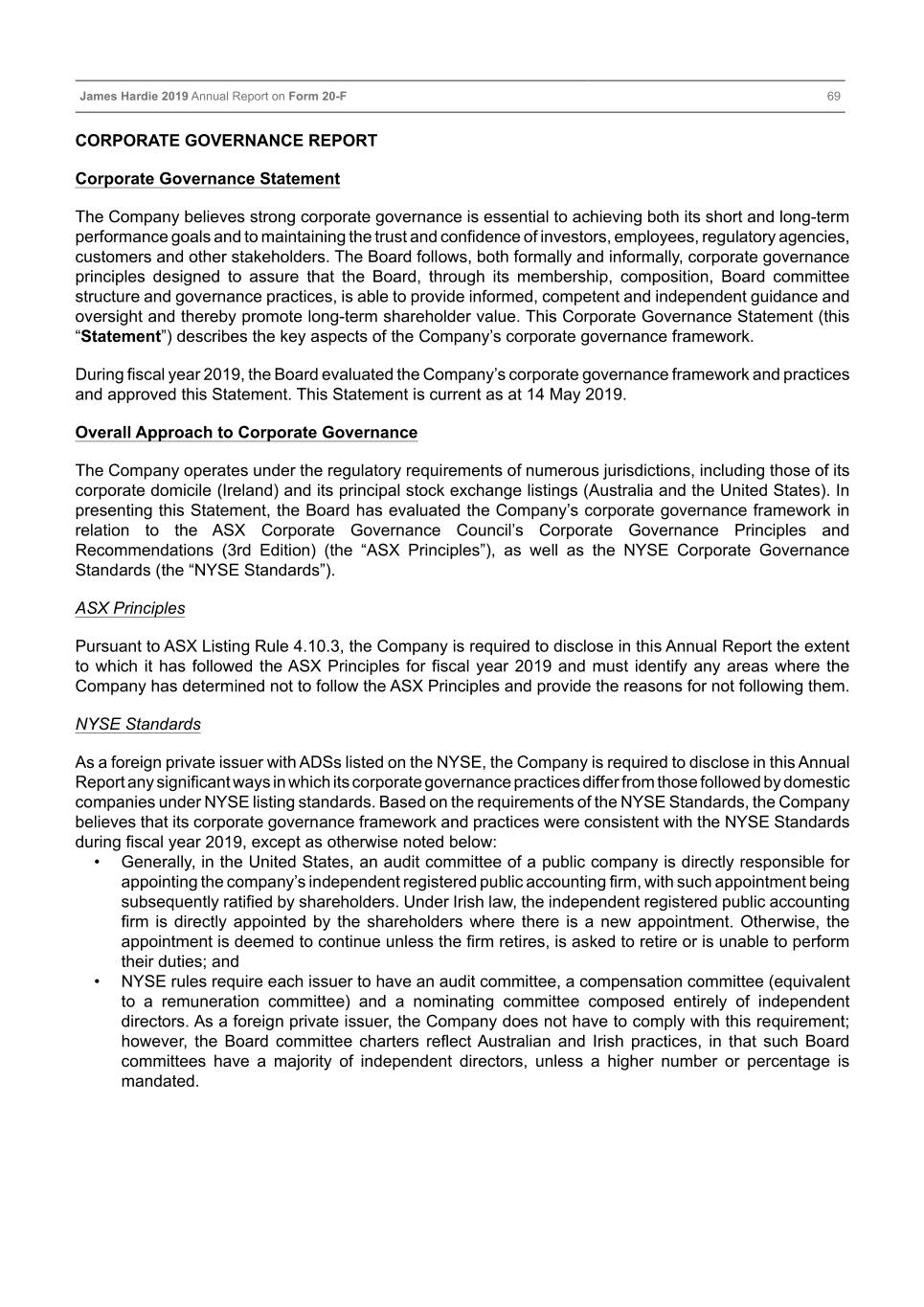
Table of Contents James Hardie 2019 Annual Report on Form 20-F 69 CORPORATE GOVERNANCE REPORT Corporate Governance Statement The Company believes strong corporate governance is essential to achieving both its short and long-term performance goals and to maintaining the trust and confidence of investors, employees, regulatory agencies, customers and other stakeholders. The Board follows, both formally and informally, corporate governance principles designed to assure that the Board, through its membership, composition, Board committee structure and governance practices, is able to provide informed, competent and independent guidance and oversight and thereby promote long-term shareholder value. This Corporate Governance Statement (this “Statement”) describes the key aspects of the Company’s corporate governance framework. During fiscal year 2019, the Board evaluated the Company’s corporate governance framework and practices and approved this Statement. This Statement is current as at 14 May 2019. Overall Approach to Corporate Governance The Company operates under the regulatory requirements of numerous jurisdictions, including those of its corporate domicile (Ireland) and its principal stock exchange listings (Australia and the United States). In presenting this Statement, the Board has evaluated the Company’s corporate governance framework in relation to the ASX Corporate Governance Council’s Corporate Governance Principles and Recommendations (3rd Edition) (the “ASX Principles”), as well as the NYSE Corporate Governance Standards (the “NYSE Standards”). ASX Principles Pursuant to ASX Listing Rule 4.10.3, the Company is required to disclose in this Annual Report the extent to which it has followed the ASX Principles for fiscal year 2019 and must identify any areas where the Company has determined not to follow the ASX Principles and provide the reasons for not following them. NYSE Standards As a foreign private issuer with ADSs listed on the NYSE, the Company is required to disclose in this Annual Report any significant ways in which its corporate governance practices differ from those followed by domestic companies under NYSE listing standards. Based on the requirements of the NYSE Standards, the Company believes that its corporate governance framework and practices were consistent with the NYSE Standards during fiscal year 2019, except as otherwise noted below: • Generally, in the United States, an audit committee of a public company is directly responsible for appointing the company’s independent registered public accounting firm, with such appointment being subsequently ratified by shareholders. Under Irish law, the independent registered public accounting firm is directly appointed by the shareholders where there is a new appointment. Otherwise, the appointment is deemed to continue unless the firm retires, is asked to retire or is unable to perform their duties; and • NYSE rules require each issuer to have an audit committee, a compensation committee (equivalent to a remuneration committee) and a nominating committee composed entirely of independent directors. As a foreign private issuer, the Company does not have to comply with this requirement; however, the Board committee charters reflect Australian and Irish practices, in that such Board committees have a majority of independent directors, unless a higher number or percentage is mandated.
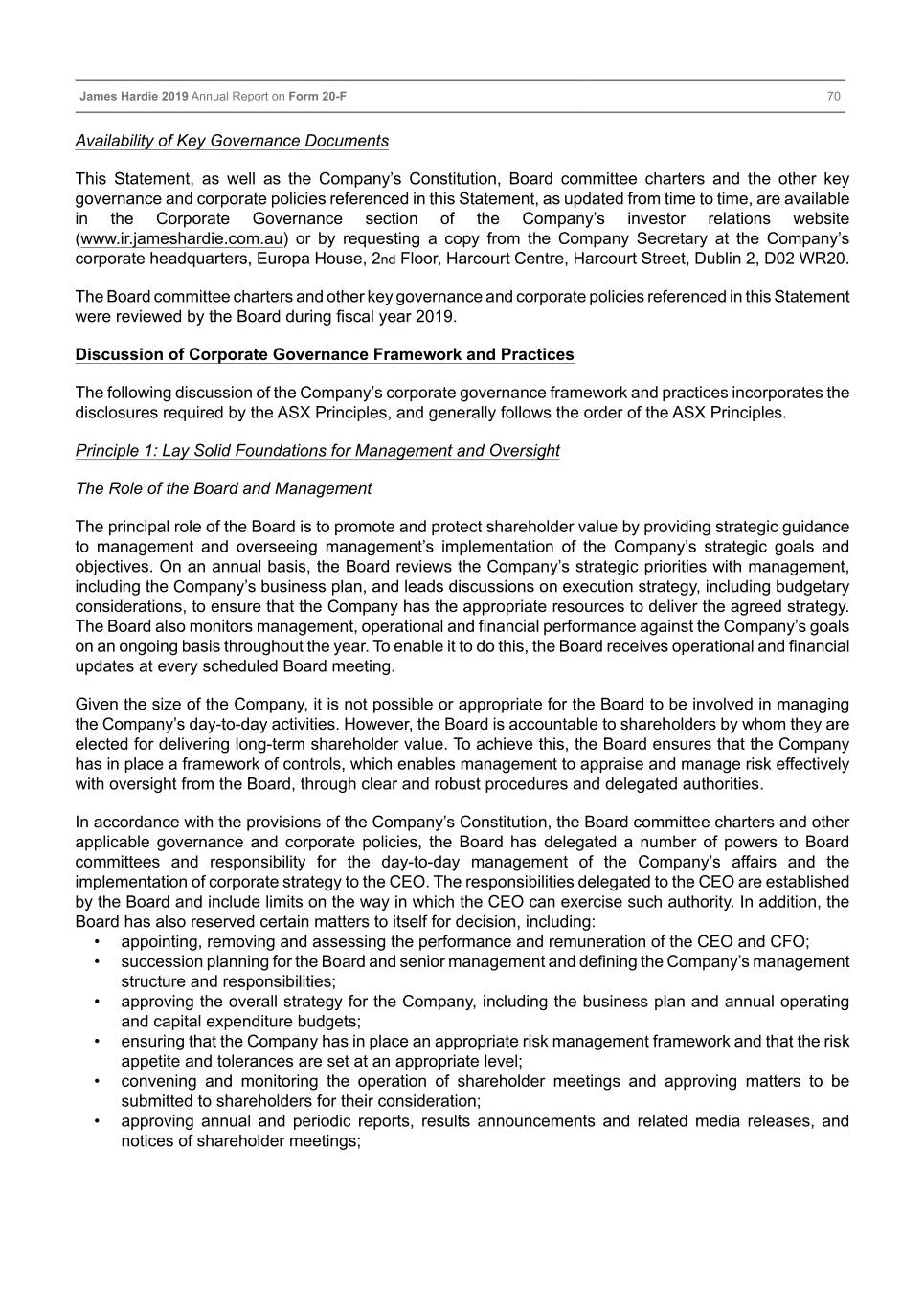
Table of Contents James Hardie 2019 Annual Report on Form 20-F 70 Availability of Key Governance Documents This Statement, as well as the Company’s Constitution, Board committee charters and the other key governance and corporate policies referenced in this Statement, as updated from time to time, are available in the Corporate Governance section of the Company’s investor relations website (www.ir.jameshardie.com.au) or by requesting a copy from the Company Secretary at the Company’s corporate headquarters, Europa House, 2nd Floor, Harcourt Centre, Harcourt Street, Dublin 2, D02 WR20. The Board committee charters and other key governance and corporate policies referenced in this Statement were reviewed by the Board during fiscal year 2019. Discussion of Corporate Governance Framework and Practices The following discussion of the Company’s corporate governance framework and practices incorporates the disclosures required by the ASX Principles, and generally follows the order of the ASX Principles. Principle 1: Lay Solid Foundations for Management and Oversight The Role of the Board and Management The principal role of the Board is to promote and protect shareholder value by providing strategic guidance to management and overseeing management’s implementation of the Company’s strategic goals and objectives. On an annual basis, the Board reviews the Company’s strategic priorities with management, including the Company’s business plan, and leads discussions on execution strategy, including budgetary considerations, to ensure that the Company has the appropriate resources to deliver the agreed strategy. The Board also monitors management, operational and financial performance against the Company’s goals on an ongoing basis throughout the year. To enable it to do this, the Board receives operational and financial updates at every scheduled Board meeting. Given the size of the Company, it is not possible or appropriate for the Board to be involved in managing the Company’s day-to-day activities. However, the Board is accountable to shareholders by whom they are elected for delivering long-term shareholder value. To achieve this, the Board ensures that the Company has in place a framework of controls, which enables management to appraise and manage risk effectively with oversight from the Board, through clear and robust procedures and delegated authorities. In accordance with the provisions of the Company’s Constitution, the Board committee charters and other applicable governance and corporate policies, the Board has delegated a number of powers to Board committees and responsibility for the day-to-day management of the Company’s affairs and the implementation of corporate strategy to the CEO. The responsibilities delegated to the CEO are established by the Board and include limits on the way in which the CEO can exercise such authority. In addition, the Board has also reserved certain matters to itself for decision, including: • appointing, removing and assessing the performance and remuneration of the CEO and CFO; • succession planning for the Board and senior management and defining the Company’s management structure and responsibilities; • approving the overall strategy for the Company, including the business plan and annual operating and capital expenditure budgets; • ensuring that the Company has in place an appropriate risk management framework and that the risk appetite and tolerances are set at an appropriate level; • convening and monitoring the operation of shareholder meetings and approving matters to be submitted to shareholders for their consideration; • approving annual and periodic reports, results announcements and related media releases, and notices of shareholder meetings;
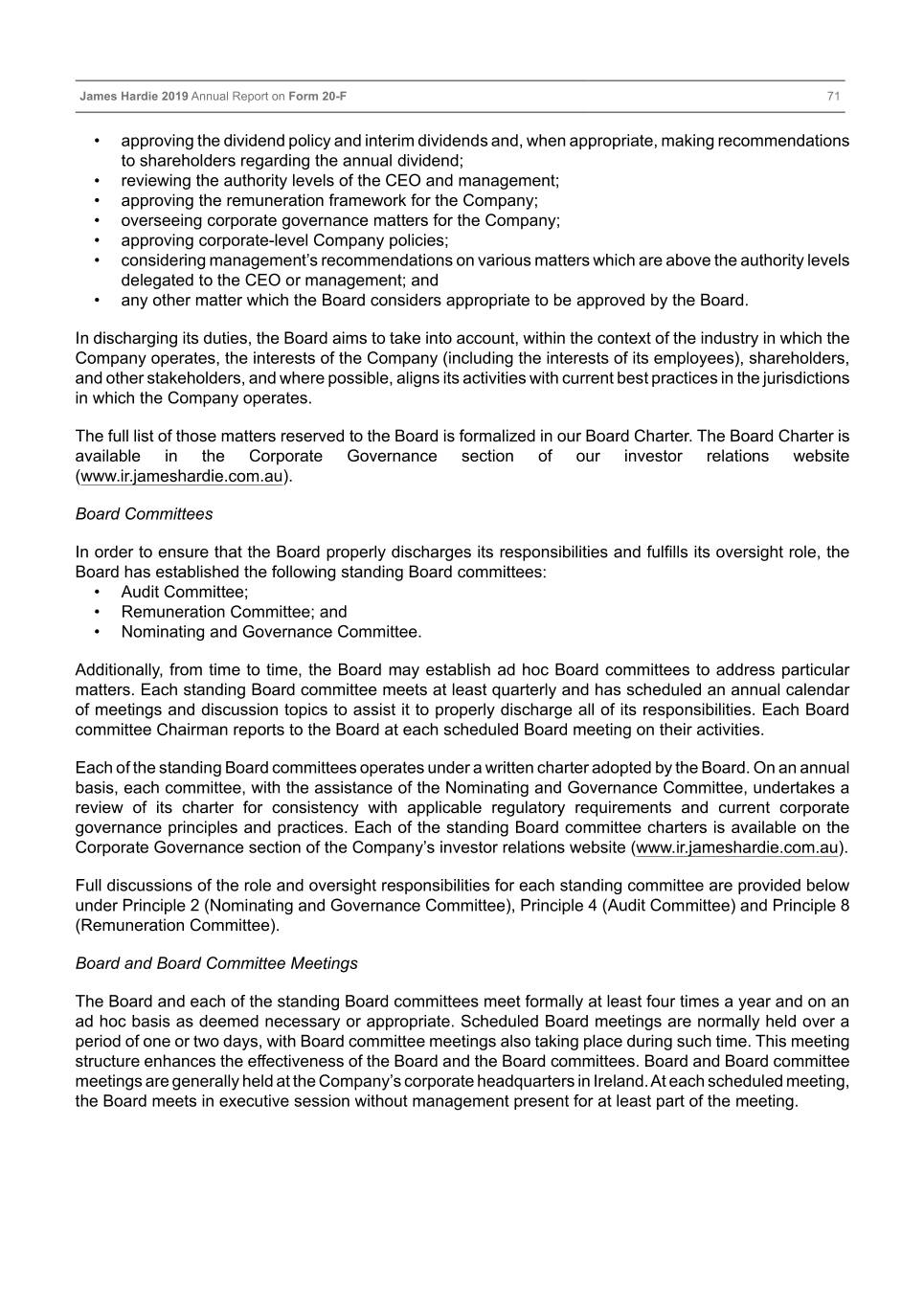
Table of Contents James Hardie 2019 Annual Report on Form 20-F 71 • approving the dividend policy and interim dividends and, when appropriate, making recommendations to shareholders regarding the annual dividend; • reviewing the authority levels of the CEO and management; • approving the remuneration framework for the Company; • overseeing corporate governance matters for the Company; • approving corporate-level Company policies; • considering management’s recommendations on various matters which are above the authority levels delegated to the CEO or management; and • any other matter which the Board considers appropriate to be approved by the Board. In discharging its duties, the Board aims to take into account, within the context of the industry in which the Company operates, the interests of the Company (including the interests of its employees), shareholders, and other stakeholders, and where possible, aligns its activities with current best practices in the jurisdictions in which the Company operates. The full list of those matters reserved to the Board is formalized in our Board Charter. The Board Charter is available in the Corporate Governance section of our investor relations website (www.ir.jameshardie.com.au). Board Committees In order to ensure that the Board properly discharges its responsibilities and fulfills its oversight role, the Board has established the following standing Board committees: • Audit Committee; • Remuneration Committee; and • Nominating and Governance Committee. Additionally, from time to time, the Board may establish ad hoc Board committees to address particular matters. Each standing Board committee meets at least quarterly and has scheduled an annual calendar of meetings and discussion topics to assist it to properly discharge all of its responsibilities. Each Board committee Chairman reports to the Board at each scheduled Board meeting on their activities. Each of the standing Board committees operates under a written charter adopted by the Board. On an annual basis, each committee, with the assistance of the Nominating and Governance Committee, undertakes a review of its charter for consistency with applicable regulatory requirements and current corporate governance principles and practices. Each of the standing Board committee charters is available on the Corporate Governance section of the Company’s investor relations website (www.ir.jameshardie.com.au). Full discussions of the role and oversight responsibilities for each standing committee are provided below under Principle 2 (Nominating and Governance Committee), Principle 4 (Audit Committee) and Principle 8 (Remuneration Committee). Board and Board Committee Meetings The Board and each of the standing Board committees meet formally at least four times a year and on an ad hoc basis as deemed necessary or appropriate. Scheduled Board meetings are normally held over a period of one or two days, with Board committee meetings also taking place during such time. This meeting structure enhances the effectiveness of the Board and the Board committees. Board and Board committee meetings are generally held at the Company’s corporate headquarters in Ireland. At each scheduled meeting, the Board meets in executive session without management present for at least part of the meeting.
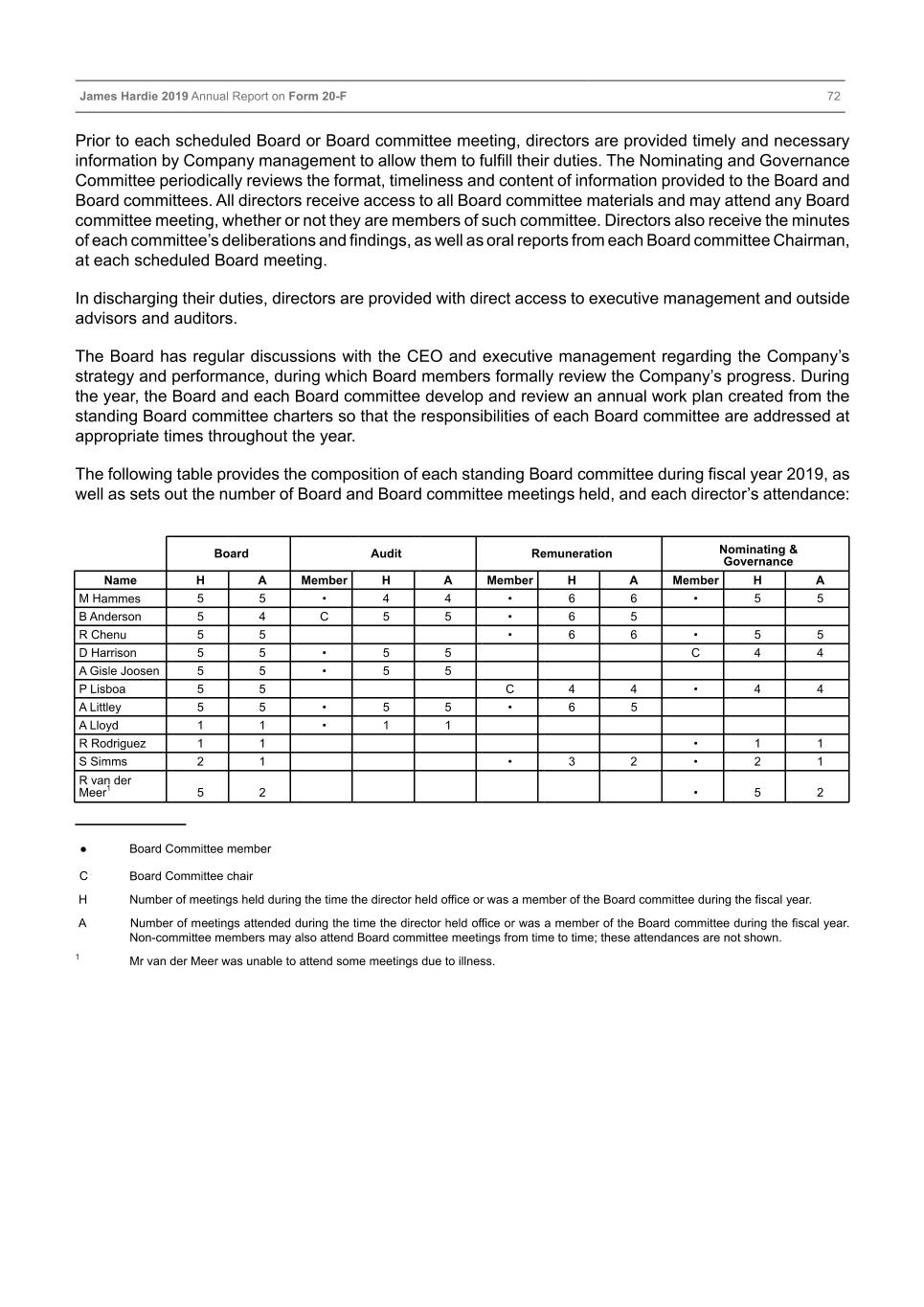
Table of Contents James Hardie 2019 Annual Report on Form 20-F 72 Prior to each scheduled Board or Board committee meeting, directors are provided timely and necessary information by Company management to allow them to fulfill their duties. The Nominating and Governance Committee periodically reviews the format, timeliness and content of information provided to the Board and Board committees. All directors receive access to all Board committee materials and may attend any Board committee meeting, whether or not they are members of such committee. Directors also receive the minutes of each committee’s deliberations and findings, as well as oral reports from each Board committee Chairman, at each scheduled Board meeting. In discharging their duties, directors are provided with direct access to executive management and outside advisors and auditors. The Board has regular discussions with the CEO and executive management regarding the Company’s strategy and performance, during which Board members formally review the Company’s progress. During the year, the Board and each Board committee develop and review an annual work plan created from the standing Board committee charters so that the responsibilities of each Board committee are addressed at appropriate times throughout the year. The following table provides the composition of each standing Board committee during fiscal year 2019, as well as sets out the number of Board and Board committee meetings held, and each director’s attendance: Board Audit Remuneration Nominating & Governance Name H A Member H A Member H A Member H A M Hammes 5 5 • 4 4 • 6 6 • 5 5 B Anderson 5 4 C 5 5 • 6 5 R Chenu 55 •66•55 D Harrison 55•55 C4 4 A Gisle Joosen 5 5 • 5 5 P Lisboa 55 C44•44 A Littley 55•55•65 A Lloyd 11•11 R Rodriguez 1 1 •11 S Simms 21 •32•21 R van der Meer1 52 •52 ____________ ● Board Committee member C Board Committee chair H Number of meetings held during the time the director held office or was a member of the Board committee during the fiscal year. A Number of meetings attended during the time the director held office or was a member of the Board committee during the fiscal year. Non-committee members may also attend Board committee meetings from time to time; these attendances are not shown. 1 Mr van der Meer was unable to attend some meetings due to illness.
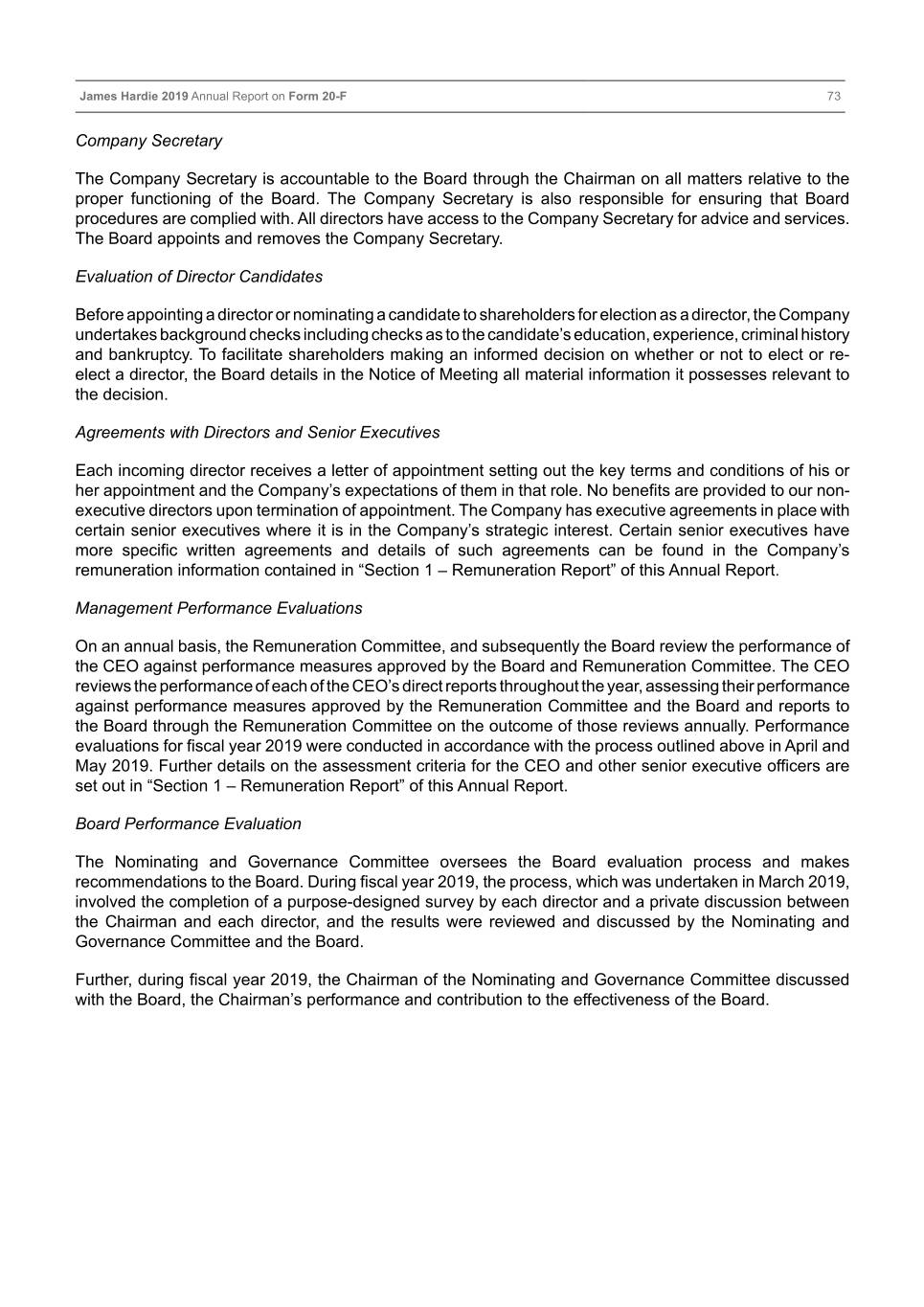
Table of Contents James Hardie 2019 Annual Report on Form 20-F 73 Company Secretary The Company Secretary is accountable to the Board through the Chairman on all matters relative to the proper functioning of the Board. The Company Secretary is also responsible for ensuring that Board procedures are complied with. All directors have access to the Company Secretary for advice and services. The Board appoints and removes the Company Secretary. Evaluation of Director Candidates Before appointing a director or nominating a candidate to shareholders for election as a director, the Company undertakes background checks including checks as to the candidate’s education, experience, criminal history and bankruptcy. To facilitate shareholders making an informed decision on whether or not to elect or re- elect a director, the Board details in the Notice of Meeting all material information it possesses relevant to the decision. Agreements with Directors and Senior Executives Each incoming director receives a letter of appointment setting out the key terms and conditions of his or her appointment and the Company’s expectations of them in that role. No benefits are provided to our non- executive directors upon termination of appointment. The Company has executive agreements in place with certain senior executives where it is in the Company’s strategic interest. Certain senior executives have more specific written agreements and details of such agreements can be found in the Company’s remuneration information contained in “Section 1 – Remuneration Report” of this Annual Report. Management Performance Evaluations On an annual basis, the Remuneration Committee, and subsequently the Board review the performance of the CEO against performance measures approved by the Board and Remuneration Committee. The CEO reviews the performance of each of the CEO’s direct reports throughout the year, assessing their performance against performance measures approved by the Remuneration Committee and the Board and reports to the Board through the Remuneration Committee on the outcome of those reviews annually. Performance evaluations for fiscal year 2019 were conducted in accordance with the process outlined above in April and May 2019. Further details on the assessment criteria for the CEO and other senior executive officers are set out in “Section 1 – Remuneration Report” of this Annual Report. Board Performance Evaluation The Nominating and Governance Committee oversees the Board evaluation process and makes recommendations to the Board. During fiscal year 2019, the process, which was undertaken in March 2019, involved the completion of a purpose-designed survey by each director and a private discussion between the Chairman and each director, and the results were reviewed and discussed by the Nominating and Governance Committee and the Board. Further, during fiscal year 2019, the Chairman of the Nominating and Governance Committee discussed with the Board, the Chairman’s performance and contribution to the effectiveness of the Board.
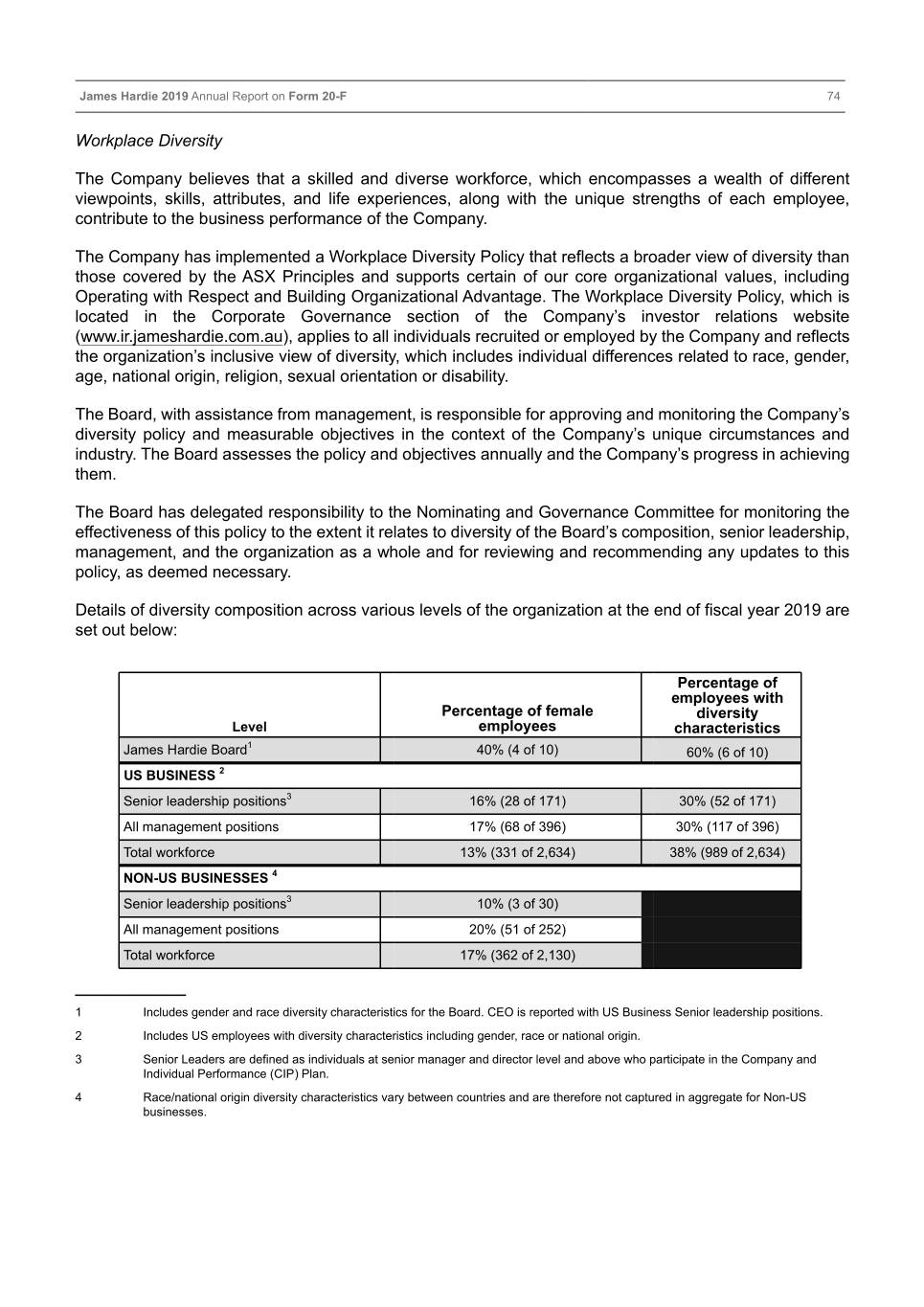
Table of Contents James Hardie 2019 Annual Report on Form 20-F 74 Workplace Diversity The Company believes that a skilled and diverse workforce, which encompasses a wealth of different viewpoints, skills, attributes, and life experiences, along with the unique strengths of each employee, contribute to the business performance of the Company. The Company has implemented a Workplace Diversity Policy that reflects a broader view of diversity than those covered by the ASX Principles and supports certain of our core organizational values, including Operating with Respect and Building Organizational Advantage. The Workplace Diversity Policy, which is located in the Corporate Governance section of the Company’s investor relations website (www.ir.jameshardie.com.au), applies to all individuals recruited or employed by the Company and reflects the organization’s inclusive view of diversity, which includes individual differences related to race, gender, age, national origin, religion, sexual orientation or disability. The Board, with assistance from management, is responsible for approving and monitoring the Company’s diversity policy and measurable objectives in the context of the Company’s unique circumstances and industry. The Board assesses the policy and objectives annually and the Company’s progress in achieving them. The Board has delegated responsibility to the Nominating and Governance Committee for monitoring the effectiveness of this policy to the extent it relates to diversity of the Board’s composition, senior leadership, management, and the organization as a whole and for reviewing and recommending any updates to this policy, as deemed necessary. Details of diversity composition across various levels of the organization at the end of fiscal year 2019 are set out below: Percentage of employees with Percentage of female diversity Level employees characteristics 1 James Hardie Board 40% (4 of 10) 60% (6 of 10) US BUSINESS 2 Senior leadership positions3 16% (28 of 171) 30% (52 of 171) All management positions 17% (68 of 396) 30% (117 of 396) Total workforce 13% (331 of 2,634) 38% (989 of 2,634) NON-US BUSINESSES 4 Senior leadership positions3 10% (3 of 30) All management positions 20% (51 of 252) Total workforce 17% (362 of 2,130) ____________ 1 Includes gender and race diversity characteristics for the Board. CEO is reported with US Business Senior leadership positions. 2 Includes US employees with diversity characteristics including gender, race or national origin. 3 Senior Leaders are defined as individuals at senior manager and director level and above who participate in the Company and Individual Performance (CIP) Plan. 4 Race/national origin diversity characteristics vary between countries and are therefore not captured in aggregate for Non-US businesses.
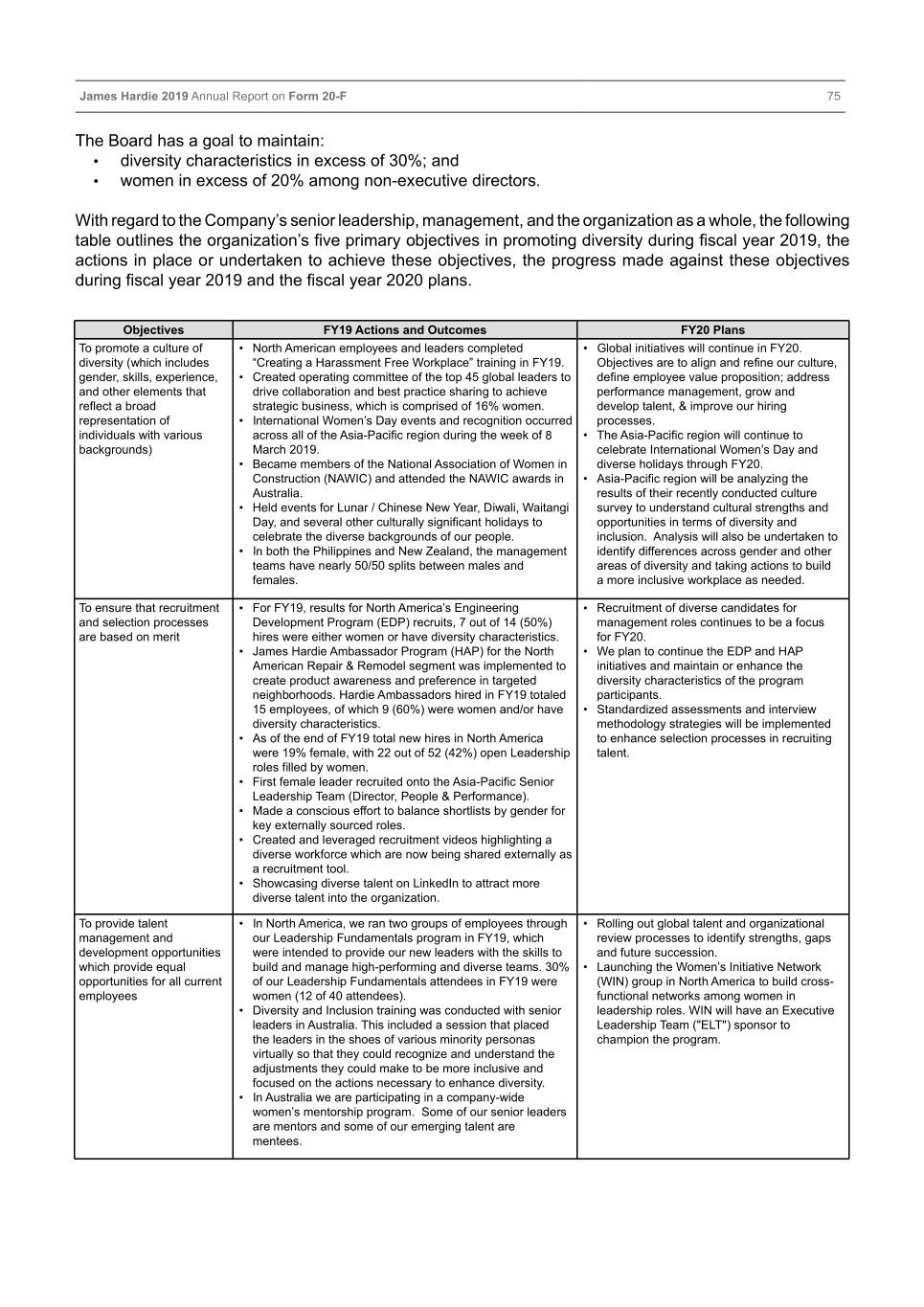
Table of Contents James Hardie 2019 Annual Report on Form 20-F 75 The Board has a goal to maintain: • diversity characteristics in excess of 30%; and • women in excess of 20% among non-executive directors. With regard to the Company’s senior leadership, management, and the organization as a whole, the following table outlines the organization’s five primary objectives in promoting diversity during fiscal year 2019, the actions in place or undertaken to achieve these objectives, the progress made against these objectives during fiscal year 2019 and the fiscal year 2020 plans. Objectives FY19 Actions and Outcomes FY20 Plans To promote a culture of • North American employees and leaders completed • Global initiatives will continue in FY20. diversity (which includes “Creating a Harassment Free Workplace” training in FY19. Objectives are to align and refine our culture, gender, skills, experience, • Created operating committee of the top 45 global leaders to define employee value proposition; address and other elements that drive collaboration and best practice sharing to achieve performance management, grow and reflect a broad strategic business, which is comprised of 16% women. develop talent, & improve our hiring representation of • International Women’s Day events and recognition occurred processes. individuals with various across all of the Asia-Pacific region during the week of 8 • The Asia-Pacific region will continue to backgrounds) March 2019. celebrate International Women’s Day and • Became members of the National Association of Women in diverse holidays through FY20. Construction (NAWIC) and attended the NAWIC awards in • Asia-Pacific region will be analyzing the Australia. results of their recently conducted culture • Held events for Lunar / Chinese New Year, Diwali, Waitangi survey to understand cultural strengths and Day, and several other culturally significant holidays to opportunities in terms of diversity and celebrate the diverse backgrounds of our people. inclusion. Analysis will also be undertaken to • In both the Philippines and New Zealand, the management identify differences across gender and other teams have nearly 50/50 splits between males and areas of diversity and taking actions to build females. a more inclusive workplace as needed. To ensure that recruitment • For FY19, results for North America’s Engineering • Recruitment of diverse candidates for and selection processes Development Program (EDP) recruits, 7 out of 14 (50%) management roles continues to be a focus are based on merit hires were either women or have diversity characteristics. for FY20. • James Hardie Ambassador Program (HAP) for the North • We plan to continue the EDP and HAP American Repair & Remodel segment was implemented to initiatives and maintain or enhance the create product awareness and preference in targeted diversity characteristics of the program neighborhoods. Hardie Ambassadors hired in FY19 totaled participants. 15 employees, of which 9 (60%) were women and/or have • Standardized assessments and interview diversity characteristics. methodology strategies will be implemented • As of the end of FY19 total new hires in North America to enhance selection processes in recruiting were 19% female, with 22 out of 52 (42%) open Leadership talent. roles filled by women. • First female leader recruited onto the Asia-Pacific Senior Leadership Team (Director, People & Performance). • Made a conscious effort to balance shortlists by gender for key externally sourced roles. • Created and leveraged recruitment videos highlighting a diverse workforce which are now being shared externally as a recruitment tool. • Showcasing diverse talent on LinkedIn to attract more diverse talent into the organization. To provide talent • In North America, we ran two groups of employees through • Rolling out global talent and organizational management and our Leadership Fundamentals program in FY19, which review processes to identify strengths, gaps development opportunities were intended to provide our new leaders with the skills to and future succession. which provide equal build and manage high-performing and diverse teams. 30% • Launching the Women’s Initiative Network opportunities for all current of our Leadership Fundamentals attendees in FY19 were (WIN) group in North America to build cross- employees women (12 of 40 attendees). functional networks among women in • Diversity and Inclusion training was conducted with senior leadership roles. WIN will have an Executive leaders in Australia. This included a session that placed Leadership Team ("ELT") sponsor to the leaders in the shoes of various minority personas champion the program. virtually so that they could recognize and understand the adjustments they could make to be more inclusive and focused on the actions necessary to enhance diversity. • In Australia we are participating in a company-wide women’s mentorship program. Some of our senior leaders are mentors and some of our emerging talent are mentees.
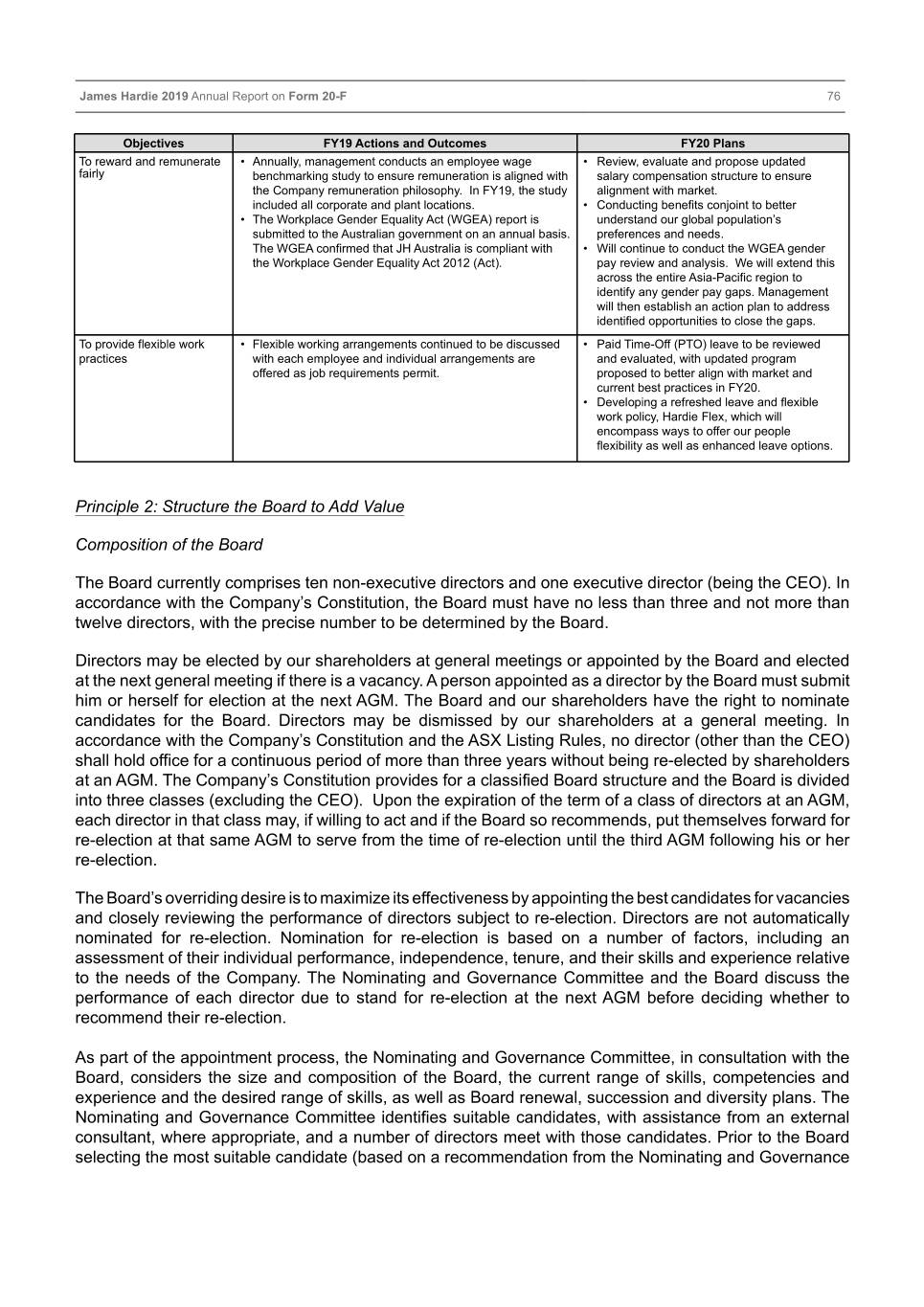
Table of Contents James Hardie 2019 Annual Report on Form 20-F 76 Objectives FY19 Actions and Outcomes FY20 Plans To reward and remunerate • Annually, management conducts an employee wage • Review, evaluate and propose updated fairly benchmarking study to ensure remuneration is aligned with salary compensation structure to ensure the Company remuneration philosophy. In FY19, the study alignment with market. included all corporate and plant locations. • Conducting benefits conjoint to better • The Workplace Gender Equality Act (WGEA) report is understand our global population’s submitted to the Australian government on an annual basis. preferences and needs. The WGEA confirmed that JH Australia is compliant with • Will continue to conduct the WGEA gender the Workplace Gender Equality Act 2012 (Act). pay review and analysis. We will extend this across the entire Asia-Pacific region to identify any gender pay gaps. Management will then establish an action plan to address identified opportunities to close the gaps. To provide flexible work • Flexible working arrangements continued to be discussed • Paid Time-Off (PTO) leave to be reviewed practices with each employee and individual arrangements are and evaluated, with updated program offered as job requirements permit. proposed to better align with market and current best practices in FY20. • Developing a refreshed leave and flexible work policy, Hardie Flex, which will encompass ways to offer our people flexibility as well as enhanced leave options. Principle 2: Structure the Board to Add Value Composition of the Board The Board currently comprises ten non-executive directors and one executive director (being the CEO). In accordance with the Company’s Constitution, the Board must have no less than three and not more than twelve directors, with the precise number to be determined by the Board. Directors may be elected by our shareholders at general meetings or appointed by the Board and elected at the next general meeting if there is a vacancy. A person appointed as a director by the Board must submit him or herself for election at the next AGM. The Board and our shareholders have the right to nominate candidates for the Board. Directors may be dismissed by our shareholders at a general meeting. In accordance with the Company’s Constitution and the ASX Listing Rules, no director (other than the CEO) shall hold office for a continuous period of more than three years without being re-elected by shareholders at an AGM. The Company’s Constitution provides for a classified Board structure and the Board is divided into three classes (excluding the CEO). Upon the expiration of the term of a class of directors at an AGM, each director in that class may, if willing to act and if the Board so recommends, put themselves forward for re-election at that same AGM to serve from the time of re-election until the third AGM following his or her re-election. The Board’s overriding desire is to maximize its effectiveness by appointing the best candidates for vacancies and closely reviewing the performance of directors subject to re-election. Directors are not automatically nominated for re-election. Nomination for re-election is based on a number of factors, including an assessment of their individual performance, independence, tenure, and their skills and experience relative to the needs of the Company. The Nominating and Governance Committee and the Board discuss the performance of each director due to stand for re-election at the next AGM before deciding whether to recommend their re-election. As part of the appointment process, the Nominating and Governance Committee, in consultation with the Board, considers the size and composition of the Board, the current range of skills, competencies and experience and the desired range of skills, as well as Board renewal, succession and diversity plans. The Nominating and Governance Committee identifies suitable candidates, with assistance from an external consultant, where appropriate, and a number of directors meet with those candidates. Prior to the Board selecting the most suitable candidate (based on a recommendation from the Nominating and Governance
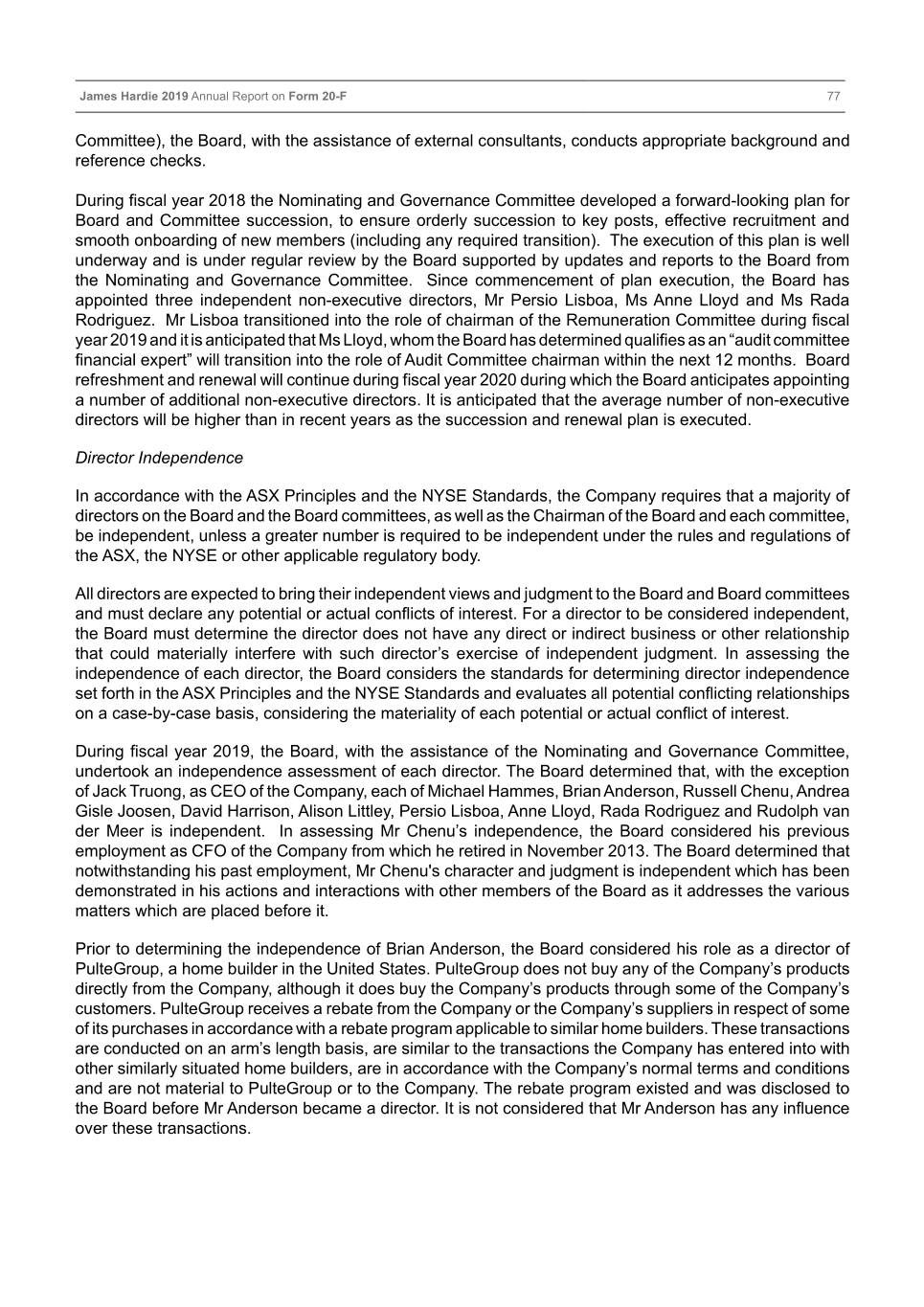
Table of Contents James Hardie 2019 Annual Report on Form 20-F 77 Committee), the Board, with the assistance of external consultants, conducts appropriate background and reference checks. During fiscal year 2018 the Nominating and Governance Committee developed a forward-looking plan for Board and Committee succession, to ensure orderly succession to key posts, effective recruitment and smooth onboarding of new members (including any required transition). The execution of this plan is well underway and is under regular review by the Board supported by updates and reports to the Board from the Nominating and Governance Committee. Since commencement of plan execution, the Board has appointed three independent non-executive directors, Mr Persio Lisboa, Ms Anne Lloyd and Ms Rada Rodriguez. Mr Lisboa transitioned into the role of chairman of the Remuneration Committee during fiscal year 2019 and it is anticipated that Ms Lloyd, whom the Board has determined qualifies as an “audit committee financial expert” will transition into the role of Audit Committee chairman within the next 12 months. Board refreshment and renewal will continue during fiscal year 2020 during which the Board anticipates appointing a number of additional non-executive directors. It is anticipated that the average number of non-executive directors will be higher than in recent years as the succession and renewal plan is executed. Director Independence In accordance with the ASX Principles and the NYSE Standards, the Company requires that a majority of directors on the Board and the Board committees, as well as the Chairman of the Board and each committee, be independent, unless a greater number is required to be independent under the rules and regulations of the ASX, the NYSE or other applicable regulatory body. All directors are expected to bring their independent views and judgment to the Board and Board committees and must declare any potential or actual conflicts of interest. For a director to be considered independent, the Board must determine the director does not have any direct or indirect business or other relationship that could materially interfere with such director’s exercise of independent judgment. In assessing the independence of each director, the Board considers the standards for determining director independence set forth in the ASX Principles and the NYSE Standards and evaluates all potential conflicting relationships on a case-by-case basis, considering the materiality of each potential or actual conflict of interest. During fiscal year 2019, the Board, with the assistance of the Nominating and Governance Committee, undertook an independence assessment of each director. The Board determined that, with the exception of Jack Truong, as CEO of the Company, each of Michael Hammes, Brian Anderson, Russell Chenu, Andrea Gisle Joosen, David Harrison, Alison Littley, Persio Lisboa, Anne Lloyd, Rada Rodriguez and Rudolph van der Meer is independent. In assessing Mr Chenu’s independence, the Board considered his previous employment as CFO of the Company from which he retired in November 2013. The Board determined that notwithstanding his past employment, Mr Chenu's character and judgment is independent which has been demonstrated in his actions and interactions with other members of the Board as it addresses the various matters which are placed before it. Prior to determining the independence of Brian Anderson, the Board considered his role as a director of PulteGroup, a home builder in the United States. PulteGroup does not buy any of the Company’s products directly from the Company, although it does buy the Company’s products through some of the Company’s customers. PulteGroup receives a rebate from the Company or the Company’s suppliers in respect of some of its purchases in accordance with a rebate program applicable to similar home builders. These transactions are conducted on an arm’s length basis, are similar to the transactions the Company has entered into with other similarly situated home builders, are in accordance with the Company’s normal terms and conditions and are not material to PulteGroup or to the Company. The rebate program existed and was disclosed to the Board before Mr Anderson became a director. It is not considered that Mr Anderson has any influence over these transactions.
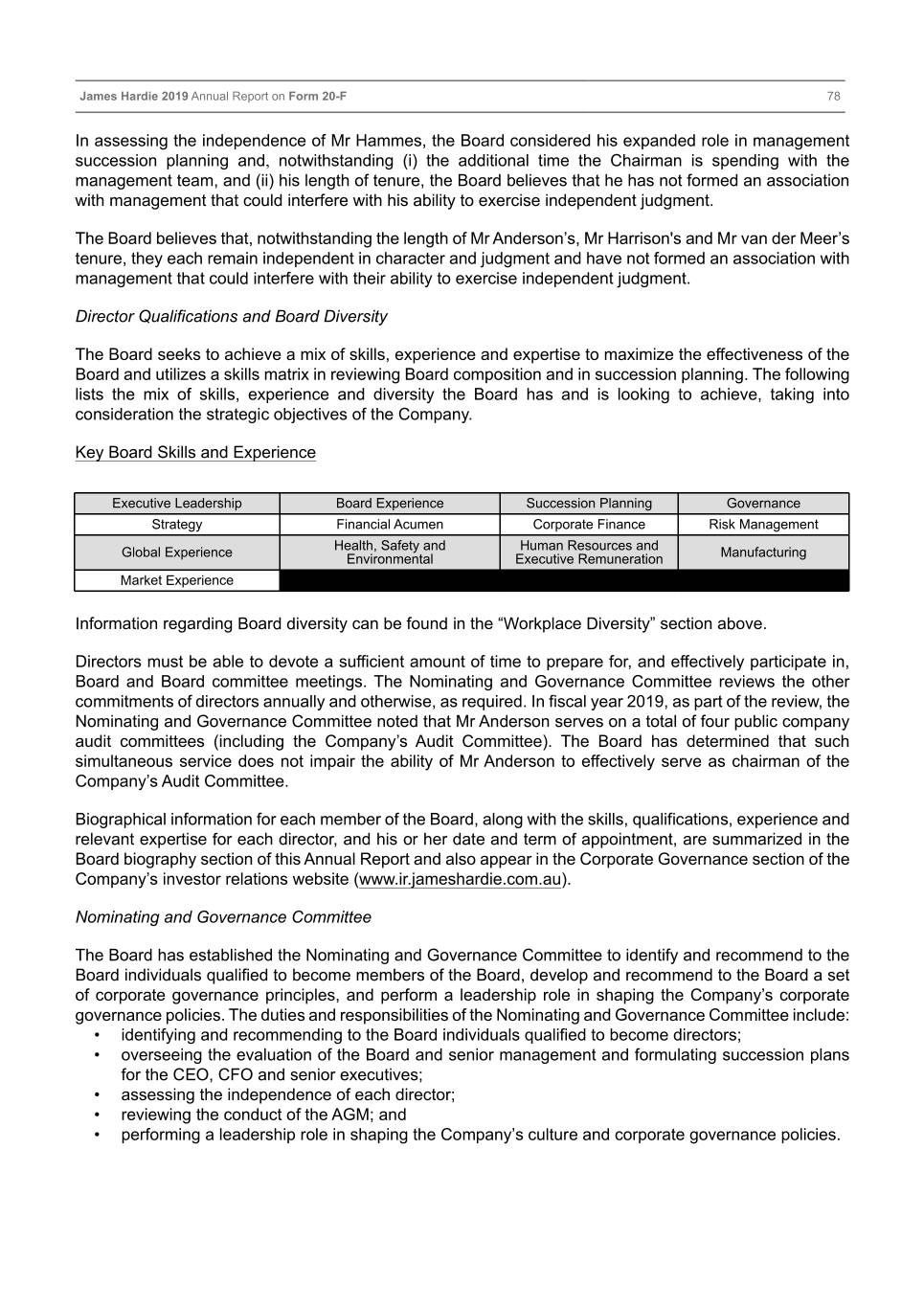
Table of Contents James Hardie 2019 Annual Report on Form 20-F 78 In assessing the independence of Mr Hammes, the Board considered his expanded role in management succession planning and, notwithstanding (i) the additional time the Chairman is spending with the management team, and (ii) his length of tenure, the Board believes that he has not formed an association with management that could interfere with his ability to exercise independent judgment. The Board believes that, notwithstanding the length of Mr Anderson’s, Mr Harrison's and Mr van der Meer’s tenure, they each remain independent in character and judgment and have not formed an association with management that could interfere with their ability to exercise independent judgment. Director Qualifications and Board Diversity The Board seeks to achieve a mix of skills, experience and expertise to maximize the effectiveness of the Board and utilizes a skills matrix in reviewing Board composition and in succession planning. The following lists the mix of skills, experience and diversity the Board has and is looking to achieve, taking into consideration the strategic objectives of the Company. Key Board Skills and Experience Executive Leadership Board Experience Succession Planning Governance Strategy Financial Acumen Corporate Finance Risk Management Health, Safety and Human Resources and Global Experience Environmental Executive Remuneration Manufacturing Market Experience Information regarding Board diversity can be found in the “Workplace Diversity” section above. Directors must be able to devote a sufficient amount of time to prepare for, and effectively participate in, Board and Board committee meetings. The Nominating and Governance Committee reviews the other commitments of directors annually and otherwise, as required. In fiscal year 2019, as part of the review, the Nominating and Governance Committee noted that Mr Anderson serves on a total of four public company audit committees (including the Company’s Audit Committee). The Board has determined that such simultaneous service does not impair the ability of Mr Anderson to effectively serve as chairman of the Company’s Audit Committee. Biographical information for each member of the Board, along with the skills, qualifications, experience and relevant expertise for each director, and his or her date and term of appointment, are summarized in the Board biography section of this Annual Report and also appear in the Corporate Governance section of the Company’s investor relations website (www.ir.jameshardie.com.au). Nominating and Governance Committee The Board has established the Nominating and Governance Committee to identify and recommend to the Board individuals qualified to become members of the Board, develop and recommend to the Board a set of corporate governance principles, and perform a leadership role in shaping the Company’s corporate governance policies. The duties and responsibilities of the Nominating and Governance Committee include: • identifying and recommending to the Board individuals qualified to become directors; • overseeing the evaluation of the Board and senior management and formulating succession plans for the CEO, CFO and senior executives; • assessing the independence of each director; • reviewing the conduct of the AGM; and • performing a leadership role in shaping the Company’s culture and corporate governance policies.
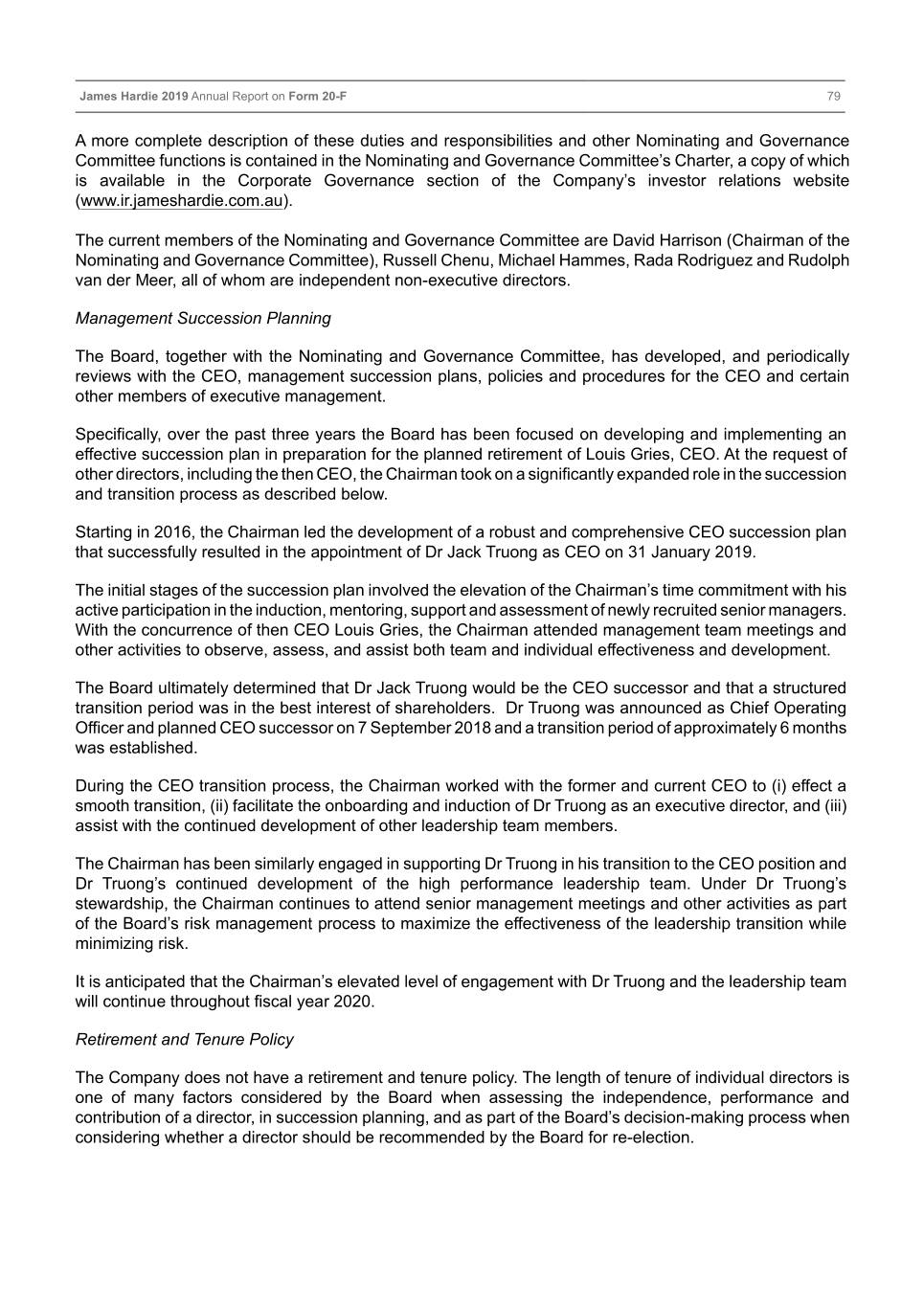
Table of Contents James Hardie 2019 Annual Report on Form 20-F 79 A more complete description of these duties and responsibilities and other Nominating and Governance Committee functions is contained in the Nominating and Governance Committee’s Charter, a copy of which is available in the Corporate Governance section of the Company’s investor relations website (www.ir.jameshardie.com.au). The current members of the Nominating and Governance Committee are David Harrison (Chairman of the Nominating and Governance Committee), Russell Chenu, Michael Hammes, Rada Rodriguez and Rudolph van der Meer, all of whom are independent non-executive directors. Management Succession Planning The Board, together with the Nominating and Governance Committee, has developed, and periodically reviews with the CEO, management succession plans, policies and procedures for the CEO and certain other members of executive management. Specifically, over the past three years the Board has been focused on developing and implementing an effective succession plan in preparation for the planned retirement of Louis Gries, CEO. At the request of other directors, including the then CEO, the Chairman took on a significantly expanded role in the succession and transition process as described below. Starting in 2016, the Chairman led the development of a robust and comprehensive CEO succession plan that successfully resulted in the appointment of Dr Jack Truong as CEO on 31 January 2019. The initial stages of the succession plan involved the elevation of the Chairman’s time commitment with his active participation in the induction, mentoring, support and assessment of newly recruited senior managers. With the concurrence of then CEO Louis Gries, the Chairman attended management team meetings and other activities to observe, assess, and assist both team and individual effectiveness and development. The Board ultimately determined that Dr Jack Truong would be the CEO successor and that a structured transition period was in the best interest of shareholders. Dr Truong was announced as Chief Operating Officer and planned CEO successor on 7 September 2018 and a transition period of approximately 6 months was established. During the CEO transition process, the Chairman worked with the former and current CEO to (i) effect a smooth transition, (ii) facilitate the onboarding and induction of Dr Truong as an executive director, and (iii) assist with the continued development of other leadership team members. The Chairman has been similarly engaged in supporting Dr Truong in his transition to the CEO position and Dr Truong’s continued development of the high performance leadership team. Under Dr Truong’s stewardship, the Chairman continues to attend senior management meetings and other activities as part of the Board’s risk management process to maximize the effectiveness of the leadership transition while minimizing risk. It is anticipated that the Chairman’s elevated level of engagement with Dr Truong and the leadership team will continue throughout fiscal year 2020. Retirement and Tenure Policy The Company does not have a retirement and tenure policy. The length of tenure of individual directors is one of many factors considered by the Board when assessing the independence, performance and contribution of a director, in succession planning, and as part of the Board’s decision-making process when considering whether a director should be recommended by the Board for re-election.
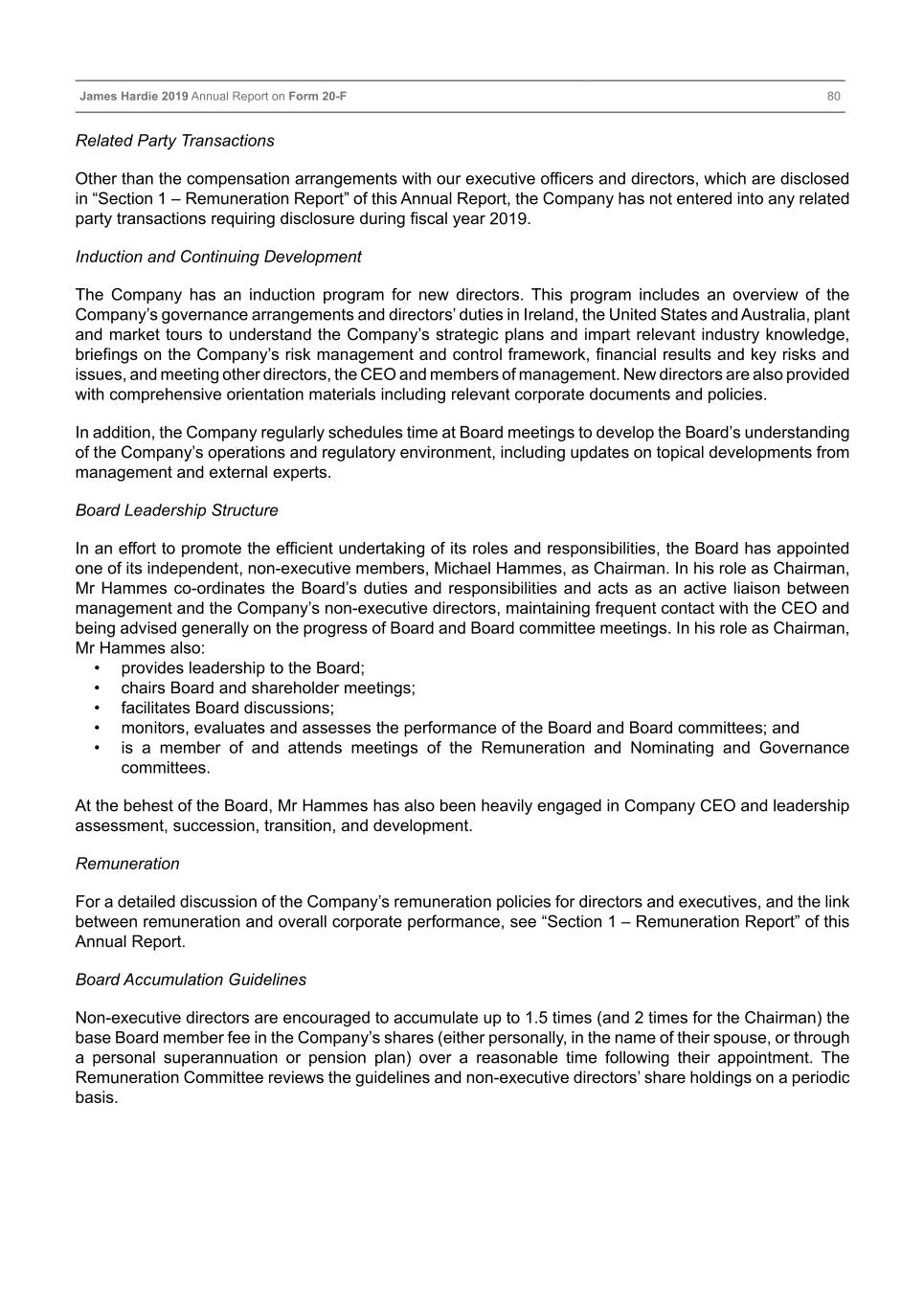
Table of Contents James Hardie 2019 Annual Report on Form 20-F 80 Related Party Transactions Other than the compensation arrangements with our executive officers and directors, which are disclosed in “Section 1 – Remuneration Report” of this Annual Report, the Company has not entered into any related party transactions requiring disclosure during fiscal year 2019. Induction and Continuing Development The Company has an induction program for new directors. This program includes an overview of the Company’s governance arrangements and directors’ duties in Ireland, the United States and Australia, plant and market tours to understand the Company’s strategic plans and impart relevant industry knowledge, briefings on the Company’s risk management and control framework, financial results and key risks and issues, and meeting other directors, the CEO and members of management. New directors are also provided with comprehensive orientation materials including relevant corporate documents and policies. In addition, the Company regularly schedules time at Board meetings to develop the Board’s understanding of the Company’s operations and regulatory environment, including updates on topical developments from management and external experts. Board Leadership Structure In an effort to promote the efficient undertaking of its roles and responsibilities, the Board has appointed one of its independent, non-executive members, Michael Hammes, as Chairman. In his role as Chairman, Mr Hammes co-ordinates the Board’s duties and responsibilities and acts as an active liaison between management and the Company’s non-executive directors, maintaining frequent contact with the CEO and being advised generally on the progress of Board and Board committee meetings. In his role as Chairman, Mr Hammes also: • provides leadership to the Board; • chairs Board and shareholder meetings; • facilitates Board discussions; • monitors, evaluates and assesses the performance of the Board and Board committees; and • is a member of and attends meetings of the Remuneration and Nominating and Governance committees. At the behest of the Board, Mr Hammes has also been heavily engaged in Company CEO and leadership assessment, succession, transition, and development. Remuneration For a detailed discussion of the Company’s remuneration policies for directors and executives, and the link between remuneration and overall corporate performance, see “Section 1 – Remuneration Report” of this Annual Report. Board Accumulation Guidelines Non-executive directors are encouraged to accumulate up to 1.5 times (and 2 times for the Chairman) the base Board member fee in the Company’s shares (either personally, in the name of their spouse, or through a personal superannuation or pension plan) over a reasonable time following their appointment. The Remuneration Committee reviews the guidelines and non-executive directors’ share holdings on a periodic basis.
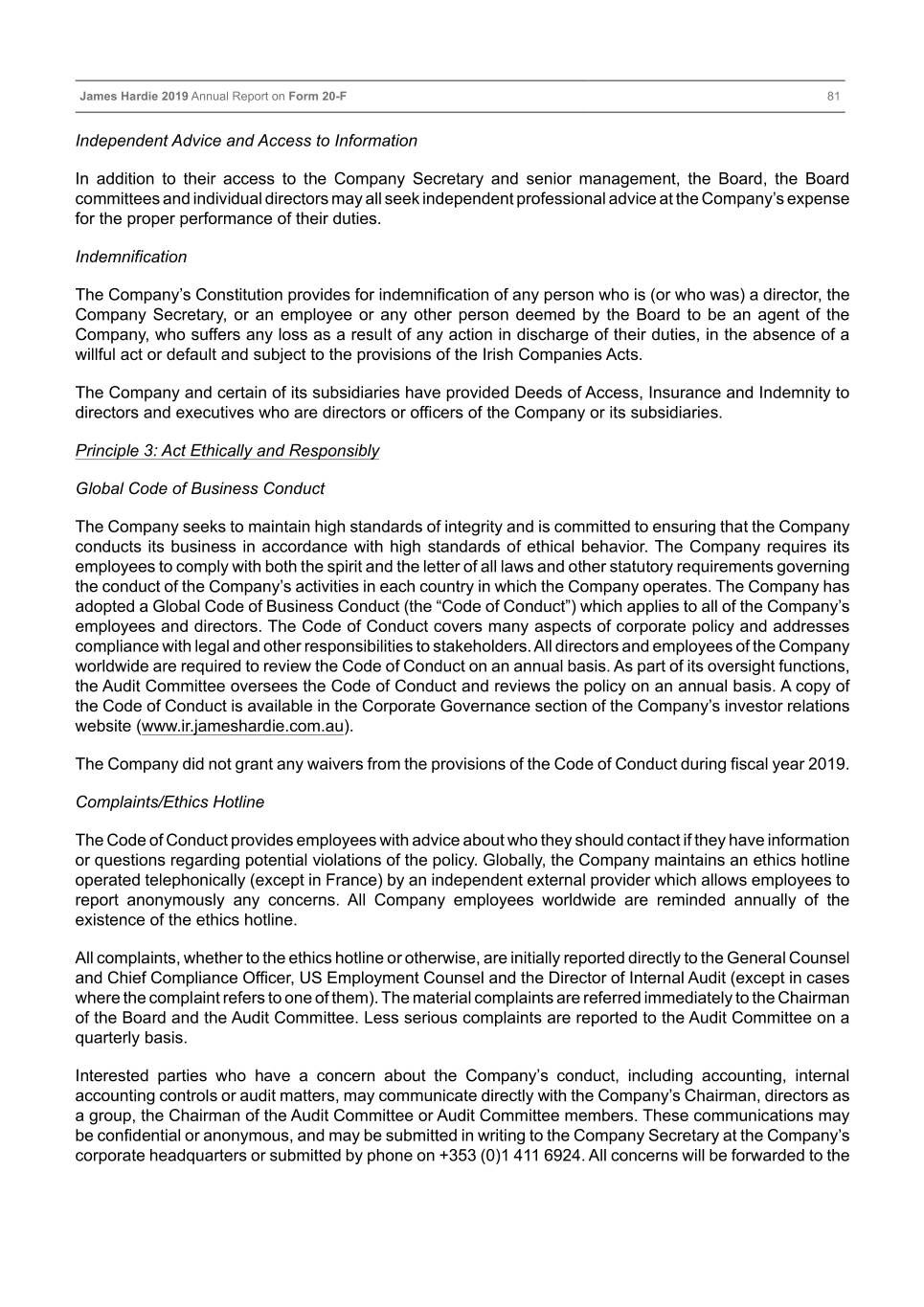
Table of Contents James Hardie 2019 Annual Report on Form 20-F 81 Independent Advice and Access to Information In addition to their access to the Company Secretary and senior management, the Board, the Board committees and individual directors may all seek independent professional advice at the Company’s expense for the proper performance of their duties. Indemnification The Company’s Constitution provides for indemnification of any person who is (or who was) a director, the Company Secretary, or an employee or any other person deemed by the Board to be an agent of the Company, who suffers any loss as a result of any action in discharge of their duties, in the absence of a willful act or default and subject to the provisions of the Irish Companies Acts. The Company and certain of its subsidiaries have provided Deeds of Access, Insurance and Indemnity to directors and executives who are directors or officers of the Company or its subsidiaries. Principle 3: Act Ethically and Responsibly Global Code of Business Conduct The Company seeks to maintain high standards of integrity and is committed to ensuring that the Company conducts its business in accordance with high standards of ethical behavior. The Company requires its employees to comply with both the spirit and the letter of all laws and other statutory requirements governing the conduct of the Company’s activities in each country in which the Company operates. The Company has adopted a Global Code of Business Conduct (the “Code of Conduct”) which applies to all of the Company’s employees and directors. The Code of Conduct covers many aspects of corporate policy and addresses compliance with legal and other responsibilities to stakeholders. All directors and employees of the Company worldwide are required to review the Code of Conduct on an annual basis. As part of its oversight functions, the Audit Committee oversees the Code of Conduct and reviews the policy on an annual basis. A copy of the Code of Conduct is available in the Corporate Governance section of the Company’s investor relations website (www.ir.jameshardie.com.au). The Company did not grant any waivers from the provisions of the Code of Conduct during fiscal year 2019. Complaints/Ethics Hotline The Code of Conduct provides employees with advice about who they should contact if they have information or questions regarding potential violations of the policy. Globally, the Company maintains an ethics hotline operated telephonically (except in France) by an independent external provider which allows employees to report anonymously any concerns. All Company employees worldwide are reminded annually of the existence of the ethics hotline. All complaints, whether to the ethics hotline or otherwise, are initially reported directly to the General Counsel and Chief Compliance Officer, US Employment Counsel and the Director of Internal Audit (except in cases where the complaint refers to one of them). The material complaints are referred immediately to the Chairman of the Board and the Audit Committee. Less serious complaints are reported to the Audit Committee on a quarterly basis. Interested parties who have a concern about the Company’s conduct, including accounting, internal accounting controls or audit matters, may communicate directly with the Company’s Chairman, directors as a group, the Chairman of the Audit Committee or Audit Committee members. These communications may be confidential or anonymous, and may be submitted in writing to the Company Secretary at the Company’s corporate headquarters or submitted by phone on +353 (0)1 411 6924. All concerns will be forwarded to the
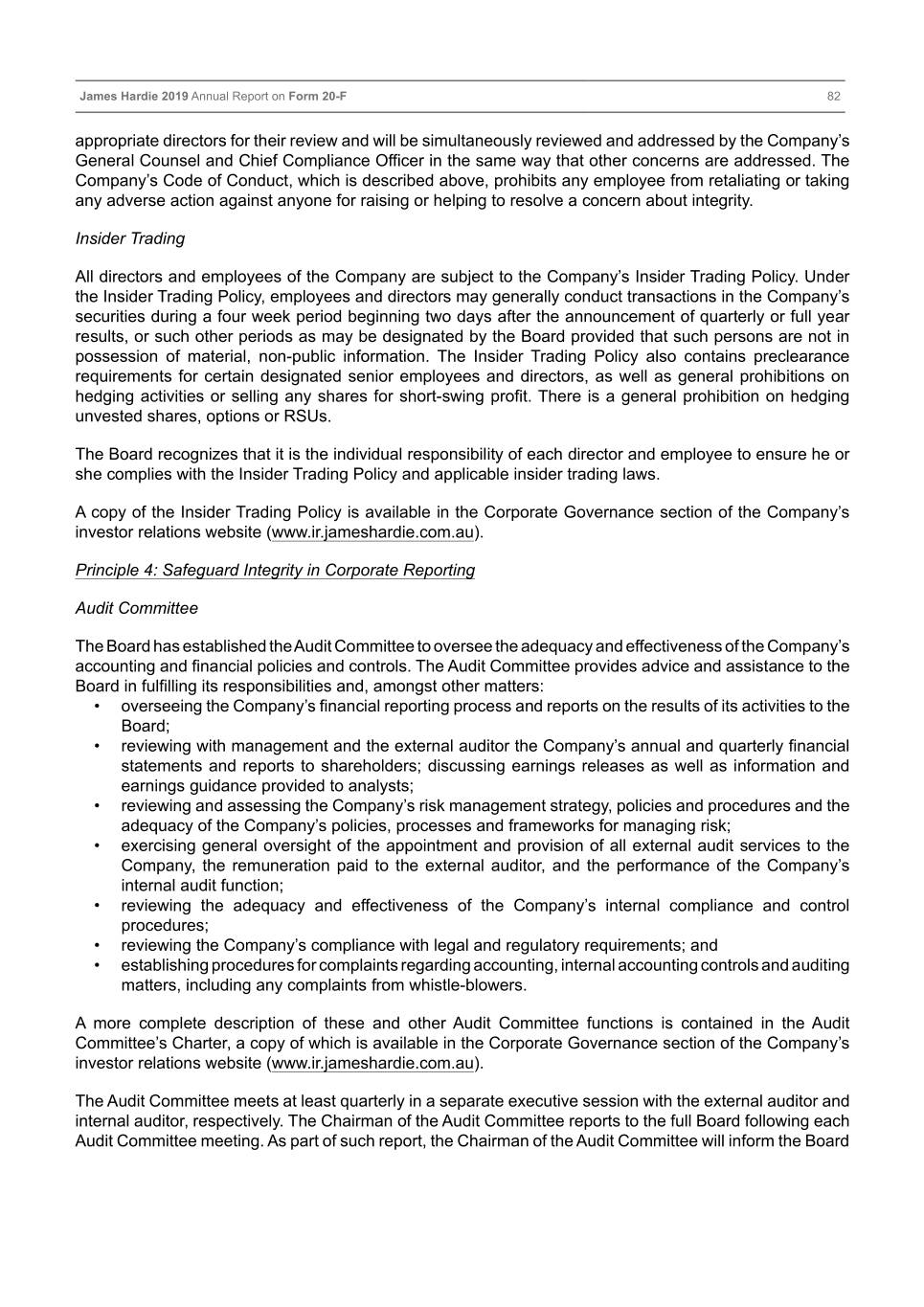
Table of Contents James Hardie 2019 Annual Report on Form 20-F 82 appropriate directors for their review and will be simultaneously reviewed and addressed by the Company’s General Counsel and Chief Compliance Officer in the same way that other concerns are addressed. The Company’s Code of Conduct, which is described above, prohibits any employee from retaliating or taking any adverse action against anyone for raising or helping to resolve a concern about integrity. Insider Trading All directors and employees of the Company are subject to the Company’s Insider Trading Policy. Under the Insider Trading Policy, employees and directors may generally conduct transactions in the Company’s securities during a four week period beginning two days after the announcement of quarterly or full year results, or such other periods as may be designated by the Board provided that such persons are not in possession of material, non-public information. The Insider Trading Policy also contains preclearance requirements for certain designated senior employees and directors, as well as general prohibitions on hedging activities or selling any shares for short-swing profit. There is a general prohibition on hedging unvested shares, options or RSUs. The Board recognizes that it is the individual responsibility of each director and employee to ensure he or she complies with the Insider Trading Policy and applicable insider trading laws. A copy of the Insider Trading Policy is available in the Corporate Governance section of the Company’s investor relations website (www.ir.jameshardie.com.au). Principle 4: Safeguard Integrity in Corporate Reporting Audit Committee The Board has established the Audit Committee to oversee the adequacy and effectiveness of the Company’s accounting and financial policies and controls. The Audit Committee provides advice and assistance to the Board in fulfilling its responsibilities and, amongst other matters: • overseeing the Company’s financial reporting process and reports on the results of its activities to the Board; • reviewing with management and the external auditor the Company’s annual and quarterly financial statements and reports to shareholders; discussing earnings releases as well as information and earnings guidance provided to analysts; • reviewing and assessing the Company’s risk management strategy, policies and procedures and the adequacy of the Company’s policies, processes and frameworks for managing risk; • exercising general oversight of the appointment and provision of all external audit services to the Company, the remuneration paid to the external auditor, and the performance of the Company’s internal audit function; • reviewing the adequacy and effectiveness of the Company’s internal compliance and control procedures; • reviewing the Company’s compliance with legal and regulatory requirements; and • establishing procedures for complaints regarding accounting, internal accounting controls and auditing matters, including any complaints from whistle-blowers. A more complete description of these and other Audit Committee functions is contained in the Audit Committee’s Charter, a copy of which is available in the Corporate Governance section of the Company’s investor relations website (www.ir.jameshardie.com.au). The Audit Committee meets at least quarterly in a separate executive session with the external auditor and internal auditor, respectively. The Chairman of the Audit Committee reports to the full Board following each Audit Committee meeting. As part of such report, the Chairman of the Audit Committee will inform the Board
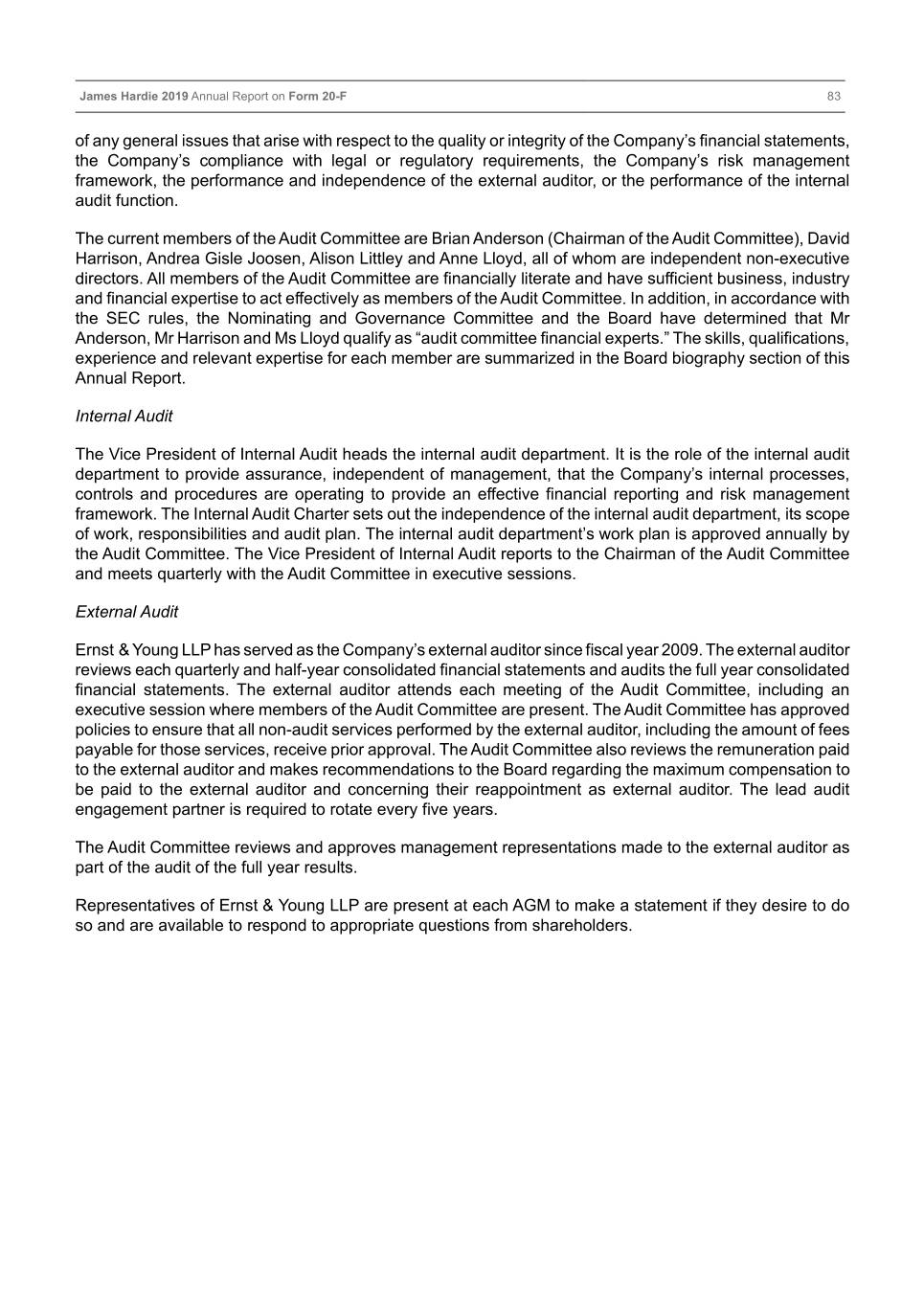
Table of Contents James Hardie 2019 Annual Report on Form 20-F 83 of any general issues that arise with respect to the quality or integrity of the Company’s financial statements, the Company’s compliance with legal or regulatory requirements, the Company’s risk management framework, the performance and independence of the external auditor, or the performance of the internal audit function. The current members of the Audit Committee are Brian Anderson (Chairman of the Audit Committee), David Harrison, Andrea Gisle Joosen, Alison Littley and Anne Lloyd, all of whom are independent non-executive directors. All members of the Audit Committee are financially literate and have sufficient business, industry and financial expertise to act effectively as members of the Audit Committee. In addition, in accordance with the SEC rules, the Nominating and Governance Committee and the Board have determined that Mr Anderson, Mr Harrison and Ms Lloyd qualify as “audit committee financial experts.” The skills, qualifications, experience and relevant expertise for each member are summarized in the Board biography section of this Annual Report. Internal Audit The Vice President of Internal Audit heads the internal audit department. It is the role of the internal audit department to provide assurance, independent of management, that the Company’s internal processes, controls and procedures are operating to provide an effective financial reporting and risk management framework. The Internal Audit Charter sets out the independence of the internal audit department, its scope of work, responsibilities and audit plan. The internal audit department’s work plan is approved annually by the Audit Committee. The Vice President of Internal Audit reports to the Chairman of the Audit Committee and meets quarterly with the Audit Committee in executive sessions. External Audit Ernst & Young LLP has served as the Company’s external auditor since fiscal year 2009. The external auditor reviews each quarterly and half-year consolidated financial statements and audits the full year consolidated financial statements. The external auditor attends each meeting of the Audit Committee, including an executive session where members of the Audit Committee are present. The Audit Committee has approved policies to ensure that all non-audit services performed by the external auditor, including the amount of fees payable for those services, receive prior approval. The Audit Committee also reviews the remuneration paid to the external auditor and makes recommendations to the Board regarding the maximum compensation to be paid to the external auditor and concerning their reappointment as external auditor. The lead audit engagement partner is required to rotate every five years. The Audit Committee reviews and approves management representations made to the external auditor as part of the audit of the full year results. Representatives of Ernst & Young LLP are present at each AGM to make a statement if they desire to do so and are available to respond to appropriate questions from shareholders.
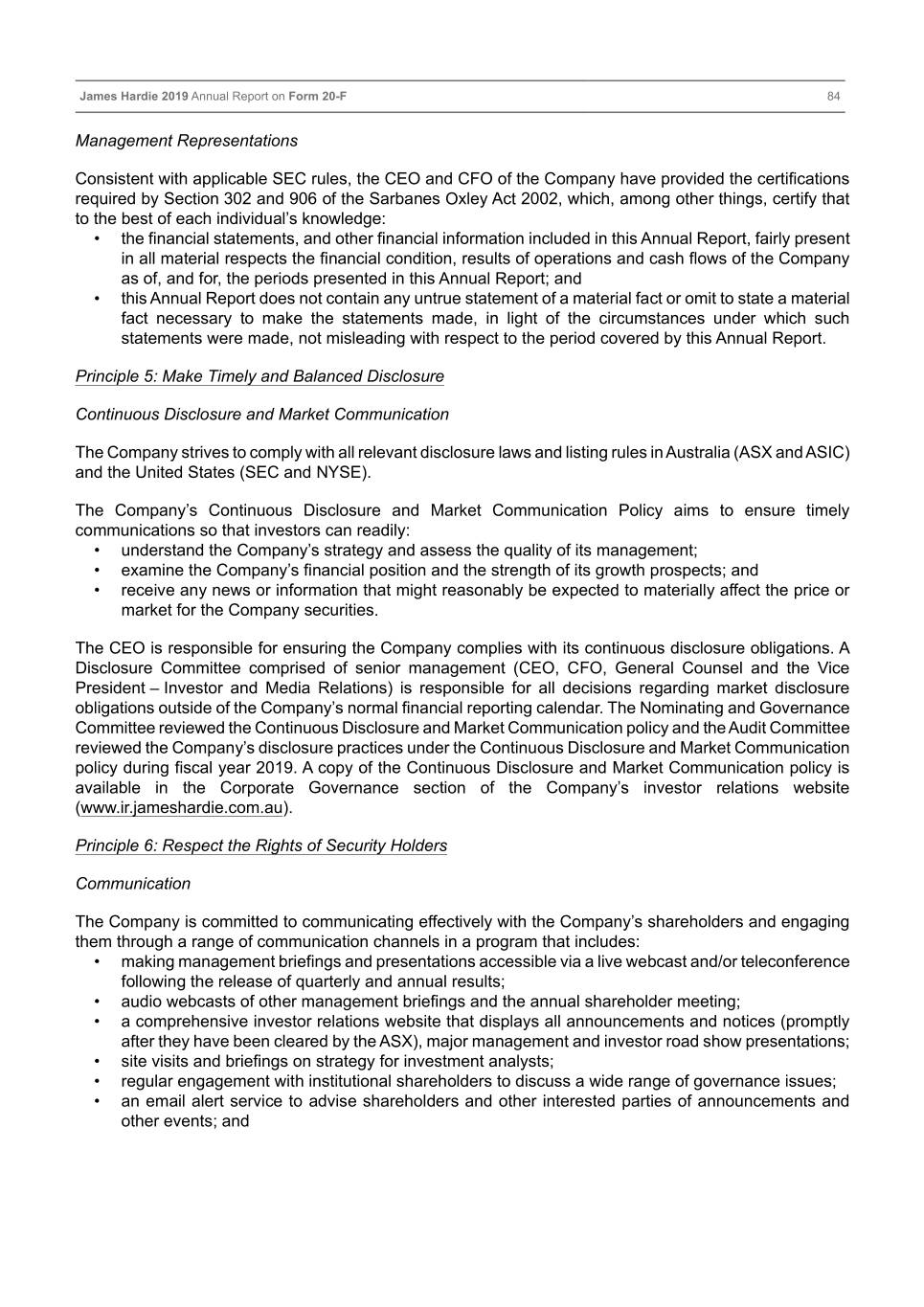
Table of Contents James Hardie 2019 Annual Report on Form 20-F 84 Management Representations Consistent with applicable SEC rules, the CEO and CFO of the Company have provided the certifications required by Section 302 and 906 of the Sarbanes Oxley Act 2002, which, among other things, certify that to the best of each individual’s knowledge: • the financial statements, and other financial information included in this Annual Report, fairly present in all material respects the financial condition, results of operations and cash flows of the Company as of, and for, the periods presented in this Annual Report; and • this Annual Report does not contain any untrue statement of a material fact or omit to state a material fact necessary to make the statements made, in light of the circumstances under which such statements were made, not misleading with respect to the period covered by this Annual Report. Principle 5: Make Timely and Balanced Disclosure Continuous Disclosure and Market Communication The Company strives to comply with all relevant disclosure laws and listing rules in Australia (ASX and ASIC) and the United States (SEC and NYSE). The Company’s Continuous Disclosure and Market Communication Policy aims to ensure timely communications so that investors can readily: • understand the Company’s strategy and assess the quality of its management; • examine the Company’s financial position and the strength of its growth prospects; and • receive any news or information that might reasonably be expected to materially affect the price or market for the Company securities. The CEO is responsible for ensuring the Company complies with its continuous disclosure obligations. A Disclosure Committee comprised of senior management (CEO, CFO, General Counsel and the Vice President – Investor and Media Relations) is responsible for all decisions regarding market disclosure obligations outside of the Company’s normal financial reporting calendar. The Nominating and Governance Committee reviewed the Continuous Disclosure and Market Communication policy and the Audit Committee reviewed the Company’s disclosure practices under the Continuous Disclosure and Market Communication policy during fiscal year 2019. A copy of the Continuous Disclosure and Market Communication policy is available in the Corporate Governance section of the Company’s investor relations website (www.ir.jameshardie.com.au). Principle 6: Respect the Rights of Security Holders Communication The Company is committed to communicating effectively with the Company’s shareholders and engaging them through a range of communication channels in a program that includes: • making management briefings and presentations accessible via a live webcast and/or teleconference following the release of quarterly and annual results; • audio webcasts of other management briefings and the annual shareholder meeting; • a comprehensive investor relations website that displays all announcements and notices (promptly after they have been cleared by the ASX), major management and investor road show presentations; • site visits and briefings on strategy for investment analysts; • regular engagement with institutional shareholders to discuss a wide range of governance issues; • an email alert service to advise shareholders and other interested parties of announcements and other events; and
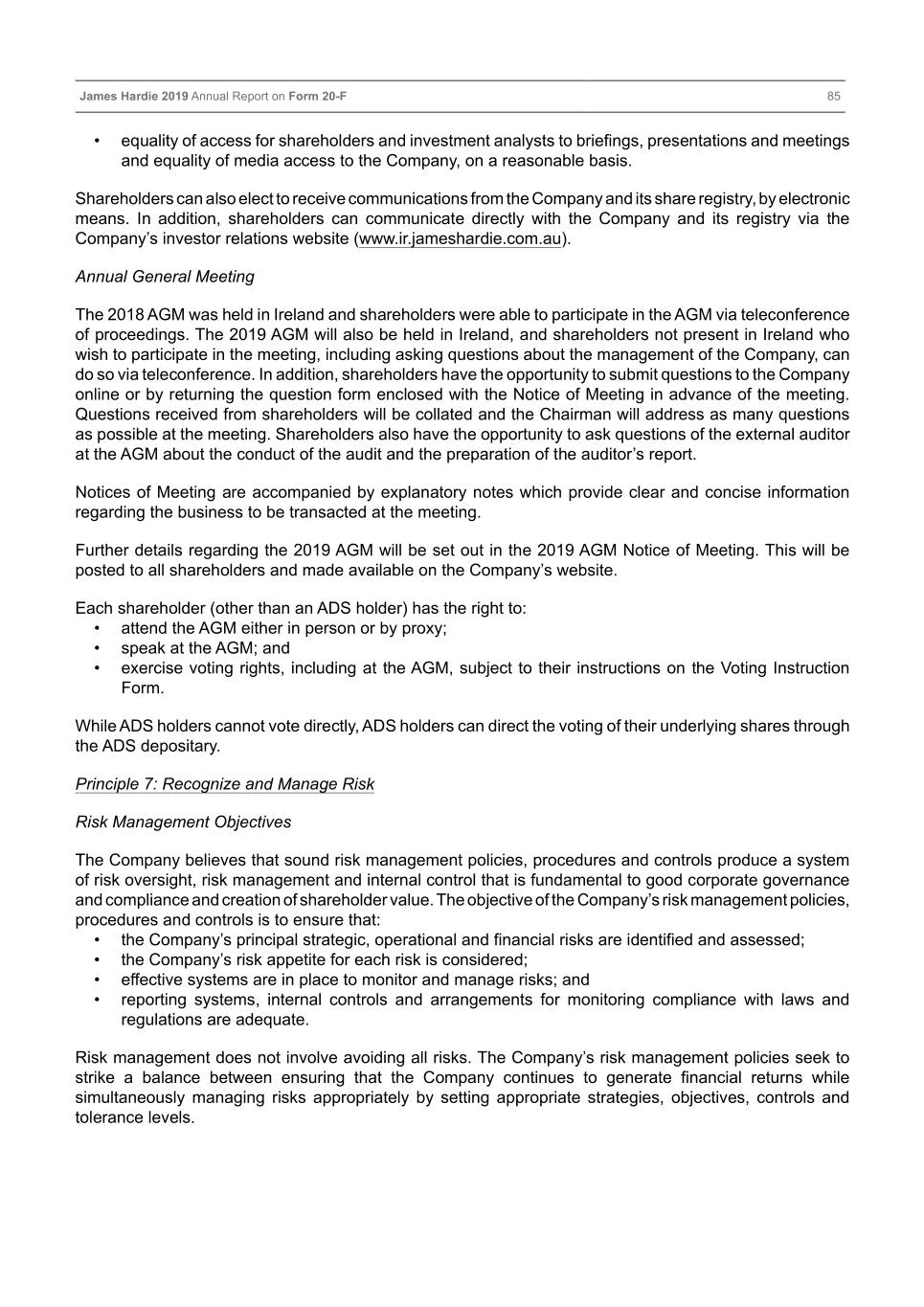
Table of Contents James Hardie 2019 Annual Report on Form 20-F 85 • equality of access for shareholders and investment analysts to briefings, presentations and meetings and equality of media access to the Company, on a reasonable basis. Shareholders can also elect to receive communications from the Company and its share registry, by electronic means. In addition, shareholders can communicate directly with the Company and its registry via the Company’s investor relations website (www.ir.jameshardie.com.au). Annual General Meeting The 2018 AGM was held in Ireland and shareholders were able to participate in the AGM via teleconference of proceedings. The 2019 AGM will also be held in Ireland, and shareholders not present in Ireland who wish to participate in the meeting, including asking questions about the management of the Company, can do so via teleconference. In addition, shareholders have the opportunity to submit questions to the Company online or by returning the question form enclosed with the Notice of Meeting in advance of the meeting. Questions received from shareholders will be collated and the Chairman will address as many questions as possible at the meeting. Shareholders also have the opportunity to ask questions of the external auditor at the AGM about the conduct of the audit and the preparation of the auditor’s report. Notices of Meeting are accompanied by explanatory notes which provide clear and concise information regarding the business to be transacted at the meeting. Further details regarding the 2019 AGM will be set out in the 2019 AGM Notice of Meeting. This will be posted to all shareholders and made available on the Company’s website. Each shareholder (other than an ADS holder) has the right to: • attend the AGM either in person or by proxy; • speak at the AGM; and • exercise voting rights, including at the AGM, subject to their instructions on the Voting Instruction Form. While ADS holders cannot vote directly, ADS holders can direct the voting of their underlying shares through the ADS depositary. Principle 7: Recognize and Manage Risk Risk Management Objectives The Company believes that sound risk management policies, procedures and controls produce a system of risk oversight, risk management and internal control that is fundamental to good corporate governance and compliance and creation of shareholder value. The objective of the Company’s risk management policies, procedures and controls is to ensure that: • the Company’s principal strategic, operational and financial risks are identified and assessed; • the Company’s risk appetite for each risk is considered; • effective systems are in place to monitor and manage risks; and • reporting systems, internal controls and arrangements for monitoring compliance with laws and regulations are adequate. Risk management does not involve avoiding all risks. The Company’s risk management policies seek to strike a balance between ensuring that the Company continues to generate financial returns while simultaneously managing risks appropriately by setting appropriate strategies, objectives, controls and tolerance levels.
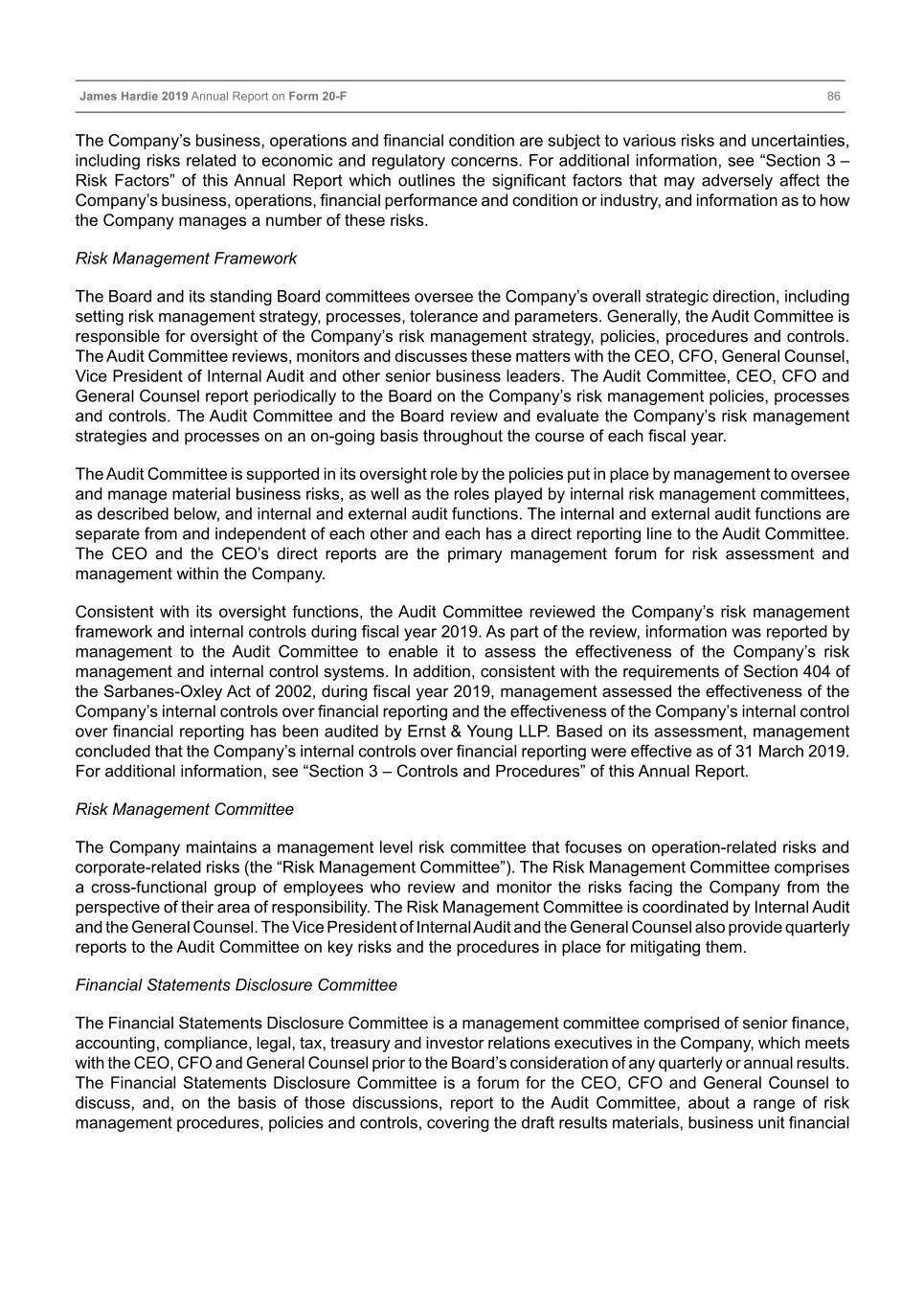
Table of Contents James Hardie 2019 Annual Report on Form 20-F 86 The Company’s business, operations and financial condition are subject to various risks and uncertainties, including risks related to economic and regulatory concerns. For additional information, see “Section 3 – Risk Factors” of this Annual Report which outlines the significant factors that may adversely affect the Company’s business, operations, financial performance and condition or industry, and information as to how the Company manages a number of these risks. Risk Management Framework The Board and its standing Board committees oversee the Company’s overall strategic direction, including setting risk management strategy, processes, tolerance and parameters. Generally, the Audit Committee is responsible for oversight of the Company’s risk management strategy, policies, procedures and controls. The Audit Committee reviews, monitors and discusses these matters with the CEO, CFO, General Counsel, Vice President of Internal Audit and other senior business leaders. The Audit Committee, CEO, CFO and General Counsel report periodically to the Board on the Company’s risk management policies, processes and controls. The Audit Committee and the Board review and evaluate the Company’s risk management strategies and processes on an on-going basis throughout the course of each fiscal year. The Audit Committee is supported in its oversight role by the policies put in place by management to oversee and manage material business risks, as well as the roles played by internal risk management committees, as described below, and internal and external audit functions. The internal and external audit functions are separate from and independent of each other and each has a direct reporting line to the Audit Committee. The CEO and the CEO’s direct reports are the primary management forum for risk assessment and management within the Company. Consistent with its oversight functions, the Audit Committee reviewed the Company’s risk management framework and internal controls during fiscal year 2019. As part of the review, information was reported by management to the Audit Committee to enable it to assess the effectiveness of the Company’s risk management and internal control systems. In addition, consistent with the requirements of Section 404 of the Sarbanes-Oxley Act of 2002, during fiscal year 2019, management assessed the effectiveness of the Company’s internal controls over financial reporting and the effectiveness of the Company’s internal control over financial reporting has been audited by Ernst & Young LLP. Based on its assessment, management concluded that the Company’s internal controls over financial reporting were effective as of 31 March 2019. For additional information, see “Section 3 – Controls and Procedures” of this Annual Report. Risk Management Committee The Company maintains a management level risk committee that focuses on operation-related risks and corporate-related risks (the “Risk Management Committee”). The Risk Management Committee comprises a cross-functional group of employees who review and monitor the risks facing the Company from the perspective of their area of responsibility. The Risk Management Committee is coordinated by Internal Audit and the General Counsel. The Vice President of Internal Audit and the General Counsel also provide quarterly reports to the Audit Committee on key risks and the procedures in place for mitigating them. Financial Statements Disclosure Committee The Financial Statements Disclosure Committee is a management committee comprised of senior finance, accounting, compliance, legal, tax, treasury and investor relations executives in the Company, which meets with the CEO, CFO and General Counsel prior to the Board’s consideration of any quarterly or annual results. The Financial Statements Disclosure Committee is a forum for the CEO, CFO and General Counsel to discuss, and, on the basis of those discussions, report to the Audit Committee, about a range of risk management procedures, policies and controls, covering the draft results materials, business unit financial
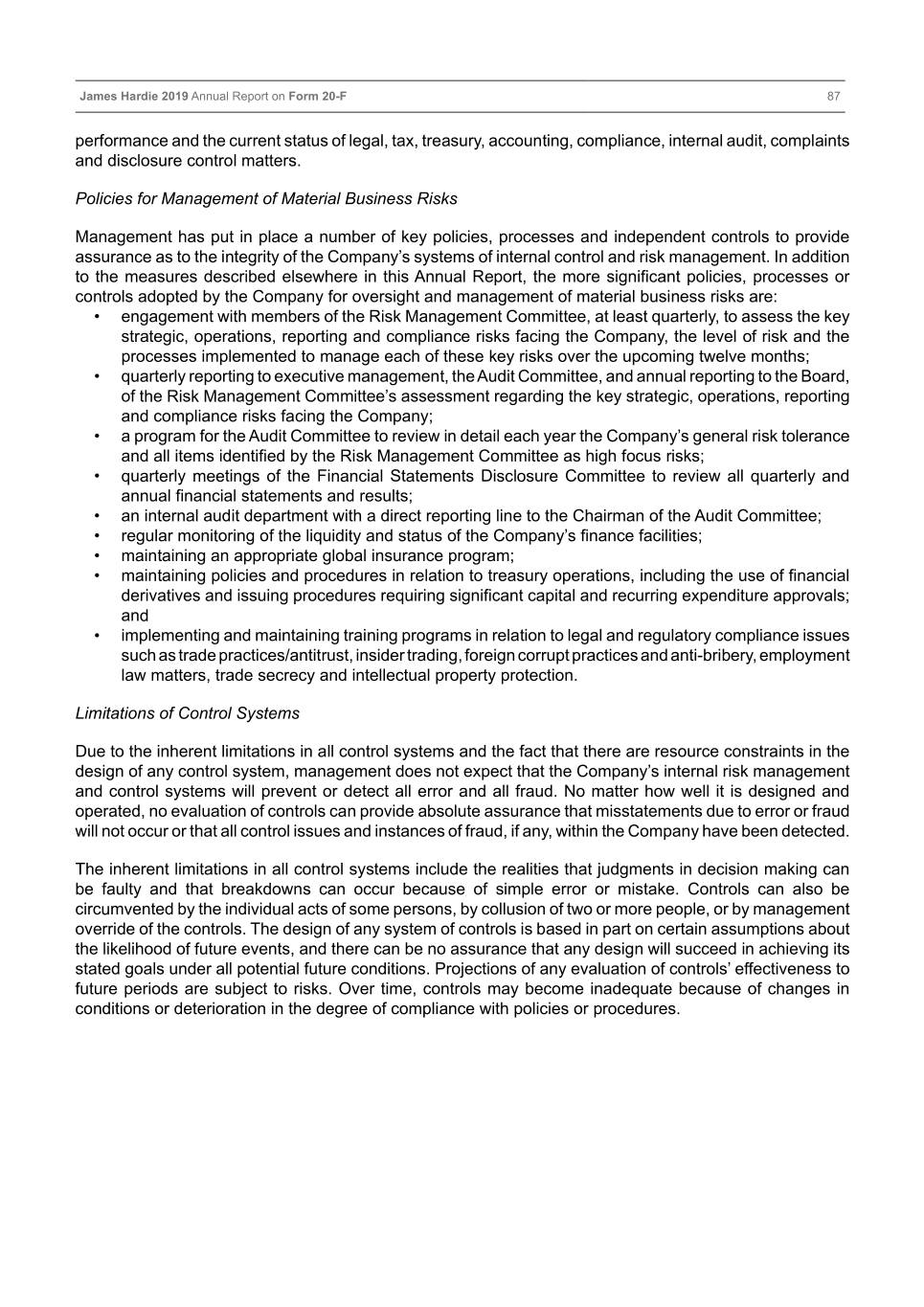
Table of Contents James Hardie 2019 Annual Report on Form 20-F 87 performance and the current status of legal, tax, treasury, accounting, compliance, internal audit, complaints and disclosure control matters. Policies for Management of Material Business Risks Management has put in place a number of key policies, processes and independent controls to provide assurance as to the integrity of the Company’s systems of internal control and risk management. In addition to the measures described elsewhere in this Annual Report, the more significant policies, processes or controls adopted by the Company for oversight and management of material business risks are: • engagement with members of the Risk Management Committee, at least quarterly, to assess the key strategic, operations, reporting and compliance risks facing the Company, the level of risk and the processes implemented to manage each of these key risks over the upcoming twelve months; • quarterly reporting to executive management, the Audit Committee, and annual reporting to the Board, of the Risk Management Committee’s assessment regarding the key strategic, operations, reporting and compliance risks facing the Company; • a program for the Audit Committee to review in detail each year the Company’s general risk tolerance and all items identified by the Risk Management Committee as high focus risks; • quarterly meetings of the Financial Statements Disclosure Committee to review all quarterly and annual financial statements and results; • an internal audit department with a direct reporting line to the Chairman of the Audit Committee; • regular monitoring of the liquidity and status of the Company’s finance facilities; • maintaining an appropriate global insurance program; • maintaining policies and procedures in relation to treasury operations, including the use of financial derivatives and issuing procedures requiring significant capital and recurring expenditure approvals; and • implementing and maintaining training programs in relation to legal and regulatory compliance issues such as trade practices/antitrust, insider trading, foreign corrupt practices and anti-bribery, employment law matters, trade secrecy and intellectual property protection. Limitations of Control Systems Due to the inherent limitations in all control systems and the fact that there are resource constraints in the design of any control system, management does not expect that the Company’s internal risk management and control systems will prevent or detect all error and all fraud. No matter how well it is designed and operated, no evaluation of controls can provide absolute assurance that misstatements due to error or fraud will not occur or that all control issues and instances of fraud, if any, within the Company have been detected. The inherent limitations in all control systems include the realities that judgments in decision making can be faulty and that breakdowns can occur because of simple error or mistake. Controls can also be circumvented by the individual acts of some persons, by collusion of two or more people, or by management override of the controls. The design of any system of controls is based in part on certain assumptions about the likelihood of future events, and there can be no assurance that any design will succeed in achieving its stated goals under all potential future conditions. Projections of any evaluation of controls’ effectiveness to future periods are subject to risks. Over time, controls may become inadequate because of changes in conditions or deterioration in the degree of compliance with policies or procedures.
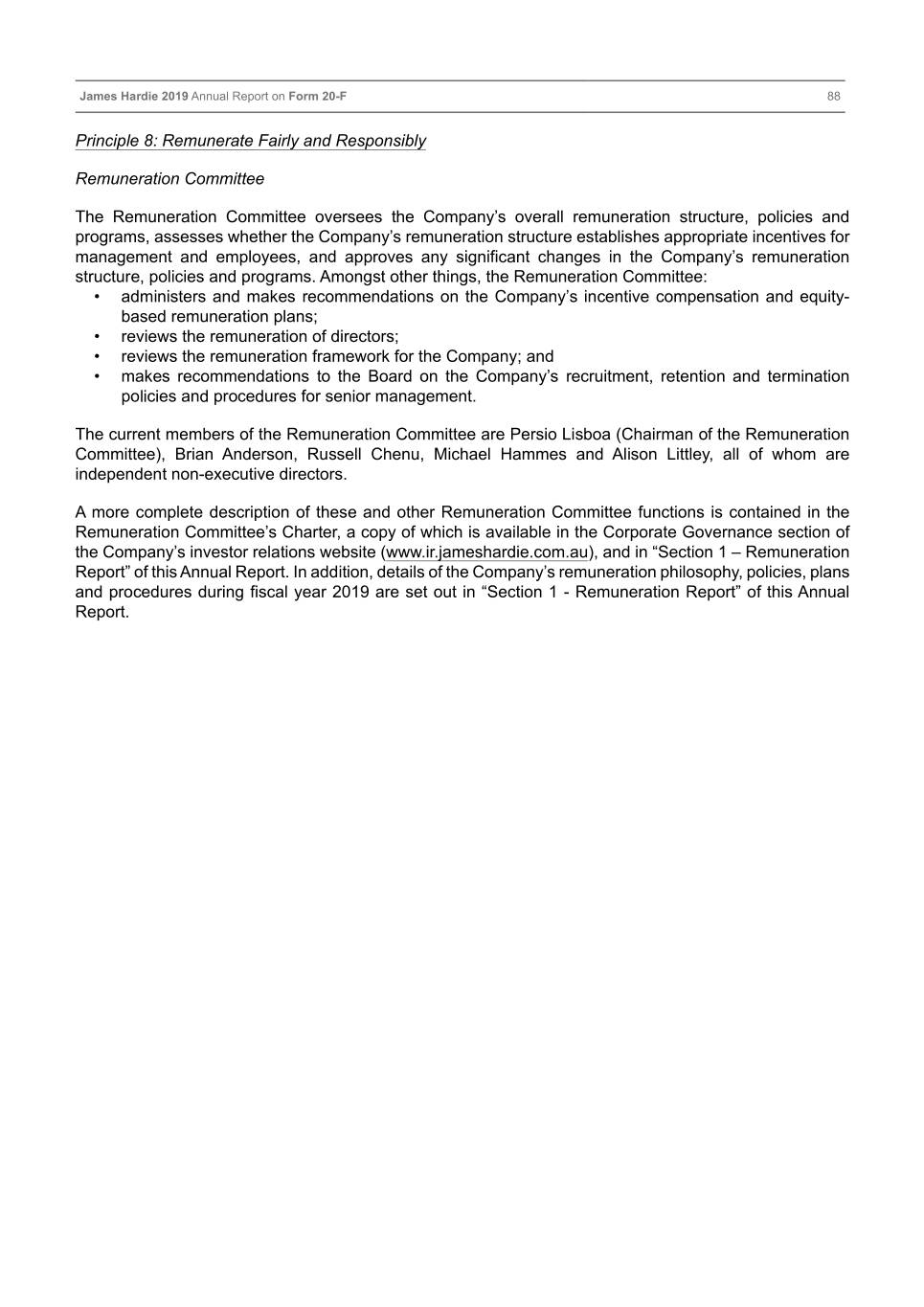
Table of Contents James Hardie 2019 Annual Report on Form 20-F 88 Principle 8: Remunerate Fairly and Responsibly Remuneration Committee The Remuneration Committee oversees the Company’s overall remuneration structure, policies and programs, assesses whether the Company’s remuneration structure establishes appropriate incentives for management and employees, and approves any significant changes in the Company’s remuneration structure, policies and programs. Amongst other things, the Remuneration Committee: • administers and makes recommendations on the Company’s incentive compensation and equity- based remuneration plans; • reviews the remuneration of directors; • reviews the remuneration framework for the Company; and • makes recommendations to the Board on the Company’s recruitment, retention and termination policies and procedures for senior management. The current members of the Remuneration Committee are Persio Lisboa (Chairman of the Remuneration Committee), Brian Anderson, Russell Chenu, Michael Hammes and Alison Littley, all of whom are independent non-executive directors. A more complete description of these and other Remuneration Committee functions is contained in the Remuneration Committee’s Charter, a copy of which is available in the Corporate Governance section of the Company’s investor relations website (www.ir.jameshardie.com.au), and in “Section 1 – Remuneration Report” of this Annual Report. In addition, details of the Company’s remuneration philosophy, policies, plans and procedures during fiscal year 2019 are set out in “Section 1 - Remuneration Report” of this Annual Report.

Table of Contents James Hardie 2019 Annual Report on Form 20-F 89 SECTION 2 READING THIS REPORT Forward-Looking Statements This Annual Report contains forward-looking statements. James Hardie may from time to time make forward- looking statements in its periodic reports filed with or furnished to the SEC, on Forms 20-F and 6-K, in its annual reports to shareholders, in offering circulars, invitation memoranda and prospectuses, in media releases and other written materials and in oral statements made by the Company’s officers, directors or employees to analysts, institutional investors, existing and potential lenders, representatives of the media and others. Statements that are not historical facts are forward-looking statements and such forward-looking statements are statements made pursuant to the safe harbor provisions of the Private Securities Litigation Reform Act of 1995. Examples of forward-looking statements include: • statements about the Company’s future performance; • projections of the Company’s results of operations or financial condition; • statements regarding the Company’s plans, objectives or goals, including those relating to strategies, initiatives, competition, acquisitions, dispositions and/or its products; • expectations concerning the costs associated with the suspension or closure of operations at any of the Company’s plants and future plans with respect to any such plants; • expectations concerning the costs associated with the significant capital expenditure projects at any of the Company’s plants and future plans with respect to any such projects; • expectations regarding the extension or renewal of the Company’s credit facilities including changes to terms, covenants or ratios; • expectations concerning dividend payments and share buy-backs; • statements concerning the Company’s corporate and tax domiciles and structures and potential changes to them, including potential tax charges; • statements regarding tax liabilities and related audits, reviews and proceedings; • statements regarding the possible consequences and/or potential outcome of legal proceedings brought against us and the potential liabilities, if any, associated with such proceedings; • expectations about the timing and amount of contributions to AICF, a special purpose fund for the compensation of proven Australian asbestos-related personal injury and death claims; • expectations concerning the adequacy of the Company’s warranty provisions and estimates for future warranty-related costs; • statements regarding the Company’s ability to manage legal and regulatory matters (including, but not limited to, product liability, environmental, intellectual property and competition law matters) and to resolve any such pending legal and regulatory matters within current estimates and in anticipation of certain third-party recoveries; and • statements about economic conditions, such as changes in the US economic or housing market conditions or changes in the market conditions in the Asia Pacific region, the levels of new home construction and home renovations, unemployment levels, changes in consumer income, changes or stability in housing values, the availability of mortgages and other financing, mortgage and other interest rates, housing affordability and supply, the levels of foreclosures and home resales, currency exchange rates, and builder and consumer confidence. Words such as “believe,” “anticipate,” “plan,” “expect,” “intend,” “target,” “estimate,” “project,” “predict,” “forecast,” “guideline,” “aim,” “will,” “should,” “likely,” “continue,” “may,” “objective,” “outlook” and similar expressions are intended to identify forward-looking statements but are not the exclusive means of identifying such statements. Readers are cautioned not to place undue reliance on these forward-looking statements
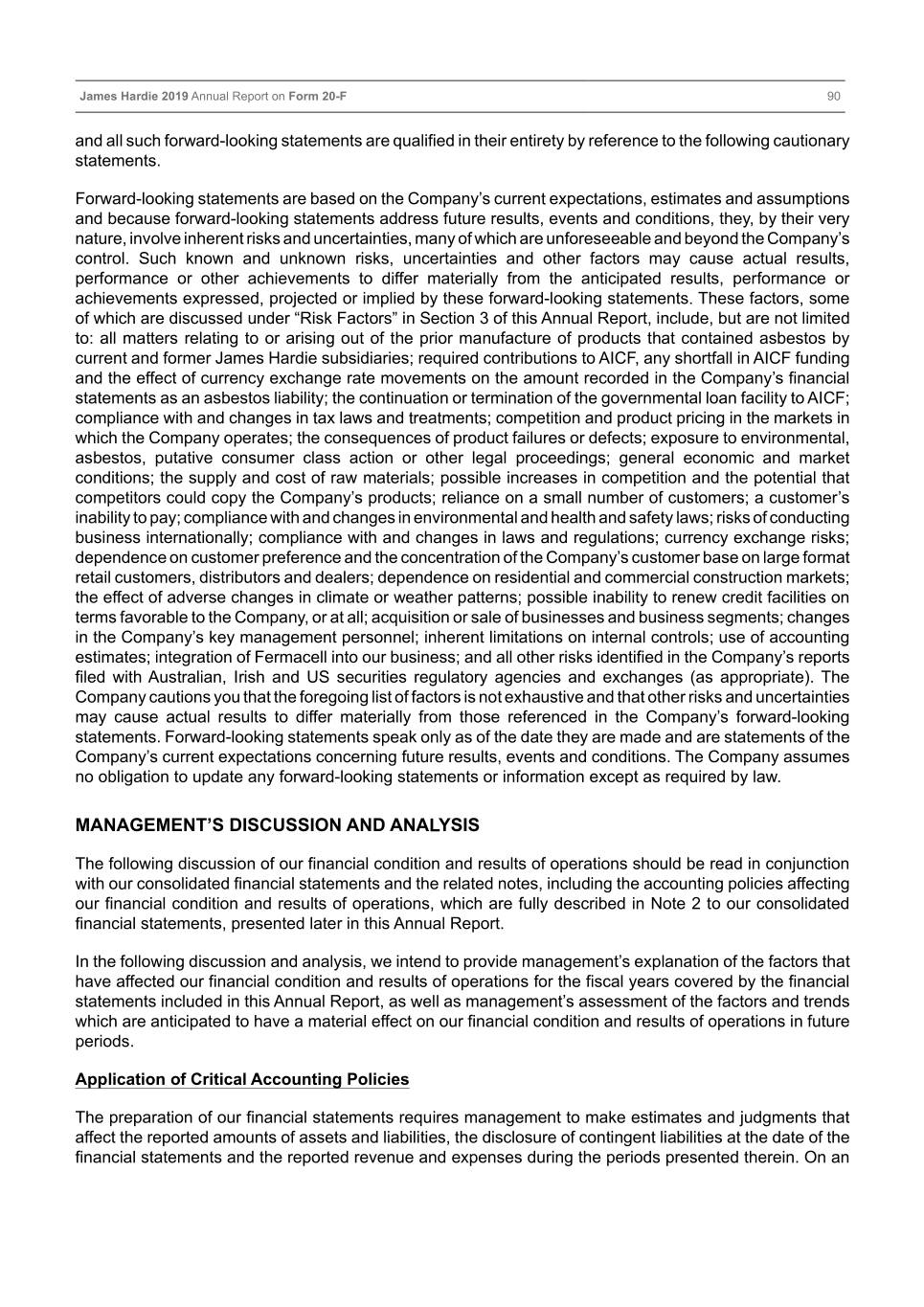
Table of Contents James Hardie 2019 Annual Report on Form 20-F 90 and all such forward-looking statements are qualified in their entirety by reference to the following cautionary statements. Forward-looking statements are based on the Company’s current expectations, estimates and assumptions and because forward-looking statements address future results, events and conditions, they, by their very nature, involve inherent risks and uncertainties, many of which are unforeseeable and beyond the Company’s control. Such known and unknown risks, uncertainties and other factors may cause actual results, performance or other achievements to differ materially from the anticipated results, performance or achievements expressed, projected or implied by these forward-looking statements. These factors, some of which are discussed under “Risk Factors” in Section 3 of this Annual Report, include, but are not limited to: all matters relating to or arising out of the prior manufacture of products that contained asbestos by current and former James Hardie subsidiaries; required contributions to AICF, any shortfall in AICF funding and the effect of currency exchange rate movements on the amount recorded in the Company’s financial statements as an asbestos liability; the continuation or termination of the governmental loan facility to AICF; compliance with and changes in tax laws and treatments; competition and product pricing in the markets in which the Company operates; the consequences of product failures or defects; exposure to environmental, asbestos, putative consumer class action or other legal proceedings; general economic and market conditions; the supply and cost of raw materials; possible increases in competition and the potential that competitors could copy the Company’s products; reliance on a small number of customers; a customer’s inability to pay; compliance with and changes in environmental and health and safety laws; risks of conducting business internationally; compliance with and changes in laws and regulations; currency exchange risks; dependence on customer preference and the concentration of the Company’s customer base on large format retail customers, distributors and dealers; dependence on residential and commercial construction markets; the effect of adverse changes in climate or weather patterns; possible inability to renew credit facilities on terms favorable to the Company, or at all; acquisition or sale of businesses and business segments; changes in the Company’s key management personnel; inherent limitations on internal controls; use of accounting estimates; integration of Fermacell into our business; and all other risks identified in the Company’s reports filed with Australian, Irish and US securities regulatory agencies and exchanges (as appropriate). The Company cautions you that the foregoing list of factors is not exhaustive and that other risks and uncertainties may cause actual results to differ materially from those referenced in the Company’s forward-looking statements. Forward-looking statements speak only as of the date they are made and are statements of the Company’s current expectations concerning future results, events and conditions. The Company assumes no obligation to update any forward-looking statements or information except as required by law. MANAGEMENT’S DISCUSSION AND ANALYSIS The following discussion of our financial condition and results of operations should be read in conjunction with our consolidated financial statements and the related notes, including the accounting policies affecting our financial condition and results of operations, which are fully described in Note 2 to our consolidated financial statements, presented later in this Annual Report. In the following discussion and analysis, we intend to provide management’s explanation of the factors that have affected our financial condition and results of operations for the fiscal years covered by the financial statements included in this Annual Report, as well as management’s assessment of the factors and trends which are anticipated to have a material effect on our financial condition and results of operations in future periods. Application of Critical Accounting Policies The preparation of our financial statements requires management to make estimates and judgments that affect the reported amounts of assets and liabilities, the disclosure of contingent liabilities at the date of the financial statements and the reported revenue and expenses during the periods presented therein. On an
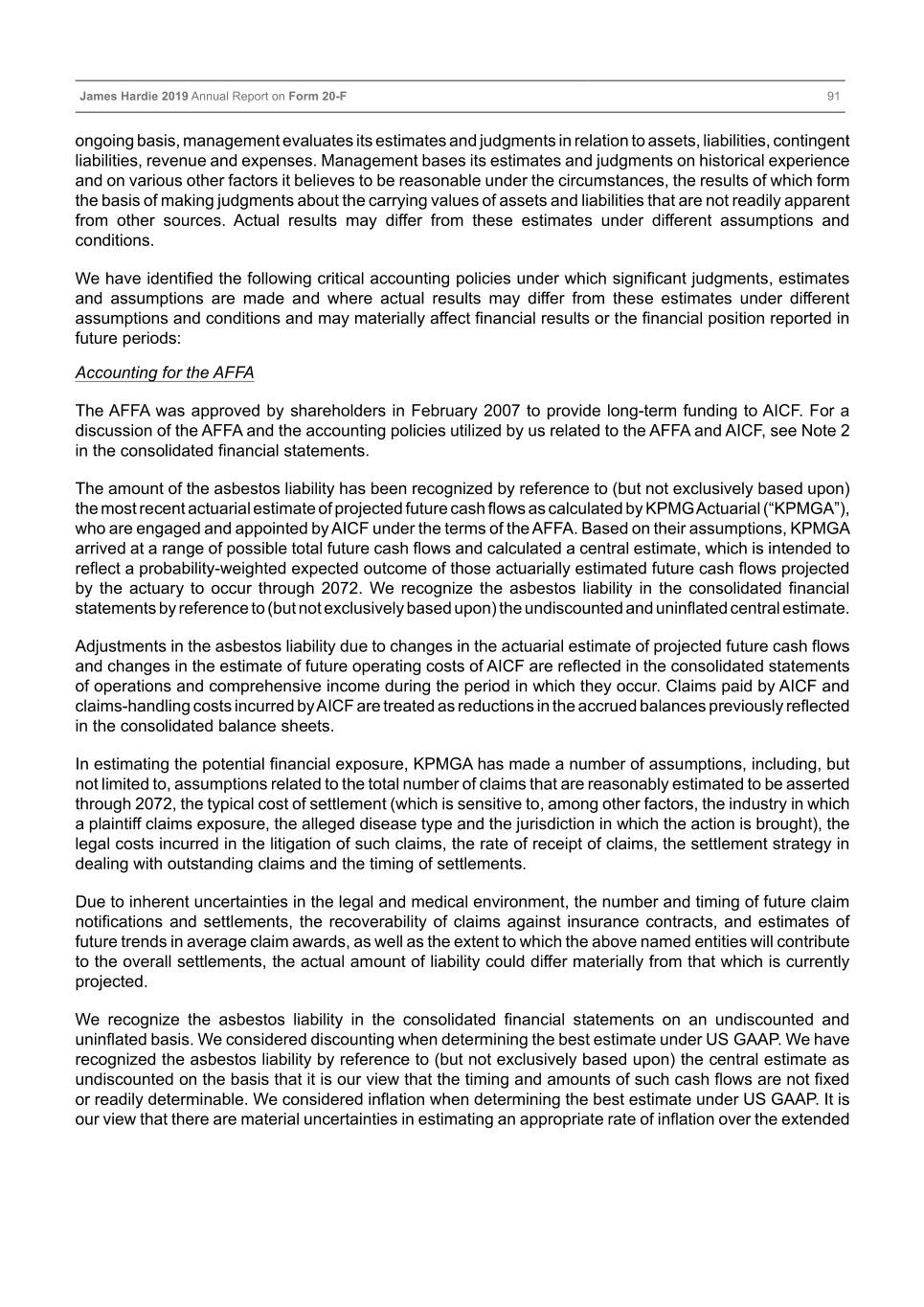
Table of Contents James Hardie 2019 Annual Report on Form 20-F 91 ongoing basis, management evaluates its estimates and judgments in relation to assets, liabilities, contingent liabilities, revenue and expenses. Management bases its estimates and judgments on historical experience and on various other factors it believes to be reasonable under the circumstances, the results of which form the basis of making judgments about the carrying values of assets and liabilities that are not readily apparent from other sources. Actual results may differ from these estimates under different assumptions and conditions. We have identified the following critical accounting policies under which significant judgments, estimates and assumptions are made and where actual results may differ from these estimates under different assumptions and conditions and may materially affect financial results or the financial position reported in future periods: Accounting for the AFFA The AFFA was approved by shareholders in February 2007 to provide long-term funding to AICF. For a discussion of the AFFA and the accounting policies utilized by us related to the AFFA and AICF, see Note 2 in the consolidated financial statements. The amount of the asbestos liability has been recognized by reference to (but not exclusively based upon) the most recent actuarial estimate of projected future cash flows as calculated by KPMG Actuarial (“KPMGA”), who are engaged and appointed by AICF under the terms of the AFFA. Based on their assumptions, KPMGA arrived at a range of possible total future cash flows and calculated a central estimate, which is intended to reflect a probability-weighted expected outcome of those actuarially estimated future cash flows projected by the actuary to occur through 2072. We recognize the asbestos liability in the consolidated financial statements by reference to (but not exclusively based upon) the undiscounted and uninflated central estimate. Adjustments in the asbestos liability due to changes in the actuarial estimate of projected future cash flows and changes in the estimate of future operating costs of AICF are reflected in the consolidated statements of operations and comprehensive income during the period in which they occur. Claims paid by AICF and claims-handling costs incurred by AICF are treated as reductions in the accrued balances previously reflected in the consolidated balance sheets. In estimating the potential financial exposure, KPMGA has made a number of assumptions, including, but not limited to, assumptions related to the total number of claims that are reasonably estimated to be asserted through 2072, the typical cost of settlement (which is sensitive to, among other factors, the industry in which a plaintiff claims exposure, the alleged disease type and the jurisdiction in which the action is brought), the legal costs incurred in the litigation of such claims, the rate of receipt of claims, the settlement strategy in dealing with outstanding claims and the timing of settlements. Due to inherent uncertainties in the legal and medical environment, the number and timing of future claim notifications and settlements, the recoverability of claims against insurance contracts, and estimates of future trends in average claim awards, as well as the extent to which the above named entities will contribute to the overall settlements, the actual amount of liability could differ materially from that which is currently projected. We recognize the asbestos liability in the consolidated financial statements on an undiscounted and uninflated basis. We considered discounting when determining the best estimate under US GAAP. We have recognized the asbestos liability by reference to (but not exclusively based upon) the central estimate as undiscounted on the basis that it is our view that the timing and amounts of such cash flows are not fixed or readily determinable. We considered inflation when determining the best estimate under US GAAP. It is our view that there are material uncertainties in estimating an appropriate rate of inflation over the extended

Table of Contents James Hardie 2019 Annual Report on Form 20-F 92 period of the AFFA. We view the undiscounted and uninflated central estimate as the best estimate under US GAAP. An updated actuarial assessment is performed as of 31 March each year. Any changes in the estimate will be reflected as a charge or credit to the consolidated statements of operations for the year then ended. Material adverse changes to the actuarial estimate would have an adverse effect on our business, results of operations and financial condition. A copy of KPMGA’s actuarial assessment as at 31 March 2019 is available on the Investor Relations area of our website (www.ir.jameshardie.com.au). Sales Rebates and Discounts We record estimated reductions to sales for customer rebates and discounts including volume, promotional, cash and other rebates and discounts. Rebates and discounts are recorded based on management’s best estimate when products are sold. The estimates are based on historical experience for similar programs and products. Management reviews these rebates and discounts on an ongoing basis and the related accruals are adjusted, if necessary, as additional information becomes available. Accounts Receivable We evaluate the collectability of accounts receivable on an ongoing basis based on historical bad debts, customer credit-worthiness, current economic trends and changes in our customer payment activity. An allowance for doubtful accounts is provided for known and estimated bad debts. Although credit losses have historically been within our expectations, we cannot guarantee that we will continue to experience the same credit loss rates that we have in the past. Because our accounts receivable are concentrated in a relatively small number of customers, a significant change in the liquidity or financial position of any of these customers could impact their ability to make payments and result in the need for additional allowances which would decrease our net sales. Inventory Inventories are recorded at the lower of cost or net realizable value. In order to determine net realizable value, management regularly reviews inventory quantities on hand and evaluates significant items to determine whether they are excess, slow-moving or obsolete. The estimated value of excess, slow-moving and obsolete inventory is recorded as a reduction to inventory and an expense in cost of sales in the period in which it is identified. This estimate requires management to make judgments about the future demand for inventory and is therefore at risk to change from period to period. If our estimate for the future demand for inventory is greater than actual demand and we fail to reduce manufacturing output accordingly, we could be required to record additional inventory reserves, which would have a negative impact on our gross profit. Further, we have distributor arrangements that we maintain with certain customers where we own inventory that is physically located in a customer’s or third party’s warehouse. As a result, our ability to effectively manage inventory levels may be impaired, which would cause our total inventory turns to decrease. In that event, our expenses associated with excess and obsolete inventory could increase and our cash flow could be negatively impacted. Accrued Warranty Reserve We have offered, and continue to offer, various warranties on our products, including a 30-year limited warranty on certain of our fiber cement siding products in the United States. Because our fiber cement products have only been used in North America since the early 1990s, there is a risk that these products will not perform in accordance with our expectations over an extended period of time. A typical warranty program requires that we replace defective products within a specified time period from the date of sale.
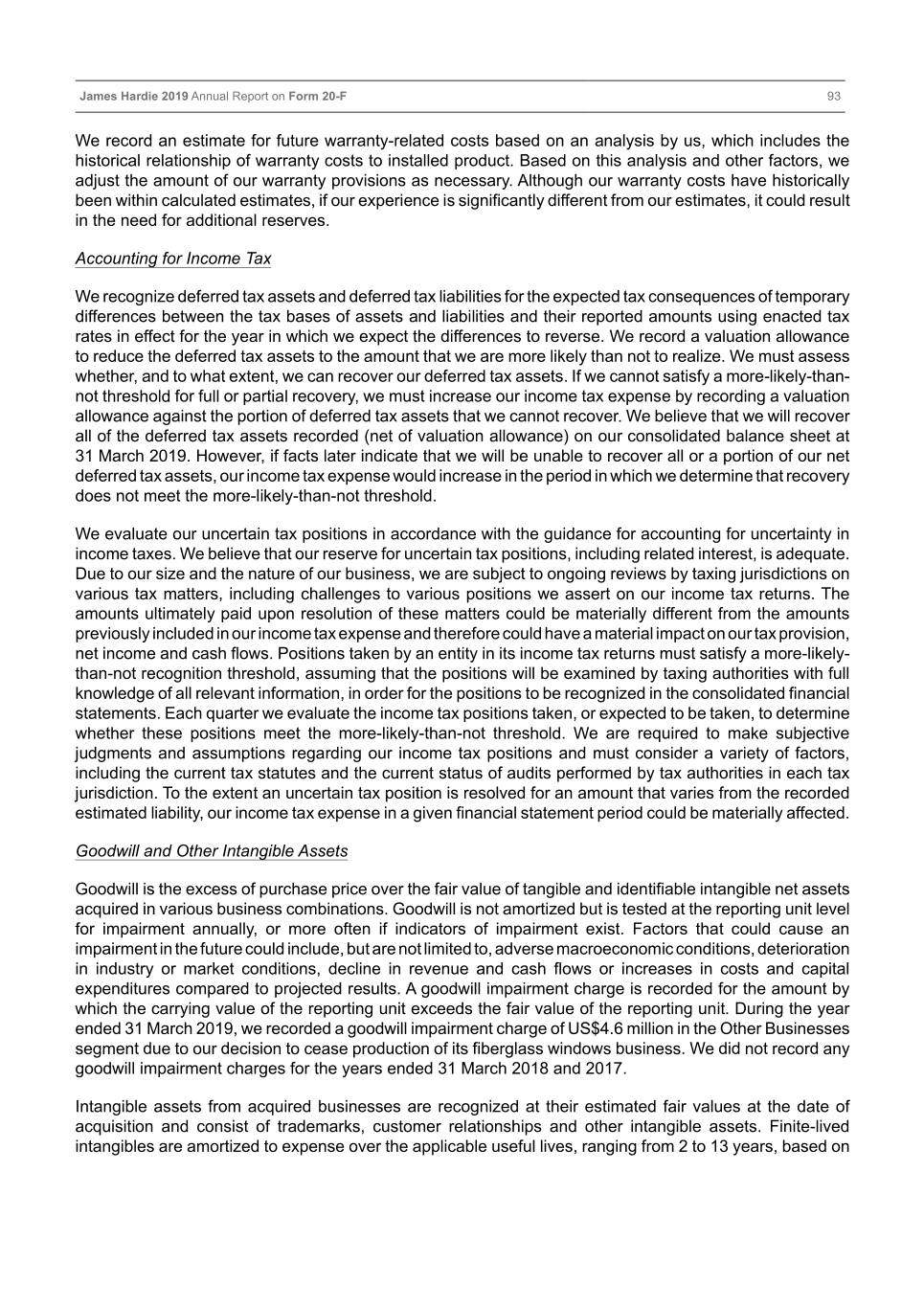
Table of Contents James Hardie 2019 Annual Report on Form 20-F 93 We record an estimate for future warranty-related costs based on an analysis by us, which includes the historical relationship of warranty costs to installed product. Based on this analysis and other factors, we adjust the amount of our warranty provisions as necessary. Although our warranty costs have historically been within calculated estimates, if our experience is significantly different from our estimates, it could result in the need for additional reserves. Accounting for Income Tax We recognize deferred tax assets and deferred tax liabilities for the expected tax consequences of temporary differences between the tax bases of assets and liabilities and their reported amounts using enacted tax rates in effect for the year in which we expect the differences to reverse. We record a valuation allowance to reduce the deferred tax assets to the amount that we are more likely than not to realize. We must assess whether, and to what extent, we can recover our deferred tax assets. If we cannot satisfy a more-likely-than- not threshold for full or partial recovery, we must increase our income tax expense by recording a valuation allowance against the portion of deferred tax assets that we cannot recover. We believe that we will recover all of the deferred tax assets recorded (net of valuation allowance) on our consolidated balance sheet at 31 March 2019. However, if facts later indicate that we will be unable to recover all or a portion of our net deferred tax assets, our income tax expense would increase in the period in which we determine that recovery does not meet the more-likely-than-not threshold. We evaluate our uncertain tax positions in accordance with the guidance for accounting for uncertainty in income taxes. We believe that our reserve for uncertain tax positions, including related interest, is adequate. Due to our size and the nature of our business, we are subject to ongoing reviews by taxing jurisdictions on various tax matters, including challenges to various positions we assert on our income tax returns. The amounts ultimately paid upon resolution of these matters could be materially different from the amounts previously included in our income tax expense and therefore could have a material impact on our tax provision, net income and cash flows. Positions taken by an entity in its income tax returns must satisfy a more-likely- than-not recognition threshold, assuming that the positions will be examined by taxing authorities with full knowledge of all relevant information, in order for the positions to be recognized in the consolidated financial statements. Each quarter we evaluate the income tax positions taken, or expected to be taken, to determine whether these positions meet the more-likely-than-not threshold. We are required to make subjective judgments and assumptions regarding our income tax positions and must consider a variety of factors, including the current tax statutes and the current status of audits performed by tax authorities in each tax jurisdiction. To the extent an uncertain tax position is resolved for an amount that varies from the recorded estimated liability, our income tax expense in a given financial statement period could be materially affected. Goodwill and Other Intangible Assets Goodwill is the excess of purchase price over the fair value of tangible and identifiable intangible net assets acquired in various business combinations. Goodwill is not amortized but is tested at the reporting unit level for impairment annually, or more often if indicators of impairment exist. Factors that could cause an impairment in the future could include, but are not limited to, adverse macroeconomic conditions, deterioration in industry or market conditions, decline in revenue and cash flows or increases in costs and capital expenditures compared to projected results. A goodwill impairment charge is recorded for the amount by which the carrying value of the reporting unit exceeds the fair value of the reporting unit. During the year ended 31 March 2019, we recorded a goodwill impairment charge of US$4.6 million in the Other Businesses segment due to our decision to cease production of its fiberglass windows business. We did not record any goodwill impairment charges for the years ended 31 March 2018 and 2017. Intangible assets from acquired businesses are recognized at their estimated fair values at the date of acquisition and consist of trademarks, customer relationships and other intangible assets. Finite-lived intangibles are amortized to expense over the applicable useful lives, ranging from 2 to 13 years, based on
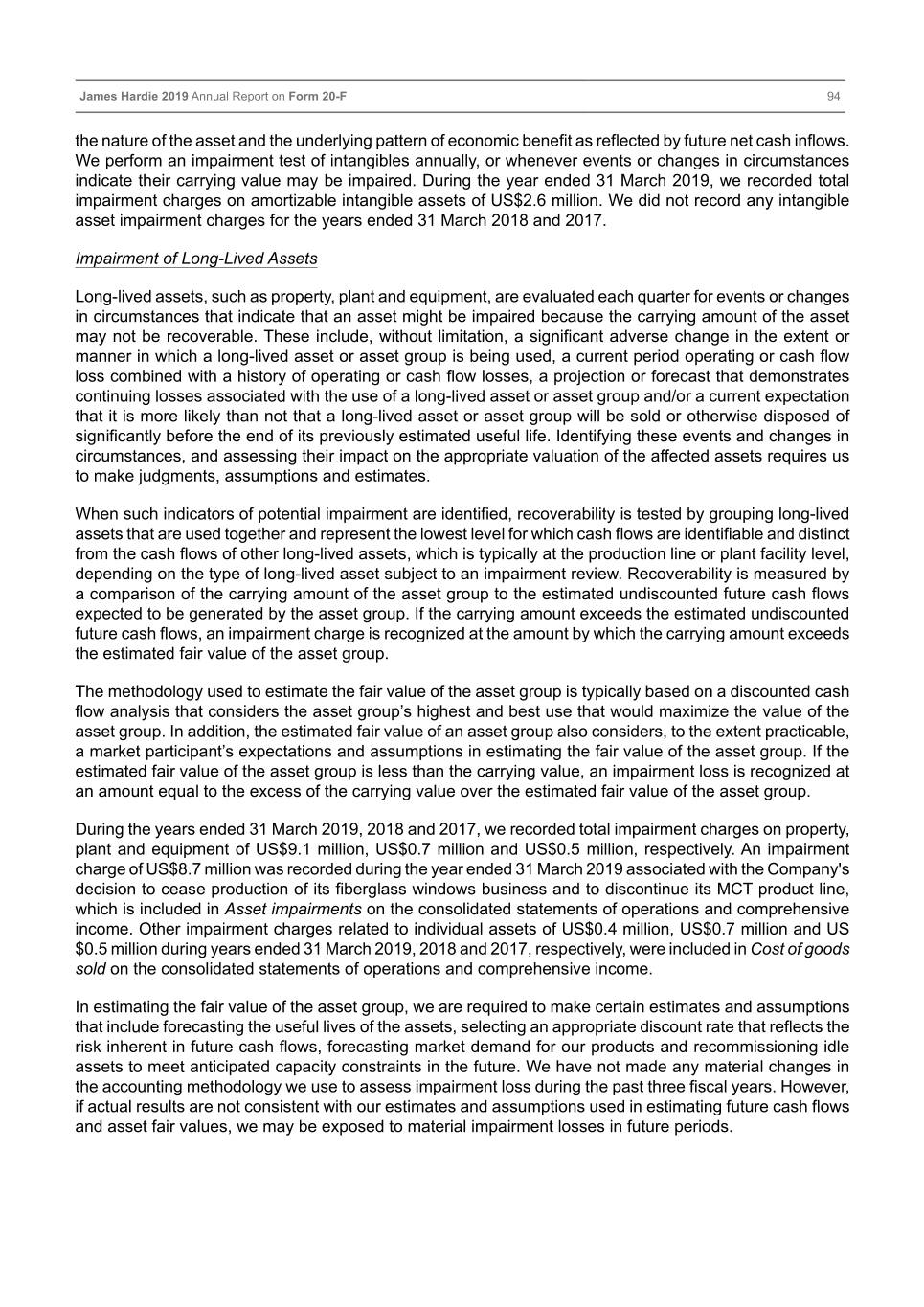
Table of Contents James Hardie 2019 Annual Report on Form 20-F 94 the nature of the asset and the underlying pattern of economic benefit as reflected by future net cash inflows. We perform an impairment test of intangibles annually, or whenever events or changes in circumstances indicate their carrying value may be impaired. During the year ended 31 March 2019, we recorded total impairment charges on amortizable intangible assets of US$2.6 million. We did not record any intangible asset impairment charges for the years ended 31 March 2018 and 2017. Impairment of Long-Lived Assets Long-lived assets, such as property, plant and equipment, are evaluated each quarter for events or changes in circumstances that indicate that an asset might be impaired because the carrying amount of the asset may not be recoverable. These include, without limitation, a significant adverse change in the extent or manner in which a long-lived asset or asset group is being used, a current period operating or cash flow loss combined with a history of operating or cash flow losses, a projection or forecast that demonstrates continuing losses associated with the use of a long-lived asset or asset group and/or a current expectation that it is more likely than not that a long-lived asset or asset group will be sold or otherwise disposed of significantly before the end of its previously estimated useful life. Identifying these events and changes in circumstances, and assessing their impact on the appropriate valuation of the affected assets requires us to make judgments, assumptions and estimates. When such indicators of potential impairment are identified, recoverability is tested by grouping long-lived assets that are used together and represent the lowest level for which cash flows are identifiable and distinct from the cash flows of other long-lived assets, which is typically at the production line or plant facility level, depending on the type of long-lived asset subject to an impairment review. Recoverability is measured by a comparison of the carrying amount of the asset group to the estimated undiscounted future cash flows expected to be generated by the asset group. If the carrying amount exceeds the estimated undiscounted future cash flows, an impairment charge is recognized at the amount by which the carrying amount exceeds the estimated fair value of the asset group. The methodology used to estimate the fair value of the asset group is typically based on a discounted cash flow analysis that considers the asset group’s highest and best use that would maximize the value of the asset group. In addition, the estimated fair value of an asset group also considers, to the extent practicable, a market participant’s expectations and assumptions in estimating the fair value of the asset group. If the estimated fair value of the asset group is less than the carrying value, an impairment loss is recognized at an amount equal to the excess of the carrying value over the estimated fair value of the asset group. During the years ended 31 March 2019, 2018 and 2017, we recorded total impairment charges on property, plant and equipment of US$9.1 million, US$0.7 million and US$0.5 million, respectively. An impairment charge of US$8.7 million was recorded during the year ended 31 March 2019 associated with the Company's decision to cease production of its fiberglass windows business and to discontinue its MCT product line, which is included in Asset impairments on the consolidated statements of operations and comprehensive income. Other impairment charges related to individual assets of US$0.4 million, US$0.7 million and US $0.5 million during years ended 31 March 2019, 2018 and 2017, respectively, were included in Cost of goods sold on the consolidated statements of operations and comprehensive income. In estimating the fair value of the asset group, we are required to make certain estimates and assumptions that include forecasting the useful lives of the assets, selecting an appropriate discount rate that reflects the risk inherent in future cash flows, forecasting market demand for our products and recommissioning idle assets to meet anticipated capacity constraints in the future. We have not made any material changes in the accounting methodology we use to assess impairment loss during the past three fiscal years. However, if actual results are not consistent with our estimates and assumptions used in estimating future cash flows and asset fair values, we may be exposed to material impairment losses in future periods.
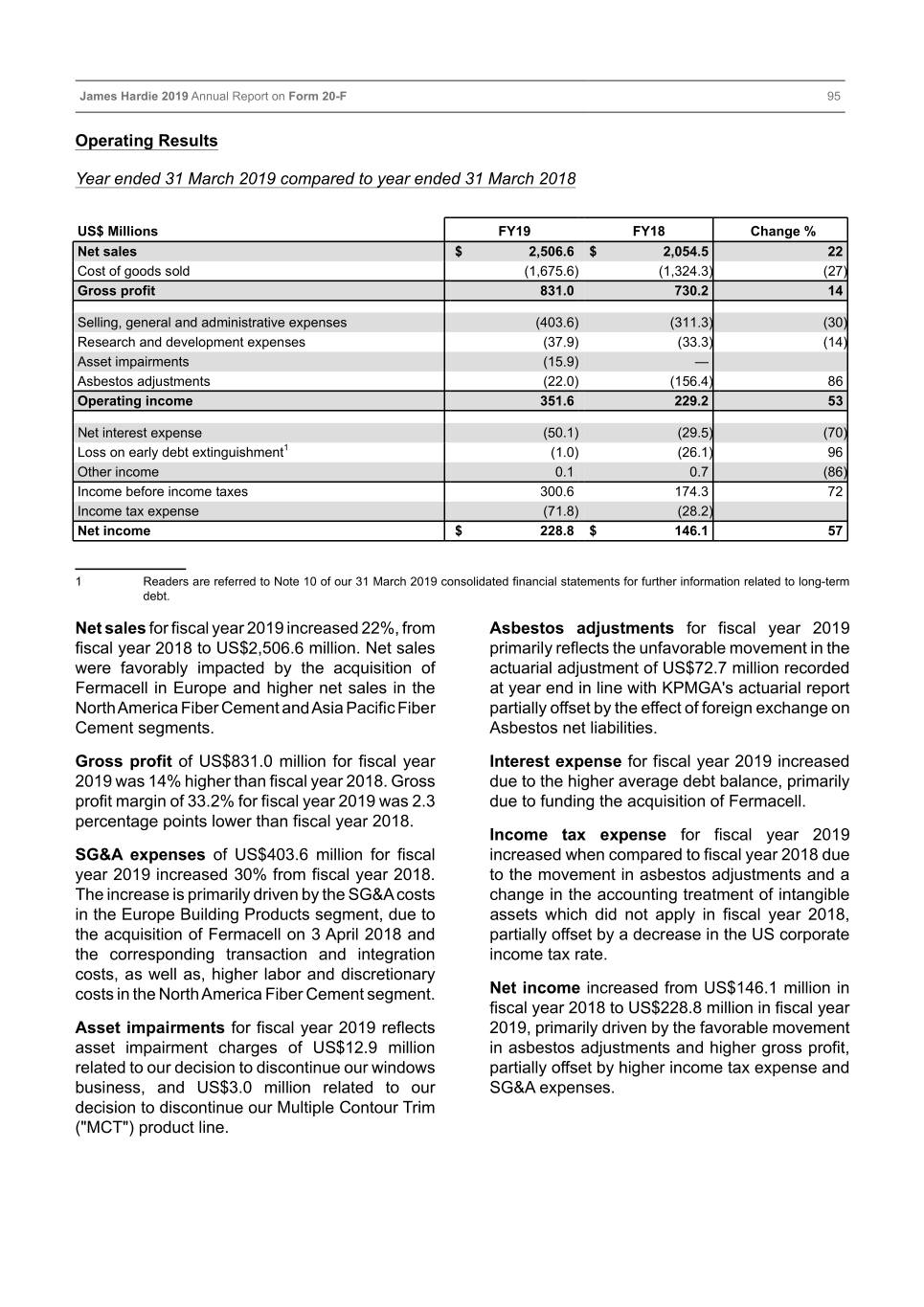
Table of Contents James Hardie 2019 Annual Report on Form 20-F 95 Operating Results Year ended 31 March 2019 compared to year ended 31 March 2018 US$ Millions FY19 FY18 Change % Net sales $ 2,506.6 $ 2,054.5 22 Cost of goods sold (1,675.6) (1,324.3) (27) Gross profit 831.0 730.2 14 Selling, general and administrative expenses (403.6) (311.3) (30) Research and development expenses (37.9) (33.3) (14) Asset impairments (15.9) — Asbestos adjustments (22.0) (156.4) 86 Operating income 351.6 229.2 53 Net interest expense (50.1) (29.5) (70) Loss on early debt extinguishment1 (1.0) (26.1) 96 Other income 0.1 0.7 (86) Income before income taxes 300.6 174.3 72 Income tax expense (71.8) (28.2) Net income $ 228.8 $ 146.1 57 ____________ 1 Readers are referred to Note 10 of our 31 March 2019 consolidated financial statements for further information related to long-term debt. Net sales for fiscal year 2019 increased 22%, from Asbestos adjustments for fiscal year 2019 fiscal year 2018 to US$2,506.6 million. Net sales primarily reflects the unfavorable movement in the were favorably impacted by the acquisition of actuarial adjustment of US$72.7 million recorded Fermacell in Europe and higher net sales in the at year end in line with KPMGA's actuarial report North America Fiber Cement and Asia Pacific Fiber partially offset by the effect of foreign exchange on Cement segments. Asbestos net liabilities. Gross profit of US$831.0 million for fiscal year Interest expense for fiscal year 2019 increased 2019 was 14% higher than fiscal year 2018. Gross due to the higher average debt balance, primarily profit margin of 33.2% for fiscal year 2019 was 2.3 due to funding the acquisition of Fermacell. percentage points lower than fiscal year 2018. Income tax expense for fiscal year 2019 SG&A expenses of US$403.6 million for fiscal increased when compared to fiscal year 2018 due year 2019 increased 30% from fiscal year 2018. to the movement in asbestos adjustments and a The increase is primarily driven by the SG&A costs change in the accounting treatment of intangible in the Europe Building Products segment, due to assets which did not apply in fiscal year 2018, the acquisition of Fermacell on 3 April 2018 and partially offset by a decrease in the US corporate the corresponding transaction and integration income tax rate. costs, as well as, higher labor and discretionary costs in the North America Fiber Cement segment. Net income increased from US$146.1 million in fiscal year 2018 to US$228.8 million in fiscal year Asset impairments for fiscal year 2019 reflects 2019, primarily driven by the favorable movement asset impairment charges of US$12.9 million in asbestos adjustments and higher gross profit, related to our decision to discontinue our windows partially offset by higher income tax expense and business, and US$3.0 million related to our SG&A expenses. decision to discontinue our Multiple Contour Trim ("MCT") product line.
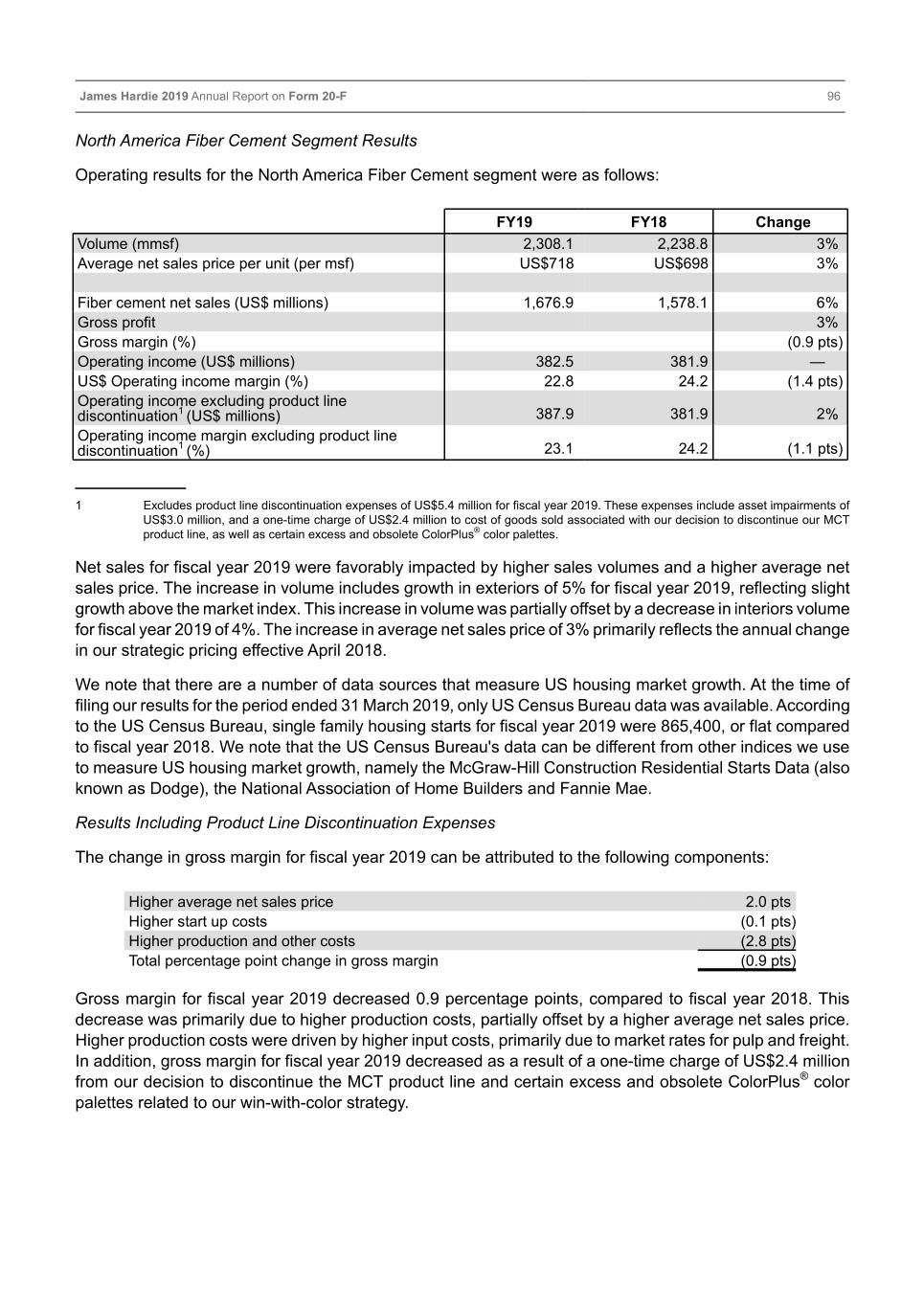
Table of Contents James Hardie 2019 Annual Report on Form 20-F 96 North America Fiber Cement Segment Results Operating results for the North America Fiber Cement segment were as follows: FY19 FY18 Change Volume (mmsf) 2,308.1 2,238.8 3% Average net sales price per unit (per msf) US$718 US$698 3% Fiber cement net sales (US$ millions) 1,676.9 1,578.1 6% Gross profit 3% Gross margin (%) (0.9 pts) Operating income (US$ millions) 382.5 381.9 — US$ Operating income margin (%) 22.8 24.2 (1.4 pts) Operating income excluding product line discontinuation1 (US$ millions) 387.9 381.9 2% Operating income margin excluding product line discontinuation1 (%) 23.1 24.2 (1.1 pts) ____________ 1 Excludes product line discontinuation expenses of US$5.4 million for fiscal year 2019. These expenses include asset impairments of US$3.0 million, and a one-time charge of US$2.4 million to cost of goods sold associated with our decision to discontinue our MCT product line, as well as certain excess and obsolete ColorPlus® color palettes. Net sales for fiscal year 2019 were favorably impacted by higher sales volumes and a higher average net sales price. The increase in volume includes growth in exteriors of 5% for fiscal year 2019, reflecting slight growth above the market index. This increase in volume was partially offset by a decrease in interiors volume for fiscal year 2019 of 4%. The increase in average net sales price of 3% primarily reflects the annual change in our strategic pricing effective April 2018. We note that there are a number of data sources that measure US housing market growth. At the time of filing our results for the period ended 31 March 2019, only US Census Bureau data was available. According to the US Census Bureau, single family housing starts for fiscal year 2019 were 865,400, or flat compared to fiscal year 2018. We note that the US Census Bureau's data can be different from other indices we use to measure US housing market growth, namely the McGraw-Hill Construction Residential Starts Data (also known as Dodge), the National Association of Home Builders and Fannie Mae. Results Including Product Line Discontinuation Expenses The change in gross margin for fiscal year 2019 can be attributed to the following components: Higher average net sales price 2.0 pts Higher start up costs (0.1 pts) Higher production and other costs (2.8 pts) Total percentage point change in gross margin (0.9 pts) Gross margin for fiscal year 2019 decreased 0.9 percentage points, compared to fiscal year 2018. This decrease was primarily due to higher production costs, partially offset by a higher average net sales price. Higher production costs were driven by higher input costs, primarily due to market rates for pulp and freight. In addition, gross margin for fiscal year 2019 decreased as a result of a one-time charge of US$2.4 million from our decision to discontinue the MCT product line and certain excess and obsolete ColorPlus® color palettes related to our win-with-color strategy.
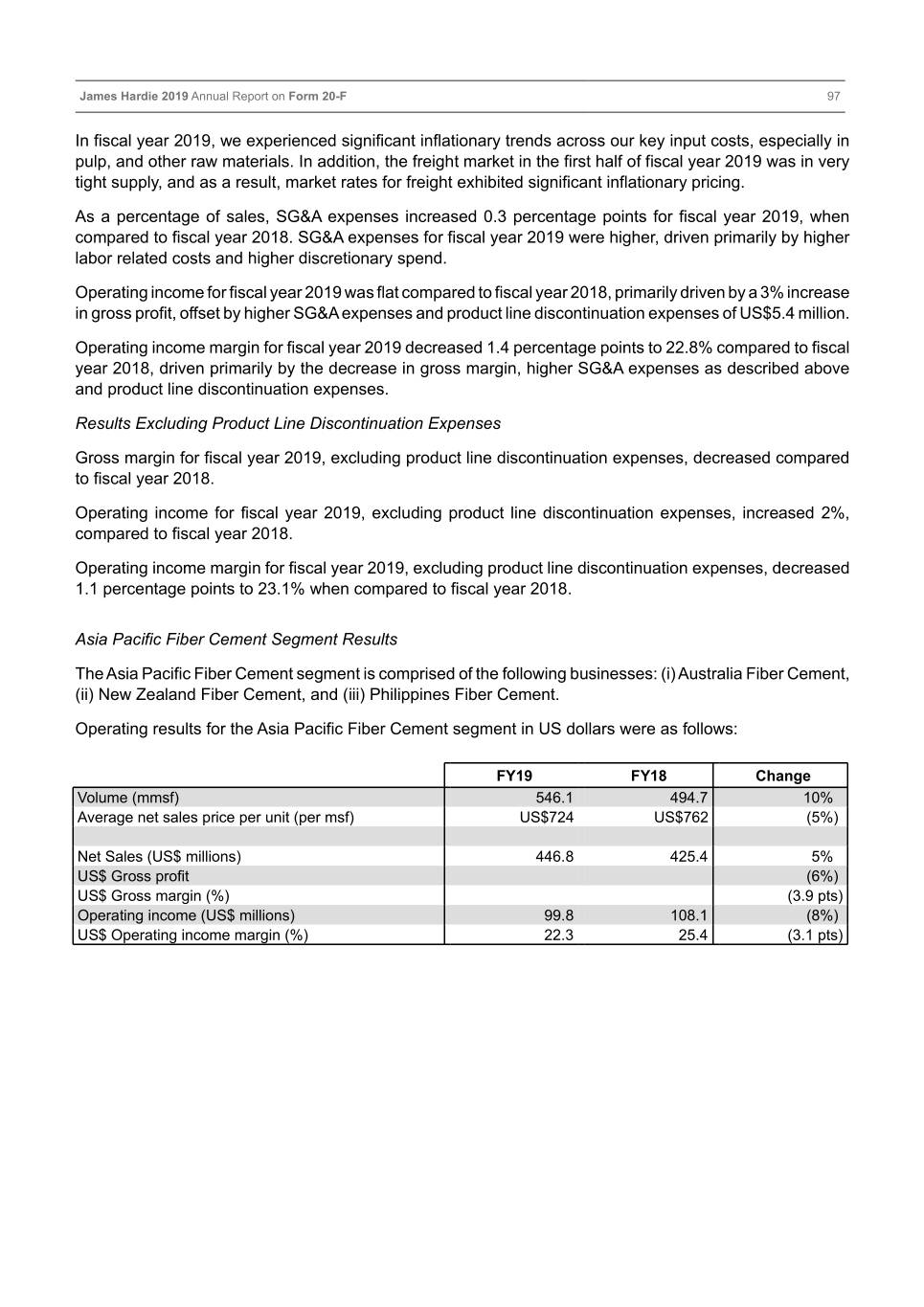
Table of Contents James Hardie 2019 Annual Report on Form 20-F 97 In fiscal year 2019, we experienced significant inflationary trends across our key input costs, especially in pulp, and other raw materials. In addition, the freight market in the first half of fiscal year 2019 was in very tight supply, and as a result, market rates for freight exhibited significant inflationary pricing. As a percentage of sales, SG&A expenses increased 0.3 percentage points for fiscal year 2019, when compared to fiscal year 2018. SG&A expenses for fiscal year 2019 were higher, driven primarily by higher labor related costs and higher discretionary spend. Operating income for fiscal year 2019 was flat compared to fiscal year 2018, primarily driven by a 3% increase in gross profit, offset by higher SG&A expenses and product line discontinuation expenses of US$5.4 million. Operating income margin for fiscal year 2019 decreased 1.4 percentage points to 22.8% compared to fiscal year 2018, driven primarily by the decrease in gross margin, higher SG&A expenses as described above and product line discontinuation expenses. Results Excluding Product Line Discontinuation Expenses Gross margin for fiscal year 2019, excluding product line discontinuation expenses, decreased compared to fiscal year 2018. Operating income for fiscal year 2019, excluding product line discontinuation expenses, increased 2%, compared to fiscal year 2018. Operating income margin for fiscal year 2019, excluding product line discontinuation expenses, decreased 1.1 percentage points to 23.1% when compared to fiscal year 2018. Asia Pacific Fiber Cement Segment Results The Asia Pacific Fiber Cement segment is comprised of the following businesses: (i) Australia Fiber Cement, (ii) New Zealand Fiber Cement, and (iii) Philippines Fiber Cement. Operating results for the Asia Pacific Fiber Cement segment in US dollars were as follows: FY19 FY18 Change Volume (mmsf) 546.1 494.7 10% Average net sales price per unit (per msf) US$724 US$762 (5%) Net Sales (US$ millions) 446.8 425.4 5% US$ Gross profit (6%) US$ Gross margin (%) (3.9 pts) Operating income (US$ millions) 99.8 108.1 (8%) US$ Operating income margin (%) 22.3 25.4 (3.1 pts)
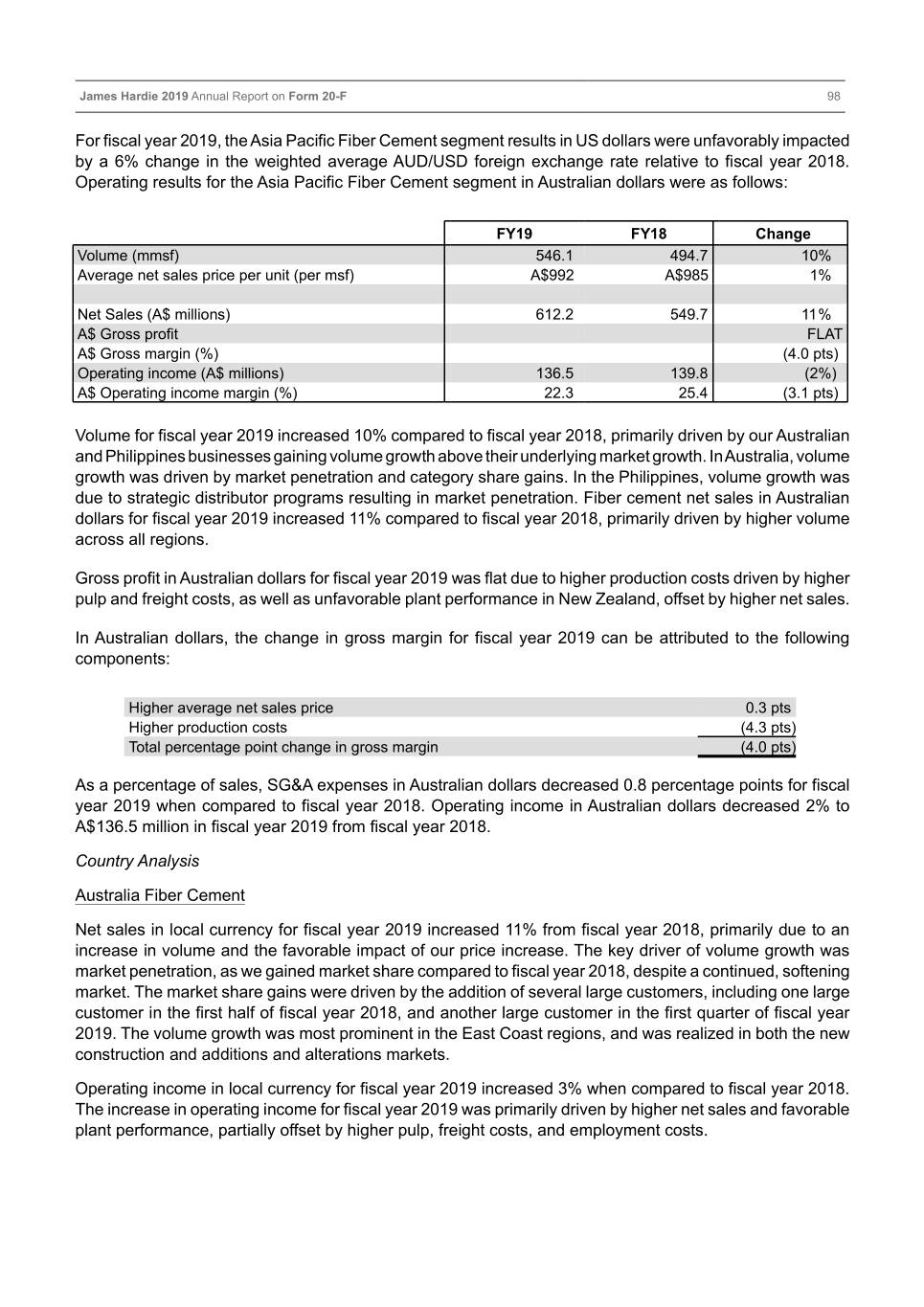
Table of Contents James Hardie 2019 Annual Report on Form 20-F 98 For fiscal year 2019, the Asia Pacific Fiber Cement segment results in US dollars were unfavorably impacted by a 6% change in the weighted average AUD/USD foreign exchange rate relative to fiscal year 2018. Operating results for the Asia Pacific Fiber Cement segment in Australian dollars were as follows: FY19 FY18 Change Volume (mmsf) 546.1 494.7 10% Average net sales price per unit (per msf) A$992 A$985 1% Net Sales (A$ millions) 612.2 549.7 11 % A$ Gross profit FLAT A$ Gross margin (%) (4.0 pts) Operating income (A$ millions) 136.5 139.8 (2%) A$ Operating income margin (%) 22.3 25.4 (3.1 pts) Volume for fiscal year 2019 increased 10% compared to fiscal year 2018, primarily driven by our Australian and Philippines businesses gaining volume growth above their underlying market growth. In Australia, volume growth was driven by market penetration and category share gains. In the Philippines, volume growth was due to strategic distributor programs resulting in market penetration. Fiber cement net sales in Australian dollars for fiscal year 2019 increased 11% compared to fiscal year 2018, primarily driven by higher volume across all regions. Gross profit in Australian dollars for fiscal year 2019 was flat due to higher production costs driven by higher pulp and freight costs, as well as unfavorable plant performance in New Zealand, offset by higher net sales. In Australian dollars, the change in gross margin for fiscal year 2019 can be attributed to the following components: Higher average net sales price 0.3 pts Higher production costs (4.3 pts) Total percentage point change in gross margin (4.0 pts) As a percentage of sales, SG&A expenses in Australian dollars decreased 0.8 percentage points for fiscal year 2019 when compared to fiscal year 2018. Operating income in Australian dollars decreased 2% to A$136.5 million in fiscal year 2019 from fiscal year 2018. Country Analysis Australia Fiber Cement Net sales in local currency for fiscal year 2019 increased 11% from fiscal year 2018, primarily due to an increase in volume and the favorable impact of our price increase. The key driver of volume growth was market penetration, as we gained market share compared to fiscal year 2018, despite a continued, softening market. The market share gains were driven by the addition of several large customers, including one large customer in the first half of fiscal year 2018, and another large customer in the first quarter of fiscal year 2019. The volume growth was most prominent in the East Coast regions, and was realized in both the new construction and additions and alterations markets. Operating income in local currency for fiscal year 2019 increased 3% when compared to fiscal year 2018. The increase in operating income for fiscal year 2019 was primarily driven by higher net sales and favorable plant performance, partially offset by higher pulp, freight costs, and employment costs.
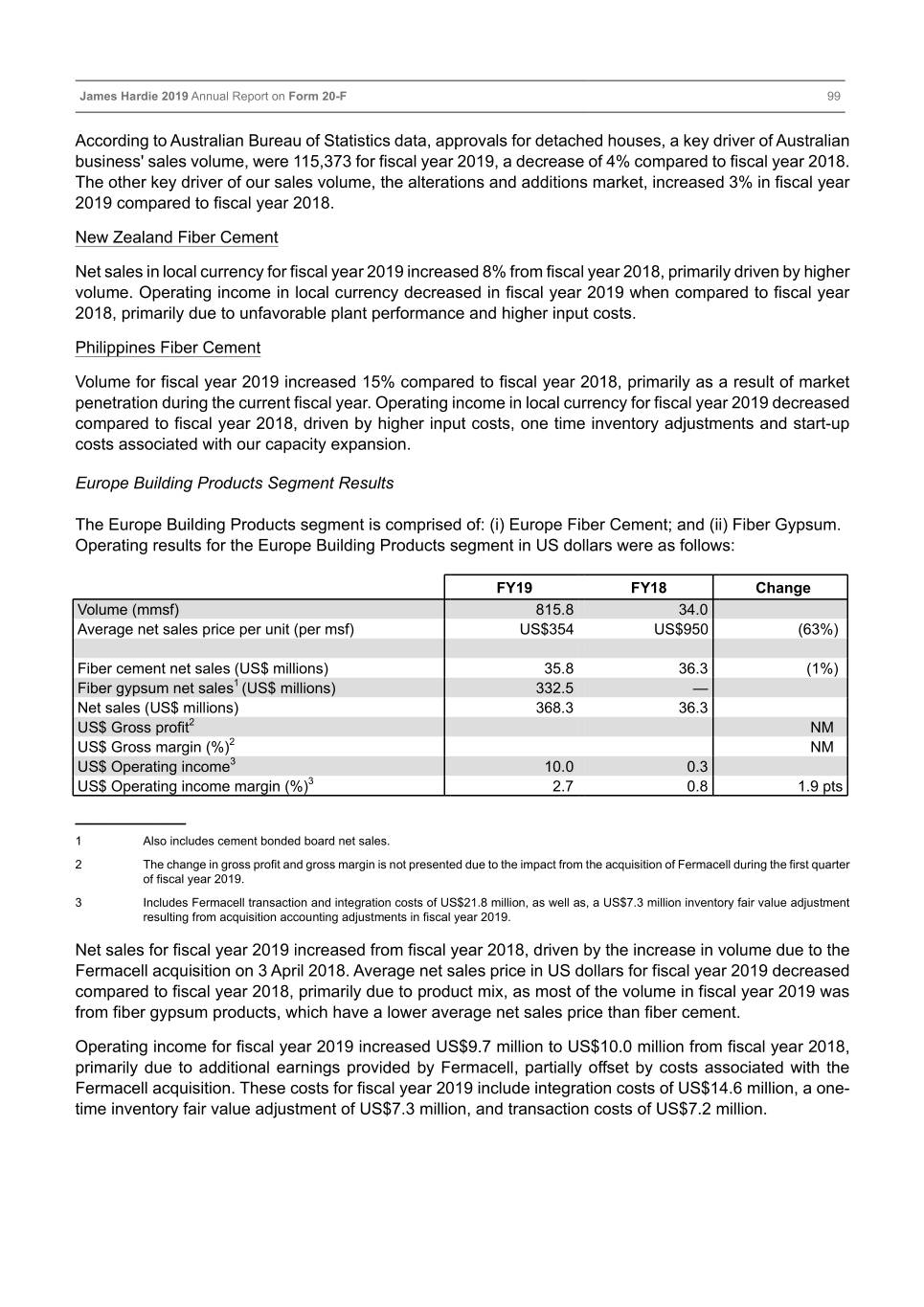
Table of Contents James Hardie 2019 Annual Report on Form 20-F 99 According to Australian Bureau of Statistics data, approvals for detached houses, a key driver of Australian business' sales volume, were 115,373 for fiscal year 2019, a decrease of 4% compared to fiscal year 2018. The other key driver of our sales volume, the alterations and additions market, increased 3% in fiscal year 2019 compared to fiscal year 2018. New Zealand Fiber Cement Net sales in local currency for fiscal year 2019 increased 8% from fiscal year 2018, primarily driven by higher volume. Operating income in local currency decreased in fiscal year 2019 when compared to fiscal year 2018, primarily due to unfavorable plant performance and higher input costs. Philippines Fiber Cement Volume for fiscal year 2019 increased 15% compared to fiscal year 2018, primarily as a result of market penetration during the current fiscal year. Operating income in local currency for fiscal year 2019 decreased compared to fiscal year 2018, driven by higher input costs, one time inventory adjustments and start-up costs associated with our capacity expansion. Europe Building Products Segment Results The Europe Building Products segment is comprised of: (i) Europe Fiber Cement; and (ii) Fiber Gypsum. Operating results for the Europe Building Products segment in US dollars were as follows: FY19 FY18 Change Volume (mmsf) 815.8 34.0 Average net sales price per unit (per msf) US$354 US$950 (63%) Fiber cement net sales (US$ millions) 35.8 36.3 (1%) Fiber gypsum net sales1 (US$ millions) 332.5 — Net sales (US$ millions) 368.3 36.3 US$ Gross profit2 NM US$ Gross margin (%)2 NM US$ Operating income3 10.0 0.3 US$ Operating income margin (%)3 2.7 0.8 1.9 pts ____________ 1 Also includes cement bonded board net sales. 2 The change in gross profit and gross margin is not presented due to the impact from the acquisition of Fermacell during the first quarter of fiscal year 2019. 3 Includes Fermacell transaction and integration costs of US$21.8 million, as well as, a US$7.3 million inventory fair value adjustment resulting from acquisition accounting adjustments in fiscal year 2019. Net sales for fiscal year 2019 increased from fiscal year 2018, driven by the increase in volume due to the Fermacell acquisition on 3 April 2018. Average net sales price in US dollars for fiscal year 2019 decreased compared to fiscal year 2018, primarily due to product mix, as most of the volume in fiscal year 2019 was from fiber gypsum products, which have a lower average net sales price than fiber cement. Operating income for fiscal year 2019 increased US$9.7 million to US$10.0 million from fiscal year 2018, primarily due to additional earnings provided by Fermacell, partially offset by costs associated with the Fermacell acquisition. These costs for fiscal year 2019 include integration costs of US$14.6 million, a one- time inventory fair value adjustment of US$7.3 million, and transaction costs of US$7.2 million.
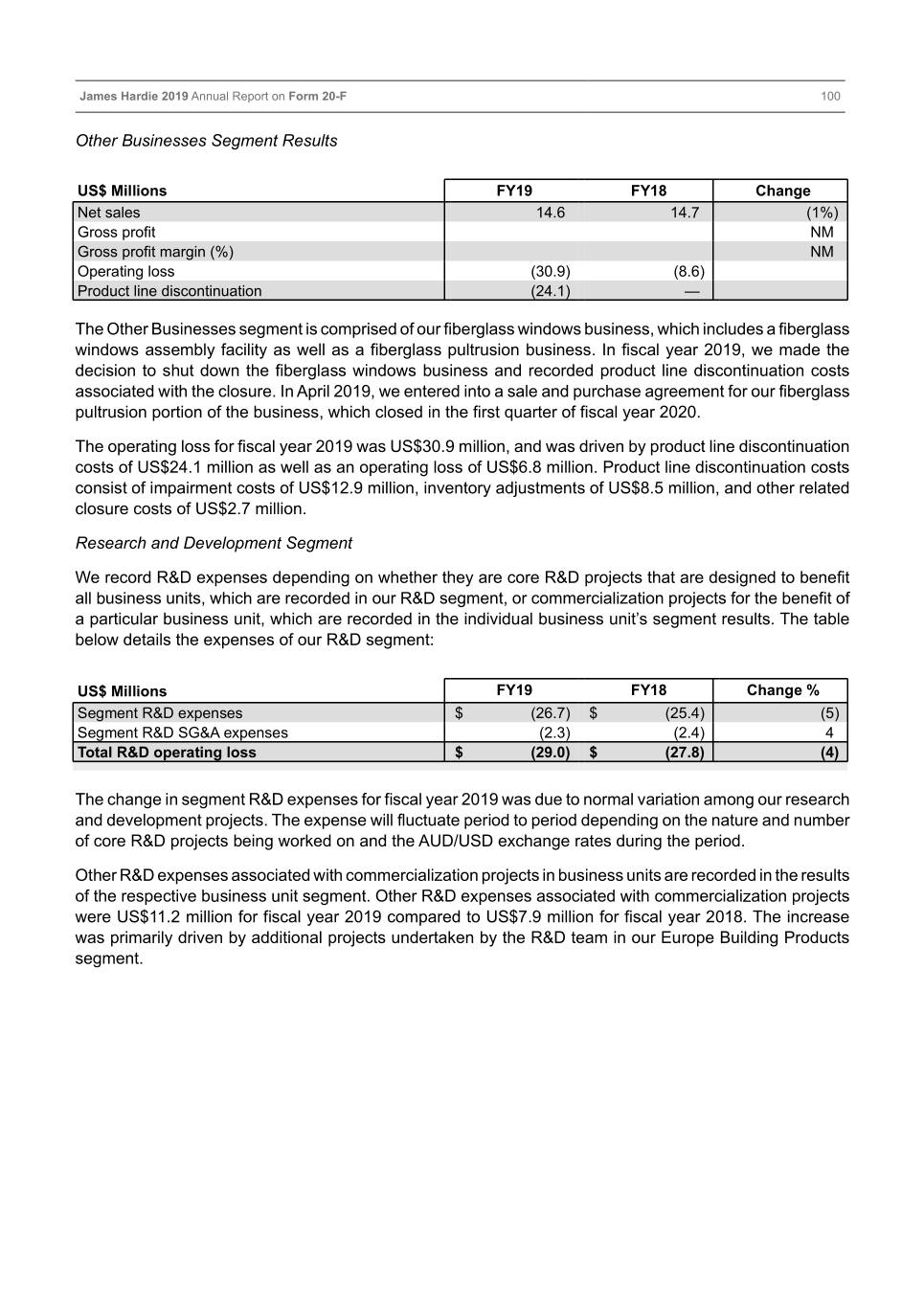
Table of Contents James Hardie 2019 Annual Report on Form 20-F 100 Other Businesses Segment Results US$ Millions FY19 FY18 Change Net sales 14.6 14.7 (1%) Gross profit NM Gross profit margin (%) NM Operating loss (30.9) (8.6) Product line discontinuation (24.1) — The Other Businesses segment is comprised of our fiberglass windows business, which includes a fiberglass windows assembly facility as well as a fiberglass pultrusion business. In fiscal year 2019, we made the decision to shut down the fiberglass windows business and recorded product line discontinuation costs associated with the closure. In April 2019, we entered into a sale and purchase agreement for our fiberglass pultrusion portion of the business, which closed in the first quarter of fiscal year 2020. The operating loss for fiscal year 2019 was US$30.9 million, and was driven by product line discontinuation costs of US$24.1 million as well as an operating loss of US$6.8 million. Product line discontinuation costs consist of impairment costs of US$12.9 million, inventory adjustments of US$8.5 million, and other related closure costs of US$2.7 million. Research and Development Segment We record R&D expenses depending on whether they are core R&D projects that are designed to benefit all business units, which are recorded in our R&D segment, or commercialization projects for the benefit of a particular business unit, which are recorded in the individual business unit’s segment results. The table below details the expenses of our R&D segment: US$ Millions FY19 FY18 Change % Segment R&D expenses $ (26.7) $ (25.4) (5) Segment R&D SG&A expenses (2.3) (2.4) 4 Total R&D operating loss $ (29.0) $ (27.8) (4) The change in segment R&D expenses for fiscal year 2019 was due to normal variation among our research and development projects. The expense will fluctuate period to period depending on the nature and number of core R&D projects being worked on and the AUD/USD exchange rates during the period. Other R&D expenses associated with commercialization projects in business units are recorded in the results of the respective business unit segment. Other R&D expenses associated with commercialization projects were US$11.2 million for fiscal year 2019 compared to US$7.9 million for fiscal year 2018. The increase was primarily driven by additional projects undertaken by the R&D team in our Europe Building Products segment.
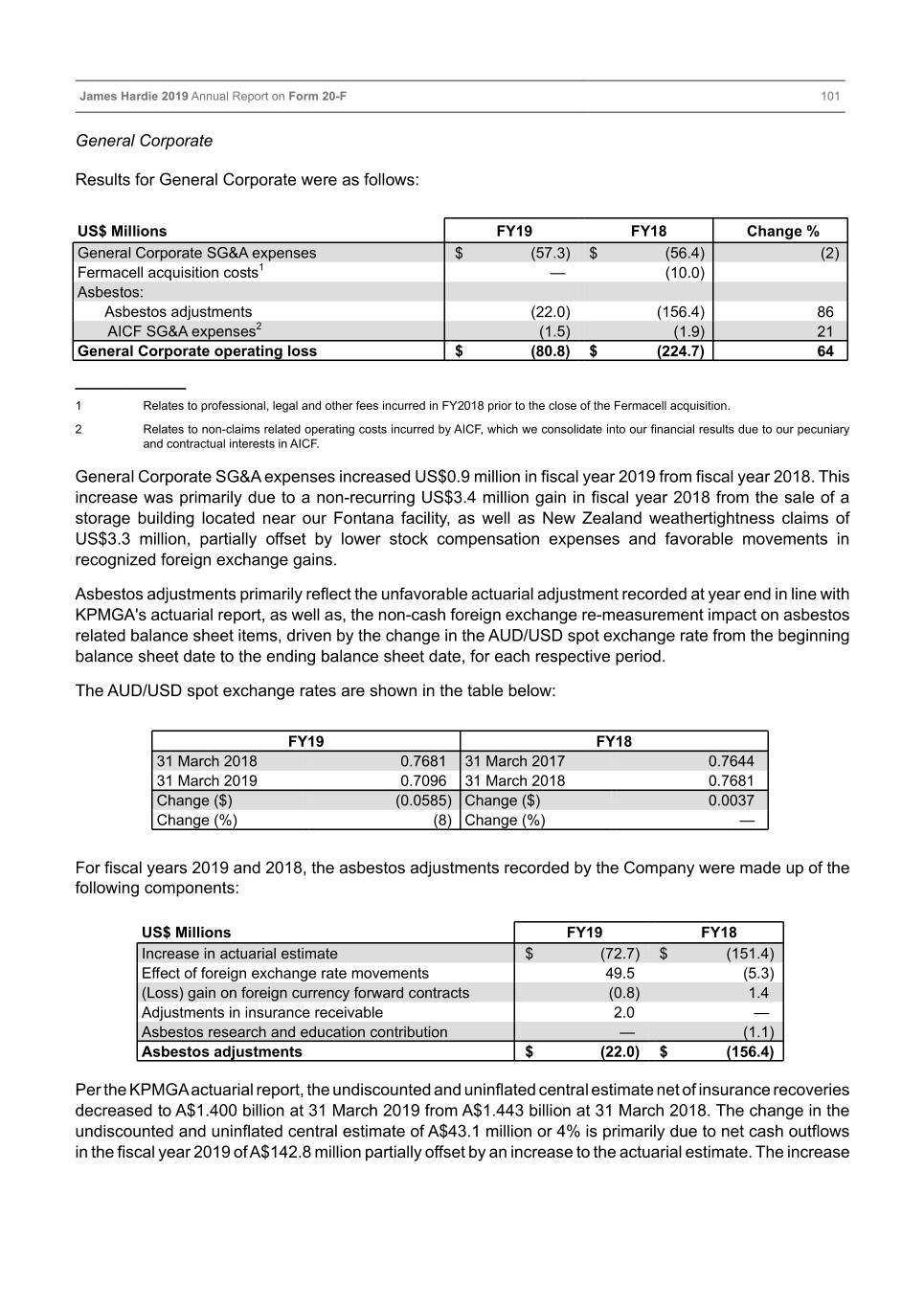
Table of Contents James Hardie 2019 Annual Report on Form 20-F 101 General Corporate Results for General Corporate were as follows: US$ Millions FY19 FY18 Change % General Corporate SG&A expenses $ (57.3) $ (56.4) (2) Fermacell acquisition costs1 — (10.0) Asbestos: Asbestos adjustments (22.0) (156.4) 86 AICF SG&A expenses2 (1.5) (1.9) 21 General Corporate operating loss $ (80.8) $ (224.7) 64 ____________ 1 Relates to professional, legal and other fees incurred in FY2018 prior to the close of the Fermacell acquisition. 2 Relates to non-claims related operating costs incurred by AICF, which we consolidate into our financial results due to our pecuniary and contractual interests in AICF. General Corporate SG&A expenses increased US$0.9 million in fiscal year 2019 from fiscal year 2018. This increase was primarily due to a non-recurring US$3.4 million gain in fiscal year 2018 from the sale of a storage building located near our Fontana facility, as well as New Zealand weathertightness claims of US$3.3 million, partially offset by lower stock compensation expenses and favorable movements in recognized foreign exchange gains. Asbestos adjustments primarily reflect the unfavorable actuarial adjustment recorded at year end in line with KPMGA's actuarial report, as well as, the non-cash foreign exchange re-measurement impact on asbestos related balance sheet items, driven by the change in the AUD/USD spot exchange rate from the beginning balance sheet date to the ending balance sheet date, for each respective period. The AUD/USD spot exchange rates are shown in the table below: FY19 FY18 31 March 2018 0.7681 31 March 2017 0.7644 31 March 2019 0.7096 31 March 2018 0.7681 Change ($) (0.0585) Change ($) 0.0037 Change (%) (8) Change (%) — For fiscal years 2019 and 2018, the asbestos adjustments recorded by the Company were made up of the following components: US$ Millions FY19 FY18 Increase in actuarial estimate $ (72.7) $ (151.4) Effect of foreign exchange rate movements 49.5 (5.3) (Loss) gain on foreign currency forward contracts (0.8) 1.4 Adjustments in insurance receivable 2.0 — Asbestos research and education contribution — (1.1) Asbestos adjustments $ (22.0) $ (156.4) Per the KPMGA actuarial report, the undiscounted and uninflated central estimate net of insurance recoveries decreased to A$1.400 billion at 31 March 2019 from A$1.443 billion at 31 March 2018. The change in the undiscounted and uninflated central estimate of A$43.1 million or 4% is primarily due to net cash outflows in the fiscal year 2019 of A$142.8 million partially offset by an increase to the actuarial estimate. The increase
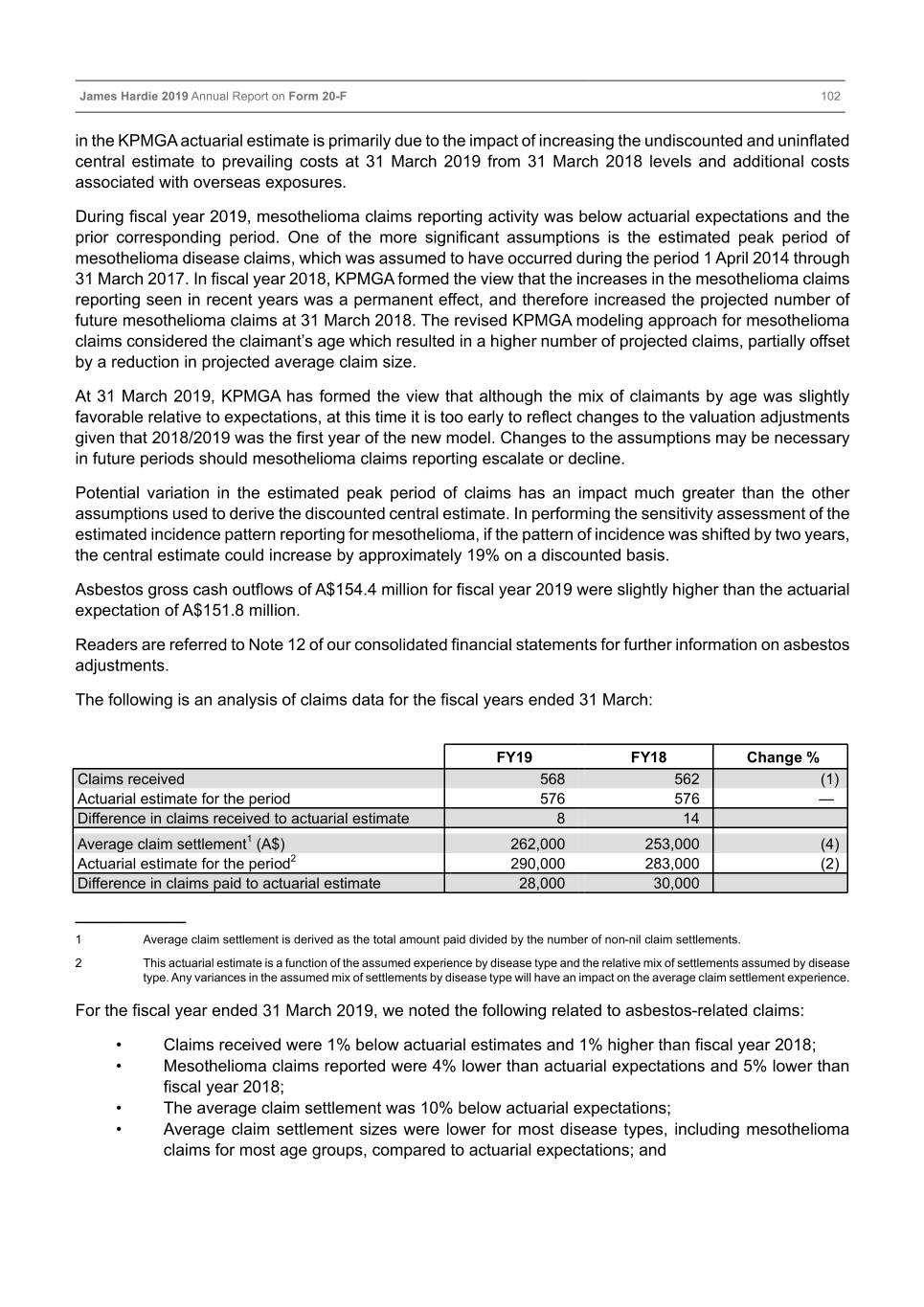
Table of Contents James Hardie 2019 Annual Report on Form 20-F 102 in the KPMGA actuarial estimate is primarily due to the impact of increasing the undiscounted and uninflated central estimate to prevailing costs at 31 March 2019 from 31 March 2018 levels and additional costs associated with overseas exposures. During fiscal year 2019, mesothelioma claims reporting activity was below actuarial expectations and the prior corresponding period. One of the more significant assumptions is the estimated peak period of mesothelioma disease claims, which was assumed to have occurred during the period 1 April 2014 through 31 March 2017. In fiscal year 2018, KPMGA formed the view that the increases in the mesothelioma claims reporting seen in recent years was a permanent effect, and therefore increased the projected number of future mesothelioma claims at 31 March 2018. The revised KPMGA modeling approach for mesothelioma claims considered the claimant’s age which resulted in a higher number of projected claims, partially offset by a reduction in projected average claim size. At 31 March 2019, KPMGA has formed the view that although the mix of claimants by age was slightly favorable relative to expectations, at this time it is too early to reflect changes to the valuation adjustments given that 2018/2019 was the first year of the new model. Changes to the assumptions may be necessary in future periods should mesothelioma claims reporting escalate or decline. Potential variation in the estimated peak period of claims has an impact much greater than the other assumptions used to derive the discounted central estimate. In performing the sensitivity assessment of the estimated incidence pattern reporting for mesothelioma, if the pattern of incidence was shifted by two years, the central estimate could increase by approximately 19% on a discounted basis. Asbestos gross cash outflows of A$154.4 million for fiscal year 2019 were slightly higher than the actuarial expectation of A$151.8 million. Readers are referred to Note 12 of our consolidated financial statements for further information on asbestos adjustments. The following is an analysis of claims data for the fiscal years ended 31 March: FY19 FY18 Change % Claims received 568 562 (1) Actuarial estimate for the period 576 576 — Difference in claims received to actuarial estimate 8 14 Average claim settlement1 (A$) 262,000 253,000 (4) Actuarial estimate for the period2 290,000 283,000 (2) Difference in claims paid to actuarial estimate 28,000 30,000 ____________ 1 Average claim settlement is derived as the total amount paid divided by the number of non-nil claim settlements. 2 This actuarial estimate is a function of the assumed experience by disease type and the relative mix of settlements assumed by disease type. Any variances in the assumed mix of settlements by disease type will have an impact on the average claim settlement experience. For the fiscal year ended 31 March 2019, we noted the following related to asbestos-related claims: • Claims received were 1% below actuarial estimates and 1% higher than fiscal year 2018; • Mesothelioma claims reported were 4% lower than actuarial expectations and 5% lower than fiscal year 2018; • The average claim settlement was 10% below actuarial expectations; • Average claim settlement sizes were lower for most disease types, including mesothelioma claims for most age groups, compared to actuarial expectations; and
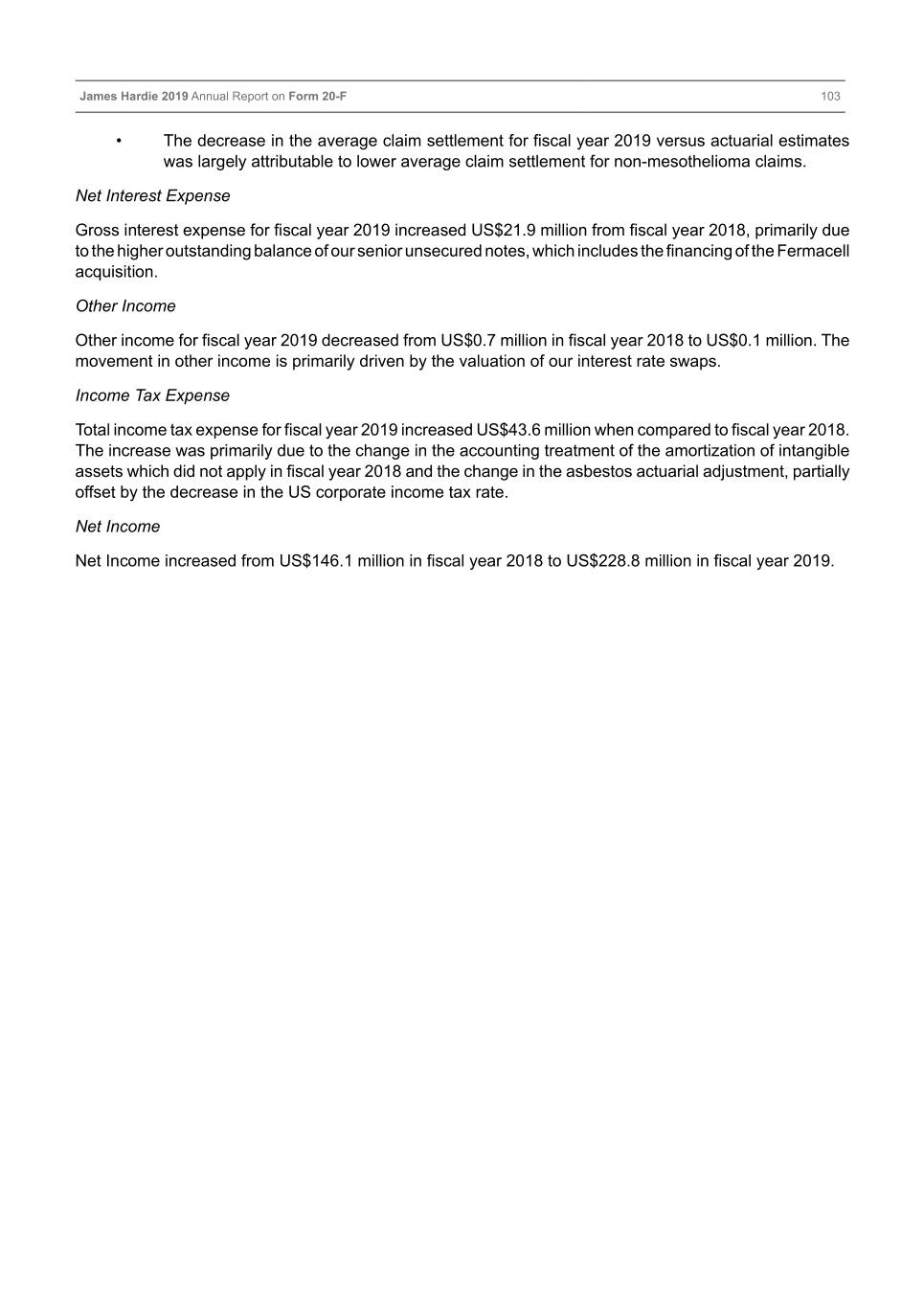
Table of Contents James Hardie 2019 Annual Report on Form 20-F 103 • The decrease in the average claim settlement for fiscal year 2019 versus actuarial estimates was largely attributable to lower average claim settlement for non-mesothelioma claims. Net Interest Expense Gross interest expense for fiscal year 2019 increased US$21.9 million from fiscal year 2018, primarily due to the higher outstanding balance of our senior unsecured notes, which includes the financing of the Fermacell acquisition. Other Income Other income for fiscal year 2019 decreased from US$0.7 million in fiscal year 2018 to US$0.1 million. The movement in other income is primarily driven by the valuation of our interest rate swaps. Income Tax Expense Total income tax expense for fiscal year 2019 increased US$43.6 million when compared to fiscal year 2018. The increase was primarily due to the change in the accounting treatment of the amortization of intangible assets which did not apply in fiscal year 2018 and the change in the asbestos actuarial adjustment, partially offset by the decrease in the US corporate income tax rate. Net Income Net Income increased from US$146.1 million in fiscal year 2018 to US$228.8 million in fiscal year 2019.
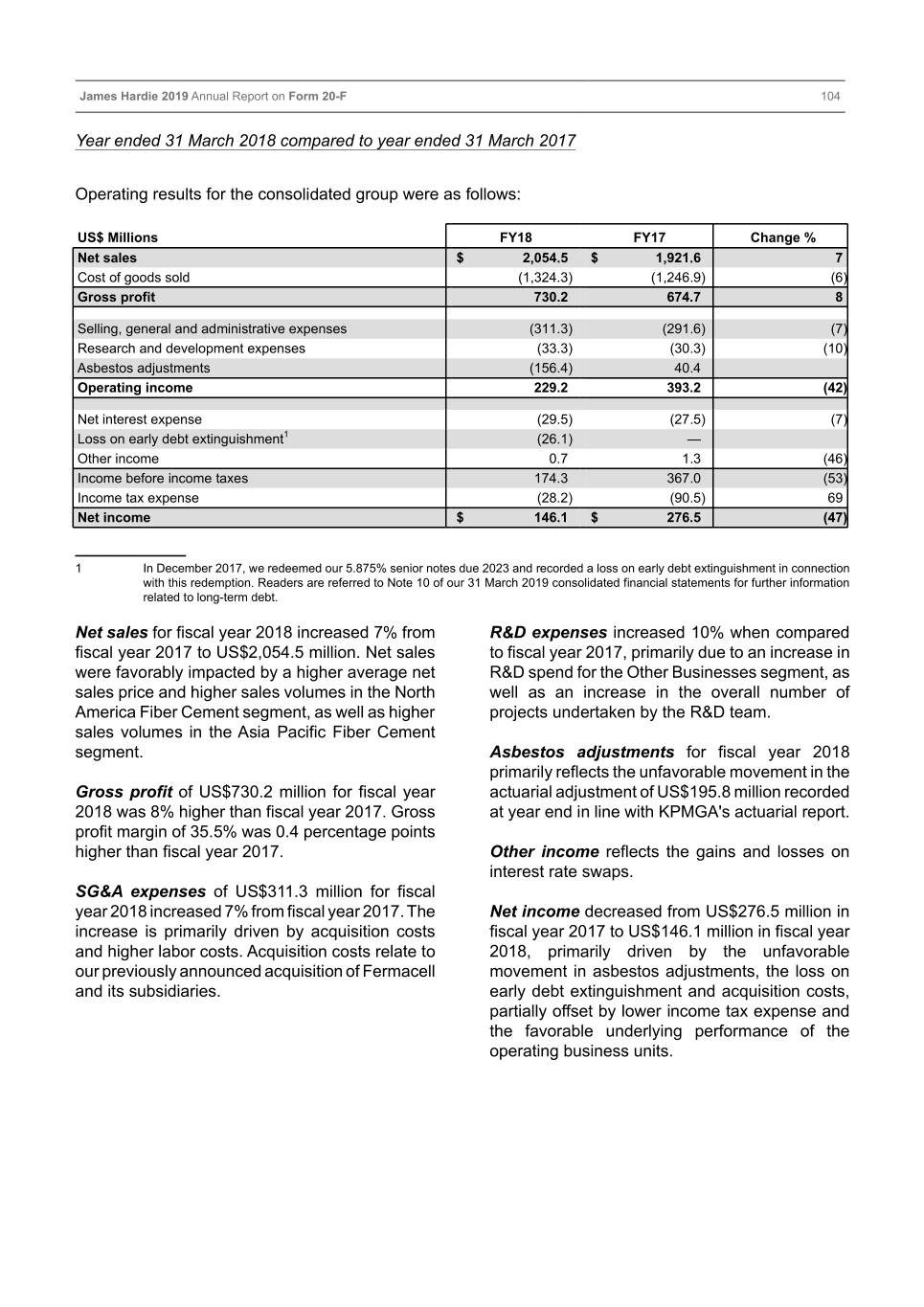
Table of Contents James Hardie 2019 Annual Report on Form 20-F 104 Year ended 31 March 2018 compared to year ended 31 March 2017 Operating results for the consolidated group were as follows: US$ Millions FY18 FY17 Change % Net sales $ 2,054.5 $ 1,921.6 7 Cost of goods sold (1,324.3) (1,246.9) (6) Gross profit 730.2 674.7 8 Selling, general and administrative expenses (311.3) (291.6) (7) Research and development expenses (33.3) (30.3) (10) Asbestos adjustments (156.4) 40.4 Operating income 229.2 393.2 (42) Net interest expense (29.5) (27.5) (7) Loss on early debt extinguishment1 (26.1) — Other income 0.7 1.3 (46) Income before income taxes 174.3 367.0 (53) Income tax expense (28.2) (90.5) 69 Net income $ 146.1 $ 276.5 (47) ____________ 1 In December 2017, we redeemed our 5.875% senior notes due 2023 and recorded a loss on early debt extinguishment in connection with this redemption. Readers are referred to Note 10 of our 31 March 2019 consolidated financial statements for further information related to long-term debt. Net sales for fiscal year 2018 increased 7% from R&D expenses increased 10% when compared fiscal year 2017 to US$2,054.5 million. Net sales to fiscal year 2017, primarily due to an increase in were favorably impacted by a higher average net R&D spend for the Other Businesses segment, as sales price and higher sales volumes in the North well as an increase in the overall number of America Fiber Cement segment, as well as higher projects undertaken by the R&D team. sales volumes in the Asia Pacific Fiber Cement segment. Asbestos adjustments for fiscal year 2018 primarily reflects the unfavorable movement in the Gross profit of US$730.2 million for fiscal year actuarial adjustment of US$195.8 million recorded 2018 was 8% higher than fiscal year 2017. Gross at year end in line with KPMGA's actuarial report. profit margin of 35.5% was 0.4 percentage points higher than fiscal year 2017. Other income reflects the gains and losses on interest rate swaps. SG&A expenses of US$311.3 million for fiscal year 2018 increased 7% from fiscal year 2017. The Net income decreased from US$276.5 million in increase is primarily driven by acquisition costs fiscal year 2017 to US$146.1 million in fiscal year and higher labor costs. Acquisition costs relate to 2018, primarily driven by the unfavorable our previously announced acquisition of Fermacell movement in asbestos adjustments, the loss on and its subsidiaries. early debt extinguishment and acquisition costs, partially offset by lower income tax expense and the favorable underlying performance of the operating business units.
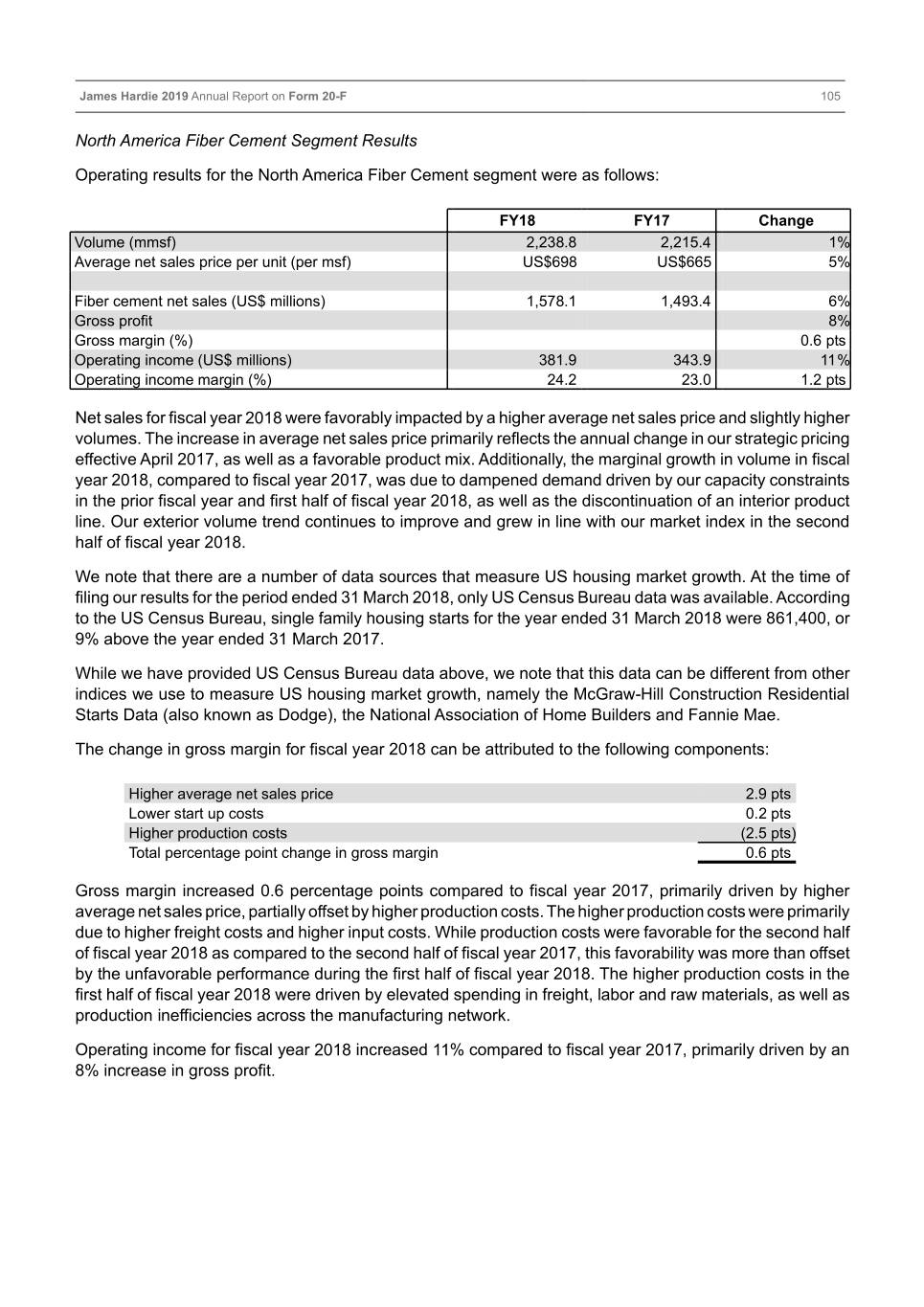
Table of Contents James Hardie 2019 Annual Report on Form 20-F 105 North America Fiber Cement Segment Results Operating results for the North America Fiber Cement segment were as follows: FY18 FY17 Change Volume (mmsf) 2,238.8 2,215.4 1% Average net sales price per unit (per msf) US$698 US$665 5% Fiber cement net sales (US$ millions) 1,578.1 1,493.4 6% Gross profit 8% Gross margin (%) 0.6 pts Operating income (US$ millions) 381.9 343.9 11 % Operating income margin (%) 24.2 23.0 1.2 pts Net sales for fiscal year 2018 were favorably impacted by a higher average net sales price and slightly higher volumes. The increase in average net sales price primarily reflects the annual change in our strategic pricing effective April 2017, as well as a favorable product mix. Additionally, the marginal growth in volume in fiscal year 2018, compared to fiscal year 2017, was due to dampened demand driven by our capacity constraints in the prior fiscal year and first half of fiscal year 2018, as well as the discontinuation of an interior product line. Our exterior volume trend continues to improve and grew in line with our market index in the second half of fiscal year 2018. We note that there are a number of data sources that measure US housing market growth. At the time of filing our results for the period ended 31 March 2018, only US Census Bureau data was available. According to the US Census Bureau, single family housing starts for the year ended 31 March 2018 were 861,400, or 9% above the year ended 31 March 2017. While we have provided US Census Bureau data above, we note that this data can be different from other indices we use to measure US housing market growth, namely the McGraw-Hill Construction Residential Starts Data (also known as Dodge), the National Association of Home Builders and Fannie Mae. The change in gross margin for fiscal year 2018 can be attributed to the following components: Higher average net sales price 2.9 pts Lower start up costs 0.2 pts Higher production costs (2.5 pts) Total percentage point change in gross margin 0.6 pts Gross margin increased 0.6 percentage points compared to fiscal year 2017, primarily driven by higher average net sales price, partially offset by higher production costs. The higher production costs were primarily due to higher freight costs and higher input costs. While production costs were favorable for the second half of fiscal year 2018 as compared to the second half of fiscal year 2017, this favorability was more than offset by the unfavorable performance during the first half of fiscal year 2018. The higher production costs in the first half of fiscal year 2018 were driven by elevated spending in freight, labor and raw materials, as well as production inefficiencies across the manufacturing network. Operating income for fiscal year 2018 increased 11% compared to fiscal year 2017, primarily driven by an 8% increase in gross profit.
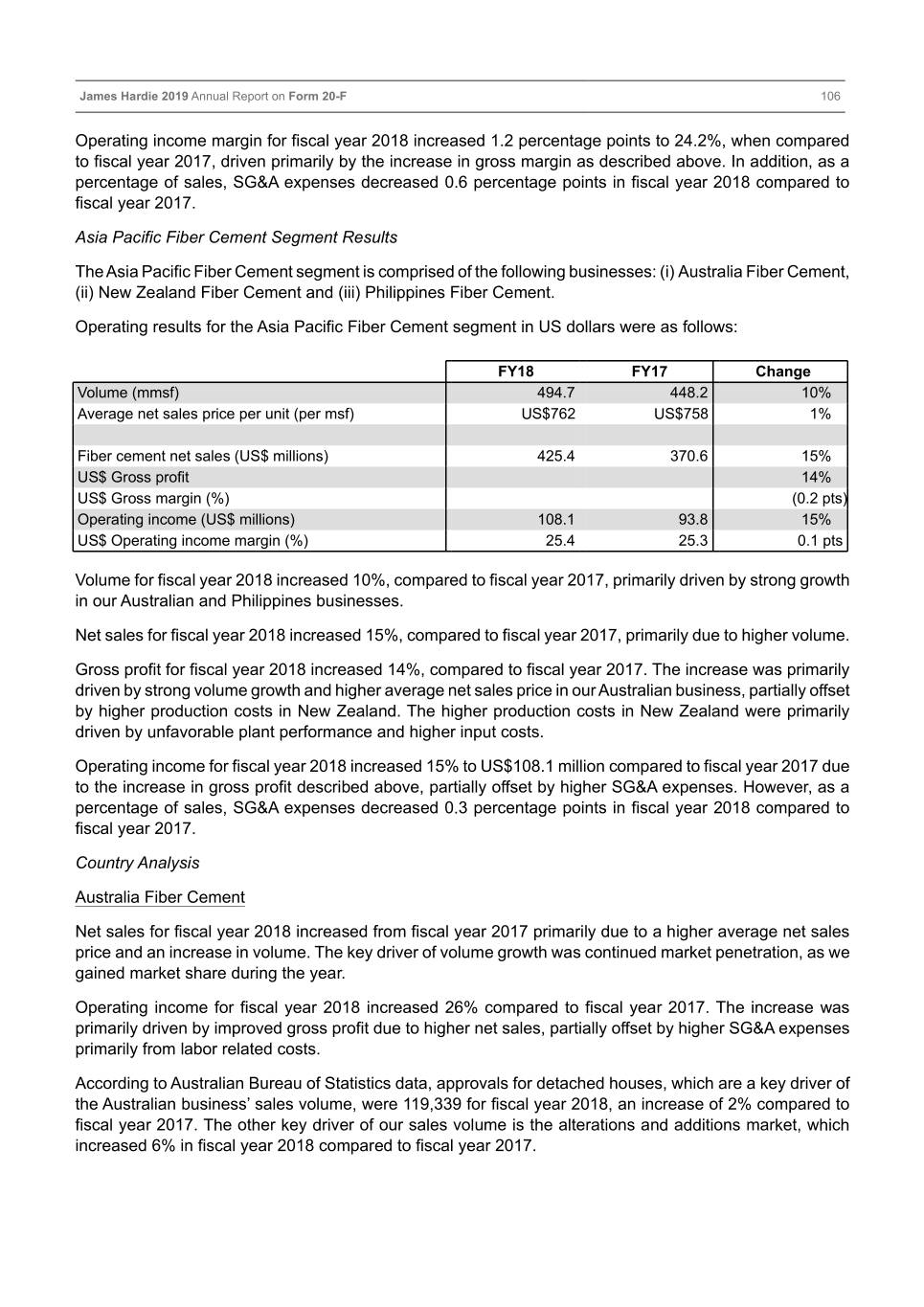
Table of Contents James Hardie 2019 Annual Report on Form 20-F 106 Operating income margin for fiscal year 2018 increased 1.2 percentage points to 24.2%, when compared to fiscal year 2017, driven primarily by the increase in gross margin as described above. In addition, as a percentage of sales, SG&A expenses decreased 0.6 percentage points in fiscal year 2018 compared to fiscal year 2017. Asia Pacific Fiber Cement Segment Results The Asia Pacific Fiber Cement segment is comprised of the following businesses: (i) Australia Fiber Cement, (ii) New Zealand Fiber Cement and (iii) Philippines Fiber Cement. Operating results for the Asia Pacific Fiber Cement segment in US dollars were as follows: FY18 FY17 Change Volume (mmsf) 494.7 448.2 10% Average net sales price per unit (per msf) US$762 US$758 1% Fiber cement net sales (US$ millions) 425.4 370.6 15% US$ Gross profit 14% US$ Gross margin (%) (0.2 pts) Operating income (US$ millions) 108.1 93.8 15% US$ Operating income margin (%) 25.4 25.3 0.1 pts Volume for fiscal year 2018 increased 10%, compared to fiscal year 2017, primarily driven by strong growth in our Australian and Philippines businesses. Net sales for fiscal year 2018 increased 15%, compared to fiscal year 2017, primarily due to higher volume. Gross profit for fiscal year 2018 increased 14%, compared to fiscal year 2017. The increase was primarily driven by strong volume growth and higher average net sales price in our Australian business, partially offset by higher production costs in New Zealand. The higher production costs in New Zealand were primarily driven by unfavorable plant performance and higher input costs. Operating income for fiscal year 2018 increased 15% to US$108.1 million compared to fiscal year 2017 due to the increase in gross profit described above, partially offset by higher SG&A expenses. However, as a percentage of sales, SG&A expenses decreased 0.3 percentage points in fiscal year 2018 compared to fiscal year 2017. Country Analysis Australia Fiber Cement Net sales for fiscal year 2018 increased from fiscal year 2017 primarily due to a higher average net sales price and an increase in volume. The key driver of volume growth was continued market penetration, as we gained market share during the year. Operating income for fiscal year 2018 increased 26% compared to fiscal year 2017. The increase was primarily driven by improved gross profit due to higher net sales, partially offset by higher SG&A expenses primarily from labor related costs. According to Australian Bureau of Statistics data, approvals for detached houses, which are a key driver of the Australian business’ sales volume, were 119,339 for fiscal year 2018, an increase of 2% compared to fiscal year 2017. The other key driver of our sales volume is the alterations and additions market, which increased 6% in fiscal year 2018 compared to fiscal year 2017.
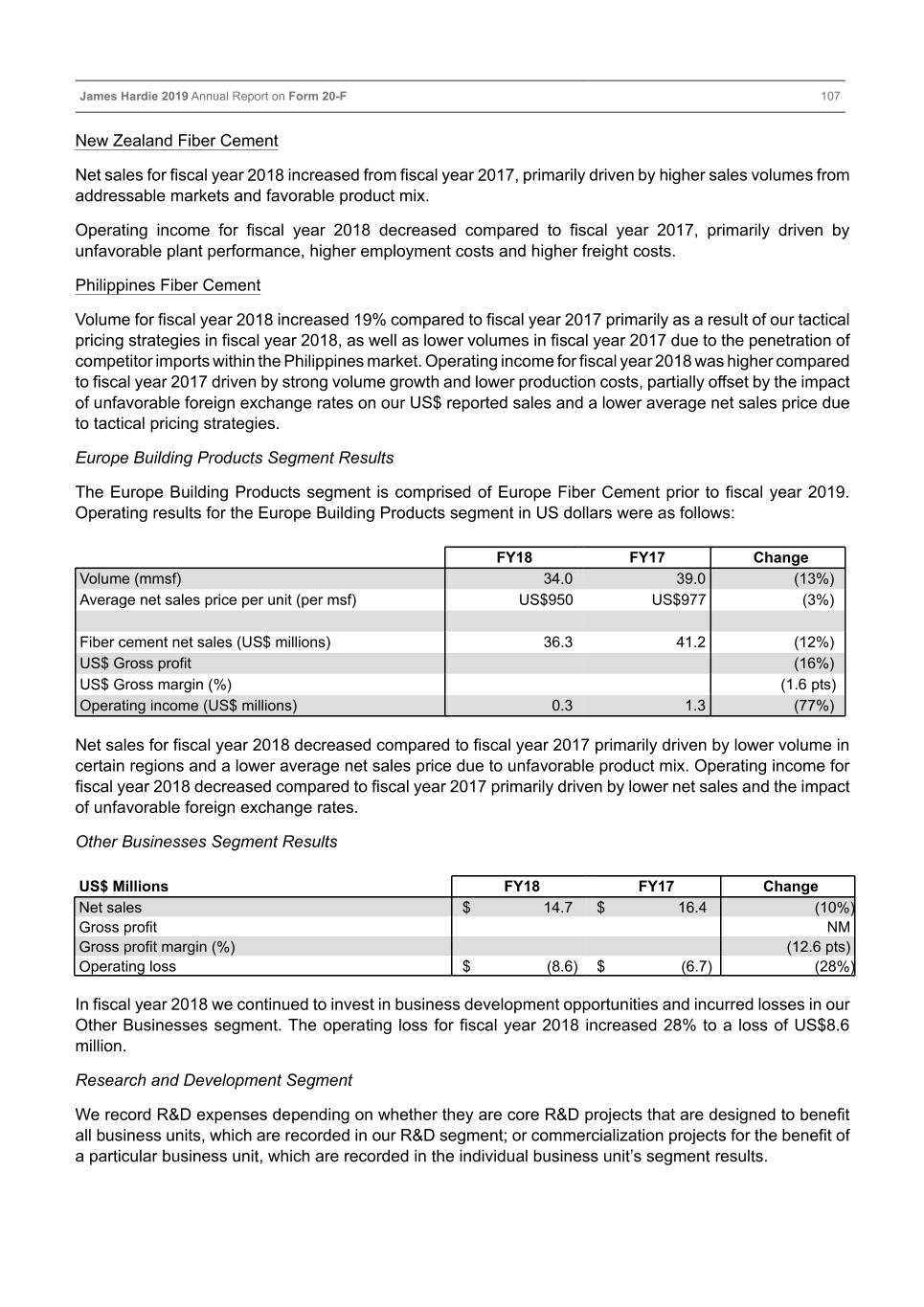
Table of Contents James Hardie 2019 Annual Report on Form 20-F 107 New Zealand Fiber Cement Net sales for fiscal year 2018 increased from fiscal year 2017, primarily driven by higher sales volumes from addressable markets and favorable product mix. Operating income for fiscal year 2018 decreased compared to fiscal year 2017, primarily driven by unfavorable plant performance, higher employment costs and higher freight costs. Philippines Fiber Cement Volume for fiscal year 2018 increased 19% compared to fiscal year 2017 primarily as a result of our tactical pricing strategies in fiscal year 2018, as well as lower volumes in fiscal year 2017 due to the penetration of competitor imports within the Philippines market. Operating income for fiscal year 2018 was higher compared to fiscal year 2017 driven by strong volume growth and lower production costs, partially offset by the impact of unfavorable foreign exchange rates on our US$ reported sales and a lower average net sales price due to tactical pricing strategies. Europe Building Products Segment Results The Europe Building Products segment is comprised of Europe Fiber Cement prior to fiscal year 2019. Operating results for the Europe Building Products segment in US dollars were as follows: FY18 FY17 Change Volume (mmsf) 34.0 39.0 (13%) Average net sales price per unit (per msf) US$950 US$977 (3%) Fiber cement net sales (US$ millions) 36.3 41.2 (12%) US$ Gross profit (16%) US$ Gross margin (%) (1.6 pts) Operating income (US$ millions) 0.3 1.3 (77%) Net sales for fiscal year 2018 decreased compared to fiscal year 2017 primarily driven by lower volume in certain regions and a lower average net sales price due to unfavorable product mix. Operating income for fiscal year 2018 decreased compared to fiscal year 2017 primarily driven by lower net sales and the impact of unfavorable foreign exchange rates. Other Businesses Segment Results US$ Millions FY18 FY17 Change Net sales $ 14.7 $ 16.4 (10%) Gross profit NM Gross profit margin (%) (12.6 pts) Operating loss $ (8.6) $ (6.7) (28%) In fiscal year 2018 we continued to invest in business development opportunities and incurred losses in our Other Businesses segment. The operating loss for fiscal year 2018 increased 28% to a loss of US$8.6 million. Research and Development Segment We record R&D expenses depending on whether they are core R&D projects that are designed to benefit all business units, which are recorded in our R&D segment; or commercialization projects for the benefit of a particular business unit, which are recorded in the individual business unit’s segment results.
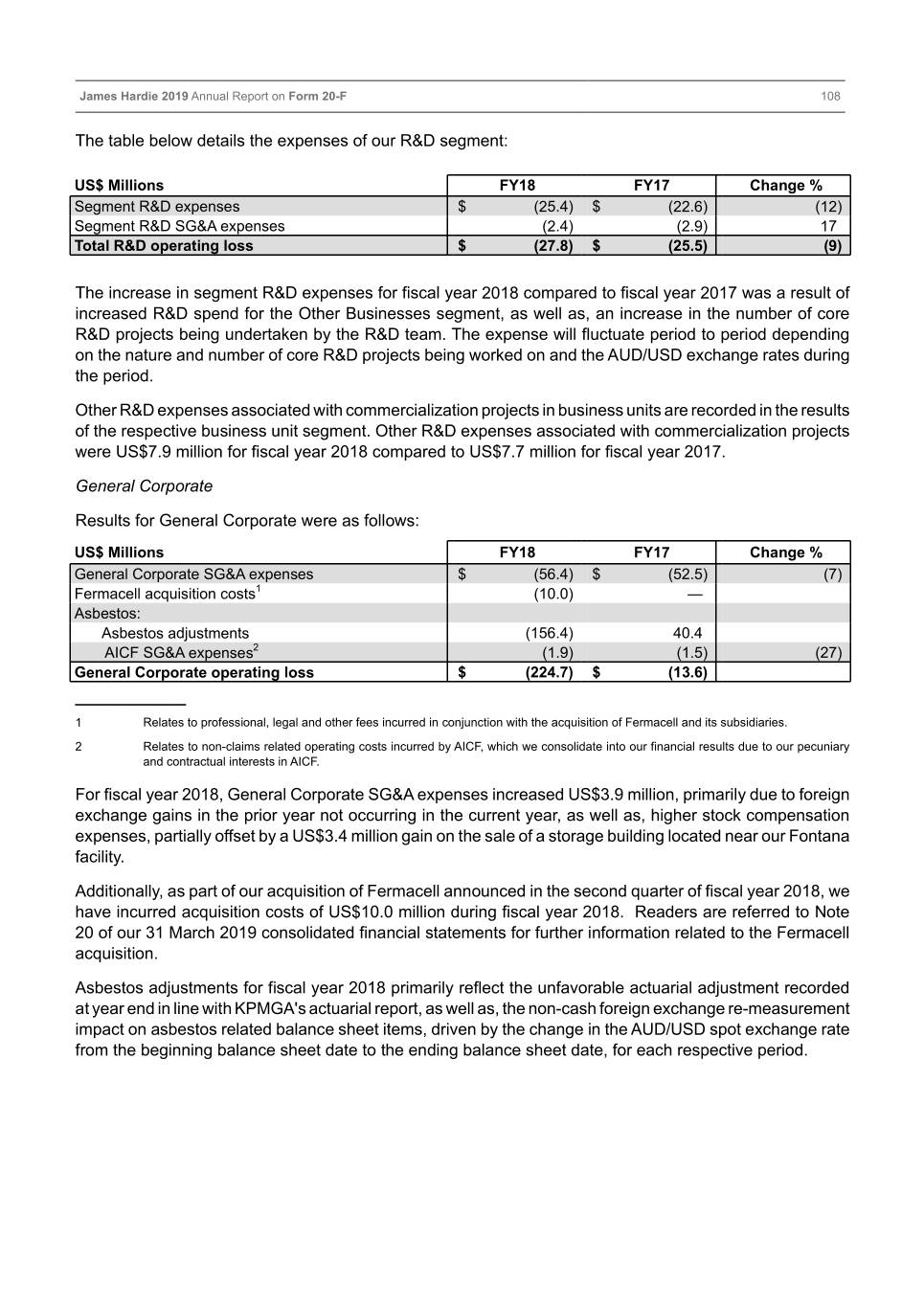
Table of Contents James Hardie 2019 Annual Report on Form 20-F 108 The table below details the expenses of our R&D segment: US$ Millions FY18 FY17 Change % Segment R&D expenses $ (25.4) $ (22.6) (12) Segment R&D SG&A expenses (2.4) (2.9) 17 Total R&D operating loss $ (27.8) $ (25.5) (9) The increase in segment R&D expenses for fiscal year 2018 compared to fiscal year 2017 was a result of increased R&D spend for the Other Businesses segment, as well as, an increase in the number of core R&D projects being undertaken by the R&D team. The expense will fluctuate period to period depending on the nature and number of core R&D projects being worked on and the AUD/USD exchange rates during the period. Other R&D expenses associated with commercialization projects in business units are recorded in the results of the respective business unit segment. Other R&D expenses associated with commercialization projects were US$7.9 million for fiscal year 2018 compared to US$7.7 million for fiscal year 2017. General Corporate Results for General Corporate were as follows: US$ Millions FY18 FY17 Change % General Corporate SG&A expenses $ (56.4) $ (52.5) (7) Fermacell acquisition costs1 (10.0) — Asbestos: Asbestos adjustments (156.4) 40.4 AICF SG&A expenses2 (1.9) (1.5) (27) General Corporate operating loss $ (224.7) $ (13.6) ____________ 1 Relates to professional, legal and other fees incurred in conjunction with the acquisition of Fermacell and its subsidiaries. 2 Relates to non-claims related operating costs incurred by AICF, which we consolidate into our financial results due to our pecuniary and contractual interests in AICF. For fiscal year 2018, General Corporate SG&A expenses increased US$3.9 million, primarily due to foreign exchange gains in the prior year not occurring in the current year, as well as, higher stock compensation expenses, partially offset by a US$3.4 million gain on the sale of a storage building located near our Fontana facility. Additionally, as part of our acquisition of Fermacell announced in the second quarter of fiscal year 2018, we have incurred acquisition costs of US$10.0 million during fiscal year 2018. Readers are referred to Note 20 of our 31 March 2019 consolidated financial statements for further information related to the Fermacell acquisition. Asbestos adjustments for fiscal year 2018 primarily reflect the unfavorable actuarial adjustment recorded at year end in line with KPMGA's actuarial report, as well as, the non-cash foreign exchange re-measurement impact on asbestos related balance sheet items, driven by the change in the AUD/USD spot exchange rate from the beginning balance sheet date to the ending balance sheet date, for each respective period.
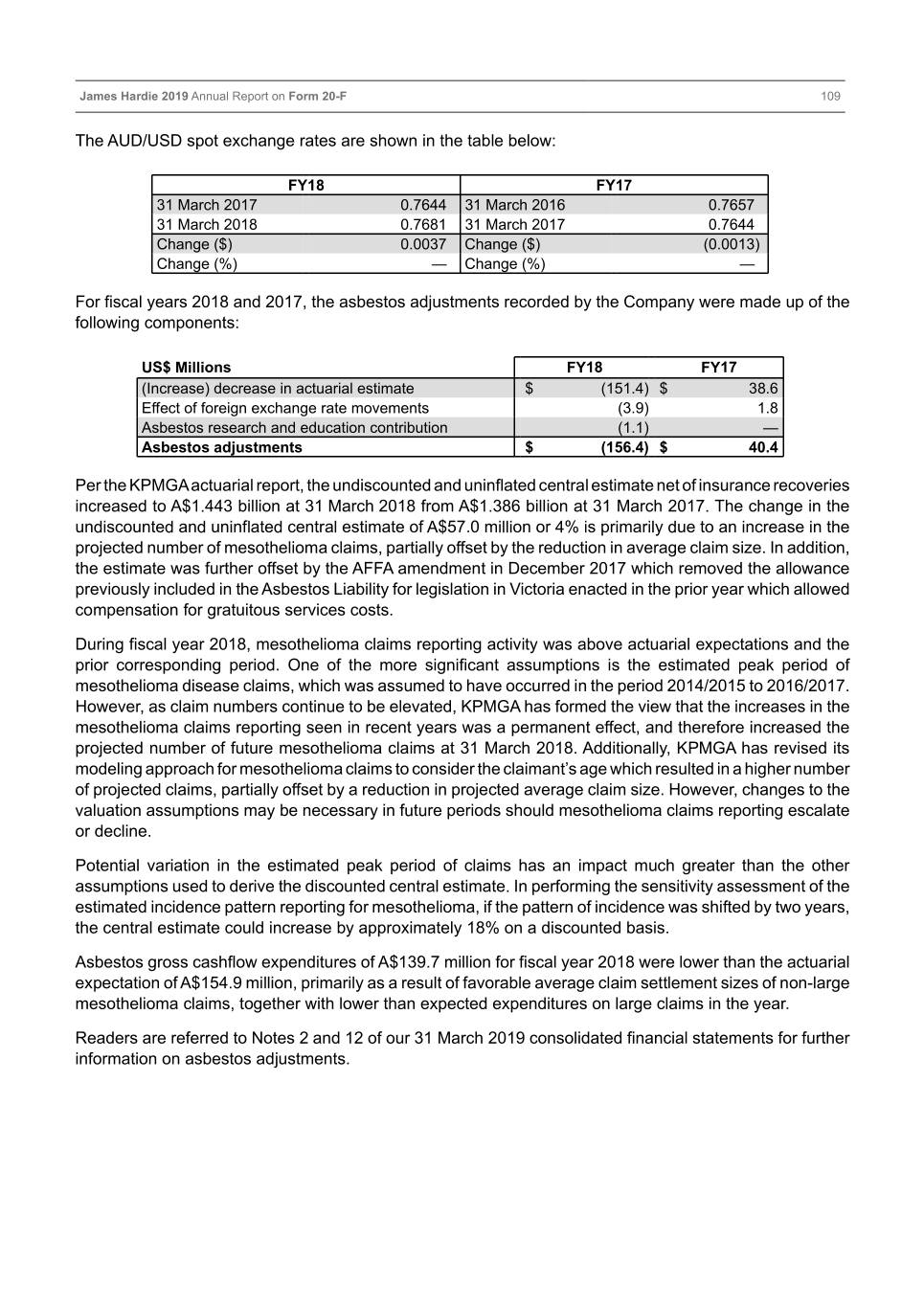
Table of Contents James Hardie 2019 Annual Report on Form 20-F 109 The AUD/USD spot exchange rates are shown in the table below: FY18 FY17 31 March 2017 0.7644 31 March 2016 0.7657 31 March 2018 0.7681 31 March 2017 0.7644 Change ($) 0.0037 Change ($) (0.0013) Change (%) — Change (%) — For fiscal years 2018 and 2017, the asbestos adjustments recorded by the Company were made up of the following components: US$ Millions FY18 FY17 (Increase) decrease in actuarial estimate $ (151.4) $ 38.6 Effect of foreign exchange rate movements (3.9) 1.8 Asbestos research and education contribution (1.1) — Asbestos adjustments $ (156.4) $ 40.4 Per the KPMGA actuarial report, the undiscounted and uninflated central estimate net of insurance recoveries increased to A$1.443 billion at 31 March 2018 from A$1.386 billion at 31 March 2017. The change in the undiscounted and uninflated central estimate of A$57.0 million or 4% is primarily due to an increase in the projected number of mesothelioma claims, partially offset by the reduction in average claim size. In addition, the estimate was further offset by the AFFA amendment in December 2017 which removed the allowance previously included in the Asbestos Liability for legislation in Victoria enacted in the prior year which allowed compensation for gratuitous services costs. During fiscal year 2018, mesothelioma claims reporting activity was above actuarial expectations and the prior corresponding period. One of the more significant assumptions is the estimated peak period of mesothelioma disease claims, which was assumed to have occurred in the period 2014/2015 to 2016/2017. However, as claim numbers continue to be elevated, KPMGA has formed the view that the increases in the mesothelioma claims reporting seen in recent years was a permanent effect, and therefore increased the projected number of future mesothelioma claims at 31 March 2018. Additionally, KPMGA has revised its modeling approach for mesothelioma claims to consider the claimant’s age which resulted in a higher number of projected claims, partially offset by a reduction in projected average claim size. However, changes to the valuation assumptions may be necessary in future periods should mesothelioma claims reporting escalate or decline. Potential variation in the estimated peak period of claims has an impact much greater than the other assumptions used to derive the discounted central estimate. In performing the sensitivity assessment of the estimated incidence pattern reporting for mesothelioma, if the pattern of incidence was shifted by two years, the central estimate could increase by approximately 18% on a discounted basis. Asbestos gross cashflow expenditures of A$139.7 million for fiscal year 2018 were lower than the actuarial expectation of A$154.9 million, primarily as a result of favorable average claim settlement sizes of non-large mesothelioma claims, together with lower than expected expenditures on large claims in the year. Readers are referred to Notes 2 and 12 of our 31 March 2019 consolidated financial statements for further information on asbestos adjustments.
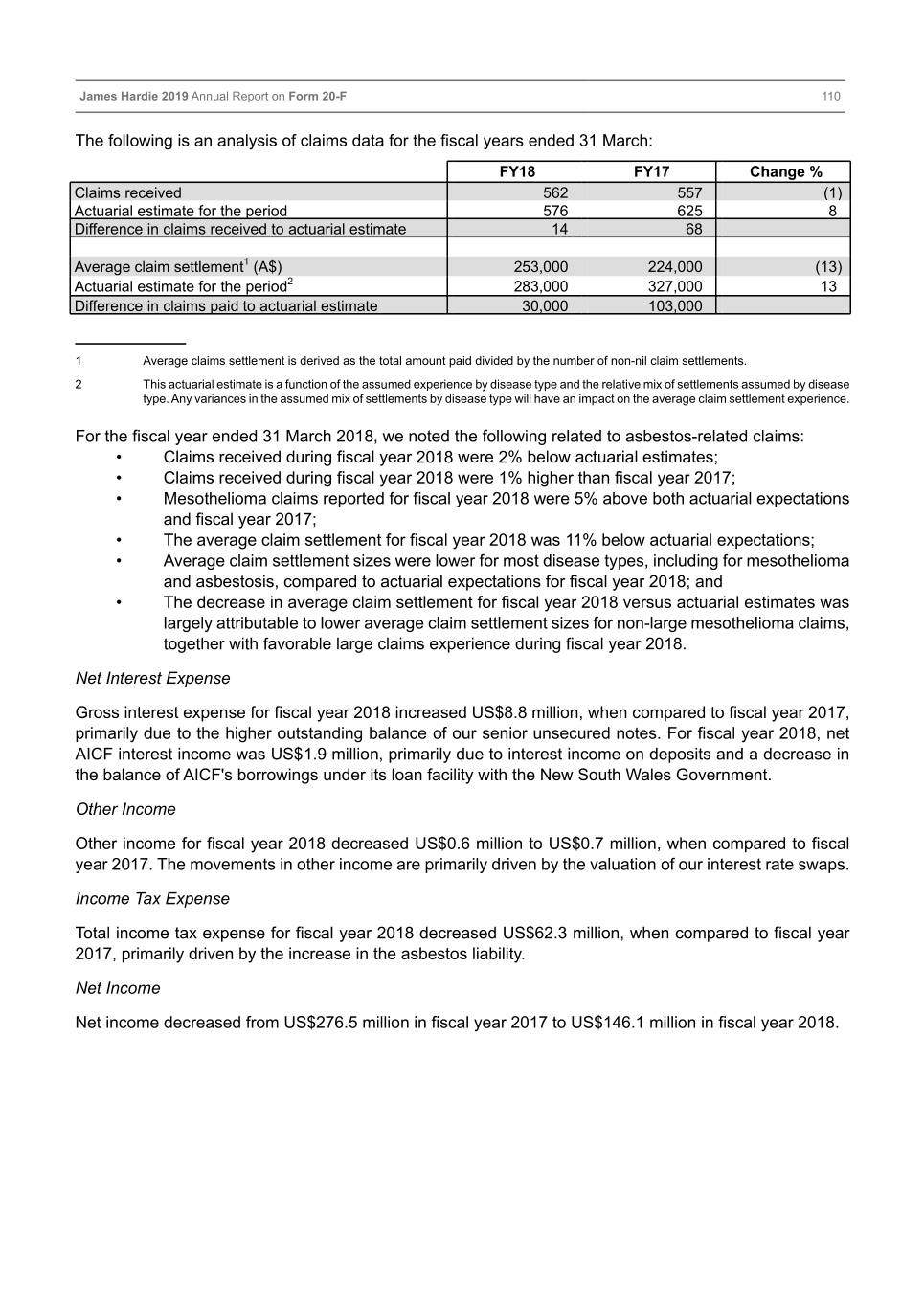
Table of Contents James Hardie 2019 Annual Report on Form 20-F 110 The following is an analysis of claims data for the fiscal years ended 31 March: FY18 FY17 Change % Claims received 562 557 (1) Actuarial estimate for the period 576 625 8 Difference in claims received to actuarial estimate 14 68 Average claim settlement1 (A$) 253,000 224,000 (13) Actuarial estimate for the period2 283,000 327,000 13 Difference in claims paid to actuarial estimate 30,000 103,000 ____________ 1 Average claims settlement is derived as the total amount paid divided by the number of non-nil claim settlements. 2 This actuarial estimate is a function of the assumed experience by disease type and the relative mix of settlements assumed by disease type. Any variances in the assumed mix of settlements by disease type will have an impact on the average claim settlement experience. For the fiscal year ended 31 March 2018, we noted the following related to asbestos-related claims: • Claims received during fiscal year 2018 were 2% below actuarial estimates; • Claims received during fiscal year 2018 were 1% higher than fiscal year 2017; • Mesothelioma claims reported for fiscal year 2018 were 5% above both actuarial expectations and fiscal year 2017; • The average claim settlement for fiscal year 2018 was 11% below actuarial expectations; • Average claim settlement sizes were lower for most disease types, including for mesothelioma and asbestosis, compared to actuarial expectations for fiscal year 2018; and • The decrease in average claim settlement for fiscal year 2018 versus actuarial estimates was largely attributable to lower average claim settlement sizes for non-large mesothelioma claims, together with favorable large claims experience during fiscal year 2018. Net Interest Expense Gross interest expense for fiscal year 2018 increased US$8.8 million, when compared to fiscal year 2017, primarily due to the higher outstanding balance of our senior unsecured notes. For fiscal year 2018, net AICF interest income was US$1.9 million, primarily due to interest income on deposits and a decrease in the balance of AICF's borrowings under its loan facility with the New South Wales Government. Other Income Other income for fiscal year 2018 decreased US$0.6 million to US$0.7 million, when compared to fiscal year 2017. The movements in other income are primarily driven by the valuation of our interest rate swaps. Income Tax Expense Total income tax expense for fiscal year 2018 decreased US$62.3 million, when compared to fiscal year 2017, primarily driven by the increase in the asbestos liability. Net Income Net income decreased from US$276.5 million in fiscal year 2017 to US$146.1 million in fiscal year 2018.
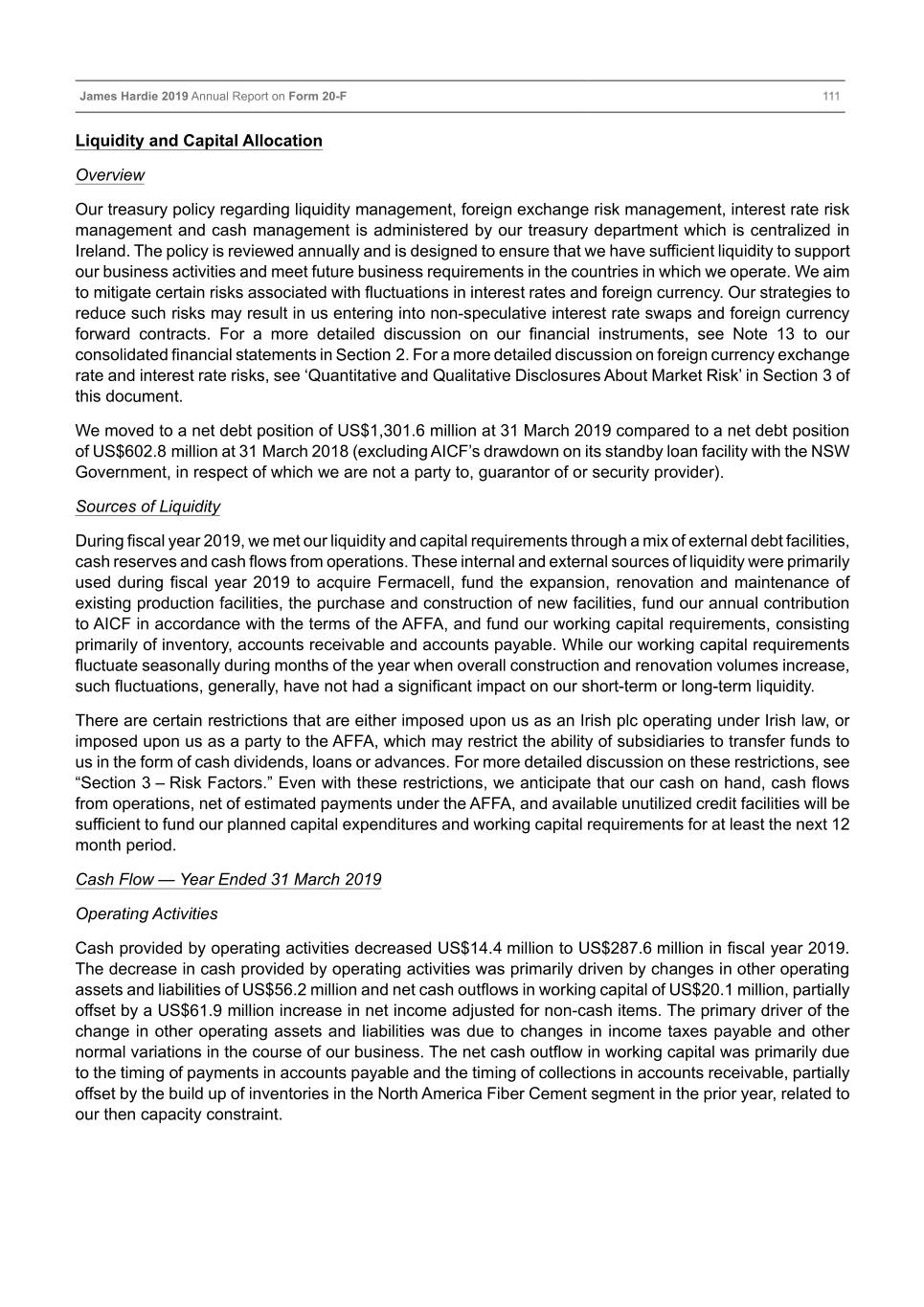
Table of Contents James Hardie 2019 Annual Report on Form 20-F 111 Liquidity and Capital Allocation Overview Our treasury policy regarding liquidity management, foreign exchange risk management, interest rate risk management and cash management is administered by our treasury department which is centralized in Ireland. The policy is reviewed annually and is designed to ensure that we have sufficient liquidity to support our business activities and meet future business requirements in the countries in which we operate. We aim to mitigate certain risks associated with fluctuations in interest rates and foreign currency. Our strategies to reduce such risks may result in us entering into non-speculative interest rate swaps and foreign currency forward contracts. For a more detailed discussion on our financial instruments, see Note 13 to our consolidated financial statements in Section 2. For a more detailed discussion on foreign currency exchange rate and interest rate risks, see ‘Quantitative and Qualitative Disclosures About Market Risk’ in Section 3 of this document. We moved to a net debt position of US$1,301.6 million at 31 March 2019 compared to a net debt position of US$602.8 million at 31 March 2018 (excluding AICF’s drawdown on its standby loan facility with the NSW Government, in respect of which we are not a party to, guarantor of or security provider). Sources of Liquidity During fiscal year 2019, we met our liquidity and capital requirements through a mix of external debt facilities, cash reserves and cash flows from operations. These internal and external sources of liquidity were primarily used during fiscal year 2019 to acquire Fermacell, fund the expansion, renovation and maintenance of existing production facilities, the purchase and construction of new facilities, fund our annual contribution to AICF in accordance with the terms of the AFFA, and fund our working capital requirements, consisting primarily of inventory, accounts receivable and accounts payable. While our working capital requirements fluctuate seasonally during months of the year when overall construction and renovation volumes increase, such fluctuations, generally, have not had a significant impact on our short-term or long-term liquidity. There are certain restrictions that are either imposed upon us as an Irish plc operating under Irish law, or imposed upon us as a party to the AFFA, which may restrict the ability of subsidiaries to transfer funds to us in the form of cash dividends, loans or advances. For more detailed discussion on these restrictions, see “Section 3 – Risk Factors.” Even with these restrictions, we anticipate that our cash on hand, cash flows from operations, net of estimated payments under the AFFA, and available unutilized credit facilities will be sufficient to fund our planned capital expenditures and working capital requirements for at least the next 12 month period. Cash Flow — Year Ended 31 March 2019 Operating Activities Cash provided by operating activities decreased US$14.4 million to US$287.6 million in fiscal year 2019. The decrease in cash provided by operating activities was primarily driven by changes in other operating assets and liabilities of US$56.2 million and net cash outflows in working capital of US$20.1 million, partially offset by a US$61.9 million increase in net income adjusted for non-cash items. The primary driver of the change in other operating assets and liabilities was due to changes in income taxes payable and other normal variations in the course of our business. The net cash outflow in working capital was primarily due to the timing of payments in accounts payable and the timing of collections in accounts receivable, partially offset by the build up of inventories in the North America Fiber Cement segment in the prior year, related to our then capacity constraint.
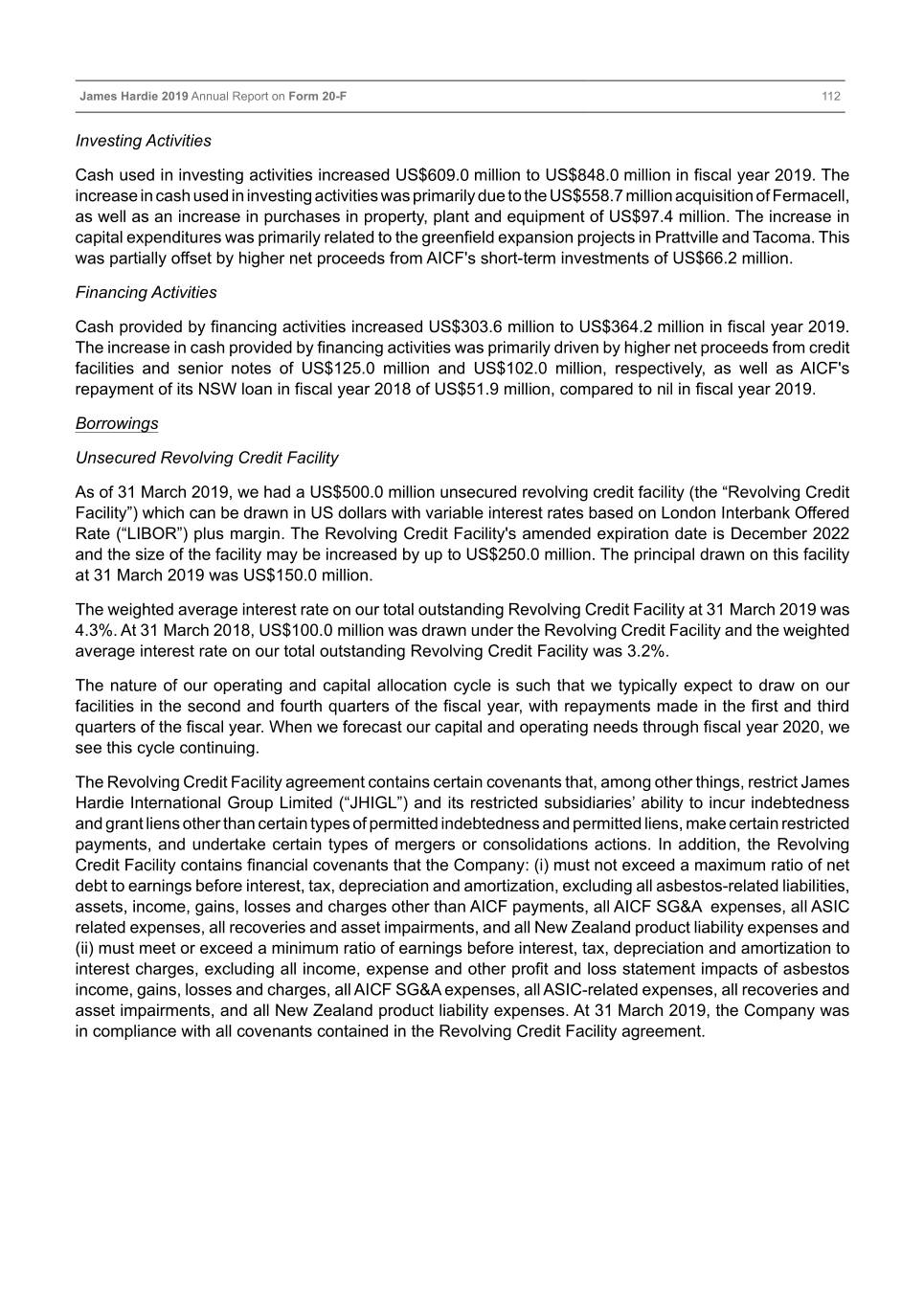
Table of Contents James Hardie 2019 Annual Report on Form 20-F 112 Investing Activities Cash used in investing activities increased US$609.0 million to US$848.0 million in fiscal year 2019. The increase in cash used in investing activities was primarily due to the US$558.7 million acquisition of Fermacell, as well as an increase in purchases in property, plant and equipment of US$97.4 million. The increase in capital expenditures was primarily related to the greenfield expansion projects in Prattville and Tacoma. This was partially offset by higher net proceeds from AICF's short-term investments of US$66.2 million. Financing Activities Cash provided by financing activities increased US$303.6 million to US$364.2 million in fiscal year 2019. The increase in cash provided by financing activities was primarily driven by higher net proceeds from credit facilities and senior notes of US$125.0 million and US$102.0 million, respectively, as well as AICF's repayment of its NSW loan in fiscal year 2018 of US$51.9 million, compared to nil in fiscal year 2019. Borrowings Unsecured Revolving Credit Facility As of 31 March 2019, we had a US$500.0 million unsecured revolving credit facility (the “Revolving Credit Facility”) which can be drawn in US dollars with variable interest rates based on London Interbank Offered Rate (“LIBOR”) plus margin. The Revolving Credit Facility's amended expiration date is December 2022 and the size of the facility may be increased by up to US$250.0 million. The principal drawn on this facility at 31 March 2019 was US$150.0 million. The weighted average interest rate on our total outstanding Revolving Credit Facility at 31 March 2019 was 4.3%. At 31 March 2018, US$100.0 million was drawn under the Revolving Credit Facility and the weighted average interest rate on our total outstanding Revolving Credit Facility was 3.2%. The nature of our operating and capital allocation cycle is such that we typically expect to draw on our facilities in the second and fourth quarters of the fiscal year, with repayments made in the first and third quarters of the fiscal year. When we forecast our capital and operating needs through fiscal year 2020, we see this cycle continuing. The Revolving Credit Facility agreement contains certain covenants that, among other things, restrict James Hardie International Group Limited (“JHIGL”) and its restricted subsidiaries’ ability to incur indebtedness and grant liens other than certain types of permitted indebtedness and permitted liens, make certain restricted payments, and undertake certain types of mergers or consolidations actions. In addition, the Revolving Credit Facility contains financial covenants that the Company: (i) must not exceed a maximum ratio of net debt to earnings before interest, tax, depreciation and amortization, excluding all asbestos-related liabilities, assets, income, gains, losses and charges other than AICF payments, all AICF SG&A expenses, all ASIC related expenses, all recoveries and asset impairments, and all New Zealand product liability expenses and (ii) must meet or exceed a minimum ratio of earnings before interest, tax, depreciation and amortization to interest charges, excluding all income, expense and other profit and loss statement impacts of asbestos income, gains, losses and charges, all AICF SG&A expenses, all ASIC-related expenses, all recoveries and asset impairments, and all New Zealand product liability expenses. At 31 March 2019, the Company was in compliance with all covenants contained in the Revolving Credit Facility agreement.
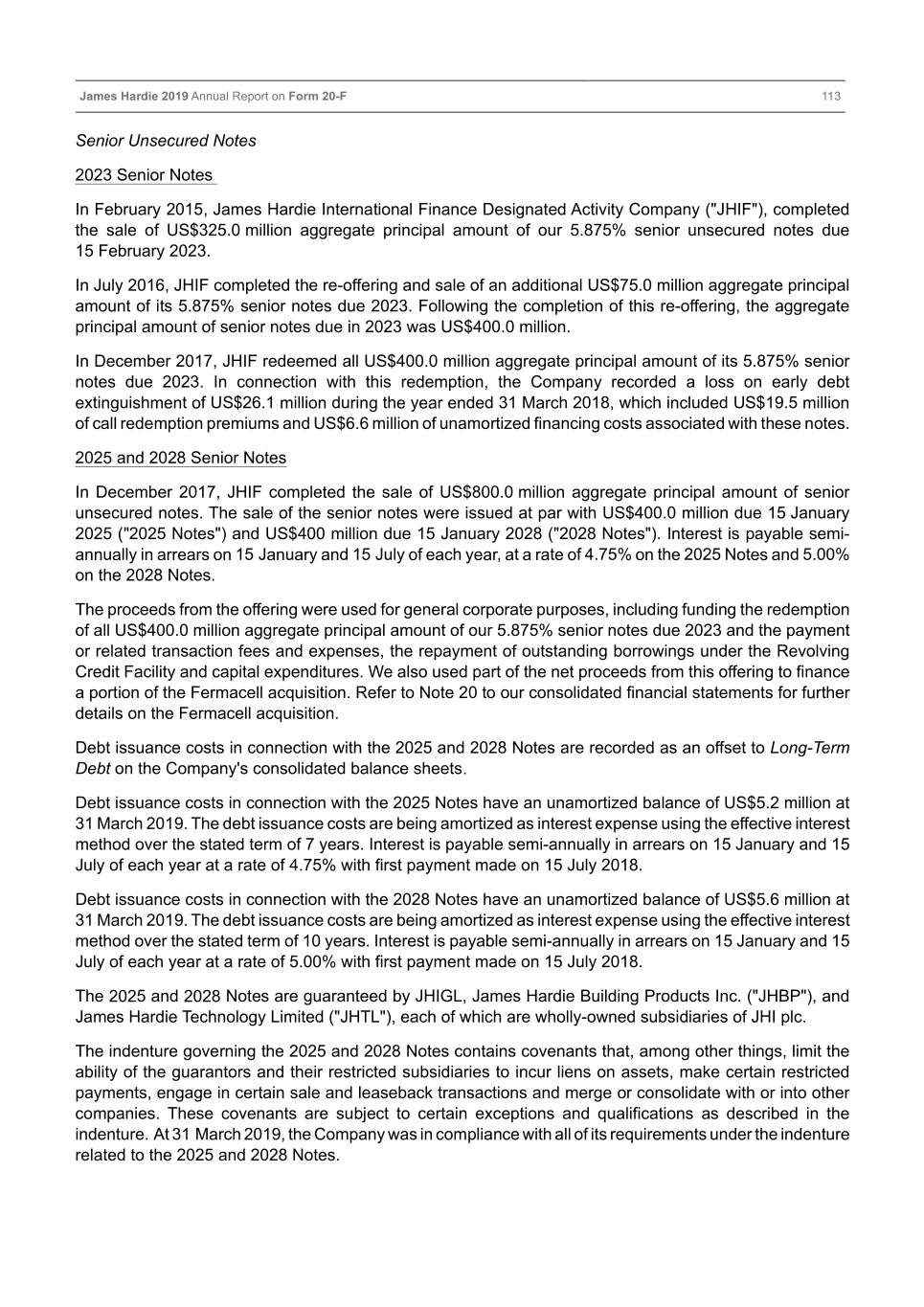
Table of Contents James Hardie 2019 Annual Report on Form 20-F 113 Senior Unsecured Notes 2023 Senior Notes In February 2015, James Hardie International Finance Designated Activity Company ("JHIF"), completed the sale of US$325.0 million aggregate principal amount of our 5.875% senior unsecured notes due 15 February 2023. In July 2016, JHIF completed the re-offering and sale of an additional US$75.0 million aggregate principal amount of its 5.875% senior notes due 2023. Following the completion of this re-offering, the aggregate principal amount of senior notes due in 2023 was US$400.0 million. In December 2017, JHIF redeemed all US$400.0 million aggregate principal amount of its 5.875% senior notes due 2023. In connection with this redemption, the Company recorded a loss on early debt extinguishment of US$26.1 million during the year ended 31 March 2018, which included US$19.5 million of call redemption premiums and US$6.6 million of unamortized financing costs associated with these notes. 2025 and 2028 Senior Notes In December 2017, JHIF completed the sale of US$800.0 million aggregate principal amount of senior unsecured notes. The sale of the senior notes were issued at par with US$400.0 million due 15 January 2025 ("2025 Notes") and US$400 million due 15 January 2028 ("2028 Notes"). Interest is payable semi- annually in arrears on 15 January and 15 July of each year, at a rate of 4.75% on the 2025 Notes and 5.00% on the 2028 Notes. The proceeds from the offering were used for general corporate purposes, including funding the redemption of all US$400.0 million aggregate principal amount of our 5.875% senior notes due 2023 and the payment or related transaction fees and expenses, the repayment of outstanding borrowings under the Revolving Credit Facility and capital expenditures. We also used part of the net proceeds from this offering to finance a portion of the Fermacell acquisition. Refer to Note 20 to our consolidated financial statements for further details on the Fermacell acquisition. Debt issuance costs in connection with the 2025 and 2028 Notes are recorded as an offset to Long-Term Debt on the Company's consolidated balance sheets. Debt issuance costs in connection with the 2025 Notes have an unamortized balance of US$5.2 million at 31 March 2019. The debt issuance costs are being amortized as interest expense using the effective interest method over the stated term of 7 years. Interest is payable semi-annually in arrears on 15 January and 15 July of each year at a rate of 4.75% with first payment made on 15 July 2018. Debt issuance costs in connection with the 2028 Notes have an unamortized balance of US$5.6 million at 31 March 2019. The debt issuance costs are being amortized as interest expense using the effective interest method over the stated term of 10 years. Interest is payable semi-annually in arrears on 15 January and 15 July of each year at a rate of 5.00% with first payment made on 15 July 2018. The 2025 and 2028 Notes are guaranteed by JHIGL, James Hardie Building Products Inc. ("JHBP"), and James Hardie Technology Limited ("JHTL"), each of which are wholly-owned subsidiaries of JHI plc. The indenture governing the 2025 and 2028 Notes contains covenants that, among other things, limit the ability of the guarantors and their restricted subsidiaries to incur liens on assets, make certain restricted payments, engage in certain sale and leaseback transactions and merge or consolidate with or into other companies. These covenants are subject to certain exceptions and qualifications as described in the indenture. At 31 March 2019, the Company was in compliance with all of its requirements under the indenture related to the 2025 and 2028 Notes.
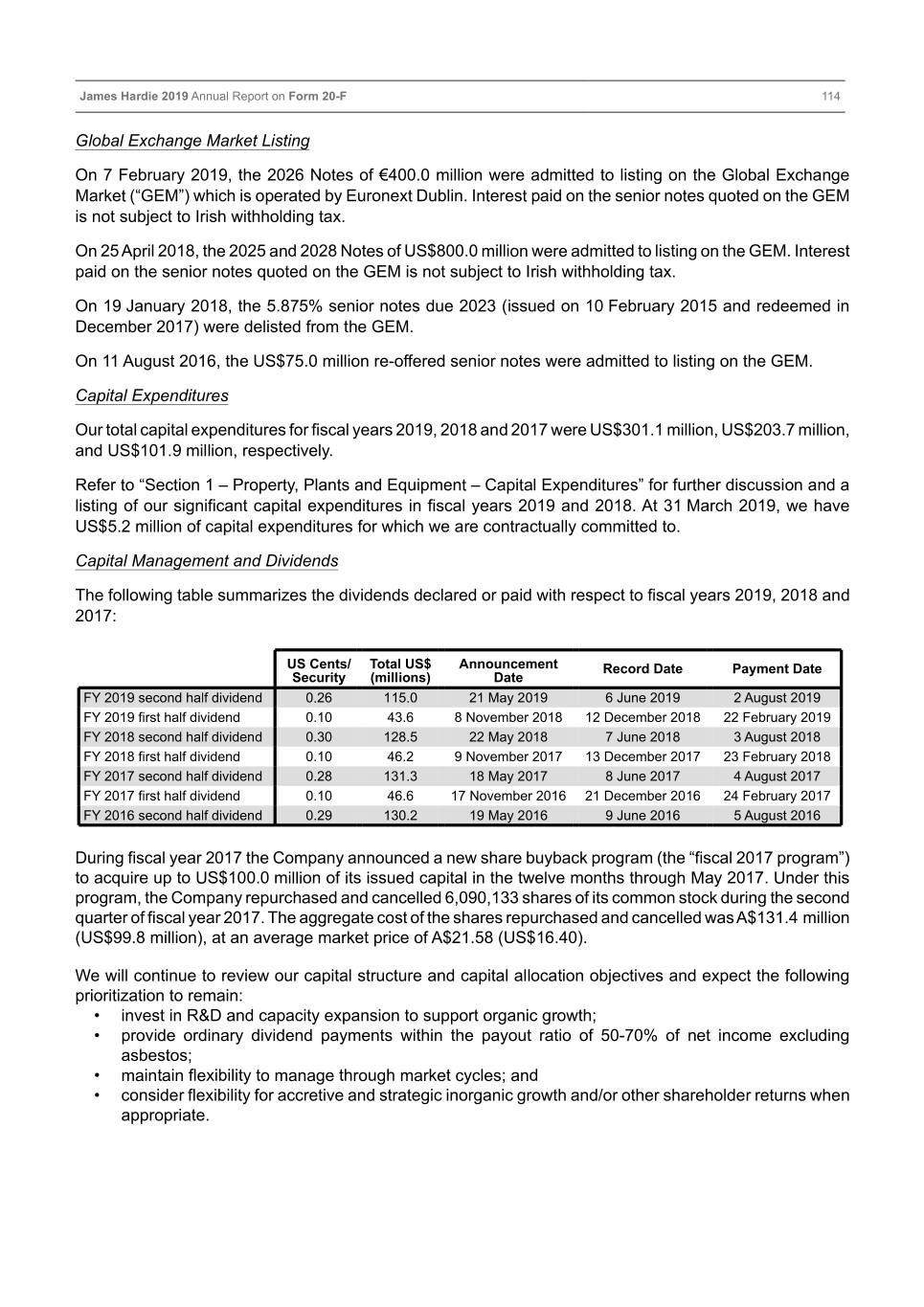
Table of Contents James Hardie 2019 Annual Report on Form 20-F 114 Global Exchange Market Listing On 7 February 2019, the 2026 Notes of €400.0 million were admitted to listing on the Global Exchange Market (“GEM”) which is operated by Euronext Dublin. Interest paid on the senior notes quoted on the GEM is not subject to Irish withholding tax. On 25 April 2018, the 2025 and 2028 Notes of US$800.0 million were admitted to listing on the GEM. Interest paid on the senior notes quoted on the GEM is not subject to Irish withholding tax. On 19 January 2018, the 5.875% senior notes due 2023 (issued on 10 February 2015 and redeemed in December 2017) were delisted from the GEM. On 11 August 2016, the US$75.0 million re-offered senior notes were admitted to listing on the GEM. Capital Expenditures Our total capital expenditures for fiscal years 2019, 2018 and 2017 were US$301.1 million, US$203.7 million, and US$101.9 million, respectively. Refer to “Section 1 – Property, Plants and Equipment – Capital Expenditures” for further discussion and a listing of our significant capital expenditures in fiscal years 2019 and 2018. At 31 March 2019, we have US$5.2 million of capital expenditures for which we are contractually committed to. Capital Management and Dividends The following table summarizes the dividends declared or paid with respect to fiscal years 2019, 2018 and 2017: US Cents/ Total US$ Announcement Record Date Payment Date Security (millions) Date FY 2019 second half dividend 0.26 115.0 21 May 2019 6 June 2019 2 August 2019 FY 2019 first half dividend 0.10 43.6 8 November 2018 12 December 2018 22 February 2019 FY 2018 second half dividend 0.30 128.5 22 May 2018 7 June 2018 3 August 2018 FY 2018 first half dividend 0.10 46.2 9 November 2017 13 December 2017 23 February 2018 FY 2017 second half dividend 0.28 131.3 18 May 2017 8 June 2017 4 August 2017 FY 2017 first half dividend 0.10 46.6 17 November 2016 21 December 2016 24 February 2017 FY 2016 second half dividend 0.29 130.2 19 May 2016 9 June 2016 5 August 2016 During fiscal year 2017 the Company announced a new share buyback program (the “fiscal 2017 program”) to acquire up to US$100.0 million of its issued capital in the twelve months through May 2017. Under this program, the Company repurchased and cancelled 6,090,133 shares of its common stock during the second quarter of fiscal year 2017. The aggregate cost of the shares repurchased and cancelled was A$131.4 million (US$99.8 million), at an average market price of A$21.58 (US$16.40). We will continue to review our capital structure and capital allocation objectives and expect the following prioritization to remain: • invest in R&D and capacity expansion to support organic growth; • provide ordinary dividend payments within the payout ratio of 50-70% of net income excluding asbestos; • maintain flexibility to manage through market cycles; and • consider flexibility for accretive and strategic inorganic growth and/or other shareholder returns when appropriate.

Table of Contents James Hardie 2019 Annual Report on Form 20-F 115 Annual AICF contribution On 2 July 2018, we made a payment of A$138.4 million (US$103.0 million) to AICF, representing 35% of our free cash flow for fiscal year 2018. Free cash flow, as defined in the AFFA, was equivalent to our fiscal year 2018 operating cash flow of US$295.0 million, adjusted to 2004 US GAAP, for free cash flow of US$294.2 million. We anticipate that we will make a contribution of approximately US$100.9 million to AICF on 1 July 2019. This amount represents 35% of our free cash flow which is equivalent to our operating cash flows of US$287.6 million plus an adjustment of US$0.8 million, resulting in free cash flow of US$288.4 million for fiscal year 2019, as defined by the AFFA. From the time AICF was established in February 2007 through 21 May 2019, we have contributed approximately A$1,193.4 million to the fund. Readers are referred to Notes 2 and 12 of our 31 March 2019 consolidated financial statements for further information on Asbestos. Outlook and Trend Information We expect the modest market growth and more prolonged recovery of the US housing market to continue into fiscal year 2020. The consensus view is that the single family new construction market and repair and remodel market are expected to grow, albeit at a growth rate lower than that in fiscal year 2019. While housing starts have rebounded from depressed post-crisis levels, they remain well below the 50-year average of approximately 1.5 million starts per year. A number of factors will contribute to new housing starts demand, including improvement in United States’ GDP, lower unemployment level, improvement in consumer confidence levels, sustainable household debt levels, historically low interest rates, stability in home prices and new household formation. We are the largest fiber cement producer in North America with nine plants. The scale of our operations and manufacturing capabilities improves our position with distributors who continue to experience increased demand for fiber cement products and seek a partner whom can manufacture and deliver the volume required on a timely basis. The plants are positioned near attractive markets in the United States to help minimize transportation costs for product distribution and raw material sourcing. Input costs including raw materials, labor and freight costs have fluctuated year over year and we are actively engaged in utilizing its platform to mitigate any future increases. We have also experienced increases in SG&A costs to align organization capacity with increases in volumes. In Australia, it is anticipated that our addressable underlying market will decrease in fiscal year 2020 compared to fiscal year 2019. Net sales from our Australian business are expected to continue to trend above the average growth of the domestic repair and remodel and single family detached housing markets in the eastern states of Australia. We expect our Europe Building Product segment to achieve year on year net sales and operating income margin growth. Off-Balance Sheet Arrangements As of 31 March 2019, the Company had a total borrowing base capacity under the Revolving Credit Facility of US$500.0 million with outstanding borrowings of US$150.0 million, and US$9.5 million of drawn letters of credit and bank guarantees. These letters of credit and bank guarantees relate to various operational
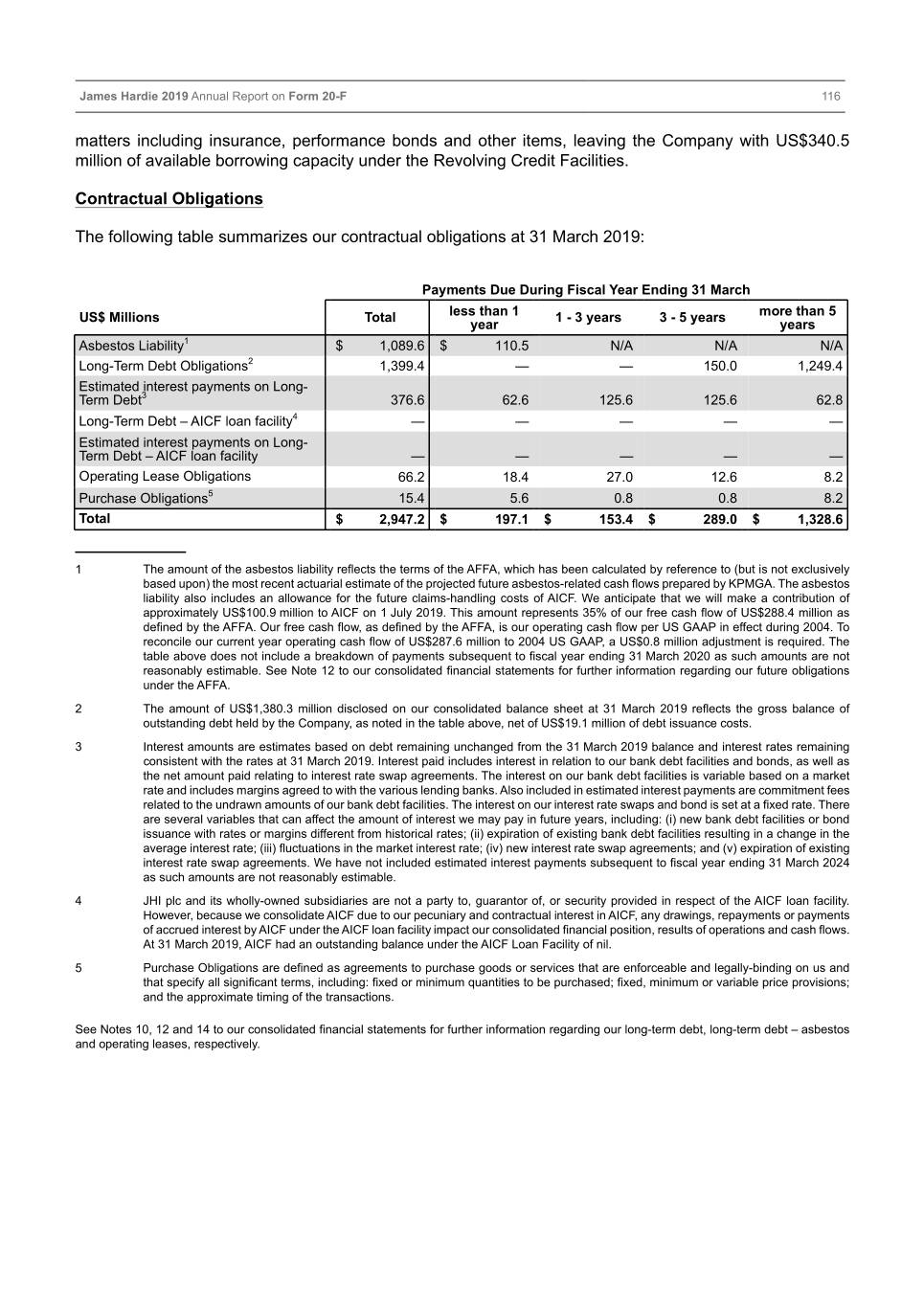
Table of Contents James Hardie 2019 Annual Report on Form 20-F 116 matters including insurance, performance bonds and other items, leaving the Company with US$340.5 million of available borrowing capacity under the Revolving Credit Facilities. Contractual Obligations The following table summarizes our contractual obligations at 31 March 2019: Payments Due During Fiscal Year Ending 31 March US$ Millions Total less than 1 1 - 3 years 3 - 5 years more than 5 year years Asbestos Liability1 $ 1,089.6 $ 110.5 N/A N/A N/A Long-Term Debt Obligations2 1,399.4 — — 150.0 1,249.4 Estimated interest payments on Long- Term Debt3 376.6 62.6 125.6 125.6 62.8 Long-Term Debt – AICF loan facility4 — — — — — Estimated interest payments on Long- Term Debt – AICF loan facility — — — — — Operating Lease Obligations 66.2 18.4 27.0 12.6 8.2 Purchase Obligations5 15.4 5.6 0.8 0.8 8.2 Total $ 2,947.2 $ 197.1 $ 153.4 $ 289.0 $ 1,328.6 ____________ 1 The amount of the asbestos liability reflects the terms of the AFFA, which has been calculated by reference to (but is not exclusively based upon) the most recent actuarial estimate of the projected future asbestos-related cash flows prepared by KPMGA. The asbestos liability also includes an allowance for the future claims-handling costs of AICF. We anticipate that we will make a contribution of approximately US$100.9 million to AICF on 1 July 2019. This amount represents 35% of our free cash flow of US$288.4 million as defined by the AFFA. Our free cash flow, as defined by the AFFA, is our operating cash flow per US GAAP in effect during 2004. To reconcile our current year operating cash flow of US$287.6 million to 2004 US GAAP, a US$0.8 million adjustment is required. The table above does not include a breakdown of payments subsequent to fiscal year ending 31 March 2020 as such amounts are not reasonably estimable. See Note 12 to our consolidated financial statements for further information regarding our future obligations under the AFFA. 2 The amount of US$1,380.3 million disclosed on our consolidated balance sheet at 31 March 2019 reflects the gross balance of outstanding debt held by the Company, as noted in the table above, net of US$19.1 million of debt issuance costs. 3 Interest amounts are estimates based on debt remaining unchanged from the 31 March 2019 balance and interest rates remaining consistent with the rates at 31 March 2019. Interest paid includes interest in relation to our bank debt facilities and bonds, as well as the net amount paid relating to interest rate swap agreements. The interest on our bank debt facilities is variable based on a market rate and includes margins agreed to with the various lending banks. Also included in estimated interest payments are commitment fees related to the undrawn amounts of our bank debt facilities. The interest on our interest rate swaps and bond is set at a fixed rate. There are several variables that can affect the amount of interest we may pay in future years, including: (i) new bank debt facilities or bond issuance with rates or margins different from historical rates; (ii) expiration of existing bank debt facilities resulting in a change in the average interest rate; (iii) fluctuations in the market interest rate; (iv) new interest rate swap agreements; and (v) expiration of existing interest rate swap agreements. We have not included estimated interest payments subsequent to fiscal year ending 31 March 2024 as such amounts are not reasonably estimable. 4 JHI plc and its wholly-owned subsidiaries are not a party to, guarantor of, or security provided in respect of the AICF loan facility. However, because we consolidate AICF due to our pecuniary and contractual interest in AICF, any drawings, repayments or payments of accrued interest by AICF under the AICF loan facility impact our consolidated financial position, results of operations and cash flows. At 31 March 2019, AICF had an outstanding balance under the AICF Loan Facility of nil. 5 Purchase Obligations are defined as agreements to purchase goods or services that are enforceable and legally-binding on us and that specify all significant terms, including: fixed or minimum quantities to be purchased; fixed, minimum or variable price provisions; and the approximate timing of the transactions. See Notes 10, 12 and 14 to our consolidated financial statements for further information regarding our long-term debt, long-term debt – asbestos and operating leases, respectively.
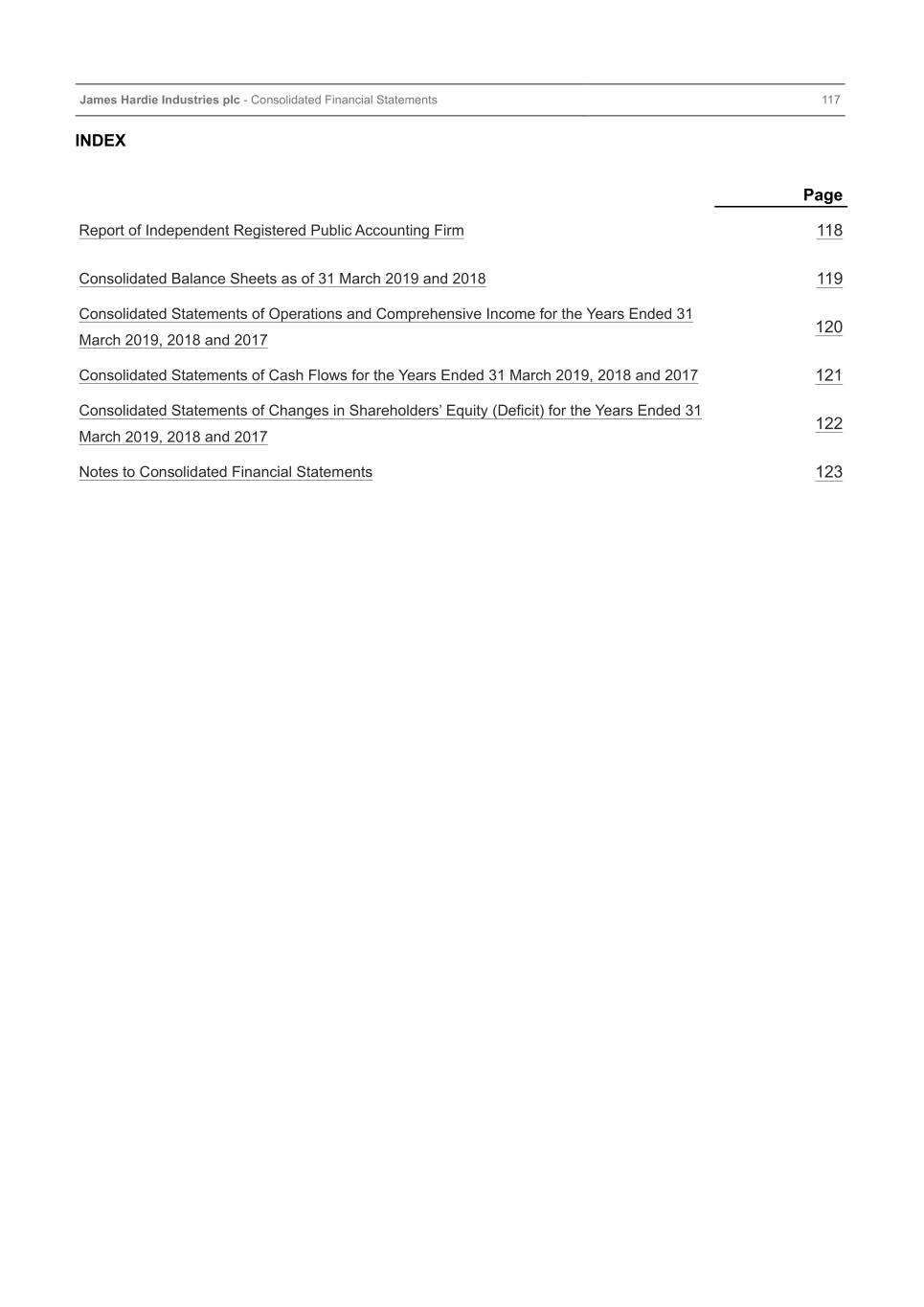
Table of Contents James Hardie Industries plc - Consolidated Financial Statements 117 INDEX Page Report of Independent Registered Public Accounting Firm 118 Consolidated Balance Sheets as of 31 March 2019 and 2018 119 Consolidated Statements of Operations and Comprehensive Income for the Years Ended 31 120 March 2019, 2018 and 2017 Consolidated Statements of Cash Flows for the Years Ended 31 March 2019, 2018 and 2017 121 Consolidated Statements of Changes in Shareholders’ Equity (Deficit) for the Years Ended 31 122 March 2019, 2018 and 2017 Notes to Consolidated Financial Statements 123
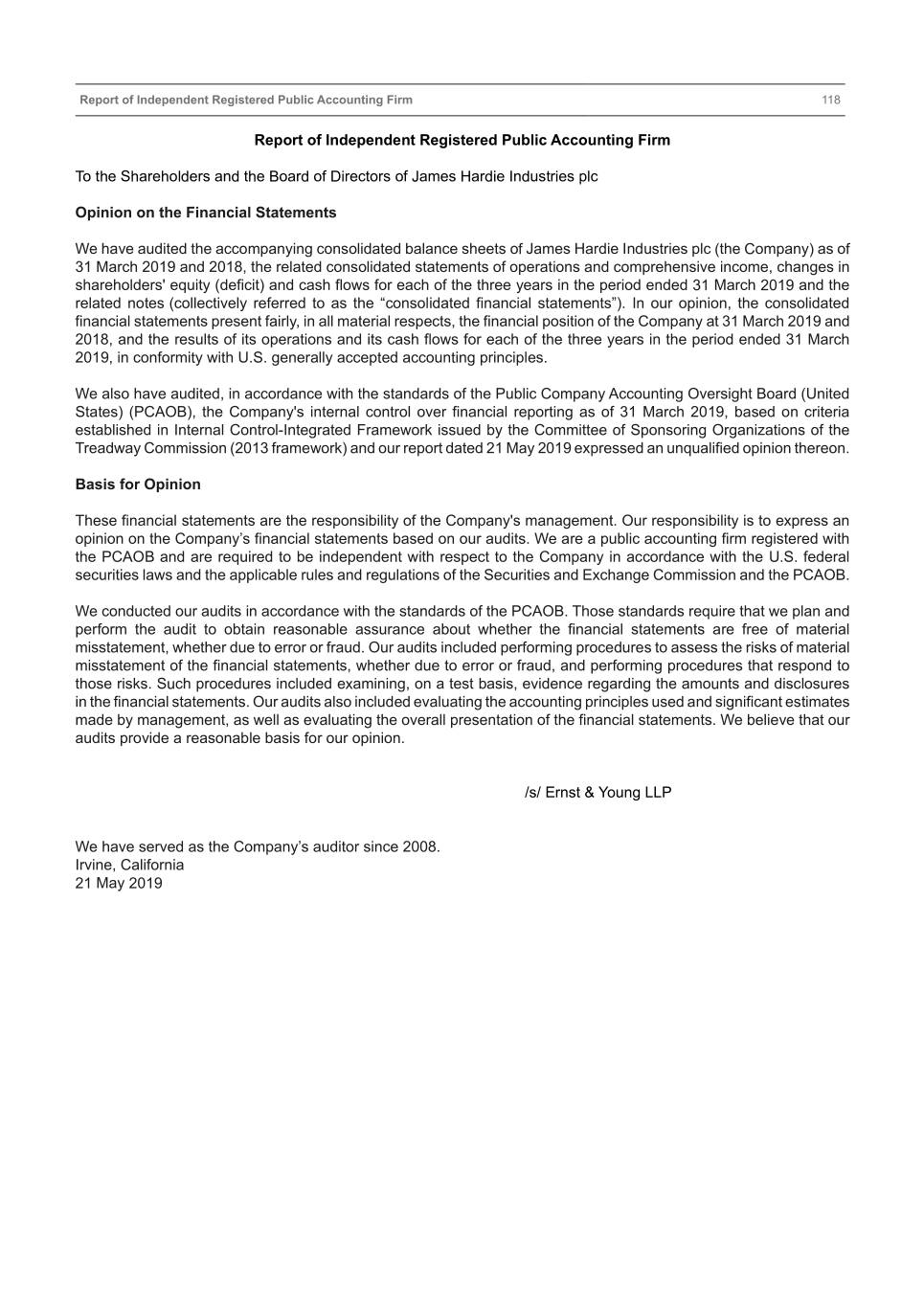
Table of Contents Report of Independent Registered Public Accounting Firm 118 Report of Independent Registered Public Accounting Firm To the Shareholders and the Board of Directors of James Hardie Industries plc Opinion on the Financial Statements We have audited the accompanying consolidated balance sheets of James Hardie Industries plc (the Company) as of 31 March 2019 and 2018, the related consolidated statements of operations and comprehensive income, changes in shareholders' equity (deficit) and cash flows for each of the three years in the period ended 31 March 2019 and the related notes (collectively referred to as the “consolidated financial statements”). In our opinion, the consolidated financial statements present fairly, in all material respects, the financial position of the Company at 31 March 2019 and 2018, and the results of its operations and its cash flows for each of the three years in the period ended 31 March 2019, in conformity with U.S. generally accepted accounting principles. We also have audited, in accordance with the standards of the Public Company Accounting Oversight Board (United States) (PCAOB), the Company's internal control over financial reporting as of 31 March 2019, based on criteria established in Internal Control-Integrated Framework issued by the Committee of Sponsoring Organizations of the Treadway Commission (2013 framework) and our report dated 21 May 2019 expressed an unqualified opinion thereon. Basis for Opinion These financial statements are the responsibility of the Company's management. Our responsibility is to express an opinion on the Company’s financial statements based on our audits. We are a public accounting firm registered with the PCAOB and are required to be independent with respect to the Company in accordance with the U.S. federal securities laws and the applicable rules and regulations of the Securities and Exchange Commission and the PCAOB. We conducted our audits in accordance with the standards of the PCAOB. Those standards require that we plan and perform the audit to obtain reasonable assurance about whether the financial statements are free of material misstatement, whether due to error or fraud. Our audits included performing procedures to assess the risks of material misstatement of the financial statements, whether due to error or fraud, and performing procedures that respond to those risks. Such procedures included examining, on a test basis, evidence regarding the amounts and disclosures in the financial statements. Our audits also included evaluating the accounting principles used and significant estimates made by management, as well as evaluating the overall presentation of the financial statements. We believe that our audits provide a reasonable basis for our opinion. /s/ Ernst & Young LLP We have served as the Company’s auditor since 2008. Irvine, California 21 May 2019
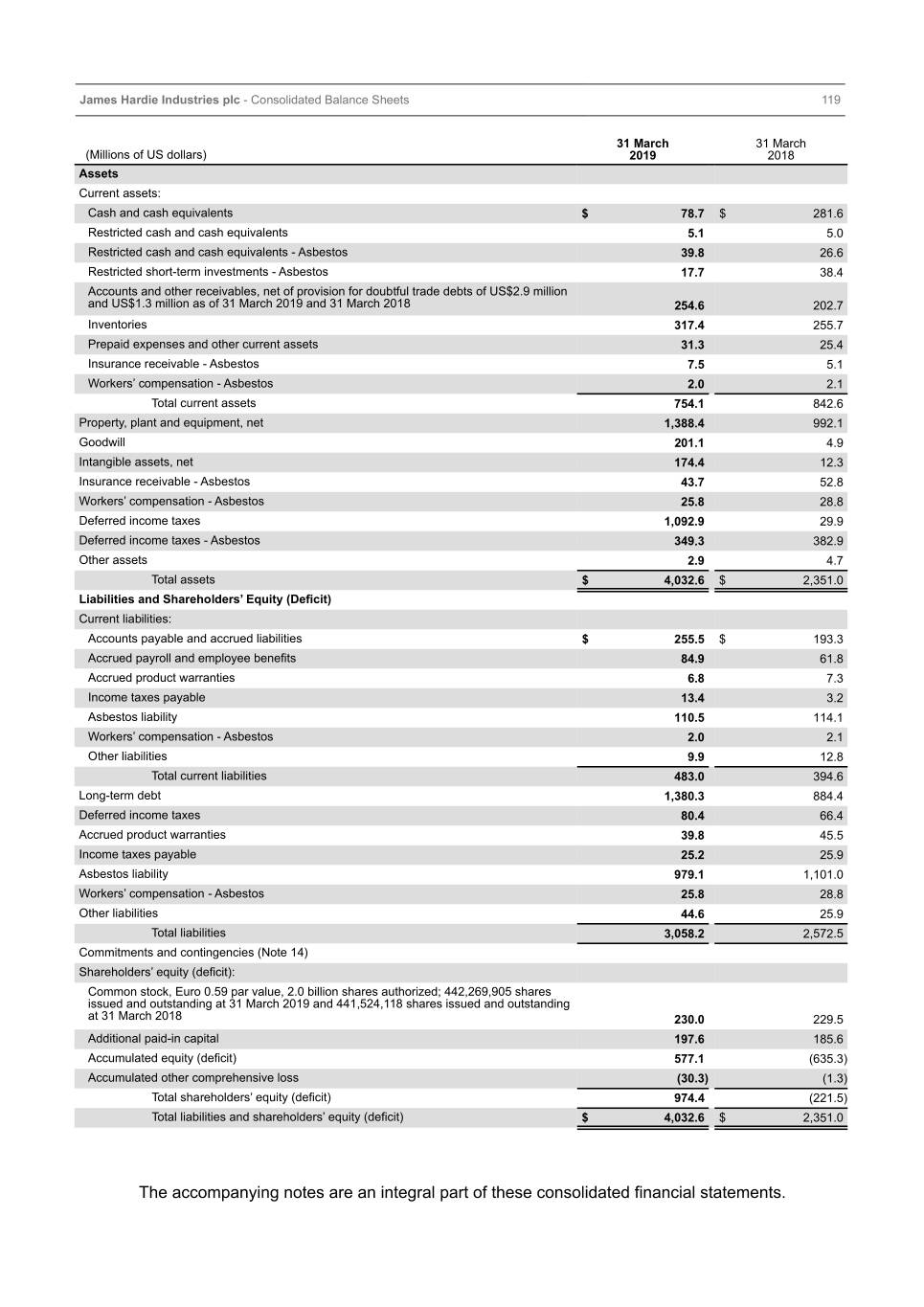
Table of Contents James Hardie Industries plc - Consolidated Balance Sheets 119 31 March 31 March (Millions of US dollars) 2019 2018 Assets Current assets: Cash and cash equivalents $ 78.7 $ 281.6 Restricted cash and cash equivalents 5.1 5.0 Restricted cash and cash equivalents - Asbestos 39.8 26.6 Restricted short-term investments - Asbestos 17.7 38.4 Accounts and other receivables, net of provision for doubtful trade debts of US$2.9 million and US$1.3 million as of 31 March 2019 and 31 March 2018 254.6 202.7 Inventories 317.4 255.7 Prepaid expenses and other current assets 31.3 25.4 Insurance receivable - Asbestos 7.5 5.1 Workers’ compensation - Asbestos 2.0 2.1 Total current assets 754.1 842.6 Property, plant and equipment, net 1,388.4 992.1 Goodwill 201.1 4.9 Intangible assets, net 174.4 12.3 Insurance receivable - Asbestos 43.7 52.8 Workers’ compensation - Asbestos 25.8 28.8 Deferred income taxes 1,092.9 29.9 Deferred income taxes - Asbestos 349.3 382.9 Other assets 2.9 4.7 Total assets $ 4,032.6 $ 2,351.0 Liabilities and Shareholders’ Equity (Deficit) Current liabilities: Accounts payable and accrued liabilities $ 255.5 $ 193.3 Accrued payroll and employee benefits 84.9 61.8 Accrued product warranties 6.8 7.3 Income taxes payable 13.4 3.2 Asbestos liability 110.5 114.1 Workers’ compensation - Asbestos 2.0 2.1 Other liabilities 9.9 12.8 Total current liabilities 483.0 394.6 Long-term debt 1,380.3 884.4 Deferred income taxes 80.4 66.4 Accrued product warranties 39.8 45.5 Income taxes payable 25.2 25.9 Asbestos liability 979.1 1,101.0 Workers’ compensation - Asbestos 25.8 28.8 Other liabilities 44.6 25.9 Total liabilities 3,058.2 2,572.5 Commitments and contingencies (Note 14) Shareholders’ equity (deficit): Common stock, Euro 0.59 par value, 2.0 billion shares authorized; 442,269,905 shares issued and outstanding at 31 March 2019 and 441,524,118 shares issued and outstanding at 31 March 2018 230.0 229.5 Additional paid-in capital 197.6 185.6 Accumulated equity (deficit) 577.1 (635.3) Accumulated other comprehensive loss (30.3) (1.3) Total shareholders’ equity (deficit) 974.4 (221.5) Total liabilities and shareholders’ equity (deficit) $ 4,032.6 $ 2,351.0 The accompanying notes are an integral part of these consolidated financial statements.

Table of Contents James Hardie Industries plc - Consolidated Statements of Operations and Comprehensive Income 120 Years Ended 31 March (Millions of US dollars, except per share data) 2019 2018 2017 Net sales $ 2,506.6 $ 2,054.5 $ 1,921.6 Cost of goods sold (1,675.6) (1,324.3) (1,246.9) Gross profit 831.0 730.2 674.7 Selling, general and administrative expenses (403.6) (311.3) (291.6) Research and development expenses (37.9) (33.3) (30.3) Asset impairments (15.9) — — Asbestos adjustments (22.0) (156.4) 40.4 Operating income 351.6 229.2 393.2 Interest expense, net of capitalized interest (54.2) (32.9) (28.5) Interest income 4.1 3.4 1.0 Loss on early debt extinguishment (1.0) (26.1) — Other income 0.1 0.7 1.3 Income before income taxes 300.6 174.3 367.0 Income tax expense (71.8) (28.2) (90.5) Net income $ 228.8 $ 146.1 $ 276.5 Income per share: Basic $ 0.52 $ 0.33 $ 0.62 Diluted $ 0.52 $ 0.33 $ 0.62 Weighted average common shares outstanding (Millions): Basic 441.9 441.2 442.7 Diluted 443.0 442.3 443.9 Comprehensive income, net of tax: Net income $ 228.8 $ 146.1 $ 276.5 Cash flow hedges (0.1) — — Currency translation adjustments (28.9) 0.9 (3.0) Comprehensive income $ 199.8 $ 147.0 $ 273.5 The accompanying notes are an integral part of these consolidated financial statements.
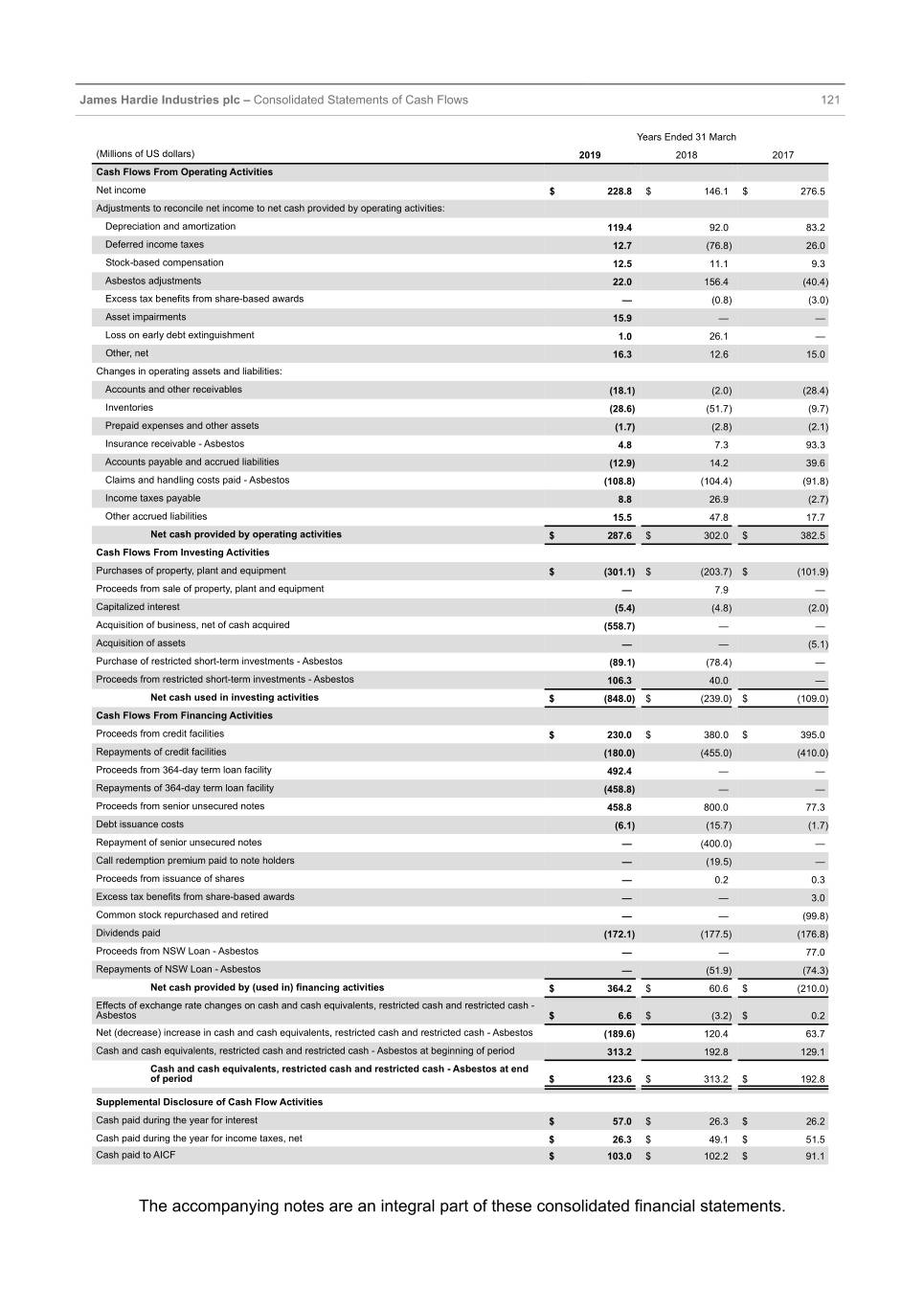
Table of Contents James Hardie Industries plc – Consolidated Statements of Cash Flows 121 Years Ended 31 March (Millions of US dollars) 2019 2018 2017 Cash Flows From Operating Activities Net income $ 228.8 $ 146.1 $ 276.5 Adjustments to reconcile net income to net cash provided by operating activities: Depreciation and amortization 119.4 92.0 83.2 Deferred income taxes 12.7 (76.8) 26.0 Stock-based compensation 12.5 11.1 9.3 Asbestos adjustments 22.0 156.4 (40.4) Excess tax benefits from share-based awards — (0.8) (3.0) Asset impairments 15.9 — — Loss on early debt extinguishment 1.0 26.1 — Other, net 16.3 12.6 15.0 Changes in operating assets and liabilities: Accounts and other receivables (18.1) (2.0) (28.4) Inventories (28.6) (51.7) (9.7) Prepaid expenses and other assets (1.7) (2.8) (2.1) Insurance receivable - Asbestos 4.8 7.3 93.3 Accounts payable and accrued liabilities (12.9) 14.2 39.6 Claims and handling costs paid - Asbestos (108.8) (104.4) (91.8) Income taxes payable 8.8 26.9 (2.7) Other accrued liabilities 15.5 47.8 17.7 Net cash provided by operating activities $ 287.6 $ 302.0 $ 382.5 Cash Flows From Investing Activities Purchases of property, plant and equipment $ (301.1) $ (203.7)$ (101.9) Proceeds from sale of property, plant and equipment — 7.9 — Capitalized interest (5.4) (4.8) (2.0) Acquisition of business, net of cash acquired (558.7) — — Acquisition of assets — — (5.1) Purchase of restricted short-term investments - Asbestos (89.1) (78.4) — Proceeds from restricted short-term investments - Asbestos 106.3 40.0 — Net cash used in investing activities $ (848.0) $ (239.0)$ (109.0) Cash Flows From Financing Activities Proceeds from credit facilities $ 230.0 $ 380.0 $ 395.0 Repayments of credit facilities (180.0) (455.0) (410.0) Proceeds from 364-day term loan facility 492.4 — — Repayments of 364-day term loan facility (458.8) — — Proceeds from senior unsecured notes 458.8 800.0 77.3 Debt issuance costs (6.1) (15.7) (1.7) Repayment of senior unsecured notes — (400.0) — Call redemption premium paid to note holders — (19.5) — Proceeds from issuance of shares — 0.2 0.3 Excess tax benefits from share-based awards — — 3.0 Common stock repurchased and retired — — (99.8) Dividends paid (172.1) (177.5) (176.8) Proceeds from NSW Loan - Asbestos — — 77.0 Repayments of NSW Loan - Asbestos — (51.9) (74.3) Net cash provided by (used in) financing activities $ 364.2 $ 60.6 $ (210.0) Effects of exchange rate changes on cash and cash equivalents, restricted cash and restricted cash - Asbestos $ 6.6 $ (3.2)$ 0.2 Net (decrease) increase in cash and cash equivalents, restricted cash and restricted cash - Asbestos (189.6) 120.4 63.7 Cash and cash equivalents, restricted cash and restricted cash - Asbestos at beginning of period 313.2 192.8 129.1 Cash and cash equivalents, restricted cash and restricted cash - Asbestos at end of period $ 123.6 $ 313.2 $ 192.8 Supplemental Disclosure of Cash Flow Activities Cash paid during the year for interest $ 57.0 $ 26.3 $ 26.2 Cash paid during the year for income taxes, net $ 26.3 $ 49.1 $ 51.5 Cash paid to AICF $ 103.0 $ 102.2 $ 91.1 The accompanying notes are an integral part of these consolidated financial statements.
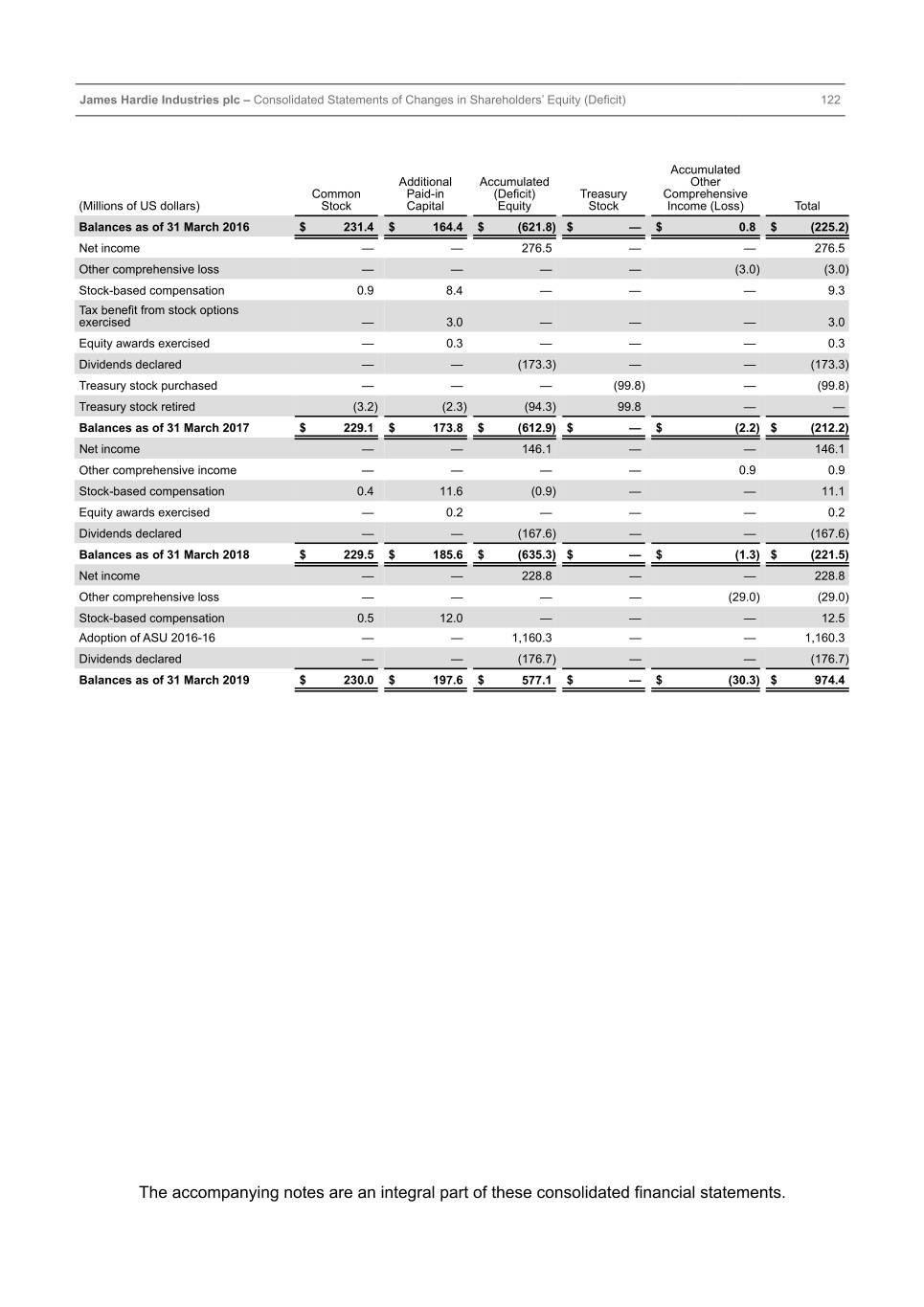
Table of Contents James Hardie Industries plc – Consolidated Statements of Changes in Shareholders’ Equity (Deficit) 122 Accumulated Additional Accumulated Other Common Paid-in (Deficit) Treasury Comprehensive (Millions of US dollars) Stock Capital Equity Stock Income (Loss) Total Balances as of 31 March 2016 $ 231.4 $ 164.4 $ (621.8)$ — $ 0.8 $ (225.2) Net income — — 276.5 — — 276.5 Other comprehensive loss — — — — (3.0) (3.0) Stock-based compensation 0.9 8.4 — — — 9.3 Tax benefit from stock options exercised — 3.0 — — — 3.0 Equity awards exercised — 0.3 — — — 0.3 Dividends declared — — (173.3) — — (173.3) Treasury stock purchased — — — (99.8) — (99.8) Treasury stock retired (3.2) (2.3) (94.3) 99.8 — — Balances as of 31 March 2017 $ 229.1 $ 173.8 $ (612.9)$ — $ (2.2)$ (212.2) Net income — — 146.1 — — 146.1 Other comprehensive income — — — — 0.9 0.9 Stock-based compensation 0.4 11.6 (0.9) — — 11.1 Equity awards exercised — 0.2 — — — 0.2 Dividends declared — — (167.6) — — (167.6) Balances as of 31 March 2018 $ 229.5 $ 185.6 $ (635.3)$ — $ (1.3)$ (221.5) Net income — — 228.8 — — 228.8 Other comprehensive loss — — — — (29.0) (29.0) Stock-based compensation 0.5 12.0 — — — 12.5 Adoption of ASU 2016-16 — — 1,160.3 — — 1,160.3 Dividends declared — — (176.7) — — (176.7) Balances as of 31 March 2019 $ 230.0 $ 197.6 $ 577.1 $ — $ (30.3)$ 974.4 The accompanying notes are an integral part of these consolidated financial statements.
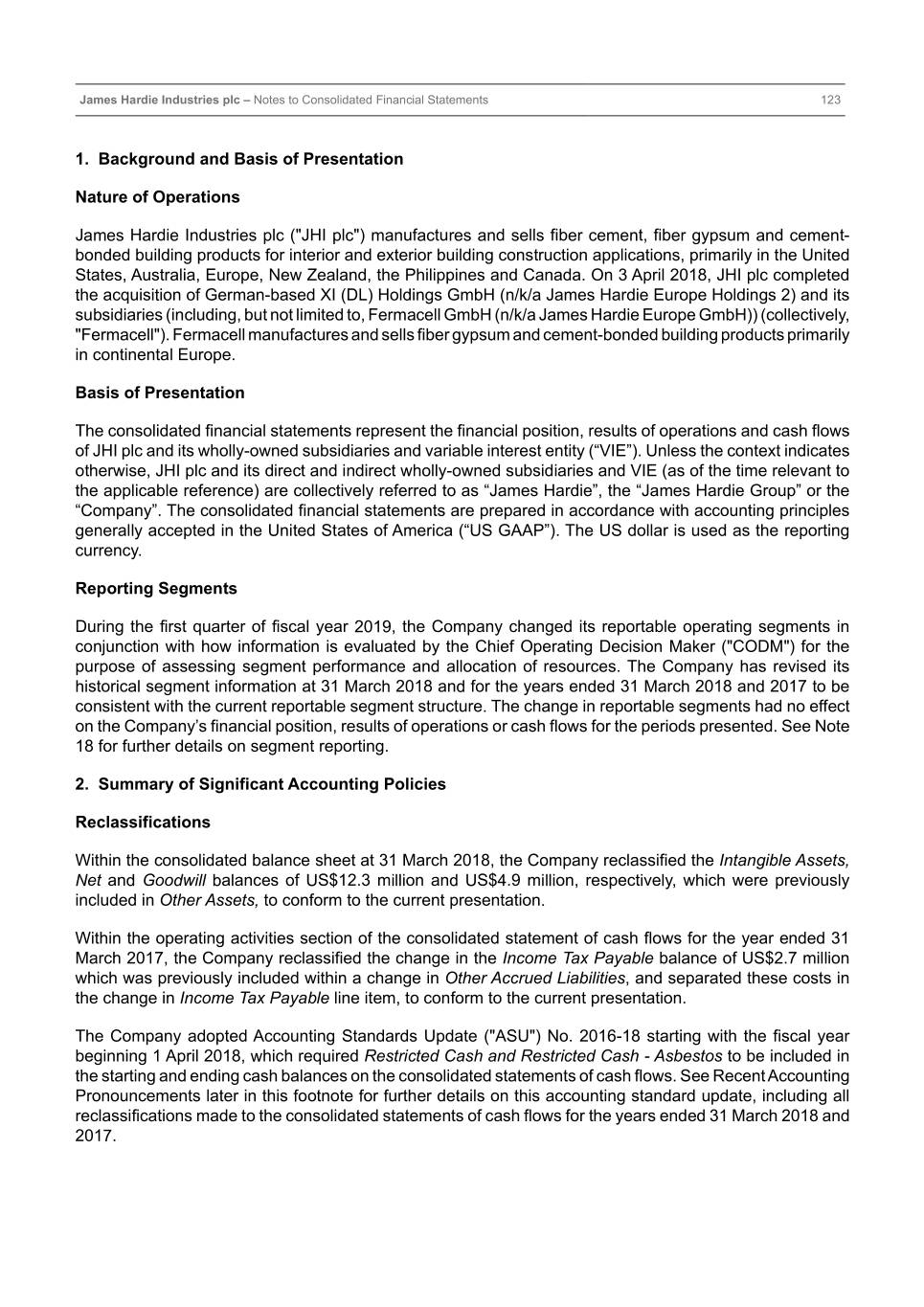
Table of Contents James Hardie Industries plc – Notes to Consolidated Financial Statements 123 1. Background and Basis of Presentation Nature of Operations James Hardie Industries plc ("JHI plc") manufactures and sells fiber cement, fiber gypsum and cement- bonded building products for interior and exterior building construction applications, primarily in the United States, Australia, Europe, New Zealand, the Philippines and Canada. On 3 April 2018, JHI plc completed the acquisition of German-based XI (DL) Holdings GmbH (n/k/a James Hardie Europe Holdings 2) and its subsidiaries (including, but not limited to, Fermacell GmbH (n/k/a James Hardie Europe GmbH)) (collectively, "Fermacell"). Fermacell manufactures and sells fiber gypsum and cement-bonded building products primarily in continental Europe. Basis of Presentation The consolidated financial statements represent the financial position, results of operations and cash flows of JHI plc and its wholly-owned subsidiaries and variable interest entity (“VIE”). Unless the context indicates otherwise, JHI plc and its direct and indirect wholly-owned subsidiaries and VIE (as of the time relevant to the applicable reference) are collectively referred to as “James Hardie”, the “James Hardie Group” or the “Company”. The consolidated financial statements are prepared in accordance with accounting principles generally accepted in the United States of America (“US GAAP”). The US dollar is used as the reporting currency. Reporting Segments During the first quarter of fiscal year 2019, the Company changed its reportable operating segments in conjunction with how information is evaluated by the Chief Operating Decision Maker ("CODM") for the purpose of assessing segment performance and allocation of resources. The Company has revised its historical segment information at 31 March 2018 and for the years ended 31 March 2018 and 2017 to be consistent with the current reportable segment structure. The change in reportable segments had no effect on the Company’s financial position, results of operations or cash flows for the periods presented. See Note 18 for further details on segment reporting. 2. Summary of Significant Accounting Policies Reclassifications Within the consolidated balance sheet at 31 March 2018, the Company reclassified the Intangible Assets, Net and Goodwill balances of US$12.3 million and US$4.9 million, respectively, which were previously included in Other Assets, to conform to the current presentation. Within the operating activities section of the consolidated statement of cash flows for the year ended 31 March 2017, the Company reclassified the change in the Income Tax Payable balance of US$2.7 million which was previously included within a change in Other Accrued Liabilities, and separated these costs in the change in Income Tax Payable line item, to conform to the current presentation. The Company adopted Accounting Standards Update ("ASU") No. 2016-18 starting with the fiscal year beginning 1 April 2018, which required Restricted Cash and Restricted Cash - Asbestos to be included in the starting and ending cash balances on the consolidated statements of cash flows. See Recent Accounting Pronouncements later in this footnote for further details on this accounting standard update, including all reclassifications made to the consolidated statements of cash flows for the years ended 31 March 2018 and 2017.
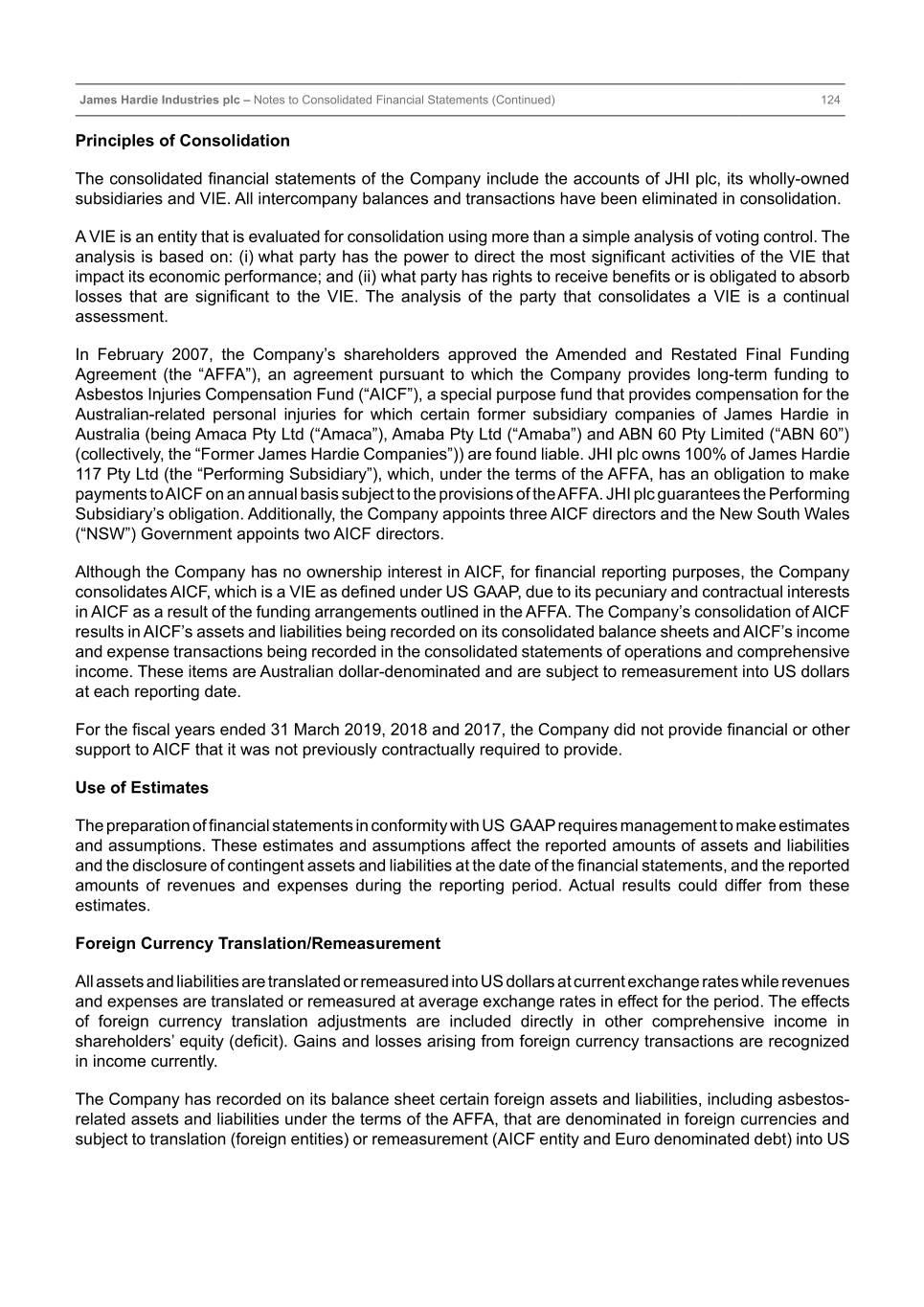
Table of Contents James Hardie Industries plc – Notes to Consolidated Financial Statements (Continued) 124 Principles of Consolidation The consolidated financial statements of the Company include the accounts of JHI plc, its wholly-owned subsidiaries and VIE. All intercompany balances and transactions have been eliminated in consolidation. A VIE is an entity that is evaluated for consolidation using more than a simple analysis of voting control. The analysis is based on: (i) what party has the power to direct the most significant activities of the VIE that impact its economic performance; and (ii) what party has rights to receive benefits or is obligated to absorb losses that are significant to the VIE. The analysis of the party that consolidates a VIE is a continual assessment. In February 2007, the Company’s shareholders approved the Amended and Restated Final Funding Agreement (the “AFFA”), an agreement pursuant to which the Company provides long-term funding to Asbestos Injuries Compensation Fund (“AICF”), a special purpose fund that provides compensation for the Australian-related personal injuries for which certain former subsidiary companies of James Hardie in Australia (being Amaca Pty Ltd (“Amaca”), Amaba Pty Ltd (“Amaba”) and ABN 60 Pty Limited (“ABN 60”) (collectively, the “Former James Hardie Companies”)) are found liable. JHI plc owns 100% of James Hardie 117 Pty Ltd (the “Performing Subsidiary”), which, under the terms of the AFFA, has an obligation to make payments to AICF on an annual basis subject to the provisions of the AFFA. JHI plc guarantees the Performing Subsidiary’s obligation. Additionally, the Company appoints three AICF directors and the New South Wales (“NSW”) Government appoints two AICF directors. Although the Company has no ownership interest in AICF, for financial reporting purposes, the Company consolidates AICF, which is a VIE as defined under US GAAP, due to its pecuniary and contractual interests in AICF as a result of the funding arrangements outlined in the AFFA. The Company’s consolidation of AICF results in AICF’s assets and liabilities being recorded on its consolidated balance sheets and AICF’s income and expense transactions being recorded in the consolidated statements of operations and comprehensive income. These items are Australian dollar-denominated and are subject to remeasurement into US dollars at each reporting date. For the fiscal years ended 31 March 2019, 2018 and 2017, the Company did not provide financial or other support to AICF that it was not previously contractually required to provide. Use of Estimates The preparation of financial statements in conformity with US GAAP requires management to make estimates and assumptions. These estimates and assumptions affect the reported amounts of assets and liabilities and the disclosure of contingent assets and liabilities at the date of the financial statements, and the reported amounts of revenues and expenses during the reporting period. Actual results could differ from these estimates. Foreign Currency Translation/Remeasurement All assets and liabilities are translated or remeasured into US dollars at current exchange rates while revenues and expenses are translated or remeasured at average exchange rates in effect for the period. The effects of foreign currency translation adjustments are included directly in other comprehensive income in shareholders’ equity (deficit). Gains and losses arising from foreign currency transactions are recognized in income currently. The Company has recorded on its balance sheet certain foreign assets and liabilities, including asbestos- related assets and liabilities under the terms of the AFFA, that are denominated in foreign currencies and subject to translation (foreign entities) or remeasurement (AICF entity and Euro denominated debt) into US
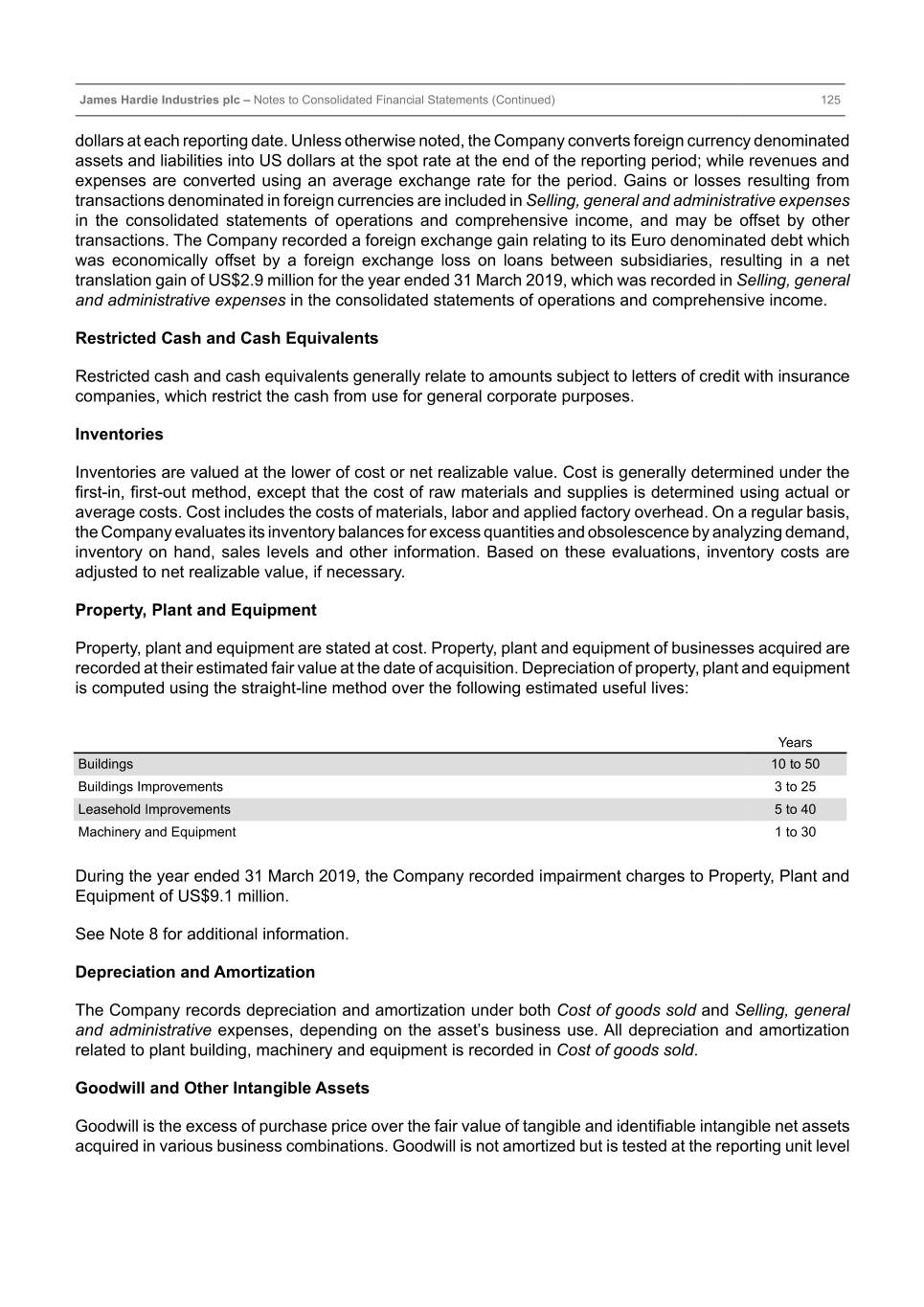
Table of Contents James Hardie Industries plc – Notes to Consolidated Financial Statements (Continued) 125 dollars at each reporting date. Unless otherwise noted, the Company converts foreign currency denominated assets and liabilities into US dollars at the spot rate at the end of the reporting period; while revenues and expenses are converted using an average exchange rate for the period. Gains or losses resulting from transactions denominated in foreign currencies are included in Selling, general and administrative expenses in the consolidated statements of operations and comprehensive income, and may be offset by other transactions. The Company recorded a foreign exchange gain relating to its Euro denominated debt which was economically offset by a foreign exchange loss on loans between subsidiaries, resulting in a net translation gain of US$2.9 million for the year ended 31 March 2019, which was recorded in Selling, general and administrative expenses in the consolidated statements of operations and comprehensive income. Restricted Cash and Cash Equivalents Restricted cash and cash equivalents generally relate to amounts subject to letters of credit with insurance companies, which restrict the cash from use for general corporate purposes. Inventories Inventories are valued at the lower of cost or net realizable value. Cost is generally determined under the first-in, first-out method, except that the cost of raw materials and supplies is determined using actual or average costs. Cost includes the costs of materials, labor and applied factory overhead. On a regular basis, the Company evaluates its inventory balances for excess quantities and obsolescence by analyzing demand, inventory on hand, sales levels and other information. Based on these evaluations, inventory costs are adjusted to net realizable value, if necessary. Property, Plant and Equipment Property, plant and equipment are stated at cost. Property, plant and equipment of businesses acquired are recorded at their estimated fair value at the date of acquisition. Depreciation of property, plant and equipment is computed using the straight-line method over the following estimated useful lives: Years Buildings 10 to 50 Buildings Improvements 3 to 25 Leasehold Improvements 5 to 40 Machinery and Equipment 1 to 30 During the year ended 31 March 2019, the Company recorded impairment charges to Property, Plant and Equipment of US$9.1 million. See Note 8 for additional information. Depreciation and Amortization The Company records depreciation and amortization under both Cost of goods sold and Selling, general and administrative expenses, depending on the asset’s business use. All depreciation and amortization related to plant building, machinery and equipment is recorded in Cost of goods sold. Goodwill and Other Intangible Assets Goodwill is the excess of purchase price over the fair value of tangible and identifiable intangible net assets acquired in various business combinations. Goodwill is not amortized but is tested at the reporting unit level
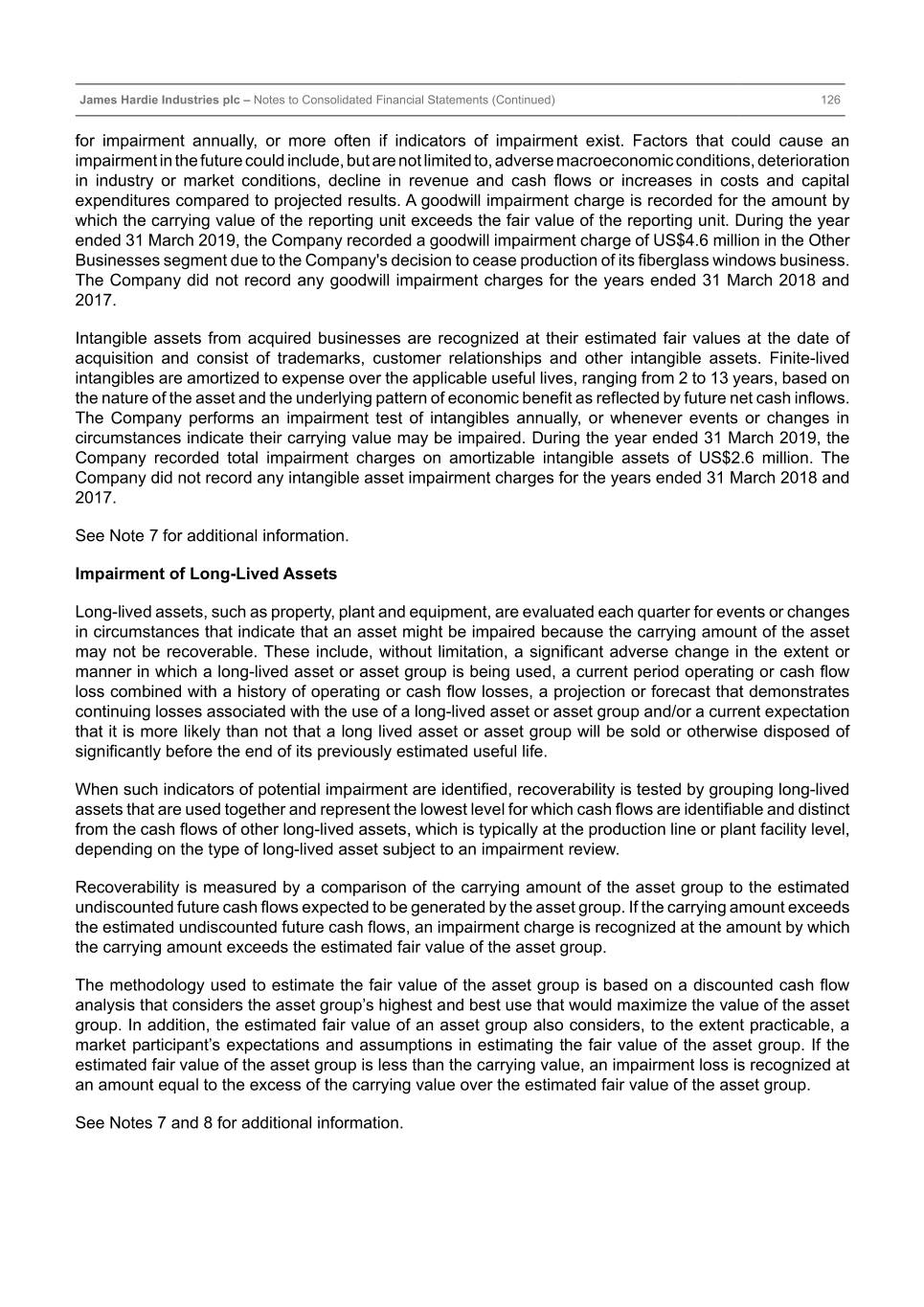
Table of Contents James Hardie Industries plc – Notes to Consolidated Financial Statements (Continued) 126 for impairment annually, or more often if indicators of impairment exist. Factors that could cause an impairment in the future could include, but are not limited to, adverse macroeconomic conditions, deterioration in industry or market conditions, decline in revenue and cash flows or increases in costs and capital expenditures compared to projected results. A goodwill impairment charge is recorded for the amount by which the carrying value of the reporting unit exceeds the fair value of the reporting unit. During the year ended 31 March 2019, the Company recorded a goodwill impairment charge of US$4.6 million in the Other Businesses segment due to the Company's decision to cease production of its fiberglass windows business. The Company did not record any goodwill impairment charges for the years ended 31 March 2018 and 2017. Intangible assets from acquired businesses are recognized at their estimated fair values at the date of acquisition and consist of trademarks, customer relationships and other intangible assets. Finite-lived intangibles are amortized to expense over the applicable useful lives, ranging from 2 to 13 years, based on the nature of the asset and the underlying pattern of economic benefit as reflected by future net cash inflows. The Company performs an impairment test of intangibles annually, or whenever events or changes in circumstances indicate their carrying value may be impaired. During the year ended 31 March 2019, the Company recorded total impairment charges on amortizable intangible assets of US$2.6 million. The Company did not record any intangible asset impairment charges for the years ended 31 March 2018 and 2017. See Note 7 for additional information. Impairment of Long-Lived Assets Long-lived assets, such as property, plant and equipment, are evaluated each quarter for events or changes in circumstances that indicate that an asset might be impaired because the carrying amount of the asset may not be recoverable. These include, without limitation, a significant adverse change in the extent or manner in which a long-lived asset or asset group is being used, a current period operating or cash flow loss combined with a history of operating or cash flow losses, a projection or forecast that demonstrates continuing losses associated with the use of a long-lived asset or asset group and/or a current expectation that it is more likely than not that a long lived asset or asset group will be sold or otherwise disposed of significantly before the end of its previously estimated useful life. When such indicators of potential impairment are identified, recoverability is tested by grouping long-lived assets that are used together and represent the lowest level for which cash flows are identifiable and distinct from the cash flows of other long-lived assets, which is typically at the production line or plant facility level, depending on the type of long-lived asset subject to an impairment review. Recoverability is measured by a comparison of the carrying amount of the asset group to the estimated undiscounted future cash flows expected to be generated by the asset group. If the carrying amount exceeds the estimated undiscounted future cash flows, an impairment charge is recognized at the amount by which the carrying amount exceeds the estimated fair value of the asset group. The methodology used to estimate the fair value of the asset group is based on a discounted cash flow analysis that considers the asset group’s highest and best use that would maximize the value of the asset group. In addition, the estimated fair value of an asset group also considers, to the extent practicable, a market participant’s expectations and assumptions in estimating the fair value of the asset group. If the estimated fair value of the asset group is less than the carrying value, an impairment loss is recognized at an amount equal to the excess of the carrying value over the estimated fair value of the asset group. See Notes 7 and 8 for additional information.
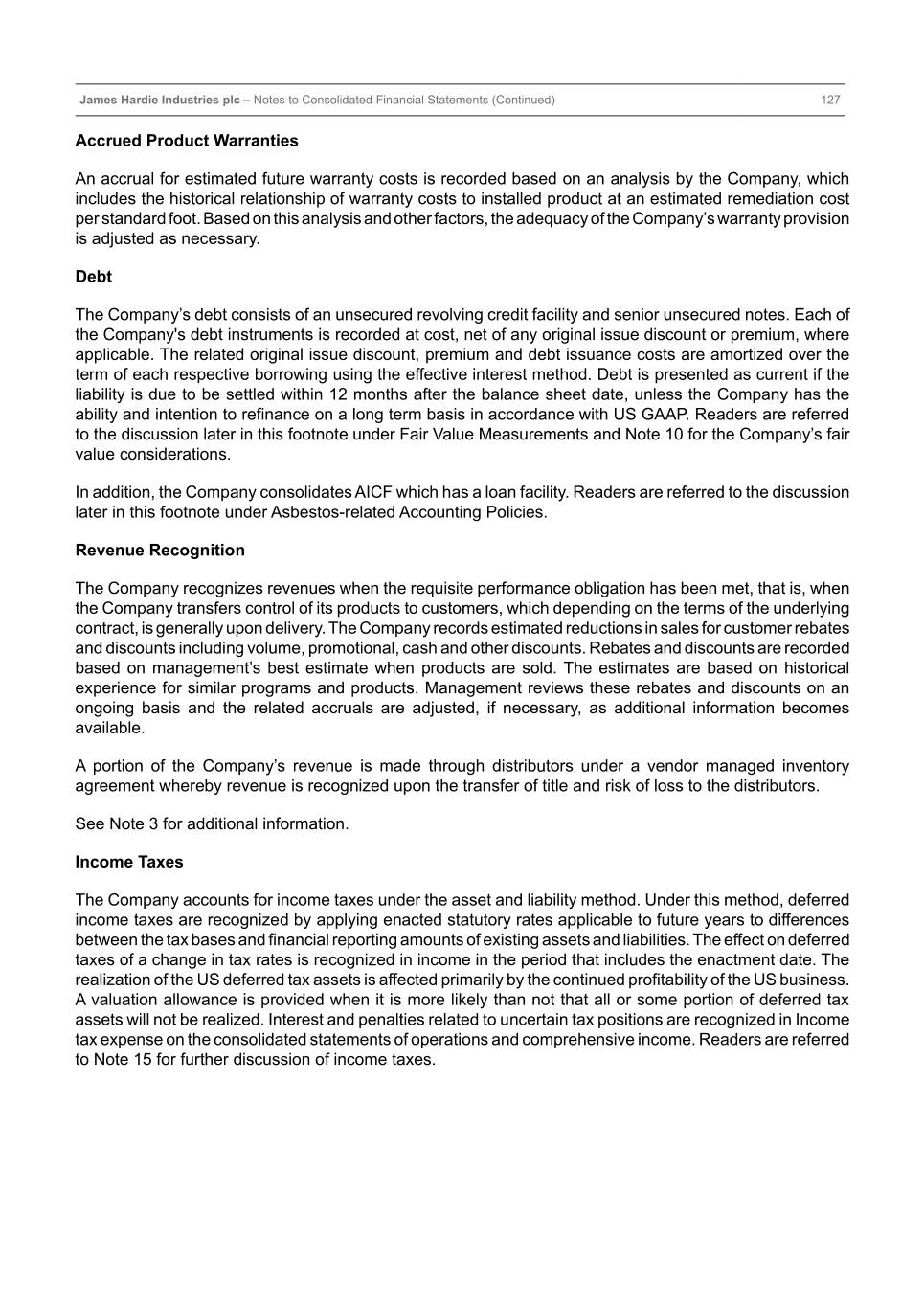
Table of Contents James Hardie Industries plc – Notes to Consolidated Financial Statements (Continued) 127 Accrued Product Warranties An accrual for estimated future warranty costs is recorded based on an analysis by the Company, which includes the historical relationship of warranty costs to installed product at an estimated remediation cost per standard foot. Based on this analysis and other factors, the adequacy of the Company’s warranty provision is adjusted as necessary. Debt The Company’s debt consists of an unsecured revolving credit facility and senior unsecured notes. Each of the Company's debt instruments is recorded at cost, net of any original issue discount or premium, where applicable. The related original issue discount, premium and debt issuance costs are amortized over the term of each respective borrowing using the effective interest method. Debt is presented as current if the liability is due to be settled within 12 months after the balance sheet date, unless the Company has the ability and intention to refinance on a long term basis in accordance with US GAAP. Readers are referred to the discussion later in this footnote under Fair Value Measurements and Note 10 for the Company’s fair value considerations. In addition, the Company consolidates AICF which has a loan facility. Readers are referred to the discussion later in this footnote under Asbestos-related Accounting Policies. Revenue Recognition The Company recognizes revenues when the requisite performance obligation has been met, that is, when the Company transfers control of its products to customers, which depending on the terms of the underlying contract, is generally upon delivery. The Company records estimated reductions in sales for customer rebates and discounts including volume, promotional, cash and other discounts. Rebates and discounts are recorded based on management’s best estimate when products are sold. The estimates are based on historical experience for similar programs and products. Management reviews these rebates and discounts on an ongoing basis and the related accruals are adjusted, if necessary, as additional information becomes available. A portion of the Company’s revenue is made through distributors under a vendor managed inventory agreement whereby revenue is recognized upon the transfer of title and risk of loss to the distributors. See Note 3 for additional information. Income Taxes The Company accounts for income taxes under the asset and liability method. Under this method, deferred income taxes are recognized by applying enacted statutory rates applicable to future years to differences between the tax bases and financial reporting amounts of existing assets and liabilities. The effect on deferred taxes of a change in tax rates is recognized in income in the period that includes the enactment date. The realization of the US deferred tax assets is affected primarily by the continued profitability of the US business. A valuation allowance is provided when it is more likely than not that all or some portion of deferred tax assets will not be realized. Interest and penalties related to uncertain tax positions are recognized in Income tax expense on the consolidated statements of operations and comprehensive income. Readers are referred to Note 15 for further discussion of income taxes.

Table of Contents James Hardie Industries plc – Notes to Consolidated Financial Statements (Continued) 128 Financial Instruments The Company calculates the fair value of financial instruments and includes this additional information in the notes to the consolidated financial statements. The estimated fair value amounts have been determined by the Company using available market information and appropriate valuation methodologies. However, considerable judgment is required in interpreting market data to develop the estimates of fair value. Accordingly, the estimates presented herein are not necessarily indicative of the amounts that the Company could realize in a current market exchange. The use of different market assumptions and/or estimation methodologies may have a material effect on the estimated fair value amounts. Periodically, interest rate swaps, commodity swaps and forward exchange contracts are used to manage market risks and reduce exposure resulting from fluctuations in interest rates, commodity prices and foreign currency exchange rates. Changes in the fair value of financial instruments that are not designated as hedges are recorded in earnings within Other income at each measurement date. The Company does not use derivatives for trading purposes. Readers are referred to Note 13 for further discussion on financial instruments. Fair Value Measurements Assets and liabilities of the Company that are carried or disclosed at fair value are classified in one of the following three categories: Level 1 Quoted market prices in active markets for identical assets and liabilities that the Company has the ability to access at the measurement date; Level 2 Observable market-based inputs or unobservable inputs that are corroborated by market data for the asset or liability at the measurement date; Level 3 Unobservable inputs that are not corroborated by market data used when there is minimal market activity for the asset or liability at the measurement date. Fair value measurements of assets and liabilities are assigned a level within the fair value hierarchy based on the lowest level of any input that is significant to the fair value measurement in its entirety. The carrying amounts of Cash and Cash Equivalents, Restricted cash and cash equivalents, Trade receivables, Trade payables and the Revolving Credit Facility approximates their respective fair values due to the short-term nature of these instruments. Stock-based Compensation Stock-based compensation expense represents the estimated fair value of equity-based and liability- classified awards granted to employees and is recognized as an expense over the vesting period. Stock- based compensation expense is included in the line item Selling, general and administrative expenses on the consolidated statements of operations and comprehensive income. Equity awards with vesting based solely on a service condition are typically subject to graded vesting, in that the awards primarily vest 25% after the first year, 25% after the second year and 50% after the third year. For equity awards subject to graded vesting, the Company has elected to use the accelerated recognition method. Accordingly, each vesting tranche is valued separately, and the recognition of stock- based compensation expense is more heavily weighted earlier in the vesting period. Stock-based compensation expense for equity awards that are subject to performance or market vesting conditions are based upon an estimate of the number of awards that are expected to vest and typically recognized ratably
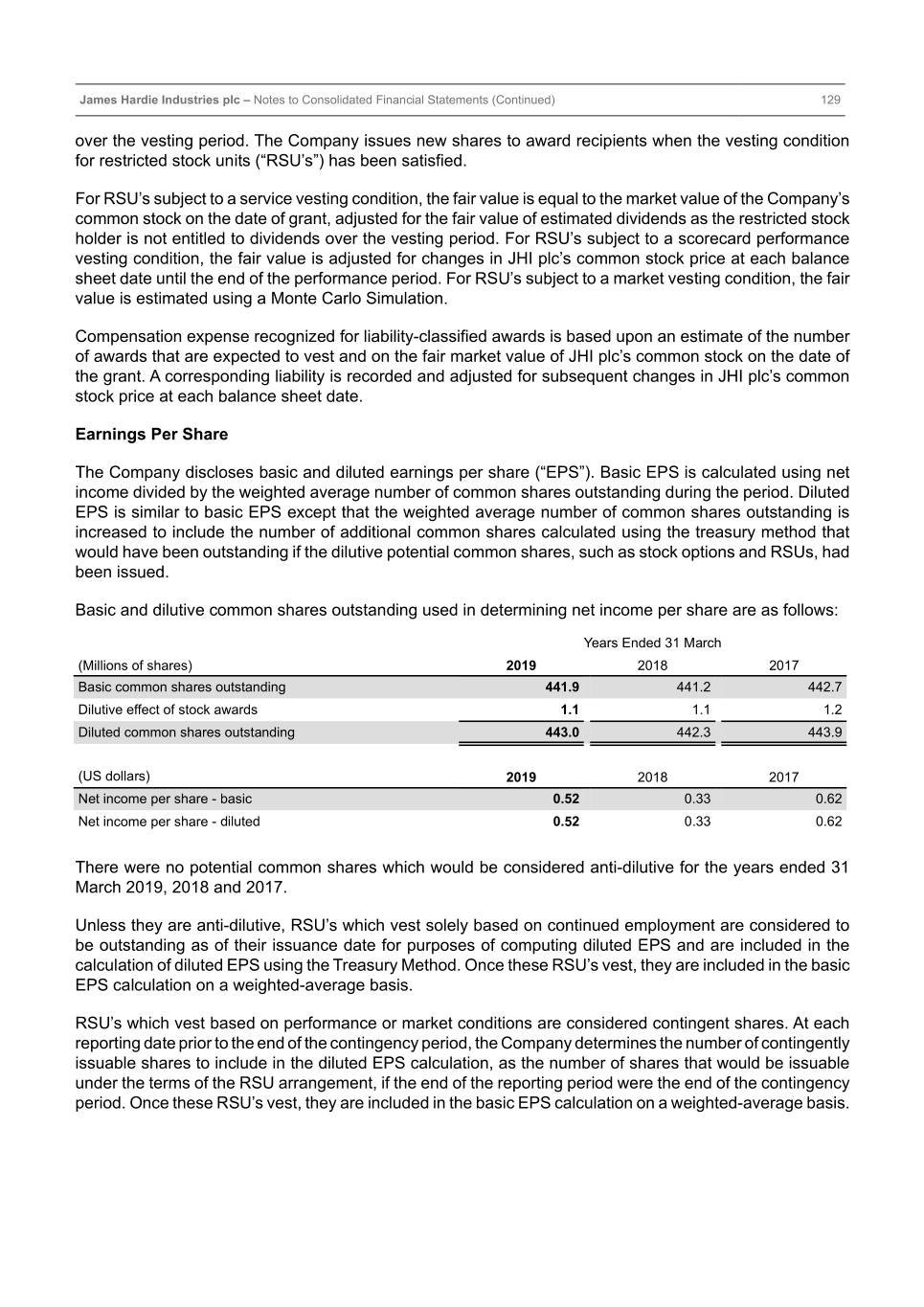
Table of Contents James Hardie Industries plc – Notes to Consolidated Financial Statements (Continued) 129 over the vesting period. The Company issues new shares to award recipients when the vesting condition for restricted stock units (“RSU’s”) has been satisfied. For RSU’s subject to a service vesting condition, the fair value is equal to the market value of the Company’s common stock on the date of grant, adjusted for the fair value of estimated dividends as the restricted stock holder is not entitled to dividends over the vesting period. For RSU’s subject to a scorecard performance vesting condition, the fair value is adjusted for changes in JHI plc’s common stock price at each balance sheet date until the end of the performance period. For RSU’s subject to a market vesting condition, the fair value is estimated using a Monte Carlo Simulation. Compensation expense recognized for liability-classified awards is based upon an estimate of the number of awards that are expected to vest and on the fair market value of JHI plc’s common stock on the date of the grant. A corresponding liability is recorded and adjusted for subsequent changes in JHI plc’s common stock price at each balance sheet date. Earnings Per Share The Company discloses basic and diluted earnings per share (“EPS”). Basic EPS is calculated using net income divided by the weighted average number of common shares outstanding during the period. Diluted EPS is similar to basic EPS except that the weighted average number of common shares outstanding is increased to include the number of additional common shares calculated using the treasury method that would have been outstanding if the dilutive potential common shares, such as stock options and RSUs, had been issued. Basic and dilutive common shares outstanding used in determining net income per share are as follows: Years Ended 31 March (Millions of shares) 2019 2018 2017 Basic common shares outstanding 441.9 441.2 442.7 Dilutive effect of stock awards 1.1 1.1 1.2 Diluted common shares outstanding 443.0 442.3 443.9 (US dollars) 2019 2018 2017 Net income per share - basic 0.52 0.33 0.62 Net income per share - diluted 0.52 0.33 0.62 There were no potential common shares which would be considered anti-dilutive for the years ended 31 March 2019, 2018 and 2017. Unless they are anti-dilutive, RSU’s which vest solely based on continued employment are considered to be outstanding as of their issuance date for purposes of computing diluted EPS and are included in the calculation of diluted EPS using the Treasury Method. Once these RSU’s vest, they are included in the basic EPS calculation on a weighted-average basis. RSU’s which vest based on performance or market conditions are considered contingent shares. At each reporting date prior to the end of the contingency period, the Company determines the number of contingently issuable shares to include in the diluted EPS calculation, as the number of shares that would be issuable under the terms of the RSU arrangement, if the end of the reporting period were the end of the contingency period. Once these RSU’s vest, they are included in the basic EPS calculation on a weighted-average basis.
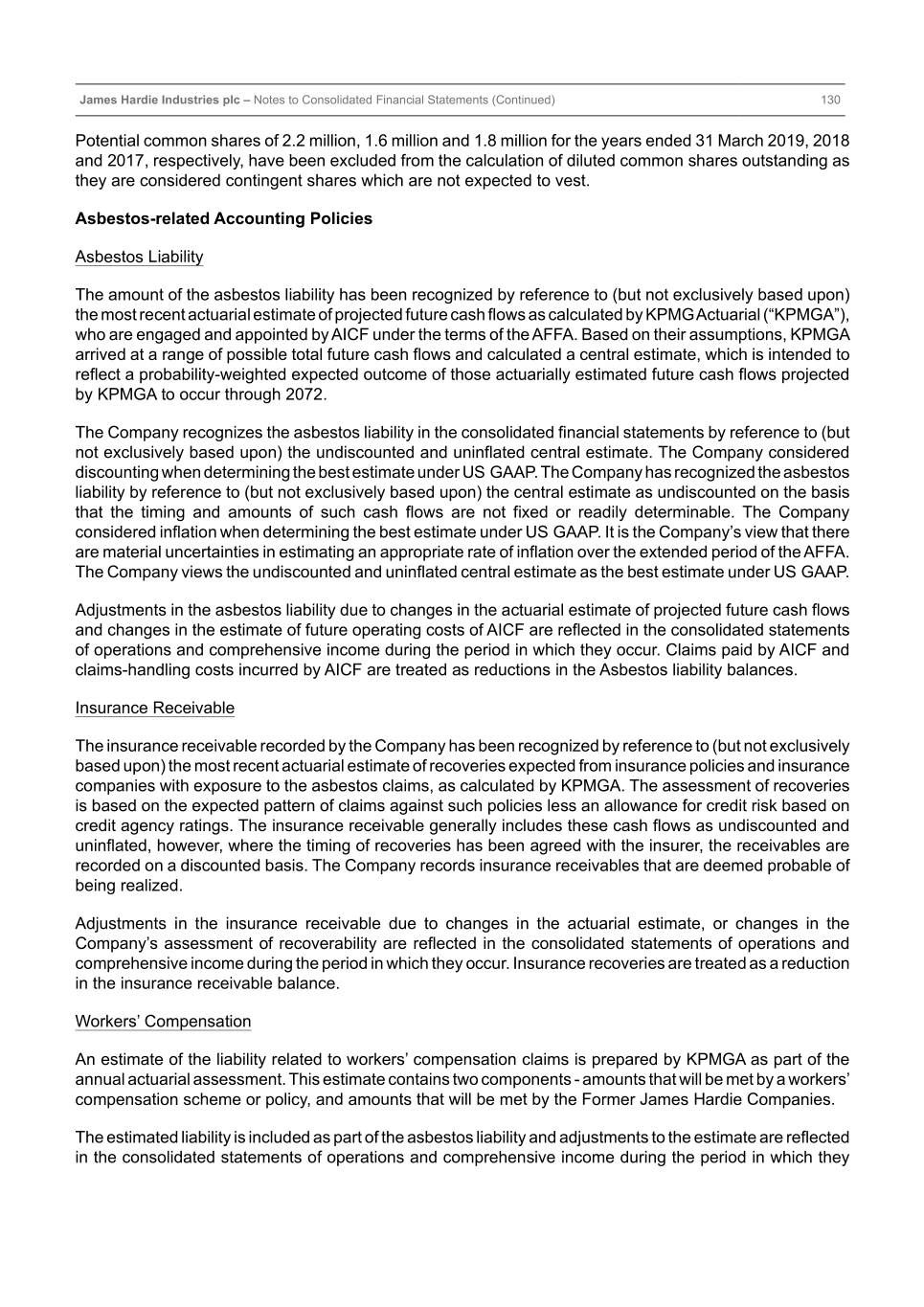
Table of Contents James Hardie Industries plc – Notes to Consolidated Financial Statements (Continued) 130 Potential common shares of 2.2 million, 1.6 million and 1.8 million for the years ended 31 March 2019, 2018 and 2017, respectively, have been excluded from the calculation of diluted common shares outstanding as they are considered contingent shares which are not expected to vest. Asbestos-related Accounting Policies Asbestos Liability The amount of the asbestos liability has been recognized by reference to (but not exclusively based upon) the most recent actuarial estimate of projected future cash flows as calculated by KPMG Actuarial (“KPMGA”), who are engaged and appointed by AICF under the terms of the AFFA. Based on their assumptions, KPMGA arrived at a range of possible total future cash flows and calculated a central estimate, which is intended to reflect a probability-weighted expected outcome of those actuarially estimated future cash flows projected by KPMGA to occur through 2072. The Company recognizes the asbestos liability in the consolidated financial statements by reference to (but not exclusively based upon) the undiscounted and uninflated central estimate. The Company considered discounting when determining the best estimate under US GAAP. The Company has recognized the asbestos liability by reference to (but not exclusively based upon) the central estimate as undiscounted on the basis that the timing and amounts of such cash flows are not fixed or readily determinable. The Company considered inflation when determining the best estimate under US GAAP. It is the Company’s view that there are material uncertainties in estimating an appropriate rate of inflation over the extended period of the AFFA. The Company views the undiscounted and uninflated central estimate as the best estimate under US GAAP. Adjustments in the asbestos liability due to changes in the actuarial estimate of projected future cash flows and changes in the estimate of future operating costs of AICF are reflected in the consolidated statements of operations and comprehensive income during the period in which they occur. Claims paid by AICF and claims-handling costs incurred by AICF are treated as reductions in the Asbestos liability balances. Insurance Receivable The insurance receivable recorded by the Company has been recognized by reference to (but not exclusively based upon) the most recent actuarial estimate of recoveries expected from insurance policies and insurance companies with exposure to the asbestos claims, as calculated by KPMGA. The assessment of recoveries is based on the expected pattern of claims against such policies less an allowance for credit risk based on credit agency ratings. The insurance receivable generally includes these cash flows as undiscounted and uninflated, however, where the timing of recoveries has been agreed with the insurer, the receivables are recorded on a discounted basis. The Company records insurance receivables that are deemed probable of being realized. Adjustments in the insurance receivable due to changes in the actuarial estimate, or changes in the Company’s assessment of recoverability are reflected in the consolidated statements of operations and comprehensive income during the period in which they occur. Insurance recoveries are treated as a reduction in the insurance receivable balance. Workers’ Compensation An estimate of the liability related to workers’ compensation claims is prepared by KPMGA as part of the annual actuarial assessment. This estimate contains two components - amounts that will be met by a workers’ compensation scheme or policy, and amounts that will be met by the Former James Hardie Companies. The estimated liability is included as part of the asbestos liability and adjustments to the estimate are reflected in the consolidated statements of operations and comprehensive income during the period in which they
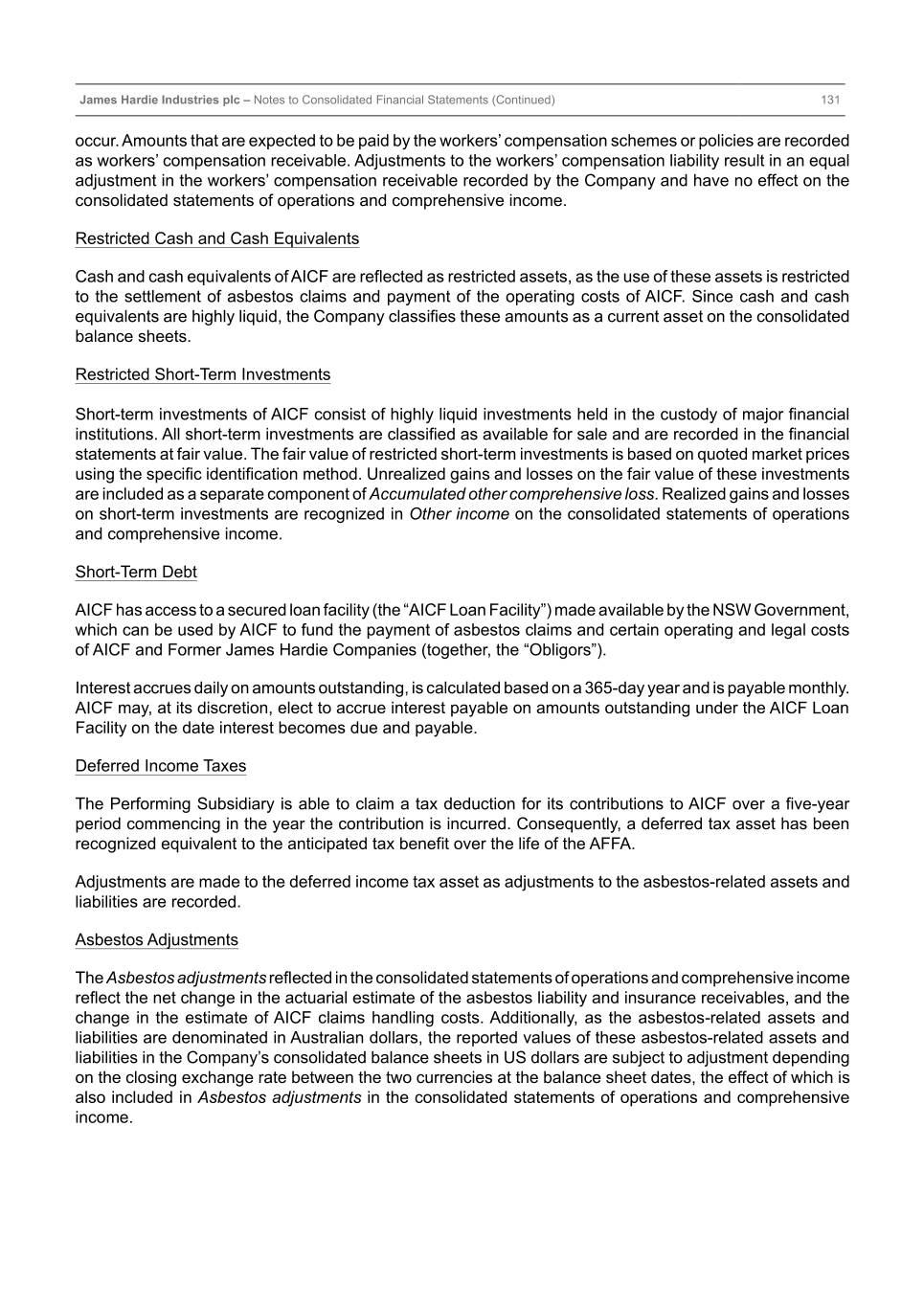
Table of Contents James Hardie Industries plc – Notes to Consolidated Financial Statements (Continued) 131 occur. Amounts that are expected to be paid by the workers’ compensation schemes or policies are recorded as workers’ compensation receivable. Adjustments to the workers’ compensation liability result in an equal adjustment in the workers’ compensation receivable recorded by the Company and have no effect on the consolidated statements of operations and comprehensive income. Restricted Cash and Cash Equivalents Cash and cash equivalents of AICF are reflected as restricted assets, as the use of these assets is restricted to the settlement of asbestos claims and payment of the operating costs of AICF. Since cash and cash equivalents are highly liquid, the Company classifies these amounts as a current asset on the consolidated balance sheets. Restricted Short-Term Investments Short-term investments of AICF consist of highly liquid investments held in the custody of major financial institutions. All short-term investments are classified as available for sale and are recorded in the financial statements at fair value. The fair value of restricted short-term investments is based on quoted market prices using the specific identification method. Unrealized gains and losses on the fair value of these investments are included as a separate component of Accumulated other comprehensive loss. Realized gains and losses on short-term investments are recognized in Other income on the consolidated statements of operations and comprehensive income. Short-Term Debt AICF has access to a secured loan facility (the “AICF Loan Facility”) made available by the NSW Government, which can be used by AICF to fund the payment of asbestos claims and certain operating and legal costs of AICF and Former James Hardie Companies (together, the “Obligors”). Interest accrues daily on amounts outstanding, is calculated based on a 365-day year and is payable monthly. AICF may, at its discretion, elect to accrue interest payable on amounts outstanding under the AICF Loan Facility on the date interest becomes due and payable. Deferred Income Taxes The Performing Subsidiary is able to claim a tax deduction for its contributions to AICF over a five-year period commencing in the year the contribution is incurred. Consequently, a deferred tax asset has been recognized equivalent to the anticipated tax benefit over the life of the AFFA. Adjustments are made to the deferred income tax asset as adjustments to the asbestos-related assets and liabilities are recorded. Asbestos Adjustments The Asbestos adjustments reflected in the consolidated statements of operations and comprehensive income reflect the net change in the actuarial estimate of the asbestos liability and insurance receivables, and the change in the estimate of AICF claims handling costs. Additionally, as the asbestos-related assets and liabilities are denominated in Australian dollars, the reported values of these asbestos-related assets and liabilities in the Company’s consolidated balance sheets in US dollars are subject to adjustment depending on the closing exchange rate between the two currencies at the balance sheet dates, the effect of which is also included in Asbestos adjustments in the consolidated statements of operations and comprehensive income.
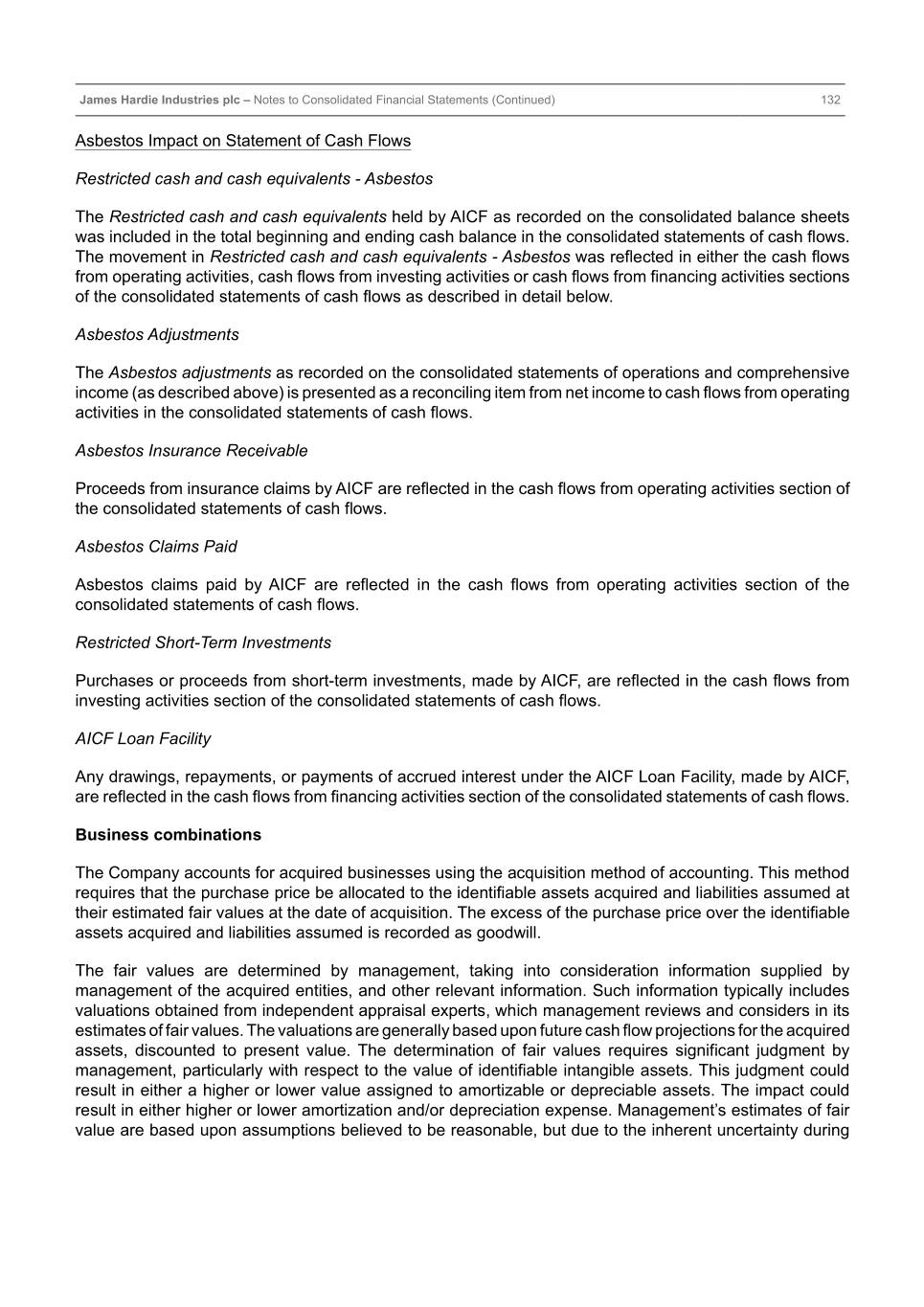
Table of Contents James Hardie Industries plc – Notes to Consolidated Financial Statements (Continued) 132 Asbestos Impact on Statement of Cash Flows Restricted cash and cash equivalents - Asbestos The Restricted cash and cash equivalents held by AICF as recorded on the consolidated balance sheets was included in the total beginning and ending cash balance in the consolidated statements of cash flows. The movement in Restricted cash and cash equivalents - Asbestos was reflected in either the cash flows from operating activities, cash flows from investing activities or cash flows from financing activities sections of the consolidated statements of cash flows as described in detail below. Asbestos Adjustments The Asbestos adjustments as recorded on the consolidated statements of operations and comprehensive income (as described above) is presented as a reconciling item from net income to cash flows from operating activities in the consolidated statements of cash flows. Asbestos Insurance Receivable Proceeds from insurance claims by AICF are reflected in the cash flows from operating activities section of the consolidated statements of cash flows. Asbestos Claims Paid Asbestos claims paid by AICF are reflected in the cash flows from operating activities section of the consolidated statements of cash flows. Restricted Short-Term Investments Purchases or proceeds from short-term investments, made by AICF, are reflected in the cash flows from investing activities section of the consolidated statements of cash flows. AICF Loan Facility Any drawings, repayments, or payments of accrued interest under the AICF Loan Facility, made by AICF, are reflected in the cash flows from financing activities section of the consolidated statements of cash flows. Business combinations The Company accounts for acquired businesses using the acquisition method of accounting. This method requires that the purchase price be allocated to the identifiable assets acquired and liabilities assumed at their estimated fair values at the date of acquisition. The excess of the purchase price over the identifiable assets acquired and liabilities assumed is recorded as goodwill. The fair values are determined by management, taking into consideration information supplied by management of the acquired entities, and other relevant information. Such information typically includes valuations obtained from independent appraisal experts, which management reviews and considers in its estimates of fair values. The valuations are generally based upon future cash flow projections for the acquired assets, discounted to present value. The determination of fair values requires significant judgment by management, particularly with respect to the value of identifiable intangible assets. This judgment could result in either a higher or lower value assigned to amortizable or depreciable assets. The impact could result in either higher or lower amortization and/or depreciation expense. Management’s estimates of fair value are based upon assumptions believed to be reasonable, but due to the inherent uncertainty during
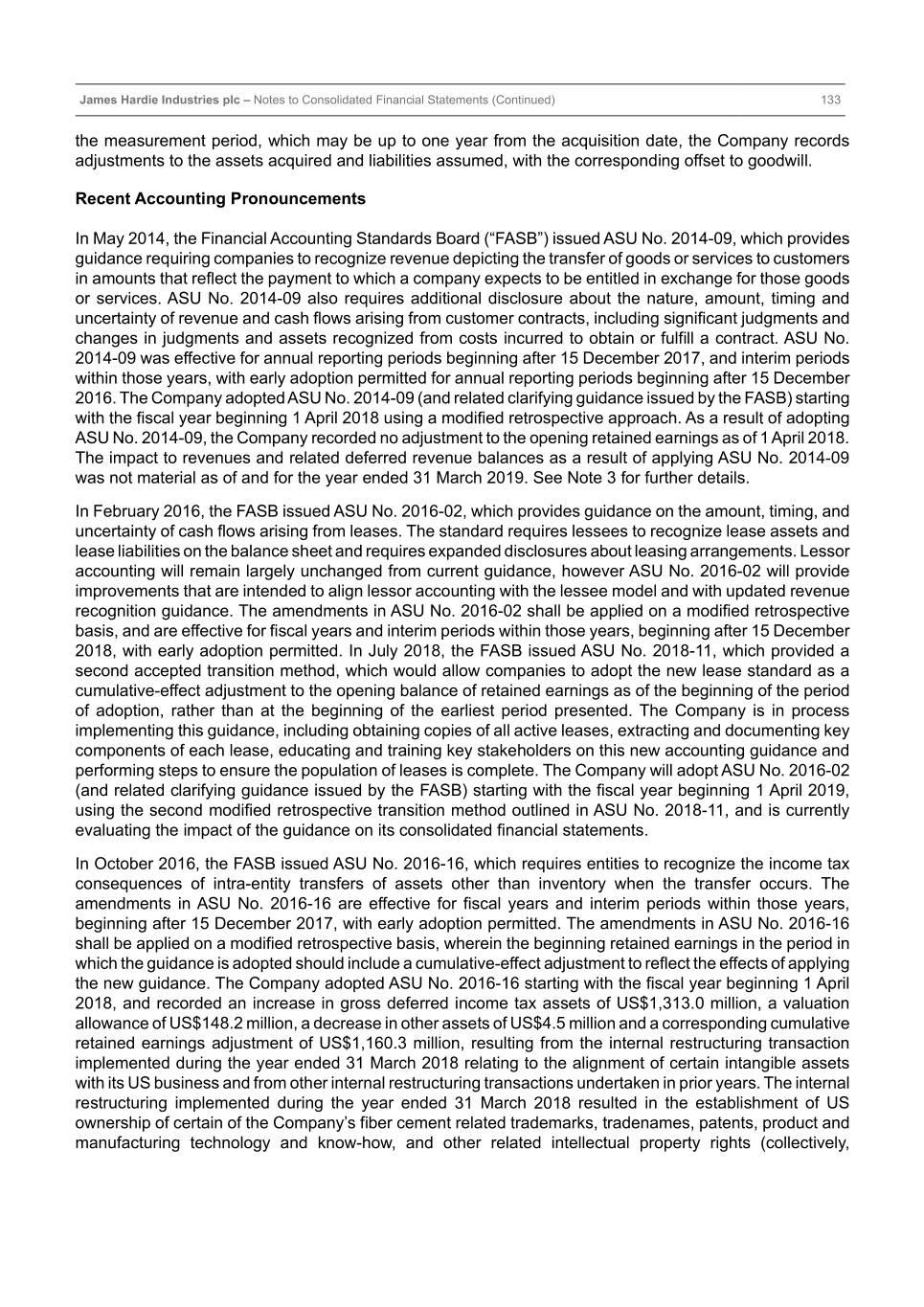
Table of Contents James Hardie Industries plc – Notes to Consolidated Financial Statements (Continued) 133 the measurement period, which may be up to one year from the acquisition date, the Company records adjustments to the assets acquired and liabilities assumed, with the corresponding offset to goodwill. Recent Accounting Pronouncements In May 2014, the Financial Accounting Standards Board (“FASB”) issued ASU No. 2014-09, which provides guidance requiring companies to recognize revenue depicting the transfer of goods or services to customers in amounts that reflect the payment to which a company expects to be entitled in exchange for those goods or services. ASU No. 2014-09 also requires additional disclosure about the nature, amount, timing and uncertainty of revenue and cash flows arising from customer contracts, including significant judgments and changes in judgments and assets recognized from costs incurred to obtain or fulfill a contract. ASU No. 2014-09 was effective for annual reporting periods beginning after 15 December 2017, and interim periods within those years, with early adoption permitted for annual reporting periods beginning after 15 December 2016. The Company adopted ASU No. 2014-09 (and related clarifying guidance issued by the FASB) starting with the fiscal year beginning 1 April 2018 using a modified retrospective approach. As a result of adopting ASU No. 2014-09, the Company recorded no adjustment to the opening retained earnings as of 1 April 2018. The impact to revenues and related deferred revenue balances as a result of applying ASU No. 2014-09 was not material as of and for the year ended 31 March 2019. See Note 3 for further details. In February 2016, the FASB issued ASU No. 2016-02, which provides guidance on the amount, timing, and uncertainty of cash flows arising from leases. The standard requires lessees to recognize lease assets and lease liabilities on the balance sheet and requires expanded disclosures about leasing arrangements. Lessor accounting will remain largely unchanged from current guidance, however ASU No. 2016-02 will provide improvements that are intended to align lessor accounting with the lessee model and with updated revenue recognition guidance. The amendments in ASU No. 2016-02 shall be applied on a modified retrospective basis, and are effective for fiscal years and interim periods within those years, beginning after 15 December 2018, with early adoption permitted. In July 2018, the FASB issued ASU No. 2018-11, which provided a second accepted transition method, which would allow companies to adopt the new lease standard as a cumulative-effect adjustment to the opening balance of retained earnings as of the beginning of the period of adoption, rather than at the beginning of the earliest period presented. The Company is in process implementing this guidance, including obtaining copies of all active leases, extracting and documenting key components of each lease, educating and training key stakeholders on this new accounting guidance and performing steps to ensure the population of leases is complete. The Company will adopt ASU No. 2016-02 (and related clarifying guidance issued by the FASB) starting with the fiscal year beginning 1 April 2019, using the second modified retrospective transition method outlined in ASU No. 2018-11, and is currently evaluating the impact of the guidance on its consolidated financial statements. In October 2016, the FASB issued ASU No. 2016-16, which requires entities to recognize the income tax consequences of intra-entity transfers of assets other than inventory when the transfer occurs. The amendments in ASU No. 2016-16 are effective for fiscal years and interim periods within those years, beginning after 15 December 2017, with early adoption permitted. The amendments in ASU No. 2016-16 shall be applied on a modified retrospective basis, wherein the beginning retained earnings in the period in which the guidance is adopted should include a cumulative-effect adjustment to reflect the effects of applying the new guidance. The Company adopted ASU No. 2016-16 starting with the fiscal year beginning 1 April 2018, and recorded an increase in gross deferred income tax assets of US$1,313.0 million, a valuation allowance of US$148.2 million, a decrease in other assets of US$4.5 million and a corresponding cumulative retained earnings adjustment of US$1,160.3 million, resulting from the internal restructuring transaction implemented during the year ended 31 March 2018 relating to the alignment of certain intangible assets with its US business and from other internal restructuring transactions undertaken in prior years. The internal restructuring implemented during the year ended 31 March 2018 resulted in the establishment of US ownership of certain of the Company’s fiber cement related trademarks, tradenames, patents, product and manufacturing technology and know-how, and other related intellectual property rights (collectively,
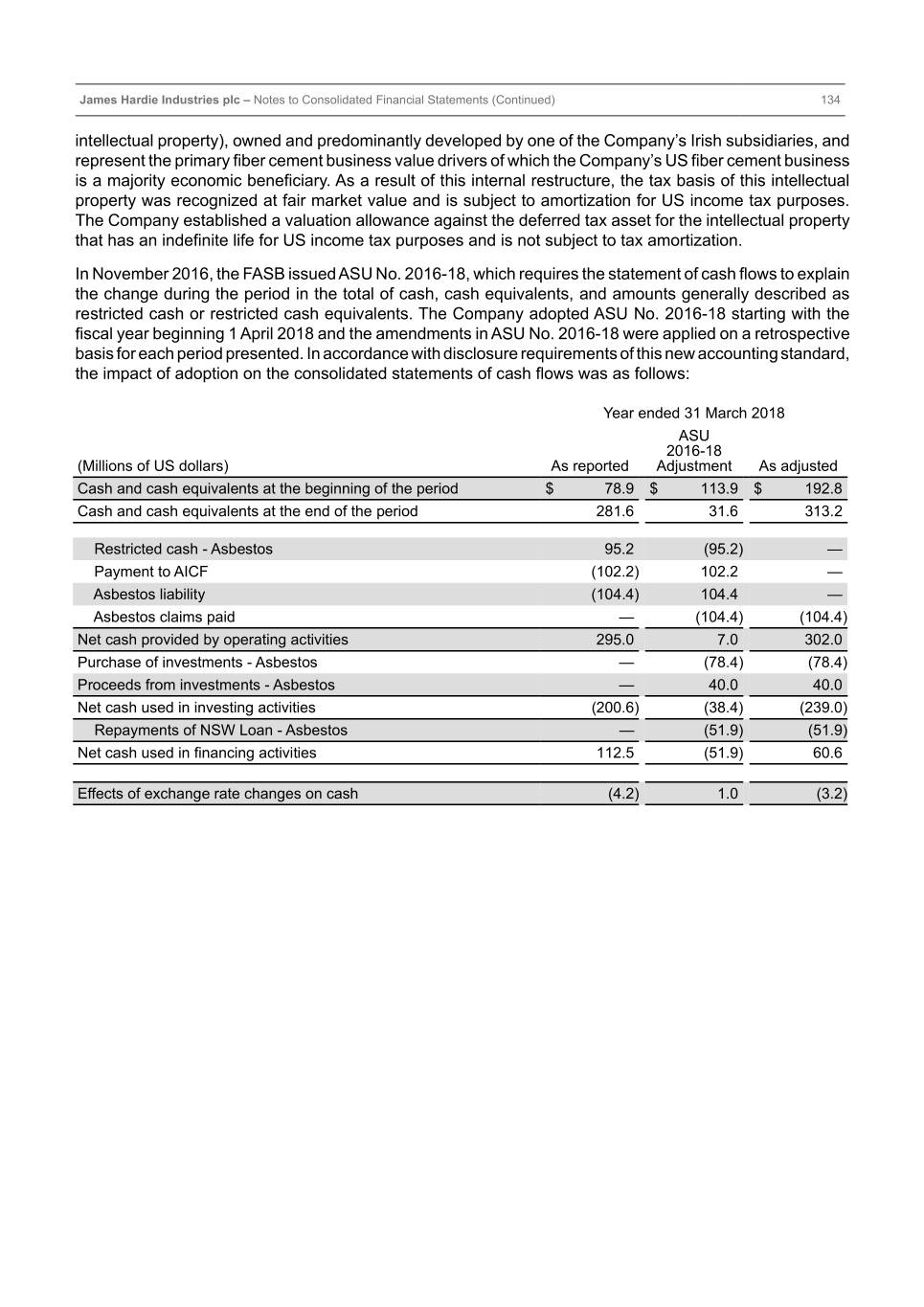
Table of Contents James Hardie Industries plc – Notes to Consolidated Financial Statements (Continued) 134 intellectual property), owned and predominantly developed by one of the Company’s Irish subsidiaries, and represent the primary fiber cement business value drivers of which the Company’s US fiber cement business is a majority economic beneficiary. As a result of this internal restructure, the tax basis of this intellectual property was recognized at fair market value and is subject to amortization for US income tax purposes. The Company established a valuation allowance against the deferred tax asset for the intellectual property that has an indefinite life for US income tax purposes and is not subject to tax amortization. In November 2016, the FASB issued ASU No. 2016-18, which requires the statement of cash flows to explain the change during the period in the total of cash, cash equivalents, and amounts generally described as restricted cash or restricted cash equivalents. The Company adopted ASU No. 2016-18 starting with the fiscal year beginning 1 April 2018 and the amendments in ASU No. 2016-18 were applied on a retrospective basis for each period presented. In accordance with disclosure requirements of this new accounting standard, the impact of adoption on the consolidated statements of cash flows was as follows: Year ended 31 March 2018 ASU 2016-18 (Millions of US dollars) As reported Adjustment As adjusted Cash and cash equivalents at the beginning of the period $ 78.9 $ 113.9 $ 192.8 Cash and cash equivalents at the end of the period 281.6 31.6 313.2 Restricted cash - Asbestos 95.2 (95.2) — Payment to AICF (102.2) 102.2 — Asbestos liability (104.4) 104.4 — Asbestos claims paid — (104.4) (104.4) Net cash provided by operating activities 295.0 7.0 302.0 Purchase of investments - Asbestos — (78.4) (78.4) Proceeds from investments - Asbestos — 40.0 40.0 Net cash used in investing activities (200.6) (38.4) (239.0) Repayments of NSW Loan - Asbestos — (51.9) (51.9) Net cash used in financing activities 112.5 (51.9) 60.6 Effects of exchange rate changes on cash (4.2) 1.0 (3.2)
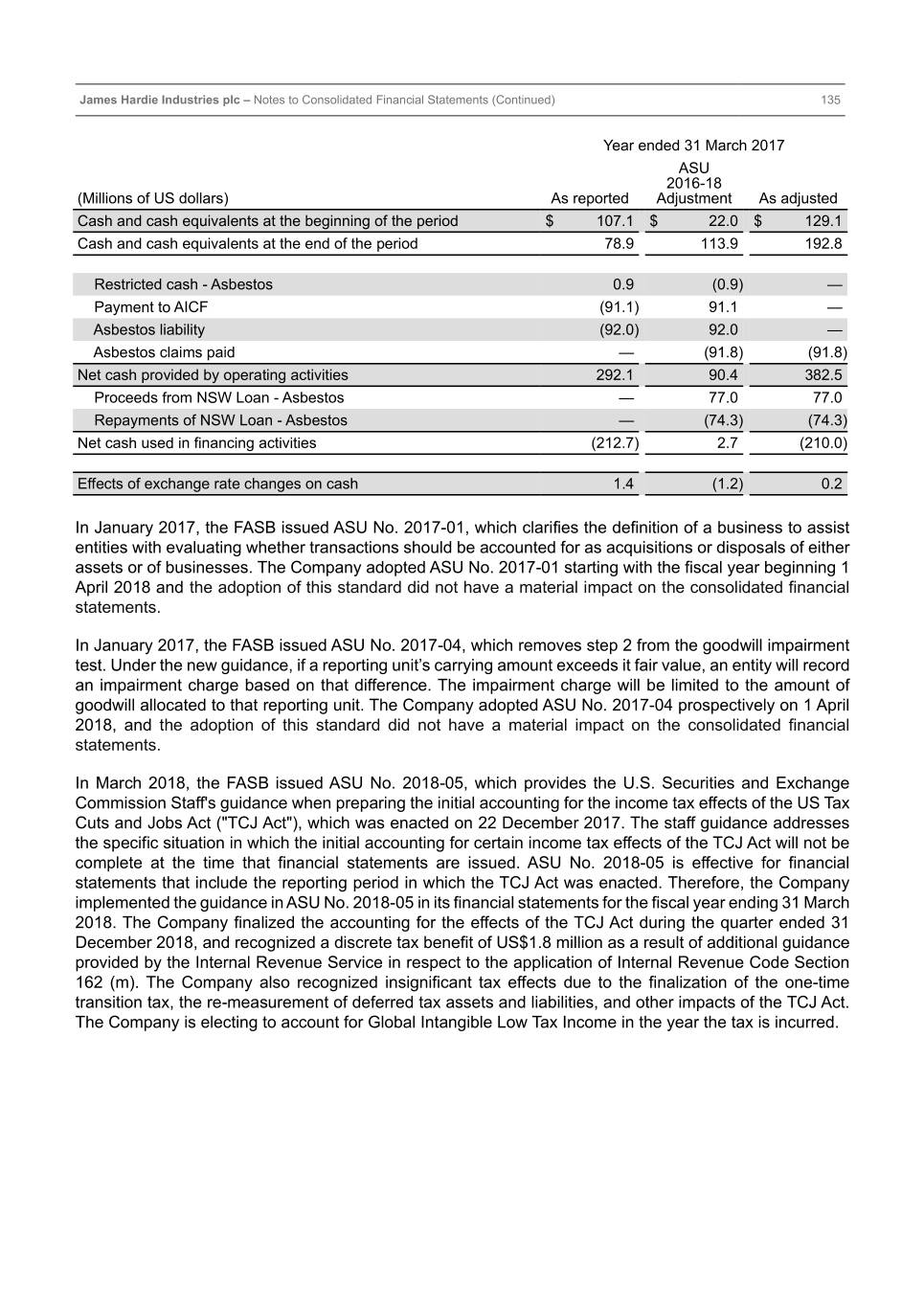
Table of Contents James Hardie Industries plc – Notes to Consolidated Financial Statements (Continued) 135 Year ended 31 March 2017 ASU 2016-18 (Millions of US dollars) As reported Adjustment As adjusted Cash and cash equivalents at the beginning of the period $ 107.1 $ 22.0 $ 129.1 Cash and cash equivalents at the end of the period 78.9 113.9 192.8 Restricted cash - Asbestos 0.9 (0.9) — Payment to AICF (91.1) 91.1 — Asbestos liability (92.0) 92.0 — Asbestos claims paid — (91.8) (91.8) Net cash provided by operating activities 292.1 90.4 382.5 Proceeds from NSW Loan - Asbestos — 77.0 77.0 Repayments of NSW Loan - Asbestos — (74.3) (74.3) Net cash used in financing activities (212.7) 2.7 (210.0) Effects of exchange rate changes on cash 1.4 (1.2) 0.2 In January 2017, the FASB issued ASU No. 2017-01, which clarifies the definition of a business to assist entities with evaluating whether transactions should be accounted for as acquisitions or disposals of either assets or of businesses. The Company adopted ASU No. 2017-01 starting with the fiscal year beginning 1 April 2018 and the adoption of this standard did not have a material impact on the consolidated financial statements. In January 2017, the FASB issued ASU No. 2017-04, which removes step 2 from the goodwill impairment test. Under the new guidance, if a reporting unit’s carrying amount exceeds it fair value, an entity will record an impairment charge based on that difference. The impairment charge will be limited to the amount of goodwill allocated to that reporting unit. The Company adopted ASU No. 2017-04 prospectively on 1 April 2018, and the adoption of this standard did not have a material impact on the consolidated financial statements. In March 2018, the FASB issued ASU No. 2018-05, which provides the U.S. Securities and Exchange Commission Staff's guidance when preparing the initial accounting for the income tax effects of the US Tax Cuts and Jobs Act ("TCJ Act"), which was enacted on 22 December 2017. The staff guidance addresses the specific situation in which the initial accounting for certain income tax effects of the TCJ Act will not be complete at the time that financial statements are issued. ASU No. 2018-05 is effective for financial statements that include the reporting period in which the TCJ Act was enacted. Therefore, the Company implemented the guidance in ASU No. 2018-05 in its financial statements for the fiscal year ending 31 March 2018. The Company finalized the accounting for the effects of the TCJ Act during the quarter ended 31 December 2018, and recognized a discrete tax benefit of US$1.8 million as a result of additional guidance provided by the Internal Revenue Service in respect to the application of Internal Revenue Code Section 162 (m). The Company also recognized insignificant tax effects due to the finalization of the one-time transition tax, the re-measurement of deferred tax assets and liabilities, and other impacts of the TCJ Act. The Company is electing to account for Global Intangible Low Tax Income in the year the tax is incurred.
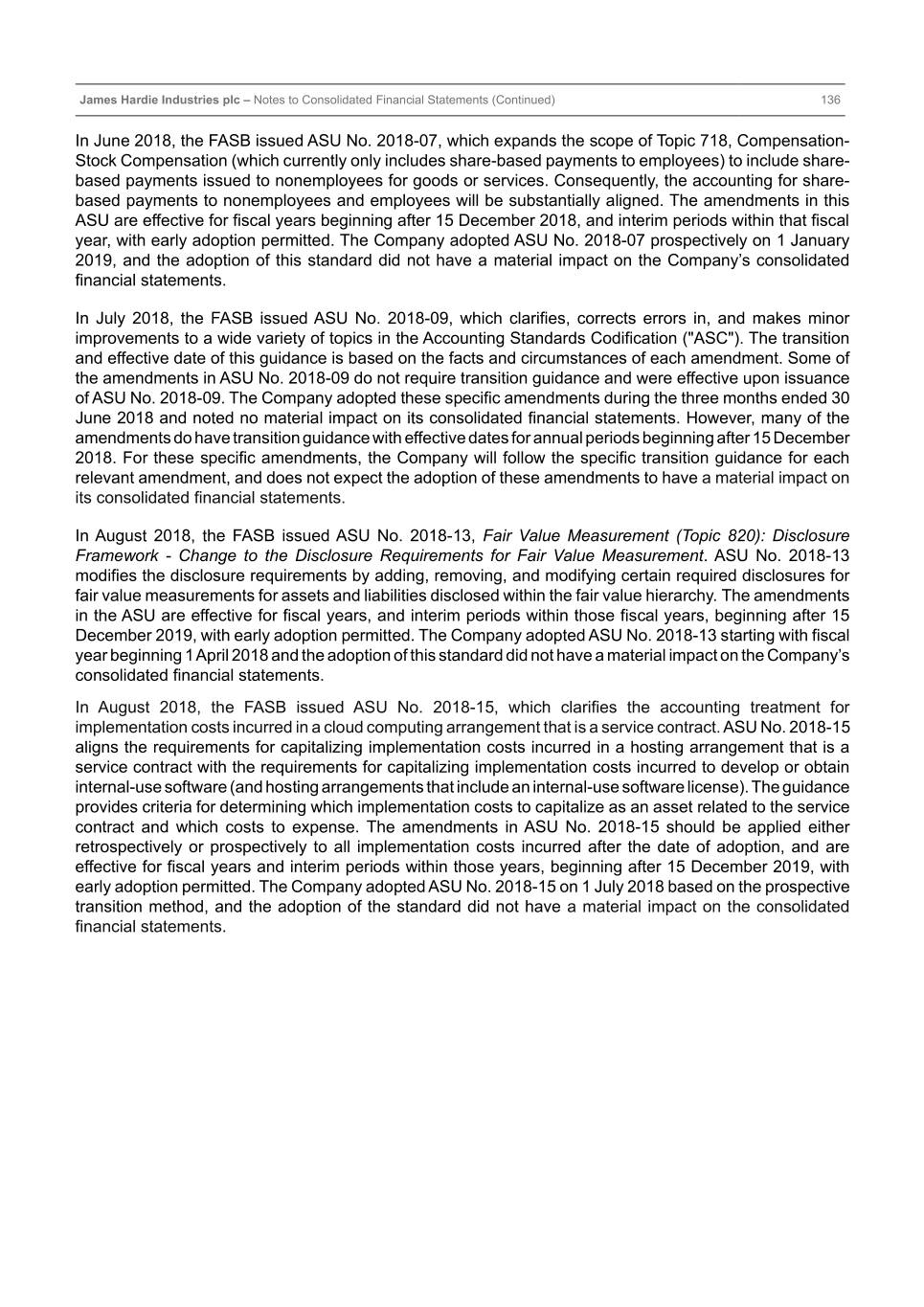
Table of Contents James Hardie Industries plc – Notes to Consolidated Financial Statements (Continued) 136 In June 2018, the FASB issued ASU No. 2018-07, which expands the scope of Topic 718, Compensation- Stock Compensation (which currently only includes share-based payments to employees) to include share- based payments issued to nonemployees for goods or services. Consequently, the accounting for share- based payments to nonemployees and employees will be substantially aligned. The amendments in this ASU are effective for fiscal years beginning after 15 December 2018, and interim periods within that fiscal year, with early adoption permitted. The Company adopted ASU No. 2018-07 prospectively on 1 January 2019, and the adoption of this standard did not have a material impact on the Company’s consolidated financial statements. In July 2018, the FASB issued ASU No. 2018-09, which clarifies, corrects errors in, and makes minor improvements to a wide variety of topics in the Accounting Standards Codification ("ASC"). The transition and effective date of this guidance is based on the facts and circumstances of each amendment. Some of the amendments in ASU No. 2018-09 do not require transition guidance and were effective upon issuance of ASU No. 2018-09. The Company adopted these specific amendments during the three months ended 30 June 2018 and noted no material impact on its consolidated financial statements. However, many of the amendments do have transition guidance with effective dates for annual periods beginning after 15 December 2018. For these specific amendments, the Company will follow the specific transition guidance for each relevant amendment, and does not expect the adoption of these amendments to have a material impact on its consolidated financial statements. In August 2018, the FASB issued ASU No. 2018-13, Fair Value Measurement (Topic 820): Disclosure Framework - Change to the Disclosure Requirements for Fair Value Measurement. ASU No. 2018-13 modifies the disclosure requirements by adding, removing, and modifying certain required disclosures for fair value measurements for assets and liabilities disclosed within the fair value hierarchy. The amendments in the ASU are effective for fiscal years, and interim periods within those fiscal years, beginning after 15 December 2019, with early adoption permitted. The Company adopted ASU No. 2018-13 starting with fiscal year beginning 1 April 2018 and the adoption of this standard did not have a material impact on the Company’s consolidated financial statements. In August 2018, the FASB issued ASU No. 2018-15, which clarifies the accounting treatment for implementation costs incurred in a cloud computing arrangement that is a service contract. ASU No. 2018-15 aligns the requirements for capitalizing implementation costs incurred in a hosting arrangement that is a service contract with the requirements for capitalizing implementation costs incurred to develop or obtain internal-use software (and hosting arrangements that include an internal-use software license). The guidance provides criteria for determining which implementation costs to capitalize as an asset related to the service contract and which costs to expense. The amendments in ASU No. 2018-15 should be applied either retrospectively or prospectively to all implementation costs incurred after the date of adoption, and are effective for fiscal years and interim periods within those years, beginning after 15 December 2019, with early adoption permitted. The Company adopted ASU No. 2018-15 on 1 July 2018 based on the prospective transition method, and the adoption of the standard did not have a material impact on the consolidated financial statements.
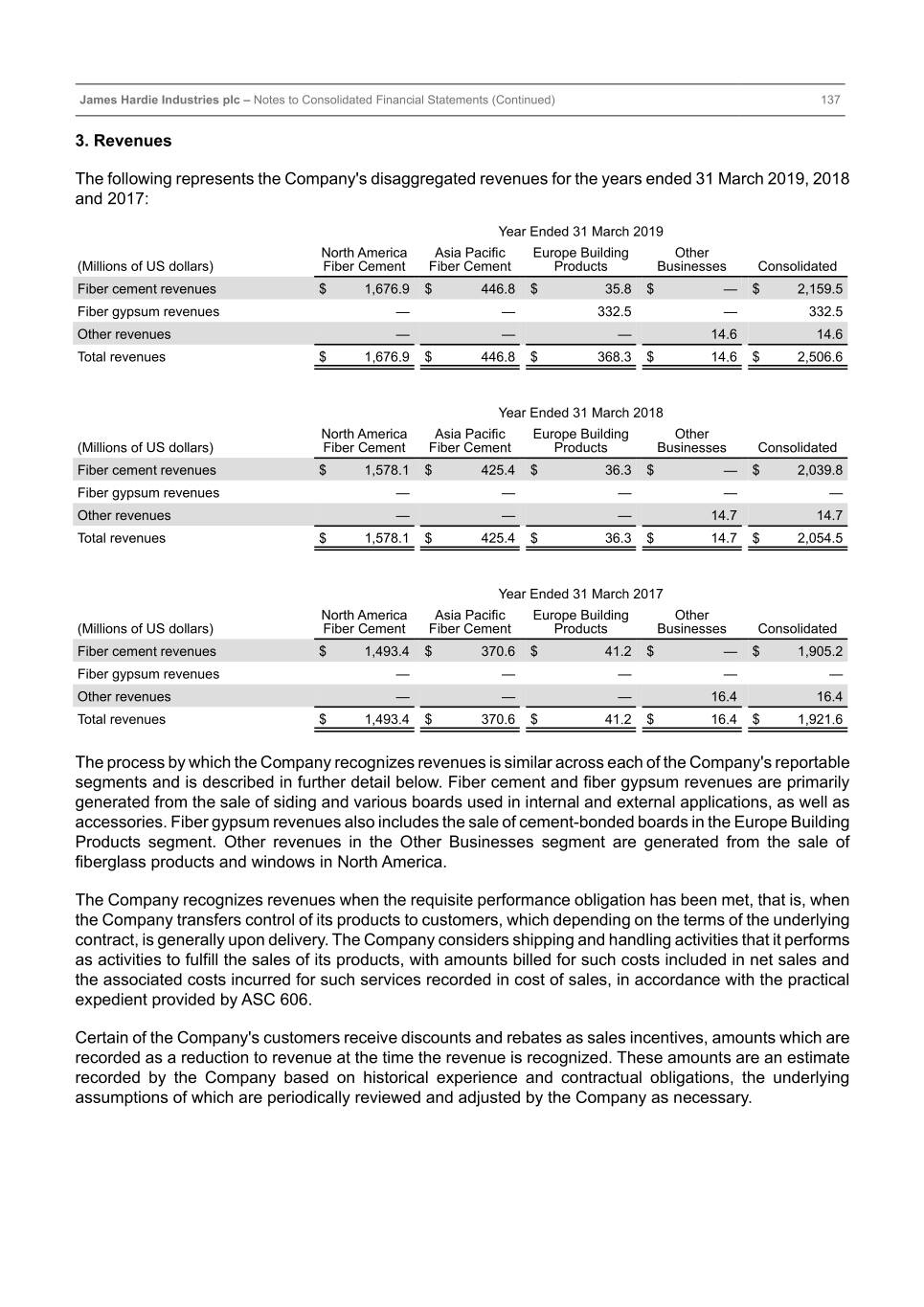
Table of Contents James Hardie Industries plc – Notes to Consolidated Financial Statements (Continued) 137 3. Revenues The following represents the Company's disaggregated revenues for the years ended 31 March 2019, 2018 and 2017: Year Ended 31 March 2019 North America Asia Pacific Europe Building Other (Millions of US dollars) Fiber Cement Fiber Cement Products Businesses Consolidated Fiber cement revenues $ 1,676.9 $ 446.8 $ 35.8 $ — $ 2,159.5 Fiber gypsum revenues — — 332.5 — 332.5 Other revenues — — — 14.6 14.6 Total revenues $ 1,676.9 $ 446.8 $ 368.3 $ 14.6 $ 2,506.6 Year Ended 31 March 2018 North America Asia Pacific Europe Building Other (Millions of US dollars) Fiber Cement Fiber Cement Products Businesses Consolidated Fiber cement revenues $ 1,578.1 $ 425.4 $ 36.3 $ — $ 2,039.8 Fiber gypsum revenues — — — — — Other revenues — — — 14.7 14.7 Total revenues $ 1,578.1 $ 425.4 $ 36.3 $ 14.7 $ 2,054.5 Year Ended 31 March 2017 North America Asia Pacific Europe Building Other (Millions of US dollars) Fiber Cement Fiber Cement Products Businesses Consolidated Fiber cement revenues $ 1,493.4 $ 370.6 $ 41.2 $ — $ 1,905.2 Fiber gypsum revenues — — — — — Other revenues — — — 16.4 16.4 Total revenues $ 1,493.4 $ 370.6 $ 41.2 $ 16.4 $ 1,921.6 The process by which the Company recognizes revenues is similar across each of the Company's reportable segments and is described in further detail below. Fiber cement and fiber gypsum revenues are primarily generated from the sale of siding and various boards used in internal and external applications, as well as accessories. Fiber gypsum revenues also includes the sale of cement-bonded boards in the Europe Building Products segment. Other revenues in the Other Businesses segment are generated from the sale of fiberglass products and windows in North America. The Company recognizes revenues when the requisite performance obligation has been met, that is, when the Company transfers control of its products to customers, which depending on the terms of the underlying contract, is generally upon delivery. The Company considers shipping and handling activities that it performs as activities to fulfill the sales of its products, with amounts billed for such costs included in net sales and the associated costs incurred for such services recorded in cost of sales, in accordance with the practical expedient provided by ASC 606. Certain of the Company's customers receive discounts and rebates as sales incentives, amounts which are recorded as a reduction to revenue at the time the revenue is recognized. These amounts are an estimate recorded by the Company based on historical experience and contractual obligations, the underlying assumptions of which are periodically reviewed and adjusted by the Company as necessary.
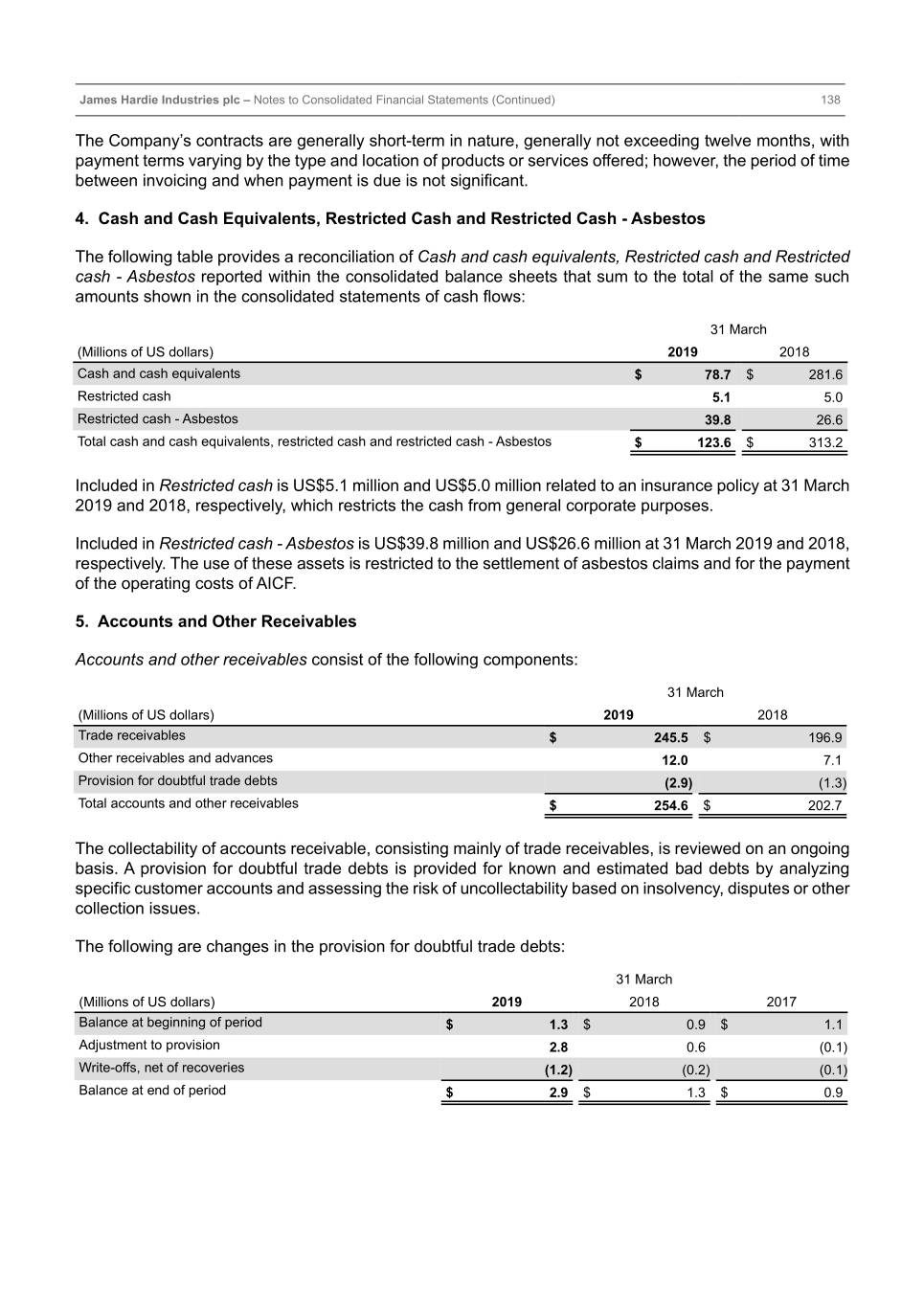
Table of Contents James Hardie Industries plc – Notes to Consolidated Financial Statements (Continued) 138 The Company’s contracts are generally short-term in nature, generally not exceeding twelve months, with payment terms varying by the type and location of products or services offered; however, the period of time between invoicing and when payment is due is not significant. 4. Cash and Cash Equivalents, Restricted Cash and Restricted Cash - Asbestos The following table provides a reconciliation of Cash and cash equivalents, Restricted cash and Restricted cash - Asbestos reported within the consolidated balance sheets that sum to the total of the same such amounts shown in the consolidated statements of cash flows: 31 March (Millions of US dollars) 2019 2018 Cash and cash equivalents $ 78.7 $ 281.6 Restricted cash 5.1 5.0 Restricted cash - Asbestos 39.8 26.6 Total cash and cash equivalents, restricted cash and restricted cash - Asbestos $ 123.6 $ 313.2 Included in Restricted cash is US$5.1 million and US$5.0 million related to an insurance policy at 31 March 2019 and 2018, respectively, which restricts the cash from general corporate purposes. Included in Restricted cash - Asbestos is US$39.8 million and US$26.6 million at 31 March 2019 and 2018, respectively. The use of these assets is restricted to the settlement of asbestos claims and for the payment of the operating costs of AICF. 5. Accounts and Other Receivables Accounts and other receivables consist of the following components: 31 March (Millions of US dollars) 2019 2018 Trade receivables $ 245.5 $ 196.9 Other receivables and advances 12.0 7.1 Provision for doubtful trade debts (2.9) (1.3) Total accounts and other receivables $ 254.6 $ 202.7 The collectability of accounts receivable, consisting mainly of trade receivables, is reviewed on an ongoing basis. A provision for doubtful trade debts is provided for known and estimated bad debts by analyzing specific customer accounts and assessing the risk of uncollectability based on insolvency, disputes or other collection issues. The following are changes in the provision for doubtful trade debts: 31 March (Millions of US dollars) 2019 2018 2017 Balance at beginning of period $ 1.3 $ 0.9 $ 1.1 Adjustment to provision 2.8 0.6 (0.1) Write-offs, net of recoveries (1.2) (0.2) (0.1) Balance at end of period $ 2.9 $ 1.3 $ 0.9
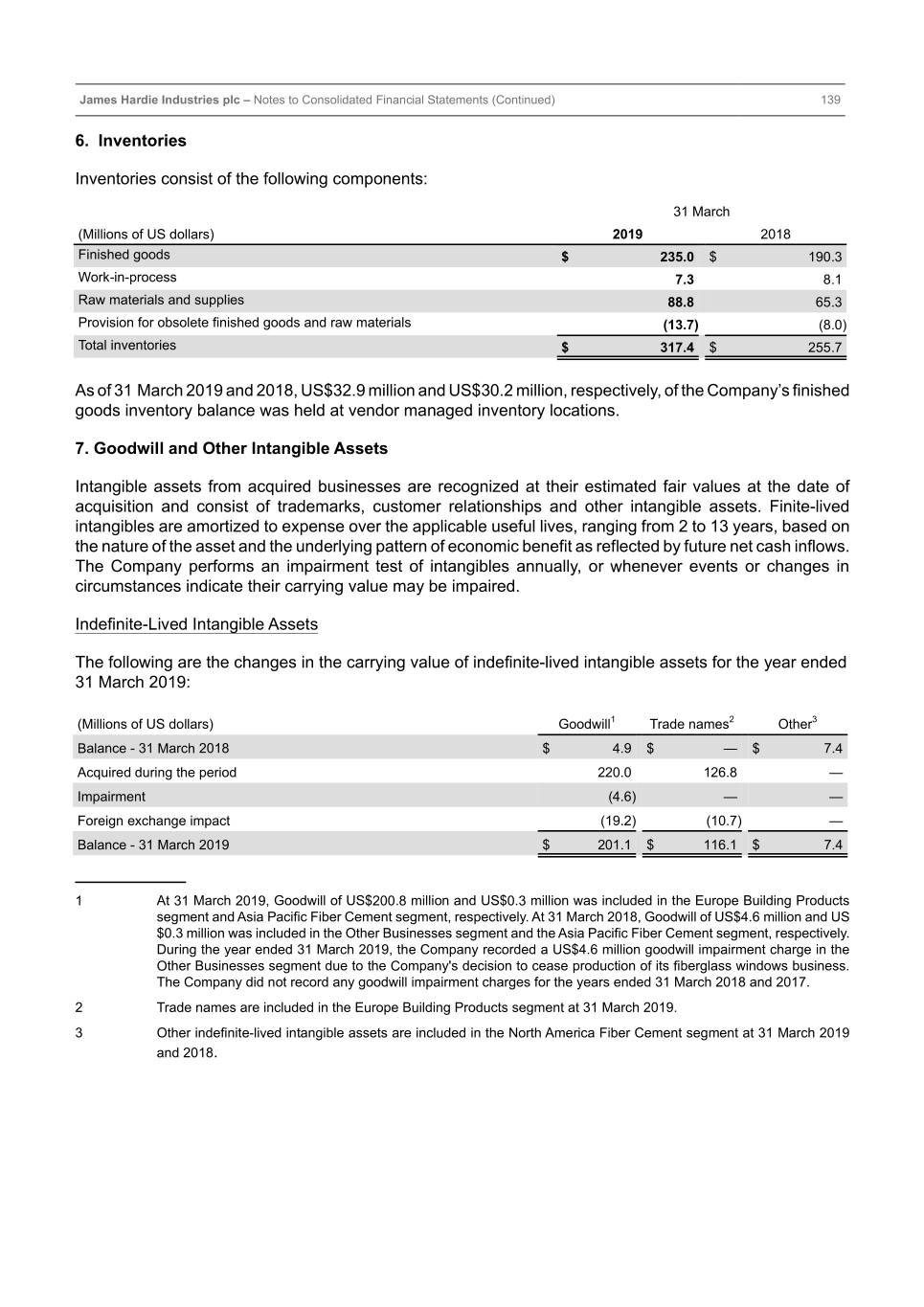
Table of Contents James Hardie Industries plc – Notes to Consolidated Financial Statements (Continued) 139 6. Inventories Inventories consist of the following components: 31 March (Millions of US dollars) 2019 2018 Finished goods $ 235.0 $ 190.3 Work-in-process 7.3 8.1 Raw materials and supplies 88.8 65.3 Provision for obsolete finished goods and raw materials (13.7) (8.0) Total inventories $ 317.4 $ 255.7 As of 31 March 2019 and 2018, US$32.9 million and US$30.2 million, respectively, of the Company’s finished goods inventory balance was held at vendor managed inventory locations. 7. Goodwill and Other Intangible Assets Intangible assets from acquired businesses are recognized at their estimated fair values at the date of acquisition and consist of trademarks, customer relationships and other intangible assets. Finite-lived intangibles are amortized to expense over the applicable useful lives, ranging from 2 to 13 years, based on the nature of the asset and the underlying pattern of economic benefit as reflected by future net cash inflows. The Company performs an impairment test of intangibles annually, or whenever events or changes in circumstances indicate their carrying value may be impaired. Indefinite-Lived Intangible Assets The following are the changes in the carrying value of indefinite-lived intangible assets for the year ended 31 March 2019: (Millions of US dollars) Goodwill1 Trade names2 Other3 Balance - 31 March 2018 $ 4.9 $ — $ 7.4 Acquired during the period 220.0 126.8 — Impairment (4.6) — — Foreign exchange impact (19.2) (10.7) — Balance - 31 March 2019 $ 201.1 $ 116.1 $ 7.4 ____________ 1 At 31 March 2019, Goodwill of US$200.8 million and US$0.3 million was included in the Europe Building Products segment and Asia Pacific Fiber Cement segment, respectively. At 31 March 2018, Goodwill of US$4.6 million and US $0.3 million was included in the Other Businesses segment and the Asia Pacific Fiber Cement segment, respectively. During the year ended 31 March 2019, the Company recorded a US$4.6 million goodwill impairment charge in the Other Businesses segment due to the Company's decision to cease production of its fiberglass windows business. The Company did not record any goodwill impairment charges for the years ended 31 March 2018 and 2017. 2 Trade names are included in the Europe Building Products segment at 31 March 2019. 3 Other indefinite-lived intangible assets are included in the North America Fiber Cement segment at 31 March 2019 and 2018.

Table of Contents James Hardie Industries plc – Notes to Consolidated Financial Statements (Continued) 140 Amortizable Intangible Assets The following are the changes in the carrying value of amortizable intangible assets primarily held in the Europe Building Products segment for the year ended 31 March 2019: Accumulated (Millions of US dollars) Gross Carrying Amount Amortization Net Carrying Amount Customer relationships: Balance - 31 March 2018 $ — $ — $ — Acquired during the period 57.8 — 57.8 Amortization — (4.8) (4.8) Foreign exchange impact (5.8) 0.5 (5.3) Balance - 31 March 2019 $ 52.0 $ (4.3)$ 47.7 Accumulated Amortization and (Millions of US dollars) Gross Carrying Amount Impairment Net Carrying Amount Other intangibles: Balance - 31 March 2018 $ 9.7 $ (4.8)$ 4.9 Acquired during the period 2.4 — 2.4 Amortization — (1.3) (1.3) Impairment — (2.6) (2.6) Foreign exchange impact (0.3) 0.1 (0.2) Balance - 31 March 2019 $ 11.8 $ (8.6)$ 3.2 The amortization of intangible assets was US$6.1 million, US$0.9 million and US$0.8 million for the years ended 31 March 2019, 2018 and 2017, respectively. During the year ended 31 March 2019, the Company recorded total impairment charges on amortizable intangible assets of US$2.6 million. An impairment charge of US$2.2 million was recorded to the intangible assets associated with the Other Businesses segment due to the Company's decision to cease production of its fiberglass windows business in the second quarter of fiscal year 2019. Also, the Company made the decision to exit its MCT product line, and as such, recorded an impairment charge in the North America Fiber Cement segment of US$0.4 million on intangible assets associated with this product line. The Company did not record any intangible asset impairment charges for the years ended 31 March 2018 and 2017. At 31 March 2019 and 2018, the weighted-average remaining useful life of the Company's amortizable intangible assets is as follows: (In Years) 31 March 2019 31 March 2018 Customer Relationships 12.0 — Other Intangibles 7.5 6.1 Total 11.7 6.1
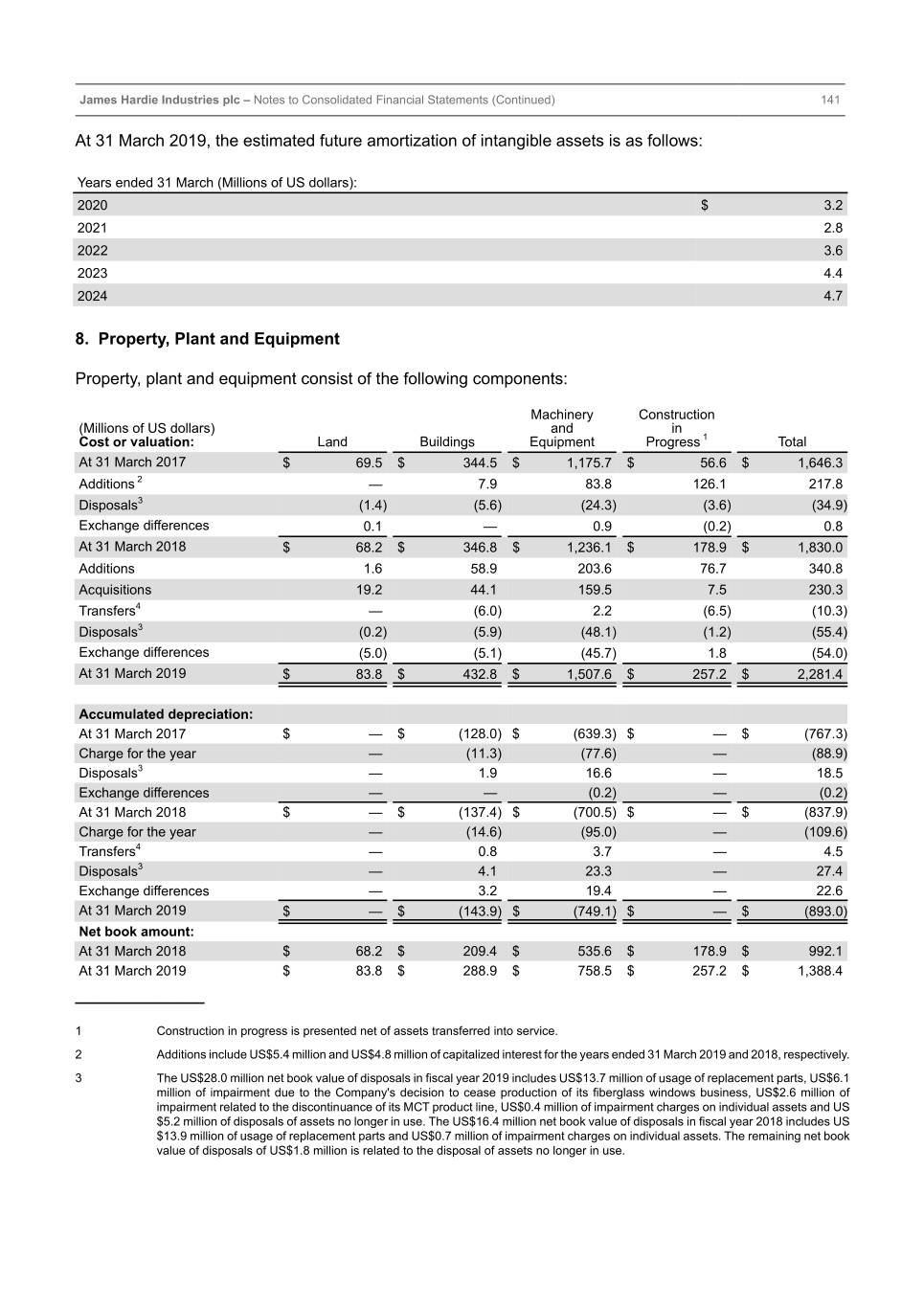
Table of Contents James Hardie Industries plc – Notes to Consolidated Financial Statements (Continued) 141 At 31 March 2019, the estimated future amortization of intangible assets is as follows: Years ended 31 March (Millions of US dollars): 2020 $ 3.2 2021 2.8 2022 3.6 2023 4.4 2024 4.7 8. Property, Plant and Equipment Property, plant and equipment consist of the following components: Machinery Construction (Millions of US dollars) and in Cost or valuation: Land Buildings Equipment Progress 1 Total At 31 March 2017 $ 69.5 $ 344.5 $ 1,175.7 $ 56.6 $ 1,646.3 Additions 2 — 7.9 83.8 126.1 217.8 Disposals3 (1.4) (5.6) (24.3) (3.6) (34.9) Exchange differences 0.1 — 0.9 (0.2) 0.8 At 31 March 2018 $ 68.2 $ 346.8 $ 1,236.1 $ 178.9 $ 1,830.0 Additions 1.6 58.9 203.6 76.7 340.8 Acquisitions 19.2 44.1 159.5 7.5 230.3 Transfers4 — (6.0) 2.2 (6.5) (10.3) Disposals3 (0.2) (5.9) (48.1) (1.2) (55.4) Exchange differences (5.0) (5.1) (45.7) 1.8 (54.0) At 31 March 2019 $ 83.8 $ 432.8 $ 1,507.6 $ 257.2 $ 2,281.4 Accumulated depreciation: At 31 March 2017 $ — $ (128.0) $ (639.3) $ — $ (767.3) Charge for the year — (11.3) (77.6) — (88.9) Disposals3 — 1.9 16.6 — 18.5 Exchange differences — — (0.2) — (0.2) At 31 March 2018 $ — $ (137.4) $ (700.5) $ — $ (837.9) Charge for the year — (14.6) (95.0) — (109.6) Transfers4 — 0.8 3.7 — 4.5 Disposals3 — 4.1 23.3 — 27.4 Exchange differences — 3.2 19.4 — 22.6 At 31 March 2019 $ — $ (143.9)$ (749.1)$ — $ (893.0) Net book amount: At 31 March 2018 $ 68.2 $ 209.4 $ 535.6 $ 178.9 $ 992.1 At 31 March 2019 $ 83.8 $ 288.9 $ 758.5 $ 257.2 $ 1,388.4 ______________ 1 Construction in progress is presented net of assets transferred into service. 2 Additions include US$5.4 million and US$4.8 million of capitalized interest for the years ended 31 March 2019 and 2018, respectively. 3 The US$28.0 million net book value of disposals in fiscal year 2019 includes US$13.7 million of usage of replacement parts, US$6.1 million of impairment due to the Company's decision to cease production of its fiberglass windows business, US$2.6 million of impairment related to the discontinuance of its MCT product line, US$0.4 million of impairment charges on individual assets and US $5.2 million of disposals of assets no longer in use. The US$16.4 million net book value of disposals in fiscal year 2018 includes US $13.9 million of usage of replacement parts and US$0.7 million of impairment charges on individual assets. The remaining net book value of disposals of US$1.8 million is related to the disposal of assets no longer in use.
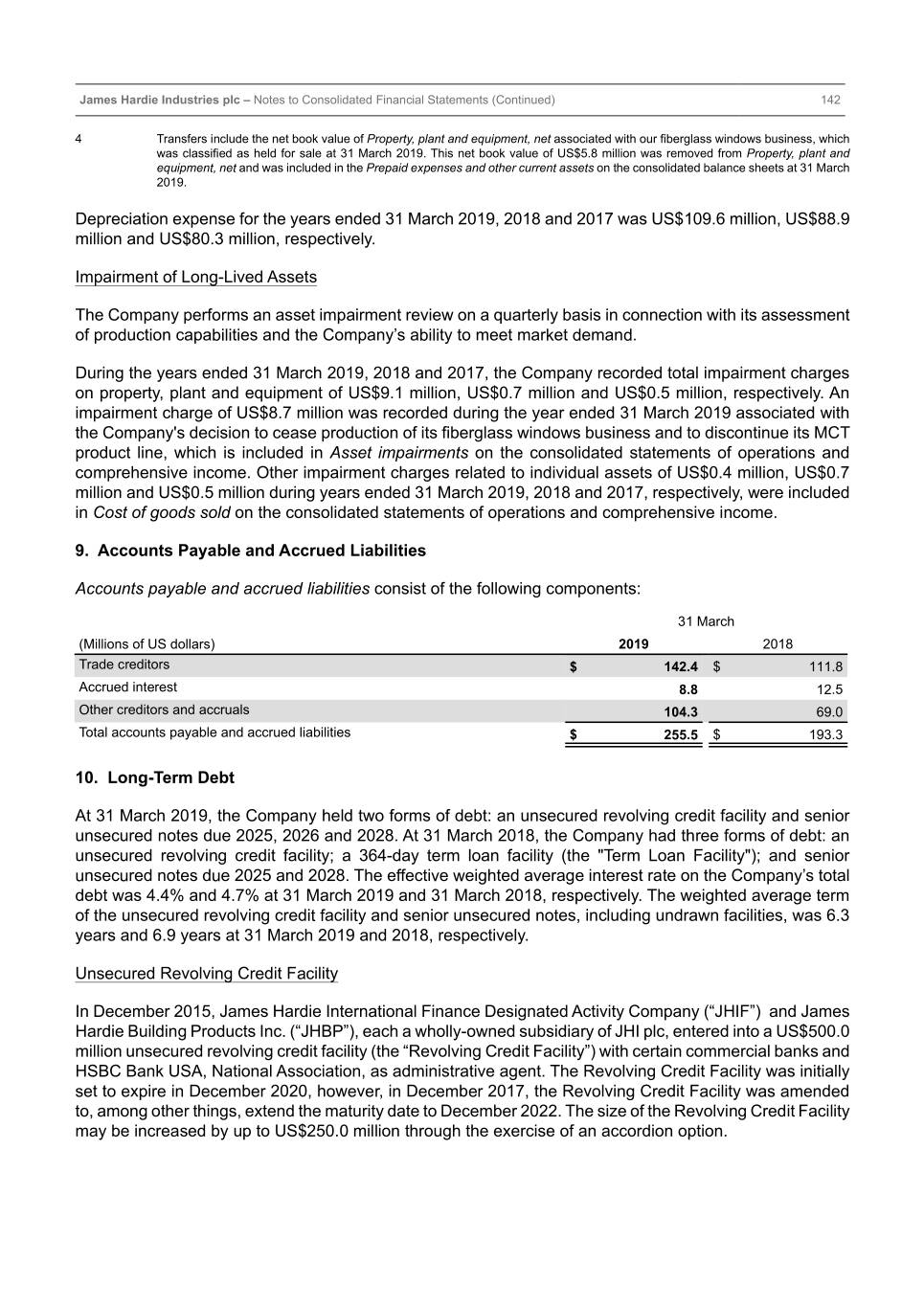
Table of Contents James Hardie Industries plc – Notes to Consolidated Financial Statements (Continued) 142 4 Transfers include the net book value of Property, plant and equipment, net associated with our fiberglass windows business, which was classified as held for sale at 31 March 2019. This net book value of US$5.8 million was removed from Property, plant and equipment, net and was included in the Prepaid expenses and other current assets on the consolidated balance sheets at 31 March 2019. Depreciation expense for the years ended 31 March 2019, 2018 and 2017 was US$109.6 million, US$88.9 million and US$80.3 million, respectively. Impairment of Long-Lived Assets The Company performs an asset impairment review on a quarterly basis in connection with its assessment of production capabilities and the Company’s ability to meet market demand. During the years ended 31 March 2019, 2018 and 2017, the Company recorded total impairment charges on property, plant and equipment of US$9.1 million, US$0.7 million and US$0.5 million, respectively. An impairment charge of US$8.7 million was recorded during the year ended 31 March 2019 associated with the Company's decision to cease production of its fiberglass windows business and to discontinue its MCT product line, which is included in Asset impairments on the consolidated statements of operations and comprehensive income. Other impairment charges related to individual assets of US$0.4 million, US$0.7 million and US$0.5 million during years ended 31 March 2019, 2018 and 2017, respectively, were included in Cost of goods sold on the consolidated statements of operations and comprehensive income. 9. Accounts Payable and Accrued Liabilities Accounts payable and accrued liabilities consist of the following components: 31 March (Millions of US dollars) 2019 2018 Trade creditors $ 142.4 $ 111.8 Accrued interest 8.8 12.5 Other creditors and accruals 104.3 69.0 Total accounts payable and accrued liabilities $ 255.5 $ 193.3 10. Long-Term Debt At 31 March 2019, the Company held two forms of debt: an unsecured revolving credit facility and senior unsecured notes due 2025, 2026 and 2028. At 31 March 2018, the Company had three forms of debt: an unsecured revolving credit facility; a 364-day term loan facility (the "Term Loan Facility"); and senior unsecured notes due 2025 and 2028. The effective weighted average interest rate on the Company’s total debt was 4.4% and 4.7% at 31 March 2019 and 31 March 2018, respectively. The weighted average term of the unsecured revolving credit facility and senior unsecured notes, including undrawn facilities, was 6.3 years and 6.9 years at 31 March 2019 and 2018, respectively. Unsecured Revolving Credit Facility In December 2015, James Hardie International Finance Designated Activity Company (“JHIF”) and James Hardie Building Products Inc. (“JHBP”), each a wholly-owned subsidiary of JHI plc, entered into a US$500.0 million unsecured revolving credit facility (the “Revolving Credit Facility”) with certain commercial banks and HSBC Bank USA, National Association, as administrative agent. The Revolving Credit Facility was initially set to expire in December 2020, however, in December 2017, the Revolving Credit Facility was amended to, among other things, extend the maturity date to December 2022. The size of the Revolving Credit Facility may be increased by up to US$250.0 million through the exercise of an accordion option.
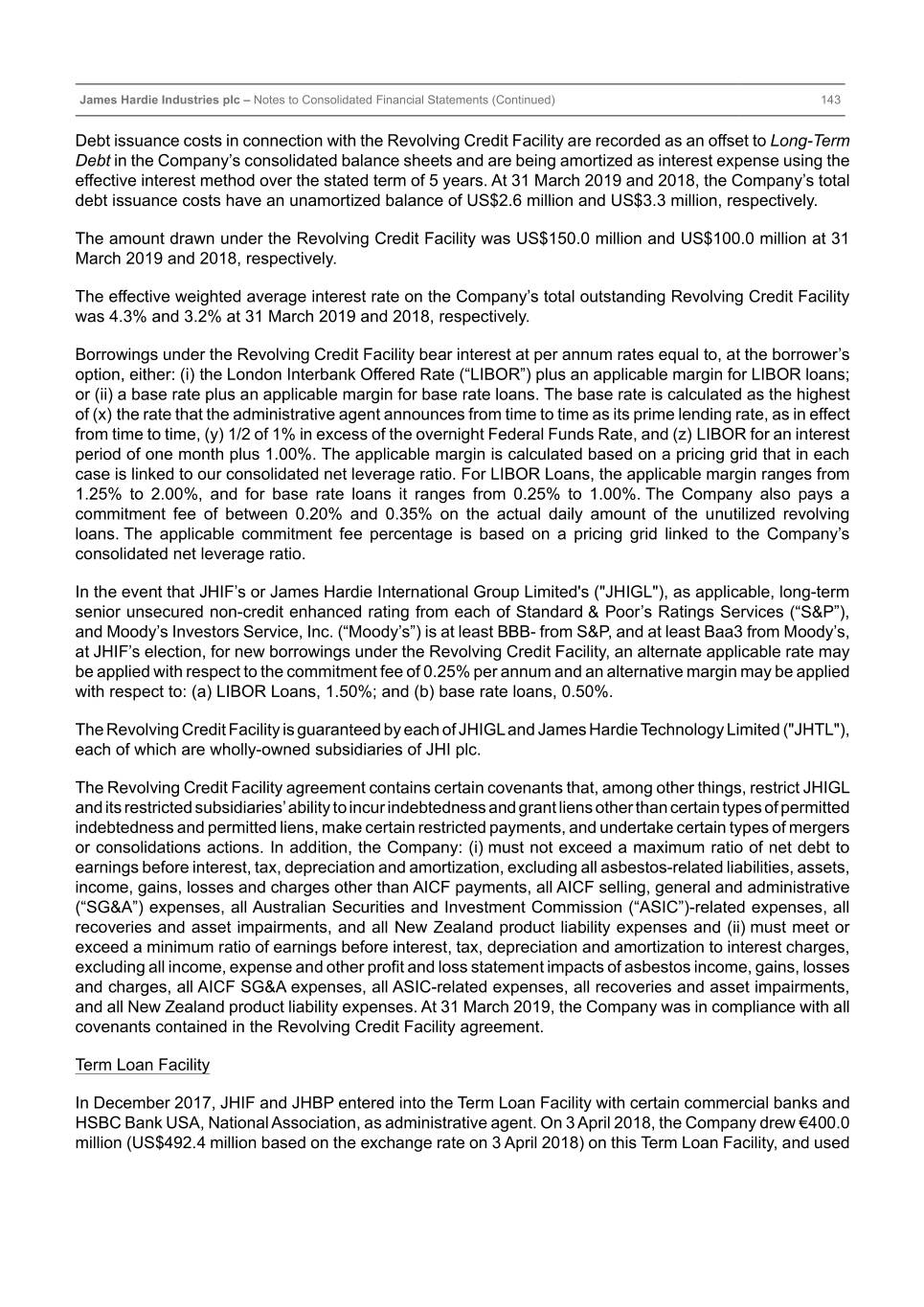
Table of Contents James Hardie Industries plc – Notes to Consolidated Financial Statements (Continued) 143 Debt issuance costs in connection with the Revolving Credit Facility are recorded as an offset to Long-Term Debt in the Company’s consolidated balance sheets and are being amortized as interest expense using the effective interest method over the stated term of 5 years. At 31 March 2019 and 2018, the Company’s total debt issuance costs have an unamortized balance of US$2.6 million and US$3.3 million, respectively. The amount drawn under the Revolving Credit Facility was US$150.0 million and US$100.0 million at 31 March 2019 and 2018, respectively. The effective weighted average interest rate on the Company’s total outstanding Revolving Credit Facility was 4.3% and 3.2% at 31 March 2019 and 2018, respectively. Borrowings under the Revolving Credit Facility bear interest at per annum rates equal to, at the borrower’s option, either: (i) the London Interbank Offered Rate (“LIBOR”) plus an applicable margin for LIBOR loans; or (ii) a base rate plus an applicable margin for base rate loans. The base rate is calculated as the highest of (x) the rate that the administrative agent announces from time to time as its prime lending rate, as in effect from time to time, (y) 1/2 of 1% in excess of the overnight Federal Funds Rate, and (z) LIBOR for an interest period of one month plus 1.00%. The applicable margin is calculated based on a pricing grid that in each case is linked to our consolidated net leverage ratio. For LIBOR Loans, the applicable margin ranges from 1.25% to 2.00%, and for base rate loans it ranges from 0.25% to 1.00%. The Company also pays a commitment fee of between 0.20% and 0.35% on the actual daily amount of the unutilized revolving loans. The applicable commitment fee percentage is based on a pricing grid linked to the Company’s consolidated net leverage ratio. In the event that JHIF’s or James Hardie International Group Limited's ("JHIGL"), as applicable, long-term senior unsecured non-credit enhanced rating from each of Standard & Poor’s Ratings Services (“S&P”), and Moody’s Investors Service, Inc. (“Moody’s”) is at least BBB- from S&P, and at least Baa3 from Moody’s, at JHIF’s election, for new borrowings under the Revolving Credit Facility, an alternate applicable rate may be applied with respect to the commitment fee of 0.25% per annum and an alternative margin may be applied with respect to: (a) LIBOR Loans, 1.50%; and (b) base rate loans, 0.50%. The Revolving Credit Facility is guaranteed by each of JHIGL and James Hardie Technology Limited ("JHTL"), each of which are wholly-owned subsidiaries of JHI plc. The Revolving Credit Facility agreement contains certain covenants that, among other things, restrict JHIGL and its restricted subsidiaries’ ability to incur indebtedness and grant liens other than certain types of permitted indebtedness and permitted liens, make certain restricted payments, and undertake certain types of mergers or consolidations actions. In addition, the Company: (i) must not exceed a maximum ratio of net debt to earnings before interest, tax, depreciation and amortization, excluding all asbestos-related liabilities, assets, income, gains, losses and charges other than AICF payments, all AICF selling, general and administrative (“SG&A”) expenses, all Australian Securities and Investment Commission (“ASIC”)-related expenses, all recoveries and asset impairments, and all New Zealand product liability expenses and (ii) must meet or exceed a minimum ratio of earnings before interest, tax, depreciation and amortization to interest charges, excluding all income, expense and other profit and loss statement impacts of asbestos income, gains, losses and charges, all AICF SG&A expenses, all ASIC-related expenses, all recoveries and asset impairments, and all New Zealand product liability expenses. At 31 March 2019, the Company was in compliance with all covenants contained in the Revolving Credit Facility agreement. Term Loan Facility In December 2017, JHIF and JHBP entered into the Term Loan Facility with certain commercial banks and HSBC Bank USA, National Association, as administrative agent. On 3 April 2018, the Company drew €400.0 million (US$492.4 million based on the exchange rate on 3 April 2018) on this Term Loan Facility, and used
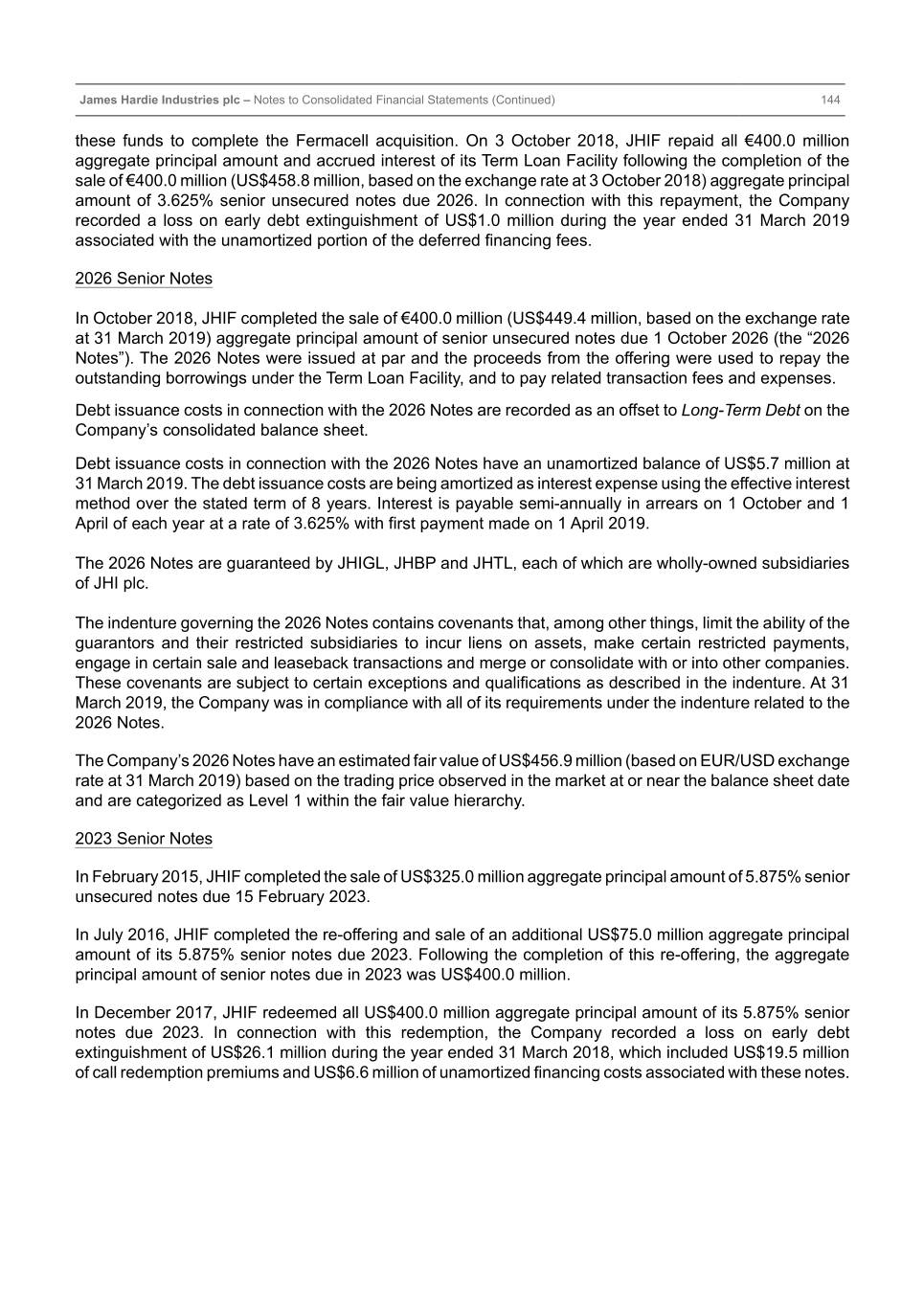
Table of Contents James Hardie Industries plc – Notes to Consolidated Financial Statements (Continued) 144 these funds to complete the Fermacell acquisition. On 3 October 2018, JHIF repaid all €400.0 million aggregate principal amount and accrued interest of its Term Loan Facility following the completion of the sale of €400.0 million (US$458.8 million, based on the exchange rate at 3 October 2018) aggregate principal amount of 3.625% senior unsecured notes due 2026. In connection with this repayment, the Company recorded a loss on early debt extinguishment of US$1.0 million during the year ended 31 March 2019 associated with the unamortized portion of the deferred financing fees. 2026 Senior Notes In October 2018, JHIF completed the sale of €400.0 million (US$449.4 million, based on the exchange rate at 31 March 2019) aggregate principal amount of senior unsecured notes due 1 October 2026 (the “2026 Notes”). The 2026 Notes were issued at par and the proceeds from the offering were used to repay the outstanding borrowings under the Term Loan Facility, and to pay related transaction fees and expenses. Debt issuance costs in connection with the 2026 Notes are recorded as an offset to Long-Term Debt on the Company’s consolidated balance sheet. Debt issuance costs in connection with the 2026 Notes have an unamortized balance of US$5.7 million at 31 March 2019. The debt issuance costs are being amortized as interest expense using the effective interest method over the stated term of 8 years. Interest is payable semi-annually in arrears on 1 October and 1 April of each year at a rate of 3.625% with first payment made on 1 April 2019. The 2026 Notes are guaranteed by JHIGL, JHBP and JHTL, each of which are wholly-owned subsidiaries of JHI plc. The indenture governing the 2026 Notes contains covenants that, among other things, limit the ability of the guarantors and their restricted subsidiaries to incur liens on assets, make certain restricted payments, engage in certain sale and leaseback transactions and merge or consolidate with or into other companies. These covenants are subject to certain exceptions and qualifications as described in the indenture. At 31 March 2019, the Company was in compliance with all of its requirements under the indenture related to the 2026 Notes. The Company’s 2026 Notes have an estimated fair value of US$456.9 million (based on EUR/USD exchange rate at 31 March 2019) based on the trading price observed in the market at or near the balance sheet date and are categorized as Level 1 within the fair value hierarchy. 2023 Senior Notes In February 2015, JHIF completed the sale of US$325.0 million aggregate principal amount of 5.875% senior unsecured notes due 15 February 2023. In July 2016, JHIF completed the re-offering and sale of an additional US$75.0 million aggregate principal amount of its 5.875% senior notes due 2023. Following the completion of this re-offering, the aggregate principal amount of senior notes due in 2023 was US$400.0 million. In December 2017, JHIF redeemed all US$400.0 million aggregate principal amount of its 5.875% senior notes due 2023. In connection with this redemption, the Company recorded a loss on early debt extinguishment of US$26.1 million during the year ended 31 March 2018, which included US$19.5 million of call redemption premiums and US$6.6 million of unamortized financing costs associated with these notes.
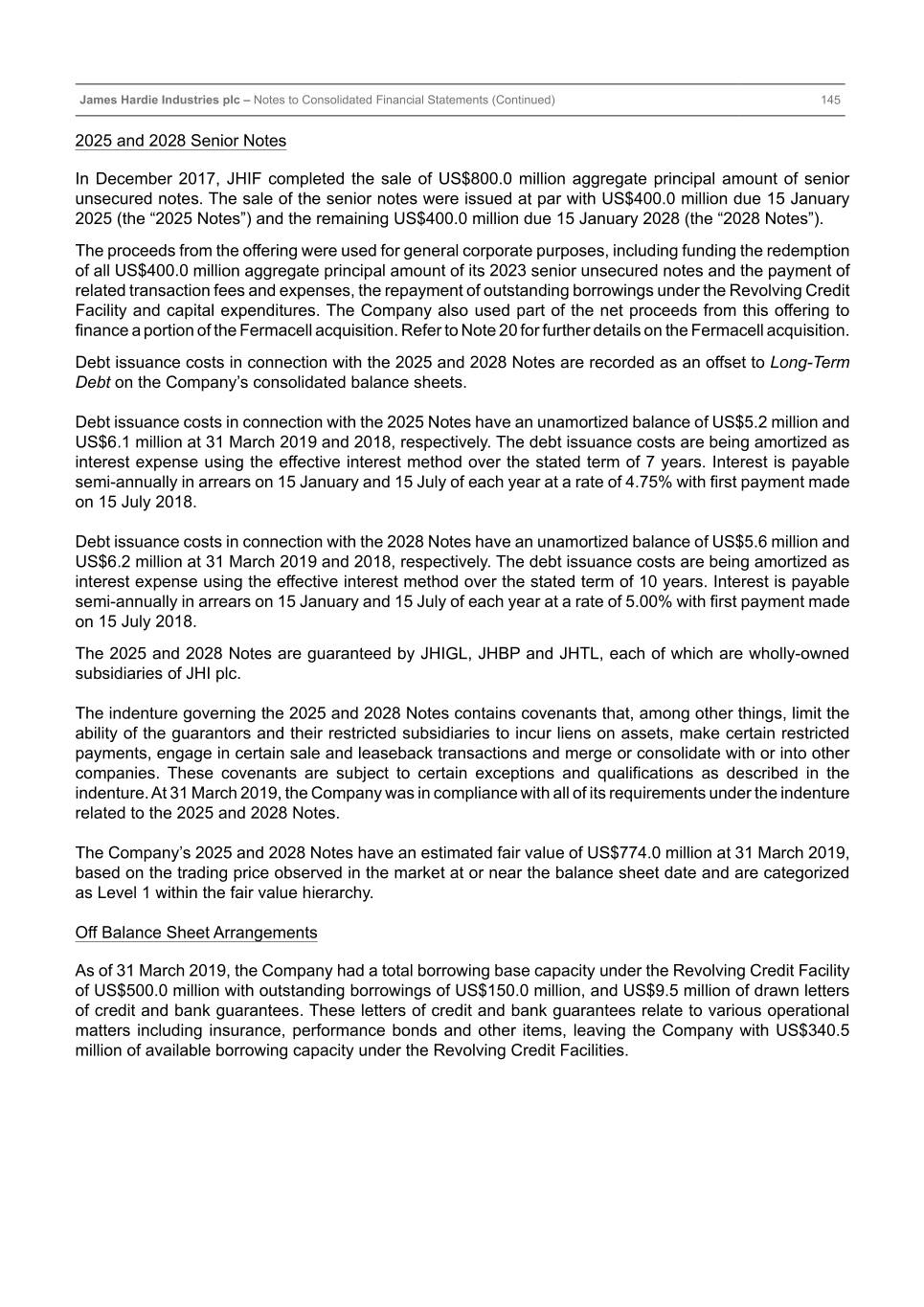
Table of Contents James Hardie Industries plc – Notes to Consolidated Financial Statements (Continued) 145 2025 and 2028 Senior Notes In December 2017, JHIF completed the sale of US$800.0 million aggregate principal amount of senior unsecured notes. The sale of the senior notes were issued at par with US$400.0 million due 15 January 2025 (the “2025 Notes”) and the remaining US$400.0 million due 15 January 2028 (the “2028 Notes”). The proceeds from the offering were used for general corporate purposes, including funding the redemption of all US$400.0 million aggregate principal amount of its 2023 senior unsecured notes and the payment of related transaction fees and expenses, the repayment of outstanding borrowings under the Revolving Credit Facility and capital expenditures. The Company also used part of the net proceeds from this offering to finance a portion of the Fermacell acquisition. Refer to Note 20 for further details on the Fermacell acquisition. Debt issuance costs in connection with the 2025 and 2028 Notes are recorded as an offset to Long-Term Debt on the Company’s consolidated balance sheets. Debt issuance costs in connection with the 2025 Notes have an unamortized balance of US$5.2 million and US$6.1 million at 31 March 2019 and 2018, respectively. The debt issuance costs are being amortized as interest expense using the effective interest method over the stated term of 7 years. Interest is payable semi-annually in arrears on 15 January and 15 July of each year at a rate of 4.75% with first payment made on 15 July 2018. Debt issuance costs in connection with the 2028 Notes have an unamortized balance of US$5.6 million and US$6.2 million at 31 March 2019 and 2018, respectively. The debt issuance costs are being amortized as interest expense using the effective interest method over the stated term of 10 years. Interest is payable semi-annually in arrears on 15 January and 15 July of each year at a rate of 5.00% with first payment made on 15 July 2018. The 2025 and 2028 Notes are guaranteed by JHIGL, JHBP and JHTL, each of which are wholly-owned subsidiaries of JHI plc. The indenture governing the 2025 and 2028 Notes contains covenants that, among other things, limit the ability of the guarantors and their restricted subsidiaries to incur liens on assets, make certain restricted payments, engage in certain sale and leaseback transactions and merge or consolidate with or into other companies. These covenants are subject to certain exceptions and qualifications as described in the indenture. At 31 March 2019, the Company was in compliance with all of its requirements under the indenture related to the 2025 and 2028 Notes. The Company’s 2025 and 2028 Notes have an estimated fair value of US$774.0 million at 31 March 2019, based on the trading price observed in the market at or near the balance sheet date and are categorized as Level 1 within the fair value hierarchy. Off Balance Sheet Arrangements As of 31 March 2019, the Company had a total borrowing base capacity under the Revolving Credit Facility of US$500.0 million with outstanding borrowings of US$150.0 million, and US$9.5 million of drawn letters of credit and bank guarantees. These letters of credit and bank guarantees relate to various operational matters including insurance, performance bonds and other items, leaving the Company with US$340.5 million of available borrowing capacity under the Revolving Credit Facilities.
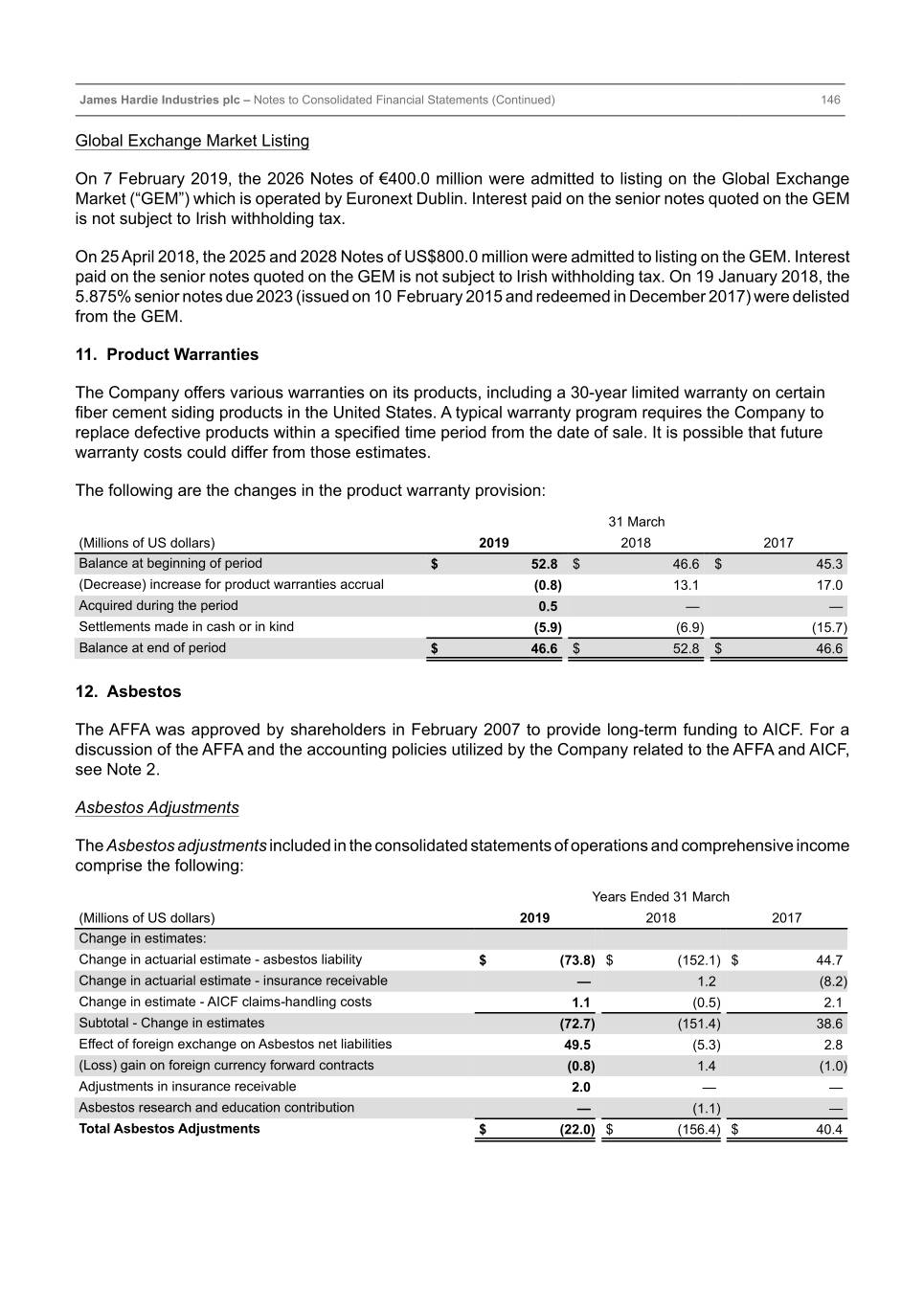
Table of Contents James Hardie Industries plc – Notes to Consolidated Financial Statements (Continued) 146 Global Exchange Market Listing On 7 February 2019, the 2026 Notes of €400.0 million were admitted to listing on the Global Exchange Market (“GEM”) which is operated by Euronext Dublin. Interest paid on the senior notes quoted on the GEM is not subject to Irish withholding tax. On 25 April 2018, the 2025 and 2028 Notes of US$800.0 million were admitted to listing on the GEM. Interest paid on the senior notes quoted on the GEM is not subject to Irish withholding tax. On 19 January 2018, the 5.875% senior notes due 2023 (issued on 10 February 2015 and redeemed in December 2017) were delisted from the GEM. 11. Product Warranties The Company offers various warranties on its products, including a 30-year limited warranty on certain fiber cement siding products in the United States. A typical warranty program requires the Company to replace defective products within a specified time period from the date of sale. It is possible that future warranty costs could differ from those estimates. The following are the changes in the product warranty provision: 31 March (Millions of US dollars) 2019 2018 2017 Balance at beginning of period $ 52.8 $ 46.6 $ 45.3 (Decrease) increase for product warranties accrual (0.8) 13.1 17.0 Acquired during the period 0.5 — — Settlements made in cash or in kind (5.9) (6.9) (15.7) Balance at end of period $ 46.6 $ 52.8 $ 46.6 12. Asbestos The AFFA was approved by shareholders in February 2007 to provide long-term funding to AICF. For a discussion of the AFFA and the accounting policies utilized by the Company related to the AFFA and AICF, see Note 2. Asbestos Adjustments The Asbestos adjustments included in the consolidated statements of operations and comprehensive income comprise the following: Years Ended 31 March (Millions of US dollars) 2019 2018 2017 Change in estimates: Change in actuarial estimate - asbestos liability $ (73.8) $ (152.1)$ 44.7 Change in actuarial estimate - insurance receivable — 1.2 (8.2) Change in estimate - AICF claims-handling costs 1.1 (0.5) 2.1 Subtotal - Change in estimates (72.7) (151.4) 38.6 Effect of foreign exchange on Asbestos net liabilities 49.5 (5.3) 2.8 (Loss) gain on foreign currency forward contracts (0.8) 1.4 (1.0) Adjustments in insurance receivable 2.0 — — Asbestos research and education contribution — (1.1) — Total Asbestos Adjustments $ (22.0) $ (156.4)$ 40.4
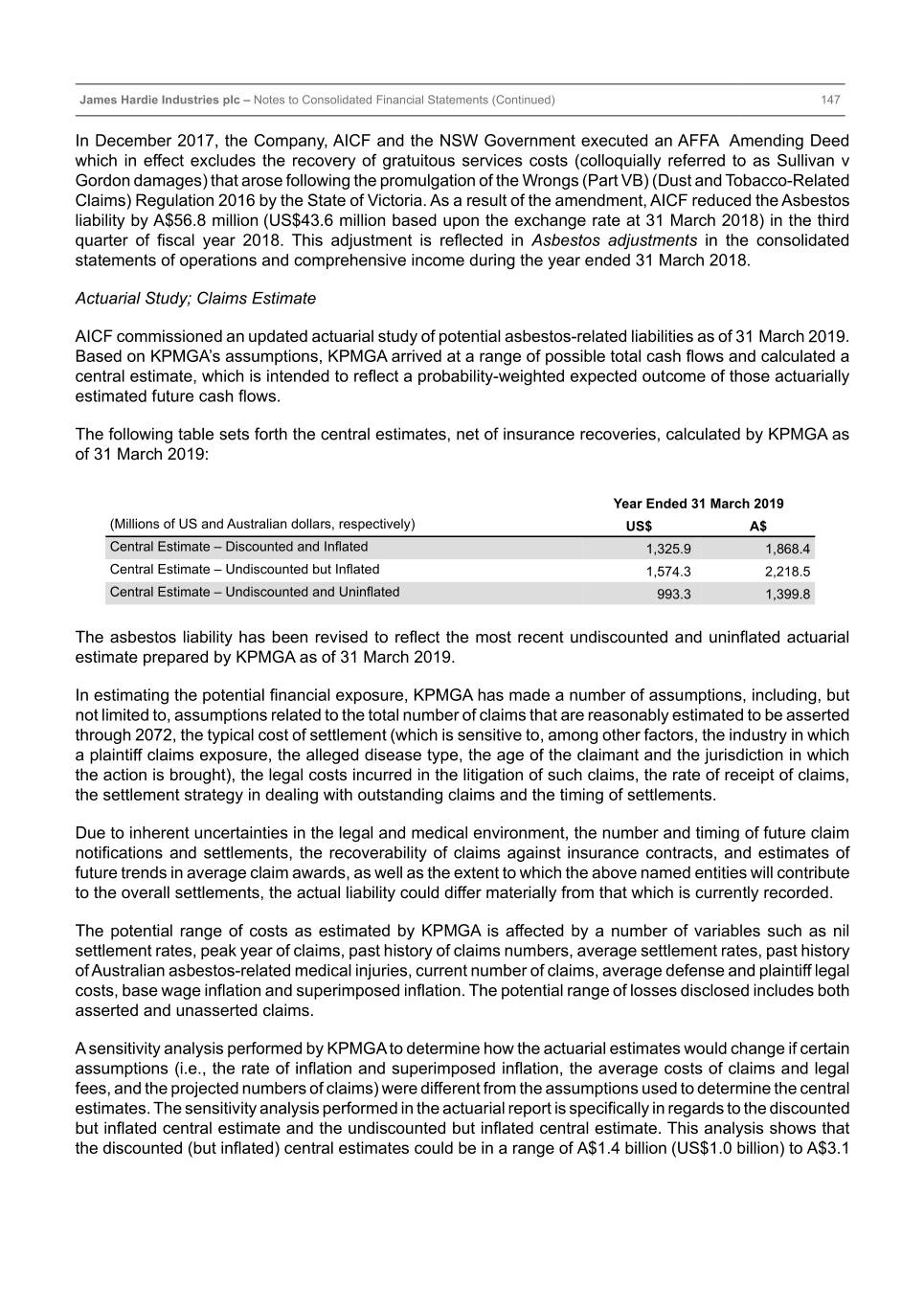
Table of Contents James Hardie Industries plc – Notes to Consolidated Financial Statements (Continued) 147 In December 2017, the Company, AICF and the NSW Government executed an AFFA Amending Deed which in effect excludes the recovery of gratuitous services costs (colloquially referred to as Sullivan v Gordon damages) that arose following the promulgation of the Wrongs (Part VB) (Dust and Tobacco-Related Claims) Regulation 2016 by the State of Victoria. As a result of the amendment, AICF reduced the Asbestos liability by A$56.8 million (US$43.6 million based upon the exchange rate at 31 March 2018) in the third quarter of fiscal year 2018. This adjustment is reflected in Asbestos adjustments in the consolidated statements of operations and comprehensive income during the year ended 31 March 2018. Actuarial Study; Claims Estimate AICF commissioned an updated actuarial study of potential asbestos-related liabilities as of 31 March 2019. Based on KPMGA’s assumptions, KPMGA arrived at a range of possible total cash flows and calculated a central estimate, which is intended to reflect a probability-weighted expected outcome of those actuarially estimated future cash flows. The following table sets forth the central estimates, net of insurance recoveries, calculated by KPMGA as of 31 March 2019: Year Ended 31 March 2019 (Millions of US and Australian dollars, respectively) US$ A$ Central Estimate – Discounted and Inflated 1,325.9 1,868.4 Central Estimate – Undiscounted but Inflated 1,574.3 2,218.5 Central Estimate – Undiscounted and Uninflated 993.3 1,399.8 The asbestos liability has been revised to reflect the most recent undiscounted and uninflated actuarial estimate prepared by KPMGA as of 31 March 2019. In estimating the potential financial exposure, KPMGA has made a number of assumptions, including, but not limited to, assumptions related to the total number of claims that are reasonably estimated to be asserted through 2072, the typical cost of settlement (which is sensitive to, among other factors, the industry in which a plaintiff claims exposure, the alleged disease type, the age of the claimant and the jurisdiction in which the action is brought), the legal costs incurred in the litigation of such claims, the rate of receipt of claims, the settlement strategy in dealing with outstanding claims and the timing of settlements. Due to inherent uncertainties in the legal and medical environment, the number and timing of future claim notifications and settlements, the recoverability of claims against insurance contracts, and estimates of future trends in average claim awards, as well as the extent to which the above named entities will contribute to the overall settlements, the actual liability could differ materially from that which is currently recorded. The potential range of costs as estimated by KPMGA is affected by a number of variables such as nil settlement rates, peak year of claims, past history of claims numbers, average settlement rates, past history of Australian asbestos-related medical injuries, current number of claims, average defense and plaintiff legal costs, base wage inflation and superimposed inflation. The potential range of losses disclosed includes both asserted and unasserted claims. A sensitivity analysis performed by KPMGA to determine how the actuarial estimates would change if certain assumptions (i.e., the rate of inflation and superimposed inflation, the average costs of claims and legal fees, and the projected numbers of claims) were different from the assumptions used to determine the central estimates. The sensitivity analysis performed in the actuarial report is specifically in regards to the discounted but inflated central estimate and the undiscounted but inflated central estimate. This analysis shows that the discounted (but inflated) central estimates could be in a range of A$1.4 billion (US$1.0 billion) to A$3.1
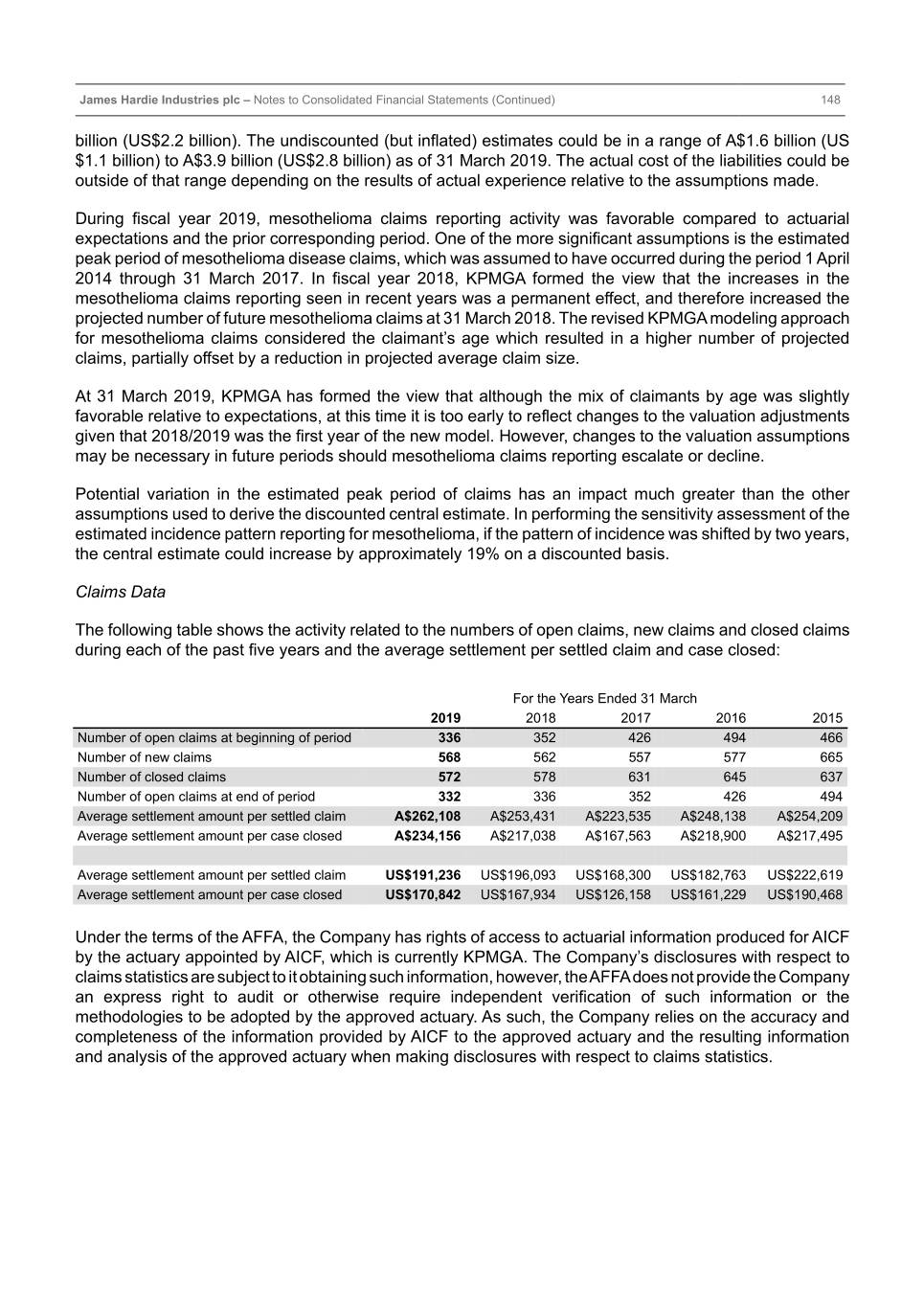
Table of Contents James Hardie Industries plc – Notes to Consolidated Financial Statements (Continued) 148 billion (US$2.2 billion). The undiscounted (but inflated) estimates could be in a range of A$1.6 billion (US $1.1 billion) to A$3.9 billion (US$2.8 billion) as of 31 March 2019. The actual cost of the liabilities could be outside of that range depending on the results of actual experience relative to the assumptions made. During fiscal year 2019, mesothelioma claims reporting activity was favorable compared to actuarial expectations and the prior corresponding period. One of the more significant assumptions is the estimated peak period of mesothelioma disease claims, which was assumed to have occurred during the period 1 April 2014 through 31 March 2017. In fiscal year 2018, KPMGA formed the view that the increases in the mesothelioma claims reporting seen in recent years was a permanent effect, and therefore increased the projected number of future mesothelioma claims at 31 March 2018. The revised KPMGA modeling approach for mesothelioma claims considered the claimant’s age which resulted in a higher number of projected claims, partially offset by a reduction in projected average claim size. At 31 March 2019, KPMGA has formed the view that although the mix of claimants by age was slightly favorable relative to expectations, at this time it is too early to reflect changes to the valuation adjustments given that 2018/2019 was the first year of the new model. However, changes to the valuation assumptions may be necessary in future periods should mesothelioma claims reporting escalate or decline. Potential variation in the estimated peak period of claims has an impact much greater than the other assumptions used to derive the discounted central estimate. In performing the sensitivity assessment of the estimated incidence pattern reporting for mesothelioma, if the pattern of incidence was shifted by two years, the central estimate could increase by approximately 19% on a discounted basis. Claims Data The following table shows the activity related to the numbers of open claims, new claims and closed claims during each of the past five years and the average settlement per settled claim and case closed: For the Years Ended 31 March 2019 2018 2017 2016 2015 Number of open claims at beginning of period 336 352 426 494 466 Number of new claims 568 562 557 577 665 Number of closed claims 572 578 631 645 637 Number of open claims at end of period 332 336 352 426 494 Average settlement amount per settled claim A$262,108 A$253,431 A$223,535 A$248,138 A$254,209 Average settlement amount per case closed A$234,156 A$217,038 A$167,563 A$218,900 A$217,495 Average settlement amount per settled claim US$191,236 US$196,093 US$168,300 US$182,763 US$222,619 Average settlement amount per case closed US$170,842 US$167,934 US$126,158 US$161,229 US$190,468 Under the terms of the AFFA, the Company has rights of access to actuarial information produced for AICF by the actuary appointed by AICF, which is currently KPMGA. The Company’s disclosures with respect to claims statistics are subject to it obtaining such information, however, the AFFA does not provide the Company an express right to audit or otherwise require independent verification of such information or the methodologies to be adopted by the approved actuary. As such, the Company relies on the accuracy and completeness of the information provided by AICF to the approved actuary and the resulting information and analysis of the approved actuary when making disclosures with respect to claims statistics.
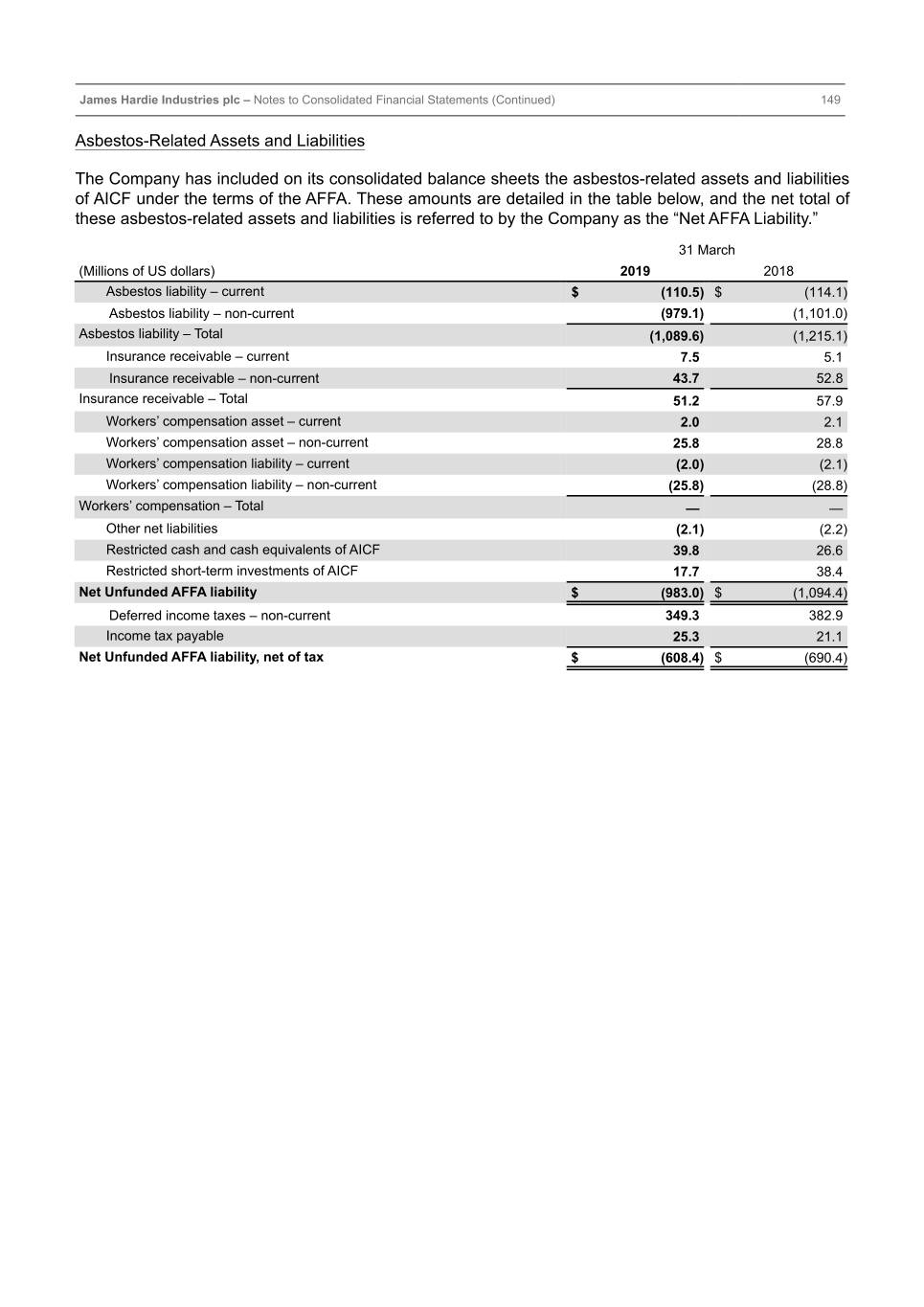
Table of Contents James Hardie Industries plc – Notes to Consolidated Financial Statements (Continued) 149 Asbestos-Related Assets and Liabilities The Company has included on its consolidated balance sheets the asbestos-related assets and liabilities of AICF under the terms of the AFFA. These amounts are detailed in the table below, and the net total of these asbestos-related assets and liabilities is referred to by the Company as the “Net AFFA Liability.” 31 March (Millions of US dollars) 2019 2018 Asbestos liability – current $ (110.5) $ (114.1) Asbestos liability – non-current (979.1) (1,101.0) Asbestos liability – Total (1,089.6) (1,215.1) Insurance receivable – current 7.5 5.1 Insurance receivable – non-current 43.7 52.8 Insurance receivable – Total 51.2 57.9 Workers’ compensation asset – current 2.0 2.1 Workers’ compensation asset – non-current 25.8 28.8 Workers’ compensation liability – current (2.0) (2.1) Workers’ compensation liability – non-current (25.8) (28.8) Workers’ compensation – Total — — Other net liabilities (2.1) (2.2) Restricted cash and cash equivalents of AICF 39.8 26.6 Restricted short-term investments of AICF 17.7 38.4 Net Unfunded AFFA liability $ (983.0) $ (1,094.4) Deferred income taxes – non-current 349.3 382.9 Income tax payable 25.3 21.1 Net Unfunded AFFA liability, net of tax $ (608.4) $ (690.4)
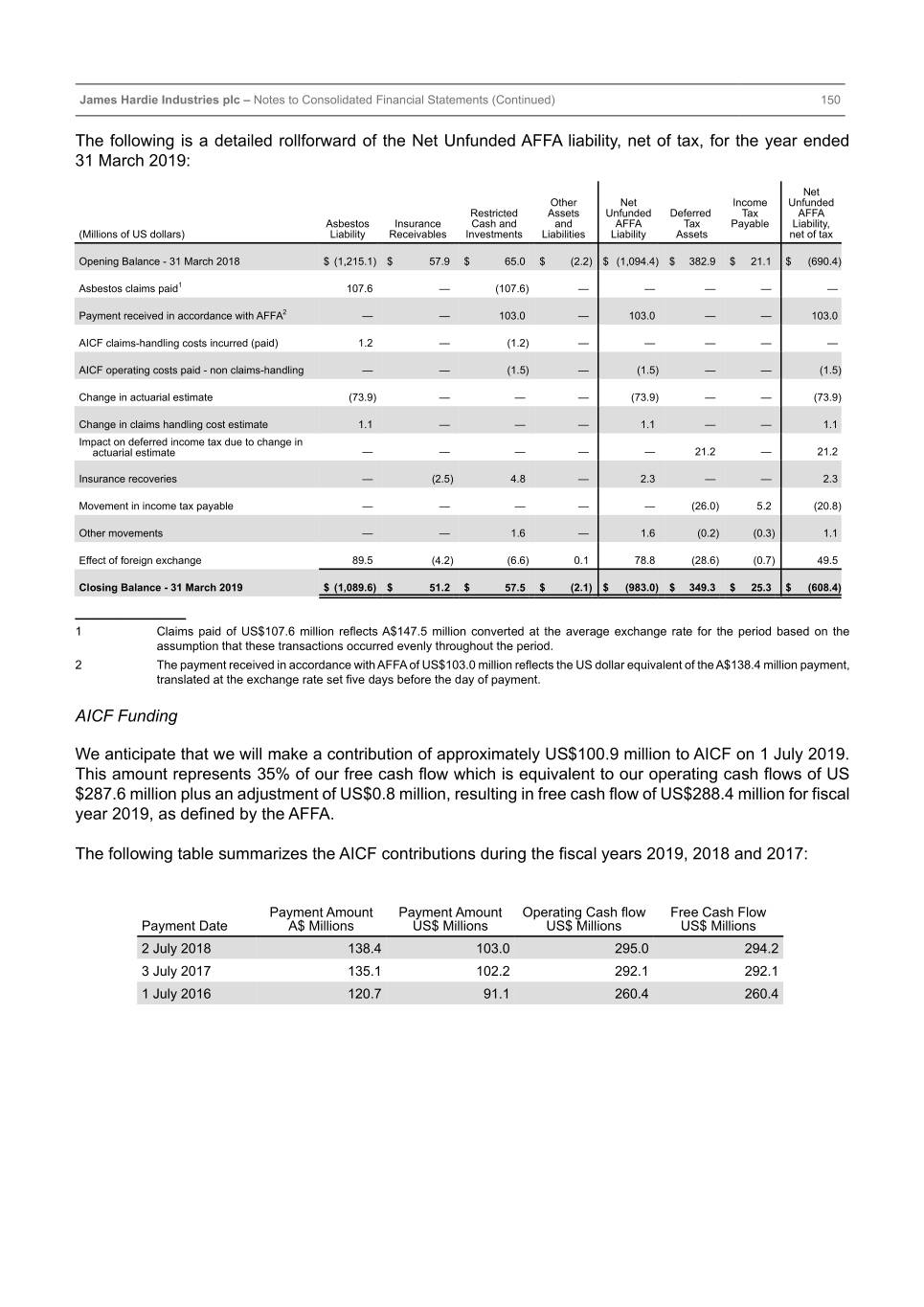
Table of Contents James Hardie Industries plc – Notes to Consolidated Financial Statements (Continued) 150 The following is a detailed rollforward of the Net Unfunded AFFA liability, net of tax, for the year ended 31 March 2019: Net Other Net Income Unfunded Restricted Assets Unfunded Deferred Tax AFFA Asbestos Insurance Cash and and AFFA Tax Payable Liability, (Millions of US dollars) Liability Receivables Investments Liabilities Liability Assets net of tax Opening Balance - 31 March 2018 $ (1,215.1)$ 57.9 $ 65.0 $ (2.2)$(1,094.4)$ 382.9 $ 21.1 $ (690.4) Asbestos claims paid1 107.6 — (107.6) — — —— — Payment received in accordance with AFFA2 — — 103.0 — 103.0 — — 103.0 AICF claims-handling costs incurred (paid) 1.2 — (1.2) — — —— — AICF operating costs paid - non claims-handling — — (1.5) — (1.5) — — (1.5) Change in actuarial estimate (73.9) — — — (73.9) — — (73.9) Change in claims handling cost estimate 1.1 — — — 1.1 — — 1.1 Impact on deferred income tax due to change in actuarial estimate — — —— — 21.2 — 21.2 Insurance recoveries — (2.5) 4.8 — 2.3 — — 2.3 Movement in income tax payable — — —— — (26.0) 5.2 (20.8) Other movements — — 1.6 — 1.6 (0.2) (0.3) 1.1 Effect of foreign exchange 89.5 (4.2) (6.6) 0.1 78.8 (28.6) (0.7) 49.5 Closing Balance - 31 March 2019 $ (1,089.6)$ 51.2 $ 57.5 $ (2.1)$ (983.0)$ 349.3 $ 25.3 $ (608.4) ____________ 1 Claims paid of US$107.6 million reflects A$147.5 million converted at the average exchange rate for the period based on the assumption that these transactions occurred evenly throughout the period. 2 The payment received in accordance with AFFA of US$103.0 million reflects the US dollar equivalent of the A$138.4 million payment, translated at the exchange rate set five days before the day of payment. AICF Funding We anticipate that we will make a contribution of approximately US$100.9 million to AICF on 1 July 2019. This amount represents 35% of our free cash flow which is equivalent to our operating cash flows of US $287.6 million plus an adjustment of US$0.8 million, resulting in free cash flow of US$288.4 million for fiscal year 2019, as defined by the AFFA. The following table summarizes the AICF contributions during the fiscal years 2019, 2018 and 2017: Payment Amount Payment Amount Operating Cash flow Free Cash Flow Payment Date A$ Millions US$ Millions US$ Millions US$ Millions 2 July 2018 138.4 103.0 295.0 294.2 3 July 2017 135.1 102.2 292.1 292.1 1 July 2016 120.7 91.1 260.4 260.4

Table of Contents James Hardie Industries plc – Notes to Consolidated Financial Statements (Continued) 151 Restricted Short-Term Investments In July 2017, AICF invested A$100.0 million of its excess cash in time deposits. During the year ended 31 March 2018, A$50.0 million of these time deposits matured and were reclassified to Restricted cash and cash equivalents - Asbestos on the consolidated balance sheet. During the year ended 31 March 2019, the remaining time deposits of A$50.0 million matured and were reclassified to Restricted cash and cash equivalents - Asbestos on the consolidated balance sheets. In July 2018, AICF invested A$120.0 million of its excess cash in time deposits. During the year ended 31 March 2019, A$95.0 million of these time deposits matured and were classified to Restricted cash and cash equivalents - Asbestos on the consolidated balance sheet. The remaining time deposits of A$25.0 million (US$17.7 million, based on the exchange rate at 31 March 2019) bear a fixed interest rate of 2.5% and mature on 31 May 2019. These time deposits are reflected within Restricted short-term investments - Asbestos on the consolidated balance sheet as of 31 March 2019 and have been classified as available- for-sale. At 31 March 2019, AICF’s short-term investments were revalued resulting in a mark-to-market fair value adjustment of nil. AICF – NSW Government Secured Loan Facility AICF may borrow, subject to certain conditions, up to an aggregate amount of A$320.0 million (US$227.1 million, based on the exchange rate at 31 March 2019). The AICF Loan Facility is available to be drawn for the payment of claims through 1 November 2030, at which point, all outstanding borrowings must be repaid. Borrowings made under the AICF Loan Facility are classified as current, as AICF intends to repay the debt within one year. At 31 March 2019 and 2018, AICF had an outstanding balance under the AICF Loan Facility of nil. To the extent the NSW Government sources funding for the AICF Loan Facility from the Commonwealth of Australia (the “Commonwealth”), the interest rate on the AICF Loan Facility is calculated by reference to the cost of NSW’s borrowings from the Commonwealth for that purpose, being calculated with reference to the Commonwealth Treasury fixed coupon bond rate for a period determined as appropriate by the Commonwealth. To the extent that NSW’s source of funding is not from the Commonwealth, the interest rate on drawings under the AICF Loan Facility is calculated as (i) during the period to (but excluding) 1 May 2020, a yield percent per annum calculated at the time of the first drawdown of the AICF Loan Facility by reference to the NSW Treasury Corporation’s 6% 1/05/2020 Benchmark Bonds, (ii) during the period after 1 May 2020, a yield percent per annum calculated by reference to NSW Treasury Corporation bonds on issue at that time and maturing in 2030, or (iii) in any case, if the relevant bonds are not on issue, a yield percent per annum in respect of such other source of funding for the AICF Loan Facility determined by the NSW Government in good faith to be used to replace those bonds, including any guarantee fee payable to the Commonwealth in respect of the bonds (where the bonds are guaranteed by the Commonwealth) or other source of funding. Under the AICF Loan Facility, the Former James Hardie Companies each guarantee the payment of amounts owed by AICF and AICF’s performance of its obligations under the AICF Loan Facility. Each Obligor has granted the NSW Government a security interest in certain property including cash accounts, proceeds from insurance claims, payments remitted by the Company to AICF and contractual rights under certain documents including the AFFA. Each Obligor may not deal with the secured property until all amounts outstanding under the AICF Loan Facility are paid, except as permitted under the terms of the security interest. Under the terms of the AICF Loan Facility, each Obligor must, upon receipt of proceeds from insurance claims and payments remitted by the Company under the AFFA, apply all of such proceeds in repayment
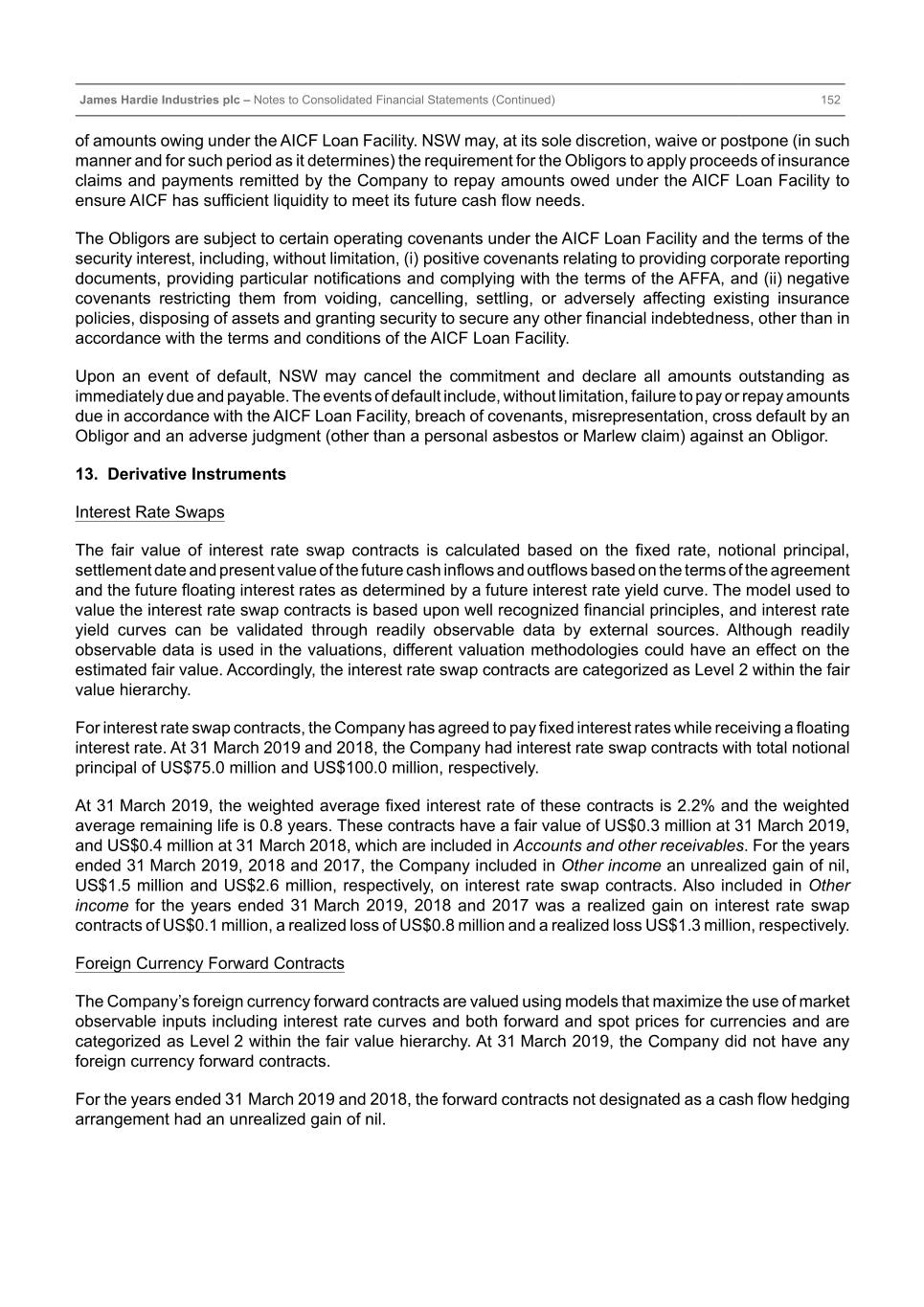
Table of Contents James Hardie Industries plc – Notes to Consolidated Financial Statements (Continued) 152 of amounts owing under the AICF Loan Facility. NSW may, at its sole discretion, waive or postpone (in such manner and for such period as it determines) the requirement for the Obligors to apply proceeds of insurance claims and payments remitted by the Company to repay amounts owed under the AICF Loan Facility to ensure AICF has sufficient liquidity to meet its future cash flow needs. The Obligors are subject to certain operating covenants under the AICF Loan Facility and the terms of the security interest, including, without limitation, (i) positive covenants relating to providing corporate reporting documents, providing particular notifications and complying with the terms of the AFFA, and (ii) negative covenants restricting them from voiding, cancelling, settling, or adversely affecting existing insurance policies, disposing of assets and granting security to secure any other financial indebtedness, other than in accordance with the terms and conditions of the AICF Loan Facility. Upon an event of default, NSW may cancel the commitment and declare all amounts outstanding as immediately due and payable. The events of default include, without limitation, failure to pay or repay amounts due in accordance with the AICF Loan Facility, breach of covenants, misrepresentation, cross default by an Obligor and an adverse judgment (other than a personal asbestos or Marlew claim) against an Obligor. 13. Derivative Instruments Interest Rate Swaps The fair value of interest rate swap contracts is calculated based on the fixed rate, notional principal, settlement date and present value of the future cash inflows and outflows based on the terms of the agreement and the future floating interest rates as determined by a future interest rate yield curve. The model used to value the interest rate swap contracts is based upon well recognized financial principles, and interest rate yield curves can be validated through readily observable data by external sources. Although readily observable data is used in the valuations, different valuation methodologies could have an effect on the estimated fair value. Accordingly, the interest rate swap contracts are categorized as Level 2 within the fair value hierarchy. For interest rate swap contracts, the Company has agreed to pay fixed interest rates while receiving a floating interest rate. At 31 March 2019 and 2018, the Company had interest rate swap contracts with total notional principal of US$75.0 million and US$100.0 million, respectively. At 31 March 2019, the weighted average fixed interest rate of these contracts is 2.2% and the weighted average remaining life is 0.8 years. These contracts have a fair value of US$0.3 million at 31 March 2019, and US$0.4 million at 31 March 2018, which are included in Accounts and other receivables. For the years ended 31 March 2019, 2018 and 2017, the Company included in Other income an unrealized gain of nil, US$1.5 million and US$2.6 million, respectively, on interest rate swap contracts. Also included in Other income for the years ended 31 March 2019, 2018 and 2017 was a realized gain on interest rate swap contracts of US$0.1 million, a realized loss of US$0.8 million and a realized loss US$1.3 million, respectively. Foreign Currency Forward Contracts The Company’s foreign currency forward contracts are valued using models that maximize the use of market observable inputs including interest rate curves and both forward and spot prices for currencies and are categorized as Level 2 within the fair value hierarchy. At 31 March 2019, the Company did not have any foreign currency forward contracts. For the years ended 31 March 2019 and 2018, the forward contracts not designated as a cash flow hedging arrangement had an unrealized gain of nil.
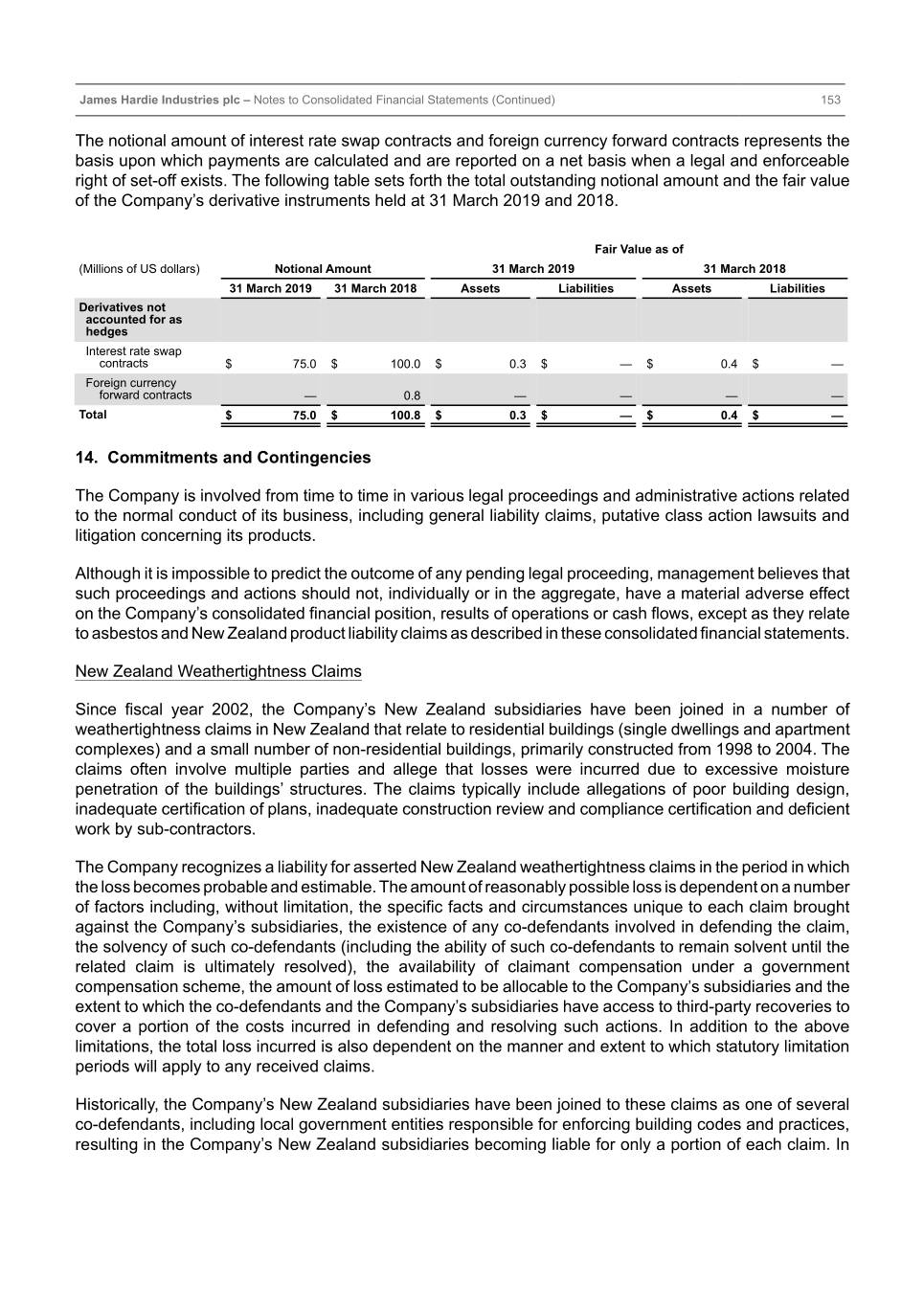
Table of Contents James Hardie Industries plc – Notes to Consolidated Financial Statements (Continued) 153 The notional amount of interest rate swap contracts and foreign currency forward contracts represents the basis upon which payments are calculated and are reported on a net basis when a legal and enforceable right of set-off exists. The following table sets forth the total outstanding notional amount and the fair value of the Company’s derivative instruments held at 31 March 2019 and 2018. Fair Value as of (Millions of US dollars) Notional Amount 31 March 2019 31 March 2018 31 March 2019 31 March 2018 Assets Liabilities Assets Liabilities Derivatives not accounted for as hedges Interest rate swap contracts $ 75.0 $ 100.0 $ 0.3 $ — $ 0.4 $ — Foreign currency forward contracts — 0.8 — — — — Total $ 75.0 $ 100.8 $ 0.3 $ — $ 0.4 $ — 14. Commitments and Contingencies The Company is involved from time to time in various legal proceedings and administrative actions related to the normal conduct of its business, including general liability claims, putative class action lawsuits and litigation concerning its products. Although it is impossible to predict the outcome of any pending legal proceeding, management believes that such proceedings and actions should not, individually or in the aggregate, have a material adverse effect on the Company’s consolidated financial position, results of operations or cash flows, except as they relate to asbestos and New Zealand product liability claims as described in these consolidated financial statements. New Zealand Weathertightness Claims Since fiscal year 2002, the Company’s New Zealand subsidiaries have been joined in a number of weathertightness claims in New Zealand that relate to residential buildings (single dwellings and apartment complexes) and a small number of non-residential buildings, primarily constructed from 1998 to 2004. The claims often involve multiple parties and allege that losses were incurred due to excessive moisture penetration of the buildings’ structures. The claims typically include allegations of poor building design, inadequate certification of plans, inadequate construction review and compliance certification and deficient work by sub-contractors. The Company recognizes a liability for asserted New Zealand weathertightness claims in the period in which the loss becomes probable and estimable. The amount of reasonably possible loss is dependent on a number of factors including, without limitation, the specific facts and circumstances unique to each claim brought against the Company’s subsidiaries, the existence of any co-defendants involved in defending the claim, the solvency of such co-defendants (including the ability of such co-defendants to remain solvent until the related claim is ultimately resolved), the availability of claimant compensation under a government compensation scheme, the amount of loss estimated to be allocable to the Company’s subsidiaries and the extent to which the co-defendants and the Company’s subsidiaries have access to third-party recoveries to cover a portion of the costs incurred in defending and resolving such actions. In addition to the above limitations, the total loss incurred is also dependent on the manner and extent to which statutory limitation periods will apply to any received claims. Historically, the Company’s New Zealand subsidiaries have been joined to these claims as one of several co-defendants, including local government entities responsible for enforcing building codes and practices, resulting in the Company’s New Zealand subsidiaries becoming liable for only a portion of each claim. In
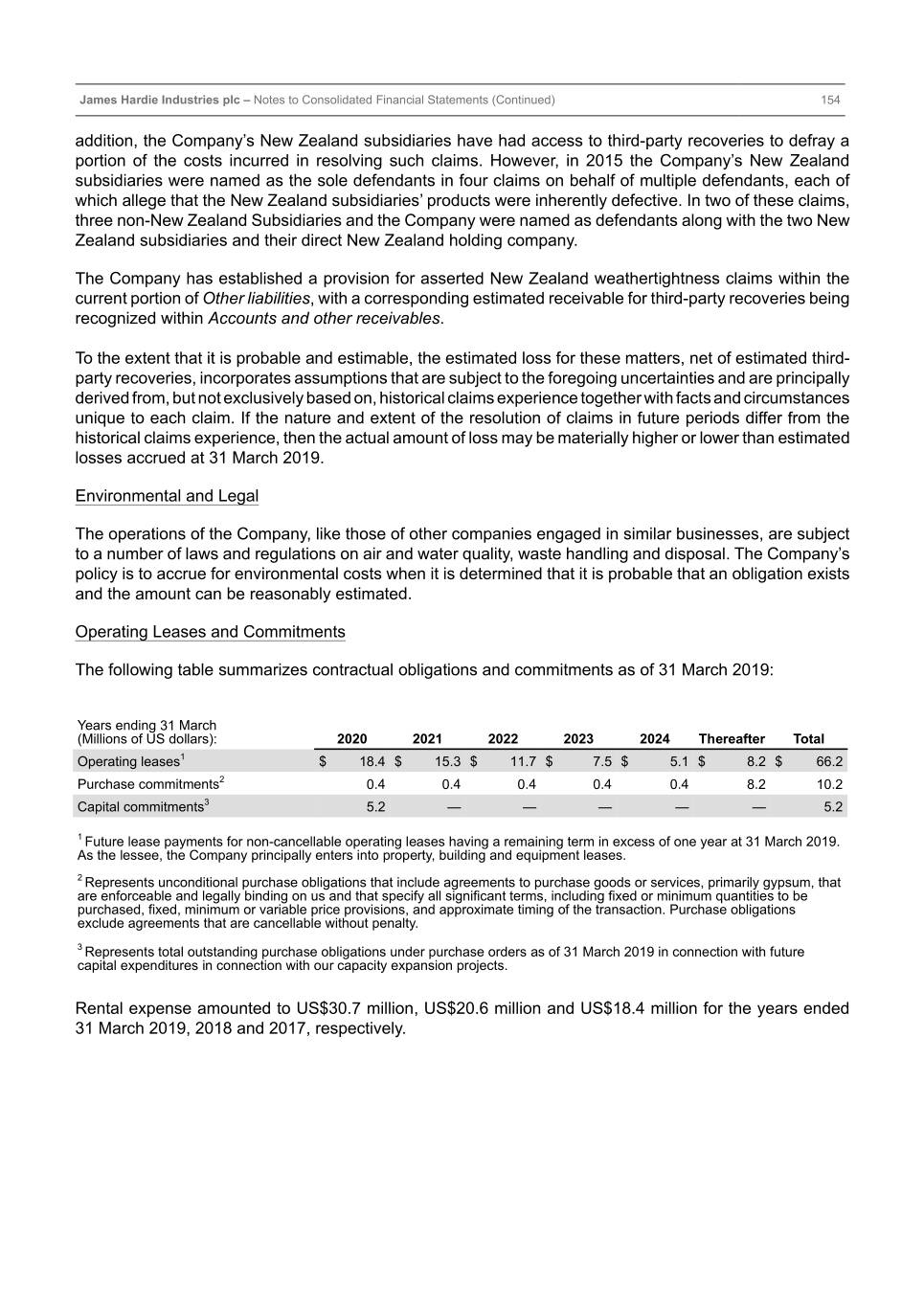
Table of Contents James Hardie Industries plc – Notes to Consolidated Financial Statements (Continued) 154 addition, the Company’s New Zealand subsidiaries have had access to third-party recoveries to defray a portion of the costs incurred in resolving such claims. However, in 2015 the Company’s New Zealand subsidiaries were named as the sole defendants in four claims on behalf of multiple defendants, each of which allege that the New Zealand subsidiaries’ products were inherently defective. In two of these claims, three non-New Zealand Subsidiaries and the Company were named as defendants along with the two New Zealand subsidiaries and their direct New Zealand holding company. The Company has established a provision for asserted New Zealand weathertightness claims within the current portion of Other liabilities, with a corresponding estimated receivable for third-party recoveries being recognized within Accounts and other receivables. To the extent that it is probable and estimable, the estimated loss for these matters, net of estimated third- party recoveries, incorporates assumptions that are subject to the foregoing uncertainties and are principally derived from, but not exclusively based on, historical claims experience together with facts and circumstances unique to each claim. If the nature and extent of the resolution of claims in future periods differ from the historical claims experience, then the actual amount of loss may be materially higher or lower than estimated losses accrued at 31 March 2019. Environmental and Legal The operations of the Company, like those of other companies engaged in similar businesses, are subject to a number of laws and regulations on air and water quality, waste handling and disposal. The Company’s policy is to accrue for environmental costs when it is determined that it is probable that an obligation exists and the amount can be reasonably estimated. Operating Leases and Commitments The following table summarizes contractual obligations and commitments as of 31 March 2019: Years ending 31 March (Millions of US dollars): 2020 2021 2022 2023 2024 Thereafter Total Operating leases1 $ 18.4 $ 15.3 $ 11.7 $ 7.5 $ 5.1 $ 8.2 $ 66.2 Purchase commitments2 0.4 0.4 0.4 0.4 0.4 8.2 10.2 Capital commitments3 5.2 — — — — — 5.2 1 Future lease payments for non-cancellable operating leases having a remaining term in excess of one year at 31 March 2019. As the lessee, the Company principally enters into property, building and equipment leases. 2 Represents unconditional purchase obligations that include agreements to purchase goods or services, primarily gypsum, that are enforceable and legally binding on us and that specify all significant terms, including fixed or minimum quantities to be purchased, fixed, minimum or variable price provisions, and approximate timing of the transaction. Purchase obligations exclude agreements that are cancellable without penalty. 3 Represents total outstanding purchase obligations under purchase orders as of 31 March 2019 in connection with future capital expenditures in connection with our capacity expansion projects. Rental expense amounted to US$30.7 million, US$20.6 million and US$18.4 million for the years ended 31 March 2019, 2018 and 2017, respectively.
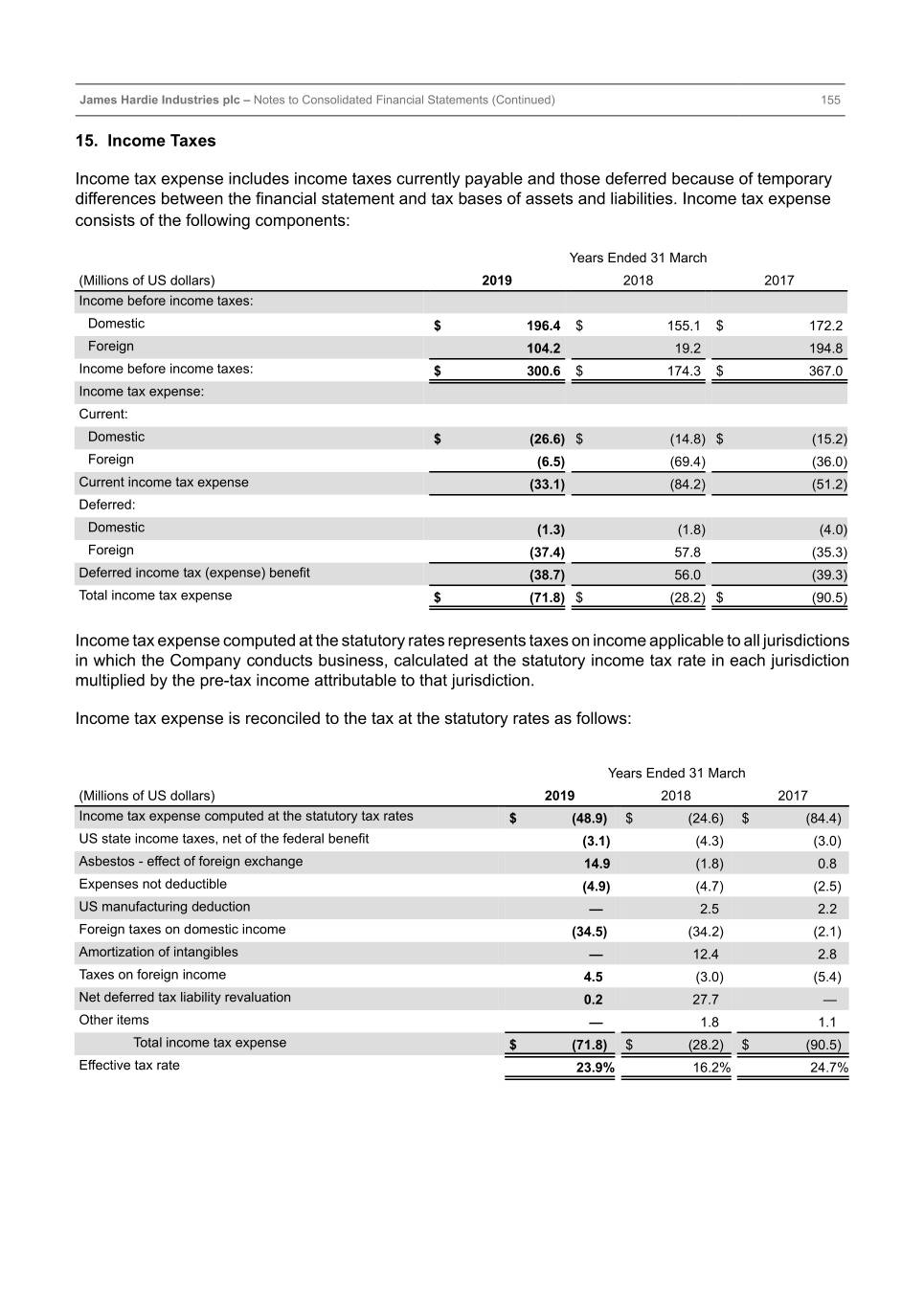
Table of Contents James Hardie Industries plc – Notes to Consolidated Financial Statements (Continued) 155 15. Income Taxes Income tax expense includes income taxes currently payable and those deferred because of temporary differences between the financial statement and tax bases of assets and liabilities. Income tax expense consists of the following components: Years Ended 31 March (Millions of US dollars) 2019 2018 2017 Income before income taxes: Domestic $ 196.4 $ 155.1 $ 172.2 Foreign 104.2 19.2 194.8 Income before income taxes: $ 300.6 $ 174.3 $ 367.0 Income tax expense: Current: Domestic $ (26.6) $ (14.8)$ (15.2) Foreign (6.5) (69.4) (36.0) Current income tax expense (33.1) (84.2) (51.2) Deferred: Domestic (1.3) (1.8) (4.0) Foreign (37.4) 57.8 (35.3) Deferred income tax (expense) benefit (38.7) 56.0 (39.3) Total income tax expense $ (71.8) $ (28.2)$ (90.5) Income tax expense computed at the statutory rates represents taxes on income applicable to all jurisdictions in which the Company conducts business, calculated at the statutory income tax rate in each jurisdiction multiplied by the pre-tax income attributable to that jurisdiction. Income tax expense is reconciled to the tax at the statutory rates as follows: Years Ended 31 March (Millions of US dollars) 2019 2018 2017 Income tax expense computed at the statutory tax rates $ (48.9) $ (24.6)$ (84.4) US state income taxes, net of the federal benefit (3.1) (4.3) (3.0) Asbestos - effect of foreign exchange 14.9 (1.8) 0.8 Expenses not deductible (4.9) (4.7) (2.5) US manufacturing deduction — 2.5 2.2 Foreign taxes on domestic income (34.5) (34.2) (2.1) Amortization of intangibles — 12.4 2.8 Taxes on foreign income 4.5 (3.0) (5.4) Net deferred tax liability revaluation 0.2 27.7 — Other items — 1.8 1.1 Total income tax expense $ (71.8) $ (28.2)$ (90.5) Effective tax rate 23.9% 16.2% 24.7%
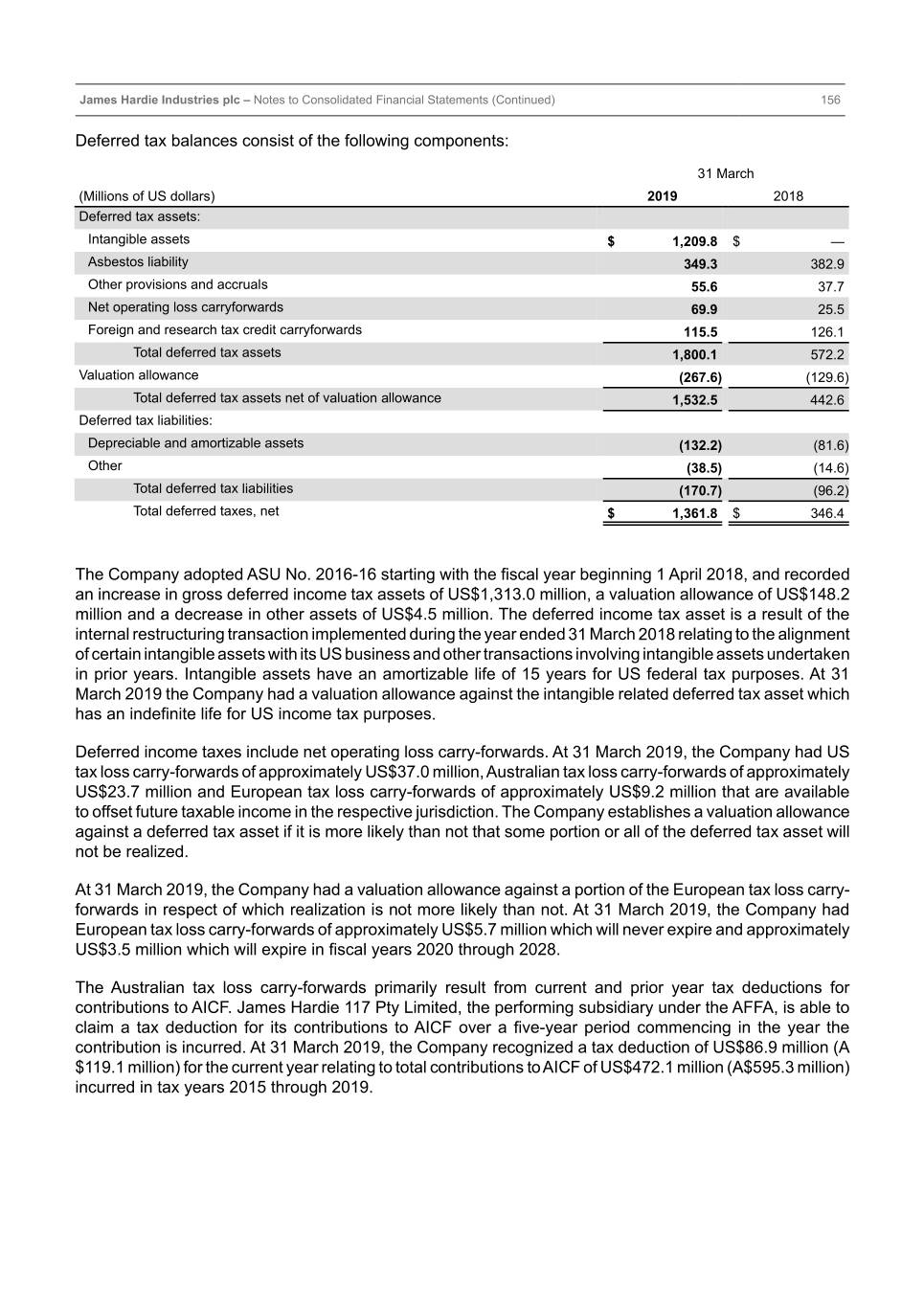
Table of Contents James Hardie Industries plc – Notes to Consolidated Financial Statements (Continued) 156 Deferred tax balances consist of the following components: 31 March (Millions of US dollars) 2019 2018 Deferred tax assets: Intangible assets $ 1,209.8 $ — Asbestos liability 349.3 382.9 Other provisions and accruals 55.6 37.7 Net operating loss carryforwards 69.9 25.5 Foreign and research tax credit carryforwards 115.5 126.1 Total deferred tax assets 1,800.1 572.2 Valuation allowance (267.6) (129.6) Total deferred tax assets net of valuation allowance 1,532.5 442.6 Deferred tax liabilities: Depreciable and amortizable assets (132.2) (81.6) Other (38.5) (14.6) Total deferred tax liabilities (170.7) (96.2) Total deferred taxes, net $ 1,361.8 $ 346.4 The Company adopted ASU No. 2016-16 starting with the fiscal year beginning 1 April 2018, and recorded an increase in gross deferred income tax assets of US$1,313.0 million, a valuation allowance of US$148.2 million and a decrease in other assets of US$4.5 million. The deferred income tax asset is a result of the internal restructuring transaction implemented during the year ended 31 March 2018 relating to the alignment of certain intangible assets with its US business and other transactions involving intangible assets undertaken in prior years. Intangible assets have an amortizable life of 15 years for US federal tax purposes. At 31 March 2019 the Company had a valuation allowance against the intangible related deferred tax asset which has an indefinite life for US income tax purposes. Deferred income taxes include net operating loss carry-forwards. At 31 March 2019, the Company had US tax loss carry-forwards of approximately US$37.0 million, Australian tax loss carry-forwards of approximately US$23.7 million and European tax loss carry-forwards of approximately US$9.2 million that are available to offset future taxable income in the respective jurisdiction. The Company establishes a valuation allowance against a deferred tax asset if it is more likely than not that some portion or all of the deferred tax asset will not be realized. At 31 March 2019, the Company had a valuation allowance against a portion of the European tax loss carry- forwards in respect of which realization is not more likely than not. At 31 March 2019, the Company had European tax loss carry-forwards of approximately US$5.7 million which will never expire and approximately US$3.5 million which will expire in fiscal years 2020 through 2028. The Australian tax loss carry-forwards primarily result from current and prior year tax deductions for contributions to AICF. James Hardie 117 Pty Limited, the performing subsidiary under the AFFA, is able to claim a tax deduction for its contributions to AICF over a five-year period commencing in the year the contribution is incurred. At 31 March 2019, the Company recognized a tax deduction of US$86.9 million (A $119.1 million) for the current year relating to total contributions to AICF of US$472.1 million (A$595.3 million) incurred in tax years 2015 through 2019.
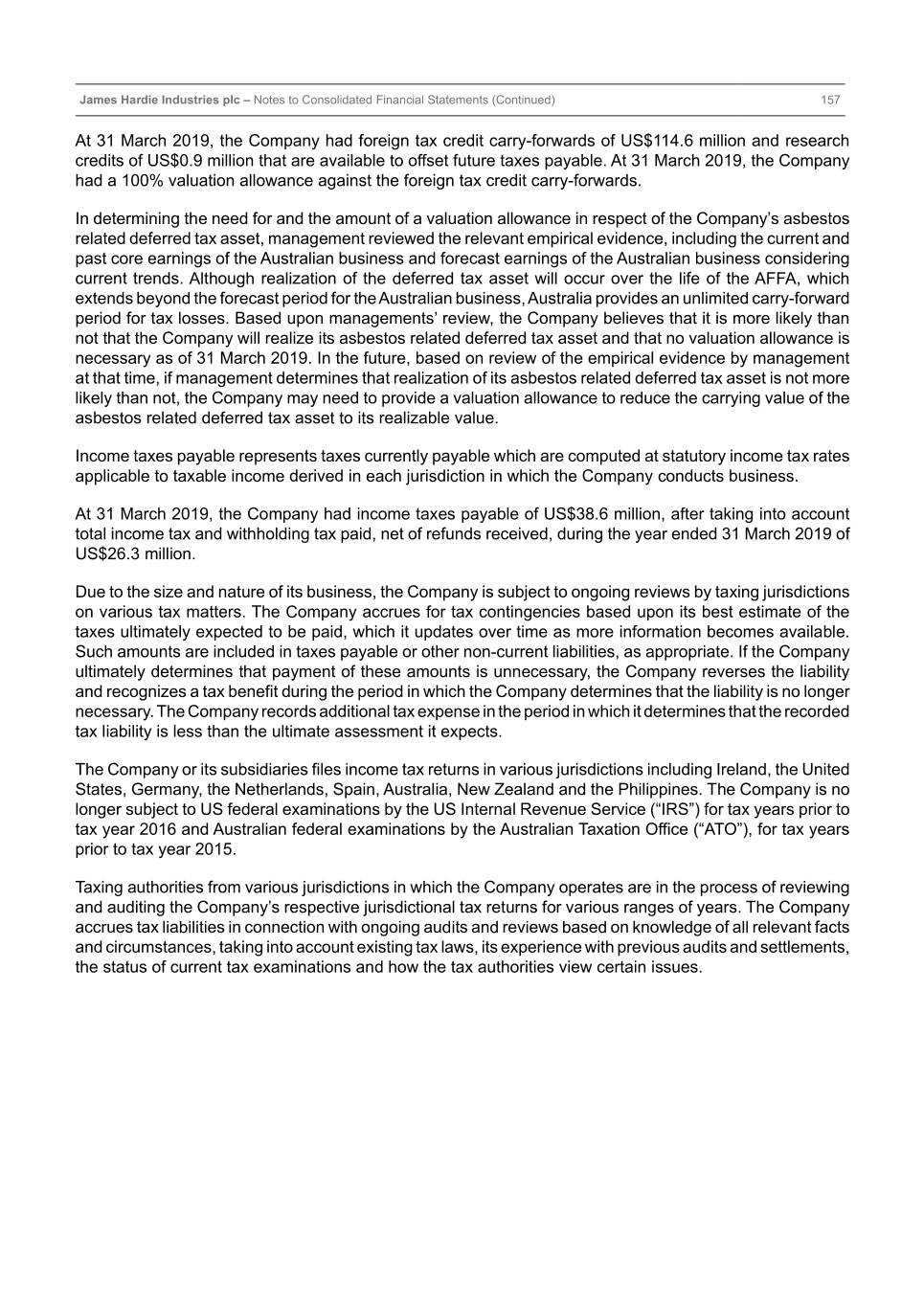
Table of Contents James Hardie Industries plc – Notes to Consolidated Financial Statements (Continued) 157 At 31 March 2019, the Company had foreign tax credit carry-forwards of US$114.6 million and research credits of US$0.9 million that are available to offset future taxes payable. At 31 March 2019, the Company had a 100% valuation allowance against the foreign tax credit carry-forwards. In determining the need for and the amount of a valuation allowance in respect of the Company’s asbestos related deferred tax asset, management reviewed the relevant empirical evidence, including the current and past core earnings of the Australian business and forecast earnings of the Australian business considering current trends. Although realization of the deferred tax asset will occur over the life of the AFFA, which extends beyond the forecast period for the Australian business, Australia provides an unlimited carry-forward period for tax losses. Based upon managements’ review, the Company believes that it is more likely than not that the Company will realize its asbestos related deferred tax asset and that no valuation allowance is necessary as of 31 March 2019. In the future, based on review of the empirical evidence by management at that time, if management determines that realization of its asbestos related deferred tax asset is not more likely than not, the Company may need to provide a valuation allowance to reduce the carrying value of the asbestos related deferred tax asset to its realizable value. Income taxes payable represents taxes currently payable which are computed at statutory income tax rates applicable to taxable income derived in each jurisdiction in which the Company conducts business. At 31 March 2019, the Company had income taxes payable of US$38.6 million, after taking into account total income tax and withholding tax paid, net of refunds received, during the year ended 31 March 2019 of US$26.3 million. Due to the size and nature of its business, the Company is subject to ongoing reviews by taxing jurisdictions on various tax matters. The Company accrues for tax contingencies based upon its best estimate of the taxes ultimately expected to be paid, which it updates over time as more information becomes available. Such amounts are included in taxes payable or other non-current liabilities, as appropriate. If the Company ultimately determines that payment of these amounts is unnecessary, the Company reverses the liability and recognizes a tax benefit during the period in which the Company determines that the liability is no longer necessary. The Company records additional tax expense in the period in which it determines that the recorded tax liability is less than the ultimate assessment it expects. The Company or its subsidiaries files income tax returns in various jurisdictions including Ireland, the United States, Germany, the Netherlands, Spain, Australia, New Zealand and the Philippines. The Company is no longer subject to US federal examinations by the US Internal Revenue Service (“IRS”) for tax years prior to tax year 2016 and Australian federal examinations by the Australian Taxation Office (“ATO”), for tax years prior to tax year 2015. Taxing authorities from various jurisdictions in which the Company operates are in the process of reviewing and auditing the Company’s respective jurisdictional tax returns for various ranges of years. The Company accrues tax liabilities in connection with ongoing audits and reviews based on knowledge of all relevant facts and circumstances, taking into account existing tax laws, its experience with previous audits and settlements, the status of current tax examinations and how the tax authorities view certain issues.
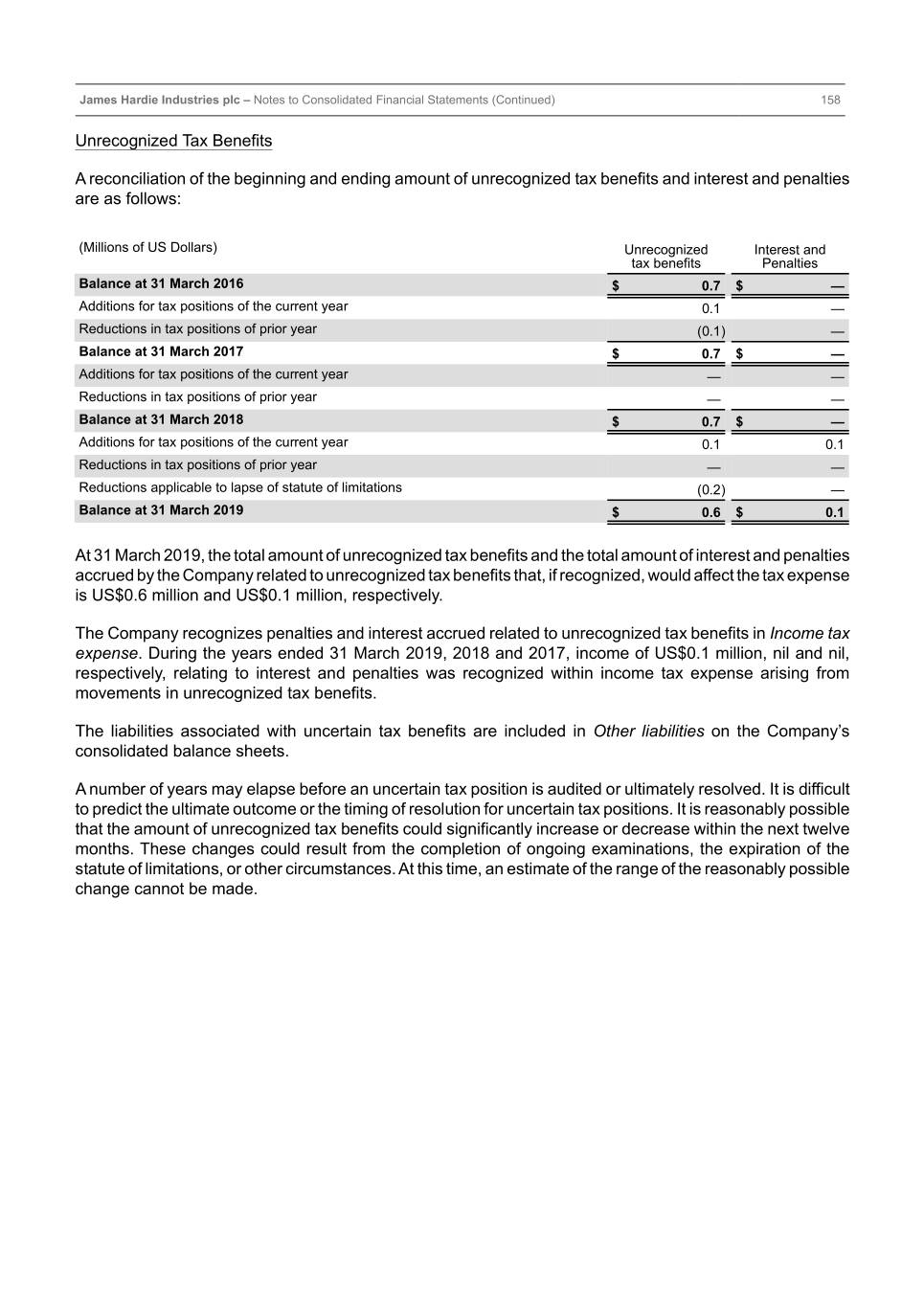
Table of Contents James Hardie Industries plc – Notes to Consolidated Financial Statements (Continued) 158 Unrecognized Tax Benefits A reconciliation of the beginning and ending amount of unrecognized tax benefits and interest and penalties are as follows: (Millions of US Dollars) Unrecognized Interest and tax benefits Penalties Balance at 31 March 2016 $ 0.7 $ — Additions for tax positions of the current year 0.1 — Reductions in tax positions of prior year (0.1) — Balance at 31 March 2017 $ 0.7 $ — Additions for tax positions of the current year — — Reductions in tax positions of prior year — — Balance at 31 March 2018 $ 0.7 $ — Additions for tax positions of the current year 0.1 0.1 Reductions in tax positions of prior year — — Reductions applicable to lapse of statute of limitations (0.2) — Balance at 31 March 2019 $ 0.6 $ 0.1 At 31 March 2019, the total amount of unrecognized tax benefits and the total amount of interest and penalties accrued by the Company related to unrecognized tax benefits that, if recognized, would affect the tax expense is US$0.6 million and US$0.1 million, respectively. The Company recognizes penalties and interest accrued related to unrecognized tax benefits in Income tax expense. During the years ended 31 March 2019, 2018 and 2017, income of US$0.1 million, nil and nil, respectively, relating to interest and penalties was recognized within income tax expense arising from movements in unrecognized tax benefits. The liabilities associated with uncertain tax benefits are included in Other liabilities on the Company’s consolidated balance sheets. A number of years may elapse before an uncertain tax position is audited or ultimately resolved. It is difficult to predict the ultimate outcome or the timing of resolution for uncertain tax positions. It is reasonably possible that the amount of unrecognized tax benefits could significantly increase or decrease within the next twelve months. These changes could result from the completion of ongoing examinations, the expiration of the statute of limitations, or other circumstances. At this time, an estimate of the range of the reasonably possible change cannot be made.
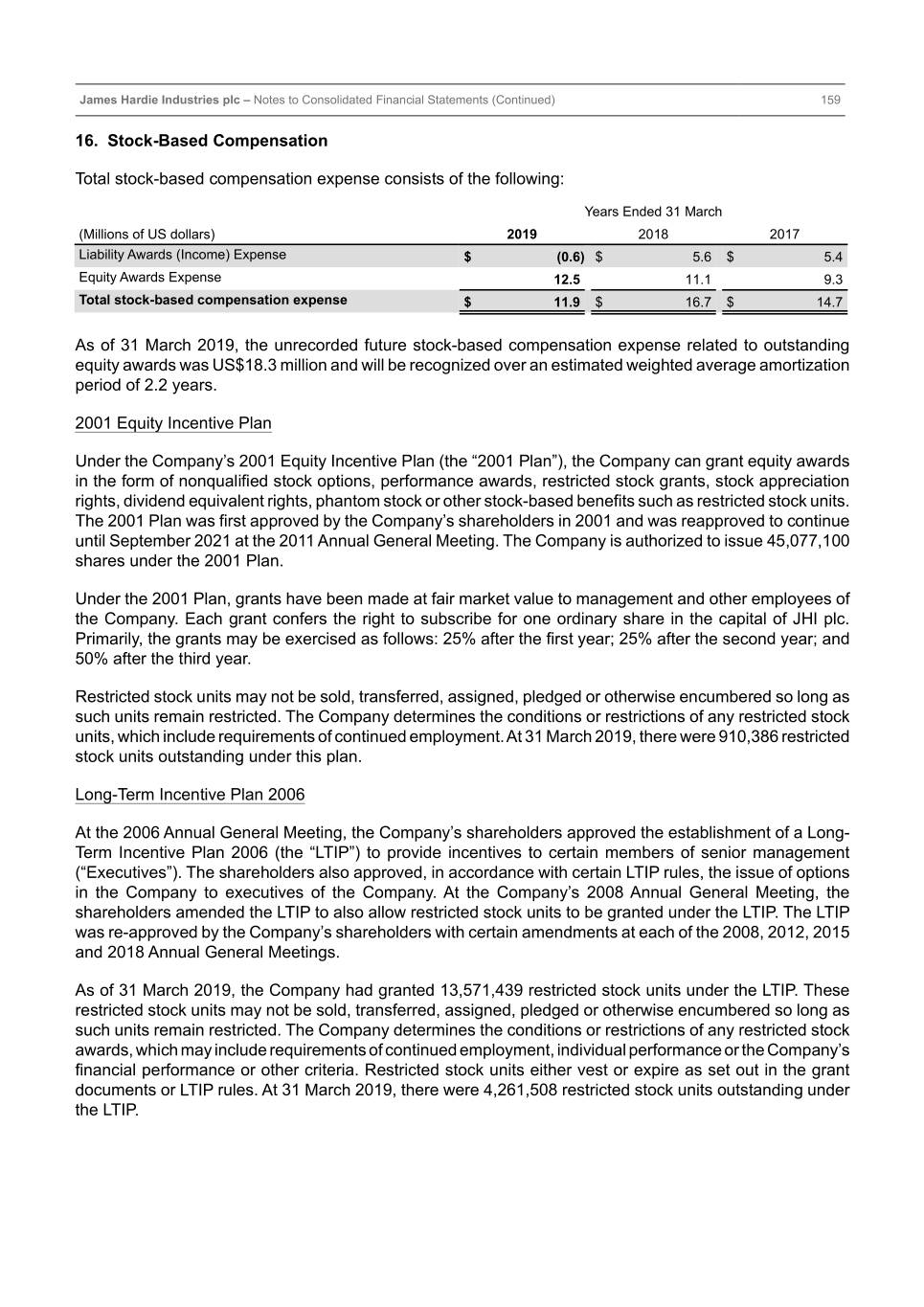
Table of Contents James Hardie Industries plc – Notes to Consolidated Financial Statements (Continued) 159 16. Stock-Based Compensation Total stock-based compensation expense consists of the following: Years Ended 31 March (Millions of US dollars) 2019 2018 2017 Liability Awards (Income) Expense $ (0.6) $ 5.6 $ 5.4 Equity Awards Expense 12.5 11.1 9.3 Total stock-based compensation expense $ 11.9 $ 16.7 $ 14.7 As of 31 March 2019, the unrecorded future stock-based compensation expense related to outstanding equity awards was US$18.3 million and will be recognized over an estimated weighted average amortization period of 2.2 years. 2001 Equity Incentive Plan Under the Company’s 2001 Equity Incentive Plan (the “2001 Plan”), the Company can grant equity awards in the form of nonqualified stock options, performance awards, restricted stock grants, stock appreciation rights, dividend equivalent rights, phantom stock or other stock-based benefits such as restricted stock units. The 2001 Plan was first approved by the Company’s shareholders in 2001 and was reapproved to continue until September 2021 at the 2011 Annual General Meeting. The Company is authorized to issue 45,077,100 shares under the 2001 Plan. Under the 2001 Plan, grants have been made at fair market value to management and other employees of the Company. Each grant confers the right to subscribe for one ordinary share in the capital of JHI plc. Primarily, the grants may be exercised as follows: 25% after the first year; 25% after the second year; and 50% after the third year. Restricted stock units may not be sold, transferred, assigned, pledged or otherwise encumbered so long as such units remain restricted. The Company determines the conditions or restrictions of any restricted stock units, which include requirements of continued employment. At 31 March 2019, there were 910,386 restricted stock units outstanding under this plan. Long-Term Incentive Plan 2006 At the 2006 Annual General Meeting, the Company’s shareholders approved the establishment of a Long- Term Incentive Plan 2006 (the “LTIP”) to provide incentives to certain members of senior management (“Executives”). The shareholders also approved, in accordance with certain LTIP rules, the issue of options in the Company to executives of the Company. At the Company’s 2008 Annual General Meeting, the shareholders amended the LTIP to also allow restricted stock units to be granted under the LTIP. The LTIP was re-approved by the Company’s shareholders with certain amendments at each of the 2008, 2012, 2015 and 2018 Annual General Meetings. As of 31 March 2019, the Company had granted 13,571,439 restricted stock units under the LTIP. These restricted stock units may not be sold, transferred, assigned, pledged or otherwise encumbered so long as such units remain restricted. The Company determines the conditions or restrictions of any restricted stock awards, which may include requirements of continued employment, individual performance or the Company’s financial performance or other criteria. Restricted stock units either vest or expire as set out in the grant documents or LTIP rules. At 31 March 2019, there were 4,261,508 restricted stock units outstanding under the LTIP.

Table of Contents James Hardie Industries plc – Notes to Consolidated Financial Statements (Continued) 160 The following table summarizes the Company’s shares available for grant as options, restricted stock units or other equity instruments under the LTIP and 2001 Plan at 31 March 2019, 2018 and 2017: Shares Available for Grant Balance at 31 March 2017 27,238,814 Granted (1,779,904) Balance at 31 March 2018 25,458,910 Granted (1,714,094) Balance at 31 March 2019 23,744,816 Stock Options There were no stock options granted during the years ended 31 March 2019 and 2018. The following table summarizes the Company’s stock options activity during the noted periods: Outstanding Options Weighted Average Exercise Number Price (A$) Balance at 31 March 2017 48,896 6.38 Exercised (48,896) 6.38 Balance at 31 March 2018 — Exercised — Balance at 31 March 2019 — The total intrinsic value of stock options exercised was nil and A$0.8 million for the years ended 31 March 2019 and 2018, respectively. Windfall tax benefits realized in the United States from stock options exercised and included in cash flows from financing activities in the consolidated statements of cash flows were nil, nil and US$3.0 million for the years ended 31 March 2019, 2018 and 2017, respectively.
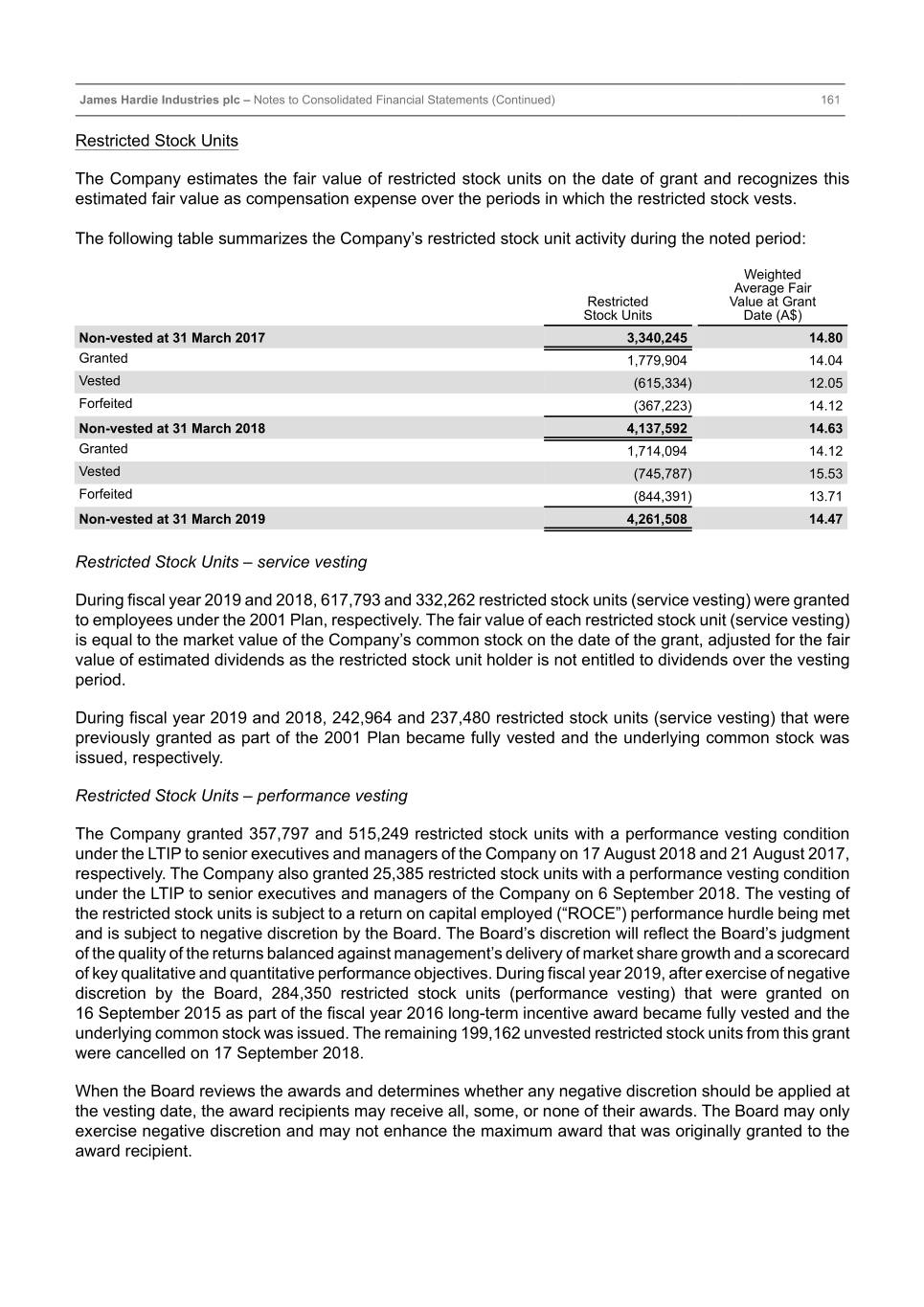
Table of Contents James Hardie Industries plc – Notes to Consolidated Financial Statements (Continued) 161 Restricted Stock Units The Company estimates the fair value of restricted stock units on the date of grant and recognizes this estimated fair value as compensation expense over the periods in which the restricted stock vests. The following table summarizes the Company’s restricted stock unit activity during the noted period: Weighted Average Fair Restricted Value at Grant Stock Units Date (A$) Non-vested at 31 March 2017 3,340,245 14.80 Granted 1,779,904 14.04 Vested (615,334) 12.05 Forfeited (367,223) 14.12 Non-vested at 31 March 2018 4,137,592 14.63 Granted 1,714,094 14.12 Vested (745,787) 15.53 Forfeited (844,391) 13.71 Non-vested at 31 March 2019 4,261,508 14.47 Restricted Stock Units – service vesting During fiscal year 2019 and 2018, 617,793 and 332,262 restricted stock units (service vesting) were granted to employees under the 2001 Plan, respectively. The fair value of each restricted stock unit (service vesting) is equal to the market value of the Company’s common stock on the date of the grant, adjusted for the fair value of estimated dividends as the restricted stock unit holder is not entitled to dividends over the vesting period. During fiscal year 2019 and 2018, 242,964 and 237,480 restricted stock units (service vesting) that were previously granted as part of the 2001 Plan became fully vested and the underlying common stock was issued, respectively. Restricted Stock Units – performance vesting The Company granted 357,797 and 515,249 restricted stock units with a performance vesting condition under the LTIP to senior executives and managers of the Company on 17 August 2018 and 21 August 2017, respectively. The Company also granted 25,385 restricted stock units with a performance vesting condition under the LTIP to senior executives and managers of the Company on 6 September 2018. The vesting of the restricted stock units is subject to a return on capital employed (“ROCE”) performance hurdle being met and is subject to negative discretion by the Board. The Board’s discretion will reflect the Board’s judgment of the quality of the returns balanced against management’s delivery of market share growth and a scorecard of key qualitative and quantitative performance objectives. During fiscal year 2019, after exercise of negative discretion by the Board, 284,350 restricted stock units (performance vesting) that were granted on 16 September 2015 as part of the fiscal year 2016 long-term incentive award became fully vested and the underlying common stock was issued. The remaining 199,162 unvested restricted stock units from this grant were cancelled on 17 September 2018. When the Board reviews the awards and determines whether any negative discretion should be applied at the vesting date, the award recipients may receive all, some, or none of their awards. The Board may only exercise negative discretion and may not enhance the maximum award that was originally granted to the award recipient.
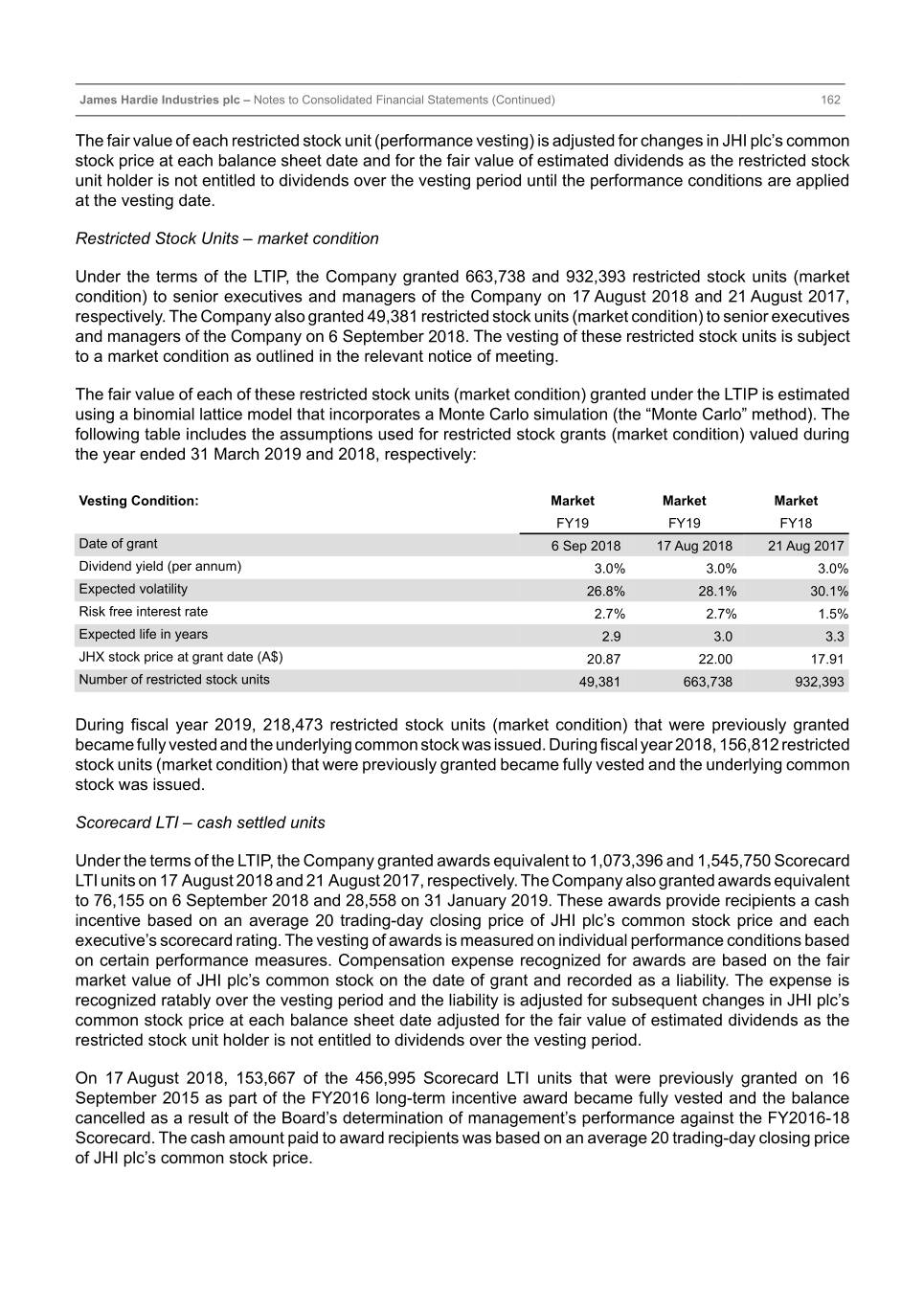
Table of Contents James Hardie Industries plc – Notes to Consolidated Financial Statements (Continued) 162 The fair value of each restricted stock unit (performance vesting) is adjusted for changes in JHI plc’s common stock price at each balance sheet date and for the fair value of estimated dividends as the restricted stock unit holder is not entitled to dividends over the vesting period until the performance conditions are applied at the vesting date. Restricted Stock Units – market condition Under the terms of the LTIP, the Company granted 663,738 and 932,393 restricted stock units (market condition) to senior executives and managers of the Company on 17 August 2018 and 21 August 2017, respectively. The Company also granted 49,381 restricted stock units (market condition) to senior executives and managers of the Company on 6 September 2018. The vesting of these restricted stock units is subject to a market condition as outlined in the relevant notice of meeting. The fair value of each of these restricted stock units (market condition) granted under the LTIP is estimated using a binomial lattice model that incorporates a Monte Carlo simulation (the “Monte Carlo” method). The following table includes the assumptions used for restricted stock grants (market condition) valued during the year ended 31 March 2019 and 2018, respectively: Vesting Condition: Market Market Market FY19 FY19 FY18 Date of grant 6 Sep 2018 17 Aug 2018 21 Aug 2017 Dividend yield (per annum) 3.0% 3.0% 3.0% Expected volatility 26.8% 28.1% 30.1% Risk free interest rate 2.7% 2.7% 1.5% Expected life in years 2.9 3.0 3.3 JHX stock price at grant date (A$) 20.87 22.00 17.91 Number of restricted stock units 49,381 663,738 932,393 During fiscal year 2019, 218,473 restricted stock units (market condition) that were previously granted became fully vested and the underlying common stock was issued. During fiscal year 2018, 156,812 restricted stock units (market condition) that were previously granted became fully vested and the underlying common stock was issued. Scorecard LTI – cash settled units Under the terms of the LTIP, the Company granted awards equivalent to 1,073,396 and 1,545,750 Scorecard LTI units on 17 August 2018 and 21 August 2017, respectively. The Company also granted awards equivalent to 76,155 on 6 September 2018 and 28,558 on 31 January 2019. These awards provide recipients a cash incentive based on an average 20 trading-day closing price of JHI plc’s common stock price and each executive’s scorecard rating. The vesting of awards is measured on individual performance conditions based on certain performance measures. Compensation expense recognized for awards are based on the fair market value of JHI plc’s common stock on the date of grant and recorded as a liability. The expense is recognized ratably over the vesting period and the liability is adjusted for subsequent changes in JHI plc’s common stock price at each balance sheet date adjusted for the fair value of estimated dividends as the restricted stock unit holder is not entitled to dividends over the vesting period. On 17 August 2018, 153,667 of the 456,995 Scorecard LTI units that were previously granted on 16 September 2015 as part of the FY2016 long-term incentive award became fully vested and the balance cancelled as a result of the Board’s determination of management’s performance against the FY2016-18 Scorecard. The cash amount paid to award recipients was based on an average 20 trading-day closing price of JHI plc’s common stock price.
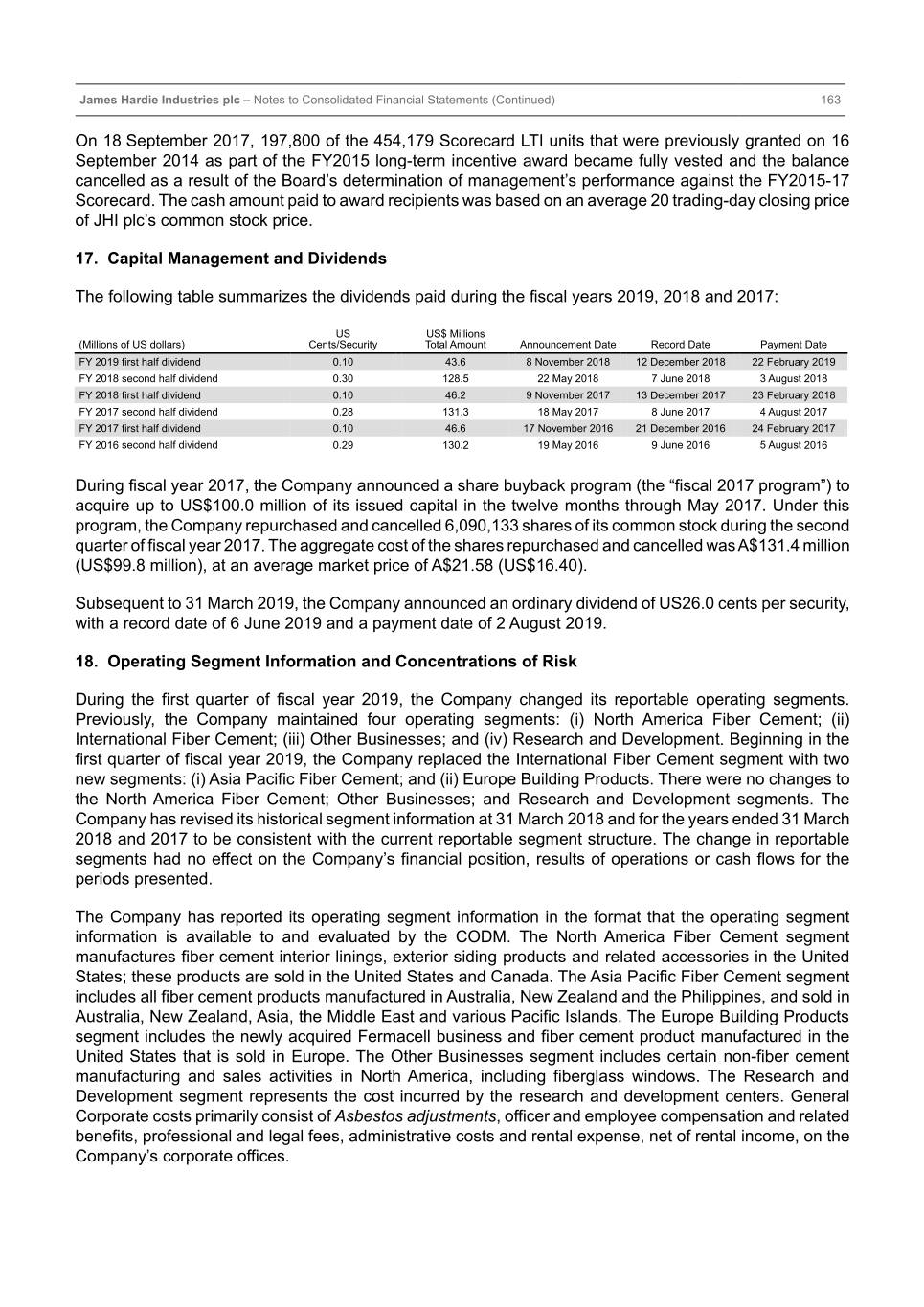
Table of Contents James Hardie Industries plc – Notes to Consolidated Financial Statements (Continued) 163 On 18 September 2017, 197,800 of the 454,179 Scorecard LTI units that were previously granted on 16 September 2014 as part of the FY2015 long-term incentive award became fully vested and the balance cancelled as a result of the Board’s determination of management’s performance against the FY2015-17 Scorecard. The cash amount paid to award recipients was based on an average 20 trading-day closing price of JHI plc’s common stock price. 17. Capital Management and Dividends The following table summarizes the dividends paid during the fiscal years 2019, 2018 and 2017: US US$ Millions (Millions of US dollars) Cents/Security Total Amount Announcement Date Record Date Payment Date FY 2019 first half dividend 0.10 43.6 8 November 2018 12 December 2018 22 February 2019 FY 2018 second half dividend 0.30 128.5 22 May 2018 7 June 2018 3 August 2018 FY 2018 first half dividend 0.10 46.2 9 November 2017 13 December 2017 23 February 2018 FY 2017 second half dividend 0.28 131.3 18 May 2017 8 June 2017 4 August 2017 FY 2017 first half dividend 0.10 46.6 17 November 2016 21 December 2016 24 February 2017 FY 2016 second half dividend 0.29 130.2 19 May 2016 9 June 2016 5 August 2016 During fiscal year 2017, the Company announced a share buyback program (the “fiscal 2017 program”) to acquire up to US$100.0 million of its issued capital in the twelve months through May 2017. Under this program, the Company repurchased and cancelled 6,090,133 shares of its common stock during the second quarter of fiscal year 2017. The aggregate cost of the shares repurchased and cancelled was A$131.4 million (US$99.8 million), at an average market price of A$21.58 (US$16.40). Subsequent to 31 March 2019, the Company announced an ordinary dividend of US26.0 cents per security, with a record date of 6 June 2019 and a payment date of 2 August 2019. 18. Operating Segment Information and Concentrations of Risk During the first quarter of fiscal year 2019, the Company changed its reportable operating segments. Previously, the Company maintained four operating segments: (i) North America Fiber Cement; (ii) International Fiber Cement; (iii) Other Businesses; and (iv) Research and Development. Beginning in the first quarter of fiscal year 2019, the Company replaced the International Fiber Cement segment with two new segments: (i) Asia Pacific Fiber Cement; and (ii) Europe Building Products. There were no changes to the North America Fiber Cement; Other Businesses; and Research and Development segments. The Company has revised its historical segment information at 31 March 2018 and for the years ended 31 March 2018 and 2017 to be consistent with the current reportable segment structure. The change in reportable segments had no effect on the Company’s financial position, results of operations or cash flows for the periods presented. The Company has reported its operating segment information in the format that the operating segment information is available to and evaluated by the CODM. The North America Fiber Cement segment manufactures fiber cement interior linings, exterior siding products and related accessories in the United States; these products are sold in the United States and Canada. The Asia Pacific Fiber Cement segment includes all fiber cement products manufactured in Australia, New Zealand and the Philippines, and sold in Australia, New Zealand, Asia, the Middle East and various Pacific Islands. The Europe Building Products segment includes the newly acquired Fermacell business and fiber cement product manufactured in the United States that is sold in Europe. The Other Businesses segment includes certain non-fiber cement manufacturing and sales activities in North America, including fiberglass windows. The Research and Development segment represents the cost incurred by the research and development centers. General Corporate costs primarily consist of Asbestos adjustments, officer and employee compensation and related benefits, professional and legal fees, administrative costs and rental expense, net of rental income, on the Company’s corporate offices.
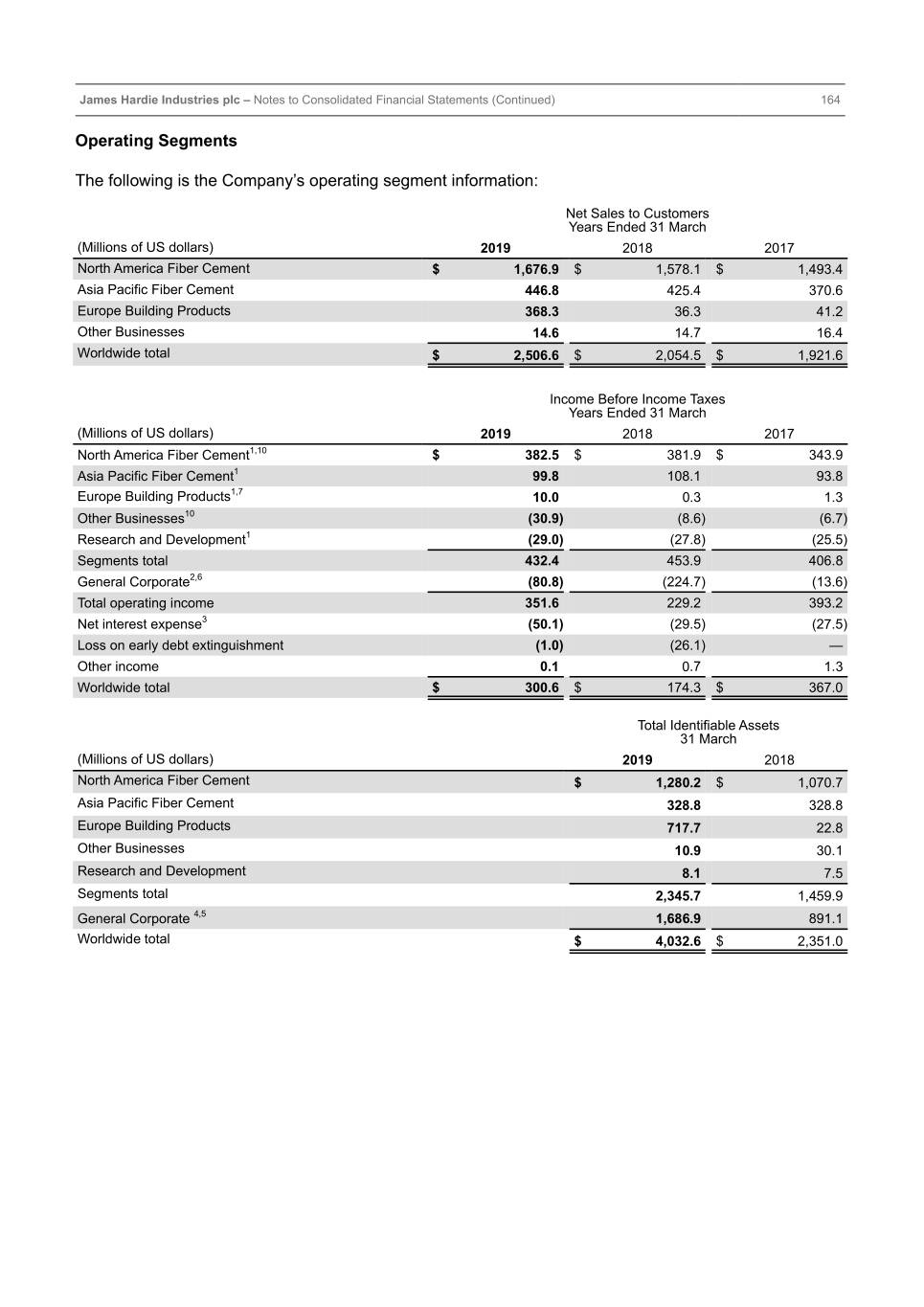
Table of Contents James Hardie Industries plc – Notes to Consolidated Financial Statements (Continued) 164 Operating Segments The following is the Company’s operating segment information: Net Sales to Customers Years Ended 31 March (Millions of US dollars) 2019 2018 2017 North America Fiber Cement $ 1,676.9 $ 1,578.1 $ 1,493.4 Asia Pacific Fiber Cement 446.8 425.4 370.6 Europe Building Products 368.3 36.3 41.2 Other Businesses 14.6 14.7 16.4 Worldwide total $ 2,506.6 $ 2,054.5 $ 1,921.6 Income Before Income Taxes Years Ended 31 March (Millions of US dollars) 2019 2018 2017 North America Fiber Cement1,10 $ 382.5 $ 381.9 $ 343.9 Asia Pacific Fiber Cement1 99.8 108.1 93.8 1,7 Europe Building Products 10.0 0.3 1.3 Other Businesses10 (30.9) (8.6) (6.7) Research and Development1 (29.0) (27.8) (25.5) Segments total 432.4 453.9 406.8 General Corporate2,6 (80.8) (224.7) (13.6) Total operating income 351.6 229.2 393.2 Net interest expense3 (50.1) (29.5) (27.5) Loss on early debt extinguishment (1.0) (26.1) — Other income 0.1 0.7 1.3 Worldwide total $ 300.6 $ 174.3 $ 367.0 Total Identifiable Assets 31 March (Millions of US dollars) 2019 2018 North America Fiber Cement $ 1,280.2 $ 1,070.7 Asia Pacific Fiber Cement 328.8 328.8 Europe Building Products 717.7 22.8 Other Businesses 10.9 30.1 Research and Development 8.1 7.5 Segments total 2,345.7 1,459.9 General Corporate 4,5 1,686.9 891.1 Worldwide total $ 4,032.6 $ 2,351.0
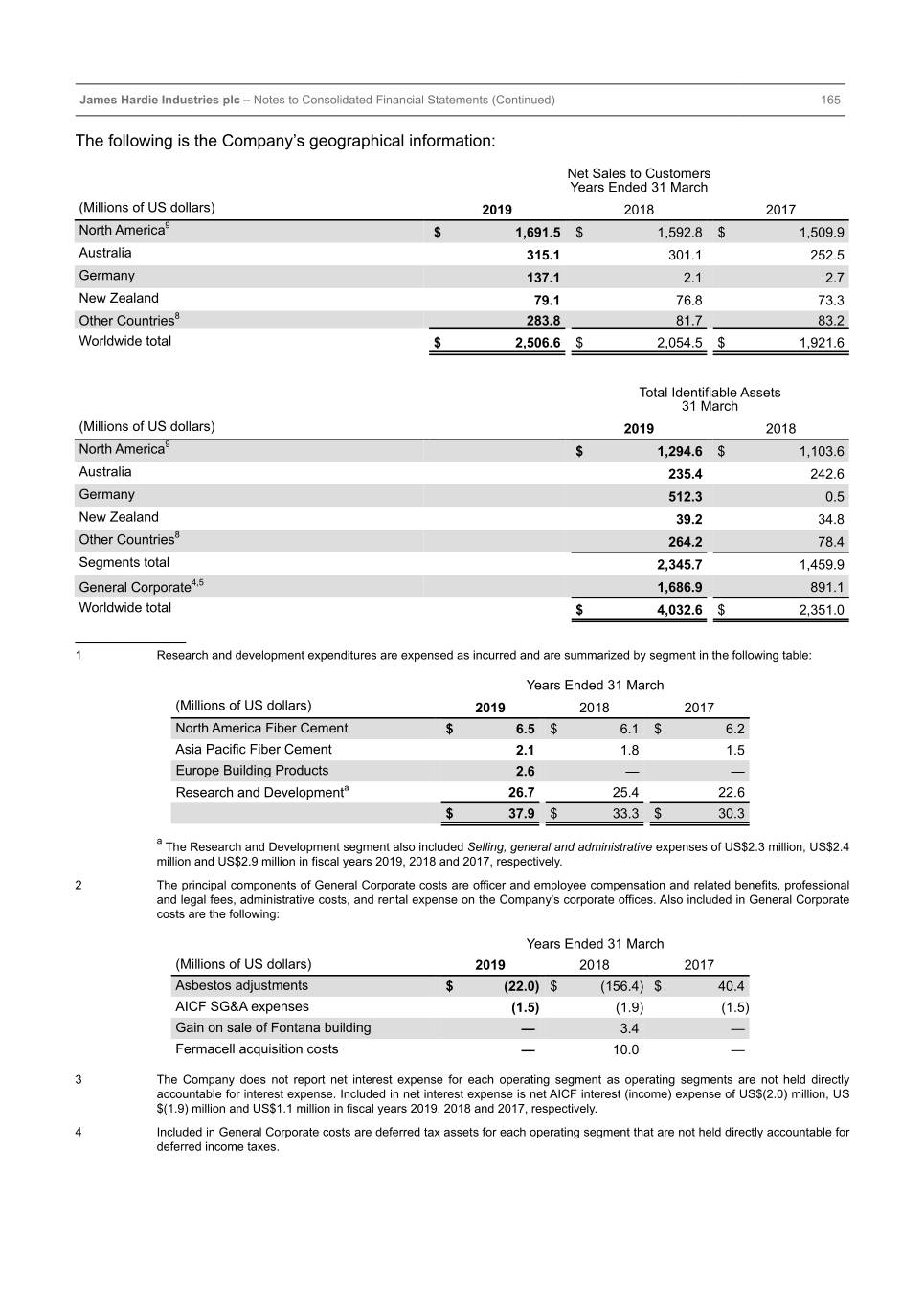
Table of Contents James Hardie Industries plc – Notes to Consolidated Financial Statements (Continued) 165 The following is the Company’s geographical information: Net Sales to Customers Years Ended 31 March (Millions of US dollars) 2019 2018 2017 9 North America $ 1,691.5 $ 1,592.8 $ 1,509.9 Australia 315.1 301.1 252.5 Germany 137.1 2.1 2.7 New Zealand 79.1 76.8 73.3 Other Countries8 283.8 81.7 83.2 Worldwide total $ 2,506.6 $ 2,054.5 $ 1,921.6 Total Identifiable Assets 31 March (Millions of US dollars) 2019 2018 9 North America $ 1,294.6 $ 1,103.6 Australia 235.4 242.6 Germany 512.3 0.5 New Zealand 39.2 34.8 8 Other Countries 264.2 78.4 Segments total 2,345.7 1,459.9 General Corporate4,5 1,686.9 891.1 Worldwide total $ 4,032.6 $ 2,351.0 ____________ 1 Research and development expenditures are expensed as incurred and are summarized by segment in the following table: Years Ended 31 March (Millions of US dollars) 2019 2018 2017 North America Fiber Cement $ 6.5 $ 6.1 $ 6.2 Asia Pacific Fiber Cement 2.1 1.8 1.5 Europe Building Products 2.6 — — Research and Developmenta 26.7 25.4 22.6 $ 37.9 $ 33.3 $ 30.3 a The Research and Development segment also included Selling, general and administrative expenses of US$2.3 million, US$2.4 million and US$2.9 million in fiscal years 2019, 2018 and 2017, respectively. 2 The principal components of General Corporate costs are officer and employee compensation and related benefits, professional and legal fees, administrative costs, and rental expense on the Company’s corporate offices. Also included in General Corporate costs are the following: Years Ended 31 March (Millions of US dollars) 2019 2018 2017 Asbestos adjustments $ (22.0) $ (156.4)$ 40.4 AICF SG&A expenses (1.5) (1.9) (1.5) Gain on sale of Fontana building — 3.4 — Fermacell acquisition costs — 10.0 — 3 The Company does not report net interest expense for each operating segment as operating segments are not held directly accountable for interest expense. Included in net interest expense is net AICF interest (income) expense of US$(2.0) million, US $(1.9) million and US$1.1 million in fiscal years 2019, 2018 and 2017, respectively. 4 Included in General Corporate costs are deferred tax assets for each operating segment that are not held directly accountable for deferred income taxes.

Table of Contents James Hardie Industries plc – Notes to Consolidated Financial Statements (Continued) 166 5 Asbestos-related assets at 31 March 2019 and 2018 are US$486.8 million and US$537.7 million, respectively, and are included in the General Corporate costs. 6 Included in the General Corporate costs are New Zealand weathertightness legal costs of US$3.3 million, nil and nil for the years ended 31 March 2019, 2018 and 2017, respectively. 7 Included in the Europe Building Products segment are Fermacell transaction and integration costs of US$21.8 million and the amortization of the inventory fair value adjustment of US$7.3 million for the year ended 31 March 2019. As this inventory was sold during the first quarter of fiscal year 2019, the entire adjustment was recognized into cost of goods sold during the same period. 8 Included are all other countries that account for less than 5% of net sales and total identifiable assets individually, primarily in the Philippines, Switzerland and other European countries. 9 The amounts disclosed for North America are substantially all related to the USA. 10 The following table summarizes asset impairment costs by segment: Years Ended 31 March (Millions of US dollars) 2019 2018 2017 North America Fiber Cementa $ 3.0 $ — $ — Other Businessesb 12.9 — — $ 15.9 $ — $ — a For the year ended 31 March 2019, the Company recorded impairment charges of US$2.6 million and US$0.4 million to Property, plant and equipment, net and Intangible assets, net, respectively, related to the discontinuance of its MCT product line. b For the year ended 31 March 2019, the Company recorded impairment charges of US$4.6 million, US$6.1 million and US$2.2 million to the Goodwill, Property, Plant and equipment, net and Intangible assets, net, respectively, due to the Company's decision to cease production of its fiberglass windows business in the second quarter of fiscal year 2019. Concentrations of Risk The distribution channels for the Company’s fiber cement products are concentrated. If the Company were to lose one or more of its major customers, there can be no assurance that the Company will be able to find a replacement. Therefore, the loss of one or more customers could have a material adverse effect on the Company’s consolidated financial position, results of operations and cash flows. We have one customer who contributes greater than 10% of our net sales in each of the past three fiscal years. This customer’s accounts receivable represented 8.5% and 9.0% of the Company’s accounts receivable at 31 March 2019 and 2018, respectively. The following is net sales generated by this customer, which is from the North America Fiber Cement segment: Years Ended 31 March (Millions of US dollars) 2019 2018 2017 Customer A $ 260.5 10.4% $ 246.9 12.0%$ 226.0 10.3% Approximately 36%, 22% and 21% of the Company’s net sales in fiscal year 2019, 2018 and 2017, respectively, were from outside the United States. Consequently, changes in the value of foreign currencies could significantly affect the consolidated financial position, results of operations and cash flows of the Company’s non-US operations on translation into US dollars.

Table of Contents James Hardie Industries plc – Notes to Consolidated Financial Statements (Continued) 167 19. Accumulated Other Comprehensive Loss During the year ended 31 March 2019 there were the following reclassifications out of Accumulated other comprehensive loss: Foreign Currency Cash Flow Translation (Millions of US dollars) Hedges Adjustments Total Balance at 31 March 2018 $ 0.3 $ (1.6)$ (1.3) Other comprehensive loss (0.1) (28.9) (29.0) Balance at 31 March 2019 $ 0.2 $ (30.5)$ (30.3) 20. Business Combinations Fermacell Acquisition On 3 April 2018, the Company completed its acquisition of the Fermacell business with Xella International S.A. for a purchase price of €516.4 million (US$635.6 million based on the exchange rate at 3 April 2018). The acquisition was pursuant to the Sales and Purchase Agreement dated 7 November 2017, and was structured as a stock purchase, resulting in 100% ownership of Fermacell. The Company financed the acquisition through a combination of cash on hand and borrowings of €400.0 million (US$492.4 million based on the exchange rate at 3 April 2018) from the Term Loan Facility. See Note 10 for more information. Headquartered in Dusseldorf, Germany, Fermacell operates six manufacturing plants across Germany, the Netherlands and Spain, with a sales force in 13 countries and revenues generated primarily from countries in Western Europe. Fermacell is a provider of innovative building solutions, producing and distributing high quality fiber gypsum boards and cement-bonded boards, which are two complementary products in the high performance board space. Management believes this acquisition will generate significant value by providing the Company with a significant European presence and a differentiated platform to position the Company for meaningful long-term growth in Europe. In connection with this acquisition, the Company incurred related transaction and integration costs of US $21.8 million during the year ended 31 March 2019, which have been recorded in the consolidated statements of operations and comprehensive income in Selling, general and administrative expenses. The following is the purchase price allocation for Fermacell: (Millions of US dollars) Cash and cash equivalents $ 76.9 Accounts and other receivable 43.7 Inventories 39.7 Other assets 4.1 Property, plant and equipment 230.3 Intangible assets 187.0 Accounts payable (40.5) Other liabilities (41.2) Deferred tax liabilities (84.4) Net assets acquired $ 415.6 Goodwill 220.0 Total consideration $ 635.6
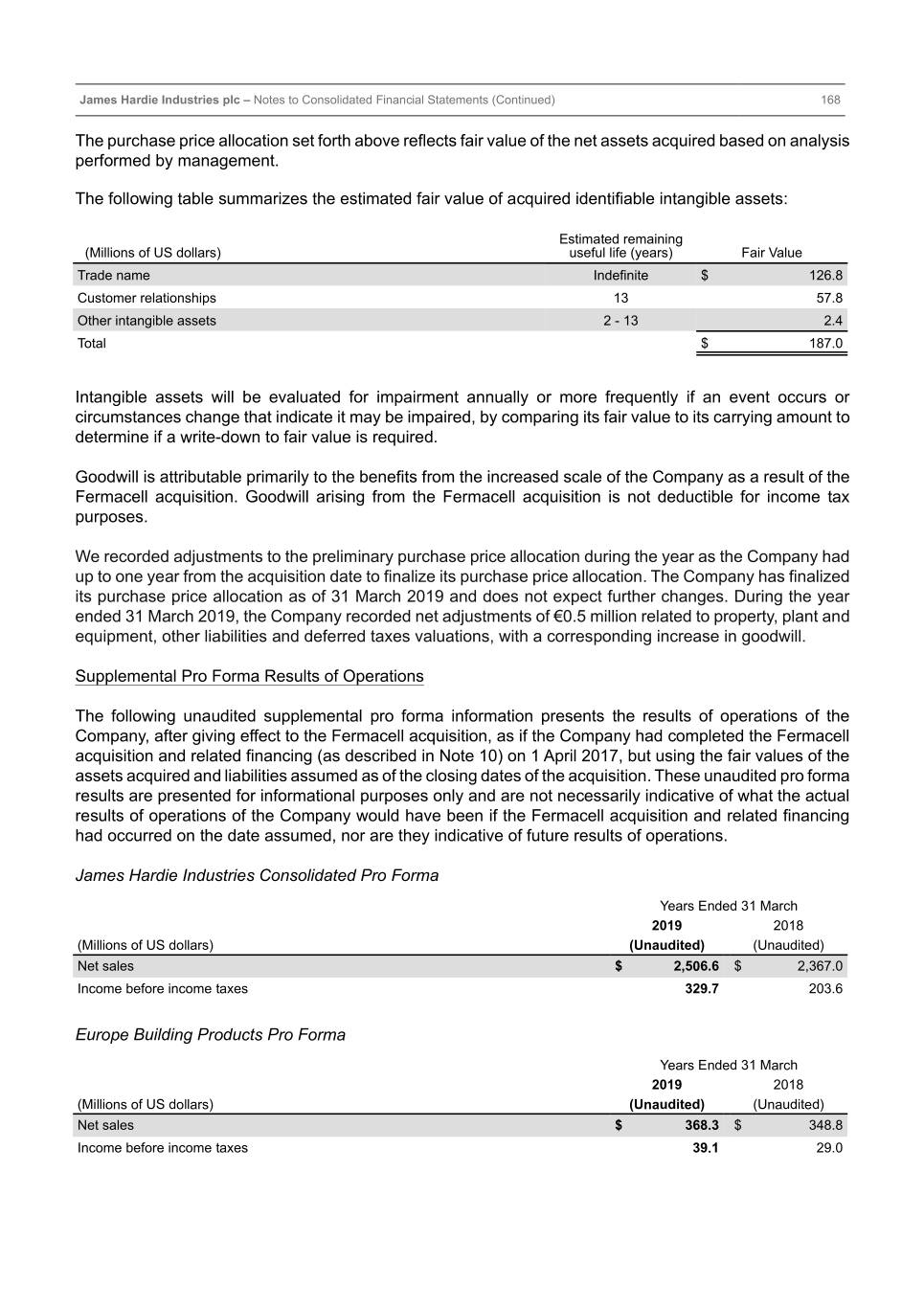
Table of Contents James Hardie Industries plc – Notes to Consolidated Financial Statements (Continued) 168 The purchase price allocation set forth above reflects fair value of the net assets acquired based on analysis performed by management. The following table summarizes the estimated fair value of acquired identifiable intangible assets: Estimated remaining (Millions of US dollars) useful life (years) Fair Value Trade name Indefinite $ 126.8 Customer relationships 13 57.8 Other intangible assets 2 - 13 2.4 Total $ 187.0 Intangible assets will be evaluated for impairment annually or more frequently if an event occurs or circumstances change that indicate it may be impaired, by comparing its fair value to its carrying amount to determine if a write-down to fair value is required. Goodwill is attributable primarily to the benefits from the increased scale of the Company as a result of the Fermacell acquisition. Goodwill arising from the Fermacell acquisition is not deductible for income tax purposes. We recorded adjustments to the preliminary purchase price allocation during the year as the Company had up to one year from the acquisition date to finalize its purchase price allocation. The Company has finalized its purchase price allocation as of 31 March 2019 and does not expect further changes. During the year ended 31 March 2019, the Company recorded net adjustments of €0.5 million related to property, plant and equipment, other liabilities and deferred taxes valuations, with a corresponding increase in goodwill. Supplemental Pro Forma Results of Operations The following unaudited supplemental pro forma information presents the results of operations of the Company, after giving effect to the Fermacell acquisition, as if the Company had completed the Fermacell acquisition and related financing (as described in Note 10) on 1 April 2017, but using the fair values of the assets acquired and liabilities assumed as of the closing dates of the acquisition. These unaudited pro forma results are presented for informational purposes only and are not necessarily indicative of what the actual results of operations of the Company would have been if the Fermacell acquisition and related financing had occurred on the date assumed, nor are they indicative of future results of operations. James Hardie Industries Consolidated Pro Forma Years Ended 31 March 2019 2018 (Millions of US dollars) (Unaudited) (Unaudited) Net sales $ 2,506.6 $ 2,367.0 Income before income taxes 329.7 203.6 Europe Building Products Pro Forma Years Ended 31 March 2019 2018 (Millions of US dollars) (Unaudited) (Unaudited) Net sales $ 368.3 $ 348.8 Income before income taxes 39.1 29.0
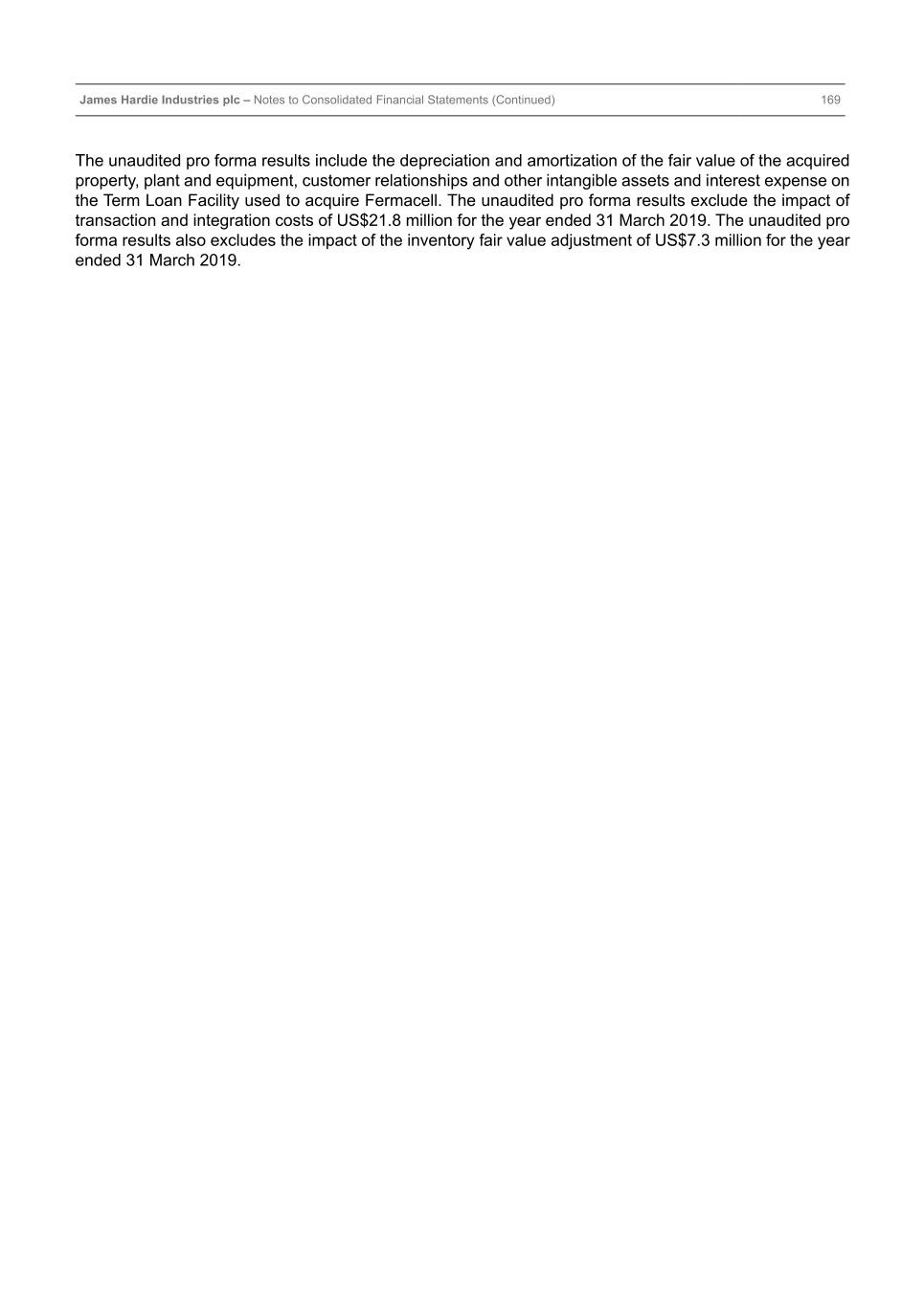
Table of Contents James Hardie Industries plc – Notes to Consolidated Financial Statements (Continued) 169 The unaudited pro forma results include the depreciation and amortization of the fair value of the acquired property, plant and equipment, customer relationships and other intangible assets and interest expense on the Term Loan Facility used to acquire Fermacell. The unaudited pro forma results exclude the impact of transaction and integration costs of US$21.8 million for the year ended 31 March 2019. The unaudited pro forma results also excludes the impact of the inventory fair value adjustment of US$7.3 million for the year ended 31 March 2019.
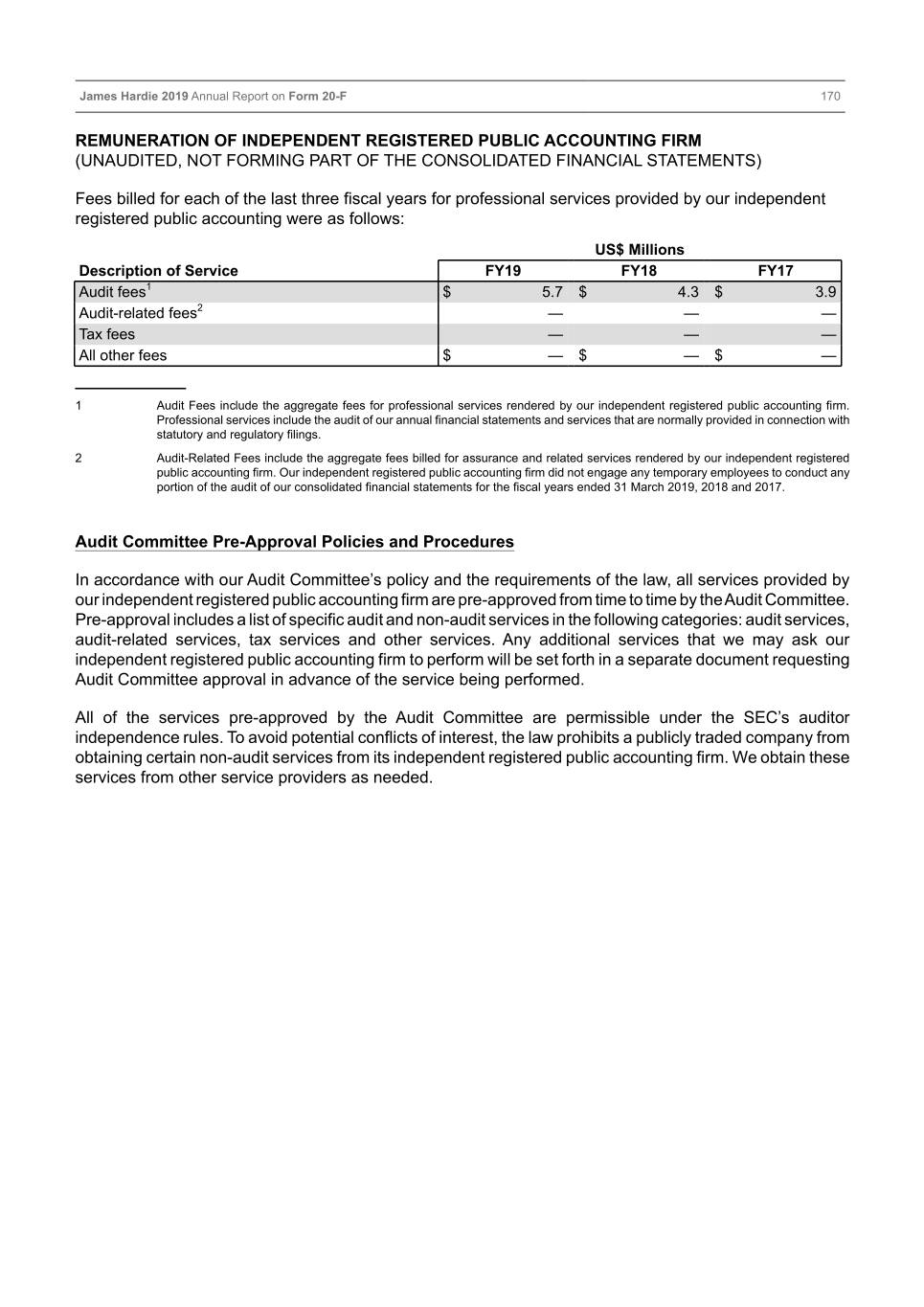
Table of Contents James Hardie 2019 Annual Report on Form 20-F 170 REMUNERATION OF INDEPENDENT REGISTERED PUBLIC ACCOUNTING FIRM (UNAUDITED, NOT FORMING PART OF THE CONSOLIDATED FINANCIAL STATEMENTS) Fees billed for each of the last three fiscal years for professional services provided by our independent registered public accounting were as follows: US$ Millions Description of Service FY19 FY18 FY17 Audit fees1 $ 5.7 $ 4.3 $ 3.9 Audit-related fees2 — — — Tax fees — — — All other fees $ —$ —$ — ____________ 1 Audit Fees include the aggregate fees for professional services rendered by our independent registered public accounting firm. Professional services include the audit of our annual financial statements and services that are normally provided in connection with statutory and regulatory filings. 2 Audit-Related Fees include the aggregate fees billed for assurance and related services rendered by our independent registered public accounting firm. Our independent registered public accounting firm did not engage any temporary employees to conduct any portion of the audit of our consolidated financial statements for the fiscal years ended 31 March 2019, 2018 and 2017. Audit Committee Pre-Approval Policies and Procedures In accordance with our Audit Committee’s policy and the requirements of the law, all services provided by our independent registered public accounting firm are pre-approved from time to time by the Audit Committee. Pre-approval includes a list of specific audit and non-audit services in the following categories: audit services, audit-related services, tax services and other services. Any additional services that we may ask our independent registered public accounting firm to perform will be set forth in a separate document requesting Audit Committee approval in advance of the service being performed. All of the services pre-approved by the Audit Committee are permissible under the SEC’s auditor independence rules. To avoid potential conflicts of interest, the law prohibits a publicly traded company from obtaining certain non-audit services from its independent registered public accounting firm. We obtain these services from other service providers as needed.
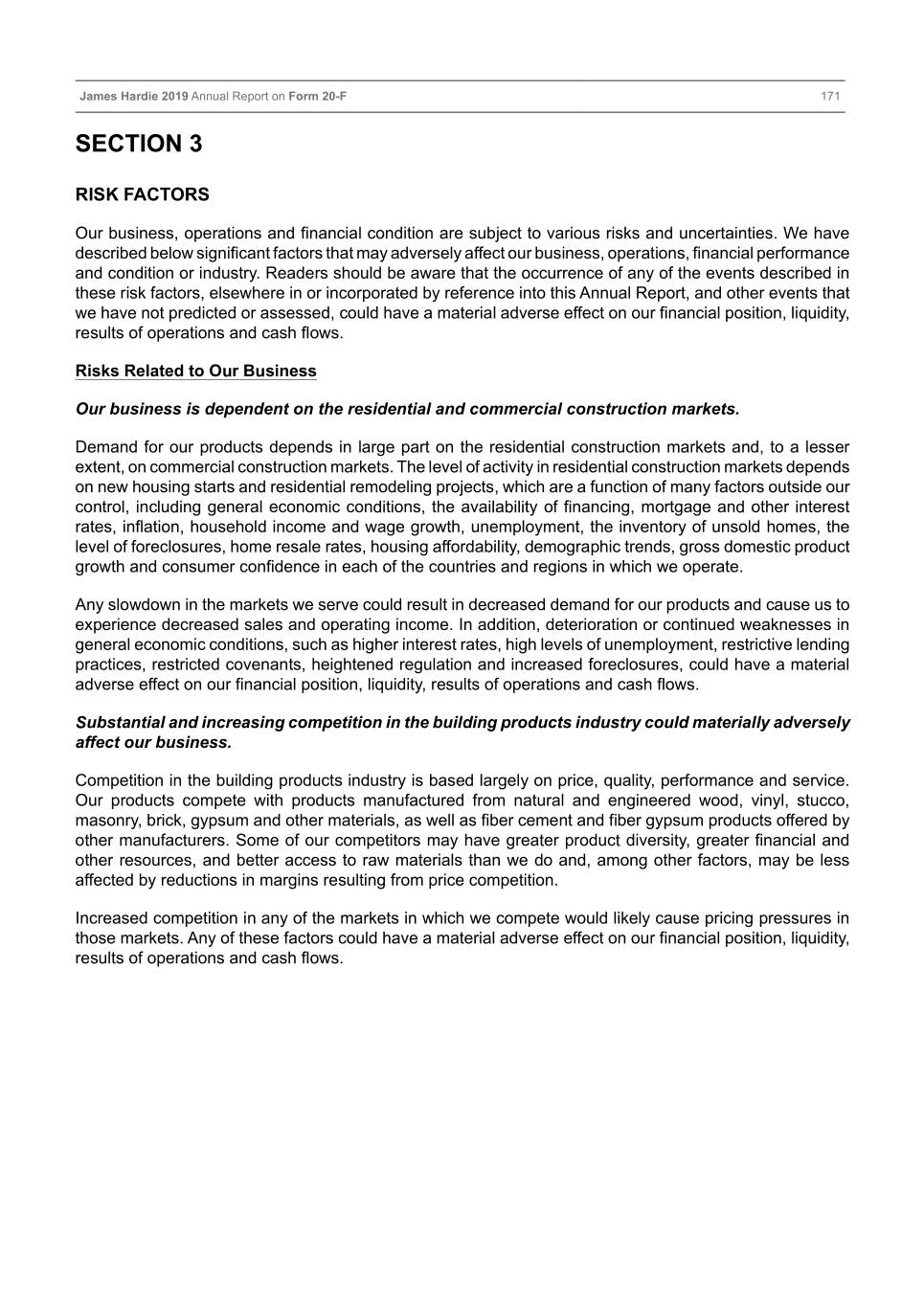
Table of Contents James Hardie 2019 Annual Report on Form 20-F 171 SECTION 3 RISK FACTORS Our business, operations and financial condition are subject to various risks and uncertainties. We have described below significant factors that may adversely affect our business, operations, financial performance and condition or industry. Readers should be aware that the occurrence of any of the events described in these risk factors, elsewhere in or incorporated by reference into this Annual Report, and other events that we have not predicted or assessed, could have a material adverse effect on our financial position, liquidity, results of operations and cash flows. Risks Related to Our Business Our business is dependent on the residential and commercial construction markets. Demand for our products depends in large part on the residential construction markets and, to a lesser extent, on commercial construction markets. The level of activity in residential construction markets depends on new housing starts and residential remodeling projects, which are a function of many factors outside our control, including general economic conditions, the availability of financing, mortgage and other interest rates, inflation, household income and wage growth, unemployment, the inventory of unsold homes, the level of foreclosures, home resale rates, housing affordability, demographic trends, gross domestic product growth and consumer confidence in each of the countries and regions in which we operate. Any slowdown in the markets we serve could result in decreased demand for our products and cause us to experience decreased sales and operating income. In addition, deterioration or continued weaknesses in general economic conditions, such as higher interest rates, high levels of unemployment, restrictive lending practices, restricted covenants, heightened regulation and increased foreclosures, could have a material adverse effect on our financial position, liquidity, results of operations and cash flows. Substantial and increasing competition in the building products industry could materially adversely affect our business. Competition in the building products industry is based largely on price, quality, performance and service. Our products compete with products manufactured from natural and engineered wood, vinyl, stucco, masonry, brick, gypsum and other materials, as well as fiber cement and fiber gypsum products offered by other manufacturers. Some of our competitors may have greater product diversity, greater financial and other resources, and better access to raw materials than we do and, among other factors, may be less affected by reductions in margins resulting from price competition. Increased competition in any of the markets in which we compete would likely cause pricing pressures in those markets. Any of these factors could have a material adverse effect on our financial position, liquidity, results of operations and cash flows.
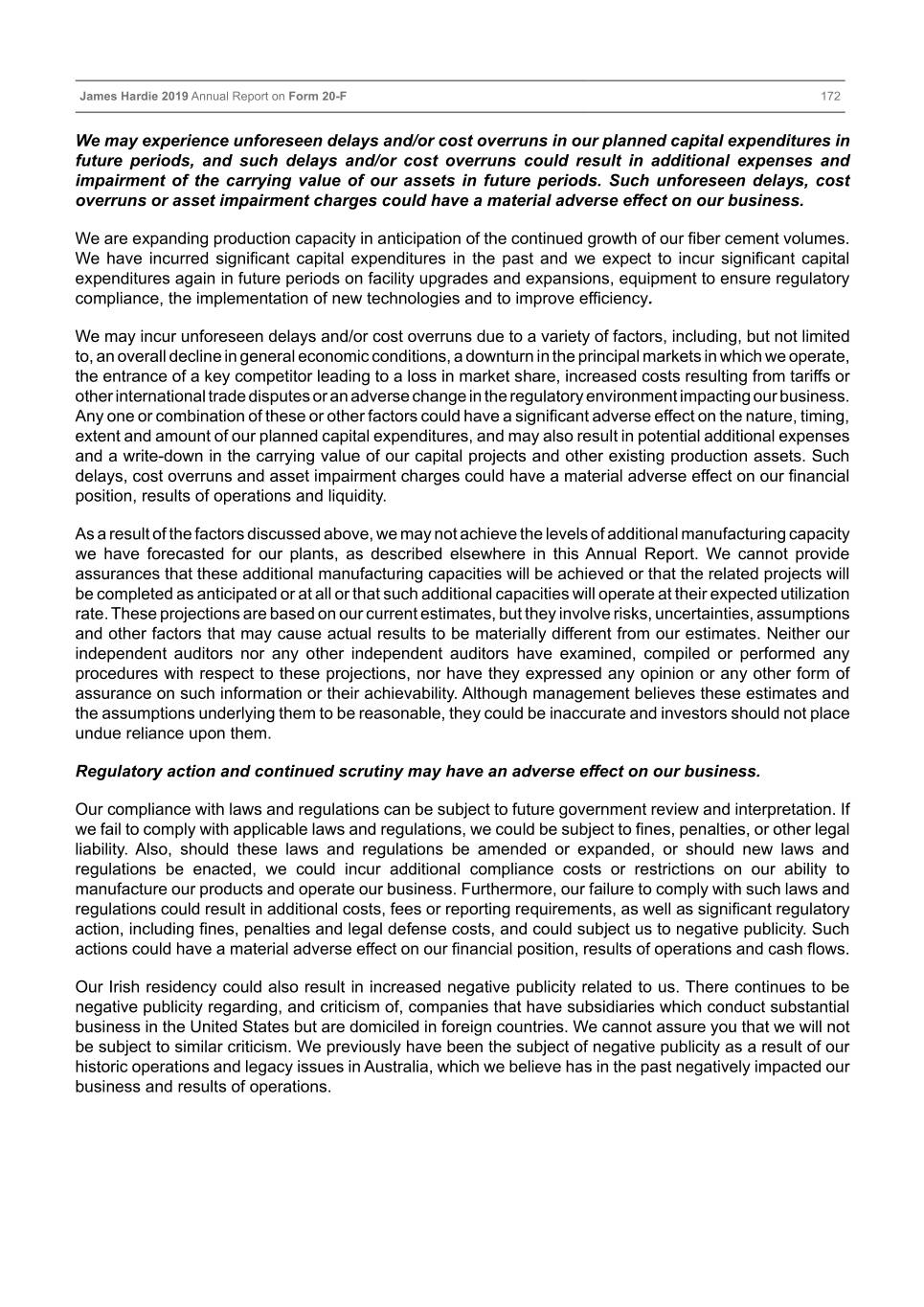
Table of Contents James Hardie 2019 Annual Report on Form 20-F 172 We may experience unforeseen delays and/or cost overruns in our planned capital expenditures in future periods, and such delays and/or cost overruns could result in additional expenses and impairment of the carrying value of our assets in future periods. Such unforeseen delays, cost overruns or asset impairment charges could have a material adverse effect on our business. We are expanding production capacity in anticipation of the continued growth of our fiber cement volumes. We have incurred significant capital expenditures in the past and we expect to incur significant capital expenditures again in future periods on facility upgrades and expansions, equipment to ensure regulatory compliance, the implementation of new technologies and to improve efficiency. We may incur unforeseen delays and/or cost overruns due to a variety of factors, including, but not limited to, an overall decline in general economic conditions, a downturn in the principal markets in which we operate, the entrance of a key competitor leading to a loss in market share, increased costs resulting from tariffs or other international trade disputes or an adverse change in the regulatory environment impacting our business. Any one or combination of these or other factors could have a significant adverse effect on the nature, timing, extent and amount of our planned capital expenditures, and may also result in potential additional expenses and a write-down in the carrying value of our capital projects and other existing production assets. Such delays, cost overruns and asset impairment charges could have a material adverse effect on our financial position, results of operations and liquidity. As a result of the factors discussed above, we may not achieve the levels of additional manufacturing capacity we have forecasted for our plants, as described elsewhere in this Annual Report. We cannot provide assurances that these additional manufacturing capacities will be achieved or that the related projects will be completed as anticipated or at all or that such additional capacities will operate at their expected utilization rate. These projections are based on our current estimates, but they involve risks, uncertainties, assumptions and other factors that may cause actual results to be materially different from our estimates. Neither our independent auditors nor any other independent auditors have examined, compiled or performed any procedures with respect to these projections, nor have they expressed any opinion or any other form of assurance on such information or their achievability. Although management believes these estimates and the assumptions underlying them to be reasonable, they could be inaccurate and investors should not place undue reliance upon them. Regulatory action and continued scrutiny may have an adverse effect on our business. Our compliance with laws and regulations can be subject to future government review and interpretation. If we fail to comply with applicable laws and regulations, we could be subject to fines, penalties, or other legal liability. Also, should these laws and regulations be amended or expanded, or should new laws and regulations be enacted, we could incur additional compliance costs or restrictions on our ability to manufacture our products and operate our business. Furthermore, our failure to comply with such laws and regulations could result in additional costs, fees or reporting requirements, as well as significant regulatory action, including fines, penalties and legal defense costs, and could subject us to negative publicity. Such actions could have a material adverse effect on our financial position, results of operations and cash flows. Our Irish residency could also result in increased negative publicity related to us. There continues to be negative publicity regarding, and criticism of, companies that have subsidiaries which conduct substantial business in the United States but are domiciled in foreign countries. We cannot assure you that we will not be subject to similar criticism. We previously have been the subject of negative publicity as a result of our historic operations and legacy issues in Australia, which we believe has in the past negatively impacted our business and results of operations.
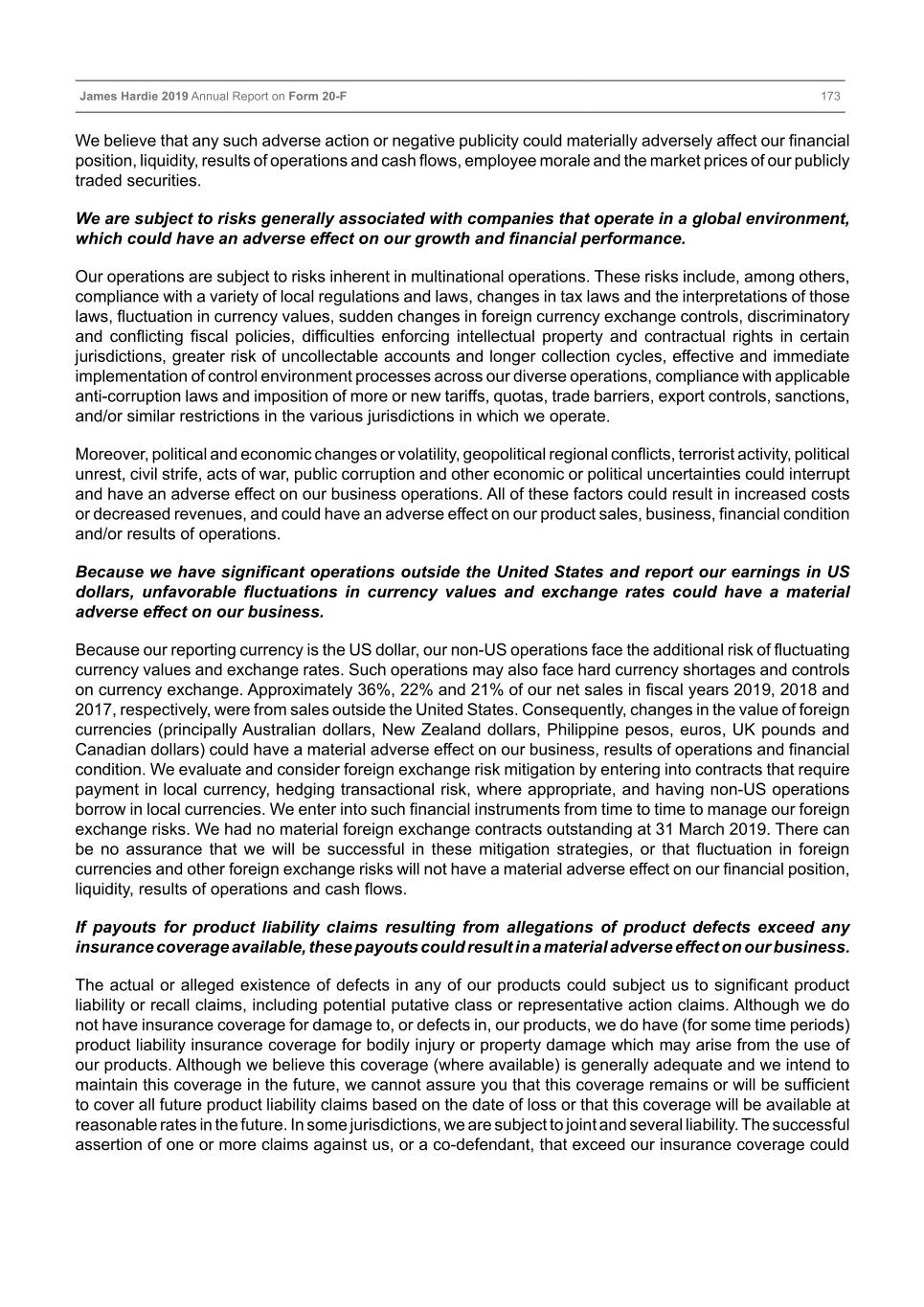
Table of Contents James Hardie 2019 Annual Report on Form 20-F 173 We believe that any such adverse action or negative publicity could materially adversely affect our financial position, liquidity, results of operations and cash flows, employee morale and the market prices of our publicly traded securities. We are subject to risks generally associated with companies that operate in a global environment, which could have an adverse effect on our growth and financial performance. Our operations are subject to risks inherent in multinational operations. These risks include, among others, compliance with a variety of local regulations and laws, changes in tax laws and the interpretations of those laws, fluctuation in currency values, sudden changes in foreign currency exchange controls, discriminatory and conflicting fiscal policies, difficulties enforcing intellectual property and contractual rights in certain jurisdictions, greater risk of uncollectable accounts and longer collection cycles, effective and immediate implementation of control environment processes across our diverse operations, compliance with applicable anti-corruption laws and imposition of more or new tariffs, quotas, trade barriers, export controls, sanctions, and/or similar restrictions in the various jurisdictions in which we operate. Moreover, political and economic changes or volatility, geopolitical regional conflicts, terrorist activity, political unrest, civil strife, acts of war, public corruption and other economic or political uncertainties could interrupt and have an adverse effect on our business operations. All of these factors could result in increased costs or decreased revenues, and could have an adverse effect on our product sales, business, financial condition and/or results of operations. Because we have significant operations outside the United States and report our earnings in US dollars, unfavorable fluctuations in currency values and exchange rates could have a material adverse effect on our business. Because our reporting currency is the US dollar, our non-US operations face the additional risk of fluctuating currency values and exchange rates. Such operations may also face hard currency shortages and controls on currency exchange. Approximately 36%, 22% and 21% of our net sales in fiscal years 2019, 2018 and 2017, respectively, were from sales outside the United States. Consequently, changes in the value of foreign currencies (principally Australian dollars, New Zealand dollars, Philippine pesos, euros, UK pounds and Canadian dollars) could have a material adverse effect on our business, results of operations and financial condition. We evaluate and consider foreign exchange risk mitigation by entering into contracts that require payment in local currency, hedging transactional risk, where appropriate, and having non-US operations borrow in local currencies. We enter into such financial instruments from time to time to manage our foreign exchange risks. We had no material foreign exchange contracts outstanding at 31 March 2019. There can be no assurance that we will be successful in these mitigation strategies, or that fluctuation in foreign currencies and other foreign exchange risks will not have a material adverse effect on our financial position, liquidity, results of operations and cash flows. If payouts for product liability claims resulting from allegations of product defects exceed any insurance coverage available, these payouts could result in a material adverse effect on our business. The actual or alleged existence of defects in any of our products could subject us to significant product liability or recall claims, including potential putative class or representative action claims. Although we do not have insurance coverage for damage to, or defects in, our products, we do have (for some time periods) product liability insurance coverage for bodily injury or property damage which may arise from the use of our products. Although we believe this coverage (where available) is generally adequate and we intend to maintain this coverage in the future, we cannot assure you that this coverage remains or will be sufficient to cover all future product liability claims based on the date of loss or that this coverage will be available at reasonable rates in the future. In some jurisdictions, we are subject to joint and several liability. The successful assertion of one or more claims against us, or a co-defendant, that exceed our insurance coverage could
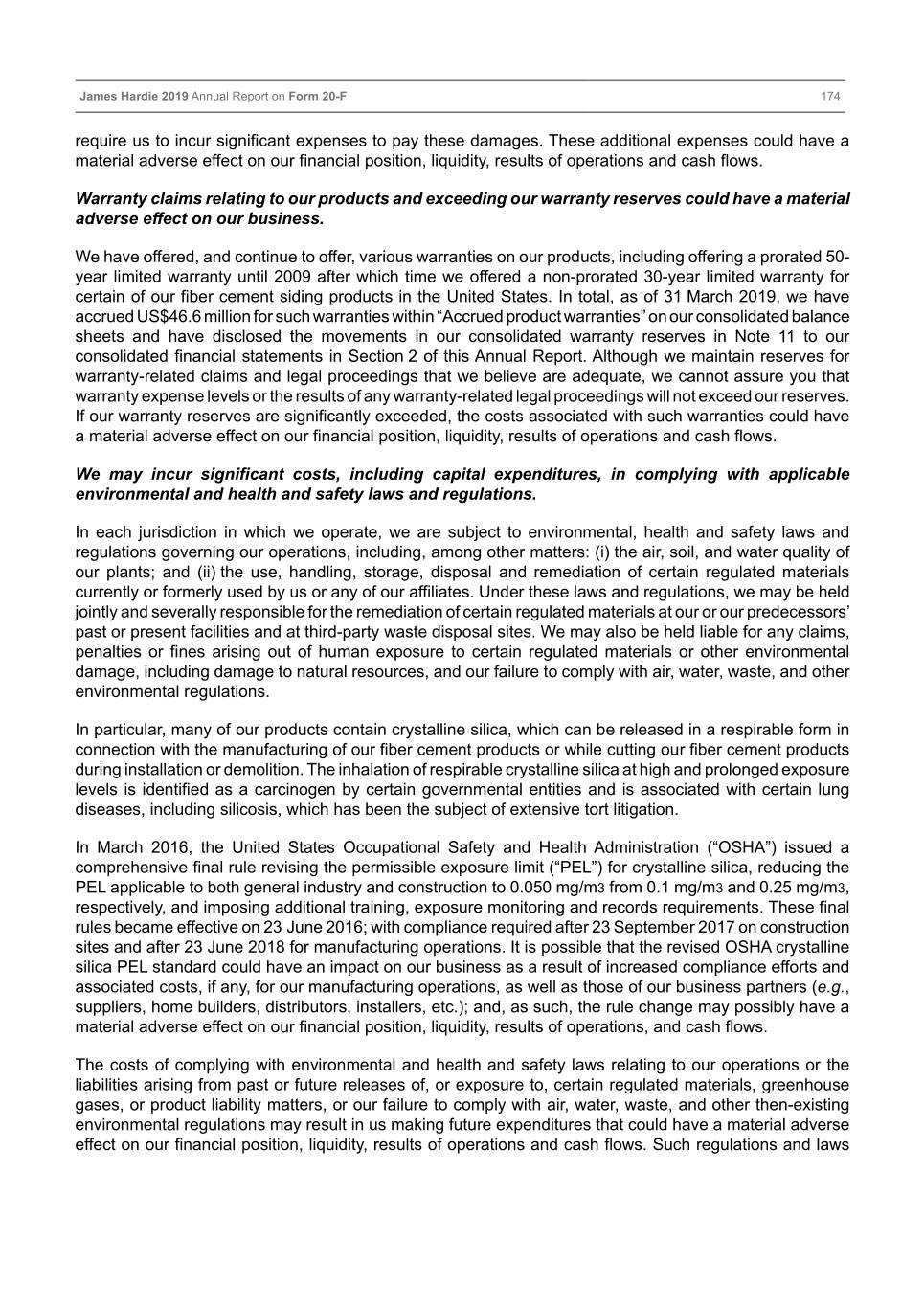
Table of Contents James Hardie 2019 Annual Report on Form 20-F 174 require us to incur significant expenses to pay these damages. These additional expenses could have a material adverse effect on our financial position, liquidity, results of operations and cash flows. Warranty claims relating to our products and exceeding our warranty reserves could have a material adverse effect on our business. We have offered, and continue to offer, various warranties on our products, including offering a prorated 50- year limited warranty until 2009 after which time we offered a non-prorated 30-year limited warranty for certain of our fiber cement siding products in the United States. In total, as of 31 March 2019, we have accrued US$46.6 million for such warranties within “Accrued product warranties” on our consolidated balance sheets and have disclosed the movements in our consolidated warranty reserves in Note 11 to our consolidated financial statements in Section 2 of this Annual Report. Although we maintain reserves for warranty-related claims and legal proceedings that we believe are adequate, we cannot assure you that warranty expense levels or the results of any warranty-related legal proceedings will not exceed our reserves. If our warranty reserves are significantly exceeded, the costs associated with such warranties could have a material adverse effect on our financial position, liquidity, results of operations and cash flows. We may incur significant costs, including capital expenditures, in complying with applicable environmental and health and safety laws and regulations. In each jurisdiction in which we operate, we are subject to environmental, health and safety laws and regulations governing our operations, including, among other matters: (i) the air, soil, and water quality of our plants; and (ii) the use, handling, storage, disposal and remediation of certain regulated materials currently or formerly used by us or any of our affiliates. Under these laws and regulations, we may be held jointly and severally responsible for the remediation of certain regulated materials at our or our predecessors’ past or present facilities and at third-party waste disposal sites. We may also be held liable for any claims, penalties or fines arising out of human exposure to certain regulated materials or other environmental damage, including damage to natural resources, and our failure to comply with air, water, waste, and other environmental regulations. In particular, many of our products contain crystalline silica, which can be released in a respirable form in connection with the manufacturing of our fiber cement products or while cutting our fiber cement products during installation or demolition. The inhalation of respirable crystalline silica at high and prolonged exposure levels is identified as a carcinogen by certain governmental entities and is associated with certain lung diseases, including silicosis, which has been the subject of extensive tort litigation. In March 2016, the United States Occupational Safety and Health Administration (“OSHA”) issued a comprehensive final rule revising the permissible exposure limit (“PEL”) for crystalline silica, reducing the PEL applicable to both general industry and construction to 0.050 mg/m3 from 0.1 mg/m3 and 0.25 mg/m3, respectively, and imposing additional training, exposure monitoring and records requirements. These final rules became effective on 23 June 2016; with compliance required after 23 September 2017 on construction sites and after 23 June 2018 for manufacturing operations. It is possible that the revised OSHA crystalline silica PEL standard could have an impact on our business as a result of increased compliance efforts and associated costs, if any, for our manufacturing operations, as well as those of our business partners (e.g., suppliers, home builders, distributors, installers, etc.); and, as such, the rule change may possibly have a material adverse effect on our financial position, liquidity, results of operations, and cash flows. The costs of complying with environmental and health and safety laws relating to our operations or the liabilities arising from past or future releases of, or exposure to, certain regulated materials, greenhouse gases, or product liability matters, or our failure to comply with air, water, waste, and other then-existing environmental regulations may result in us making future expenditures that could have a material adverse effect on our financial position, liquidity, results of operations and cash flows. Such regulations and laws
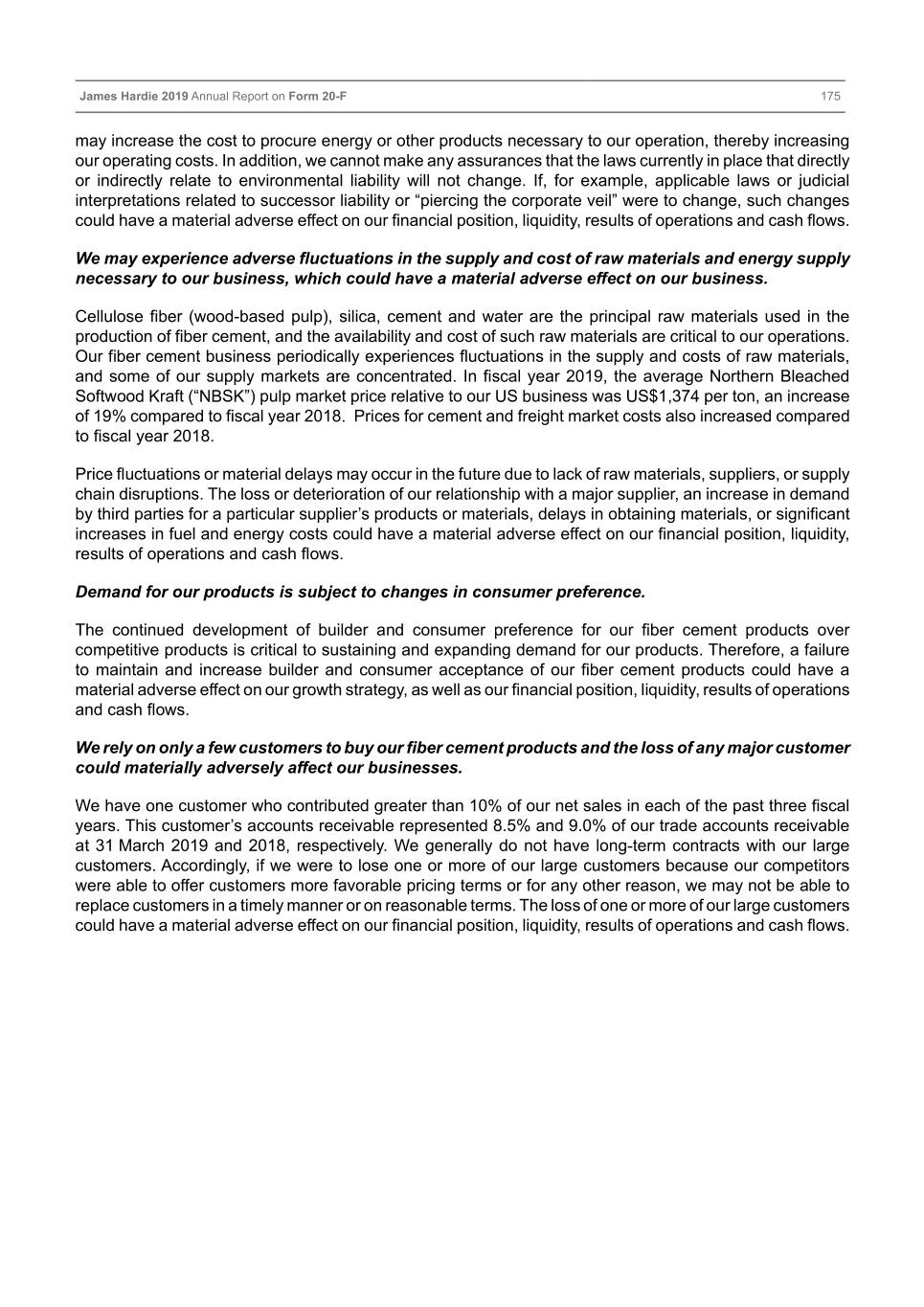
Table of Contents James Hardie 2019 Annual Report on Form 20-F 175 may increase the cost to procure energy or other products necessary to our operation, thereby increasing our operating costs. In addition, we cannot make any assurances that the laws currently in place that directly or indirectly relate to environmental liability will not change. If, for example, applicable laws or judicial interpretations related to successor liability or “piercing the corporate veil” were to change, such changes could have a material adverse effect on our financial position, liquidity, results of operations and cash flows. We may experience adverse fluctuations in the supply and cost of raw materials and energy supply necessary to our business, which could have a material adverse effect on our business. Cellulose fiber (wood-based pulp), silica, cement and water are the principal raw materials used in the production of fiber cement, and the availability and cost of such raw materials are critical to our operations. Our fiber cement business periodically experiences fluctuations in the supply and costs of raw materials, and some of our supply markets are concentrated. In fiscal year 2019, the average Northern Bleached Softwood Kraft (“NBSK”) pulp market price relative to our US business was US$1,374 per ton, an increase of 19% compared to fiscal year 2018. Prices for cement and freight market costs also increased compared to fiscal year 2018. Price fluctuations or material delays may occur in the future due to lack of raw materials, suppliers, or supply chain disruptions. The loss or deterioration of our relationship with a major supplier, an increase in demand by third parties for a particular supplier’s products or materials, delays in obtaining materials, or significant increases in fuel and energy costs could have a material adverse effect on our financial position, liquidity, results of operations and cash flows. Demand for our products is subject to changes in consumer preference. The continued development of builder and consumer preference for our fiber cement products over competitive products is critical to sustaining and expanding demand for our products. Therefore, a failure to maintain and increase builder and consumer acceptance of our fiber cement products could have a material adverse effect on our growth strategy, as well as our financial position, liquidity, results of operations and cash flows. We rely on only a few customers to buy our fiber cement products and the loss of any major customer could materially adversely affect our businesses. We have one customer who contributed greater than 10% of our net sales in each of the past three fiscal years. This customer’s accounts receivable represented 8.5% and 9.0% of our trade accounts receivable at 31 March 2019 and 2018, respectively. We generally do not have long-term contracts with our large customers. Accordingly, if we were to lose one or more of our large customers because our competitors were able to offer customers more favorable pricing terms or for any other reason, we may not be able to replace customers in a timely manner or on reasonable terms. The loss of one or more of our large customers could have a material adverse effect on our financial position, liquidity, results of operations and cash flows.
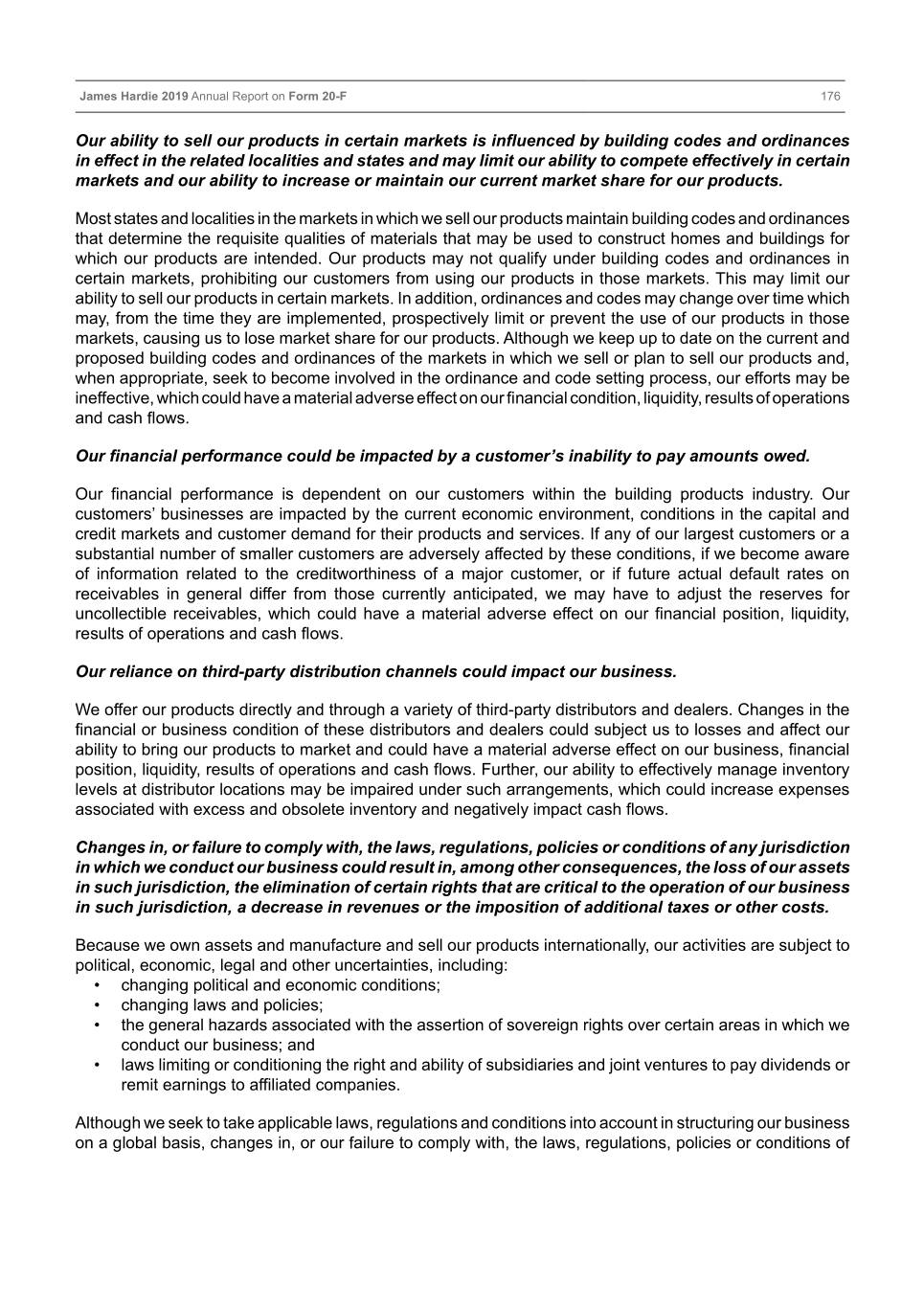
Table of Contents James Hardie 2019 Annual Report on Form 20-F 176 Our ability to sell our products in certain markets is influenced by building codes and ordinances in effect in the related localities and states and may limit our ability to compete effectively in certain markets and our ability to increase or maintain our current market share for our products. Most states and localities in the markets in which we sell our products maintain building codes and ordinances that determine the requisite qualities of materials that may be used to construct homes and buildings for which our products are intended. Our products may not qualify under building codes and ordinances in certain markets, prohibiting our customers from using our products in those markets. This may limit our ability to sell our products in certain markets. In addition, ordinances and codes may change over time which may, from the time they are implemented, prospectively limit or prevent the use of our products in those markets, causing us to lose market share for our products. Although we keep up to date on the current and proposed building codes and ordinances of the markets in which we sell or plan to sell our products and, when appropriate, seek to become involved in the ordinance and code setting process, our efforts may be ineffective, which could have a material adverse effect on our financial condition, liquidity, results of operations and cash flows. Our financial performance could be impacted by a customer’s inability to pay amounts owed. Our financial performance is dependent on our customers within the building products industry. Our customers’ businesses are impacted by the current economic environment, conditions in the capital and credit markets and customer demand for their products and services. If any of our largest customers or a substantial number of smaller customers are adversely affected by these conditions, if we become aware of information related to the creditworthiness of a major customer, or if future actual default rates on receivables in general differ from those currently anticipated, we may have to adjust the reserves for uncollectible receivables, which could have a material adverse effect on our financial position, liquidity, results of operations and cash flows. Our reliance on third-party distribution channels could impact our business. We offer our products directly and through a variety of third-party distributors and dealers. Changes in the financial or business condition of these distributors and dealers could subject us to losses and affect our ability to bring our products to market and could have a material adverse effect on our business, financial position, liquidity, results of operations and cash flows. Further, our ability to effectively manage inventory levels at distributor locations may be impaired under such arrangements, which could increase expenses associated with excess and obsolete inventory and negatively impact cash flows. Changes in, or failure to comply with, the laws, regulations, policies or conditions of any jurisdiction in which we conduct our business could result in, among other consequences, the loss of our assets in such jurisdiction, the elimination of certain rights that are critical to the operation of our business in such jurisdiction, a decrease in revenues or the imposition of additional taxes or other costs. Because we own assets and manufacture and sell our products internationally, our activities are subject to political, economic, legal and other uncertainties, including: • changing political and economic conditions; • changing laws and policies; • the general hazards associated with the assertion of sovereign rights over certain areas in which we conduct our business; and • laws limiting or conditioning the right and ability of subsidiaries and joint ventures to pay dividends or remit earnings to affiliated companies. Although we seek to take applicable laws, regulations and conditions into account in structuring our business on a global basis, changes in, or our failure to comply with, the laws, regulations, policies or conditions of
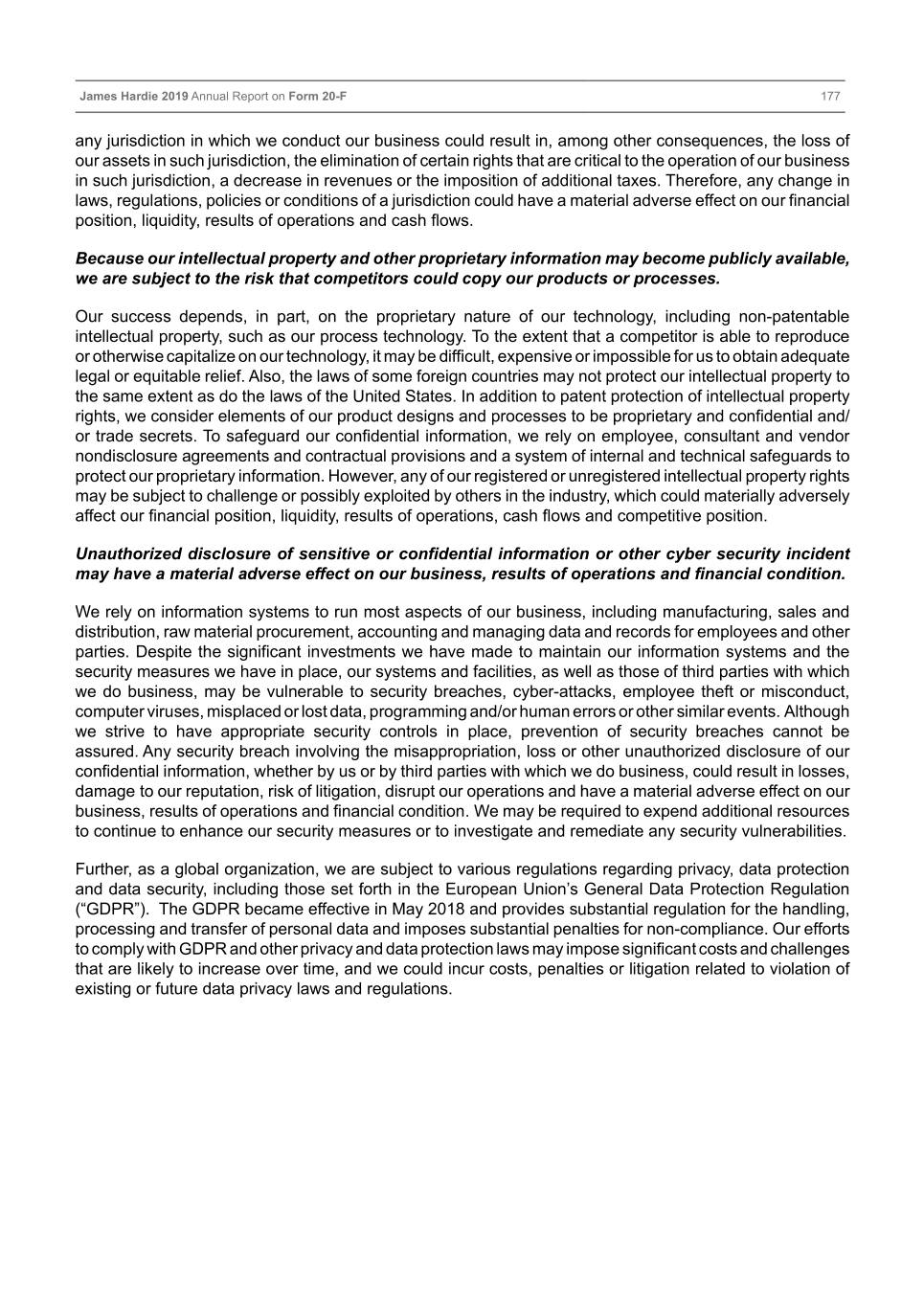
Table of Contents James Hardie 2019 Annual Report on Form 20-F 177 any jurisdiction in which we conduct our business could result in, among other consequences, the loss of our assets in such jurisdiction, the elimination of certain rights that are critical to the operation of our business in such jurisdiction, a decrease in revenues or the imposition of additional taxes. Therefore, any change in laws, regulations, policies or conditions of a jurisdiction could have a material adverse effect on our financial position, liquidity, results of operations and cash flows. Because our intellectual property and other proprietary information may become publicly available, we are subject to the risk that competitors could copy our products or processes. Our success depends, in part, on the proprietary nature of our technology, including non-patentable intellectual property, such as our process technology. To the extent that a competitor is able to reproduce or otherwise capitalize on our technology, it may be difficult, expensive or impossible for us to obtain adequate legal or equitable relief. Also, the laws of some foreign countries may not protect our intellectual property to the same extent as do the laws of the United States. In addition to patent protection of intellectual property rights, we consider elements of our product designs and processes to be proprietary and confidential and/ or trade secrets. To safeguard our confidential information, we rely on employee, consultant and vendor nondisclosure agreements and contractual provisions and a system of internal and technical safeguards to protect our proprietary information. However, any of our registered or unregistered intellectual property rights may be subject to challenge or possibly exploited by others in the industry, which could materially adversely affect our financial position, liquidity, results of operations, cash flows and competitive position. Unauthorized disclosure of sensitive or confidential information or other cyber security incident may have a material adverse effect on our business, results of operations and financial condition. We rely on information systems to run most aspects of our business, including manufacturing, sales and distribution, raw material procurement, accounting and managing data and records for employees and other parties. Despite the significant investments we have made to maintain our information systems and the security measures we have in place, our systems and facilities, as well as those of third parties with which we do business, may be vulnerable to security breaches, cyber-attacks, employee theft or misconduct, computer viruses, misplaced or lost data, programming and/or human errors or other similar events. Although we strive to have appropriate security controls in place, prevention of security breaches cannot be assured. Any security breach involving the misappropriation, loss or other unauthorized disclosure of our confidential information, whether by us or by third parties with which we do business, could result in losses, damage to our reputation, risk of litigation, disrupt our operations and have a material adverse effect on our business, results of operations and financial condition. We may be required to expend additional resources to continue to enhance our security measures or to investigate and remediate any security vulnerabilities. Further, as a global organization, we are subject to various regulations regarding privacy, data protection and data security, including those set forth in the European Union’s General Data Protection Regulation (“GDPR”). The GDPR became effective in May 2018 and provides substantial regulation for the handling, processing and transfer of personal data and imposes substantial penalties for non-compliance. Our efforts to comply with GDPR and other privacy and data protection laws may impose significant costs and challenges that are likely to increase over time, and we could incur costs, penalties or litigation related to violation of existing or future data privacy laws and regulations.
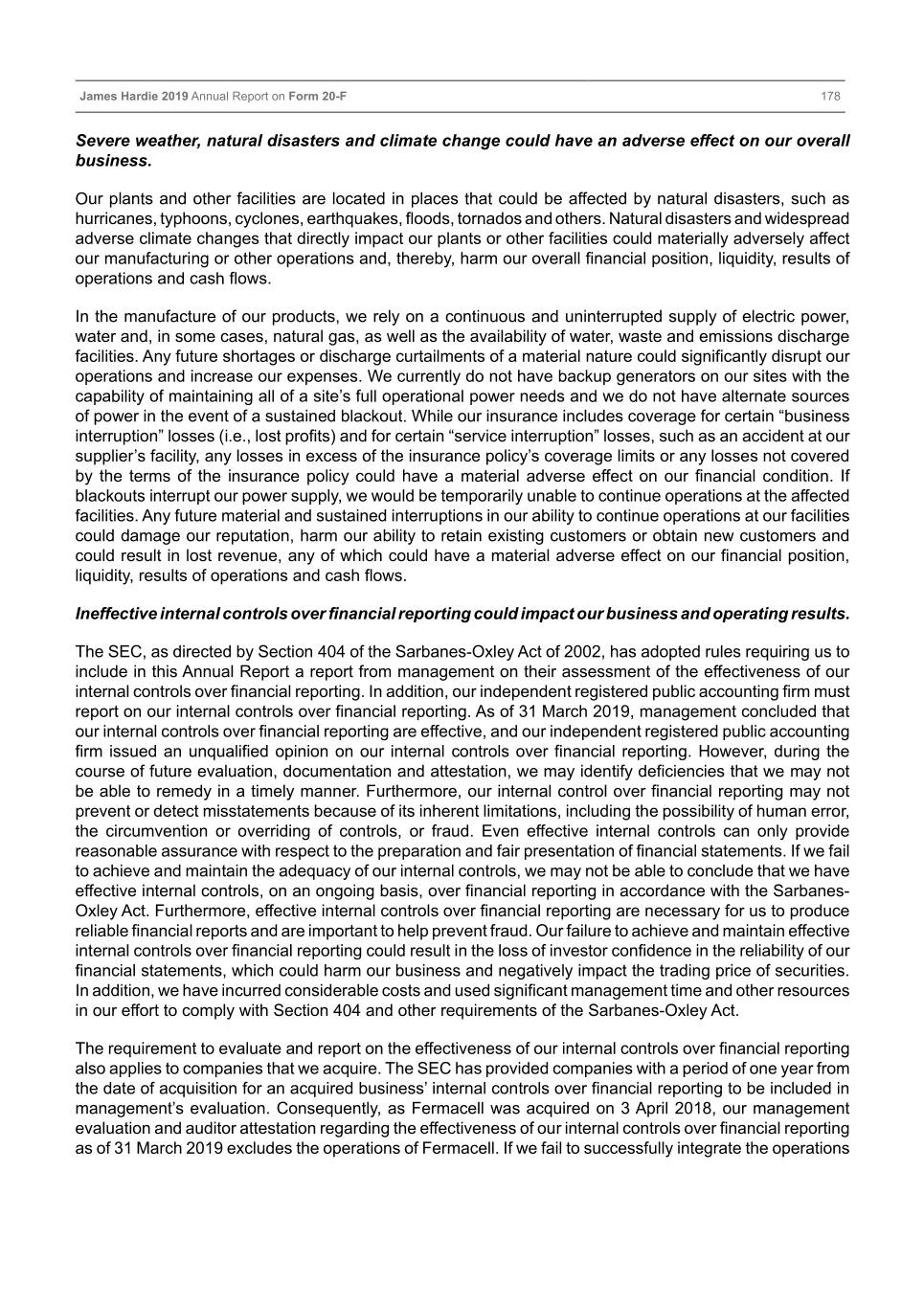
Table of Contents James Hardie 2019 Annual Report on Form 20-F 178 Severe weather, natural disasters and climate change could have an adverse effect on our overall business. Our plants and other facilities are located in places that could be affected by natural disasters, such as hurricanes, typhoons, cyclones, earthquakes, floods, tornados and others. Natural disasters and widespread adverse climate changes that directly impact our plants or other facilities could materially adversely affect our manufacturing or other operations and, thereby, harm our overall financial position, liquidity, results of operations and cash flows. In the manufacture of our products, we rely on a continuous and uninterrupted supply of electric power, water and, in some cases, natural gas, as well as the availability of water, waste and emissions discharge facilities. Any future shortages or discharge curtailments of a material nature could significantly disrupt our operations and increase our expenses. We currently do not have backup generators on our sites with the capability of maintaining all of a site’s full operational power needs and we do not have alternate sources of power in the event of a sustained blackout. While our insurance includes coverage for certain “business interruption” losses (i.e., lost profits) and for certain “service interruption” losses, such as an accident at our supplier’s facility, any losses in excess of the insurance policy’s coverage limits or any losses not covered by the terms of the insurance policy could have a material adverse effect on our financial condition. If blackouts interrupt our power supply, we would be temporarily unable to continue operations at the affected facilities. Any future material and sustained interruptions in our ability to continue operations at our facilities could damage our reputation, harm our ability to retain existing customers or obtain new customers and could result in lost revenue, any of which could have a material adverse effect on our financial position, liquidity, results of operations and cash flows. Ineffective internal controls over financial reporting could impact our business and operating results. The SEC, as directed by Section 404 of the Sarbanes-Oxley Act of 2002, has adopted rules requiring us to include in this Annual Report a report from management on their assessment of the effectiveness of our internal controls over financial reporting. In addition, our independent registered public accounting firm must report on our internal controls over financial reporting. As of 31 March 2019, management concluded that our internal controls over financial reporting are effective, and our independent registered public accounting firm issued an unqualified opinion on our internal controls over financial reporting. However, during the course of future evaluation, documentation and attestation, we may identify deficiencies that we may not be able to remedy in a timely manner. Furthermore, our internal control over financial reporting may not prevent or detect misstatements because of its inherent limitations, including the possibility of human error, the circumvention or overriding of controls, or fraud. Even effective internal controls can only provide reasonable assurance with respect to the preparation and fair presentation of financial statements. If we fail to achieve and maintain the adequacy of our internal controls, we may not be able to conclude that we have effective internal controls, on an ongoing basis, over financial reporting in accordance with the Sarbanes- Oxley Act. Furthermore, effective internal controls over financial reporting are necessary for us to produce reliable financial reports and are important to help prevent fraud. Our failure to achieve and maintain effective internal controls over financial reporting could result in the loss of investor confidence in the reliability of our financial statements, which could harm our business and negatively impact the trading price of securities. In addition, we have incurred considerable costs and used significant management time and other resources in our effort to comply with Section 404 and other requirements of the Sarbanes-Oxley Act. The requirement to evaluate and report on the effectiveness of our internal controls over financial reporting also applies to companies that we acquire. The SEC has provided companies with a period of one year from the date of acquisition for an acquired business’ internal controls over financial reporting to be included in management’s evaluation. Consequently, as Fermacell was acquired on 3 April 2018, our management evaluation and auditor attestation regarding the effectiveness of our internal controls over financial reporting as of 31 March 2019 excludes the operations of Fermacell. If we fail to successfully integrate the operations
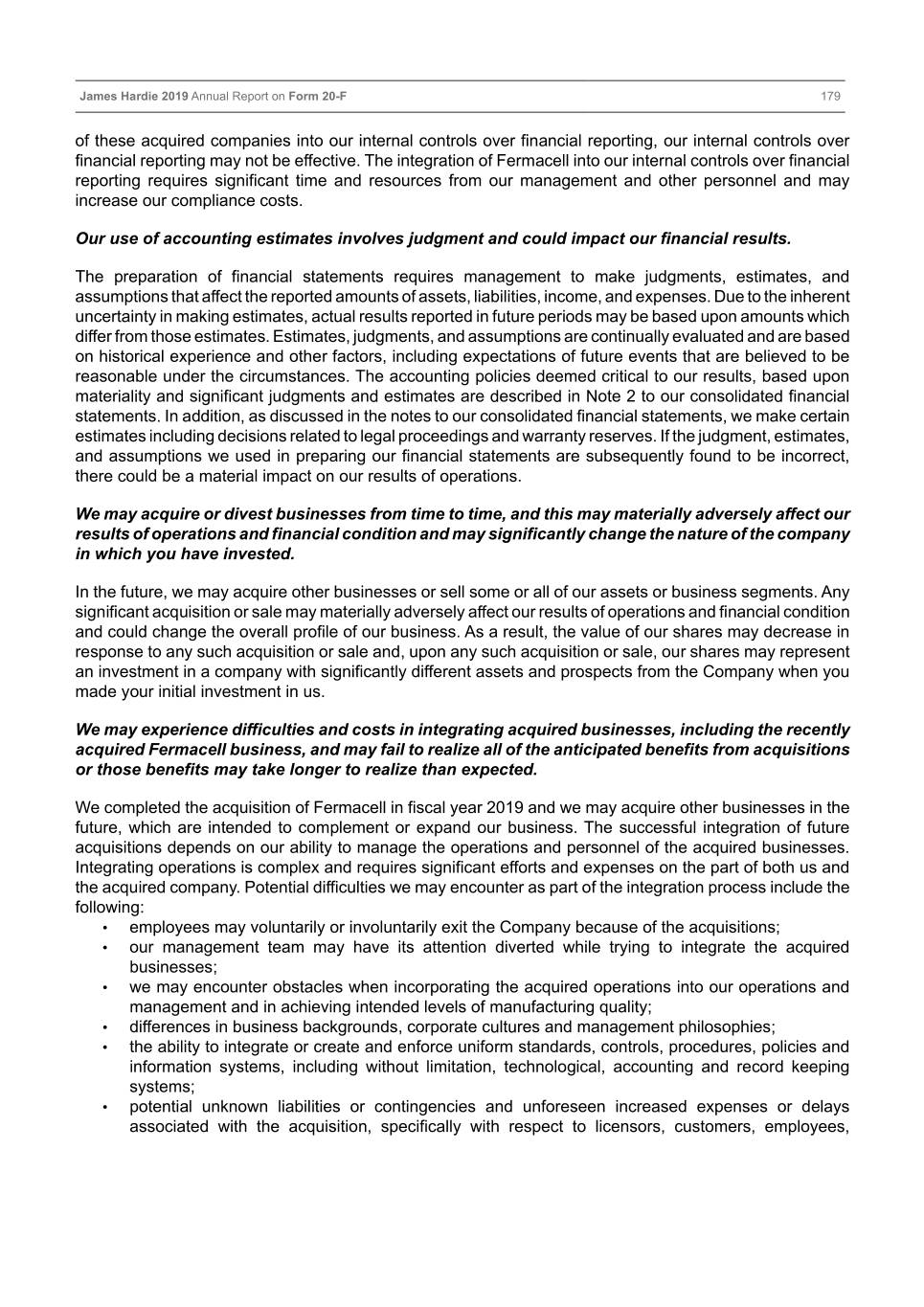
Table of Contents James Hardie 2019 Annual Report on Form 20-F 179 of these acquired companies into our internal controls over financial reporting, our internal controls over financial reporting may not be effective. The integration of Fermacell into our internal controls over financial reporting requires significant time and resources from our management and other personnel and may increase our compliance costs. Our use of accounting estimates involves judgment and could impact our financial results. The preparation of financial statements requires management to make judgments, estimates, and assumptions that affect the reported amounts of assets, liabilities, income, and expenses. Due to the inherent uncertainty in making estimates, actual results reported in future periods may be based upon amounts which differ from those estimates. Estimates, judgments, and assumptions are continually evaluated and are based on historical experience and other factors, including expectations of future events that are believed to be reasonable under the circumstances. The accounting policies deemed critical to our results, based upon materiality and significant judgments and estimates are described in Note 2 to our consolidated financial statements. In addition, as discussed in the notes to our consolidated financial statements, we make certain estimates including decisions related to legal proceedings and warranty reserves. If the judgment, estimates, and assumptions we used in preparing our financial statements are subsequently found to be incorrect, there could be a material impact on our results of operations. We may acquire or divest businesses from time to time, and this may materially adversely affect our results of operations and financial condition and may significantly change the nature of the company in which you have invested. In the future, we may acquire other businesses or sell some or all of our assets or business segments. Any significant acquisition or sale may materially adversely affect our results of operations and financial condition and could change the overall profile of our business. As a result, the value of our shares may decrease in response to any such acquisition or sale and, upon any such acquisition or sale, our shares may represent an investment in a company with significantly different assets and prospects from the Company when you made your initial investment in us. We may experience difficulties and costs in integrating acquired businesses, including the recently acquired Fermacell business, and may fail to realize all of the anticipated benefits from acquisitions or those benefits may take longer to realize than expected. We completed the acquisition of Fermacell in fiscal year 2019 and we may acquire other businesses in the future, which are intended to complement or expand our business. The successful integration of future acquisitions depends on our ability to manage the operations and personnel of the acquired businesses. Integrating operations is complex and requires significant efforts and expenses on the part of both us and the acquired company. Potential difficulties we may encounter as part of the integration process include the following: • employees may voluntarily or involuntarily exit the Company because of the acquisitions; • our management team may have its attention diverted while trying to integrate the acquired businesses; • we may encounter obstacles when incorporating the acquired operations into our operations and management and in achieving intended levels of manufacturing quality; • differences in business backgrounds, corporate cultures and management philosophies; • the ability to integrate or create and enforce uniform standards, controls, procedures, policies and information systems, including without limitation, technological, accounting and record keeping systems; • potential unknown liabilities or contingencies and unforeseen increased expenses or delays associated with the acquisition, specifically with respect to licensors, customers, employees,

Table of Contents James Hardie 2019 Annual Report on Form 20-F 180 suppliers, government authorities or other parties, including without limitation, exposure to liabilities with respect to environmental and sanctions laws; • the recording of goodwill and intangible assets that will be subject to impairment testing on a regular basis and potential periodic impairment charges; • we may discover previously undetected operational or other issues; and • the acquired operations may not otherwise perform as expected or provide expected results. On 3 April 2018, we entered into a transition services agreement with Xella International S.A. ("Xella") pursuant to which Xella and its affiliates agreed to provide certain services in connection with the Fermacell business for an interim period following consummation of the acquisition. Any failure by Xella and its affiliates to satisfactorily perform their obligations under this agreement could adversely affect our operations or otherwise cause disruption. The transition services agreement is expected to continue no later than 3 April 2020. The integration process may disrupt our business and, if implemented ineffectively, may not result in the realization of the expected benefits of the acquisition. The failure to meet the challenges involved in integrating an acquired business and to realize the anticipated benefits of an acquisition could cause an interruption of, or a loss of momentum in, our activities, result in the incurrence of additional debt and could adversely affect our operating results. In addition, we could also encounter additional transaction-related costs, unforeseen liabilities or other issues. Any of these factors could adversely affect our ability to maintain relationships with customers, suppliers, employees and other constituencies or could adversely affect our business and financial results after the acquisition. The United Kingdom invoking the process to withdraw from the European Union could have a negative effect on global economic conditions, financial markets and our business, which could adversely affect our results of operations. We operate in the European Union, particularly following the Fermacell acquisition. On 29 March 2017, the British Prime Minister delivered a notice to the European Council pursuant to Article 50 of the Treaty of the European Union to initiate the formal process of withdrawal from the European Union (“Brexit”). The Article 50 notice started a two-year period for the United Kingdom to negotiate the terms of its exit from the European Union, although this period has been extended to 31 October 2019. The United Kingdom and the European Union are currently engaged in negotiations to structure their post-Brexit relationship, but significant uncertainty remains about the future relationship between the United Kingdom and the European Union (including Ireland) following Brexit (including during any transitional exit period). Accordingly, there can be no assurance that the United Kingdom’s exit from the European Union will not have an adverse effect on our business, financial condition or results of operations. This development has had, and may continue to have, a material adverse effect on global economic conditions and the stability of global financial markets, and could significantly reduce global market liquidity and restrict the ability of key market participants to operate in certain financial markets. Asset valuations, currency exchange rates, and credit ratings may be especially subject to increased market volatility. Lack of clarity about future laws and regulations as the United Kingdom determines which European Union laws to replace or replicate upon withdrawal could depress economic activity and restrict our access to capital in the United Kingdom. If the United Kingdom and the European Union are unable to negotiate acceptable withdrawal terms, barrier-free access between the United Kingdom and other European Union member states could be diminished or eliminated. This may impact our ability to freely move staff and equipment, and it may impact the cost associated with cross-border business, for example, by the re-introduction of import duties. Any of these factors could have a material adverse effect on our business, financial condition, and results of operations.
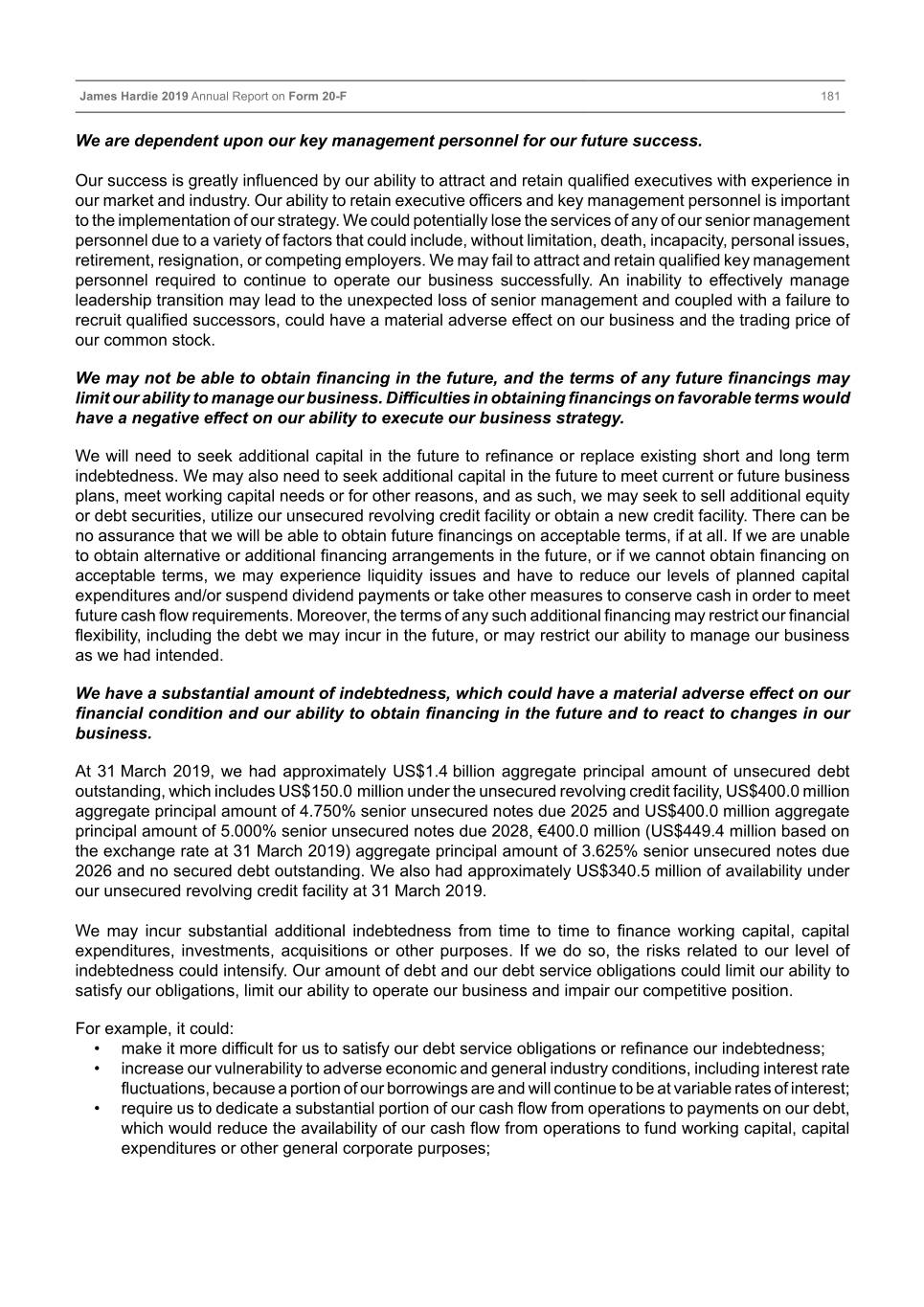
Table of Contents James Hardie 2019 Annual Report on Form 20-F 181 We are dependent upon our key management personnel for our future success. Our success is greatly influenced by our ability to attract and retain qualified executives with experience in our market and industry. Our ability to retain executive officers and key management personnel is important to the implementation of our strategy. We could potentially lose the services of any of our senior management personnel due to a variety of factors that could include, without limitation, death, incapacity, personal issues, retirement, resignation, or competing employers. We may fail to attract and retain qualified key management personnel required to continue to operate our business successfully. An inability to effectively manage leadership transition may lead to the unexpected loss of senior management and coupled with a failure to recruit qualified successors, could have a material adverse effect on our business and the trading price of our common stock. We may not be able to obtain financing in the future, and the terms of any future financings may limit our ability to manage our business. Difficulties in obtaining financings on favorable terms would have a negative effect on our ability to execute our business strategy. We will need to seek additional capital in the future to refinance or replace existing short and long term indebtedness. We may also need to seek additional capital in the future to meet current or future business plans, meet working capital needs or for other reasons, and as such, we may seek to sell additional equity or debt securities, utilize our unsecured revolving credit facility or obtain a new credit facility. There can be no assurance that we will be able to obtain future financings on acceptable terms, if at all. If we are unable to obtain alternative or additional financing arrangements in the future, or if we cannot obtain financing on acceptable terms, we may experience liquidity issues and have to reduce our levels of planned capital expenditures and/or suspend dividend payments or take other measures to conserve cash in order to meet future cash flow requirements. Moreover, the terms of any such additional financing may restrict our financial flexibility, including the debt we may incur in the future, or may restrict our ability to manage our business as we had intended. We have a substantial amount of indebtedness, which could have a material adverse effect on our financial condition and our ability to obtain financing in the future and to react to changes in our business. At 31 March 2019, we had approximately US$1.4 billion aggregate principal amount of unsecured debt outstanding, which includes US$150.0 million under the unsecured revolving credit facility, US$400.0 million aggregate principal amount of 4.750% senior unsecured notes due 2025 and US$400.0 million aggregate principal amount of 5.000% senior unsecured notes due 2028, €400.0 million (US$449.4 million based on the exchange rate at 31 March 2019) aggregate principal amount of 3.625% senior unsecured notes due 2026 and no secured debt outstanding. We also had approximately US$340.5 million of availability under our unsecured revolving credit facility at 31 March 2019. We may incur substantial additional indebtedness from time to time to finance working capital, capital expenditures, investments, acquisitions or other purposes. If we do so, the risks related to our level of indebtedness could intensify. Our amount of debt and our debt service obligations could limit our ability to satisfy our obligations, limit our ability to operate our business and impair our competitive position. For example, it could: • make it more difficult for us to satisfy our debt service obligations or refinance our indebtedness; • increase our vulnerability to adverse economic and general industry conditions, including interest rate fluctuations, because a portion of our borrowings are and will continue to be at variable rates of interest; • require us to dedicate a substantial portion of our cash flow from operations to payments on our debt, which would reduce the availability of our cash flow from operations to fund working capital, capital expenditures or other general corporate purposes;
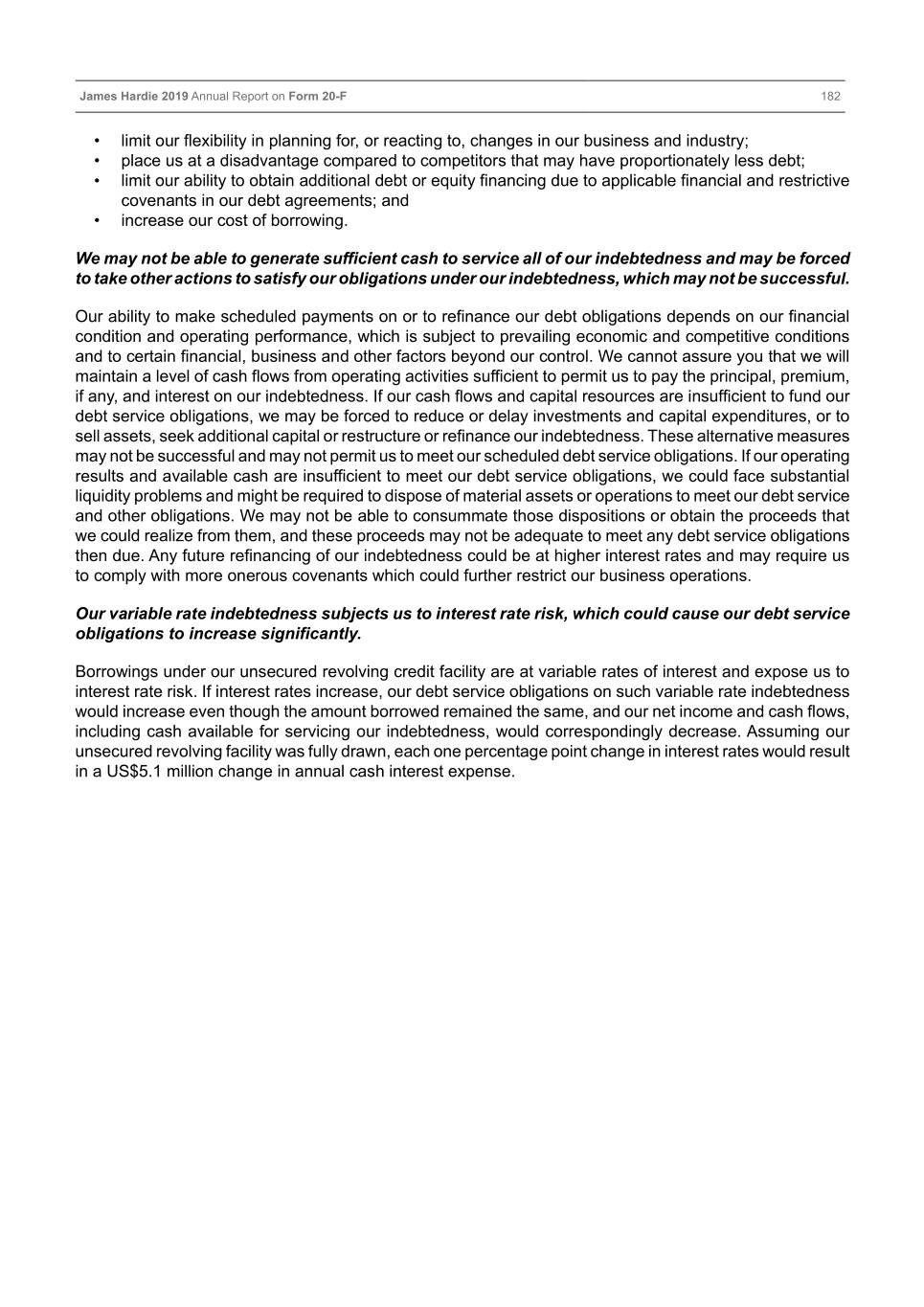
Table of Contents James Hardie 2019 Annual Report on Form 20-F 182 • limit our flexibility in planning for, or reacting to, changes in our business and industry; • place us at a disadvantage compared to competitors that may have proportionately less debt; • limit our ability to obtain additional debt or equity financing due to applicable financial and restrictive covenants in our debt agreements; and • increase our cost of borrowing. We may not be able to generate sufficient cash to service all of our indebtedness and may be forced to take other actions to satisfy our obligations under our indebtedness, which may not be successful. Our ability to make scheduled payments on or to refinance our debt obligations depends on our financial condition and operating performance, which is subject to prevailing economic and competitive conditions and to certain financial, business and other factors beyond our control. We cannot assure you that we will maintain a level of cash flows from operating activities sufficient to permit us to pay the principal, premium, if any, and interest on our indebtedness. If our cash flows and capital resources are insufficient to fund our debt service obligations, we may be forced to reduce or delay investments and capital expenditures, or to sell assets, seek additional capital or restructure or refinance our indebtedness. These alternative measures may not be successful and may not permit us to meet our scheduled debt service obligations. If our operating results and available cash are insufficient to meet our debt service obligations, we could face substantial liquidity problems and might be required to dispose of material assets or operations to meet our debt service and other obligations. We may not be able to consummate those dispositions or obtain the proceeds that we could realize from them, and these proceeds may not be adequate to meet any debt service obligations then due. Any future refinancing of our indebtedness could be at higher interest rates and may require us to comply with more onerous covenants which could further restrict our business operations. Our variable rate indebtedness subjects us to interest rate risk, which could cause our debt service obligations to increase significantly. Borrowings under our unsecured revolving credit facility are at variable rates of interest and expose us to interest rate risk. If interest rates increase, our debt service obligations on such variable rate indebtedness would increase even though the amount borrowed remained the same, and our net income and cash flows, including cash available for servicing our indebtedness, would correspondingly decrease. Assuming our unsecured revolving facility was fully drawn, each one percentage point change in interest rates would result in a US$5.1 million change in annual cash interest expense.

Table of Contents James Hardie 2019 Annual Report on Form 20-F 183 Asbestos-Related Risks Our wholly-owned Australian Performing Subsidiary is required to make payments to a special purpose fund that provides compensation for Australian asbestos-related personal injury and death claims for which certain Former James Hardie Companies are found liable. These payments may affect our ability to grow the Company. On 21 November 2006, JHI plc, AICF, the NSW Government and the Performing Subsidiary entered into the AFFA to provide long-term funding to AICF, a special purpose fund that provides compensation for Australian asbestos-related personal injury and death claims for which the Former James Hardie Companies are found liable. We have recorded a gross asbestos liability of US$1,089.6 million in our consolidated financial statements as of 31 March 2019, based on the AFFA governing our anticipated future payments to AICF. The net unfunded AFFA liability, net of tax, was US$608.4 million at 31 March 2019. The initial funding was made to AICF in February 2007 and annual payments are to be made each July, subject to the terms of the AFFA. The amounts of these annual payments are dependent on several factors, including our free cash flow (as defined in the AFFA), actuarial estimations, actual claims paid, operating expenses of AICF and the Annual Cash Flow Cap set forth in the AFFA. From the time AICF was established in February 2007 through the date of this Annual Report, we have contributed A$1,193.4 million to the fund. Our obligation to make future payments to AICF continues to be linked under the terms of the AFFA to our long-term financial success, especially our ability to generate net operating cash flow. As a result of our obligation to make payments under the AFFA, our funds available for capital expenditures (either with respect to our existing business or new business opportunities), repayments of debt, payments of dividends or other distributions have been, and will be, reduced by the amounts paid to AICF, and consequently, our financial position, liquidity and cash flows have been, and will be, reduced or materially adversely affected. Our obligation to make these payments could also affect or restrict our ability to access equity or debt capital markets. Potential escalation in proven claims made against, and associated costs of AICF could require an extension of the period of time that the Company is obliged to make annual funding payments of up to 35% of its free cash flow, as defined in the AFFA, beyond the currently anticipated expiration date of that obligation, which may cause us to have to increase our asbestos liability in the future. The amount of our asbestos liability is based, in part, on actuarially determined, anticipated (estimated) future annual funding payments to be made to AICF on an undiscounted and uninflated basis. Future annual payments to AICF are based on updated actuarial assessments that are to be performed as of 31 March of each year to determine expected asbestos-related personal injury and death claims to be funded under the AFFA for the financial year in which the payment is made and the next two financial years. Estimates of actuarial liabilities are based on many assumptions, which may not prove to be correct, and which are subject to considerable uncertainty, since the ultimate number and cost of claims are subject to the outcome of events that have not yet occurred, including social, legal and medical developments, as well as future economic conditions. If future proven claims are more numerous, the liabilities arising from them are larger than that currently estimated by AICF’s actuary, KPMGA, or if AICF investments decline in value, it is possible that pursuant to the terms of the AFFA, we will be required to pay to AICF our current annual funding payments of up to 35% of our free cash flow, as defined in the AFFA and on which our asbestos liability is based, for an extended period of time. If this occurs, we may be required to increase our asbestos liability, which would be reflected as a charge in our consolidated statements of operations and comprehensive income at that date. Any such
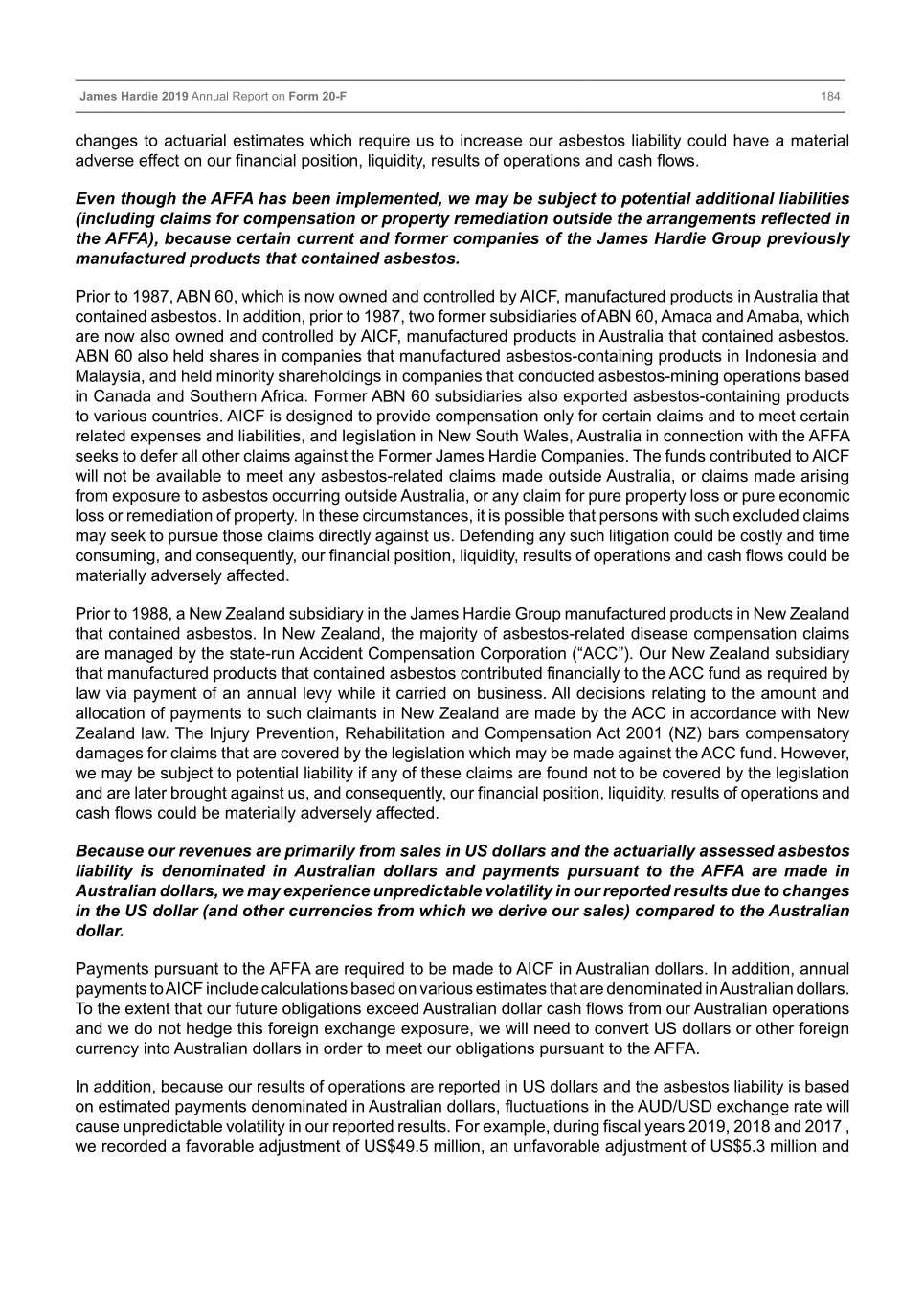
Table of Contents James Hardie 2019 Annual Report on Form 20-F 184 changes to actuarial estimates which require us to increase our asbestos liability could have a material adverse effect on our financial position, liquidity, results of operations and cash flows. Even though the AFFA has been implemented, we may be subject to potential additional liabilities (including claims for compensation or property remediation outside the arrangements reflected in the AFFA), because certain current and former companies of the James Hardie Group previously manufactured products that contained asbestos. Prior to 1987, ABN 60, which is now owned and controlled by AICF, manufactured products in Australia that contained asbestos. In addition, prior to 1987, two former subsidiaries of ABN 60, Amaca and Amaba, which are now also owned and controlled by AICF, manufactured products in Australia that contained asbestos. ABN 60 also held shares in companies that manufactured asbestos-containing products in Indonesia and Malaysia, and held minority shareholdings in companies that conducted asbestos-mining operations based in Canada and Southern Africa. Former ABN 60 subsidiaries also exported asbestos-containing products to various countries. AICF is designed to provide compensation only for certain claims and to meet certain related expenses and liabilities, and legislation in New South Wales, Australia in connection with the AFFA seeks to defer all other claims against the Former James Hardie Companies. The funds contributed to AICF will not be available to meet any asbestos-related claims made outside Australia, or claims made arising from exposure to asbestos occurring outside Australia, or any claim for pure property loss or pure economic loss or remediation of property. In these circumstances, it is possible that persons with such excluded claims may seek to pursue those claims directly against us. Defending any such litigation could be costly and time consuming, and consequently, our financial position, liquidity, results of operations and cash flows could be materially adversely affected. Prior to 1988, a New Zealand subsidiary in the James Hardie Group manufactured products in New Zealand that contained asbestos. In New Zealand, the majority of asbestos-related disease compensation claims are managed by the state-run Accident Compensation Corporation (“ACC”). Our New Zealand subsidiary that manufactured products that contained asbestos contributed financially to the ACC fund as required by law via payment of an annual levy while it carried on business. All decisions relating to the amount and allocation of payments to such claimants in New Zealand are made by the ACC in accordance with New Zealand law. The Injury Prevention, Rehabilitation and Compensation Act 2001 (NZ) bars compensatory damages for claims that are covered by the legislation which may be made against the ACC fund. However, we may be subject to potential liability if any of these claims are found not to be covered by the legislation and are later brought against us, and consequently, our financial position, liquidity, results of operations and cash flows could be materially adversely affected. Because our revenues are primarily from sales in US dollars and the actuarially assessed asbestos liability is denominated in Australian dollars and payments pursuant to the AFFA are made in Australian dollars, we may experience unpredictable volatility in our reported results due to changes in the US dollar (and other currencies from which we derive our sales) compared to the Australian dollar. Payments pursuant to the AFFA are required to be made to AICF in Australian dollars. In addition, annual payments to AICF include calculations based on various estimates that are denominated in Australian dollars. To the extent that our future obligations exceed Australian dollar cash flows from our Australian operations and we do not hedge this foreign exchange exposure, we will need to convert US dollars or other foreign currency into Australian dollars in order to meet our obligations pursuant to the AFFA. In addition, because our results of operations are reported in US dollars and the asbestos liability is based on estimated payments denominated in Australian dollars, fluctuations in the AUD/USD exchange rate will cause unpredictable volatility in our reported results. For example, during fiscal years 2019, 2018 and 2017 , we recorded a favorable adjustment of US$49.5 million, an unfavorable adjustment of US$5.3 million and
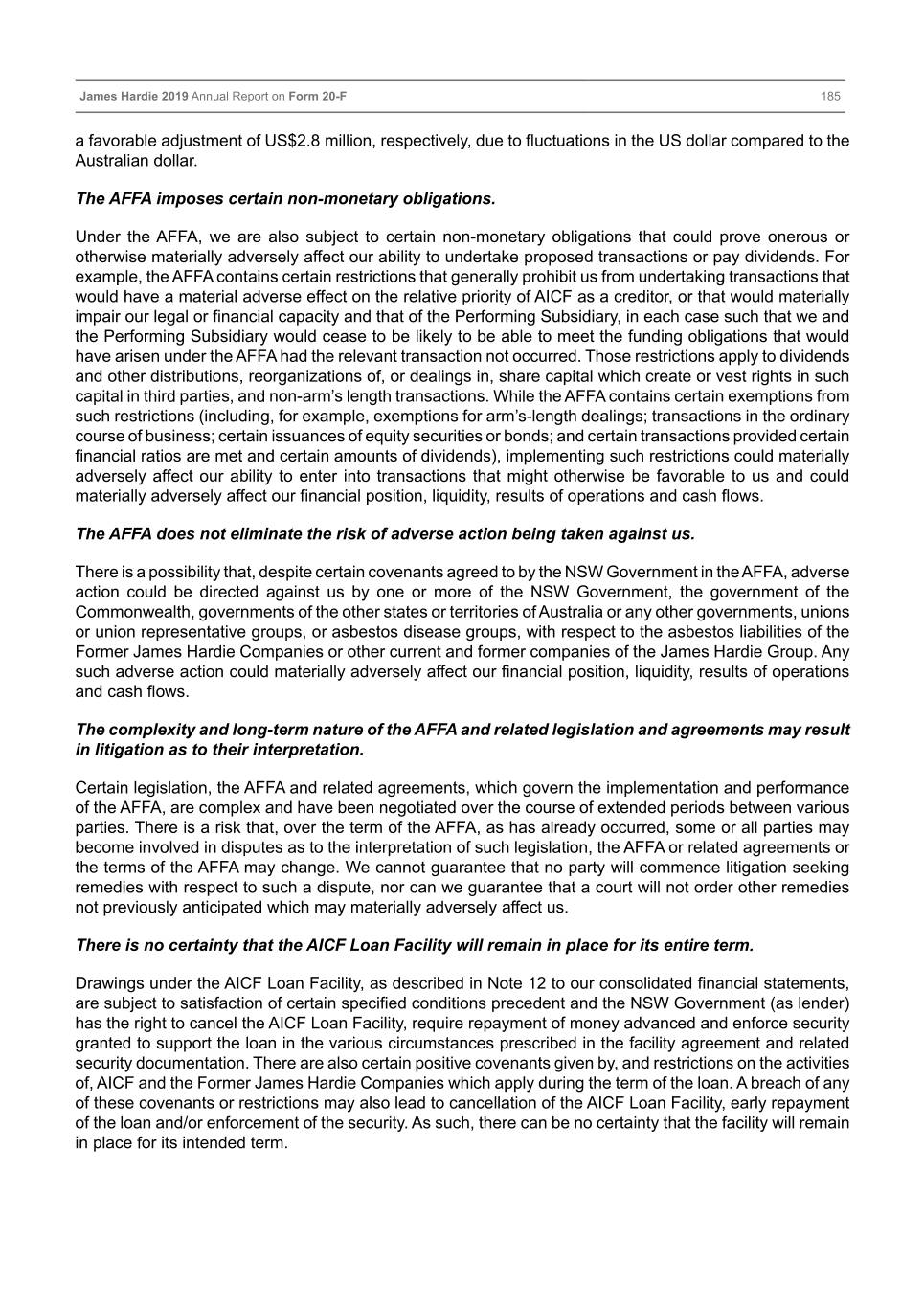
Table of Contents James Hardie 2019 Annual Report on Form 20-F 185 a favorable adjustment of US$2.8 million, respectively, due to fluctuations in the US dollar compared to the Australian dollar. The AFFA imposes certain non-monetary obligations. Under the AFFA, we are also subject to certain non-monetary obligations that could prove onerous or otherwise materially adversely affect our ability to undertake proposed transactions or pay dividends. For example, the AFFA contains certain restrictions that generally prohibit us from undertaking transactions that would have a material adverse effect on the relative priority of AICF as a creditor, or that would materially impair our legal or financial capacity and that of the Performing Subsidiary, in each case such that we and the Performing Subsidiary would cease to be likely to be able to meet the funding obligations that would have arisen under the AFFA had the relevant transaction not occurred. Those restrictions apply to dividends and other distributions, reorganizations of, or dealings in, share capital which create or vest rights in such capital in third parties, and non-arm’s length transactions. While the AFFA contains certain exemptions from such restrictions (including, for example, exemptions for arm’s-length dealings; transactions in the ordinary course of business; certain issuances of equity securities or bonds; and certain transactions provided certain financial ratios are met and certain amounts of dividends), implementing such restrictions could materially adversely affect our ability to enter into transactions that might otherwise be favorable to us and could materially adversely affect our financial position, liquidity, results of operations and cash flows. The AFFA does not eliminate the risk of adverse action being taken against us. There is a possibility that, despite certain covenants agreed to by the NSW Government in the AFFA, adverse action could be directed against us by one or more of the NSW Government, the government of the Commonwealth, governments of the other states or territories of Australia or any other governments, unions or union representative groups, or asbestos disease groups, with respect to the asbestos liabilities of the Former James Hardie Companies or other current and former companies of the James Hardie Group. Any such adverse action could materially adversely affect our financial position, liquidity, results of operations and cash flows. The complexity and long-term nature of the AFFA and related legislation and agreements may result in litigation as to their interpretation. Certain legislation, the AFFA and related agreements, which govern the implementation and performance of the AFFA, are complex and have been negotiated over the course of extended periods between various parties. There is a risk that, over the term of the AFFA, as has already occurred, some or all parties may become involved in disputes as to the interpretation of such legislation, the AFFA or related agreements or the terms of the AFFA may change. We cannot guarantee that no party will commence litigation seeking remedies with respect to such a dispute, nor can we guarantee that a court will not order other remedies not previously anticipated which may materially adversely affect us. There is no certainty that the AICF Loan Facility will remain in place for its entire term. Drawings under the AICF Loan Facility, as described in Note 12 to our consolidated financial statements, are subject to satisfaction of certain specified conditions precedent and the NSW Government (as lender) has the right to cancel the AICF Loan Facility, require repayment of money advanced and enforce security granted to support the loan in the various circumstances prescribed in the facility agreement and related security documentation. There are also certain positive covenants given by, and restrictions on the activities of, AICF and the Former James Hardie Companies which apply during the term of the loan. A breach of any of these covenants or restrictions may also lead to cancellation of the AICF Loan Facility, early repayment of the loan and/or enforcement of the security. As such, there can be no certainty that the facility will remain in place for its intended term.

Table of Contents James Hardie 2019 Annual Report on Form 20-F 186 If the AICF Loan Facility does not remain in place for its intended term, AICF may experience a short-term funding shortfall. A short-term funding shortfall for AICF could subject us to negative publicity. Such negative publicity could materially adversely affect our financial position, liquidity, results of operations and cash flows, as well as employee morale and the market prices of our publicly traded securities. We may have insufficient Australian taxable income to utilize tax deductions. We may not have sufficient Australian taxable income to utilize the tax deductions resulting from the funding payments under the AFFA to AICF. Further, if as a result of making such funding payments we incur tax losses, we may not be able to fully utilize such tax losses in future years of income. Any inability to utilize such deductions or losses could materially adversely affect our financial position, liquidity, results of operations and cash flows. Certain AFFA tax conditions may not be satisfied. Despite Australian Taxation Office (“ATO”) rulings for the expected life of the AFFA, it is possible that new (and adverse) tax legislation could be enacted in the future. It is also possible that the facts and circumstances relevant to operation of the ATO rulings could change over the life of the AFFA. We may elect to terminate the AFFA if certain tax conditions are not satisfied for more than 12 months. However, we do not have a right to terminate the AFFA if, among other things, the tax conditions are not satisfied as a result of the actions of a member of the James Hardie Group. Under certain circumstances, we may still have an obligation to make annual funding payments on an adjusted basis if the tax conditions remain unsatisfied for more than 12 months. If the tax conditions are not satisfied in a manner which does not permit us to terminate the AFFA, our financial position, liquidity, results of operations and cash flows may be materially adversely affected. The extent of this adverse effect will be determined by the nature of the tax condition which is not satisfied. Risks Related to Ireland The rules and regulations applying to us as an Irish plc may change. As an Irish plc, the majority of our board meetings are held in and strategic decisions are made in Ireland. However, there can be no assurance that Irish or another jurisdiction’s law will not become more restrictive or otherwise disadvantageous to us. Irish law contains provisions that could delay or prevent a change of control that may otherwise be beneficial to you. Irish law contains several provisions that could have the effect of delaying or preventing a change of control of our ownership. The Irish Takeover Rules would generally (subject to certain very limited exceptions) require a mandatory cash offer to be made for our entire issued share capital if, because of an acquisition of a relevant interest (including interests held in the form of shares of our common stock, CUFS or ADSs) in such shares, the voting rights of the shares in which a person (including persons acting in concert with that person) holds relevant interests increase: (i) from below 30% to 30% or more; or (ii) from a starting point that is above 30% and below 50%, by more than 0.05% in a 12-month period. However, this prohibition is subject to exceptions, including acquisitions that result from acceptances under a mandatory takeover bid made in compliance with the Irish Takeover Rules. Although the Irish Takeover Rules may help to ensure that no person acquires voting control of us without making an offer to all shareholders, they may also have the effect of delaying or preventing a change of control that may otherwise be beneficial to you. In addition to the operation of the Irish Takeover Rules, we may, from time to time, put in place appropriate retention arrangements to ensure that we retain our key employees during periods of corporate change.
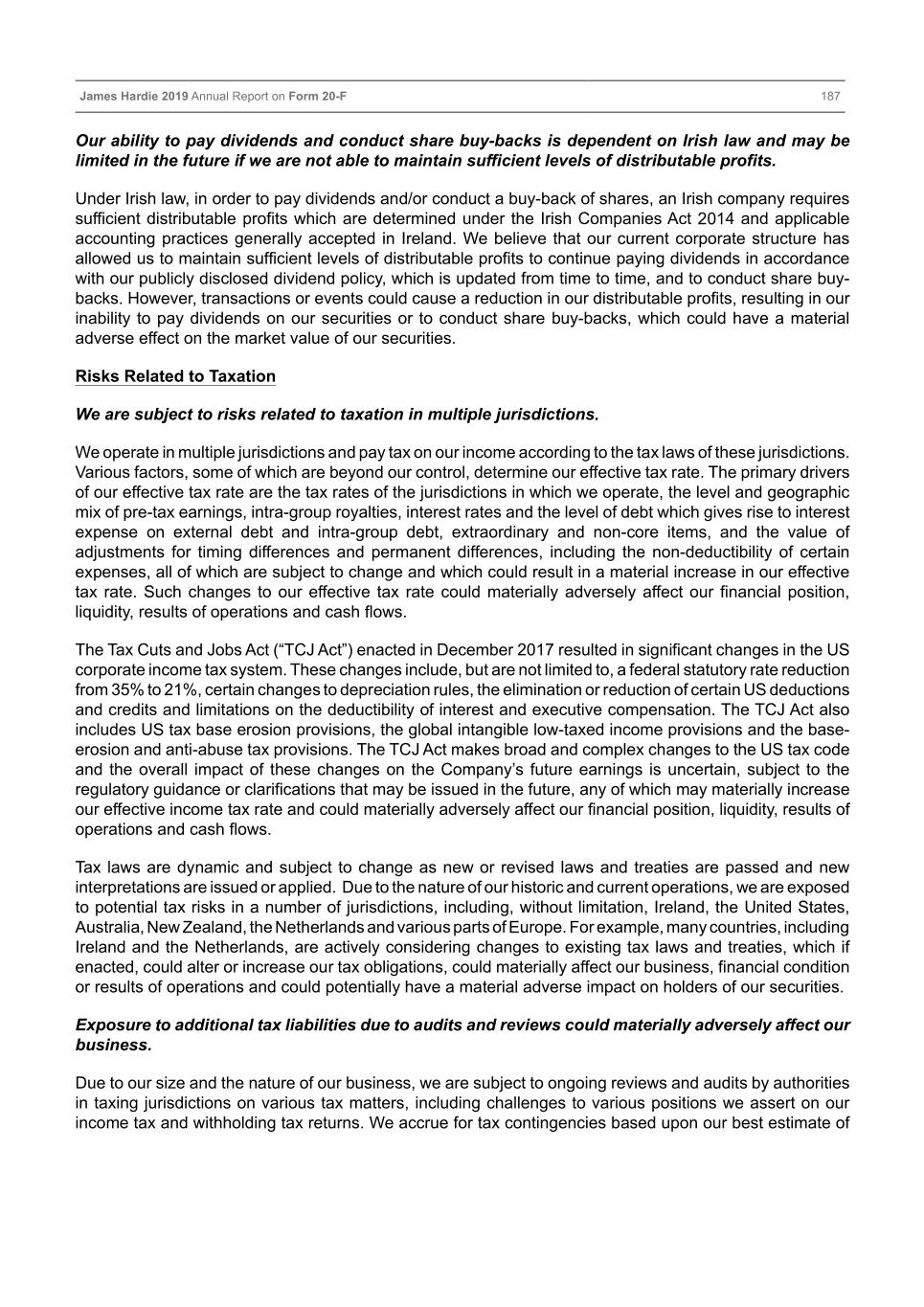
Table of Contents James Hardie 2019 Annual Report on Form 20-F 187 Our ability to pay dividends and conduct share buy-backs is dependent on Irish law and may be limited in the future if we are not able to maintain sufficient levels of distributable profits. Under Irish law, in order to pay dividends and/or conduct a buy-back of shares, an Irish company requires sufficient distributable profits which are determined under the Irish Companies Act 2014 and applicable accounting practices generally accepted in Ireland. We believe that our current corporate structure has allowed us to maintain sufficient levels of distributable profits to continue paying dividends in accordance with our publicly disclosed dividend policy, which is updated from time to time, and to conduct share buy- backs. However, transactions or events could cause a reduction in our distributable profits, resulting in our inability to pay dividends on our securities or to conduct share buy-backs, which could have a material adverse effect on the market value of our securities. Risks Related to Taxation We are subject to risks related to taxation in multiple jurisdictions. We operate in multiple jurisdictions and pay tax on our income according to the tax laws of these jurisdictions. Various factors, some of which are beyond our control, determine our effective tax rate. The primary drivers of our effective tax rate are the tax rates of the jurisdictions in which we operate, the level and geographic mix of pre-tax earnings, intra-group royalties, interest rates and the level of debt which gives rise to interest expense on external debt and intra-group debt, extraordinary and non-core items, and the value of adjustments for timing differences and permanent differences, including the non-deductibility of certain expenses, all of which are subject to change and which could result in a material increase in our effective tax rate. Such changes to our effective tax rate could materially adversely affect our financial position, liquidity, results of operations and cash flows. The Tax Cuts and Jobs Act (“TCJ Act”) enacted in December 2017 resulted in significant changes in the US corporate income tax system. These changes include, but are not limited to, a federal statutory rate reduction from 35% to 21%, certain changes to depreciation rules, the elimination or reduction of certain US deductions and credits and limitations on the deductibility of interest and executive compensation. The TCJ Act also includes US tax base erosion provisions, the global intangible low-taxed income provisions and the base- erosion and anti-abuse tax provisions. The TCJ Act makes broad and complex changes to the US tax code and the overall impact of these changes on the Company’s future earnings is uncertain, subject to the regulatory guidance or clarifications that may be issued in the future, any of which may materially increase our effective income tax rate and could materially adversely affect our financial position, liquidity, results of operations and cash flows. Tax laws are dynamic and subject to change as new or revised laws and treaties are passed and new interpretations are issued or applied. Due to the nature of our historic and current operations, we are exposed to potential tax risks in a number of jurisdictions, including, without limitation, Ireland, the United States, Australia, New Zealand, the Netherlands and various parts of Europe. For example, many countries, including Ireland and the Netherlands, are actively considering changes to existing tax laws and treaties, which if enacted, could alter or increase our tax obligations, could materially affect our business, financial condition or results of operations and could potentially have a material adverse impact on holders of our securities. Exposure to additional tax liabilities due to audits and reviews could materially adversely affect our business. Due to our size and the nature of our business, we are subject to ongoing reviews and audits by authorities in taxing jurisdictions on various tax matters, including challenges to various positions we assert on our income tax and withholding tax returns. We accrue for tax contingencies based upon our best estimate of
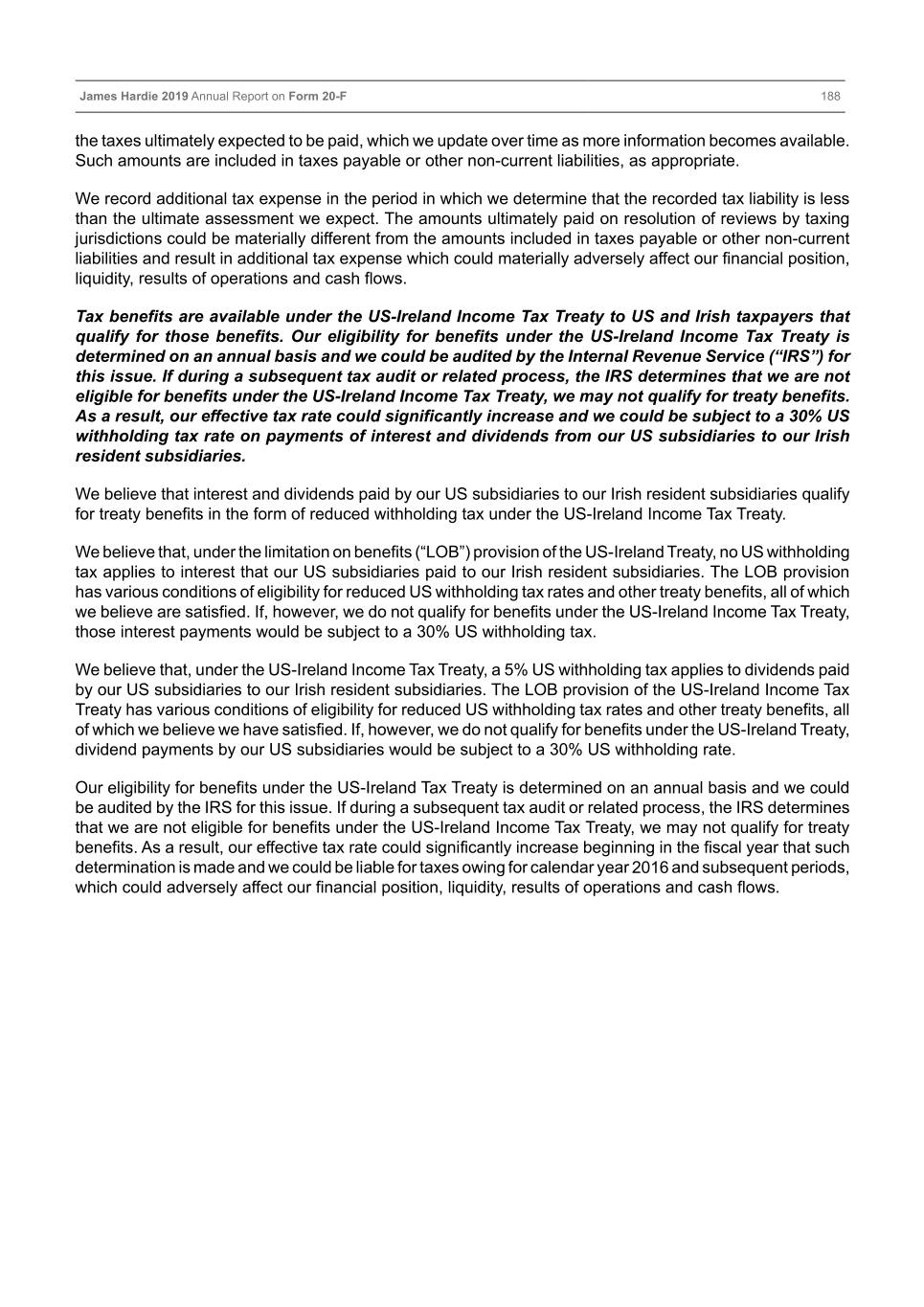
Table of Contents James Hardie 2019 Annual Report on Form 20-F 188 the taxes ultimately expected to be paid, which we update over time as more information becomes available. Such amounts are included in taxes payable or other non-current liabilities, as appropriate. We record additional tax expense in the period in which we determine that the recorded tax liability is less than the ultimate assessment we expect. The amounts ultimately paid on resolution of reviews by taxing jurisdictions could be materially different from the amounts included in taxes payable or other non-current liabilities and result in additional tax expense which could materially adversely affect our financial position, liquidity, results of operations and cash flows. Tax benefits are available under the US-Ireland Income Tax Treaty to US and Irish taxpayers that qualify for those benefits. Our eligibility for benefits under the US-Ireland Income Tax Treaty is determined on an annual basis and we could be audited by the Internal Revenue Service (“IRS”) for this issue. If during a subsequent tax audit or related process, the IRS determines that we are not eligible for benefits under the US-Ireland Income Tax Treaty, we may not qualify for treaty benefits. As a result, our effective tax rate could significantly increase and we could be subject to a 30% US withholding tax rate on payments of interest and dividends from our US subsidiaries to our Irish resident subsidiaries. We believe that interest and dividends paid by our US subsidiaries to our Irish resident subsidiaries qualify for treaty benefits in the form of reduced withholding tax under the US-Ireland Income Tax Treaty. We believe that, under the limitation on benefits (“LOB”) provision of the US-Ireland Treaty, no US withholding tax applies to interest that our US subsidiaries paid to our Irish resident subsidiaries. The LOB provision has various conditions of eligibility for reduced US withholding tax rates and other treaty benefits, all of which we believe are satisfied. If, however, we do not qualify for benefits under the US-Ireland Income Tax Treaty, those interest payments would be subject to a 30% US withholding tax. We believe that, under the US-Ireland Income Tax Treaty, a 5% US withholding tax applies to dividends paid by our US subsidiaries to our Irish resident subsidiaries. The LOB provision of the US-Ireland Income Tax Treaty has various conditions of eligibility for reduced US withholding tax rates and other treaty benefits, all of which we believe we have satisfied. If, however, we do not qualify for benefits under the US-Ireland Treaty, dividend payments by our US subsidiaries would be subject to a 30% US withholding rate. Our eligibility for benefits under the US-Ireland Tax Treaty is determined on an annual basis and we could be audited by the IRS for this issue. If during a subsequent tax audit or related process, the IRS determines that we are not eligible for benefits under the US-Ireland Income Tax Treaty, we may not qualify for treaty benefits. As a result, our effective tax rate could significantly increase beginning in the fiscal year that such determination is made and we could be liable for taxes owing for calendar year 2016 and subsequent periods, which could adversely affect our financial position, liquidity, results of operations and cash flows.
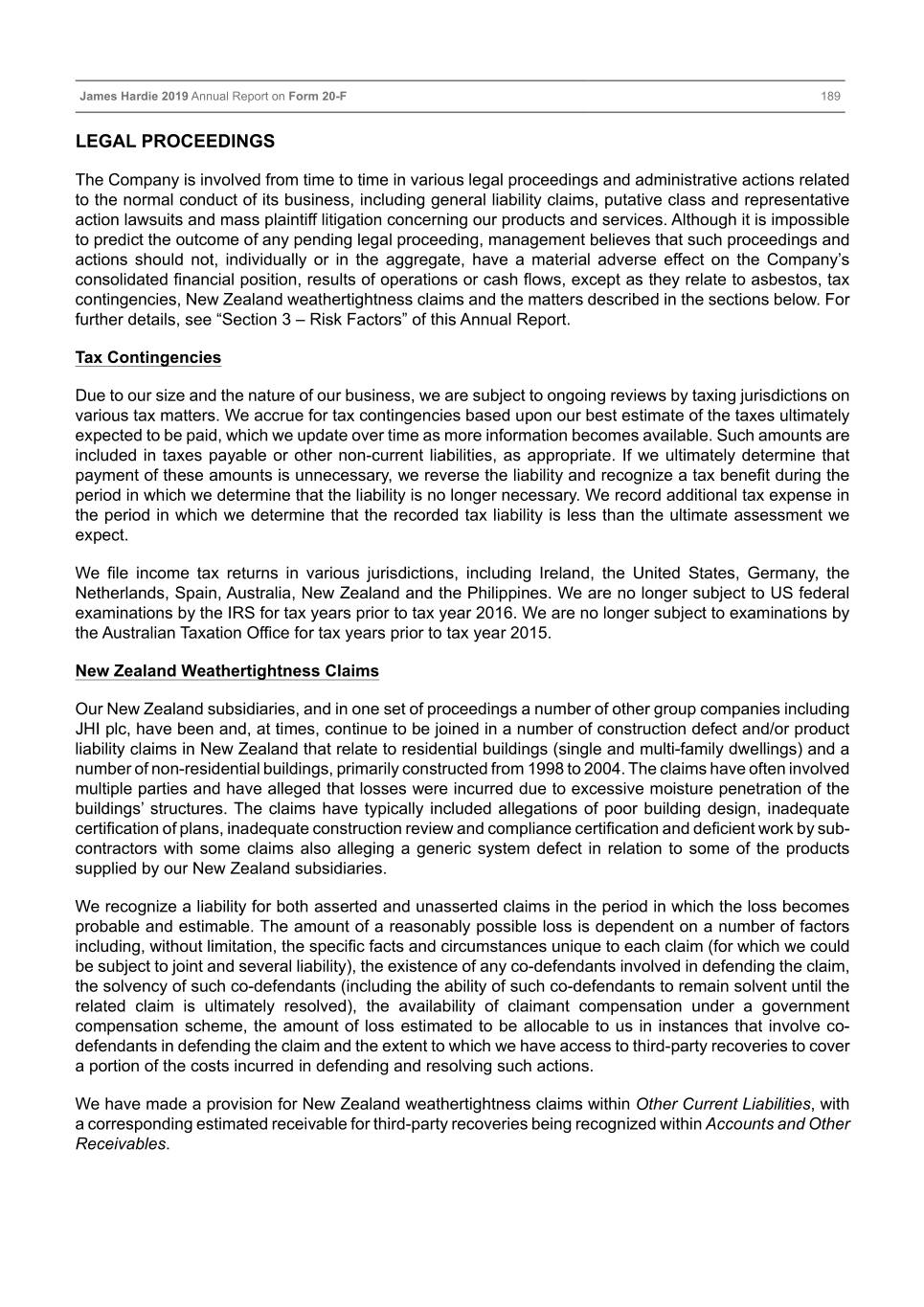
Table of Contents James Hardie 2019 Annual Report on Form 20-F 189 LEGAL PROCEEDINGS The Company is involved from time to time in various legal proceedings and administrative actions related to the normal conduct of its business, including general liability claims, putative class and representative action lawsuits and mass plaintiff litigation concerning our products and services. Although it is impossible to predict the outcome of any pending legal proceeding, management believes that such proceedings and actions should not, individually or in the aggregate, have a material adverse effect on the Company’s consolidated financial position, results of operations or cash flows, except as they relate to asbestos, tax contingencies, New Zealand weathertightness claims and the matters described in the sections below. For further details, see “Section 3 – Risk Factors” of this Annual Report. Tax Contingencies Due to our size and the nature of our business, we are subject to ongoing reviews by taxing jurisdictions on various tax matters. We accrue for tax contingencies based upon our best estimate of the taxes ultimately expected to be paid, which we update over time as more information becomes available. Such amounts are included in taxes payable or other non-current liabilities, as appropriate. If we ultimately determine that payment of these amounts is unnecessary, we reverse the liability and recognize a tax benefit during the period in which we determine that the liability is no longer necessary. We record additional tax expense in the period in which we determine that the recorded tax liability is less than the ultimate assessment we expect. We file income tax returns in various jurisdictions, including Ireland, the United States, Germany, the Netherlands, Spain, Australia, New Zealand and the Philippines. We are no longer subject to US federal examinations by the IRS for tax years prior to tax year 2016. We are no longer subject to examinations by the Australian Taxation Office for tax years prior to tax year 2015. New Zealand Weathertightness Claims Our New Zealand subsidiaries, and in one set of proceedings a number of other group companies including JHI plc, have been and, at times, continue to be joined in a number of construction defect and/or product liability claims in New Zealand that relate to residential buildings (single and multi-family dwellings) and a number of non-residential buildings, primarily constructed from 1998 to 2004. The claims have often involved multiple parties and have alleged that losses were incurred due to excessive moisture penetration of the buildings’ structures. The claims have typically included allegations of poor building design, inadequate certification of plans, inadequate construction review and compliance certification and deficient work by sub- contractors with some claims also alleging a generic system defect in relation to some of the products supplied by our New Zealand subsidiaries. We recognize a liability for both asserted and unasserted claims in the period in which the loss becomes probable and estimable. The amount of a reasonably possible loss is dependent on a number of factors including, without limitation, the specific facts and circumstances unique to each claim (for which we could be subject to joint and several liability), the existence of any co-defendants involved in defending the claim, the solvency of such co-defendants (including the ability of such co-defendants to remain solvent until the related claim is ultimately resolved), the availability of claimant compensation under a government compensation scheme, the amount of loss estimated to be allocable to us in instances that involve co- defendants in defending the claim and the extent to which we have access to third-party recoveries to cover a portion of the costs incurred in defending and resolving such actions. We have made a provision for New Zealand weathertightness claims within Other Current Liabilities, with a corresponding estimated receivable for third-party recoveries being recognized within Accounts and Other Receivables.
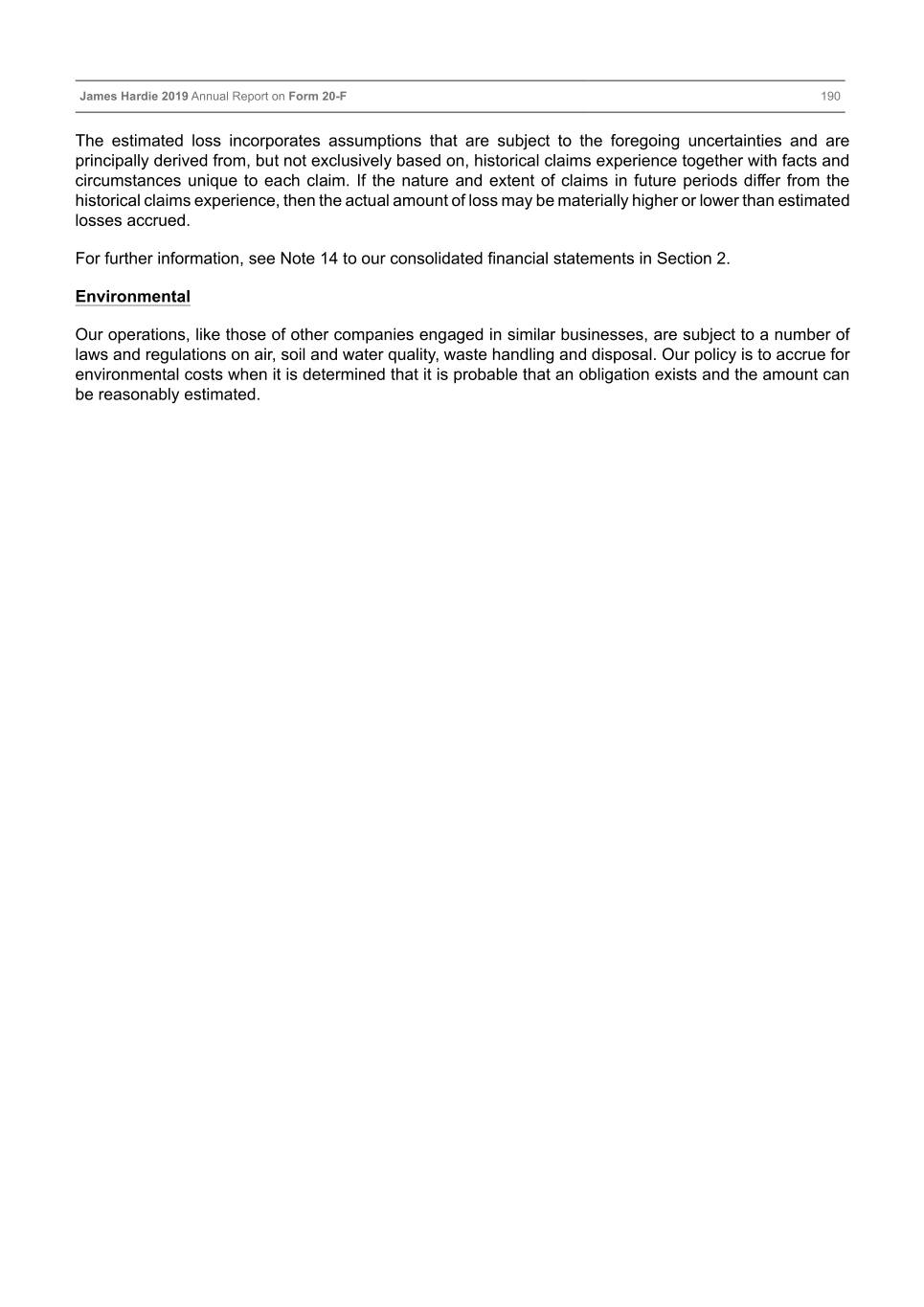
Table of Contents James Hardie 2019 Annual Report on Form 20-F 190 The estimated loss incorporates assumptions that are subject to the foregoing uncertainties and are principally derived from, but not exclusively based on, historical claims experience together with facts and circumstances unique to each claim. If the nature and extent of claims in future periods differ from the historical claims experience, then the actual amount of loss may be materially higher or lower than estimated losses accrued. For further information, see Note 14 to our consolidated financial statements in Section 2. Environmental Our operations, like those of other companies engaged in similar businesses, are subject to a number of laws and regulations on air, soil and water quality, waste handling and disposal. Our policy is to accrue for environmental costs when it is determined that it is probable that an obligation exists and the amount can be reasonably estimated.
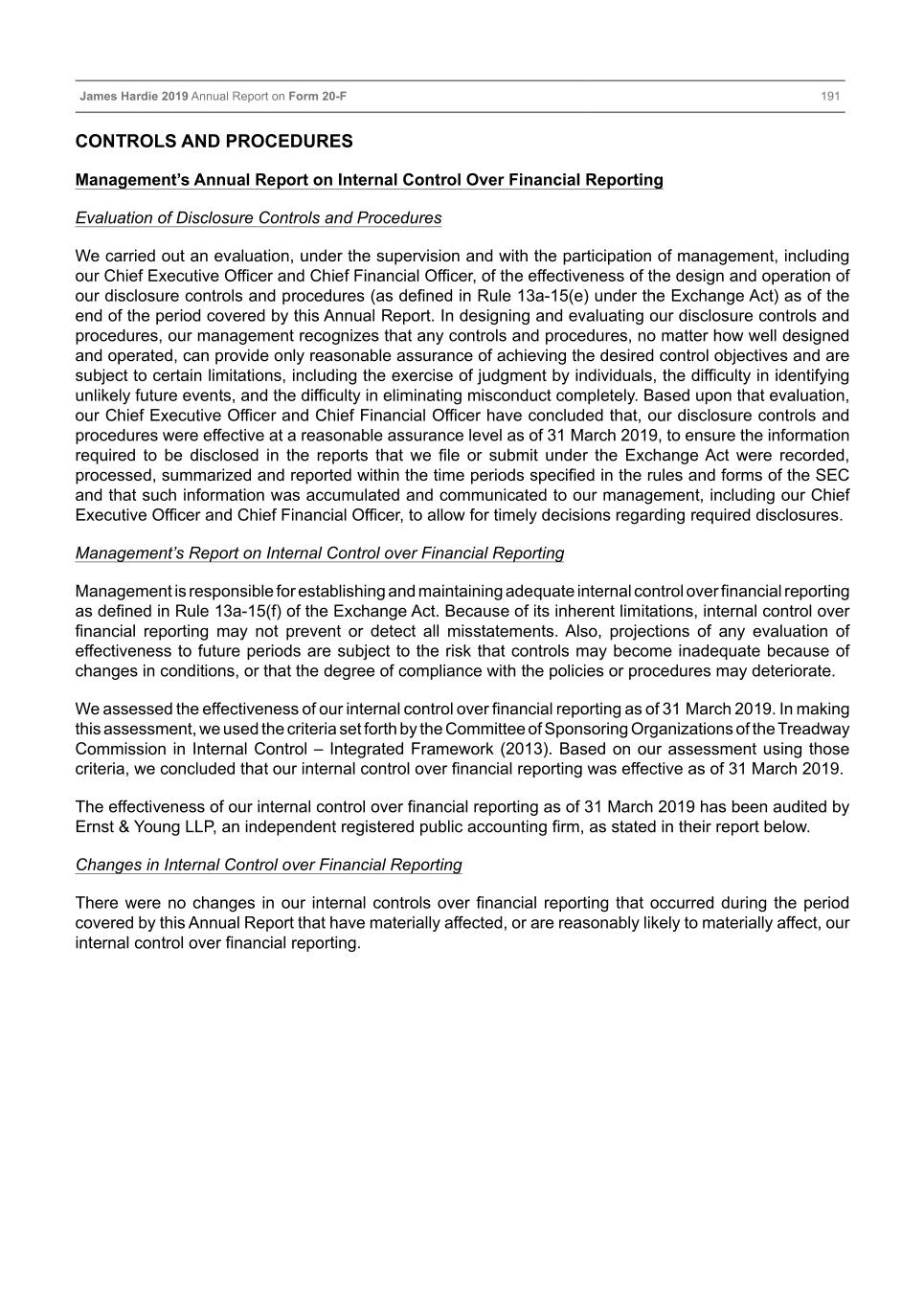
Table of Contents James Hardie 2019 Annual Report on Form 20-F 191 CONTROLS AND PROCEDURES Management’s Annual Report on Internal Control Over Financial Reporting Evaluation of Disclosure Controls and Procedures We carried out an evaluation, under the supervision and with the participation of management, including our Chief Executive Officer and Chief Financial Officer, of the effectiveness of the design and operation of our disclosure controls and procedures (as defined in Rule 13a-15(e) under the Exchange Act) as of the end of the period covered by this Annual Report. In designing and evaluating our disclosure controls and procedures, our management recognizes that any controls and procedures, no matter how well designed and operated, can provide only reasonable assurance of achieving the desired control objectives and are subject to certain limitations, including the exercise of judgment by individuals, the difficulty in identifying unlikely future events, and the difficulty in eliminating misconduct completely. Based upon that evaluation, our Chief Executive Officer and Chief Financial Officer have concluded that, our disclosure controls and procedures were effective at a reasonable assurance level as of 31 March 2019, to ensure the information required to be disclosed in the reports that we file or submit under the Exchange Act were recorded, processed, summarized and reported within the time periods specified in the rules and forms of the SEC and that such information was accumulated and communicated to our management, including our Chief Executive Officer and Chief Financial Officer, to allow for timely decisions regarding required disclosures. Management’s Report on Internal Control over Financial Reporting Management is responsible for establishing and maintaining adequate internal control over financial reporting as defined in Rule 13a-15(f) of the Exchange Act. Because of its inherent limitations, internal control over financial reporting may not prevent or detect all misstatements. Also, projections of any evaluation of effectiveness to future periods are subject to the risk that controls may become inadequate because of changes in conditions, or that the degree of compliance with the policies or procedures may deteriorate. We assessed the effectiveness of our internal control over financial reporting as of 31 March 2019. In making this assessment, we used the criteria set forth by the Committee of Sponsoring Organizations of the Treadway Commission in Internal Control – Integrated Framework (2013). Based on our assessment using those criteria, we concluded that our internal control over financial reporting was effective as of 31 March 2019. The effectiveness of our internal control over financial reporting as of 31 March 2019 has been audited by Ernst & Young LLP, an independent registered public accounting firm, as stated in their report below. Changes in Internal Control over Financial Reporting There were no changes in our internal controls over financial reporting that occurred during the period covered by this Annual Report that have materially affected, or are reasonably likely to materially affect, our internal control over financial reporting.
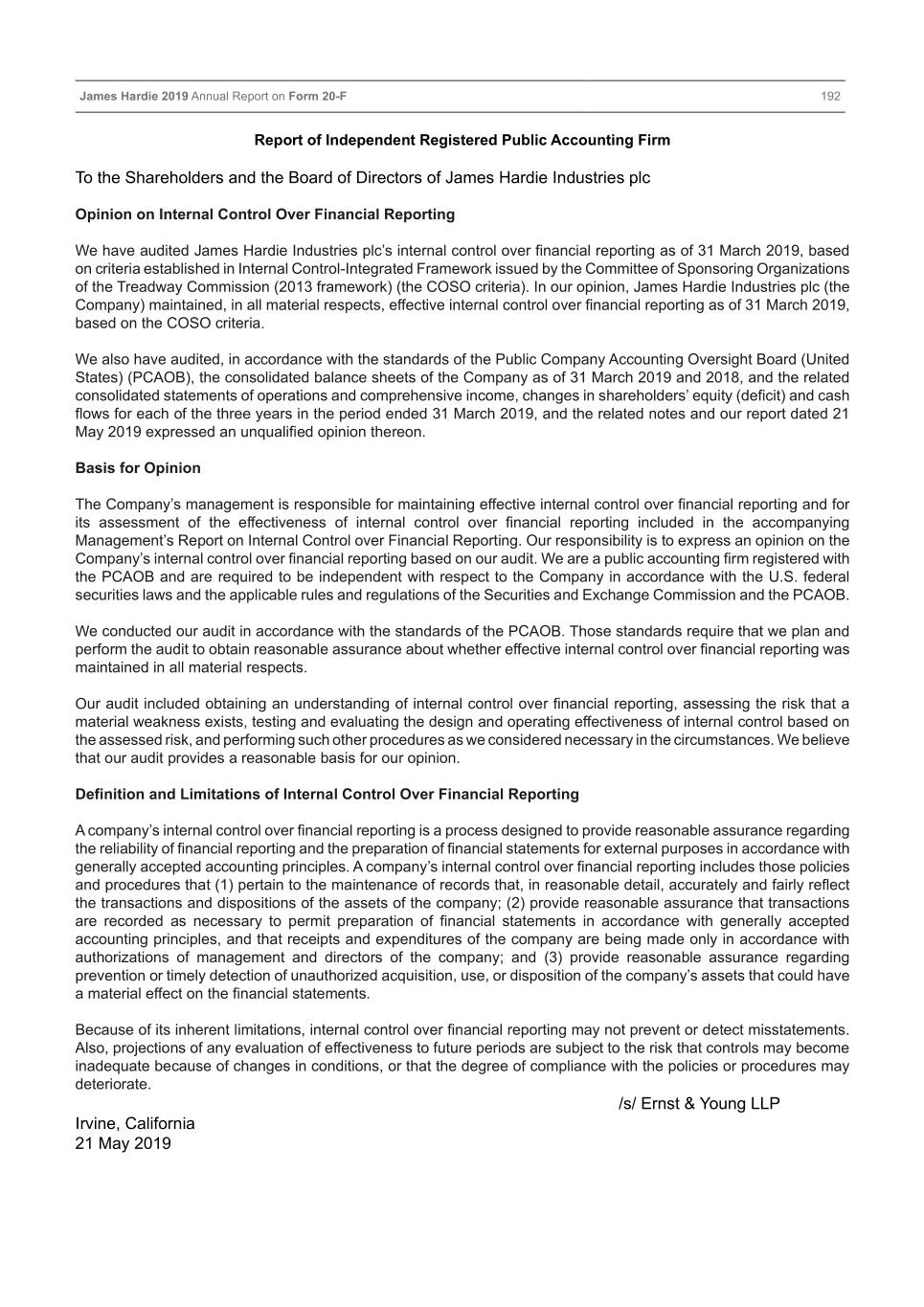
Table of Contents James Hardie 2019 Annual Report on Form 20-F 192 Report of Independent Registered Public Accounting Firm To the Shareholders and the Board of Directors of James Hardie Industries plc Opinion on Internal Control Over Financial Reporting We have audited James Hardie Industries plc’s internal control over financial reporting as of 31 March 2019, based on criteria established in Internal Control-Integrated Framework issued by the Committee of Sponsoring Organizations of the Treadway Commission (2013 framework) (the COSO criteria). In our opinion, James Hardie Industries plc (the Company) maintained, in all material respects, effective internal control over financial reporting as of 31 March 2019, based on the COSO criteria. We also have audited, in accordance with the standards of the Public Company Accounting Oversight Board (United States) (PCAOB), the consolidated balance sheets of the Company as of 31 March 2019 and 2018, and the related consolidated statements of operations and comprehensive income, changes in shareholders’ equity (deficit) and cash flows for each of the three years in the period ended 31 March 2019, and the related notes and our report dated 21 May 2019 expressed an unqualified opinion thereon. Basis for Opinion The Company’s management is responsible for maintaining effective internal control over financial reporting and for its assessment of the effectiveness of internal control over financial reporting included in the accompanying Management’s Report on Internal Control over Financial Reporting. Our responsibility is to express an opinion on the Company’s internal control over financial reporting based on our audit. We are a public accounting firm registered with the PCAOB and are required to be independent with respect to the Company in accordance with the U.S. federal securities laws and the applicable rules and regulations of the Securities and Exchange Commission and the PCAOB. We conducted our audit in accordance with the standards of the PCAOB. Those standards require that we plan and perform the audit to obtain reasonable assurance about whether effective internal control over financial reporting was maintained in all material respects. Our audit included obtaining an understanding of internal control over financial reporting, assessing the risk that a material weakness exists, testing and evaluating the design and operating effectiveness of internal control based on the assessed risk, and performing such other procedures as we considered necessary in the circumstances. We believe that our audit provides a reasonable basis for our opinion. Definition and Limitations of Internal Control Over Financial Reporting A company’s internal control over financial reporting is a process designed to provide reasonable assurance regarding the reliability of financial reporting and the preparation of financial statements for external purposes in accordance with generally accepted accounting principles. A company’s internal control over financial reporting includes those policies and procedures that (1) pertain to the maintenance of records that, in reasonable detail, accurately and fairly reflect the transactions and dispositions of the assets of the company; (2) provide reasonable assurance that transactions are recorded as necessary to permit preparation of financial statements in accordance with generally accepted accounting principles, and that receipts and expenditures of the company are being made only in accordance with authorizations of management and directors of the company; and (3) provide reasonable assurance regarding prevention or timely detection of unauthorized acquisition, use, or disposition of the company’s assets that could have a material effect on the financial statements. Because of its inherent limitations, internal control over financial reporting may not prevent or detect misstatements. Also, projections of any evaluation of effectiveness to future periods are subject to the risk that controls may become inadequate because of changes in conditions, or that the degree of compliance with the policies or procedures may deteriorate. /s/ Ernst & Young LLP Irvine, California 21 May 2019
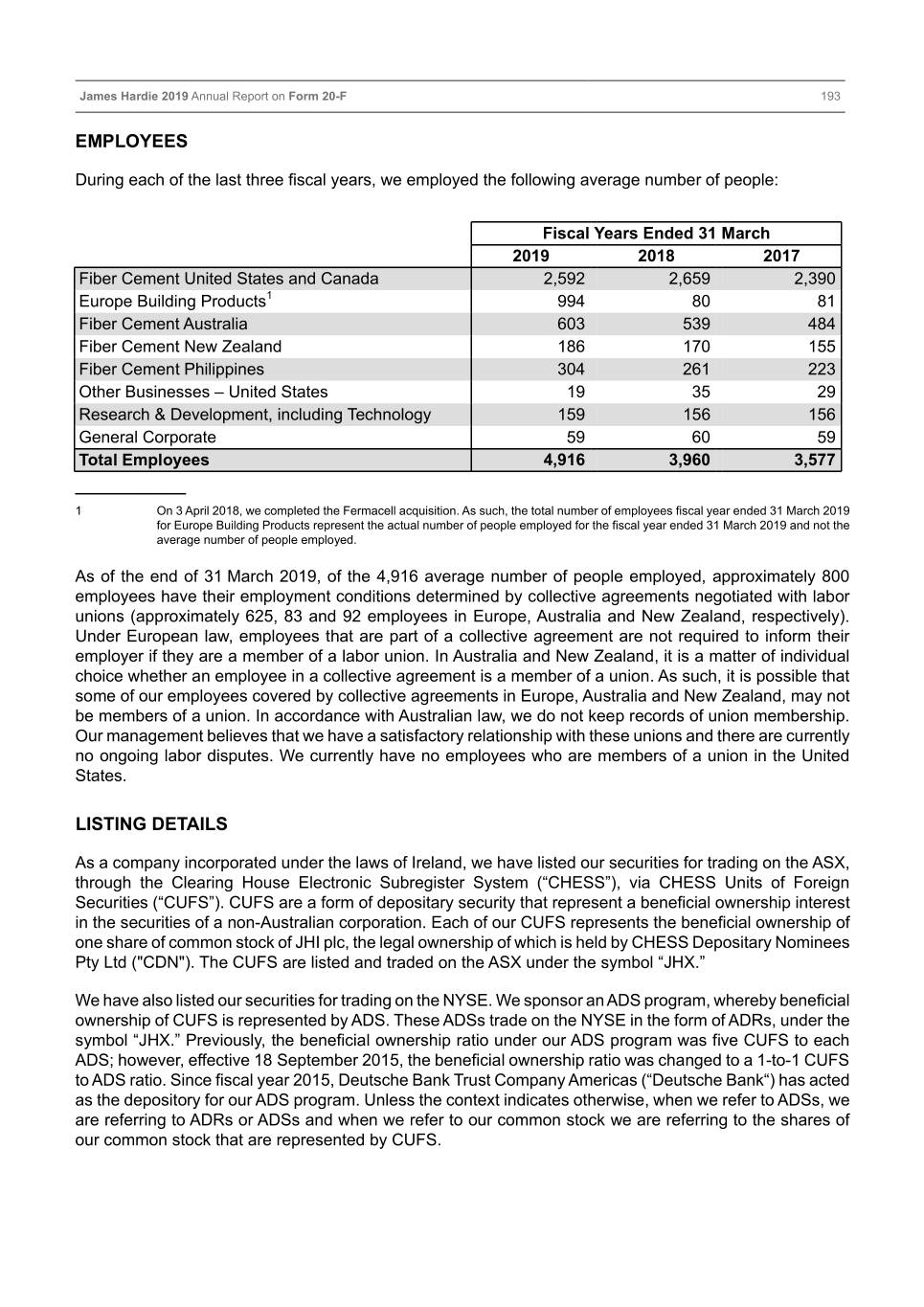
Table of Contents James Hardie 2019 Annual Report on Form 20-F 193 EMPLOYEES During each of the last three fiscal years, we employed the following average number of people: Fiscal Years Ended 31 March 2019 2018 2017 Fiber Cement United States and Canada 2,592 2,659 2,390 Europe Building Products1 994 80 81 Fiber Cement Australia 603 539 484 Fiber Cement New Zealand 186 170 155 Fiber Cement Philippines 304 261 223 Other Businesses – United States 19 35 29 Research & Development, including Technology 159 156 156 General Corporate 59 60 59 Total Employees 4,916 3,960 3,577 ____________ 1 On 3 April 2018, we completed the Fermacell acquisition. As such, the total number of employees fiscal year ended 31 March 2019 for Europe Building Products represent the actual number of people employed for the fiscal year ended 31 March 2019 and not the average number of people employed. As of the end of 31 March 2019, of the 4,916 average number of people employed, approximately 800 employees have their employment conditions determined by collective agreements negotiated with labor unions (approximately 625, 83 and 92 employees in Europe, Australia and New Zealand, respectively). Under European law, employees that are part of a collective agreement are not required to inform their employer if they are a member of a labor union. In Australia and New Zealand, it is a matter of individual choice whether an employee in a collective agreement is a member of a union. As such, it is possible that some of our employees covered by collective agreements in Europe, Australia and New Zealand, may not be members of a union. In accordance with Australian law, we do not keep records of union membership. Our management believes that we have a satisfactory relationship with these unions and there are currently no ongoing labor disputes. We currently have no employees who are members of a union in the United States. LISTING DETAILS As a company incorporated under the laws of Ireland, we have listed our securities for trading on the ASX, through the Clearing House Electronic Subregister System (“CHESS”), via CHESS Units of Foreign Securities (“CUFS”). CUFS are a form of depositary security that represent a beneficial ownership interest in the securities of a non-Australian corporation. Each of our CUFS represents the beneficial ownership of one share of common stock of JHI plc, the legal ownership of which is held by CHESS Depositary Nominees Pty Ltd ("CDN"). The CUFS are listed and traded on the ASX under the symbol “JHX.” We have also listed our securities for trading on the NYSE. We sponsor an ADS program, whereby beneficial ownership of CUFS is represented by ADS. These ADSs trade on the NYSE in the form of ADRs, under the symbol “JHX.” Previously, the beneficial ownership ratio under our ADS program was five CUFS to each ADS; however, effective 18 September 2015, the beneficial ownership ratio was changed to a 1-to-1 CUFS to ADS ratio. Since fiscal year 2015, Deutsche Bank Trust Company Americas (“Deutsche Bank“) has acted as the depository for our ADS program. Unless the context indicates otherwise, when we refer to ADSs, we are referring to ADRs or ADSs and when we refer to our common stock we are referring to the shares of our common stock that are represented by CUFS.
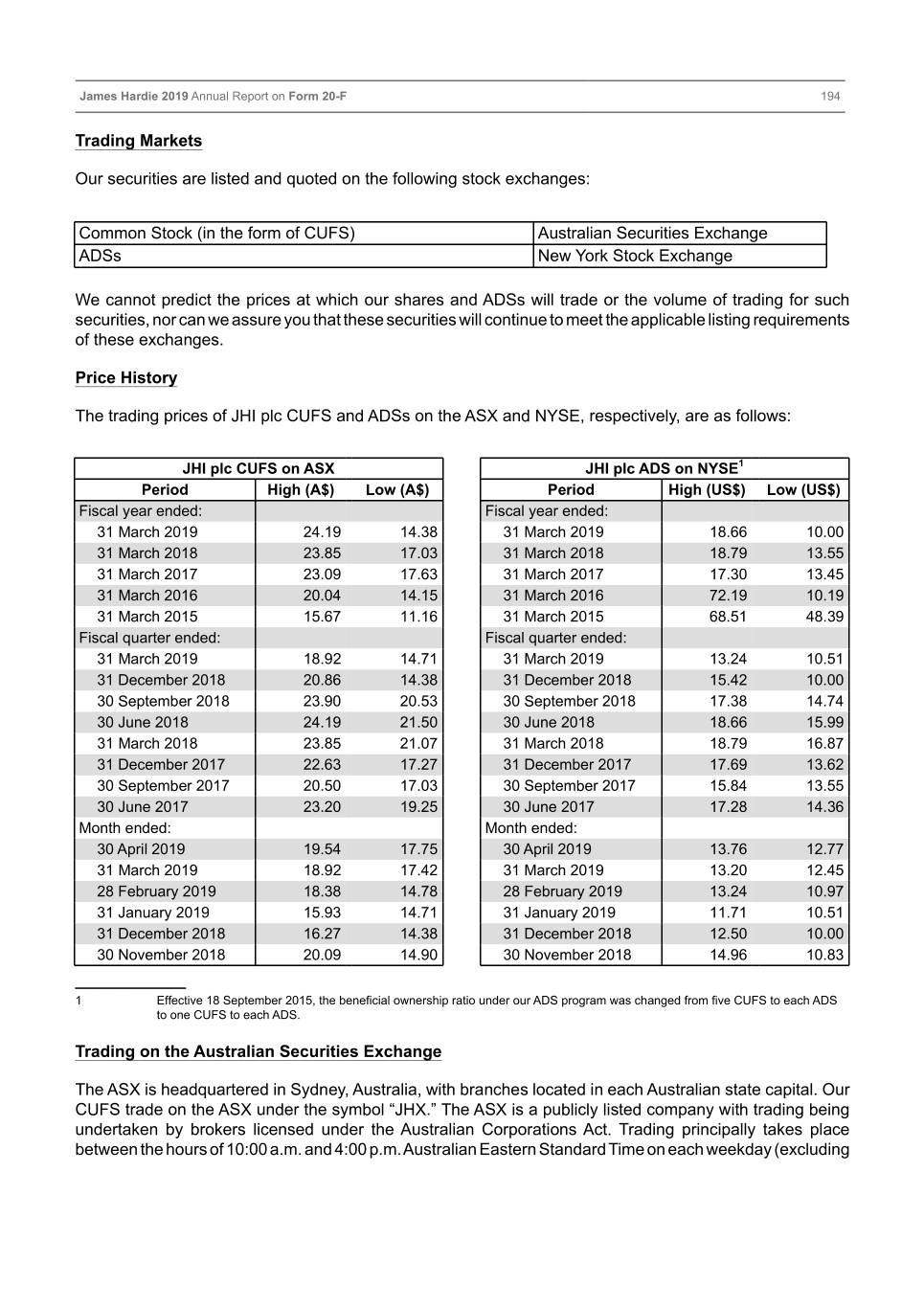
Table of Contents James Hardie 2019 Annual Report on Form 20-F 194 Trading Markets Our securities are listed and quoted on the following stock exchanges: Common Stock (in the form of CUFS) Australian Securities Exchange ADSs New York Stock Exchange We cannot predict the prices at which our shares and ADSs will trade or the volume of trading for such securities, nor can we assure you that these securities will continue to meet the applicable listing requirements of these exchanges. Price History The trading prices of JHI plc CUFS and ADSs on the ASX and NYSE, respectively, are as follows: JHI plc CUFS on ASX JHI plc ADS on NYSE1 Period High (A$) Low (A$) Period High (US$) Low (US$) Fiscal year ended: Fiscal year ended: 31 March 2019 24.19 14.38 31 March 2019 18.66 10.00 31 March 2018 23.85 17.03 31 March 2018 18.79 13.55 31 March 2017 23.09 17.63 31 March 2017 17.30 13.45 31 March 2016 20.04 14.15 31 March 2016 72.19 10.19 31 March 2015 15.67 11.16 31 March 2015 68.51 48.39 Fiscal quarter ended: Fiscal quarter ended: 31 March 2019 18.92 14.71 31 March 2019 13.24 10.51 31 December 2018 20.86 14.38 31 December 2018 15.42 10.00 30 September 2018 23.90 20.53 30 September 2018 17.38 14.74 30 June 2018 24.19 21.50 30 June 2018 18.66 15.99 31 March 2018 23.85 21.07 31 March 2018 18.79 16.87 31 December 2017 22.63 17.27 31 December 2017 17.69 13.62 30 September 2017 20.50 17.03 30 September 2017 15.84 13.55 30 June 2017 23.20 19.25 30 June 2017 17.28 14.36 Month ended: Month ended: 30 April 2019 19.54 17.75 30 April 2019 13.76 12.77 31 March 2019 18.92 17.42 31 March 2019 13.20 12.45 28 February 2019 18.38 14.78 28 February 2019 13.24 10.97 31 January 2019 15.93 14.71 31 January 2019 11.71 10.51 31 December 2018 16.27 14.38 31 December 2018 12.50 10.00 30 November 2018 20.09 14.90 30 November 2018 14.96 10.83 ____________ 1 Effective 18 September 2015, the beneficial ownership ratio under our ADS program was changed from five CUFS to each ADS to one CUFS to each ADS. Trading on the Australian Securities Exchange The ASX is headquartered in Sydney, Australia, with branches located in each Australian state capital. Our CUFS trade on the ASX under the symbol “JHX.” The ASX is a publicly listed company with trading being undertaken by brokers licensed under the Australian Corporations Act. Trading principally takes place between the hours of 10:00 a.m. and 4:00 p.m. Australian Eastern Standard Time on each weekday (excluding
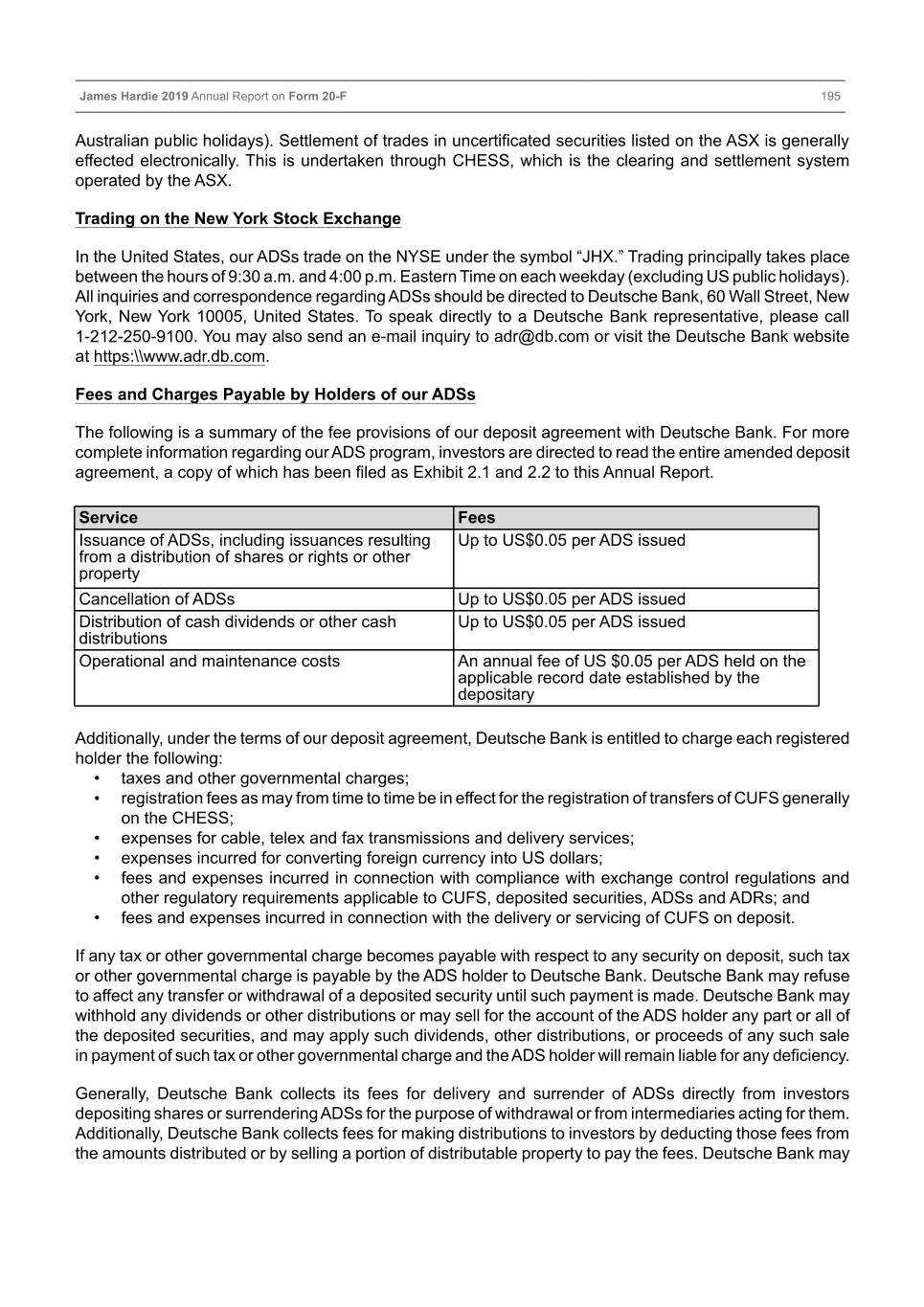
Table of Contents James Hardie 2019 Annual Report on Form 20-F 195 Australian public holidays). Settlement of trades in uncertificated securities listed on the ASX is generally effected electronically. This is undertaken through CHESS, which is the clearing and settlement system operated by the ASX. Trading on the New York Stock Exchange In the United States, our ADSs trade on the NYSE under the symbol “JHX.” Trading principally takes place between the hours of 9:30 a.m. and 4:00 p.m. Eastern Time on each weekday (excluding US public holidays). All inquiries and correspondence regarding ADSs should be directed to Deutsche Bank, 60 Wall Street, New York, New York 10005, United States. To speak directly to a Deutsche Bank representative, please call 1-212-250-9100. You may also send an e-mail inquiry to [email protected] or visit the Deutsche Bank website at https:\\www.adr.db.com. Fees and Charges Payable by Holders of our ADSs The following is a summary of the fee provisions of our deposit agreement with Deutsche Bank. For more complete information regarding our ADS program, investors are directed to read the entire amended deposit agreement, a copy of which has been filed as Exhibit 2.1 and 2.2 to this Annual Report. Service Fees Issuance of ADSs, including issuances resulting Up to US$0.05 per ADS issued from a distribution of shares or rights or other property Cancellation of ADSs Up to US$0.05 per ADS issued Distribution of cash dividends or other cash Up to US$0.05 per ADS issued distributions Operational and maintenance costs An annual fee of US $0.05 per ADS held on the applicable record date established by the depositary Additionally, under the terms of our deposit agreement, Deutsche Bank is entitled to charge each registered holder the following: • taxes and other governmental charges; • registration fees as may from time to time be in effect for the registration of transfers of CUFS generally on the CHESS; • expenses for cable, telex and fax transmissions and delivery services; • expenses incurred for converting foreign currency into US dollars; • fees and expenses incurred in connection with compliance with exchange control regulations and other regulatory requirements applicable to CUFS, deposited securities, ADSs and ADRs; and • fees and expenses incurred in connection with the delivery or servicing of CUFS on deposit. If any tax or other governmental charge becomes payable with respect to any security on deposit, such tax or other governmental charge is payable by the ADS holder to Deutsche Bank. Deutsche Bank may refuse to affect any transfer or withdrawal of a deposited security until such payment is made. Deutsche Bank may withhold any dividends or other distributions or may sell for the account of the ADS holder any part or all of the deposited securities, and may apply such dividends, other distributions, or proceeds of any such sale in payment of such tax or other governmental charge and the ADS holder will remain liable for any deficiency. Generally, Deutsche Bank collects its fees for delivery and surrender of ADSs directly from investors depositing shares or surrendering ADSs for the purpose of withdrawal or from intermediaries acting for them. Additionally, Deutsche Bank collects fees for making distributions to investors by deducting those fees from the amounts distributed or by selling a portion of distributable property to pay the fees. Deutsche Bank may
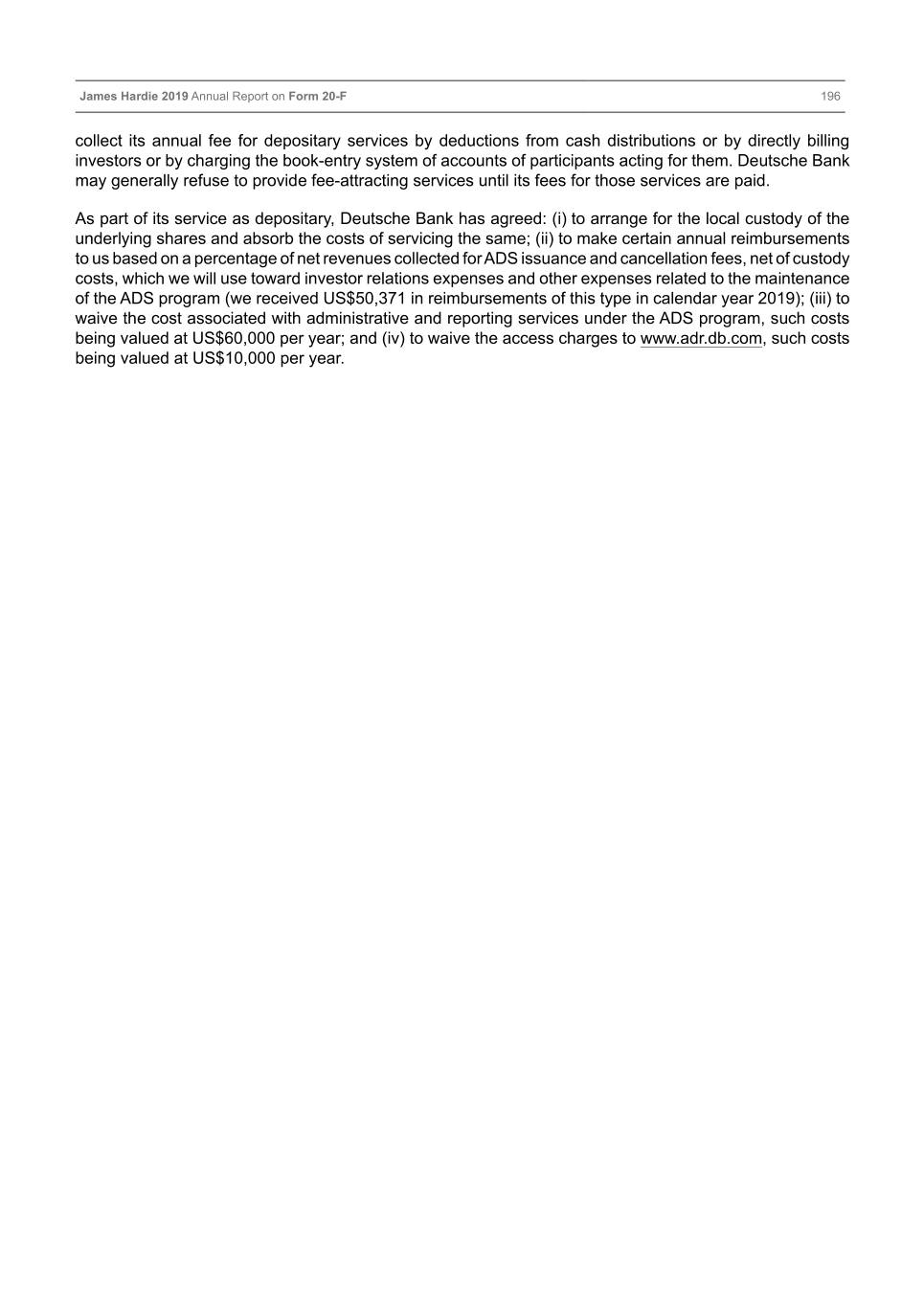
Table of Contents James Hardie 2019 Annual Report on Form 20-F 196 collect its annual fee for depositary services by deductions from cash distributions or by directly billing investors or by charging the book-entry system of accounts of participants acting for them. Deutsche Bank may generally refuse to provide fee-attracting services until its fees for those services are paid. As part of its service as depositary, Deutsche Bank has agreed: (i) to arrange for the local custody of the underlying shares and absorb the costs of servicing the same; (ii) to make certain annual reimbursements to us based on a percentage of net revenues collected for ADS issuance and cancellation fees, net of custody costs, which we will use toward investor relations expenses and other expenses related to the maintenance of the ADS program (we received US$50,371 in reimbursements of this type in calendar year 2019); (iii) to waive the cost associated with administrative and reporting services under the ADS program, such costs being valued at US$60,000 per year; and (iv) to waive the access charges to www.adr.db.com, such costs being valued at US$10,000 per year.
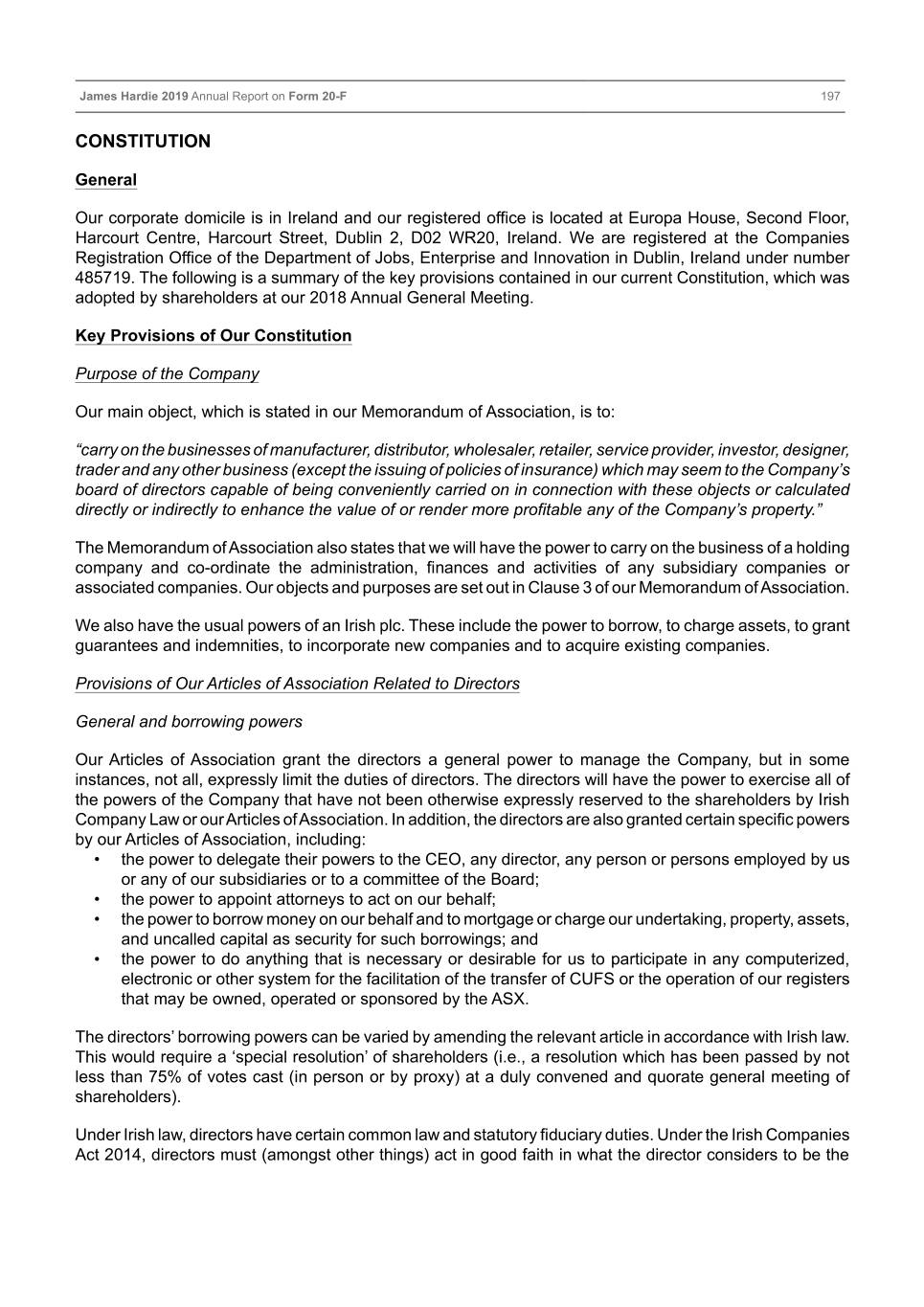
Table of Contents James Hardie 2019 Annual Report on Form 20-F 197 CONSTITUTION General Our corporate domicile is in Ireland and our registered office is located at Europa House, Second Floor, Harcourt Centre, Harcourt Street, Dublin 2, D02 WR20, Ireland. We are registered at the Companies Registration Office of the Department of Jobs, Enterprise and Innovation in Dublin, Ireland under number 485719. The following is a summary of the key provisions contained in our current Constitution, which was adopted by shareholders at our 2018 Annual General Meeting. Key Provisions of Our Constitution Purpose of the Company Our main object, which is stated in our Memorandum of Association, is to: “carry on the businesses of manufacturer, distributor, wholesaler, retailer, service provider, investor, designer, trader and any other business (except the issuing of policies of insurance) which may seem to the Company’s board of directors capable of being conveniently carried on in connection with these objects or calculated directly or indirectly to enhance the value of or render more profitable any of the Company’s property.” The Memorandum of Association also states that we will have the power to carry on the business of a holding company and co-ordinate the administration, finances and activities of any subsidiary companies or associated companies. Our objects and purposes are set out in Clause 3 of our Memorandum of Association. We also have the usual powers of an Irish plc. These include the power to borrow, to charge assets, to grant guarantees and indemnities, to incorporate new companies and to acquire existing companies. Provisions of Our Articles of Association Related to Directors General and borrowing powers Our Articles of Association grant the directors a general power to manage the Company, but in some instances, not all, expressly limit the duties of directors. The directors will have the power to exercise all of the powers of the Company that have not been otherwise expressly reserved to the shareholders by Irish Company Law or our Articles of Association. In addition, the directors are also granted certain specific powers by our Articles of Association, including: • the power to delegate their powers to the CEO, any director, any person or persons employed by us or any of our subsidiaries or to a committee of the Board; • the power to appoint attorneys to act on our behalf; • the power to borrow money on our behalf and to mortgage or charge our undertaking, property, assets, and uncalled capital as security for such borrowings; and • the power to do anything that is necessary or desirable for us to participate in any computerized, electronic or other system for the facilitation of the transfer of CUFS or the operation of our registers that may be owned, operated or sponsored by the ASX. The directors’ borrowing powers can be varied by amending the relevant article in accordance with Irish law. This would require a ‘special resolution’ of shareholders (i.e., a resolution which has been passed by not less than 75% of votes cast (in person or by proxy) at a duly convened and quorate general meeting of shareholders). Under Irish law, directors have certain common law and statutory fiduciary duties. Under the Irish Companies Act 2014, directors must (amongst other things) act in good faith in what the director considers to be the
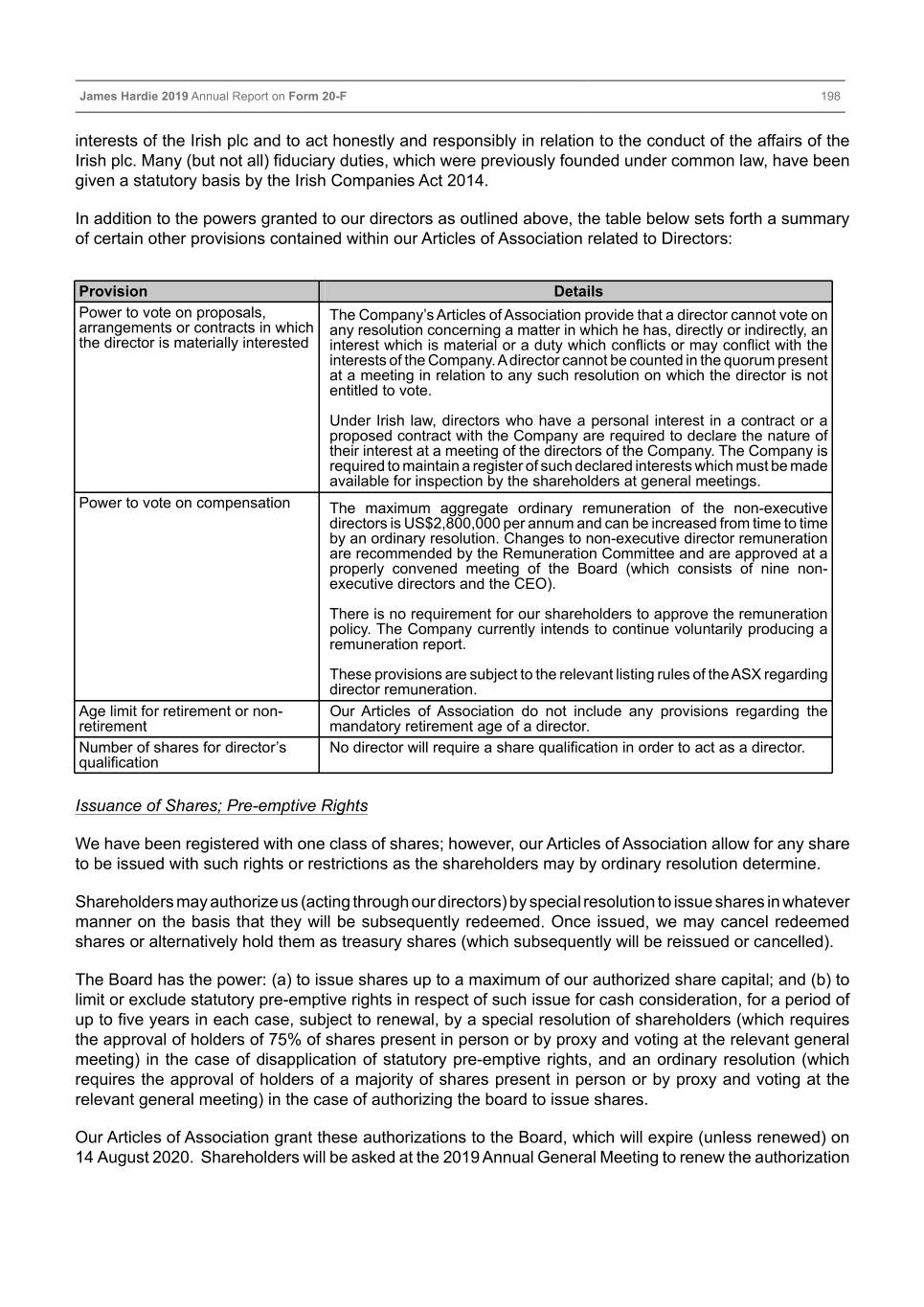
Table of Contents James Hardie 2019 Annual Report on Form 20-F 198 interests of the Irish plc and to act honestly and responsibly in relation to the conduct of the affairs of the Irish plc. Many (but not all) fiduciary duties, which were previously founded under common law, have been given a statutory basis by the Irish Companies Act 2014. In addition to the powers granted to our directors as outlined above, the table below sets forth a summary of certain other provisions contained within our Articles of Association related to Directors: Provision Details Power to vote on proposals, The Company’s Articles of Association provide that a director cannot vote on arrangements or contracts in which any resolution concerning a matter in which he has, directly or indirectly, an the director is materially interested interest which is material or a duty which conflicts or may conflict with the interests of the Company. A director cannot be counted in the quorum present at a meeting in relation to any such resolution on which the director is not entitled to vote. Under Irish law, directors who have a personal interest in a contract or a proposed contract with the Company are required to declare the nature of their interest at a meeting of the directors of the Company. The Company is required to maintain a register of such declared interests which must be made available for inspection by the shareholders at general meetings. Power to vote on compensation The maximum aggregate ordinary remuneration of the non-executive directors is US$2,800,000 per annum and can be increased from time to time by an ordinary resolution. Changes to non-executive director remuneration are recommended by the Remuneration Committee and are approved at a properly convened meeting of the Board (which consists of nine non- executive directors and the CEO). There is no requirement for our shareholders to approve the remuneration policy. The Company currently intends to continue voluntarily producing a remuneration report. These provisions are subject to the relevant listing rules of the ASX regarding director remuneration. Age limit for retirement or non- Our Articles of Association do not include any provisions regarding the retirement mandatory retirement age of a director. Number of shares for director’s No director will require a share qualification in order to act as a director. qualification Issuance of Shares; Pre-emptive Rights We have been registered with one class of shares; however, our Articles of Association allow for any share to be issued with such rights or restrictions as the shareholders may by ordinary resolution determine. Shareholders may authorize us (acting through our directors) by special resolution to issue shares in whatever manner on the basis that they will be subsequently redeemed. Once issued, we may cancel redeemed shares or alternatively hold them as treasury shares (which subsequently will be reissued or cancelled). The Board has the power: (a) to issue shares up to a maximum of our authorized share capital; and (b) to limit or exclude statutory pre-emptive rights in respect of such issue for cash consideration, for a period of up to five years in each case, subject to renewal, by a special resolution of shareholders (which requires the approval of holders of 75% of shares present in person or by proxy and voting at the relevant general meeting) in the case of disapplication of statutory pre-emptive rights, and an ordinary resolution (which requires the approval of holders of a majority of shares present in person or by proxy and voting at the relevant general meeting) in the case of authorizing the board to issue shares. Our Articles of Association grant these authorizations to the Board, which will expire (unless renewed) on 14 August 2020. Shareholders will be asked at the 2019 Annual General Meeting to renew the authorization

Table of Contents James Hardie 2019 Annual Report on Form 20-F 199 described in paragraph (a) above, with effect from the expiration of the current authorization and for a period of five years from the date of the passing of such resolution. These authorizations are subject to the listing rules of the ASX and NYSE in relation to the issue of new equity securities, which require: • in the case of the ASX, shareholder approval for the issue of equity securities which exceed 15% of the number of equity securities on issue (as determined in accordance with the ASX listing rules and subject to the various exemptions set out therein); and • in the case of the NYSE, shareholder approval for the issuance of shares that have or will have upon issuance voting power equal to or in excess of 20% of the voting power outstanding before the issuance of such shares (subject to certain exceptions). If the Board is at any time not designated as the authorized body for such powers, the shareholders acting by ordinary resolution have the power to issue shares, but only upon the proposal of the Board. As an Irish company that has listed securities in Australia and the United States, we are subject to applicable legislation regarding insider trading. Generally, Australian law prohibits persons from trading on the basis of information which is not generally available and which, if it were generally available, a reasonable person would expect to have a material effect on the price or value of securities. Similarly, in the United States, persons are prohibited from trading on the basis of material, non-public information. We have adopted an internal code on insider trading consistent with Australian and US laws and regulations. Repurchase of Shares and Reduction of Capital Irish law permits us to redeem our shares (provided such shares are redeemable) at any time whether on or off market without shareholder approval. Accordingly, our Articles of Association provide that, when we agree to acquire any shares (unless we elect to treat the acquisition as a purchase), it shall be a term of such contract that the relevant shares become redeemable on the entry into of that contract and that completion of that contract shall constitute redemption of the relevant shares. This means that we may acquire our own shares. In addition, Irish law permits an Irish company and its subsidiaries to make market purchases of the shares of the Irish company on a recognized stock exchange if shareholders of the company have granted the company and/or its subsidiaries a general authority by ordinary resolution to do so. Currently, the Irish Stock Exchange, the NYSE, NASDAQ and the London Stock Exchange are the recognized stock exchanges for this purpose. As the ASX is not currently a recognized stock exchange for the purposes of Irish law, on- and off-market purchases of our shares (by way of trading CUFS) will only be available to us through their redemption in accordance with the redemption mechanism in our Articles of Association, outlined above, provided we do not treat such acquisition as a purchase. A redemption or repurchase of shares may only be funded out of distributable reserves or out of the proceeds of a fresh issue of shares for that purpose. Under Irish Company Law, the Board may determine whether shares that we have repurchased or redeemed will either be held in treasury or cancelled. However, under Irish Company Law, the nominal value of treasury shares held by us may not, at any one time, exceed 10% of the nominal value of our issued share capital. Unless otherwise required by an Irish plc’s Articles of Association or Irish law, no business other than the appointment of a chairman may be transacted at any general meeting unless at least 5% of Irish plc’s issued share capital is present or represented.
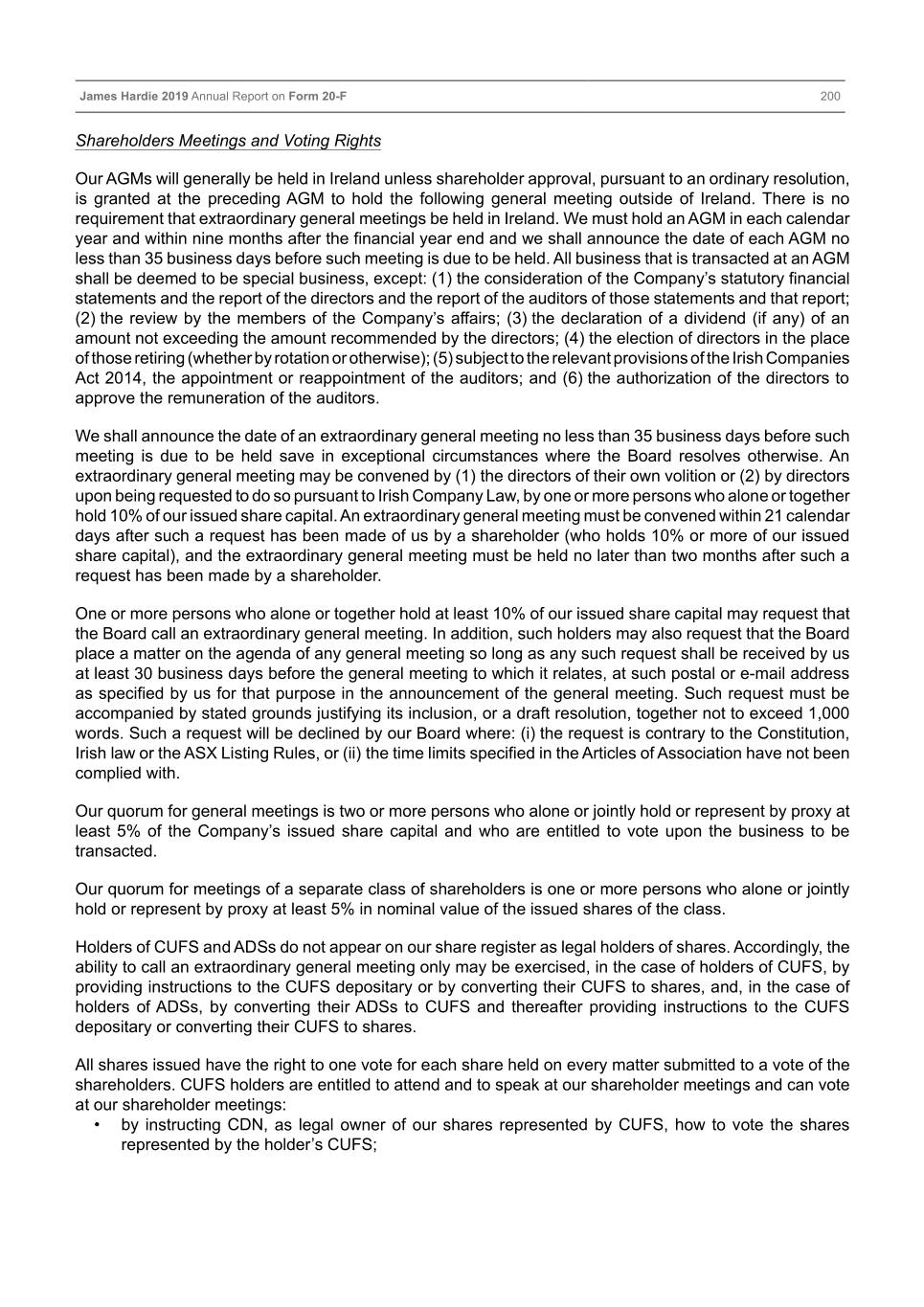
Table of Contents James Hardie 2019 Annual Report on Form 20-F 200 Shareholders Meetings and Voting Rights Our AGMs will generally be held in Ireland unless shareholder approval, pursuant to an ordinary resolution, is granted at the preceding AGM to hold the following general meeting outside of Ireland. There is no requirement that extraordinary general meetings be held in Ireland. We must hold an AGM in each calendar year and within nine months after the financial year end and we shall announce the date of each AGM no less than 35 business days before such meeting is due to be held. All business that is transacted at an AGM shall be deemed to be special business, except: (1) the consideration of the Company’s statutory financial statements and the report of the directors and the report of the auditors of those statements and that report; (2) the review by the members of the Company’s affairs; (3) the declaration of a dividend (if any) of an amount not exceeding the amount recommended by the directors; (4) the election of directors in the place of those retiring (whether by rotation or otherwise); (5) subject to the relevant provisions of the Irish Companies Act 2014, the appointment or reappointment of the auditors; and (6) the authorization of the directors to approve the remuneration of the auditors. We shall announce the date of an extraordinary general meeting no less than 35 business days before such meeting is due to be held save in exceptional circumstances where the Board resolves otherwise. An extraordinary general meeting may be convened by (1) the directors of their own volition or (2) by directors upon being requested to do so pursuant to Irish Company Law, by one or more persons who alone or together hold 10% of our issued share capital. An extraordinary general meeting must be convened within 21 calendar days after such a request has been made of us by a shareholder (who holds 10% or more of our issued share capital), and the extraordinary general meeting must be held no later than two months after such a request has been made by a shareholder. One or more persons who alone or together hold at least 10% of our issued share capital may request that the Board call an extraordinary general meeting. In addition, such holders may also request that the Board place a matter on the agenda of any general meeting so long as any such request shall be received by us at least 30 business days before the general meeting to which it relates, at such postal or e-mail address as specified by us for that purpose in the announcement of the general meeting. Such request must be accompanied by stated grounds justifying its inclusion, or a draft resolution, together not to exceed 1,000 words. Such a request will be declined by our Board where: (i) the request is contrary to the Constitution, Irish law or the ASX Listing Rules, or (ii) the time limits specified in the Articles of Association have not been complied with. Our quorum for general meetings is two or more persons who alone or jointly hold or represent by proxy at least 5% of the Company’s issued share capital and who are entitled to vote upon the business to be transacted. Our quorum for meetings of a separate class of shareholders is one or more persons who alone or jointly hold or represent by proxy at least 5% in nominal value of the issued shares of the class. Holders of CUFS and ADSs do not appear on our share register as legal holders of shares. Accordingly, the ability to call an extraordinary general meeting only may be exercised, in the case of holders of CUFS, by providing instructions to the CUFS depositary or by converting their CUFS to shares, and, in the case of holders of ADSs, by converting their ADSs to CUFS and thereafter providing instructions to the CUFS depositary or converting their CUFS to shares. All shares issued have the right to one vote for each share held on every matter submitted to a vote of the shareholders. CUFS holders are entitled to attend and to speak at our shareholder meetings and can vote at our shareholder meetings: • by instructing CDN, as legal owner of our shares represented by CUFS, how to vote the shares represented by the holder’s CUFS;
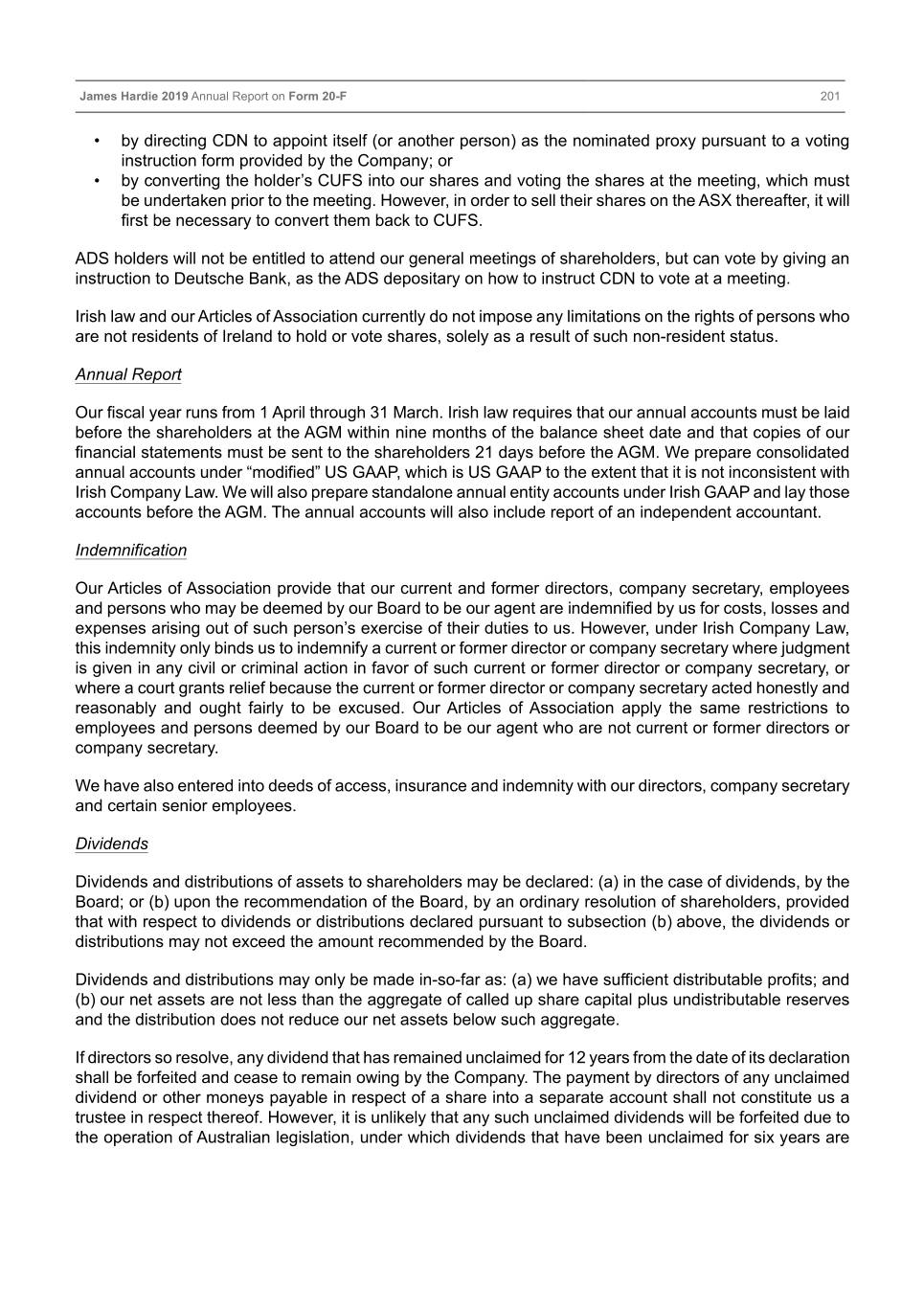
Table of Contents James Hardie 2019 Annual Report on Form 20-F 201 • by directing CDN to appoint itself (or another person) as the nominated proxy pursuant to a voting instruction form provided by the Company; or • by converting the holder’s CUFS into our shares and voting the shares at the meeting, which must be undertaken prior to the meeting. However, in order to sell their shares on the ASX thereafter, it will first be necessary to convert them back to CUFS. ADS holders will not be entitled to attend our general meetings of shareholders, but can vote by giving an instruction to Deutsche Bank, as the ADS depositary on how to instruct CDN to vote at a meeting. Irish law and our Articles of Association currently do not impose any limitations on the rights of persons who are not residents of Ireland to hold or vote shares, solely as a result of such non-resident status. Annual Report Our fiscal year runs from 1 April through 31 March. Irish law requires that our annual accounts must be laid before the shareholders at the AGM within nine months of the balance sheet date and that copies of our financial statements must be sent to the shareholders 21 days before the AGM. We prepare consolidated annual accounts under “modified” US GAAP, which is US GAAP to the extent that it is not inconsistent with Irish Company Law. We will also prepare standalone annual entity accounts under Irish GAAP and lay those accounts before the AGM. The annual accounts will also include report of an independent accountant. Indemnification Our Articles of Association provide that our current and former directors, company secretary, employees and persons who may be deemed by our Board to be our agent are indemnified by us for costs, losses and expenses arising out of such person’s exercise of their duties to us. However, under Irish Company Law, this indemnity only binds us to indemnify a current or former director or company secretary where judgment is given in any civil or criminal action in favor of such current or former director or company secretary, or where a court grants relief because the current or former director or company secretary acted honestly and reasonably and ought fairly to be excused. Our Articles of Association apply the same restrictions to employees and persons deemed by our Board to be our agent who are not current or former directors or company secretary. We have also entered into deeds of access, insurance and indemnity with our directors, company secretary and certain senior employees. Dividends Dividends and distributions of assets to shareholders may be declared: (a) in the case of dividends, by the Board; or (b) upon the recommendation of the Board, by an ordinary resolution of shareholders, provided that with respect to dividends or distributions declared pursuant to subsection (b) above, the dividends or distributions may not exceed the amount recommended by the Board. Dividends and distributions may only be made in-so-far as: (a) we have sufficient distributable profits; and (b) our net assets are not less than the aggregate of called up share capital plus undistributable reserves and the distribution does not reduce our net assets below such aggregate. If directors so resolve, any dividend that has remained unclaimed for 12 years from the date of its declaration shall be forfeited and cease to remain owing by the Company. The payment by directors of any unclaimed dividend or other moneys payable in respect of a share into a separate account shall not constitute us a trustee in respect thereof. However, it is unlikely that any such unclaimed dividends will be forfeited due to the operation of Australian legislation, under which dividends that have been unclaimed for six years are
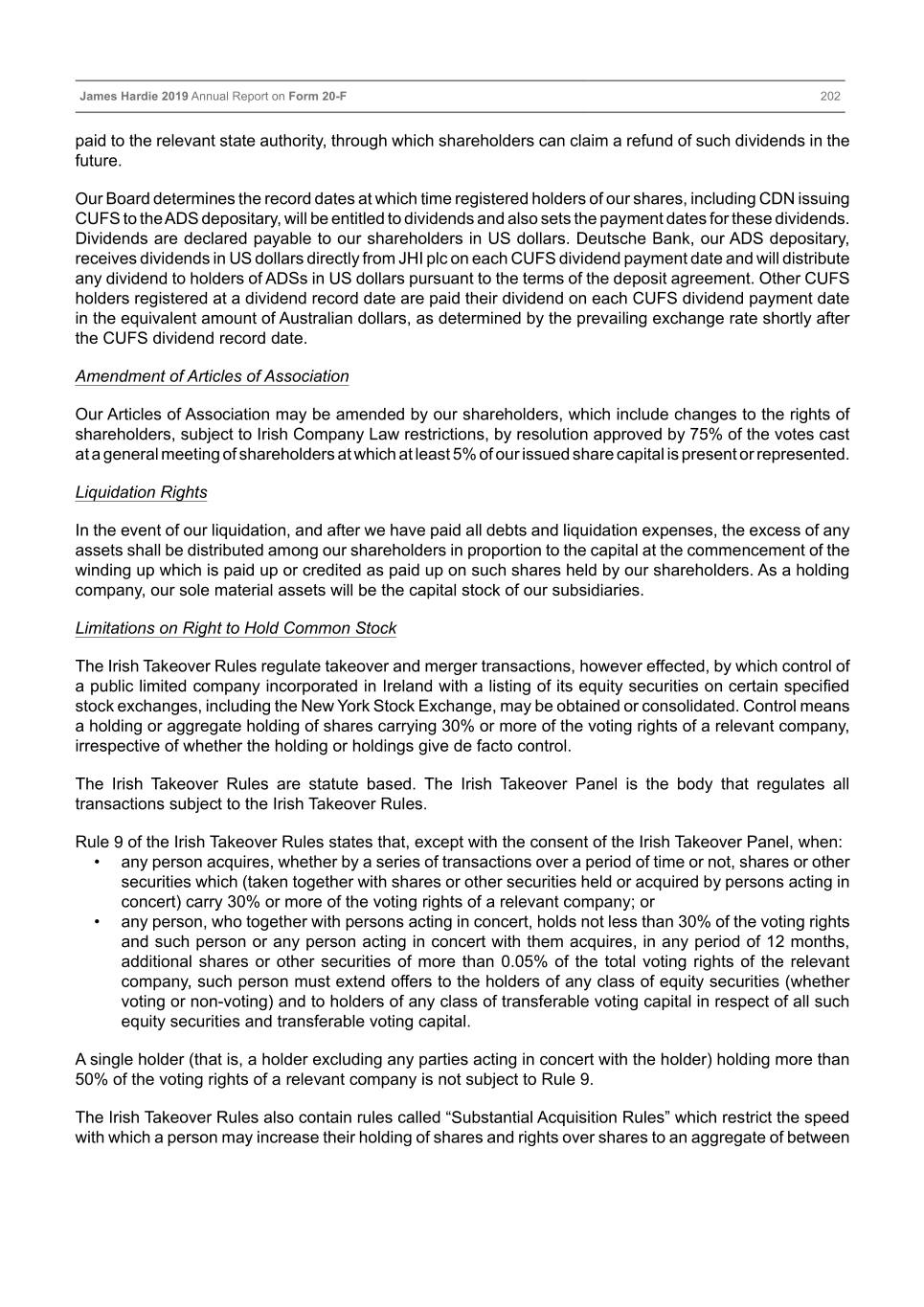
Table of Contents James Hardie 2019 Annual Report on Form 20-F 202 paid to the relevant state authority, through which shareholders can claim a refund of such dividends in the future. Our Board determines the record dates at which time registered holders of our shares, including CDN issuing CUFS to the ADS depositary, will be entitled to dividends and also sets the payment dates for these dividends. Dividends are declared payable to our shareholders in US dollars. Deutsche Bank, our ADS depositary, receives dividends in US dollars directly from JHI plc on each CUFS dividend payment date and will distribute any dividend to holders of ADSs in US dollars pursuant to the terms of the deposit agreement. Other CUFS holders registered at a dividend record date are paid their dividend on each CUFS dividend payment date in the equivalent amount of Australian dollars, as determined by the prevailing exchange rate shortly after the CUFS dividend record date. Amendment of Articles of Association Our Articles of Association may be amended by our shareholders, which include changes to the rights of shareholders, subject to Irish Company Law restrictions, by resolution approved by 75% of the votes cast at a general meeting of shareholders at which at least 5% of our issued share capital is present or represented. Liquidation Rights In the event of our liquidation, and after we have paid all debts and liquidation expenses, the excess of any assets shall be distributed among our shareholders in proportion to the capital at the commencement of the winding up which is paid up or credited as paid up on such shares held by our shareholders. As a holding company, our sole material assets will be the capital stock of our subsidiaries. Limitations on Right to Hold Common Stock The Irish Takeover Rules regulate takeover and merger transactions, however effected, by which control of a public limited company incorporated in Ireland with a listing of its equity securities on certain specified stock exchanges, including the New York Stock Exchange, may be obtained or consolidated. Control means a holding or aggregate holding of shares carrying 30% or more of the voting rights of a relevant company, irrespective of whether the holding or holdings give de facto control. The Irish Takeover Rules are statute based. The Irish Takeover Panel is the body that regulates all transactions subject to the Irish Takeover Rules. Rule 9 of the Irish Takeover Rules states that, except with the consent of the Irish Takeover Panel, when: • any person acquires, whether by a series of transactions over a period of time or not, shares or other securities which (taken together with shares or other securities held or acquired by persons acting in concert) carry 30% or more of the voting rights of a relevant company; or • any person, who together with persons acting in concert, holds not less than 30% of the voting rights and such person or any person acting in concert with them acquires, in any period of 12 months, additional shares or other securities of more than 0.05% of the total voting rights of the relevant company, such person must extend offers to the holders of any class of equity securities (whether voting or non-voting) and to holders of any class of transferable voting capital in respect of all such equity securities and transferable voting capital. A single holder (that is, a holder excluding any parties acting in concert with the holder) holding more than 50% of the voting rights of a relevant company is not subject to Rule 9. The Irish Takeover Rules also contain rules called “Substantial Acquisition Rules” which restrict the speed with which a person may increase their holding of shares and rights over shares to an aggregate of between
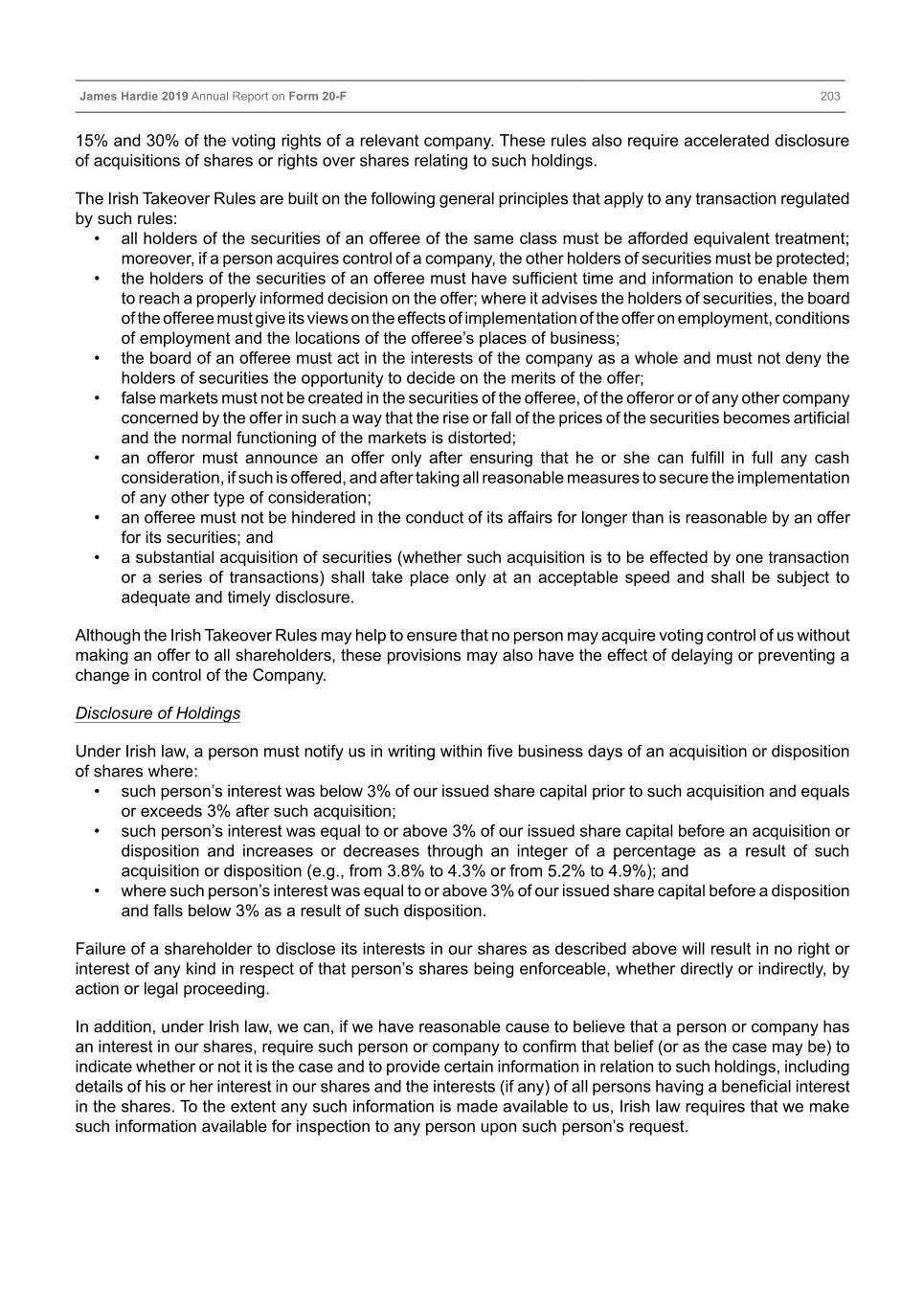
Table of Contents James Hardie 2019 Annual Report on Form 20-F 203 15% and 30% of the voting rights of a relevant company. These rules also require accelerated disclosure of acquisitions of shares or rights over shares relating to such holdings. The Irish Takeover Rules are built on the following general principles that apply to any transaction regulated by such rules: • all holders of the securities of an offeree of the same class must be afforded equivalent treatment; moreover, if a person acquires control of a company, the other holders of securities must be protected; • the holders of the securities of an offeree must have sufficient time and information to enable them to reach a properly informed decision on the offer; where it advises the holders of securities, the board of the offeree must give its views on the effects of implementation of the offer on employment, conditions of employment and the locations of the offeree’s places of business; • the board of an offeree must act in the interests of the company as a whole and must not deny the holders of securities the opportunity to decide on the merits of the offer; • false markets must not be created in the securities of the offeree, of the offeror or of any other company concerned by the offer in such a way that the rise or fall of the prices of the securities becomes artificial and the normal functioning of the markets is distorted; • an offeror must announce an offer only after ensuring that he or she can fulfill in full any cash consideration, if such is offered, and after taking all reasonable measures to secure the implementation of any other type of consideration; • an offeree must not be hindered in the conduct of its affairs for longer than is reasonable by an offer for its securities; and • a substantial acquisition of securities (whether such acquisition is to be effected by one transaction or a series of transactions) shall take place only at an acceptable speed and shall be subject to adequate and timely disclosure. Although the Irish Takeover Rules may help to ensure that no person may acquire voting control of us without making an offer to all shareholders, these provisions may also have the effect of delaying or preventing a change in control of the Company. Disclosure of Holdings Under Irish law, a person must notify us in writing within five business days of an acquisition or disposition of shares where: • such person’s interest was below 3% of our issued share capital prior to such acquisition and equals or exceeds 3% after such acquisition; • such person’s interest was equal to or above 3% of our issued share capital before an acquisition or disposition and increases or decreases through an integer of a percentage as a result of such acquisition or disposition (e.g., from 3.8% to 4.3% or from 5.2% to 4.9%); and • where such person’s interest was equal to or above 3% of our issued share capital before a disposition and falls below 3% as a result of such disposition. Failure of a shareholder to disclose its interests in our shares as described above will result in no right or interest of any kind in respect of that person’s shares being enforceable, whether directly or indirectly, by action or legal proceeding. In addition, under Irish law, we can, if we have reasonable cause to believe that a person or company has an interest in our shares, require such person or company to confirm that belief (or as the case may be) to indicate whether or not it is the case and to provide certain information in relation to such holdings, including details of his or her interest in our shares and the interests (if any) of all persons having a beneficial interest in the shares. To the extent any such information is made available to us, Irish law requires that we make such information available for inspection to any person upon such person’s request.
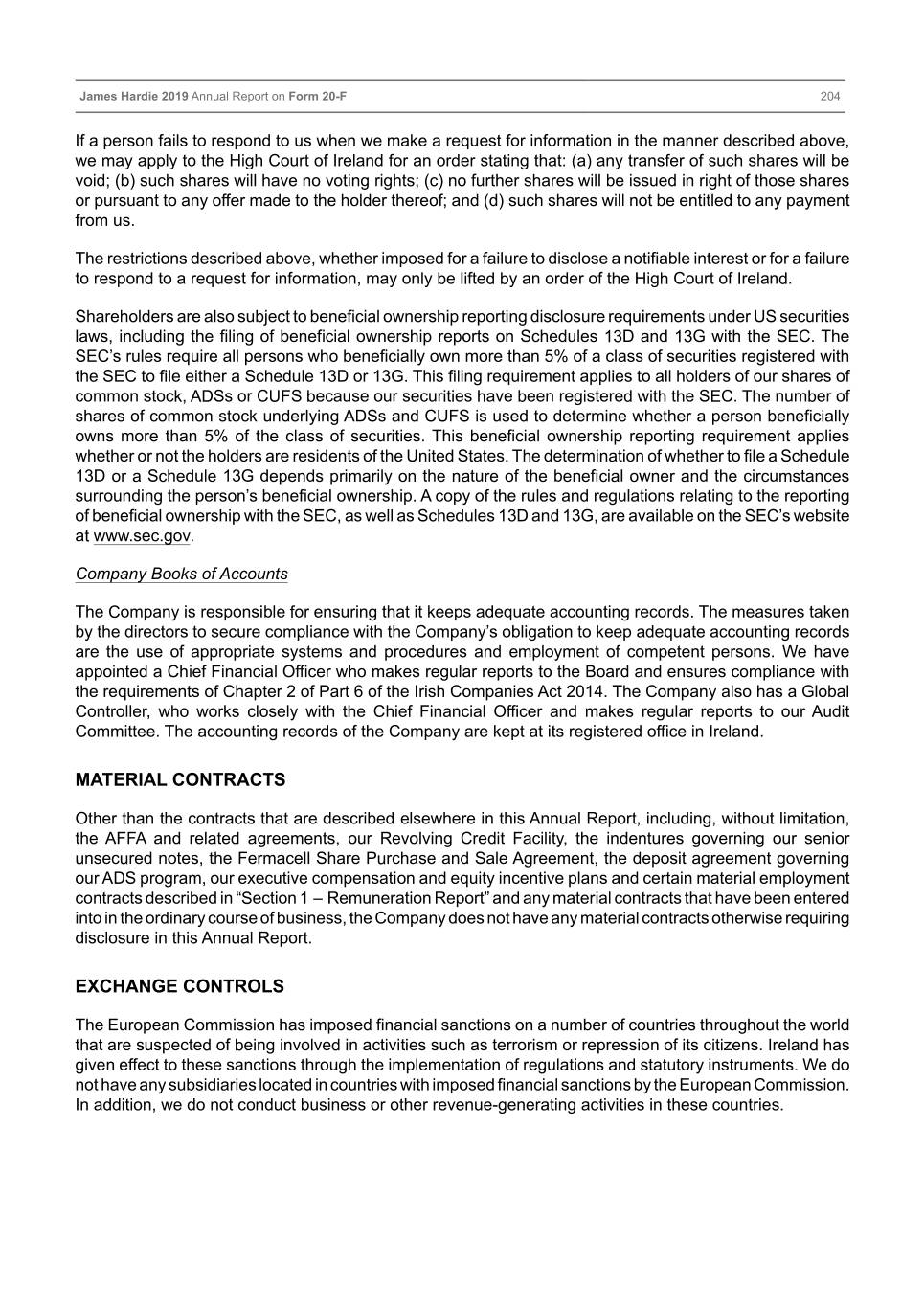
Table of Contents James Hardie 2019 Annual Report on Form 20-F 204 If a person fails to respond to us when we make a request for information in the manner described above, we may apply to the High Court of Ireland for an order stating that: (a) any transfer of such shares will be void; (b) such shares will have no voting rights; (c) no further shares will be issued in right of those shares or pursuant to any offer made to the holder thereof; and (d) such shares will not be entitled to any payment from us. The restrictions described above, whether imposed for a failure to disclose a notifiable interest or for a failure to respond to a request for information, may only be lifted by an order of the High Court of Ireland. Shareholders are also subject to beneficial ownership reporting disclosure requirements under US securities laws, including the filing of beneficial ownership reports on Schedules 13D and 13G with the SEC. The SEC’s rules require all persons who beneficially own more than 5% of a class of securities registered with the SEC to file either a Schedule 13D or 13G. This filing requirement applies to all holders of our shares of common stock, ADSs or CUFS because our securities have been registered with the SEC. The number of shares of common stock underlying ADSs and CUFS is used to determine whether a person beneficially owns more than 5% of the class of securities. This beneficial ownership reporting requirement applies whether or not the holders are residents of the United States. The determination of whether to file a Schedule 13D or a Schedule 13G depends primarily on the nature of the beneficial owner and the circumstances surrounding the person’s beneficial ownership. A copy of the rules and regulations relating to the reporting of beneficial ownership with the SEC, as well as Schedules 13D and 13G, are available on the SEC’s website at www.sec.gov. Company Books of Accounts The Company is responsible for ensuring that it keeps adequate accounting records. The measures taken by the directors to secure compliance with the Company’s obligation to keep adequate accounting records are the use of appropriate systems and procedures and employment of competent persons. We have appointed a Chief Financial Officer who makes regular reports to the Board and ensures compliance with the requirements of Chapter 2 of Part 6 of the Irish Companies Act 2014. The Company also has a Global Controller, who works closely with the Chief Financial Officer and makes regular reports to our Audit Committee. The accounting records of the Company are kept at its registered office in Ireland. MATERIAL CONTRACTS Other than the contracts that are described elsewhere in this Annual Report, including, without limitation, the AFFA and related agreements, our Revolving Credit Facility, the indentures governing our senior unsecured notes, the Fermacell Share Purchase and Sale Agreement, the deposit agreement governing our ADS program, our executive compensation and equity incentive plans and certain material employment contracts described in “Section 1 – Remuneration Report” and any material contracts that have been entered into in the ordinary course of business, the Company does not have any material contracts otherwise requiring disclosure in this Annual Report. EXCHANGE CONTROLS The European Commission has imposed financial sanctions on a number of countries throughout the world that are suspected of being involved in activities such as terrorism or repression of its citizens. Ireland has given effect to these sanctions through the implementation of regulations and statutory instruments. We do not have any subsidiaries located in countries with imposed financial sanctions by the European Commission. In addition, we do not conduct business or other revenue-generating activities in these countries.
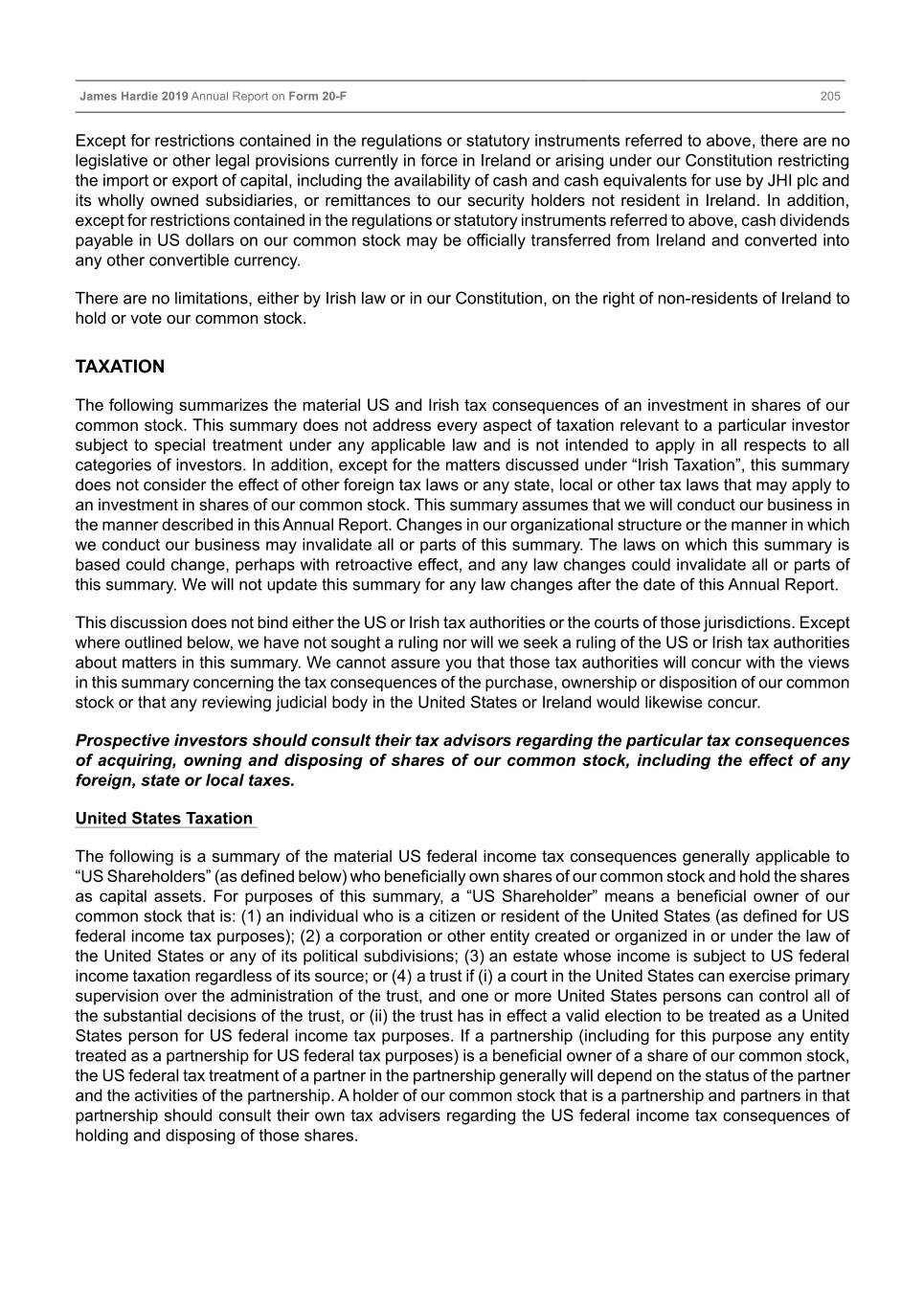
Table of Contents James Hardie 2019 Annual Report on Form 20-F 205 Except for restrictions contained in the regulations or statutory instruments referred to above, there are no legislative or other legal provisions currently in force in Ireland or arising under our Constitution restricting the import or export of capital, including the availability of cash and cash equivalents for use by JHI plc and its wholly owned subsidiaries, or remittances to our security holders not resident in Ireland. In addition, except for restrictions contained in the regulations or statutory instruments referred to above, cash dividends payable in US dollars on our common stock may be officially transferred from Ireland and converted into any other convertible currency. There are no limitations, either by Irish law or in our Constitution, on the right of non-residents of Ireland to hold or vote our common stock. TAXATION The following summarizes the material US and Irish tax consequences of an investment in shares of our common stock. This summary does not address every aspect of taxation relevant to a particular investor subject to special treatment under any applicable law and is not intended to apply in all respects to all categories of investors. In addition, except for the matters discussed under “Irish Taxation”, this summary does not consider the effect of other foreign tax laws or any state, local or other tax laws that may apply to an investment in shares of our common stock. This summary assumes that we will conduct our business in the manner described in this Annual Report. Changes in our organizational structure or the manner in which we conduct our business may invalidate all or parts of this summary. The laws on which this summary is based could change, perhaps with retroactive effect, and any law changes could invalidate all or parts of this summary. We will not update this summary for any law changes after the date of this Annual Report. This discussion does not bind either the US or Irish tax authorities or the courts of those jurisdictions. Except where outlined below, we have not sought a ruling nor will we seek a ruling of the US or Irish tax authorities about matters in this summary. We cannot assure you that those tax authorities will concur with the views in this summary concerning the tax consequences of the purchase, ownership or disposition of our common stock or that any reviewing judicial body in the United States or Ireland would likewise concur. Prospective investors should consult their tax advisors regarding the particular tax consequences of acquiring, owning and disposing of shares of our common stock, including the effect of any foreign, state or local taxes. United States Taxation The following is a summary of the material US federal income tax consequences generally applicable to “US Shareholders” (as defined below) who beneficially own shares of our common stock and hold the shares as capital assets. For purposes of this summary, a “US Shareholder” means a beneficial owner of our common stock that is: (1) an individual who is a citizen or resident of the United States (as defined for US federal income tax purposes); (2) a corporation or other entity created or organized in or under the law of the United States or any of its political subdivisions; (3) an estate whose income is subject to US federal income taxation regardless of its source; or (4) a trust if (i) a court in the United States can exercise primary supervision over the administration of the trust, and one or more United States persons can control all of the substantial decisions of the trust, or (ii) the trust has in effect a valid election to be treated as a United States person for US federal income tax purposes. If a partnership (including for this purpose any entity treated as a partnership for US federal tax purposes) is a beneficial owner of a share of our common stock, the US federal tax treatment of a partner in the partnership generally will depend on the status of the partner and the activities of the partnership. A holder of our common stock that is a partnership and partners in that partnership should consult their own tax advisers regarding the US federal income tax consequences of holding and disposing of those shares.
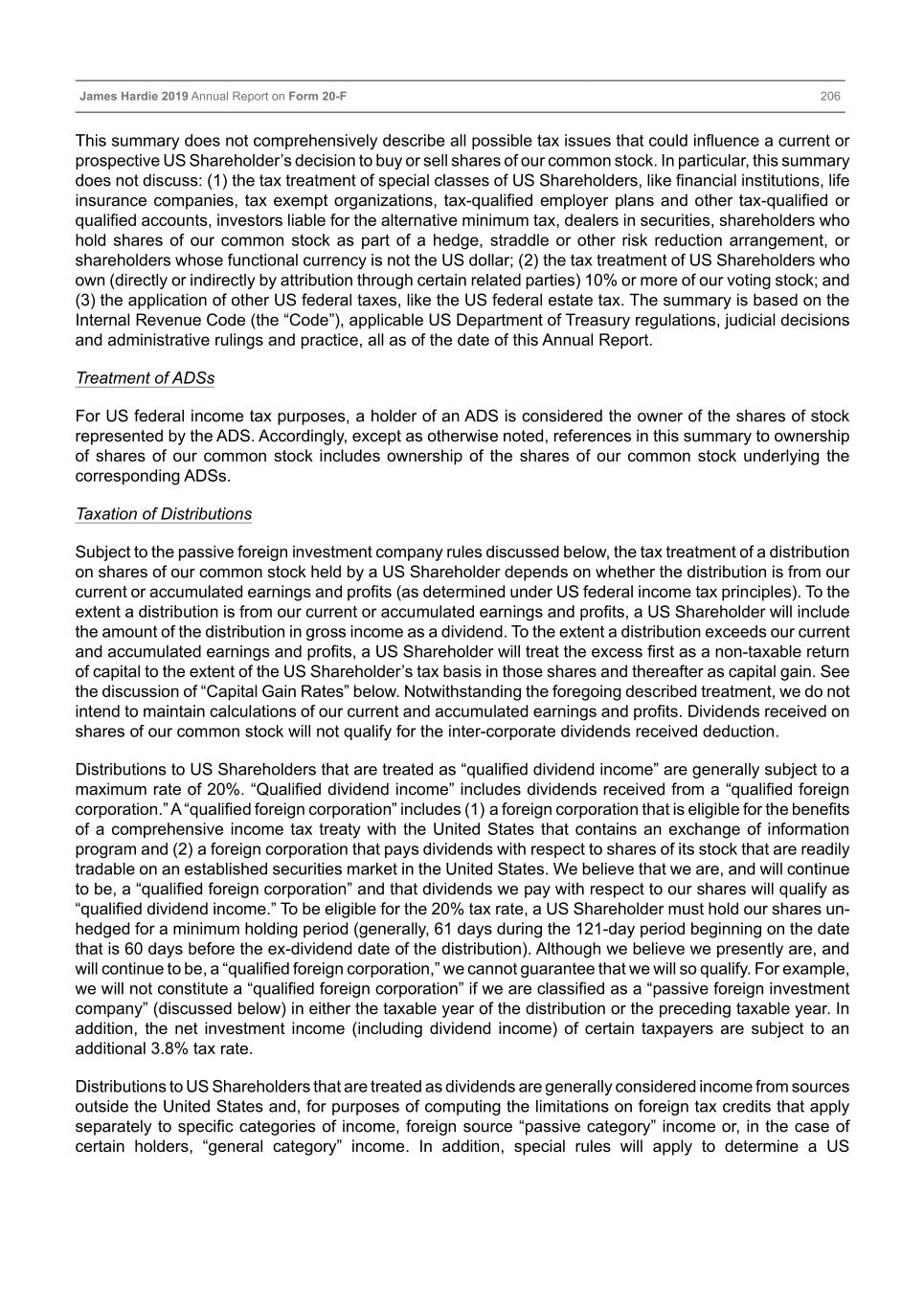
Table of Contents James Hardie 2019 Annual Report on Form 20-F 206 This summary does not comprehensively describe all possible tax issues that could influence a current or prospective US Shareholder’s decision to buy or sell shares of our common stock. In particular, this summary does not discuss: (1) the tax treatment of special classes of US Shareholders, like financial institutions, life insurance companies, tax exempt organizations, tax-qualified employer plans and other tax-qualified or qualified accounts, investors liable for the alternative minimum tax, dealers in securities, shareholders who hold shares of our common stock as part of a hedge, straddle or other risk reduction arrangement, or shareholders whose functional currency is not the US dollar; (2) the tax treatment of US Shareholders who own (directly or indirectly by attribution through certain related parties) 10% or more of our voting stock; and (3) the application of other US federal taxes, like the US federal estate tax. The summary is based on the Internal Revenue Code (the “Code”), applicable US Department of Treasury regulations, judicial decisions and administrative rulings and practice, all as of the date of this Annual Report. Treatment of ADSs For US federal income tax purposes, a holder of an ADS is considered the owner of the shares of stock represented by the ADS. Accordingly, except as otherwise noted, references in this summary to ownership of shares of our common stock includes ownership of the shares of our common stock underlying the corresponding ADSs. Taxation of Distributions Subject to the passive foreign investment company rules discussed below, the tax treatment of a distribution on shares of our common stock held by a US Shareholder depends on whether the distribution is from our current or accumulated earnings and profits (as determined under US federal income tax principles). To the extent a distribution is from our current or accumulated earnings and profits, a US Shareholder will include the amount of the distribution in gross income as a dividend. To the extent a distribution exceeds our current and accumulated earnings and profits, a US Shareholder will treat the excess first as a non-taxable return of capital to the extent of the US Shareholder’s tax basis in those shares and thereafter as capital gain. See the discussion of “Capital Gain Rates” below. Notwithstanding the foregoing described treatment, we do not intend to maintain calculations of our current and accumulated earnings and profits. Dividends received on shares of our common stock will not qualify for the inter-corporate dividends received deduction. Distributions to US Shareholders that are treated as “qualified dividend income” are generally subject to a maximum rate of 20%. “Qualified dividend income” includes dividends received from a “qualified foreign corporation.” A “qualified foreign corporation” includes (1) a foreign corporation that is eligible for the benefits of a comprehensive income tax treaty with the United States that contains an exchange of information program and (2) a foreign corporation that pays dividends with respect to shares of its stock that are readily tradable on an established securities market in the United States. We believe that we are, and will continue to be, a “qualified foreign corporation” and that dividends we pay with respect to our shares will qualify as “qualified dividend income.” To be eligible for the 20% tax rate, a US Shareholder must hold our shares un- hedged for a minimum holding period (generally, 61 days during the 121-day period beginning on the date that is 60 days before the ex-dividend date of the distribution). Although we believe we presently are, and will continue to be, a “qualified foreign corporation,” we cannot guarantee that we will so qualify. For example, we will not constitute a “qualified foreign corporation” if we are classified as a “passive foreign investment company” (discussed below) in either the taxable year of the distribution or the preceding taxable year. In addition, the net investment income (including dividend income) of certain taxpayers are subject to an additional 3.8% tax rate. Distributions to US Shareholders that are treated as dividends are generally considered income from sources outside the United States and, for purposes of computing the limitations on foreign tax credits that apply separately to specific categories of income, foreign source “passive category” income or, in the case of certain holders, “general category” income. In addition, special rules will apply to determine a US
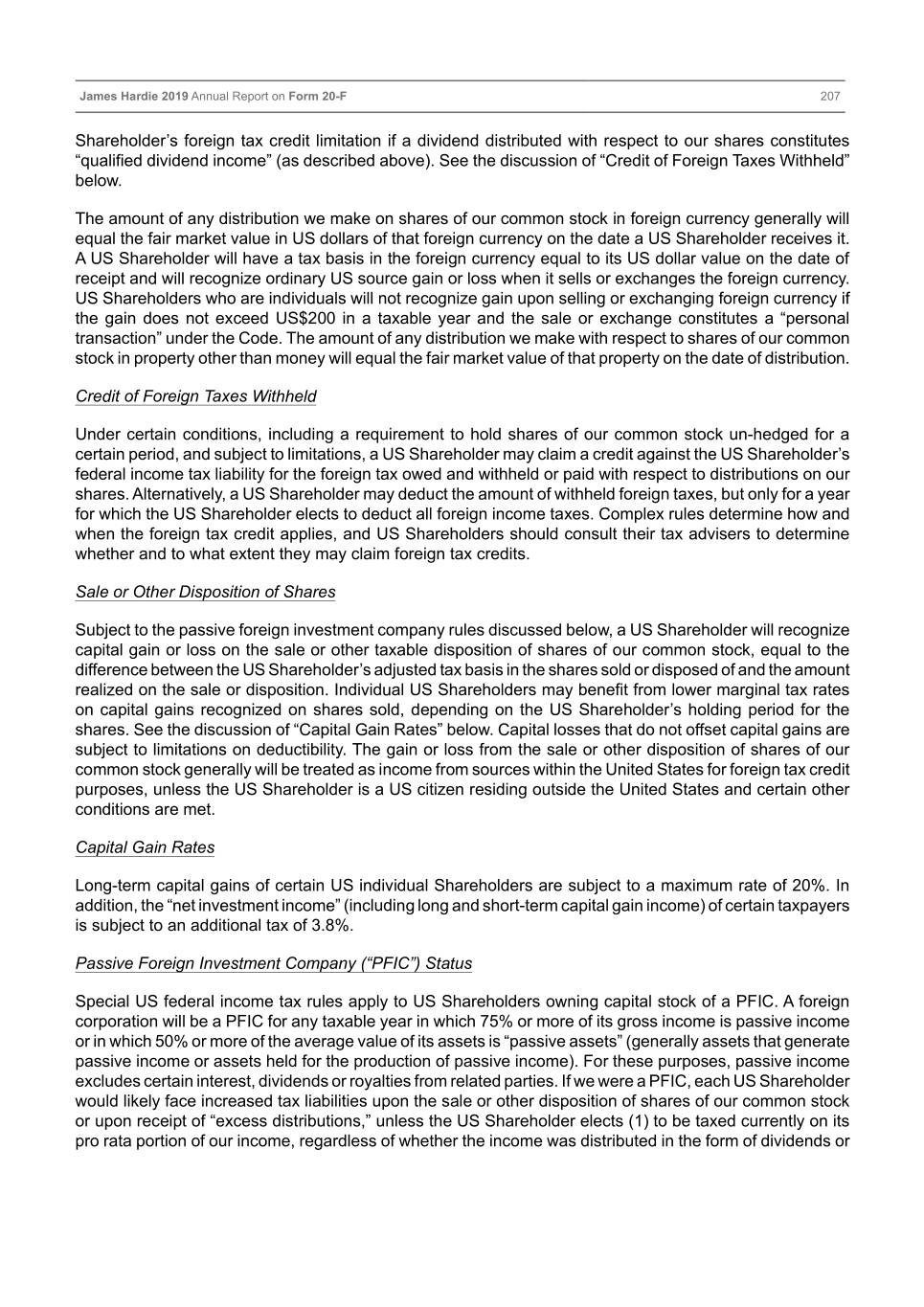
Table of Contents James Hardie 2019 Annual Report on Form 20-F 207 Shareholder’s foreign tax credit limitation if a dividend distributed with respect to our shares constitutes “qualified dividend income” (as described above). See the discussion of “Credit of Foreign Taxes Withheld” below. The amount of any distribution we make on shares of our common stock in foreign currency generally will equal the fair market value in US dollars of that foreign currency on the date a US Shareholder receives it. A US Shareholder will have a tax basis in the foreign currency equal to its US dollar value on the date of receipt and will recognize ordinary US source gain or loss when it sells or exchanges the foreign currency. US Shareholders who are individuals will not recognize gain upon selling or exchanging foreign currency if the gain does not exceed US$200 in a taxable year and the sale or exchange constitutes a “personal transaction” under the Code. The amount of any distribution we make with respect to shares of our common stock in property other than money will equal the fair market value of that property on the date of distribution. Credit of Foreign Taxes Withheld Under certain conditions, including a requirement to hold shares of our common stock un-hedged for a certain period, and subject to limitations, a US Shareholder may claim a credit against the US Shareholder’s federal income tax liability for the foreign tax owed and withheld or paid with respect to distributions on our shares. Alternatively, a US Shareholder may deduct the amount of withheld foreign taxes, but only for a year for which the US Shareholder elects to deduct all foreign income taxes. Complex rules determine how and when the foreign tax credit applies, and US Shareholders should consult their tax advisers to determine whether and to what extent they may claim foreign tax credits. Sale or Other Disposition of Shares Subject to the passive foreign investment company rules discussed below, a US Shareholder will recognize capital gain or loss on the sale or other taxable disposition of shares of our common stock, equal to the difference between the US Shareholder’s adjusted tax basis in the shares sold or disposed of and the amount realized on the sale or disposition. Individual US Shareholders may benefit from lower marginal tax rates on capital gains recognized on shares sold, depending on the US Shareholder’s holding period for the shares. See the discussion of “Capital Gain Rates” below. Capital losses that do not offset capital gains are subject to limitations on deductibility. The gain or loss from the sale or other disposition of shares of our common stock generally will be treated as income from sources within the United States for foreign tax credit purposes, unless the US Shareholder is a US citizen residing outside the United States and certain other conditions are met. Capital Gain Rates Long-term capital gains of certain US individual Shareholders are subject to a maximum rate of 20%. In addition, the “net investment income” (including long and short-term capital gain income) of certain taxpayers is subject to an additional tax of 3.8%. Passive Foreign Investment Company (“PFIC”) Status Special US federal income tax rules apply to US Shareholders owning capital stock of a PFIC. A foreign corporation will be a PFIC for any taxable year in which 75% or more of its gross income is passive income or in which 50% or more of the average value of its assets is “passive assets” (generally assets that generate passive income or assets held for the production of passive income). For these purposes, passive income excludes certain interest, dividends or royalties from related parties. If we were a PFIC, each US Shareholder would likely face increased tax liabilities upon the sale or other disposition of shares of our common stock or upon receipt of “excess distributions,” unless the US Shareholder elects (1) to be taxed currently on its pro rata portion of our income, regardless of whether the income was distributed in the form of dividends or
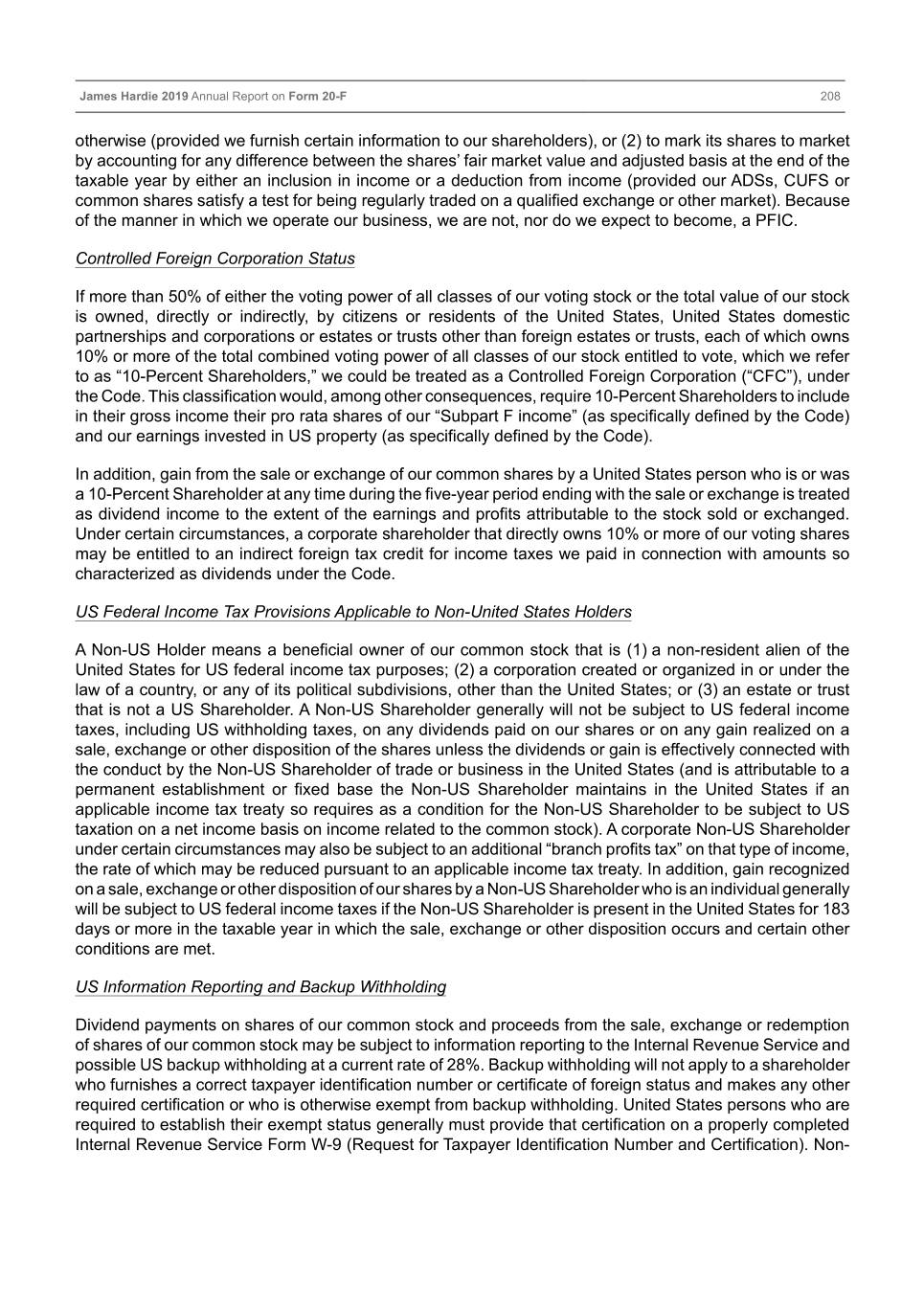
Table of Contents James Hardie 2019 Annual Report on Form 20-F 208 otherwise (provided we furnish certain information to our shareholders), or (2) to mark its shares to market by accounting for any difference between the shares’ fair market value and adjusted basis at the end of the taxable year by either an inclusion in income or a deduction from income (provided our ADSs, CUFS or common shares satisfy a test for being regularly traded on a qualified exchange or other market). Because of the manner in which we operate our business, we are not, nor do we expect to become, a PFIC. Controlled Foreign Corporation Status If more than 50% of either the voting power of all classes of our voting stock or the total value of our stock is owned, directly or indirectly, by citizens or residents of the United States, United States domestic partnerships and corporations or estates or trusts other than foreign estates or trusts, each of which owns 10% or more of the total combined voting power of all classes of our stock entitled to vote, which we refer to as “10-Percent Shareholders,” we could be treated as a Controlled Foreign Corporation (“CFC”), under the Code. This classification would, among other consequences, require 10-Percent Shareholders to include in their gross income their pro rata shares of our “Subpart F income” (as specifically defined by the Code) and our earnings invested in US property (as specifically defined by the Code). In addition, gain from the sale or exchange of our common shares by a United States person who is or was a 10-Percent Shareholder at any time during the five-year period ending with the sale or exchange is treated as dividend income to the extent of the earnings and profits attributable to the stock sold or exchanged. Under certain circumstances, a corporate shareholder that directly owns 10% or more of our voting shares may be entitled to an indirect foreign tax credit for income taxes we paid in connection with amounts so characterized as dividends under the Code. US Federal Income Tax Provisions Applicable to Non-United States Holders A Non-US Holder means a beneficial owner of our common stock that is (1) a non-resident alien of the United States for US federal income tax purposes; (2) a corporation created or organized in or under the law of a country, or any of its political subdivisions, other than the United States; or (3) an estate or trust that is not a US Shareholder. A Non-US Shareholder generally will not be subject to US federal income taxes, including US withholding taxes, on any dividends paid on our shares or on any gain realized on a sale, exchange or other disposition of the shares unless the dividends or gain is effectively connected with the conduct by the Non-US Shareholder of trade or business in the United States (and is attributable to a permanent establishment or fixed base the Non-US Shareholder maintains in the United States if an applicable income tax treaty so requires as a condition for the Non-US Shareholder to be subject to US taxation on a net income basis on income related to the common stock). A corporate Non-US Shareholder under certain circumstances may also be subject to an additional “branch profits tax” on that type of income, the rate of which may be reduced pursuant to an applicable income tax treaty. In addition, gain recognized on a sale, exchange or other disposition of our shares by a Non-US Shareholder who is an individual generally will be subject to US federal income taxes if the Non-US Shareholder is present in the United States for 183 days or more in the taxable year in which the sale, exchange or other disposition occurs and certain other conditions are met. US Information Reporting and Backup Withholding Dividend payments on shares of our common stock and proceeds from the sale, exchange or redemption of shares of our common stock may be subject to information reporting to the Internal Revenue Service and possible US backup withholding at a current rate of 28%. Backup withholding will not apply to a shareholder who furnishes a correct taxpayer identification number or certificate of foreign status and makes any other required certification or who is otherwise exempt from backup withholding. United States persons who are required to establish their exempt status generally must provide that certification on a properly completed Internal Revenue Service Form W-9 (Request for Taxpayer Identification Number and Certification). Non-
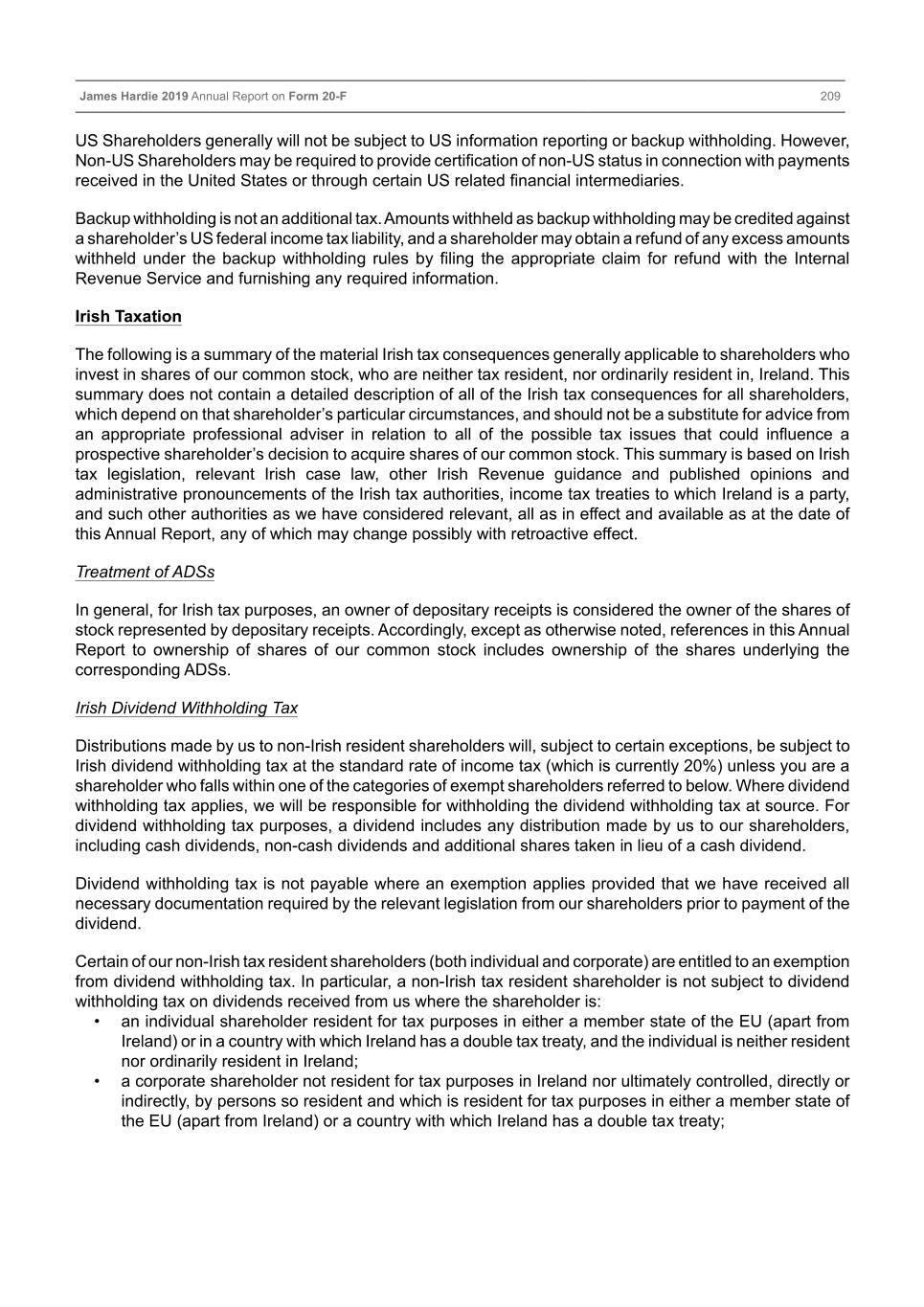
Table of Contents James Hardie 2019 Annual Report on Form 20-F 209 US Shareholders generally will not be subject to US information reporting or backup withholding. However, Non-US Shareholders may be required to provide certification of non-US status in connection with payments received in the United States or through certain US related financial intermediaries. Backup withholding is not an additional tax. Amounts withheld as backup withholding may be credited against a shareholder’s US federal income tax liability, and a shareholder may obtain a refund of any excess amounts withheld under the backup withholding rules by filing the appropriate claim for refund with the Internal Revenue Service and furnishing any required information. Irish Taxation The following is a summary of the material Irish tax consequences generally applicable to shareholders who invest in shares of our common stock, who are neither tax resident, nor ordinarily resident in, Ireland. This summary does not contain a detailed description of all of the Irish tax consequences for all shareholders, which depend on that shareholder’s particular circumstances, and should not be a substitute for advice from an appropriate professional adviser in relation to all of the possible tax issues that could influence a prospective shareholder’s decision to acquire shares of our common stock. This summary is based on Irish tax legislation, relevant Irish case law, other Irish Revenue guidance and published opinions and administrative pronouncements of the Irish tax authorities, income tax treaties to which Ireland is a party, and such other authorities as we have considered relevant, all as in effect and available as at the date of this Annual Report, any of which may change possibly with retroactive effect. Treatment of ADSs In general, for Irish tax purposes, an owner of depositary receipts is considered the owner of the shares of stock represented by depositary receipts. Accordingly, except as otherwise noted, references in this Annual Report to ownership of shares of our common stock includes ownership of the shares underlying the corresponding ADSs. Irish Dividend Withholding Tax Distributions made by us to non-Irish resident shareholders will, subject to certain exceptions, be subject to Irish dividend withholding tax at the standard rate of income tax (which is currently 20%) unless you are a shareholder who falls within one of the categories of exempt shareholders referred to below. Where dividend withholding tax applies, we will be responsible for withholding the dividend withholding tax at source. For dividend withholding tax purposes, a dividend includes any distribution made by us to our shareholders, including cash dividends, non-cash dividends and additional shares taken in lieu of a cash dividend. Dividend withholding tax is not payable where an exemption applies provided that we have received all necessary documentation required by the relevant legislation from our shareholders prior to payment of the dividend. Certain of our non-Irish tax resident shareholders (both individual and corporate) are entitled to an exemption from dividend withholding tax. In particular, a non-Irish tax resident shareholder is not subject to dividend withholding tax on dividends received from us where the shareholder is: • an individual shareholder resident for tax purposes in either a member state of the EU (apart from Ireland) or in a country with which Ireland has a double tax treaty, and the individual is neither resident nor ordinarily resident in Ireland; • a corporate shareholder not resident for tax purposes in Ireland nor ultimately controlled, directly or indirectly, by persons so resident and which is resident for tax purposes in either a member state of the EU (apart from Ireland) or a country with which Ireland has a double tax treaty;
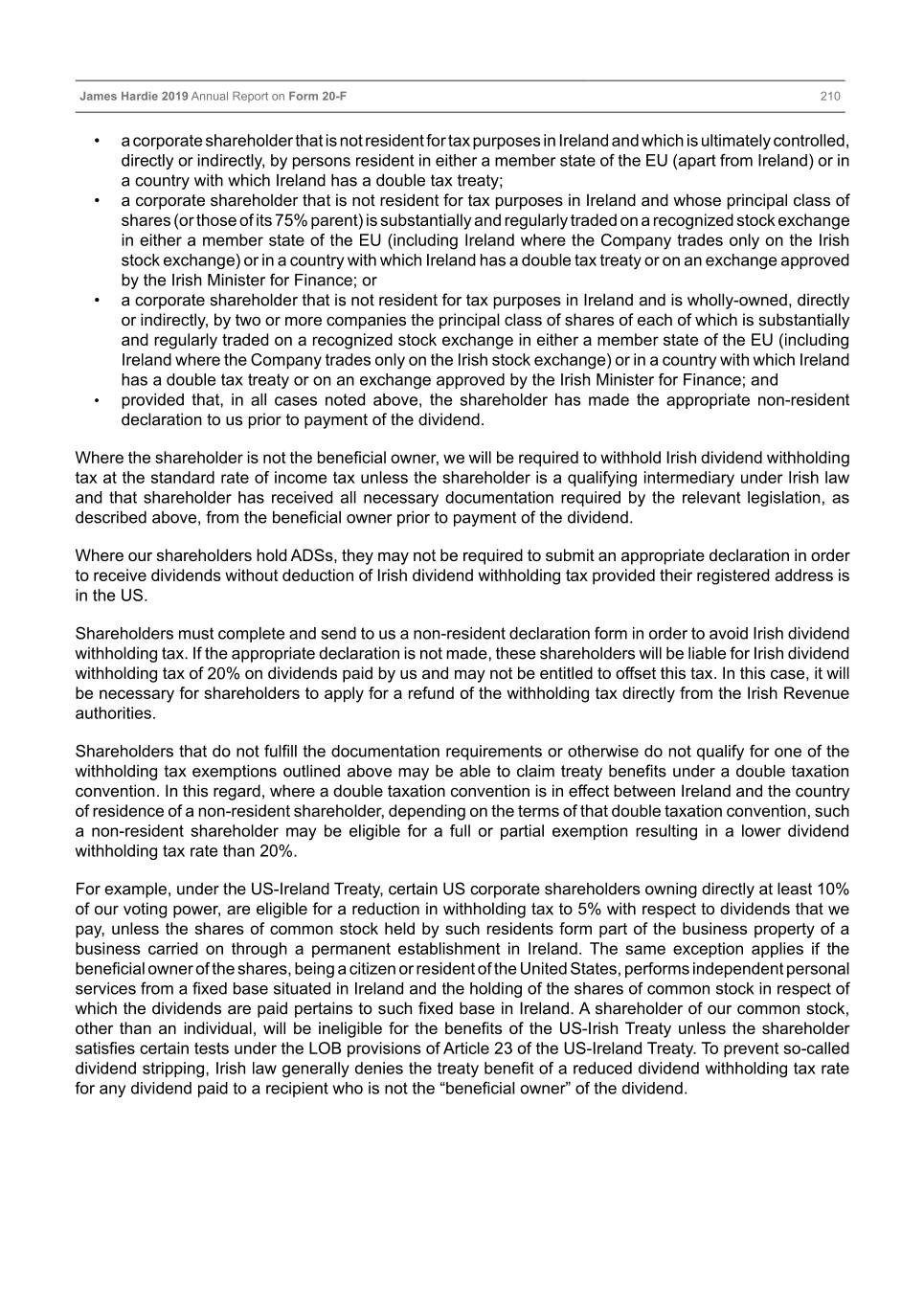
Table of Contents James Hardie 2019 Annual Report on Form 20-F 210 • a corporate shareholder that is not resident for tax purposes in Ireland and which is ultimately controlled, directly or indirectly, by persons resident in either a member state of the EU (apart from Ireland) or in a country with which Ireland has a double tax treaty; • a corporate shareholder that is not resident for tax purposes in Ireland and whose principal class of shares (or those of its 75% parent) is substantially and regularly traded on a recognized stock exchange in either a member state of the EU (including Ireland where the Company trades only on the Irish stock exchange) or in a country with which Ireland has a double tax treaty or on an exchange approved by the Irish Minister for Finance; or • a corporate shareholder that is not resident for tax purposes in Ireland and is wholly-owned, directly or indirectly, by two or more companies the principal class of shares of each of which is substantially and regularly traded on a recognized stock exchange in either a member state of the EU (including Ireland where the Company trades only on the Irish stock exchange) or in a country with which Ireland has a double tax treaty or on an exchange approved by the Irish Minister for Finance; and • provided that, in all cases noted above, the shareholder has made the appropriate non-resident declaration to us prior to payment of the dividend. Where the shareholder is not the beneficial owner, we will be required to withhold Irish dividend withholding tax at the standard rate of income tax unless the shareholder is a qualifying intermediary under Irish law and that shareholder has received all necessary documentation required by the relevant legislation, as described above, from the beneficial owner prior to payment of the dividend. Where our shareholders hold ADSs, they may not be required to submit an appropriate declaration in order to receive dividends without deduction of Irish dividend withholding tax provided their registered address is in the US. Shareholders must complete and send to us a non-resident declaration form in order to avoid Irish dividend withholding tax. If the appropriate declaration is not made, these shareholders will be liable for Irish dividend withholding tax of 20% on dividends paid by us and may not be entitled to offset this tax. In this case, it will be necessary for shareholders to apply for a refund of the withholding tax directly from the Irish Revenue authorities. Shareholders that do not fulfill the documentation requirements or otherwise do not qualify for one of the withholding tax exemptions outlined above may be able to claim treaty benefits under a double taxation convention. In this regard, where a double taxation convention is in effect between Ireland and the country of residence of a non-resident shareholder, depending on the terms of that double taxation convention, such a non-resident shareholder may be eligible for a full or partial exemption resulting in a lower dividend withholding tax rate than 20%. For example, under the US-Ireland Treaty, certain US corporate shareholders owning directly at least 10% of our voting power, are eligible for a reduction in withholding tax to 5% with respect to dividends that we pay, unless the shares of common stock held by such residents form part of the business property of a business carried on through a permanent establishment in Ireland. The same exception applies if the beneficial owner of the shares, being a citizen or resident of the United States, performs independent personal services from a fixed base situated in Ireland and the holding of the shares of common stock in respect of which the dividends are paid pertains to such fixed base in Ireland. A shareholder of our common stock, other than an individual, will be ineligible for the benefits of the US-Irish Treaty unless the shareholder satisfies certain tests under the LOB provisions of Article 23 of the US-Ireland Treaty. To prevent so-called dividend stripping, Irish law generally denies the treaty benefit of a reduced dividend withholding tax rate for any dividend paid to a recipient who is not the “beneficial owner” of the dividend.
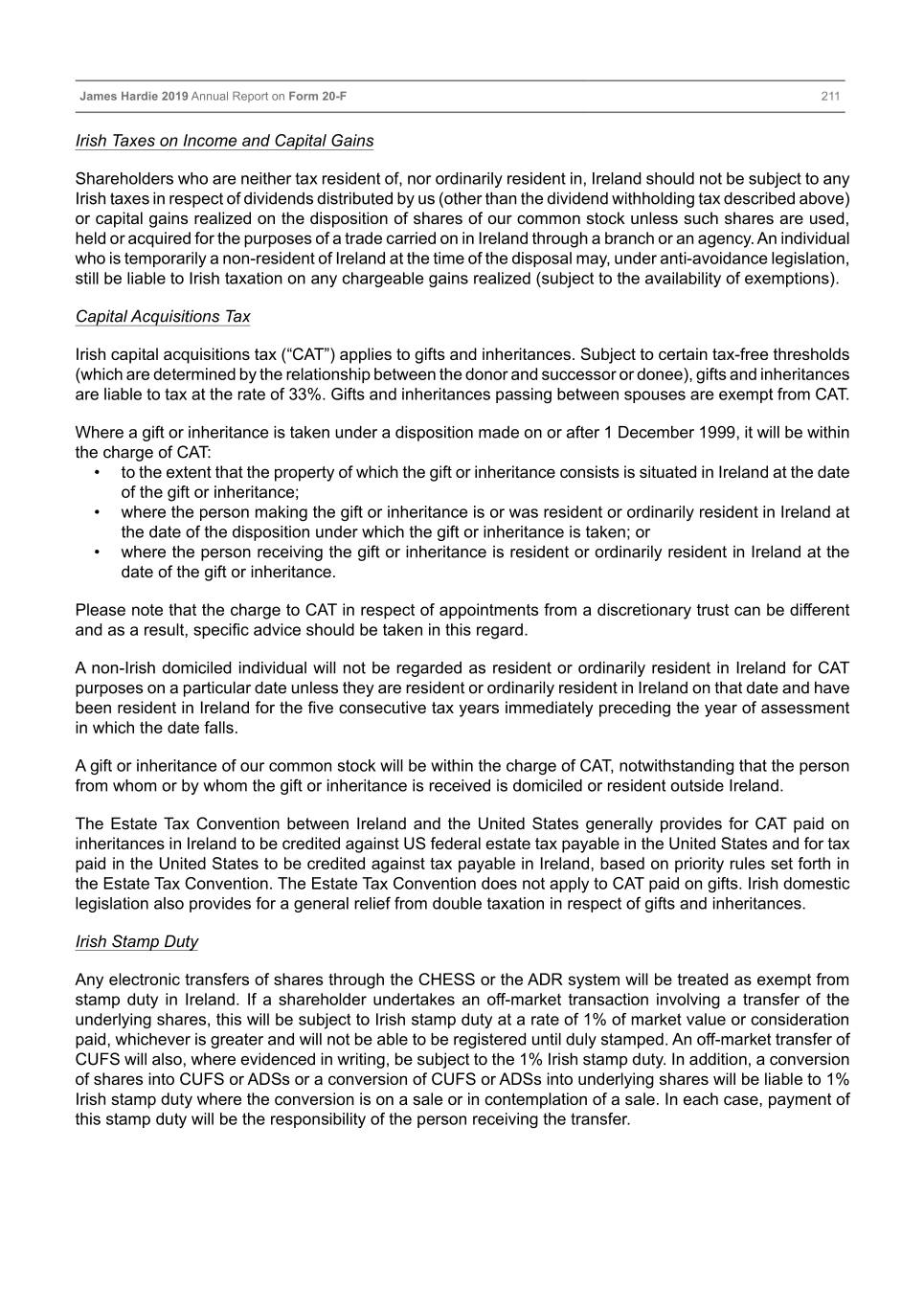
Table of Contents James Hardie 2019 Annual Report on Form 20-F 211 Irish Taxes on Income and Capital Gains Shareholders who are neither tax resident of, nor ordinarily resident in, Ireland should not be subject to any Irish taxes in respect of dividends distributed by us (other than the dividend withholding tax described above) or capital gains realized on the disposition of shares of our common stock unless such shares are used, held or acquired for the purposes of a trade carried on in Ireland through a branch or an agency. An individual who is temporarily a non-resident of Ireland at the time of the disposal may, under anti-avoidance legislation, still be liable to Irish taxation on any chargeable gains realized (subject to the availability of exemptions). Capital Acquisitions Tax Irish capital acquisitions tax (“CAT”) applies to gifts and inheritances. Subject to certain tax-free thresholds (which are determined by the relationship between the donor and successor or donee), gifts and inheritances are liable to tax at the rate of 33%. Gifts and inheritances passing between spouses are exempt from CAT. Where a gift or inheritance is taken under a disposition made on or after 1 December 1999, it will be within the charge of CAT: • to the extent that the property of which the gift or inheritance consists is situated in Ireland at the date of the gift or inheritance; • where the person making the gift or inheritance is or was resident or ordinarily resident in Ireland at the date of the disposition under which the gift or inheritance is taken; or • where the person receiving the gift or inheritance is resident or ordinarily resident in Ireland at the date of the gift or inheritance. Please note that the charge to CAT in respect of appointments from a discretionary trust can be different and as a result, specific advice should be taken in this regard. A non-Irish domiciled individual will not be regarded as resident or ordinarily resident in Ireland for CAT purposes on a particular date unless they are resident or ordinarily resident in Ireland on that date and have been resident in Ireland for the five consecutive tax years immediately preceding the year of assessment in which the date falls. A gift or inheritance of our common stock will be within the charge of CAT, notwithstanding that the person from whom or by whom the gift or inheritance is received is domiciled or resident outside Ireland. The Estate Tax Convention between Ireland and the United States generally provides for CAT paid on inheritances in Ireland to be credited against US federal estate tax payable in the United States and for tax paid in the United States to be credited against tax payable in Ireland, based on priority rules set forth in the Estate Tax Convention. The Estate Tax Convention does not apply to CAT paid on gifts. Irish domestic legislation also provides for a general relief from double taxation in respect of gifts and inheritances. Irish Stamp Duty Any electronic transfers of shares through the CHESS or the ADR system will be treated as exempt from stamp duty in Ireland. If a shareholder undertakes an off-market transaction involving a transfer of the underlying shares, this will be subject to Irish stamp duty at a rate of 1% of market value or consideration paid, whichever is greater and will not be able to be registered until duly stamped. An off-market transfer of CUFS will also, where evidenced in writing, be subject to the 1% Irish stamp duty. In addition, a conversion of shares into CUFS or ADSs or a conversion of CUFS or ADSs into underlying shares will be liable to 1% Irish stamp duty where the conversion is on a sale or in contemplation of a sale. In each case, payment of this stamp duty will be the responsibility of the person receiving the transfer.
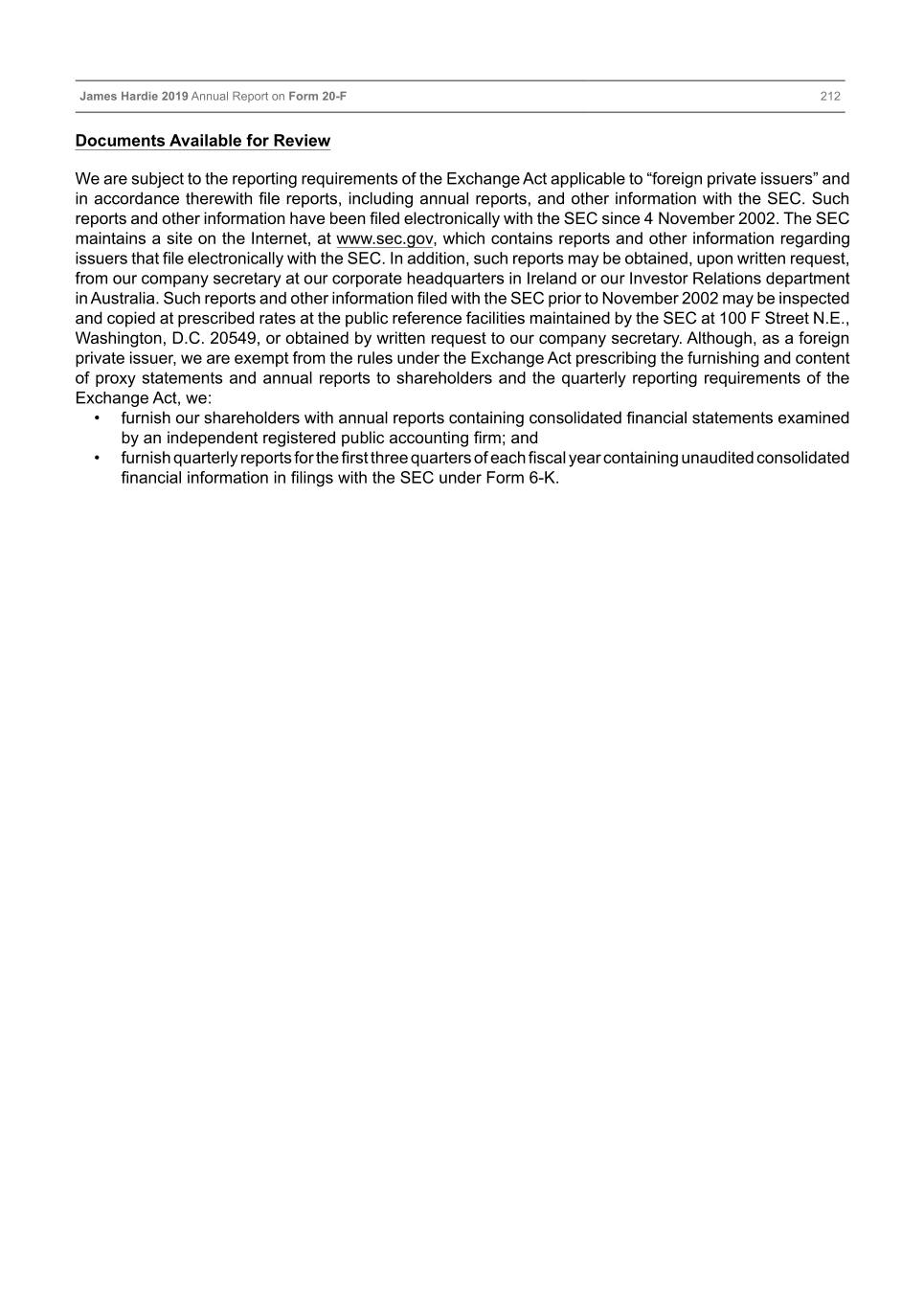
Table of Contents James Hardie 2019 Annual Report on Form 20-F 212 Documents Available for Review We are subject to the reporting requirements of the Exchange Act applicable to “foreign private issuers” and in accordance therewith file reports, including annual reports, and other information with the SEC. Such reports and other information have been filed electronically with the SEC since 4 November 2002. The SEC maintains a site on the Internet, at www.sec.gov, which contains reports and other information regarding issuers that file electronically with the SEC. In addition, such reports may be obtained, upon written request, from our company secretary at our corporate headquarters in Ireland or our Investor Relations department in Australia. Such reports and other information filed with the SEC prior to November 2002 may be inspected and copied at prescribed rates at the public reference facilities maintained by the SEC at 100 F Street N.E., Washington, D.C. 20549, or obtained by written request to our company secretary. Although, as a foreign private issuer, we are exempt from the rules under the Exchange Act prescribing the furnishing and content of proxy statements and annual reports to shareholders and the quarterly reporting requirements of the Exchange Act, we: • furnish our shareholders with annual reports containing consolidated financial statements examined by an independent registered public accounting firm; and • furnish quarterly reports for the first three quarters of each fiscal year containing unaudited consolidated financial information in filings with the SEC under Form 6-K.
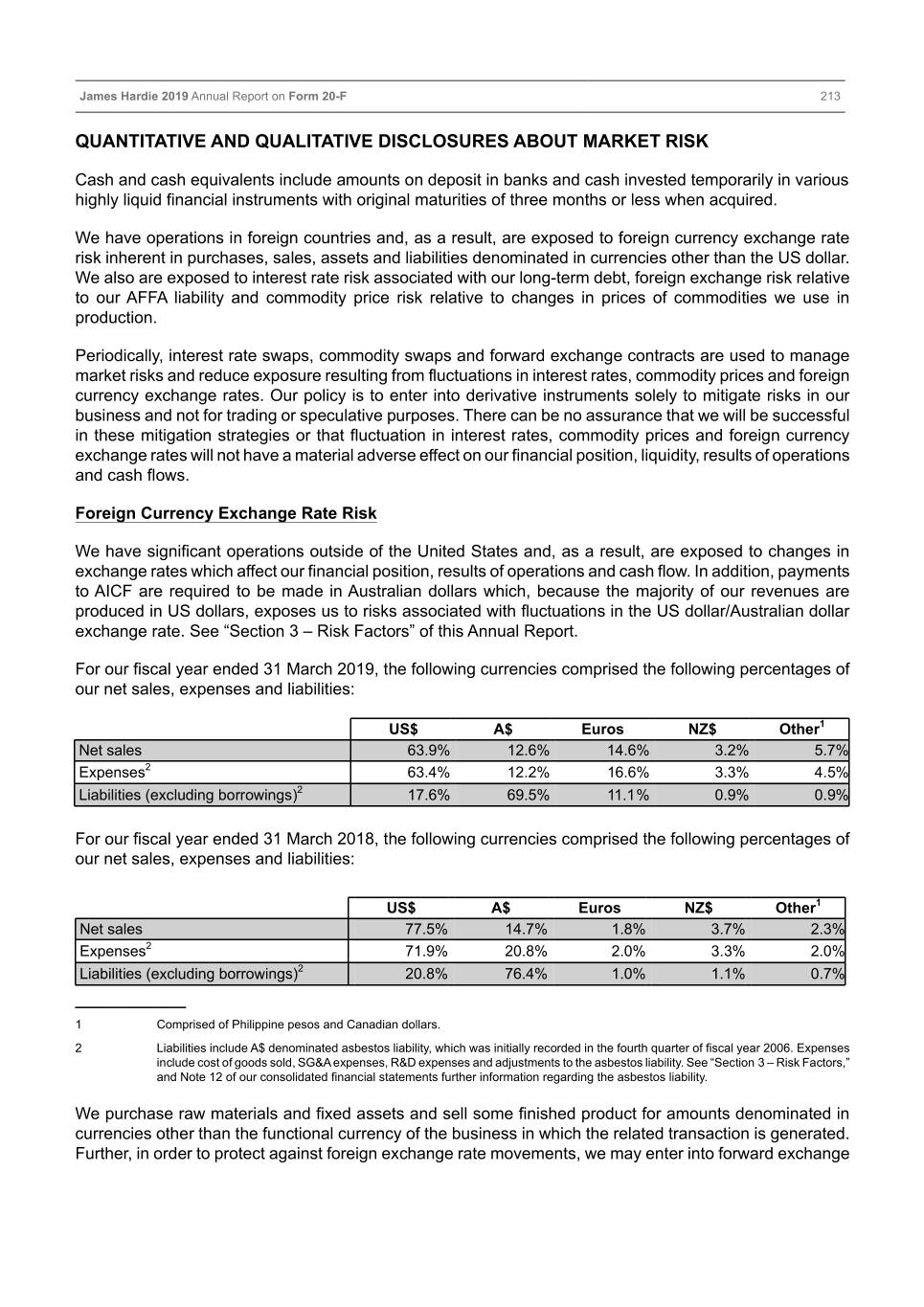
Table of Contents James Hardie 2019 Annual Report on Form 20-F 213 QUANTITATIVE AND QUALITATIVE DISCLOSURES ABOUT MARKET RISK Cash and cash equivalents include amounts on deposit in banks and cash invested temporarily in various highly liquid financial instruments with original maturities of three months or less when acquired. We have operations in foreign countries and, as a result, are exposed to foreign currency exchange rate risk inherent in purchases, sales, assets and liabilities denominated in currencies other than the US dollar. We also are exposed to interest rate risk associated with our long-term debt, foreign exchange risk relative to our AFFA liability and commodity price risk relative to changes in prices of commodities we use in production. Periodically, interest rate swaps, commodity swaps and forward exchange contracts are used to manage market risks and reduce exposure resulting from fluctuations in interest rates, commodity prices and foreign currency exchange rates. Our policy is to enter into derivative instruments solely to mitigate risks in our business and not for trading or speculative purposes. There can be no assurance that we will be successful in these mitigation strategies or that fluctuation in interest rates, commodity prices and foreign currency exchange rates will not have a material adverse effect on our financial position, liquidity, results of operations and cash flows. Foreign Currency Exchange Rate Risk We have significant operations outside of the United States and, as a result, are exposed to changes in exchange rates which affect our financial position, results of operations and cash flow. In addition, payments to AICF are required to be made in Australian dollars which, because the majority of our revenues are produced in US dollars, exposes us to risks associated with fluctuations in the US dollar/Australian dollar exchange rate. See “Section 3 – Risk Factors” of this Annual Report. For our fiscal year ended 31 March 2019, the following currencies comprised the following percentages of our net sales, expenses and liabilities: US$ A$ Euros NZ$ Other1 Net sales 63.9% 12.6% 14.6% 3.2% 5.7% Expenses2 63.4% 12.2% 16.6% 3.3% 4.5% Liabilities (excluding borrowings)2 17.6% 69.5% 11.1% 0.9% 0.9% For our fiscal year ended 31 March 2018, the following currencies comprised the following percentages of our net sales, expenses and liabilities: US$ A$ Euros NZ$ Other1 Net sales 77.5% 14.7% 1.8% 3.7% 2.3% Expenses2 71.9% 20.8% 2.0% 3.3% 2.0% Liabilities (excluding borrowings)2 20.8% 76.4% 1.0% 1.1% 0.7% ____________ 1 Comprised of Philippine pesos and Canadian dollars. 2 Liabilities include A$ denominated asbestos liability, which was initially recorded in the fourth quarter of fiscal year 2006. Expenses include cost of goods sold, SG&A expenses, R&D expenses and adjustments to the asbestos liability. See “Section 3 – Risk Factors,” and Note 12 of our consolidated financial statements further information regarding the asbestos liability. We purchase raw materials and fixed assets and sell some finished product for amounts denominated in currencies other than the functional currency of the business in which the related transaction is generated. Further, in order to protect against foreign exchange rate movements, we may enter into forward exchange
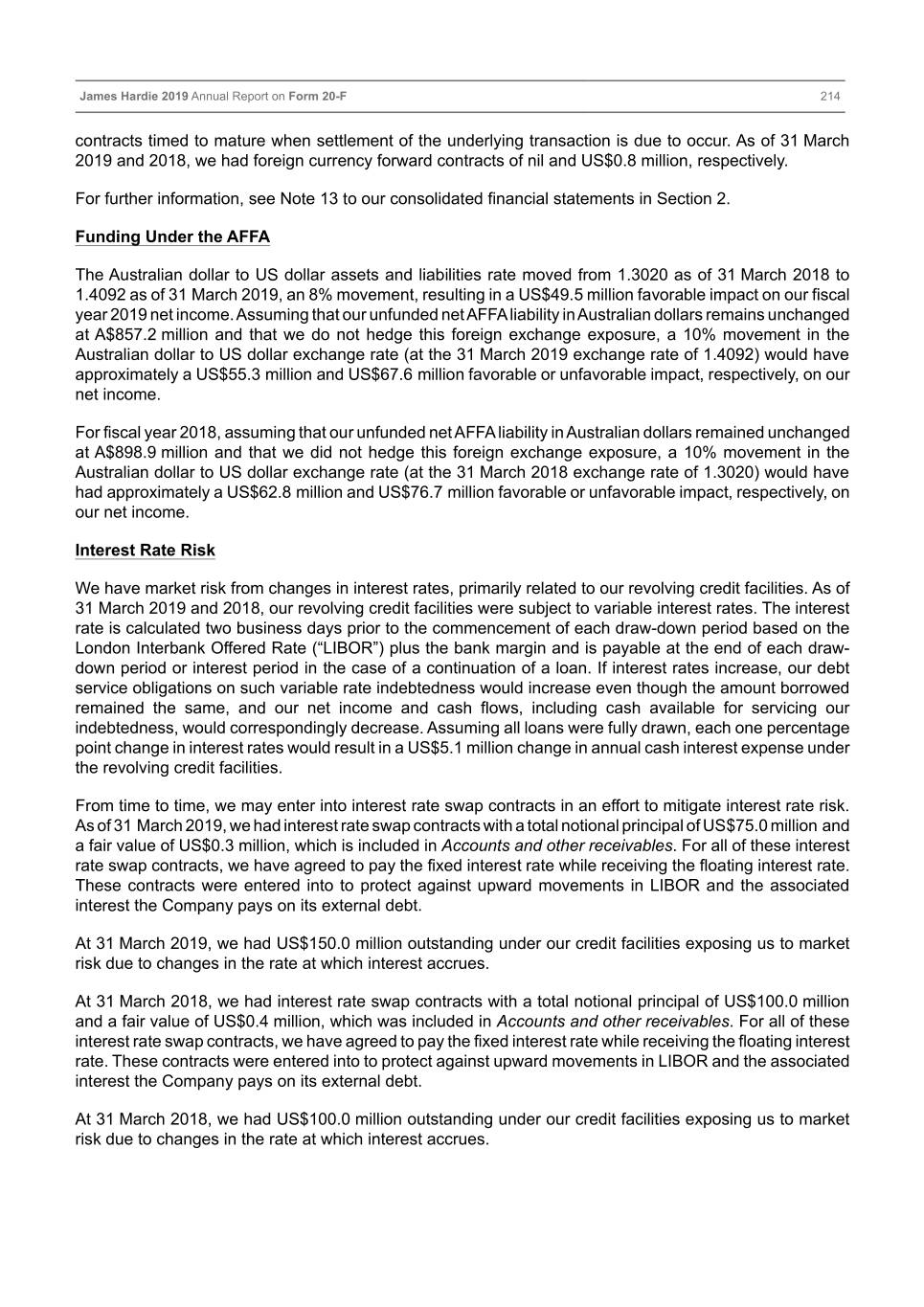
Table of Contents James Hardie 2019 Annual Report on Form 20-F 214 contracts timed to mature when settlement of the underlying transaction is due to occur. As of 31 March 2019 and 2018, we had foreign currency forward contracts of nil and US$0.8 million, respectively. For further information, see Note 13 to our consolidated financial statements in Section 2. Funding Under the AFFA The Australian dollar to US dollar assets and liabilities rate moved from 1.3020 as of 31 March 2018 to 1.4092 as of 31 March 2019, an 8% movement, resulting in a US$49.5 million favorable impact on our fiscal year 2019 net income. Assuming that our unfunded net AFFA liability in Australian dollars remains unchanged at A$857.2 million and that we do not hedge this foreign exchange exposure, a 10% movement in the Australian dollar to US dollar exchange rate (at the 31 March 2019 exchange rate of 1.4092) would have approximately a US$55.3 million and US$67.6 million favorable or unfavorable impact, respectively, on our net income. For fiscal year 2018, assuming that our unfunded net AFFA liability in Australian dollars remained unchanged at A$898.9 million and that we did not hedge this foreign exchange exposure, a 10% movement in the Australian dollar to US dollar exchange rate (at the 31 March 2018 exchange rate of 1.3020) would have had approximately a US$62.8 million and US$76.7 million favorable or unfavorable impact, respectively, on our net income. Interest Rate Risk We have market risk from changes in interest rates, primarily related to our revolving credit facilities. As of 31 March 2019 and 2018, our revolving credit facilities were subject to variable interest rates. The interest rate is calculated two business days prior to the commencement of each draw-down period based on the London Interbank Offered Rate (“LIBOR”) plus the bank margin and is payable at the end of each draw- down period or interest period in the case of a continuation of a loan. If interest rates increase, our debt service obligations on such variable rate indebtedness would increase even though the amount borrowed remained the same, and our net income and cash flows, including cash available for servicing our indebtedness, would correspondingly decrease. Assuming all loans were fully drawn, each one percentage point change in interest rates would result in a US$5.1 million change in annual cash interest expense under the revolving credit facilities. From time to time, we may enter into interest rate swap contracts in an effort to mitigate interest rate risk. As of 31 March 2019, we had interest rate swap contracts with a total notional principal of US$75.0 million and a fair value of US$0.3 million, which is included in Accounts and other receivables. For all of these interest rate swap contracts, we have agreed to pay the fixed interest rate while receiving the floating interest rate. These contracts were entered into to protect against upward movements in LIBOR and the associated interest the Company pays on its external debt. At 31 March 2019, we had US$150.0 million outstanding under our credit facilities exposing us to market risk due to changes in the rate at which interest accrues. At 31 March 2018, we had interest rate swap contracts with a total notional principal of US$100.0 million and a fair value of US$0.4 million, which was included in Accounts and other receivables. For all of these interest rate swap contracts, we have agreed to pay the fixed interest rate while receiving the floating interest rate. These contracts were entered into to protect against upward movements in LIBOR and the associated interest the Company pays on its external debt. At 31 March 2018, we had US$100.0 million outstanding under our credit facilities exposing us to market risk due to changes in the rate at which interest accrues.
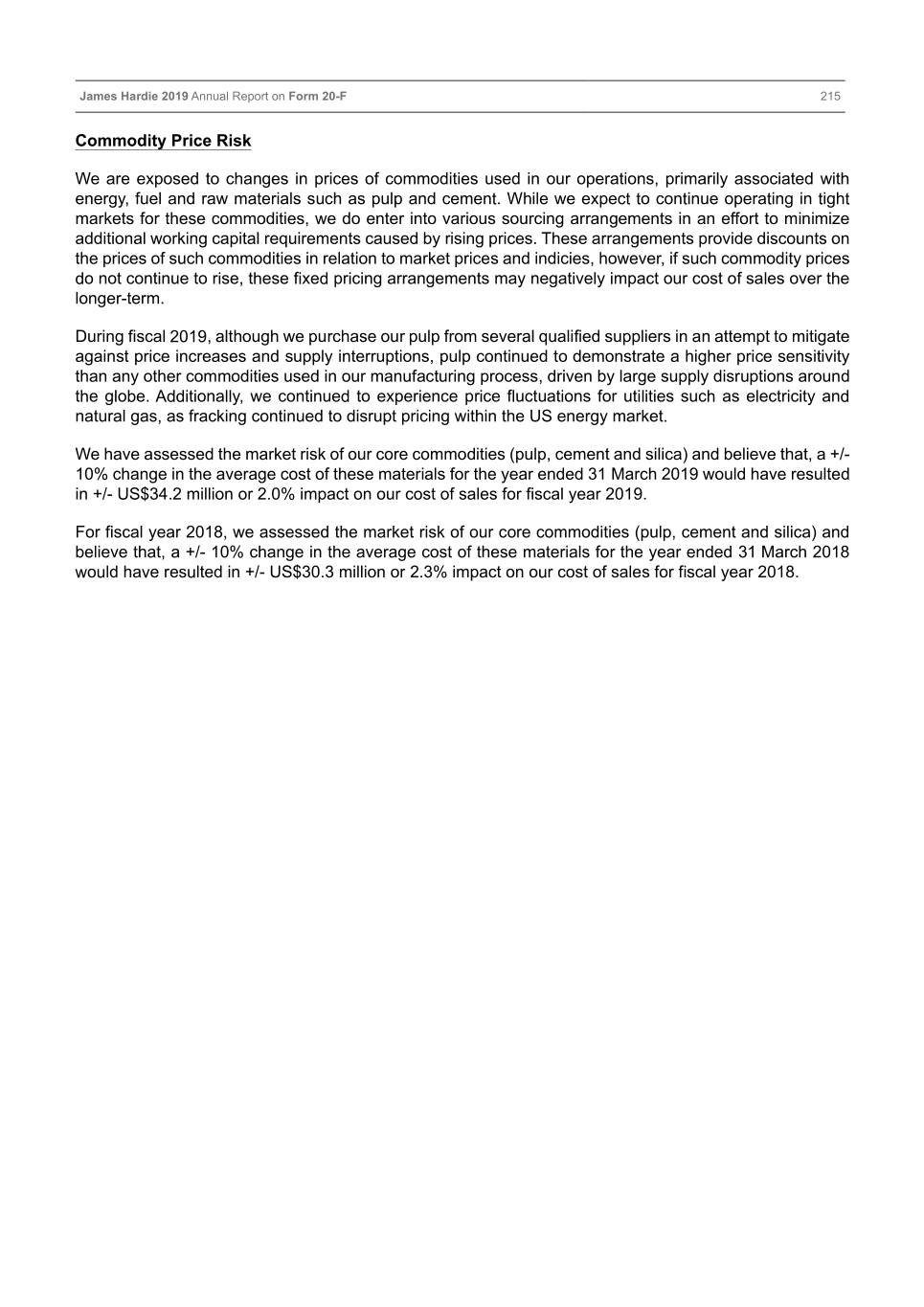
Table of Contents James Hardie 2019 Annual Report on Form 20-F 215 Commodity Price Risk We are exposed to changes in prices of commodities used in our operations, primarily associated with energy, fuel and raw materials such as pulp and cement. While we expect to continue operating in tight markets for these commodities, we do enter into various sourcing arrangements in an effort to minimize additional working capital requirements caused by rising prices. These arrangements provide discounts on the prices of such commodities in relation to market prices and indicies, however, if such commodity prices do not continue to rise, these fixed pricing arrangements may negatively impact our cost of sales over the longer-term. During fiscal 2019, although we purchase our pulp from several qualified suppliers in an attempt to mitigate against price increases and supply interruptions, pulp continued to demonstrate a higher price sensitivity than any other commodities used in our manufacturing process, driven by large supply disruptions around the globe. Additionally, we continued to experience price fluctuations for utilities such as electricity and natural gas, as fracking continued to disrupt pricing within the US energy market. We have assessed the market risk of our core commodities (pulp, cement and silica) and believe that, a +/- 10% change in the average cost of these materials for the year ended 31 March 2019 would have resulted in +/- US$34.2 million or 2.0% impact on our cost of sales for fiscal year 2019. For fiscal year 2018, we assessed the market risk of our core commodities (pulp, cement and silica) and believe that, a +/- 10% change in the average cost of these materials for the year ended 31 March 2018 would have resulted in +/- US$30.3 million or 2.3% impact on our cost of sales for fiscal year 2018.
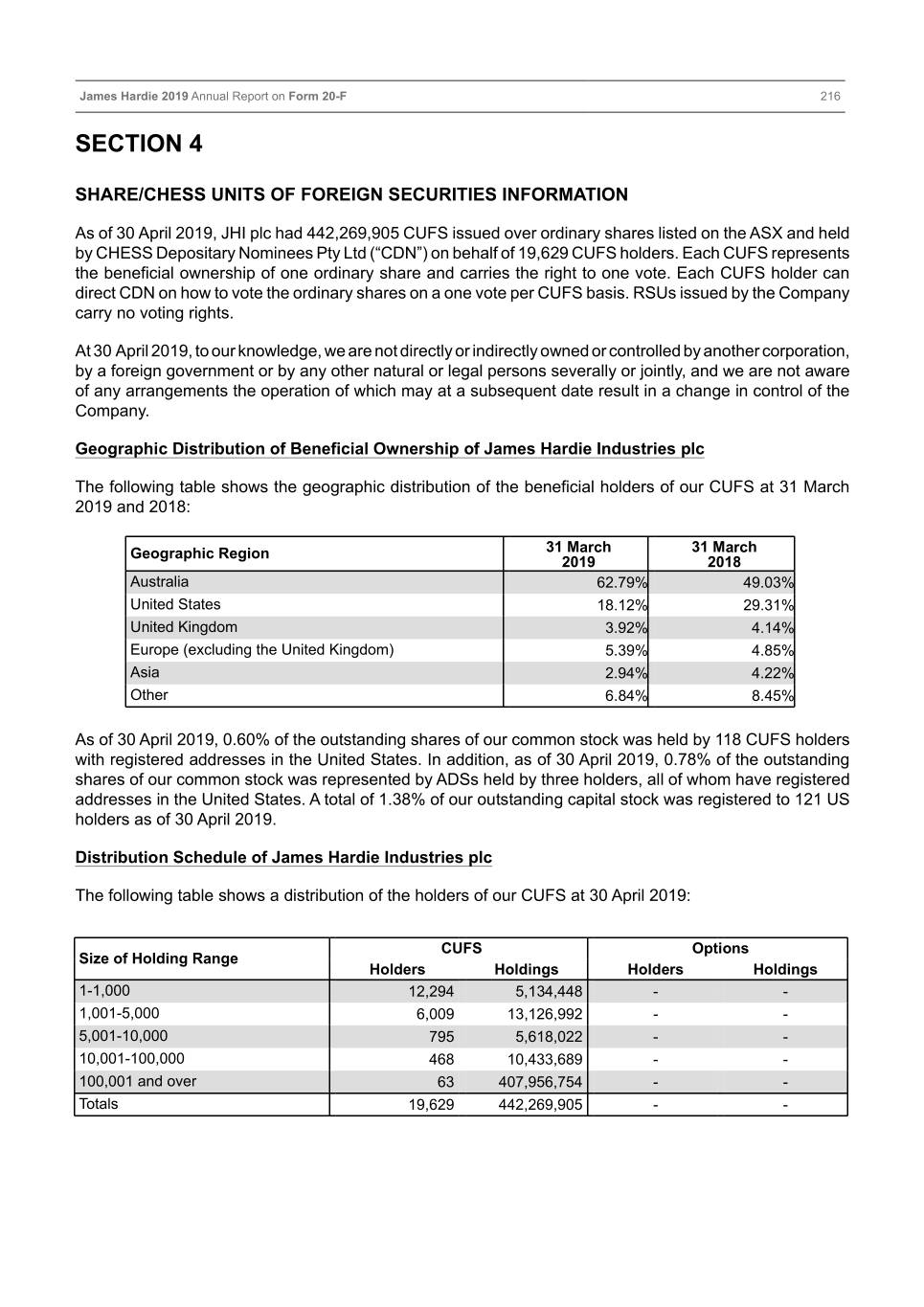
Table of Contents James Hardie 2019 Annual Report on Form 20-F 216 SECTION 4 SHARE/CHESS UNITS OF FOREIGN SECURITIES INFORMATION As of 30 April 2019, JHI plc had 442,269,905 CUFS issued over ordinary shares listed on the ASX and held by CHESS Depositary Nominees Pty Ltd (“CDN”) on behalf of 19,629 CUFS holders. Each CUFS represents the beneficial ownership of one ordinary share and carries the right to one vote. Each CUFS holder can direct CDN on how to vote the ordinary shares on a one vote per CUFS basis. RSUs issued by the Company carry no voting rights. At 30 April 2019, to our knowledge, we are not directly or indirectly owned or controlled by another corporation, by a foreign government or by any other natural or legal persons severally or jointly, and we are not aware of any arrangements the operation of which may at a subsequent date result in a change in control of the Company. Geographic Distribution of Beneficial Ownership of James Hardie Industries plc The following table shows the geographic distribution of the beneficial holders of our CUFS at 31 March 2019 and 2018: Geographic Region 31 March 31 March 2019 2018 Australia 62.79% 49.03% United States 18.12% 29.31% United Kingdom 3.92% 4.14% Europe (excluding the United Kingdom) 5.39% 4.85% Asia 2.94% 4.22% Other 6.84% 8.45% As of 30 April 2019, 0.60% of the outstanding shares of our common stock was held by 118 CUFS holders with registered addresses in the United States. In addition, as of 30 April 2019, 0.78% of the outstanding shares of our common stock was represented by ADSs held by three holders, all of whom have registered addresses in the United States. A total of 1.38% of our outstanding capital stock was registered to 121 US holders as of 30 April 2019. Distribution Schedule of James Hardie Industries plc The following table shows a distribution of the holders of our CUFS at 30 April 2019: CUFS Options Size of Holding Range Holders Holdings Holders Holdings 1-1,000 12,294 5,134,448 - - 1,001-5,000 6,009 13,126,992 - - 5,001-10,000 795 5,618,022 - - 10,001-100,000 468 10,433,689 - - 100,001 and over 63 407,956,754 - - Totals 19,629 442,269,905 - -
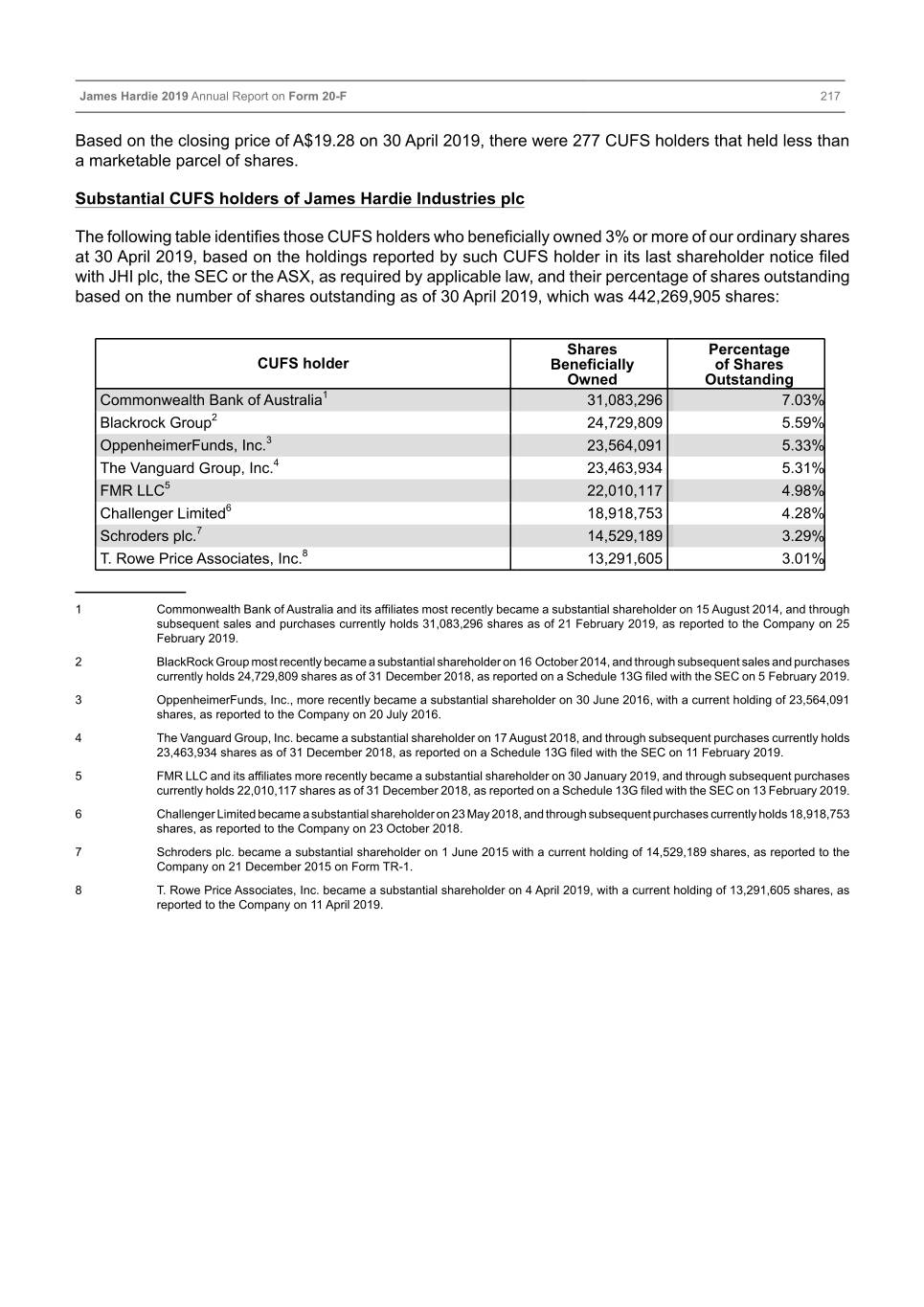
Table of Contents James Hardie 2019 Annual Report on Form 20-F 217 Based on the closing price of A$19.28 on 30 April 2019, there were 277 CUFS holders that held less than a marketable parcel of shares. Substantial CUFS holders of James Hardie Industries plc The following table identifies those CUFS holders who beneficially owned 3% or more of our ordinary shares at 30 April 2019, based on the holdings reported by such CUFS holder in its last shareholder notice filed with JHI plc, the SEC or the ASX, as required by applicable law, and their percentage of shares outstanding based on the number of shares outstanding as of 30 April 2019, which was 442,269,905 shares: Shares Percentage CUFS holder Beneficially of Shares Owned Outstanding Commonwealth Bank of Australia1 31,083,296 7.03% Blackrock Group2 24,729,809 5.59% OppenheimerFunds, Inc.3 23,564,091 5.33% The Vanguard Group, Inc.4 23,463,934 5.31% FMR LLC5 22,010,117 4.98% Challenger Limited6 18,918,753 4.28% Schroders plc.7 14,529,189 3.29% T. Rowe Price Associates, Inc.8 13,291,605 3.01% ____________ 1 Commonwealth Bank of Australia and its affiliates most recently became a substantial shareholder on 15 August 2014, and through subsequent sales and purchases currently holds 31,083,296 shares as of 21 February 2019, as reported to the Company on 25 February 2019. 2 BlackRock Group most recently became a substantial shareholder on 16 October 2014, and through subsequent sales and purchases currently holds 24,729,809 shares as of 31 December 2018, as reported on a Schedule 13G filed with the SEC on 5 February 2019. 3 OppenheimerFunds, Inc., more recently became a substantial shareholder on 30 June 2016, with a current holding of 23,564,091 shares, as reported to the Company on 20 July 2016. 4 The Vanguard Group, Inc. became a substantial shareholder on 17 August 2018, and through subsequent purchases currently holds 23,463,934 shares as of 31 December 2018, as reported on a Schedule 13G filed with the SEC on 11 February 2019. 5 FMR LLC and its affiliates more recently became a substantial shareholder on 30 January 2019, and through subsequent purchases currently holds 22,010,117 shares as of 31 December 2018, as reported on a Schedule 13G filed with the SEC on 13 February 2019. 6 Challenger Limited became a substantial shareholder on 23 May 2018, and through subsequent purchases currently holds 18,918,753 shares, as reported to the Company on 23 October 2018. 7 Schroders plc. became a substantial shareholder on 1 June 2015 with a current holding of 14,529,189 shares, as reported to the Company on 21 December 2015 on Form TR-1. 8 T. Rowe Price Associates, Inc. became a substantial shareholder on 4 April 2019, with a current holding of 13,291,605 shares, as reported to the Company on 11 April 2019.
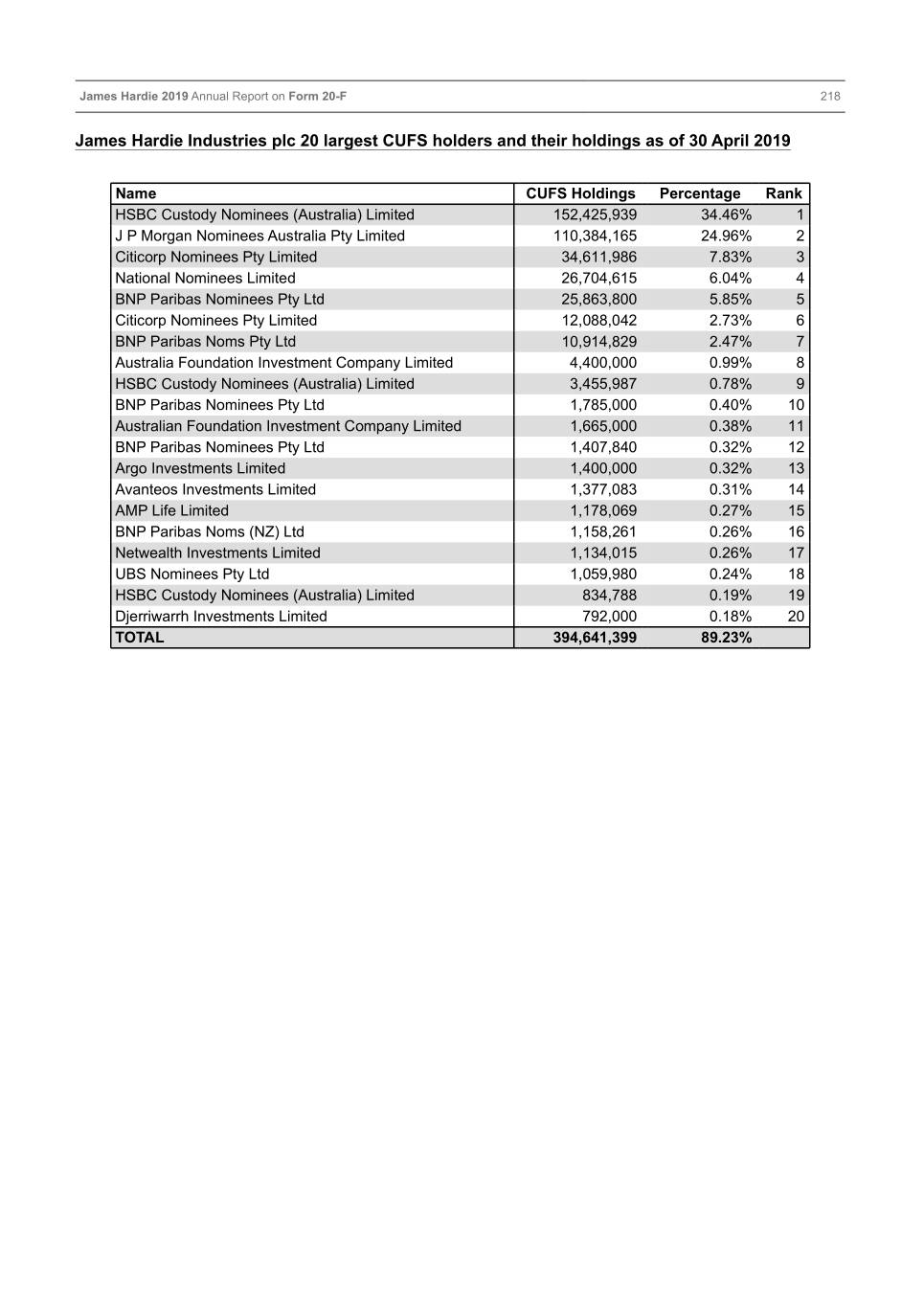
Table of Contents James Hardie 2019 Annual Report on Form 20-F 218 James Hardie Industries plc 20 largest CUFS holders and their holdings as of 30 April 2019 Name CUFS Holdings Percentage Rank HSBC Custody Nominees (Australia) Limited 152,425,939 34.46% 1 J P Morgan Nominees Australia Pty Limited 110,384,165 24.96% 2 Citicorp Nominees Pty Limited 34,611,986 7.83% 3 National Nominees Limited 26,704,615 6.04% 4 BNP Paribas Nominees Pty Ltd 25,863,800 5.85% 5 Citicorp Nominees Pty Limited 12,088,042 2.73% 6 BNP Paribas Noms Pty Ltd 10,914,829 2.47% 7 Australia Foundation Investment Company Limited 4,400,000 0.99% 8 HSBC Custody Nominees (Australia) Limited 3,455,987 0.78% 9 BNP Paribas Nominees Pty Ltd 1,785,000 0.40% 10 Australian Foundation Investment Company Limited 1,665,000 0.38% 11 BNP Paribas Nominees Pty Ltd 1,407,840 0.32% 12 Argo Investments Limited 1,400,000 0.32% 13 Avanteos Investments Limited 1,377,083 0.31% 14 AMP Life Limited 1,178,069 0.27% 15 BNP Paribas Noms (NZ) Ltd 1,158,261 0.26% 16 Netwealth Investments Limited 1,134,015 0.26% 17 UBS Nominees Pty Ltd 1,059,980 0.24% 18 HSBC Custody Nominees (Australia) Limited 834,788 0.19% 19 Djerriwarrh Investments Limited 792,000 0.18% 20 TOTAL 394,641,399 89.23%
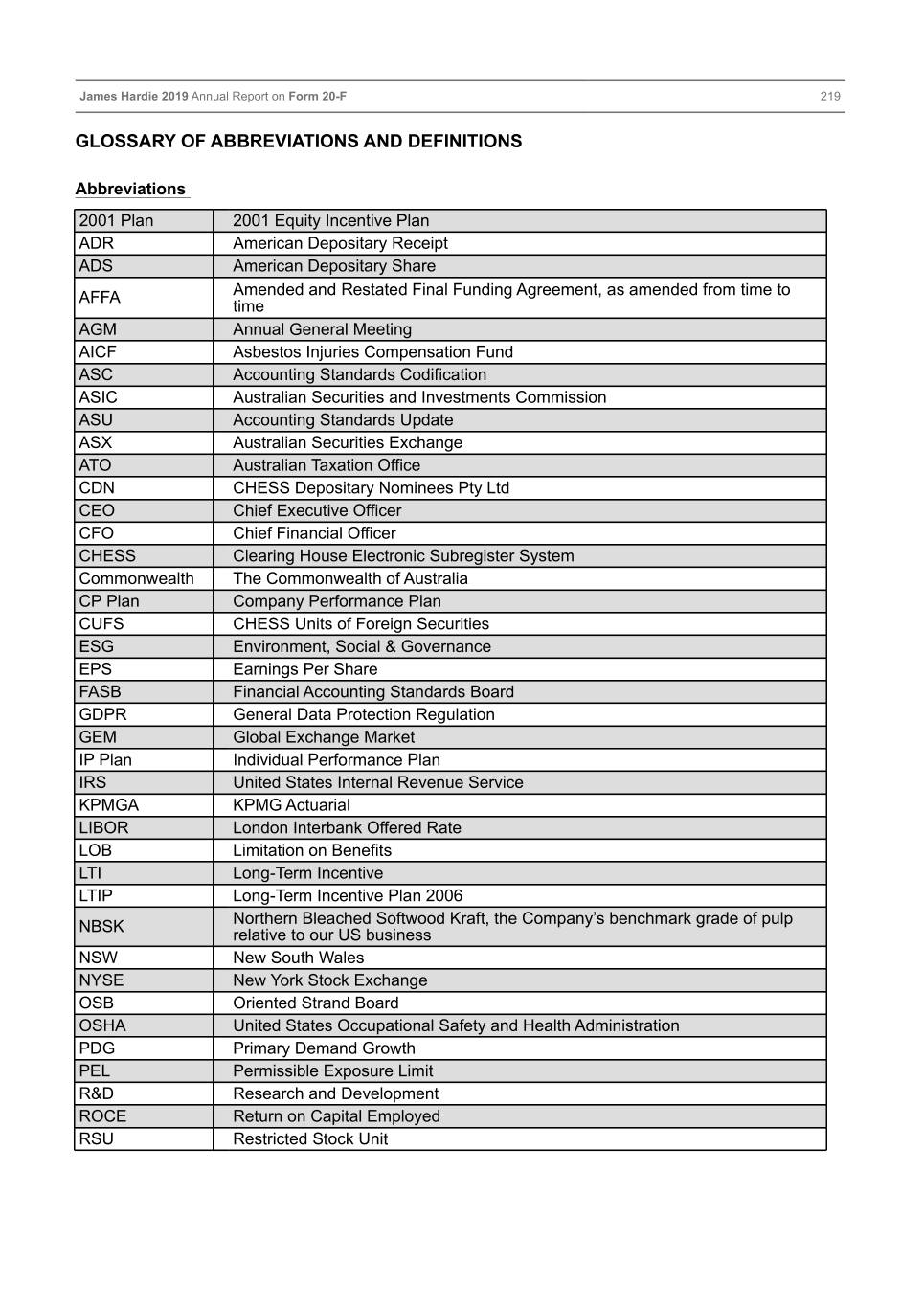
Table of Contents James Hardie 2019 Annual Report on Form 20-F 219 GLOSSARY OF ABBREVIATIONS AND DEFINITIONS Abbreviations 2001 Plan 2001 Equity Incentive Plan ADR American Depositary Receipt ADS American Depositary Share AFFA Amended and Restated Final Funding Agreement, as amended from time to time AGM Annual General Meeting AICF Asbestos Injuries Compensation Fund ASC Accounting Standards Codification ASIC Australian Securities and Investments Commission ASU Accounting Standards Update ASX Australian Securities Exchange ATO Australian Taxation Office CDN CHESS Depositary Nominees Pty Ltd CEO Chief Executive Officer CFO Chief Financial Officer CHESS Clearing House Electronic Subregister System Commonwealth The Commonwealth of Australia CP Plan Company Performance Plan CUFS CHESS Units of Foreign Securities ESG Environment, Social & Governance EPS Earnings Per Share FASB Financial Accounting Standards Board GDPR General Data Protection Regulation GEM Global Exchange Market IP Plan Individual Performance Plan IRS United States Internal Revenue Service KPMGA KPMG Actuarial LIBOR London Interbank Offered Rate LOB Limitation on Benefits LTI Long-Term Incentive LTIP Long-Term Incentive Plan 2006 NBSK Northern Bleached Softwood Kraft, the Company’s benchmark grade of pulp relative to our US business NSW New South Wales NYSE New York Stock Exchange OSB Oriented Strand Board OSHA United States Occupational Safety and Health Administration PDG Primary Demand Growth PEL Permissible Exposure Limit R&D Research and Development ROCE Return on Capital Employed RSU Restricted Stock Unit
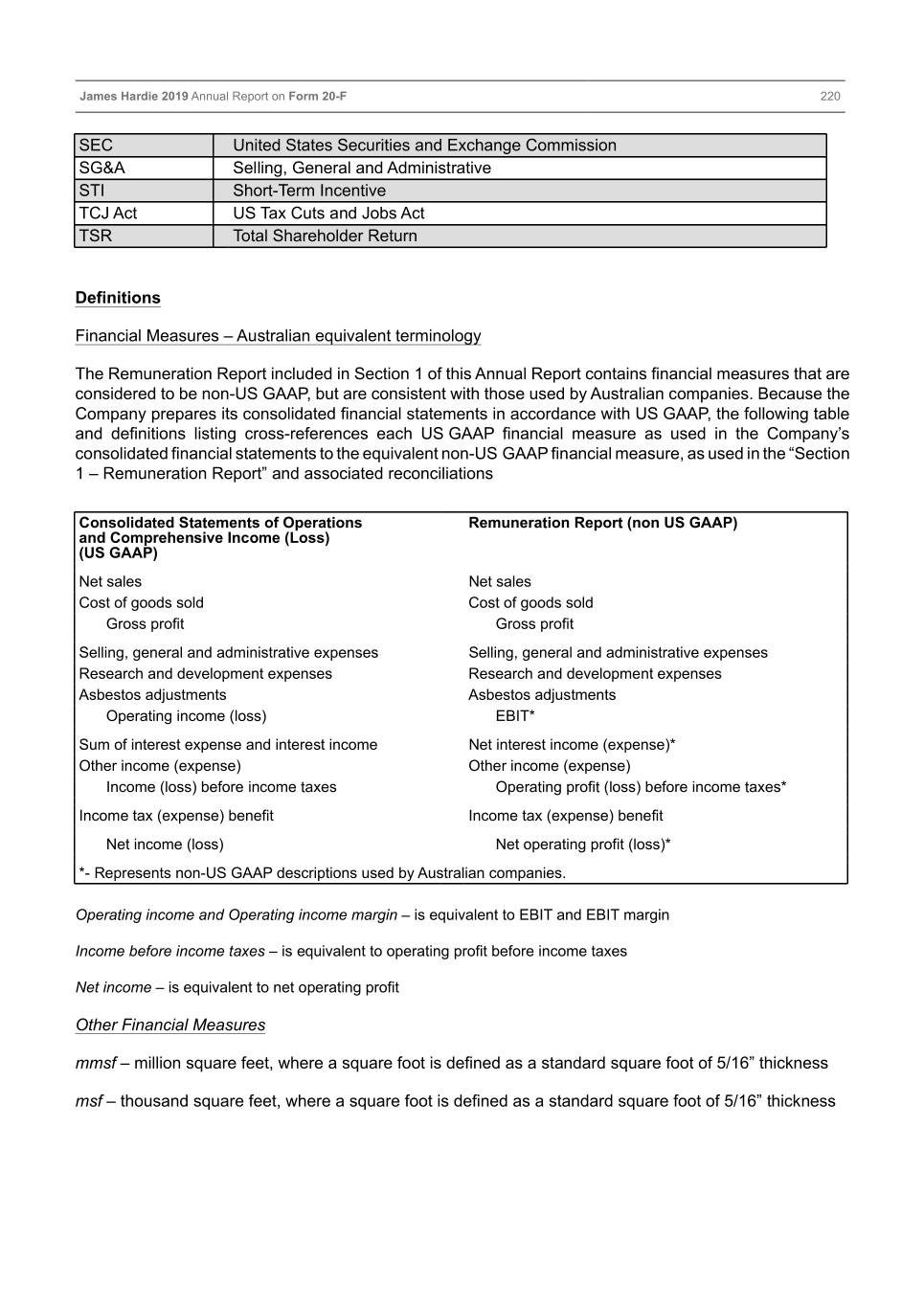
Table of Contents James Hardie 2019 Annual Report on Form 20-F 220 SEC United States Securities and Exchange Commission SG&A Selling, General and Administrative STI Short-Term Incentive TCJ Act US Tax Cuts and Jobs Act TSR Total Shareholder Return Definitions Financial Measures – Australian equivalent terminology The Remuneration Report included in Section 1 of this Annual Report contains financial measures that are considered to be non-US GAAP, but are consistent with those used by Australian companies. Because the Company prepares its consolidated financial statements in accordance with US GAAP, the following table and definitions listing cross-references each US GAAP financial measure as used in the Company’s consolidated financial statements to the equivalent non-US GAAP financial measure, as used in the “Section 1 – Remuneration Report” and associated reconciliations Consolidated Statements of Operations Remuneration Report (non US GAAP) and Comprehensive Income (Loss) (US GAAP) Net sales Net sales Cost of goods sold Cost of goods sold Gross profit Gross profit Selling, general and administrative expenses Selling, general and administrative expenses Research and development expenses Research and development expenses Asbestos adjustments Asbestos adjustments Operating income (loss) EBIT* Sum of interest expense and interest income Net interest income (expense)* Other income (expense) Other income (expense) Income (loss) before income taxes Operating profit (loss) before income taxes* Income tax (expense) benefit Income tax (expense) benefit Net income (loss) Net operating profit (loss)* *- Represents non-US GAAP descriptions used by Australian companies. Operating income and Operating income margin – is equivalent to EBIT and EBIT margin Income before income taxes – is equivalent to operating profit before income taxes Net income – is equivalent to net operating profit Other Financial Measures mmsf – million square feet, where a square foot is defined as a standard square foot of 5/16” thickness msf – thousand square feet, where a square foot is defined as a standard square foot of 5/16” thickness
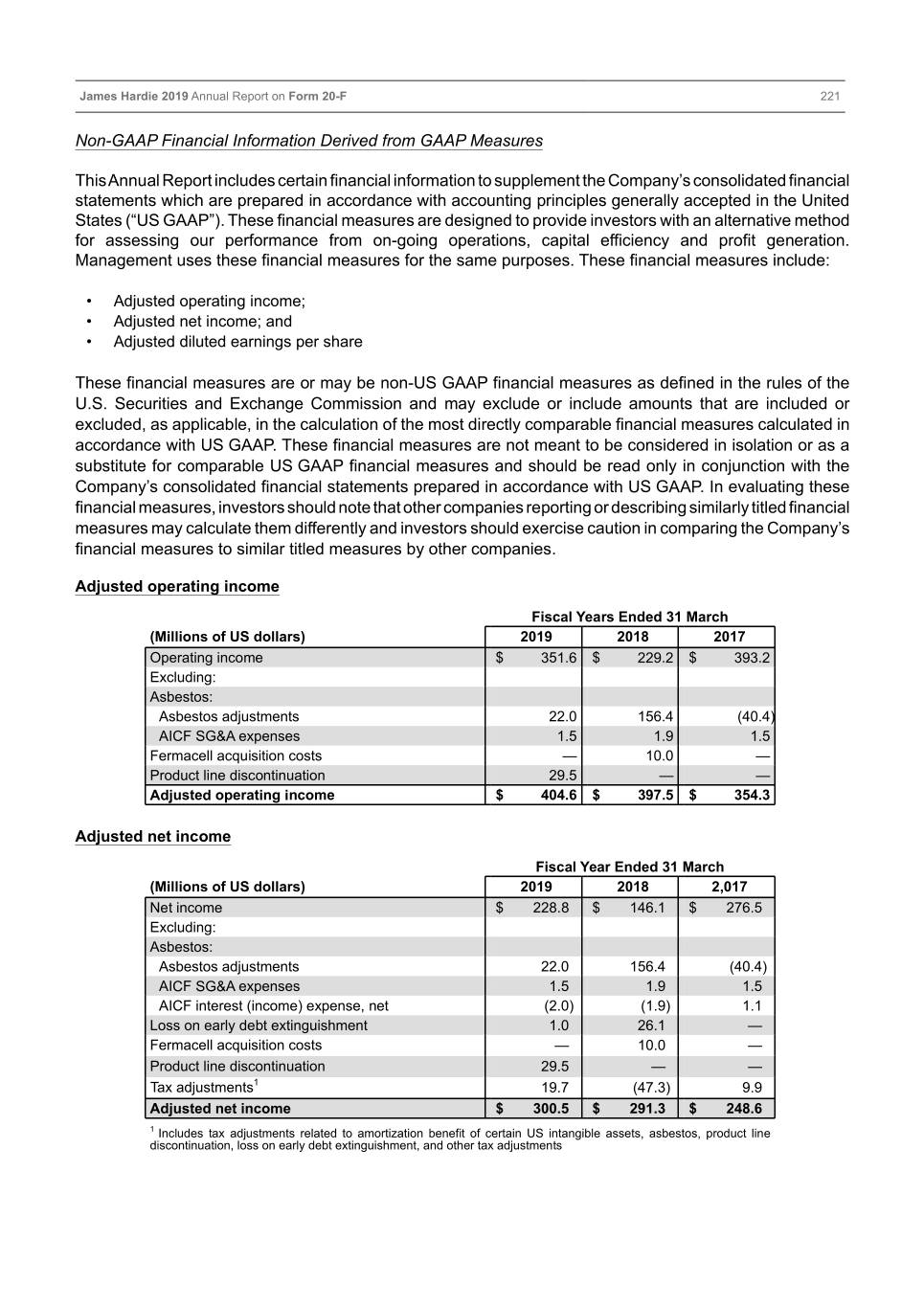
Table of Contents James Hardie 2019 Annual Report on Form 20-F 221 Non-GAAP Financial Information Derived from GAAP Measures This Annual Report includes certain financial information to supplement the Company’s consolidated financial statements which are prepared in accordance with accounting principles generally accepted in the United States (“US GAAP”). These financial measures are designed to provide investors with an alternative method for assessing our performance from on-going operations, capital efficiency and profit generation. Management uses these financial measures for the same purposes. These financial measures include: • Adjusted operating income; • Adjusted net income; and • Adjusted diluted earnings per share These financial measures are or may be non-US GAAP financial measures as defined in the rules of the U.S. Securities and Exchange Commission and may exclude or include amounts that are included or excluded, as applicable, in the calculation of the most directly comparable financial measures calculated in accordance with US GAAP. These financial measures are not meant to be considered in isolation or as a substitute for comparable US GAAP financial measures and should be read only in conjunction with the Company’s consolidated financial statements prepared in accordance with US GAAP. In evaluating these financial measures, investors should note that other companies reporting or describing similarly titled financial measures may calculate them differently and investors should exercise caution in comparing the Company’s financial measures to similar titled measures by other companies. Adjusted operating income Fiscal Years Ended 31 March (Millions of US dollars) 2019 2018 2017 Operating income $ 351.6 $ 229.2 $ 393.2 Excluding: Asbestos: Asbestos adjustments 22.0 156.4 (40.4) AICF SG&A expenses 1.5 1.9 1.5 Fermacell acquisition costs — 10.0 — Product line discontinuation 29.5 — — Adjusted operating income $ 404.6 $ 397.5 $ 354.3 Adjusted net income Fiscal Year Ended 31 March (Millions of US dollars) 2019 2018 2,017 Net income $ 228.8 $ 146.1 $ 276.5 Excluding: Asbestos: Asbestos adjustments 22.0 156.4 (40.4) AICF SG&A expenses 1.5 1.9 1.5 AICF interest (income) expense, net (2.0) (1.9) 1.1 Loss on early debt extinguishment 1.0 26.1 — Fermacell acquisition costs — 10.0 — Product line discontinuation 29.5 — — Tax adjustments1 19.7 (47.3) 9.9 Adjusted net income $ 300.5 $ 291.3 $ 248.6 1 Includes tax adjustments related to amortization benefit of certain US intangible assets, asbestos, product line discontinuation, loss on early debt extinguishment, and other tax adjustments
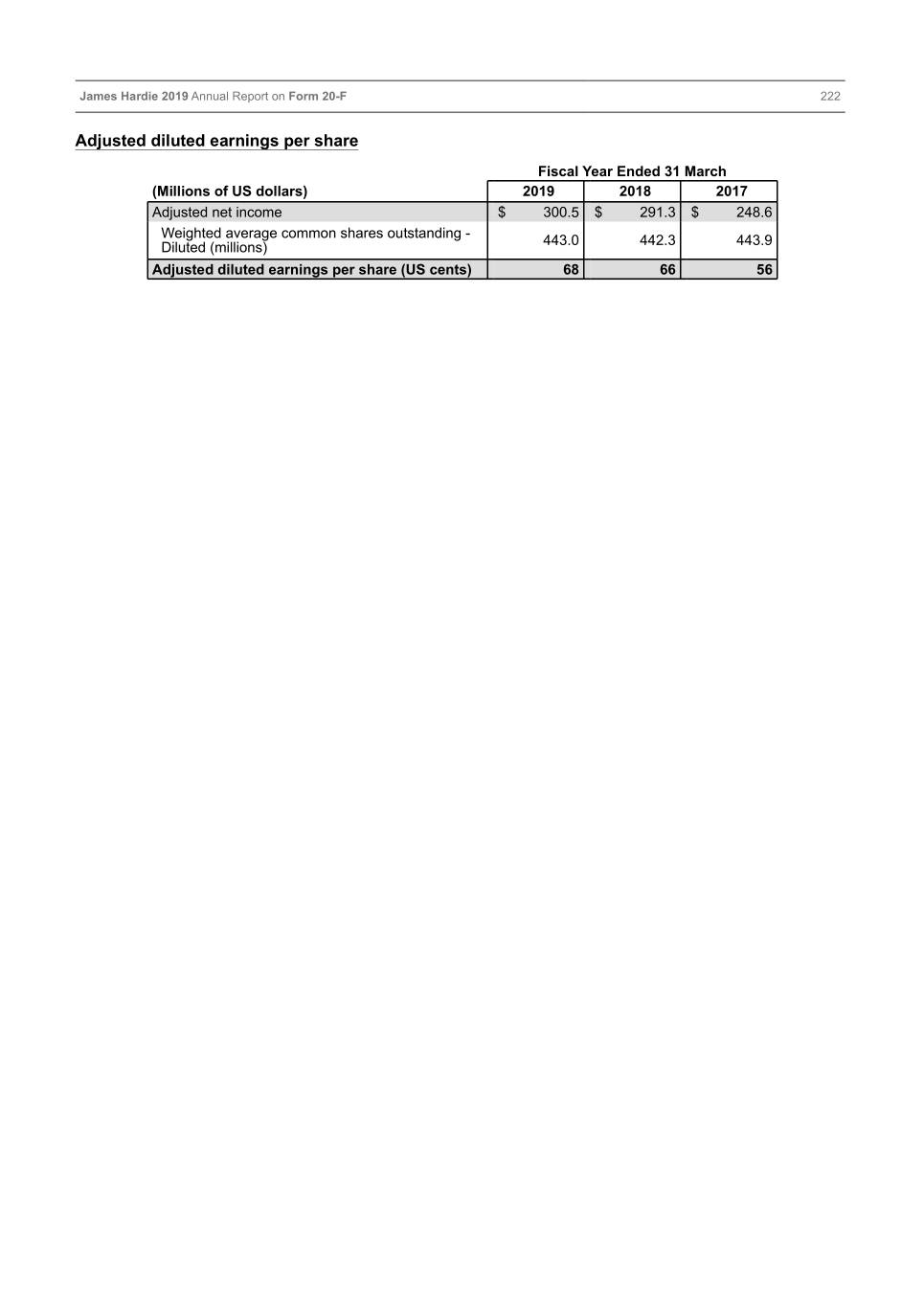
Table of Contents James Hardie 2019 Annual Report on Form 20-F 222 Adjusted diluted earnings per share Fiscal Year Ended 31 March (Millions of US dollars) 2019 2018 2017 Adjusted net income $ 300.5 $ 291.3 $ 248.6 Weighted average common shares outstanding - Diluted (millions) 443.0 442.3 443.9 Adjusted diluted earnings per share (US cents) 68 66 56
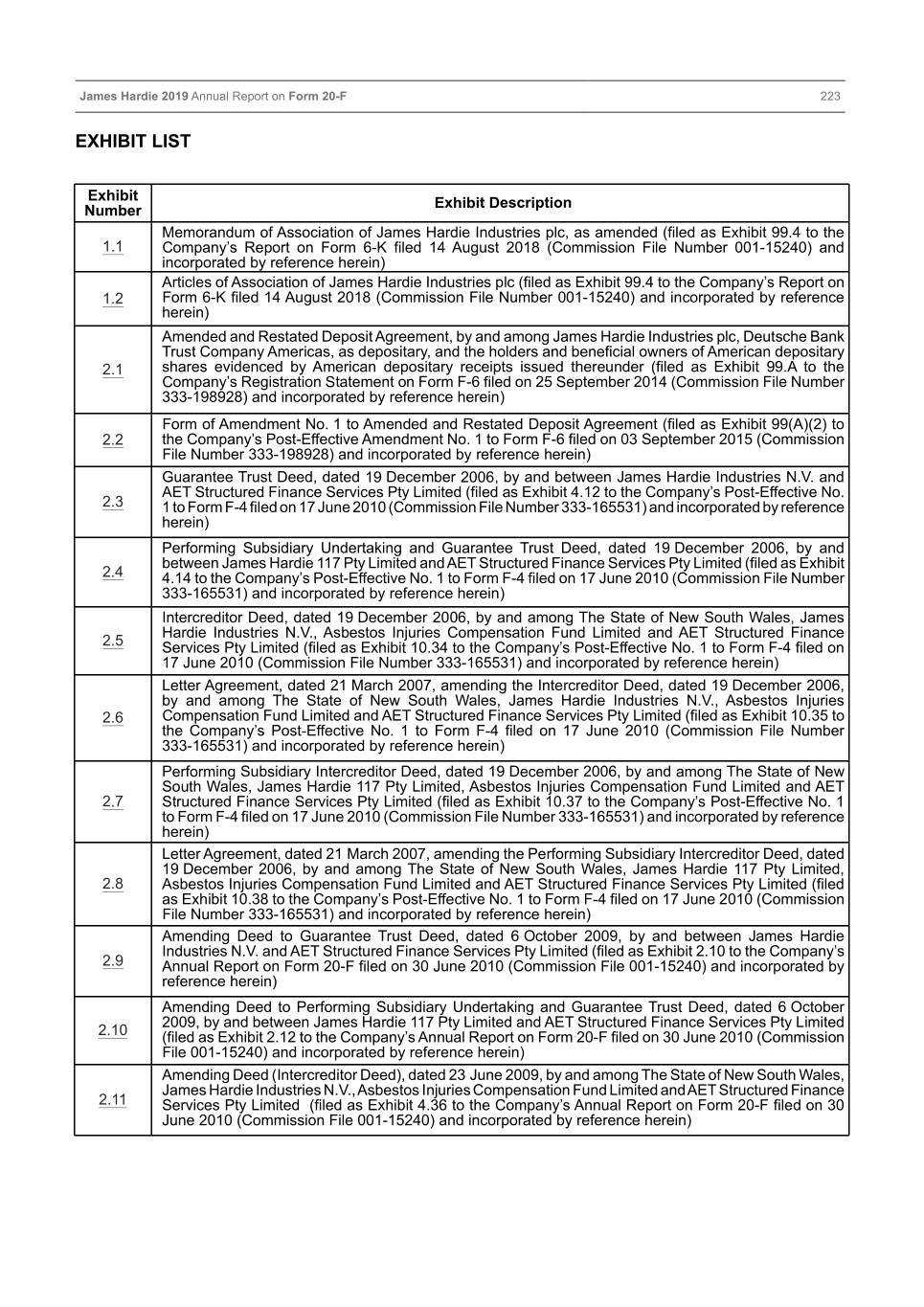
Table of Contents James Hardie 2019 Annual Report on Form 20-F 223 EXHIBIT LIST Exhibit Exhibit Description Number Memorandum of Association of James Hardie Industries plc, as amended (filed as Exhibit 99.4 to the 1.1 Company’s Report on Form 6-K filed 14 August 2018 (Commission File Number 001-15240) and incorporated by reference herein) Articles of Association of James Hardie Industries plc (filed as Exhibit 99.4 to the Company’s Report on 1.2 Form 6-K filed 14 August 2018 (Commission File Number 001-15240) and incorporated by reference herein) Amended and Restated Deposit Agreement, by and among James Hardie Industries plc, Deutsche Bank Trust Company Americas, as depositary, and the holders and beneficial owners of American depositary 2.1 shares evidenced by American depositary receipts issued thereunder (filed as Exhibit 99.A to the Company’s Registration Statement on Form F-6 filed on 25 September 2014 (Commission File Number 333-198928) and incorporated by reference herein) Form of Amendment No. 1 to Amended and Restated Deposit Agreement (filed as Exhibit 99(A)(2) to 2.2 the Company’s Post-Effective Amendment No. 1 to Form F-6 filed on 03 September 2015 (Commission File Number 333-198928) and incorporated by reference herein) Guarantee Trust Deed, dated 19 December 2006, by and between James Hardie Industries N.V. and AET Structured Finance Services Pty Limited (filed as Exhibit 4.12 to the Company’s Post-Effective No. 2.3 1 to Form F-4 filed on 17 June 2010 (Commission File Number 333-165531) and incorporated by reference herein) Performing Subsidiary Undertaking and Guarantee Trust Deed, dated 19 December 2006, by and between James Hardie 117 Pty Limited and AET Structured Finance Services Pty Limited (filed as Exhibit 2.4 4.14 to the Company’s Post-Effective No. 1 to Form F-4 filed on 17 June 2010 (Commission File Number 333-165531) and incorporated by reference herein) Intercreditor Deed, dated 19 December 2006, by and among The State of New South Wales, James Hardie Industries N.V., Asbestos Injuries Compensation Fund Limited and AET Structured Finance 2.5 Services Pty Limited (filed as Exhibit 10.34 to the Company’s Post-Effective No. 1 to Form F-4 filed on 17 June 2010 (Commission File Number 333-165531) and incorporated by reference herein) Letter Agreement, dated 21 March 2007, amending the Intercreditor Deed, dated 19 December 2006, by and among The State of New South Wales, James Hardie Industries N.V., Asbestos Injuries 2.6 Compensation Fund Limited and AET Structured Finance Services Pty Limited (filed as Exhibit 10.35 to the Company’s Post-Effective No. 1 to Form F-4 filed on 17 June 2010 (Commission File Number 333-165531) and incorporated by reference herein) Performing Subsidiary Intercreditor Deed, dated 19 December 2006, by and among The State of New South Wales, James Hardie 117 Pty Limited, Asbestos Injuries Compensation Fund Limited and AET 2.7 Structured Finance Services Pty Limited (filed as Exhibit 10.37 to the Company’s Post-Effective No. 1 to Form F-4 filed on 17 June 2010 (Commission File Number 333-165531) and incorporated by reference herein) Letter Agreement, dated 21 March 2007, amending the Performing Subsidiary Intercreditor Deed, dated 19 December 2006, by and among The State of New South Wales, James Hardie 117 Pty Limited, 2.8 Asbestos Injuries Compensation Fund Limited and AET Structured Finance Services Pty Limited (filed as Exhibit 10.38 to the Company’s Post-Effective No. 1 to Form F-4 filed on 17 June 2010 (Commission File Number 333-165531) and incorporated by reference herein) Amending Deed to Guarantee Trust Deed, dated 6 October 2009, by and between James Hardie Industries N.V. and AET Structured Finance Services Pty Limited (filed as Exhibit 2.10 to the Company’s 2.9 Annual Report on Form 20-F filed on 30 June 2010 (Commission File 001-15240) and incorporated by reference herein) Amending Deed to Performing Subsidiary Undertaking and Guarantee Trust Deed, dated 6 October 2009, by and between James Hardie 117 Pty Limited and AET Structured Finance Services Pty Limited 2.10 (filed as Exhibit 2.12 to the Company’s Annual Report on Form 20-F filed on 30 June 2010 (Commission File 001-15240) and incorporated by reference herein) Amending Deed (Intercreditor Deed), dated 23 June 2009, by and among The State of New South Wales, James Hardie Industries N.V., Asbestos Injuries Compensation Fund Limited and AET Structured Finance 2.11 Services Pty Limited (filed as Exhibit 4.36 to the Company’s Annual Report on Form 20-F filed on 30 June 2010 (Commission File 001-15240) and incorporated by reference herein)
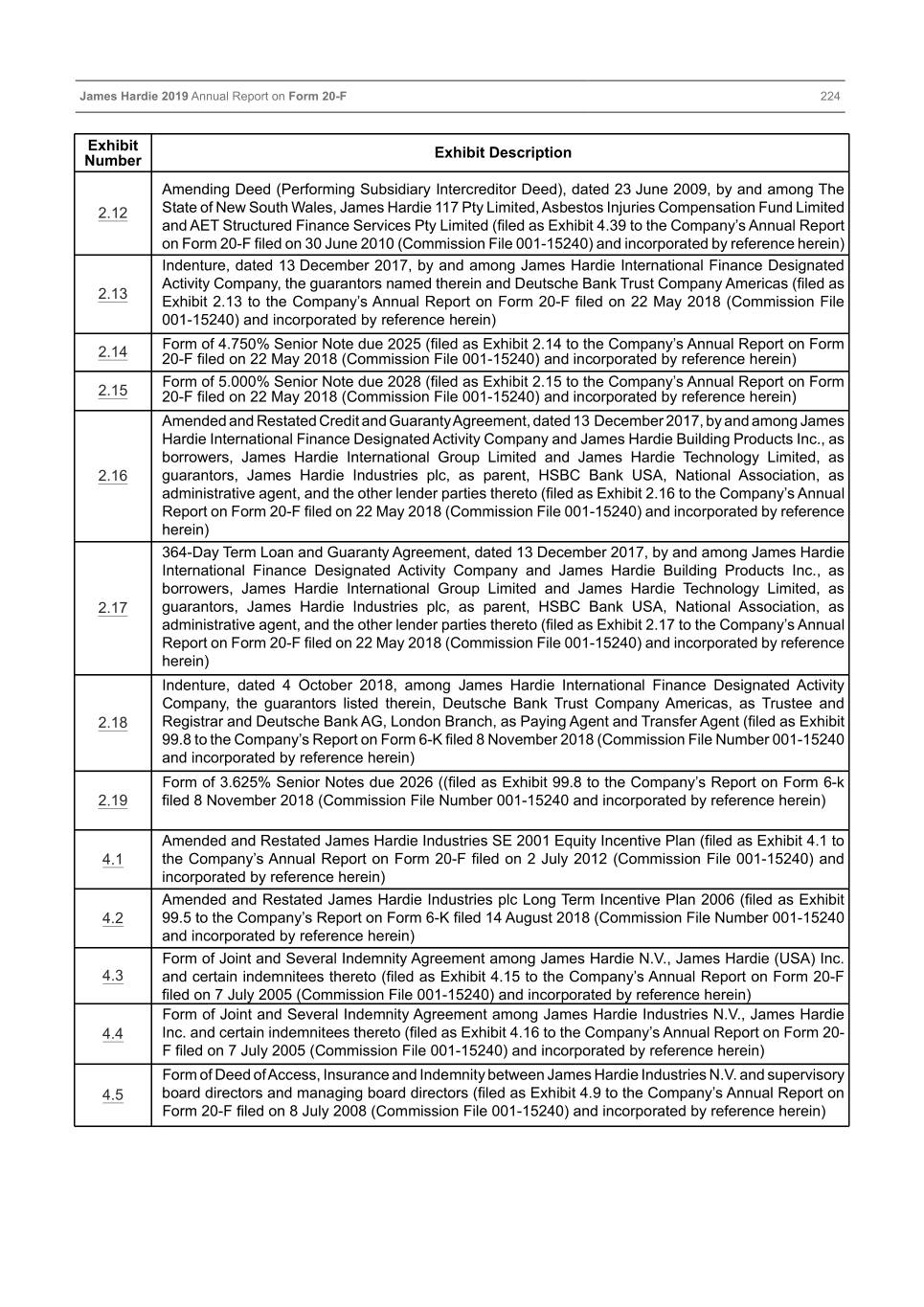
Table of Contents James Hardie 2019 Annual Report on Form 20-F 224 Exhibit Exhibit Description Number Amending Deed (Performing Subsidiary Intercreditor Deed), dated 23 June 2009, by and among The 2.12 State of New South Wales, James Hardie 117 Pty Limited, Asbestos Injuries Compensation Fund Limited and AET Structured Finance Services Pty Limited (filed as Exhibit 4.39 to the Company’s Annual Report on Form 20-F filed on 30 June 2010 (Commission File 001-15240) and incorporated by reference herein) Indenture, dated 13 December 2017, by and among James Hardie International Finance Designated Activity Company, the guarantors named therein and Deutsche Bank Trust Company Americas (filed as 2.13 Exhibit 2.13 to the Company’s Annual Report on Form 20-F filed on 22 May 2018 (Commission File 001-15240) and incorporated by reference herein) Form of 4.750% Senior Note due 2025 (filed as Exhibit 2.14 to the Company’s Annual Report on Form 2.14 20-F filed on 22 May 2018 (Commission File 001-15240) and incorporated by reference herein) Form of 5.000% Senior Note due 2028 (filed as Exhibit 2.15 to the Company’s Annual Report on Form 2.15 20-F filed on 22 May 2018 (Commission File 001-15240) and incorporated by reference herein) Amended and Restated Credit and Guaranty Agreement, dated 13 December 2017, by and among James Hardie International Finance Designated Activity Company and James Hardie Building Products Inc., as borrowers, James Hardie International Group Limited and James Hardie Technology Limited, as 2.16 guarantors, James Hardie Industries plc, as parent, HSBC Bank USA, National Association, as administrative agent, and the other lender parties thereto (filed as Exhibit 2.16 to the Company’s Annual Report on Form 20-F filed on 22 May 2018 (Commission File 001-15240) and incorporated by reference herein) 364-Day Term Loan and Guaranty Agreement, dated 13 December 2017, by and among James Hardie International Finance Designated Activity Company and James Hardie Building Products Inc., as borrowers, James Hardie International Group Limited and James Hardie Technology Limited, as 2.17 guarantors, James Hardie Industries plc, as parent, HSBC Bank USA, National Association, as administrative agent, and the other lender parties thereto (filed as Exhibit 2.17 to the Company’s Annual Report on Form 20-F filed on 22 May 2018 (Commission File 001-15240) and incorporated by reference herein) Indenture, dated 4 October 2018, among James Hardie International Finance Designated Activity Company, the guarantors listed therein, Deutsche Bank Trust Company Americas, as Trustee and 2.18 Registrar and Deutsche Bank AG, London Branch, as Paying Agent and Transfer Agent (filed as Exhibit 99.8 to the Company’s Report on Form 6-K filed 8 November 2018 (Commission File Number 001-15240 and incorporated by reference herein) Form of 3.625% Senior Notes due 2026 ((filed as Exhibit 99.8 to the Company’s Report on Form 6-k 2.19 filed 8 November 2018 (Commission File Number 001-15240 and incorporated by reference herein) Amended and Restated James Hardie Industries SE 2001 Equity Incentive Plan (filed as Exhibit 4.1 to 4.1 the Company’s Annual Report on Form 20-F filed on 2 July 2012 (Commission File 001-15240) and incorporated by reference herein) Amended and Restated James Hardie Industries plc Long Term Incentive Plan 2006 (filed as Exhibit 4.2 99.5 to the Company’s Report on Form 6-K filed 14 August 2018 (Commission File Number 001-15240 and incorporated by reference herein) Form of Joint and Several Indemnity Agreement among James Hardie N.V., James Hardie (USA) Inc. 4.3 and certain indemnitees thereto (filed as Exhibit 4.15 to the Company’s Annual Report on Form 20-F filed on 7 July 2005 (Commission File 001-15240) and incorporated by reference herein) Form of Joint and Several Indemnity Agreement among James Hardie Industries N.V., James Hardie 4.4 Inc. and certain indemnitees thereto (filed as Exhibit 4.16 to the Company’s Annual Report on Form 20- F filed on 7 July 2005 (Commission File 001-15240) and incorporated by reference herein) Form of Deed of Access, Insurance and Indemnity between James Hardie Industries N.V. and supervisory 4.5 board directors and managing board directors (filed as Exhibit 4.9 to the Company’s Annual Report on Form 20-F filed on 8 July 2008 (Commission File 001-15240) and incorporated by reference herein)
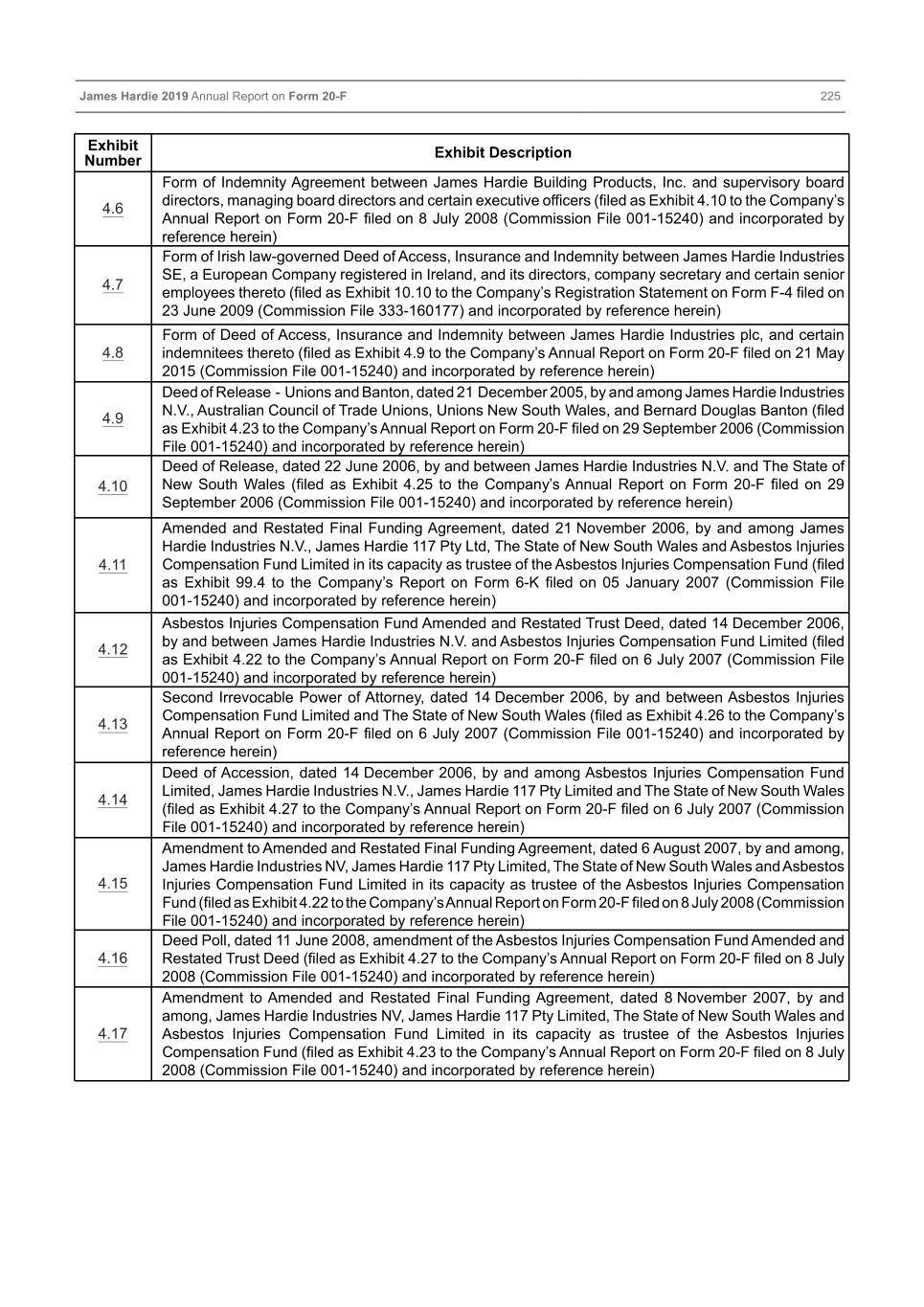
Table of Contents James Hardie 2019 Annual Report on Form 20-F 225 Exhibit Exhibit Description Number Form of Indemnity Agreement between James Hardie Building Products, Inc. and supervisory board directors, managing board directors and certain executive officers (filed as Exhibit 4.10 to the Company’s 4.6 Annual Report on Form 20-F filed on 8 July 2008 (Commission File 001-15240) and incorporated by reference herein) Form of Irish law-governed Deed of Access, Insurance and Indemnity between James Hardie Industries SE, a European Company registered in Ireland, and its directors, company secretary and certain senior 4.7 employees thereto (filed as Exhibit 10.10 to the Company’s Registration Statement on Form F-4 filed on 23 June 2009 (Commission File 333-160177) and incorporated by reference herein) Form of Deed of Access, Insurance and Indemnity between James Hardie Industries plc, and certain 4.8 indemnitees thereto (filed as Exhibit 4.9 to the Company’s Annual Report on Form 20-F filed on 21 May 2015 (Commission File 001-15240) and incorporated by reference herein) Deed of Release - Unions and Banton, dated 21 December 2005, by and among James Hardie Industries N.V., Australian Council of Trade Unions, Unions New South Wales, and Bernard Douglas Banton (filed 4.9 as Exhibit 4.23 to the Company’s Annual Report on Form 20-F filed on 29 September 2006 (Commission File 001-15240) and incorporated by reference herein) Deed of Release, dated 22 June 2006, by and between James Hardie Industries N.V. and The State of 4.10 New South Wales (filed as Exhibit 4.25 to the Company’s Annual Report on Form 20-F filed on 29 September 2006 (Commission File 001-15240) and incorporated by reference herein) Amended and Restated Final Funding Agreement, dated 21 November 2006, by and among James Hardie Industries N.V., James Hardie 117 Pty Ltd, The State of New South Wales and Asbestos Injuries 4.11 Compensation Fund Limited in its capacity as trustee of the Asbestos Injuries Compensation Fund (filed as Exhibit 99.4 to the Company’s Report on Form 6-K filed on 05 January 2007 (Commission File 001-15240) and incorporated by reference herein) Asbestos Injuries Compensation Fund Amended and Restated Trust Deed, dated 14 December 2006, by and between James Hardie Industries N.V. and Asbestos Injuries Compensation Fund Limited (filed 4.12 as Exhibit 4.22 to the Company’s Annual Report on Form 20-F filed on 6 July 2007 (Commission File 001-15240) and incorporated by reference herein) Second Irrevocable Power of Attorney, dated 14 December 2006, by and between Asbestos Injuries Compensation Fund Limited and The State of New South Wales (filed as Exhibit 4.26 to the Company’s 4.13 Annual Report on Form 20-F filed on 6 July 2007 (Commission File 001-15240) and incorporated by reference herein) Deed of Accession, dated 14 December 2006, by and among Asbestos Injuries Compensation Fund Limited, James Hardie Industries N.V., James Hardie 117 Pty Limited and The State of New South Wales 4.14 (filed as Exhibit 4.27 to the Company’s Annual Report on Form 20-F filed on 6 July 2007 (Commission File 001-15240) and incorporated by reference herein) Amendment to Amended and Restated Final Funding Agreement, dated 6 August 2007, by and among, James Hardie Industries NV, James Hardie 117 Pty Limited, The State of New South Wales and Asbestos 4.15 Injuries Compensation Fund Limited in its capacity as trustee of the Asbestos Injuries Compensation Fund (filed as Exhibit 4.22 to the Company’s Annual Report on Form 20-F filed on 8 July 2008 (Commission File 001-15240) and incorporated by reference herein) Deed Poll, dated 11 June 2008, amendment of the Asbestos Injuries Compensation Fund Amended and 4.16 Restated Trust Deed (filed as Exhibit 4.27 to the Company’s Annual Report on Form 20-F filed on 8 July 2008 (Commission File 001-15240) and incorporated by reference herein) Amendment to Amended and Restated Final Funding Agreement, dated 8 November 2007, by and among, James Hardie Industries NV, James Hardie 117 Pty Limited, The State of New South Wales and 4.17 Asbestos Injuries Compensation Fund Limited in its capacity as trustee of the Asbestos Injuries Compensation Fund (filed as Exhibit 4.23 to the Company’s Annual Report on Form 20-F filed on 8 July 2008 (Commission File 001-15240) and incorporated by reference herein)
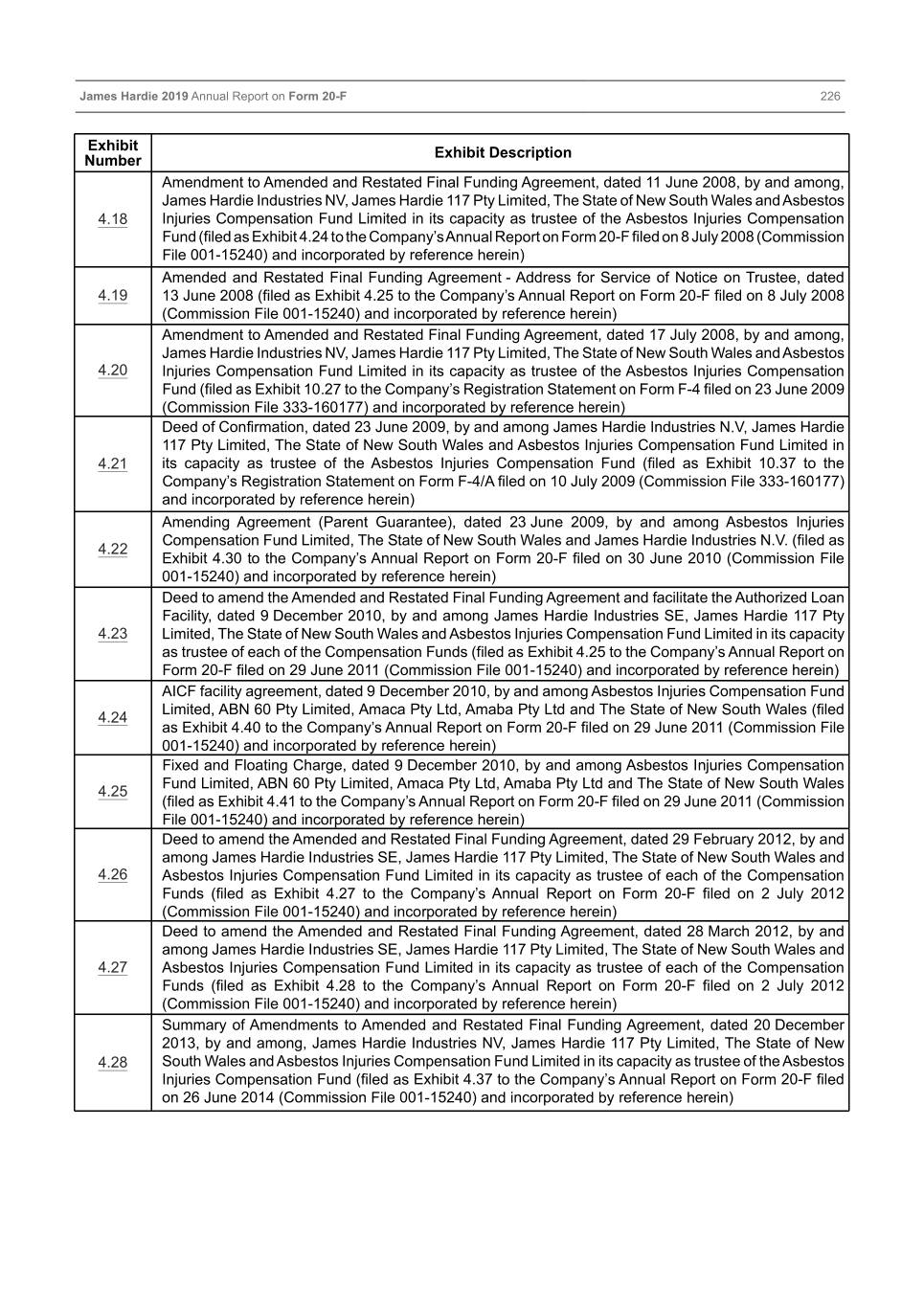
Table of Contents James Hardie 2019 Annual Report on Form 20-F 226 Exhibit Exhibit Description Number Amendment to Amended and Restated Final Funding Agreement, dated 11 June 2008, by and among, James Hardie Industries NV, James Hardie 117 Pty Limited, The State of New South Wales and Asbestos 4.18 Injuries Compensation Fund Limited in its capacity as trustee of the Asbestos Injuries Compensation Fund (filed as Exhibit 4.24 to the Company’s Annual Report on Form 20-F filed on 8 July 2008 (Commission File 001-15240) and incorporated by reference herein) Amended and Restated Final Funding Agreement - Address for Service of Notice on Trustee, dated 4.19 13 June 2008 (filed as Exhibit 4.25 to the Company’s Annual Report on Form 20-F filed on 8 July 2008 (Commission File 001-15240) and incorporated by reference herein) Amendment to Amended and Restated Final Funding Agreement, dated 17 July 2008, by and among, James Hardie Industries NV, James Hardie 117 Pty Limited, The State of New South Wales and Asbestos 4.20 Injuries Compensation Fund Limited in its capacity as trustee of the Asbestos Injuries Compensation Fund (filed as Exhibit 10.27 to the Company’s Registration Statement on Form F-4 filed on 23 June 2009 (Commission File 333-160177) and incorporated by reference herein) Deed of Confirmation, dated 23 June 2009, by and among James Hardie Industries N.V, James Hardie 117 Pty Limited, The State of New South Wales and Asbestos Injuries Compensation Fund Limited in 4.21 its capacity as trustee of the Asbestos Injuries Compensation Fund (filed as Exhibit 10.37 to the Company’s Registration Statement on Form F-4/A filed on 10 July 2009 (Commission File 333-160177) and incorporated by reference herein) Amending Agreement (Parent Guarantee), dated 23 June 2009, by and among Asbestos Injuries Compensation Fund Limited, The State of New South Wales and James Hardie Industries N.V. (filed as 4.22 Exhibit 4.30 to the Company’s Annual Report on Form 20-F filed on 30 June 2010 (Commission File 001-15240) and incorporated by reference herein) Deed to amend the Amended and Restated Final Funding Agreement and facilitate the Authorized Loan Facility, dated 9 December 2010, by and among James Hardie Industries SE, James Hardie 117 Pty 4.23 Limited, The State of New South Wales and Asbestos Injuries Compensation Fund Limited in its capacity as trustee of each of the Compensation Funds (filed as Exhibit 4.25 to the Company’s Annual Report on Form 20-F filed on 29 June 2011 (Commission File 001-15240) and incorporated by reference herein) AICF facility agreement, dated 9 December 2010, by and among Asbestos Injuries Compensation Fund Limited, ABN 60 Pty Limited, Amaca Pty Ltd, Amaba Pty Ltd and The State of New South Wales (filed 4.24 as Exhibit 4.40 to the Company’s Annual Report on Form 20-F filed on 29 June 2011 (Commission File 001-15240) and incorporated by reference herein) Fixed and Floating Charge, dated 9 December 2010, by and among Asbestos Injuries Compensation Fund Limited, ABN 60 Pty Limited, Amaca Pty Ltd, Amaba Pty Ltd and The State of New South Wales 4.25 (filed as Exhibit 4.41 to the Company’s Annual Report on Form 20-F filed on 29 June 2011 (Commission File 001-15240) and incorporated by reference herein) Deed to amend the Amended and Restated Final Funding Agreement, dated 29 February 2012, by and among James Hardie Industries SE, James Hardie 117 Pty Limited, The State of New South Wales and 4.26 Asbestos Injuries Compensation Fund Limited in its capacity as trustee of each of the Compensation Funds (filed as Exhibit 4.27 to the Company’s Annual Report on Form 20-F filed on 2 July 2012 (Commission File 001-15240) and incorporated by reference herein) Deed to amend the Amended and Restated Final Funding Agreement, dated 28 March 2012, by and among James Hardie Industries SE, James Hardie 117 Pty Limited, The State of New South Wales and 4.27 Asbestos Injuries Compensation Fund Limited in its capacity as trustee of each of the Compensation Funds (filed as Exhibit 4.28 to the Company’s Annual Report on Form 20-F filed on 2 July 2012 (Commission File 001-15240) and incorporated by reference herein) Summary of Amendments to Amended and Restated Final Funding Agreement, dated 20 December 2013, by and among, James Hardie Industries NV, James Hardie 117 Pty Limited, The State of New 4.28 South Wales and Asbestos Injuries Compensation Fund Limited in its capacity as trustee of the Asbestos Injuries Compensation Fund (filed as Exhibit 4.37 to the Company’s Annual Report on Form 20-F filed on 26 June 2014 (Commission File 001-15240) and incorporated by reference herein)
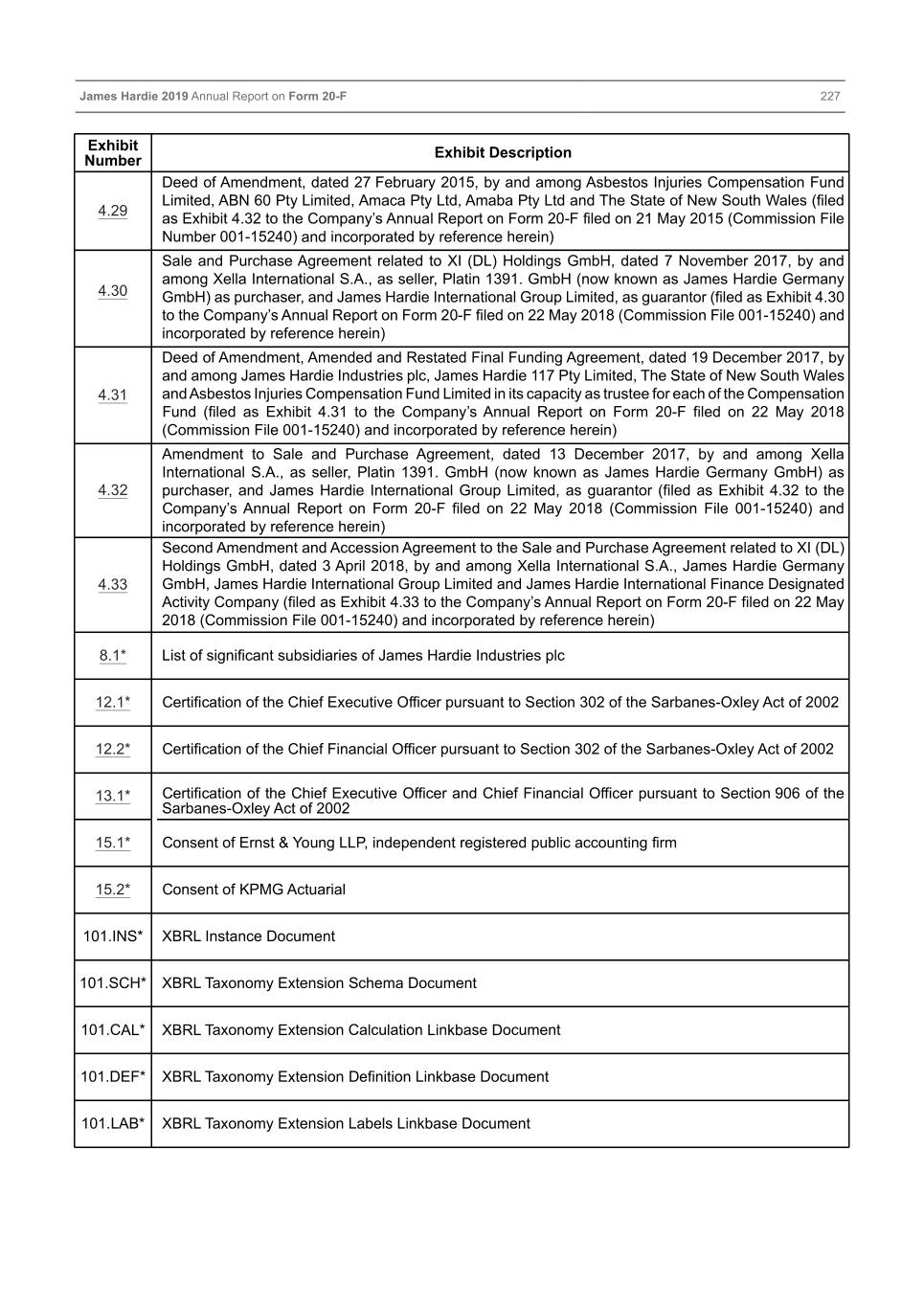
Table of Contents James Hardie 2019 Annual Report on Form 20-F 227 Exhibit Exhibit Description Number Deed of Amendment, dated 27 February 2015, by and among Asbestos Injuries Compensation Fund Limited, ABN 60 Pty Limited, Amaca Pty Ltd, Amaba Pty Ltd and The State of New South Wales (filed 4.29 as Exhibit 4.32 to the Company’s Annual Report on Form 20-F filed on 21 May 2015 (Commission File Number 001-15240) and incorporated by reference herein) Sale and Purchase Agreement related to XI (DL) Holdings GmbH, dated 7 November 2017, by and among Xella International S.A., as seller, Platin 1391. GmbH (now known as James Hardie Germany 4.30 GmbH) as purchaser, and James Hardie International Group Limited, as guarantor (filed as Exhibit 4.30 to the Company’s Annual Report on Form 20-F filed on 22 May 2018 (Commission File 001-15240) and incorporated by reference herein) Deed of Amendment, Amended and Restated Final Funding Agreement, dated 19 December 2017, by and among James Hardie Industries plc, James Hardie 117 Pty Limited, The State of New South Wales 4.31 and Asbestos Injuries Compensation Fund Limited in its capacity as trustee for each of the Compensation Fund (filed as Exhibit 4.31 to the Company’s Annual Report on Form 20-F filed on 22 May 2018 (Commission File 001-15240) and incorporated by reference herein) Amendment to Sale and Purchase Agreement, dated 13 December 2017, by and among Xella International S.A., as seller, Platin 1391. GmbH (now known as James Hardie Germany GmbH) as 4.32 purchaser, and James Hardie International Group Limited, as guarantor (filed as Exhibit 4.32 to the Company’s Annual Report on Form 20-F filed on 22 May 2018 (Commission File 001-15240) and incorporated by reference herein) Second Amendment and Accession Agreement to the Sale and Purchase Agreement related to XI (DL) Holdings GmbH, dated 3 April 2018, by and among Xella International S.A., James Hardie Germany 4.33 GmbH, James Hardie International Group Limited and James Hardie International Finance Designated Activity Company (filed as Exhibit 4.33 to the Company’s Annual Report on Form 20-F filed on 22 May 2018 (Commission File 001-15240) and incorporated by reference herein) 8.1* List of significant subsidiaries of James Hardie Industries plc 12.1* Certification of the Chief Executive Officer pursuant to Section 302 of the Sarbanes-Oxley Act of 2002 12.2* Certification of the Chief Financial Officer pursuant to Section 302 of the Sarbanes-Oxley Act of 2002 13.1* Certification of the Chief Executive Officer and Chief Financial Officer pursuant to Section 906 of the Sarbanes-Oxley Act of 2002 15.1* Consent of Ernst & Young LLP, independent registered public accounting firm 15.2* Consent of KPMG Actuarial 101.INS* XBRL Instance Document 101.SCH* XBRL Taxonomy Extension Schema Document 101.CAL* XBRL Taxonomy Extension Calculation Linkbase Document 101.DEF* XBRL Taxonomy Extension Definition Linkbase Document 101.LAB* XBRL Taxonomy Extension Labels Linkbase Document
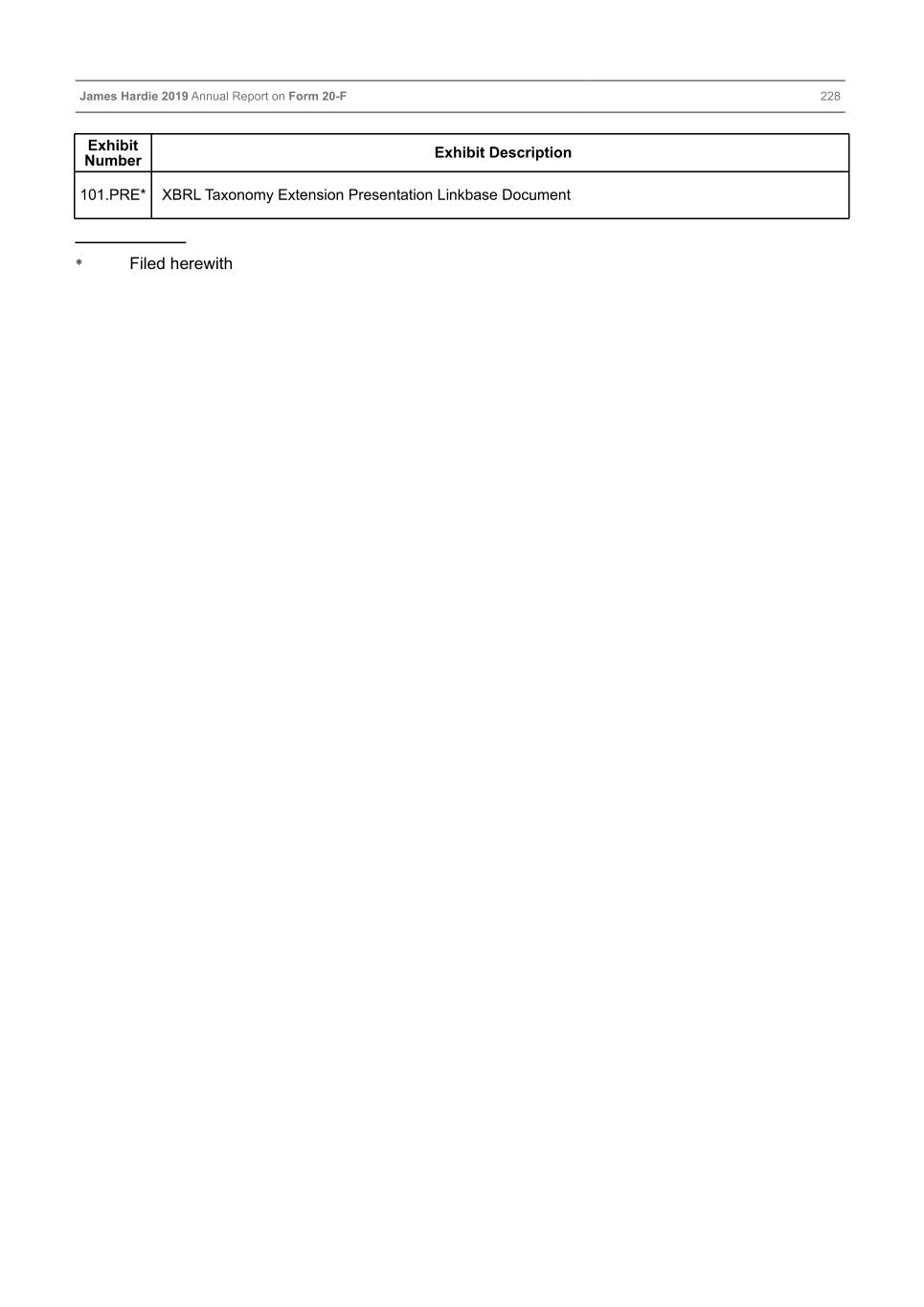
Table of Contents James Hardie 2019 Annual Report on Form 20-F 228 Exhibit Exhibit Description Number 101.PRE* XBRL Taxonomy Extension Presentation Linkbase Document ____________ * Filed herewith
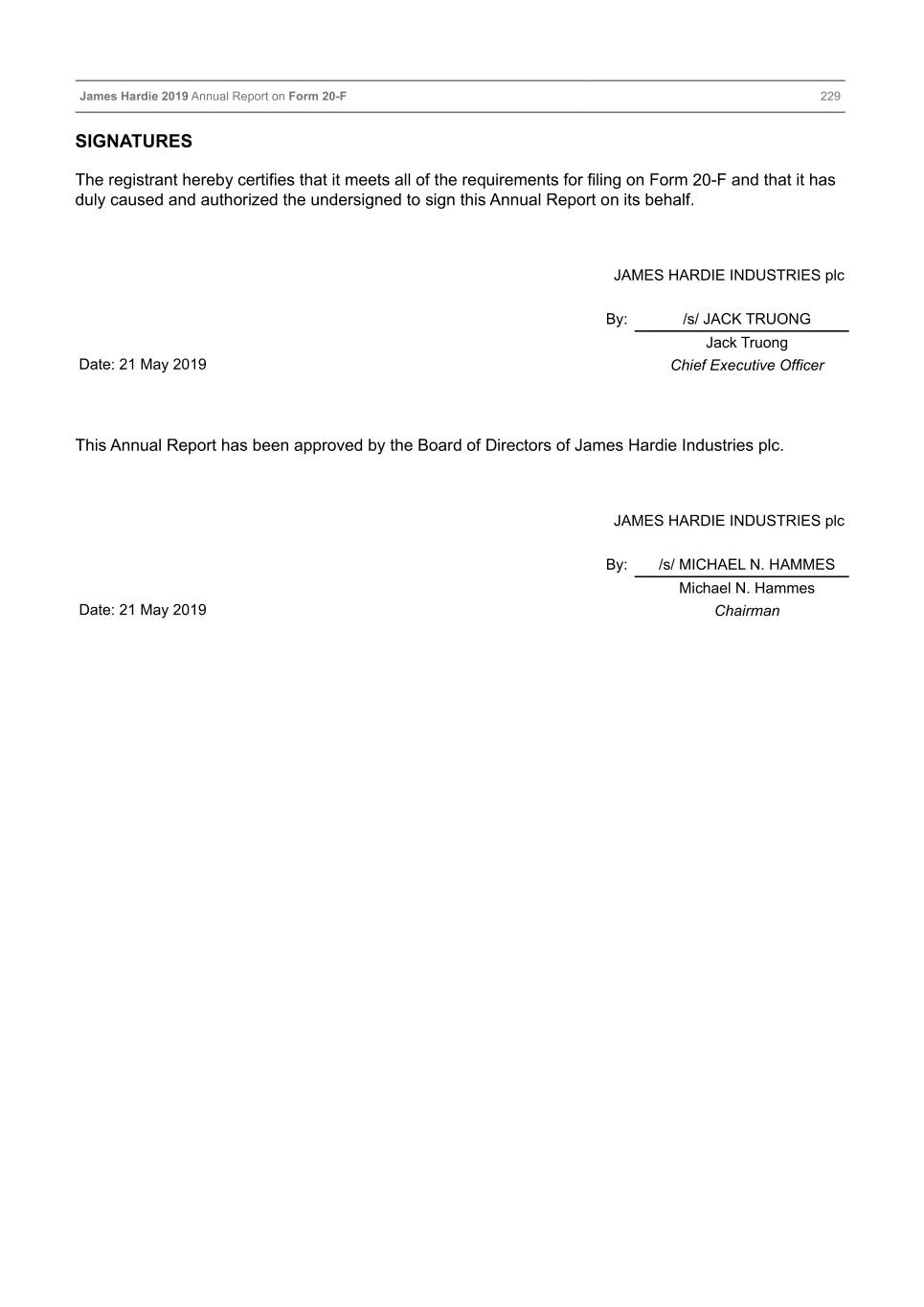
Table of Contents James Hardie 2019 Annual Report on Form 20-F 229 SIGNATURES The registrant hereby certifies that it meets all of the requirements for filing on Form 20-F and that it has duly caused and authorized the undersigned to sign this Annual Report on its behalf. JAMES HARDIE INDUSTRIES plc By: /s/ JACK TRUONG Jack Truong Date: 21 May 2019 Chief Executive Officer This Annual Report has been approved by the Board of Directors of James Hardie Industries plc. JAMES HARDIE INDUSTRIES plc By: /s/ MICHAEL N. HAMMES Michael N. Hammes Date: 21 May 2019 Chairman

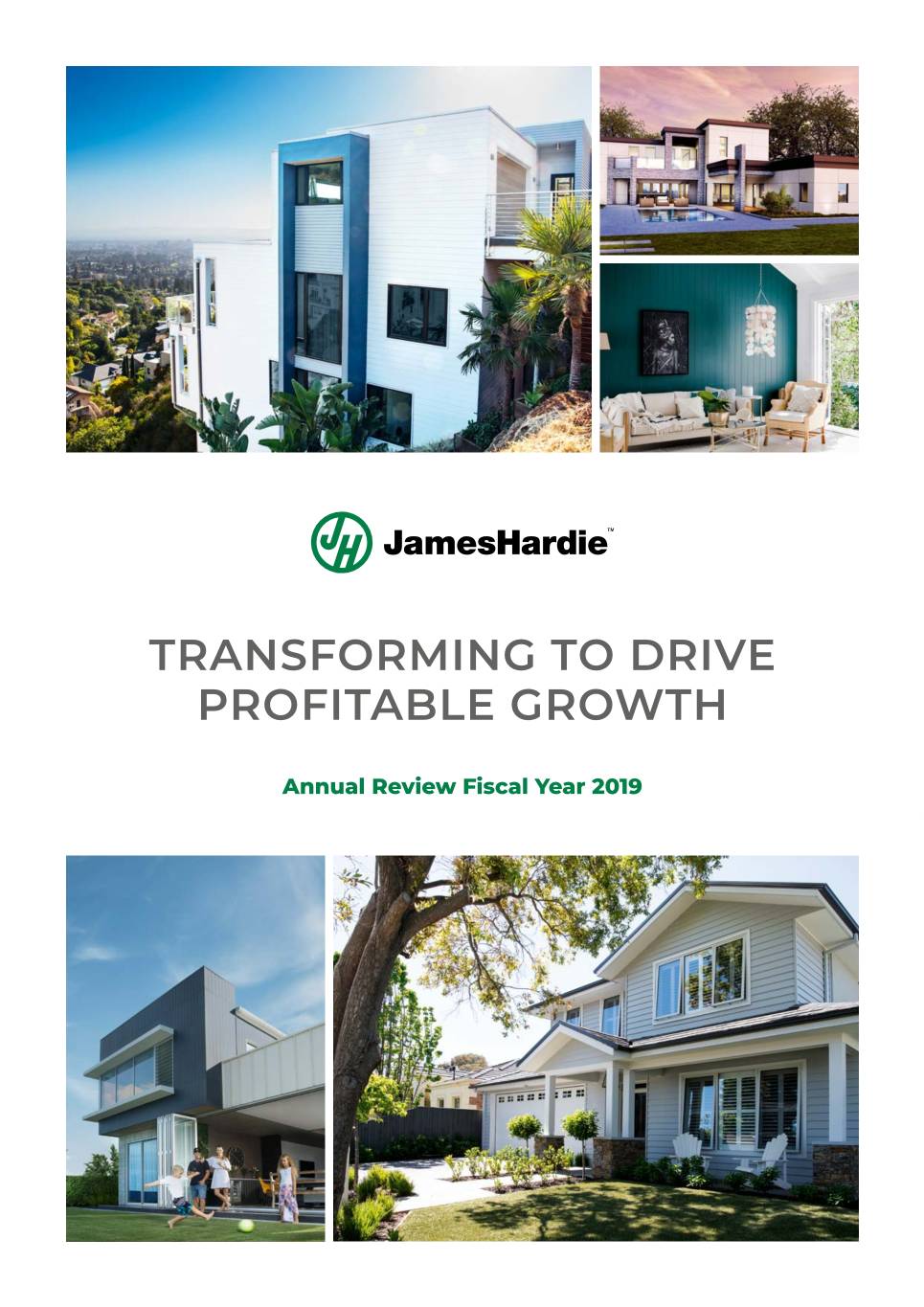
TRANSFORMING TO DRIVE PROFITABLE GROWTH Annual Review Fiscal Year 2019
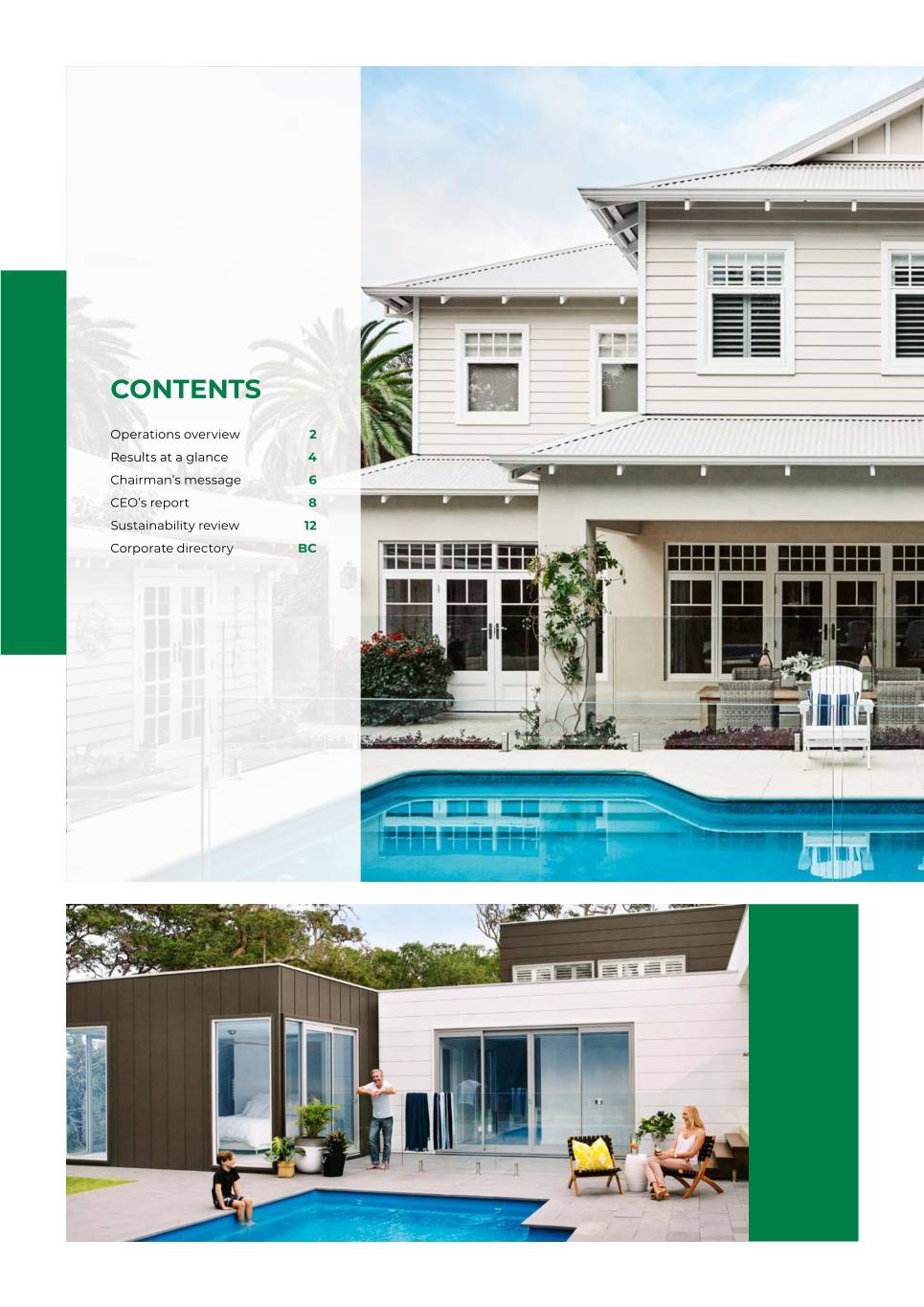
CONTENTS Operations overview 2 Results at a glance 4 Chairman’s message 6 CEO’s report 8 Sustainability review 12 Corporate directory BC
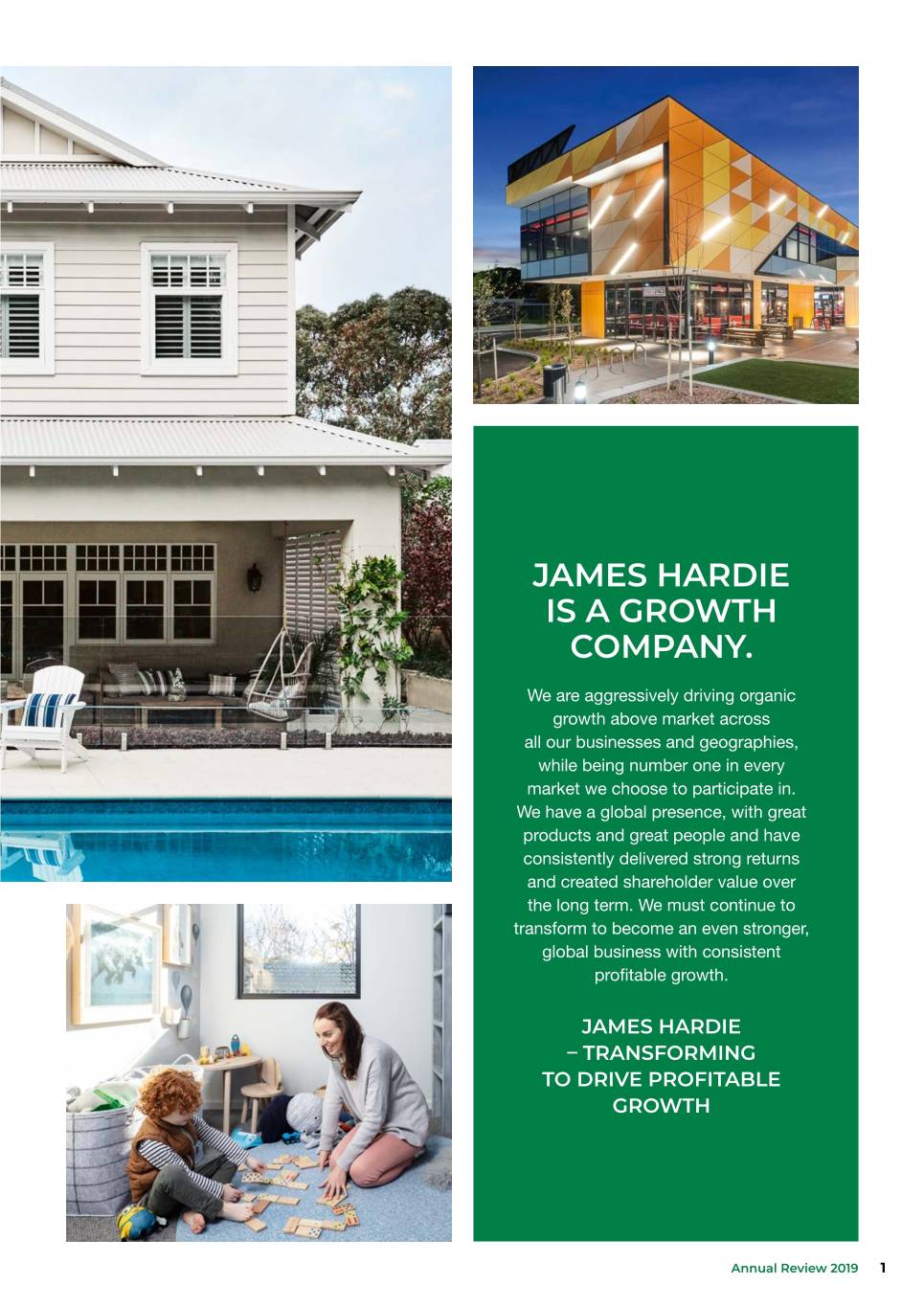
JAMES HARDIE IS A GROWTH COMPANY. We are aggressively driving organic growth above market across all our businesses and geographies, while being number one in every market we choose to participate in. We have a global presence, with great products and great people and have consistently delivered strong returns and created shareholder value over the long term. We must continue to transform to become an even stronger, global business with consistent profitable growth. JAMES HARDIE – TRANSFORMING TO DRIVE PROFITABLE GROWTH Annual Review 2019 1
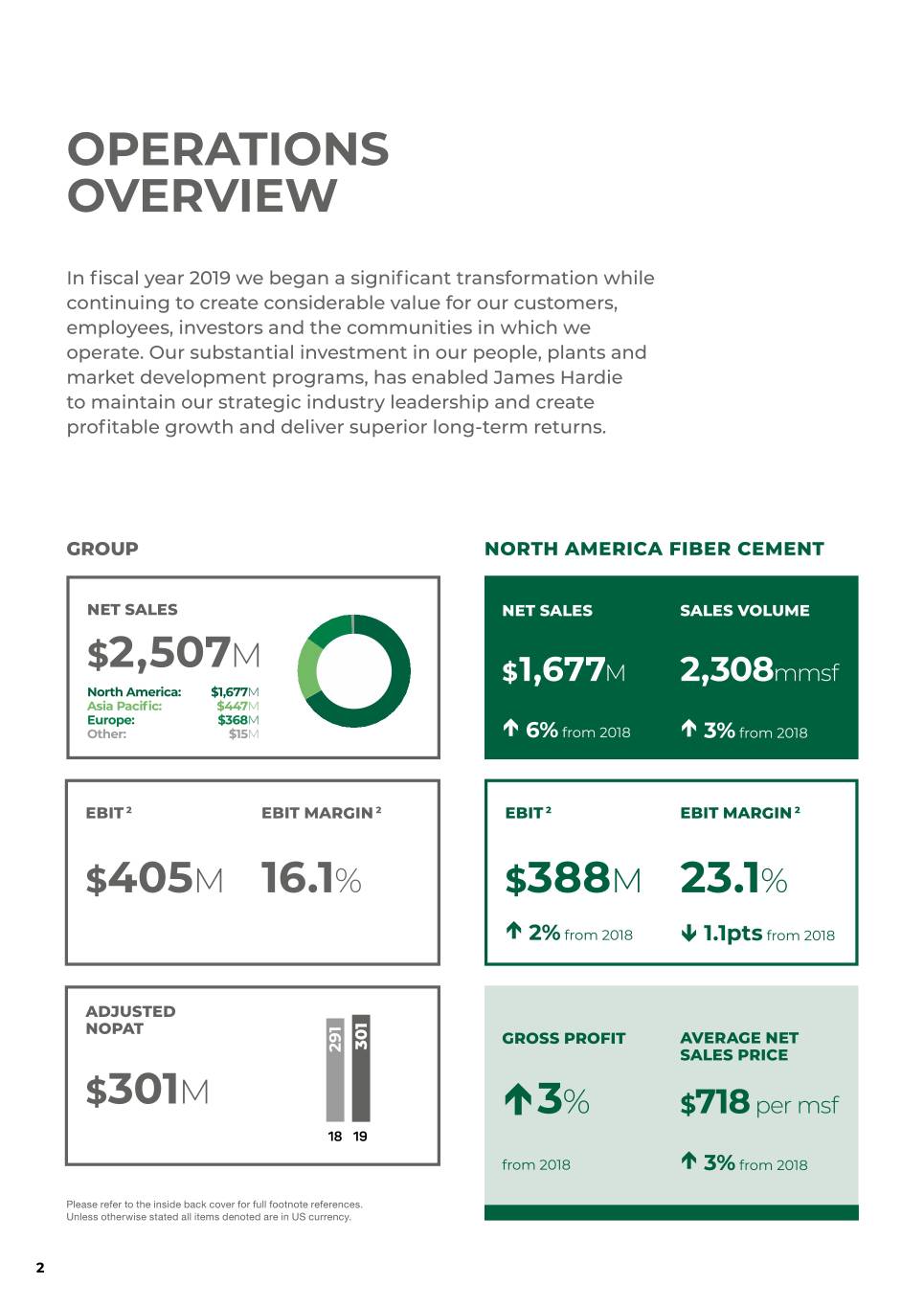
OPERATIONS OVERVIEW In fiscal year 2019 we began a significant transformation while continuing to create considerable value for our customers, employees, investors and the communities in which we operate. Our substantial investment in our people, plants and market development programs, has enabled James Hardie to maintain our strategic industry leadership and create profitable growth and deliver superior long-term returns. GROUP NORTH AMERICA FIBER CEMENT NET SALES NET SALES SALES VOLUME $ M 2,507 $1,677M 2,308mmsf North America: $1,677M Asia Pacific: $447M Europe: $368M Other: $15M 6% from 2018 3% from 2018 EBIT 2 EBIT MARGIN 2 EBIT 2 EBIT MARGIN 2 $405M 16.1% $388M 23.1% 2% from 2018 1.1pts from 2018 ADJUSTED NOPAT GROSS PROFIT AVERAGE NET 301 291 SALES PRICE $301M 3% $718 per msf 18 19 from 2018 3% from 2018 Please refer to the inside back cover for full footnote references. Unless otherwise stated all items denoted are in US currency. 2
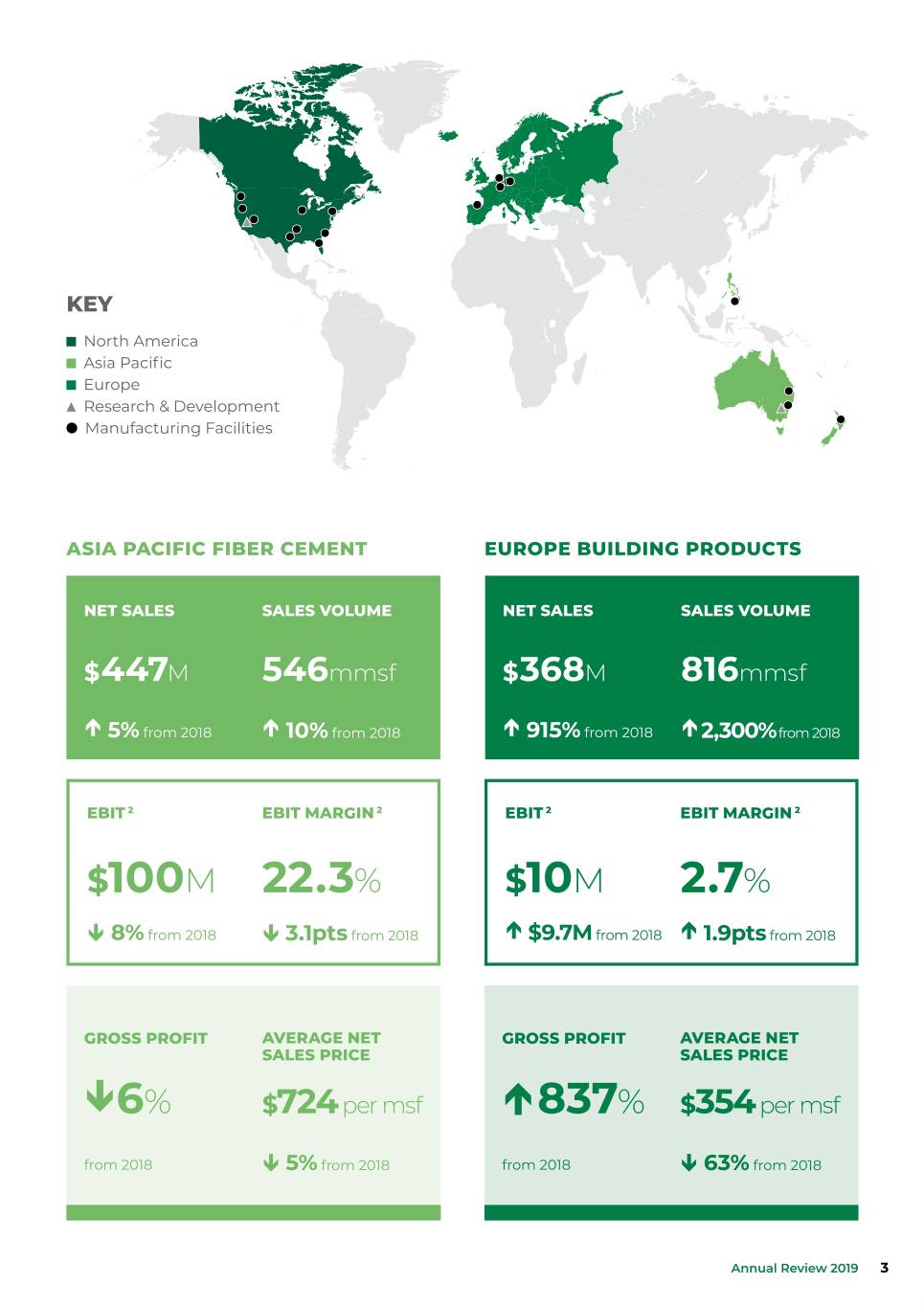
KEY North America Asia Pacific Europe Research & Development Manufacturing Facilities ASIA PACIFIC FIBER CEMENT EUROPE BUILDING PRODUCTS NET SALES SALES VOLUME NET SALES SALES VOLUME $447M 546mmsf $368M 816mmsf 5% from 2018 10% from 2018 915% from 2018 2,300% from 2018 EBIT 2 EBIT MARGIN 2 EBIT 2 EBIT MARGIN 2 $100M 22.3% $10M 2.7% 8% from 2018 3.1pts from 2018 $9.7M from 2018 1.9pts from 2018 GROSS PROFIT AVERAGE NET GROSS PROFIT AVERAGE NET SALES PRICE SALES PRICE 6% $724 per msf 837% $354 per msf from 2018 5% from 2018 from 2018 63% from 2018 Annual Review 2019 3
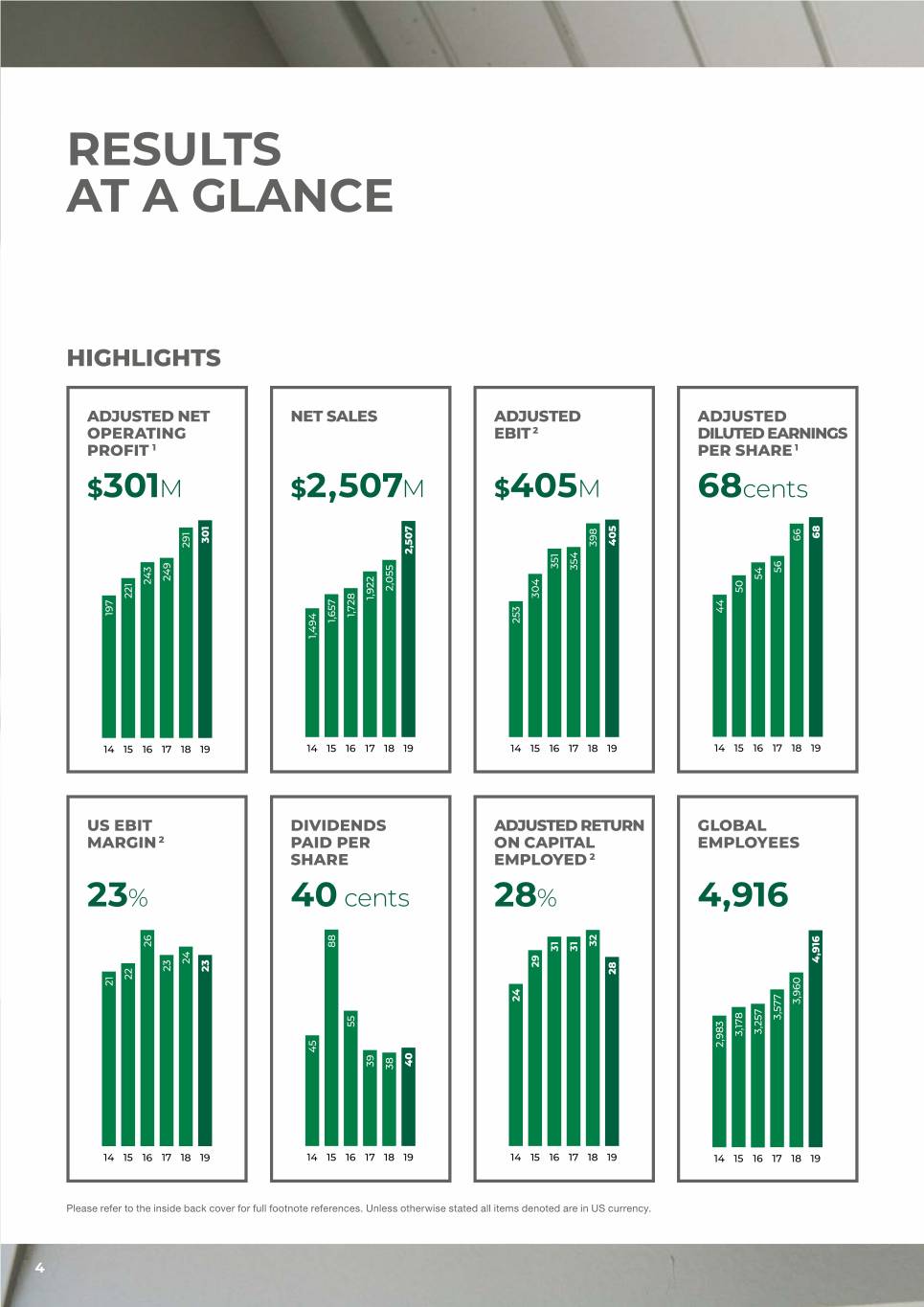
RESULTS AT A GLANCE HIGHLIGHTS ADJUSTED NET NET SALES ADJUSTED ADJUSTED OPERATING EBIT 2 DILUTED EARNINGS PROFIT 1 PER SHARE 1 $301M $2,507M $405M 68cents 68 66 301 405 398 291 2,507 351 354 56 54 249 243 2,055 50 304 221 1,922 44 197 1,728 1,657 253 1,494 14 15 16 17 18 19 14 15 16 17 18 19 14 15 16 17 18 19 14 15 16 17 18 19 US EBIT DIVIDENDS ADJUSTED RETURN GLOBAL MARGIN 2 PAID PER ON CAPITAL EMPLOYEES SHARE EMPLOYED 2 23% 40 cents 28% 4,916 32 26 88 31 31 4,916 24 29 23 23 28 22 21 24 3,960 3,577 55 3,257 3,178 2,983 45 40 39 38 14 15 16 17 18 19 14 15 16 17 18 19 14 15 16 17 18 19 14 15 16 17 18 19 Please refer to the inside back cover for full footnote references. Unless otherwise stated all items denoted are in US currency. 4
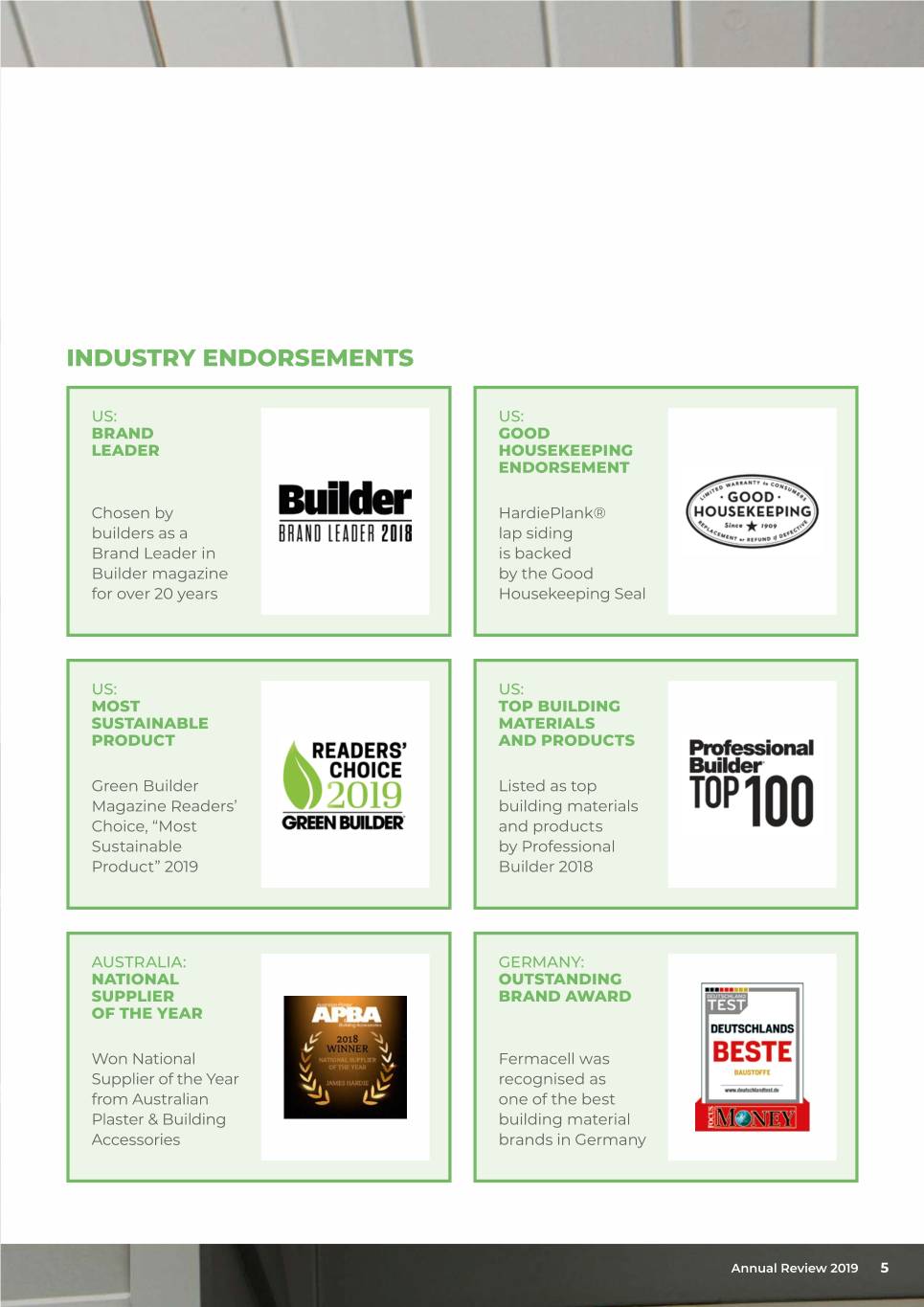
INDUSTRY ENDORSEMENTS US: US: BRAND GOOD LEADER HOUSEKEEPING ENDORSEMENT Chosen by HardiePlank® builders as a lap siding Brand Leader in is backed Builder magazine by the Good for over 20 years Housekeeping Seal US: US: MOST TOP BUILDING SUSTAINABLE MATERIALS PRODUCT AND PRODUCTS Green Builder Listed as top Magazine Readers’ building materials Choice, “Most and products Sustainable by Professional Product” 2019 Builder 2018 AUSTRALIA: GERMANY: NATIONAL OUTSTANDING SUPPLIER BRAND AWARD OF THE YEAR Won National Fermacell was Supplier of the Year recognised as from Australian one of the best Plaster & Building building material Accessories brands in Germany Annual Review 2019 5
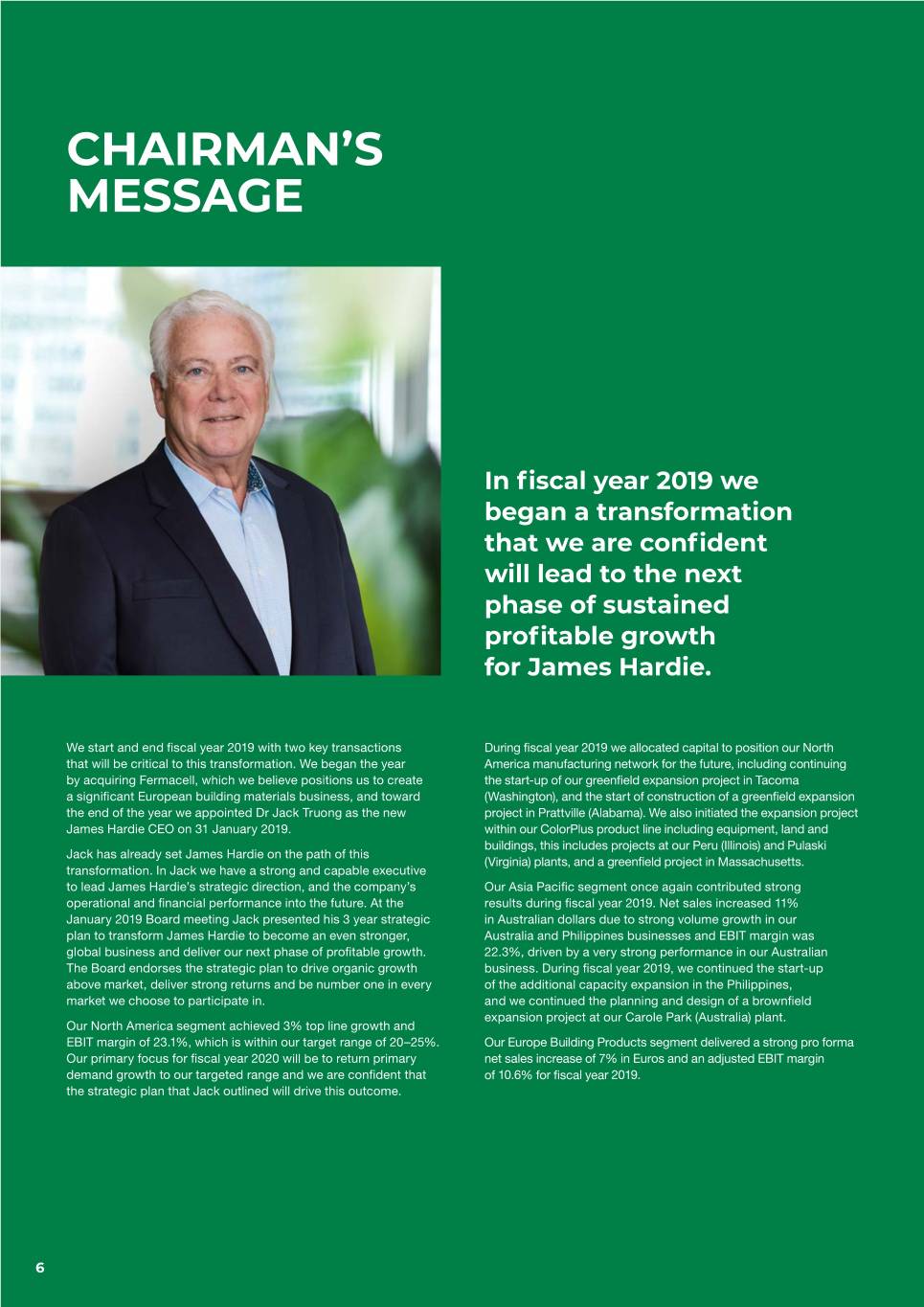
CHAIRMAN’S MESSAGE In fiscal year 2019 we began a transformation that we are confident will lead to the next phase of sustained profitable growth for James Hardie. We start and end fiscal year 2019 with two key transactions During fiscal year 2019 we allocated capital to position our North that will be critical to this transformation. We began the year America manufacturing network for the future, including continuing by acquiring Fermacell, which we believe positions us to create the start-up of our greenfield expansion project in Tacoma a significant European building materials business, and toward (Washington), and the start of construction of a greenfield expansion the end of the year we appointed Dr Jack Truong as the new project in Prattville (Alabama). We also initiated the expansion project James Hardie CEO on 31 January 2019. within our ColorPlus product line including equipment, land and buildings, this includes projects at our Peru (Illinois) and Pulaski Jack has already set James Hardie on the path of this (Virginia) plants, and a greenfield project in Massachusetts. transformation. In Jack we have a strong and capable executive to lead James Hardie’s strategic direction, and the company’s Our Asia Pacific segment once again contributed strong operational and financial performance into the future. At the results during fiscal year 2019. Net sales increased 11% January 2019 Board meeting Jack presented his 3 year strategic in Australian dollars due to strong volume growth in our plan to transform James Hardie to become an even stronger, Australia and Philippines businesses and EBIT margin was global business and deliver our next phase of profitable growth. 22.3%, driven by a very strong performance in our Australian The Board endorses the strategic plan to drive organic growth business. During fiscal year 2019, we continued the start‑up above market, deliver strong returns and be number one in every of the additional capacity expansion in the Philippines, market we choose to participate in. and we continued the planning and design of a brownfield expansion project at our Carole Park (Australia) plant. Our North America segment achieved 3% top line growth and EBIT margin of 23.1%, which is within our target range of 20–25%. Our Europe Building Products segment delivered a strong pro forma Our primary focus for fiscal year 2020 will be to return primary net sales increase of 7% in Euros and an adjusted EBIT margin demand growth to our targeted range and we are confident that of 10.6% for fiscal year 2019. the strategic plan that Jack outlined will drive this outcome. 6
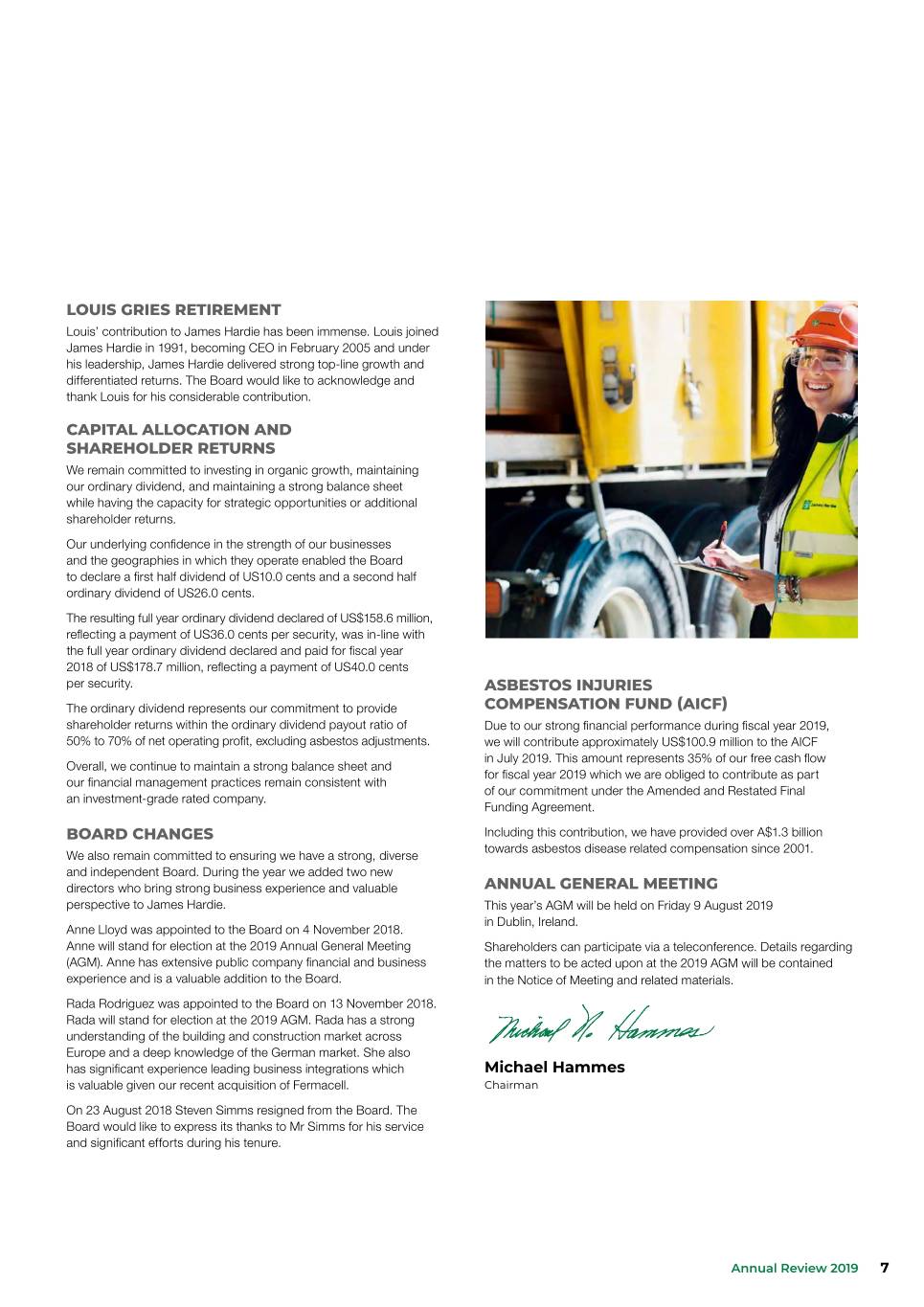
LOUIS GRIES RETIREMENT Louis’ contribution to James Hardie has been immense. Louis joined James Hardie in 1991, becoming CEO in February 2005 and under his leadership, James Hardie delivered strong top‑line growth and differentiated returns. The Board would like to acknowledge and thank Louis for his considerable contribution. CAPITAL ALLOCATION AND SHAREHOLDER RETURNS We remain committed to investing in organic growth, maintaining our ordinary dividend, and maintaining a strong balance sheet while having the capacity for strategic opportunities or additional shareholder returns. Our underlying confidence in the strength of our businesses and the geographies in which they operate enabled the Board to declare a first half dividend of US10.0 cents and a second half ordinary dividend of US26.0 cents. The resulting full year ordinary dividend declared of US$158.6 million, reflecting a payment of US36.0 cents per security, was in-line with the full year ordinary dividend declared and paid for fiscal year 2018 of US$178.7 million, reflecting a payment of US40.0 cents per security. ASBESTOS INJURIES The ordinary dividend represents our commitment to provide COMPENSATION FUND (AICF) shareholder returns within the ordinary dividend payout ratio of Due to our strong financial performance during fiscal year 2019, 50% to 70% of net operating profit, excluding asbestos adjustments. we will contribute approximately US$100.9 million to the AICF in July 2019. This amount represents 35% of our free cash flow Overall, we continue to maintain a strong balance sheet and for fiscal year 2019 which we are obliged to contribute as part our financial management practices remain consistent with of our commitment under the Amended and Restated Final an investment-grade rated company. Funding Agreement. BOARD CHANGES Including this contribution, we have provided over A$1.3 billion towards asbestos disease related compensation since 2001. We also remain committed to ensuring we have a strong, diverse and independent Board. During the year we added two new directors who bring strong business experience and valuable ANNUAL GENERAL MEETING perspective to James Hardie. This year’s AGM will be held on Friday 9 August 2019 in Dublin, Ireland. Anne Lloyd was appointed to the Board on 4 November 2018. Anne will stand for election at the 2019 Annual General Meeting Shareholders can participate via a teleconference. Details regarding (AGM). Anne has extensive public company financial and business the matters to be acted upon at the 2019 AGM will be contained experience and is a valuable addition to the Board. in the Notice of Meeting and related materials. Rada Rodriguez was appointed to the Board on 13 November 2018. Rada will stand for election at the 2019 AGM. Rada has a strong understanding of the building and construction market across Europe and a deep knowledge of the German market. She also has significant experience leading business integrations which Michael Hammes is valuable given our recent acquisition of Fermacell. Chairman On 23 August 2018 Steven Simms resigned from the Board. The Board would like to express its thanks to Mr Simms for his service and significant efforts during his tenure. Annual Review 2019 7
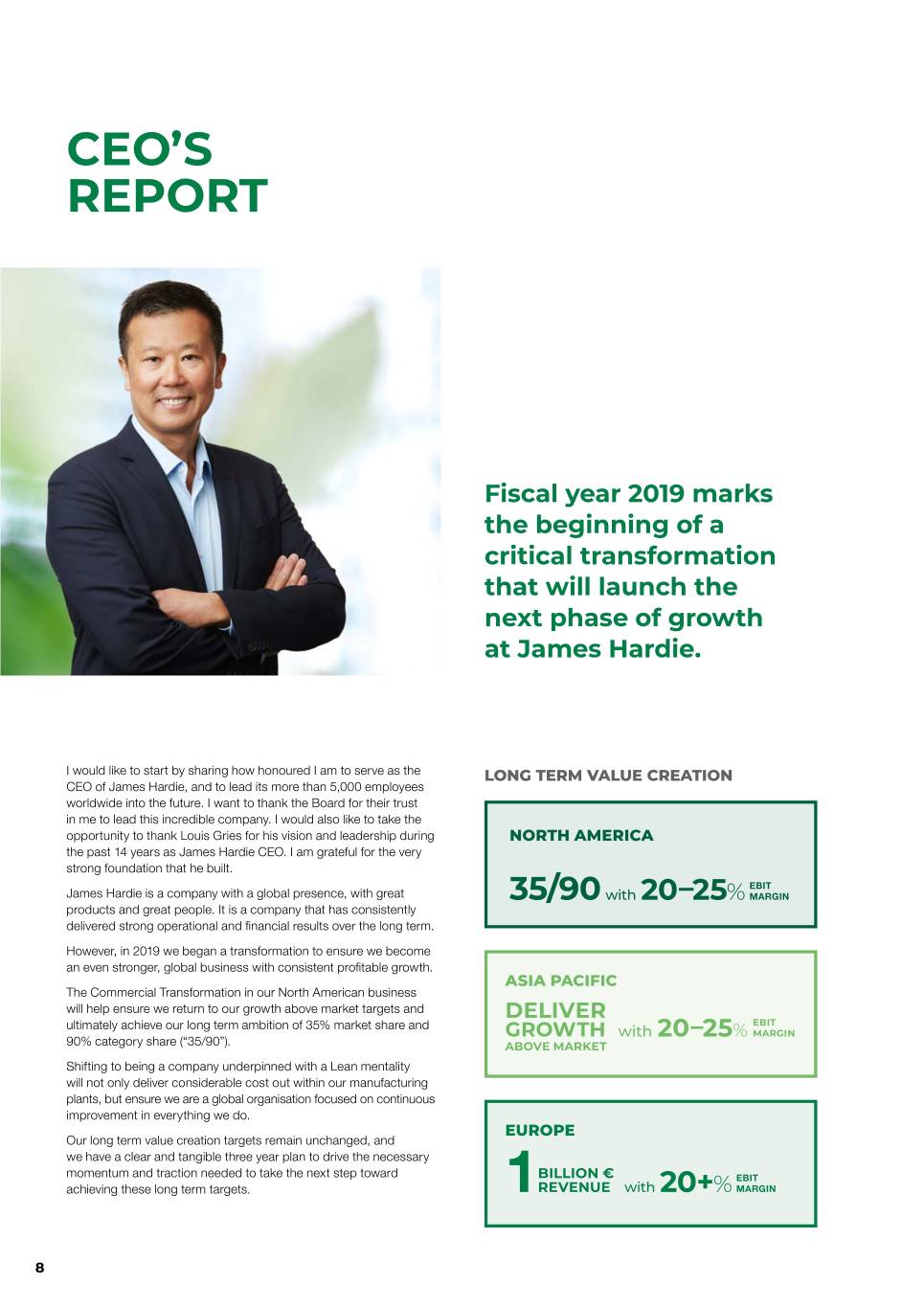
CEO’S REPORT Fiscal year 2019 marks the beginning of a critical transformation that will launch the next phase of growth at James Hardie. I would like to start by sharing how honoured I am to serve as the LONG TERM VALUE CREATION CEO of James Hardie, and to lead its more than 5,000 employees worldwide into the future. I want to thank the Board for their trust in me to lead this incredible company. I would also like to take the opportunity to thank Louis Gries for his vision and leadership during NORTH AMERICA the past 14 years as James Hardie CEO. I am grateful for the very strong foundation that he built. EBIT James Hardie is a company with a global presence, with great 35/90 with 20–25% MARGIN products and great people. It is a company that has consistently delivered strong operational and financial results over the long term. However, in 2019 we began a transformation to ensure we become an even stronger, global business with consistent profitable growth. ASIA PACIFIC The Commercial Transformation in our North American business will help ensure we return to our growth above market targets and DELIVER ultimately achieve our long term ambition of 35% market share and EBIT GROWTH with 20–25% MARGIN 90% category share (“35/90”). ABOVE MARKET Shifting to being a company underpinned with a Lean mentality will not only deliver considerable cost out within our manufacturing plants, but ensure we are a global organisation focused on continuous improvement in everything we do. EUROPE Our long term value creation targets remain unchanged, and we have a clear and tangible three year plan to drive the necessary momentum and traction needed to take the next step toward BILLION € EBIT achieving these long term targets. 1REVENUE with 20+% MARGIN 8

GLOBAL STRATEGY Organic growth above market with strong returns Be #1 in every market we choose to participate in FULL EXPAND LEAN HARDIE INTERIOR INNOVATION MANUFACTURING EXTERIOR BUSINESS BUILD ON Culture and employee engagement ORGANISATIONAL THRIVE ON ADVANTAGE COMPETITION Empowerment PDCA Continuous Global Mindset & accountability Improvement Mindset EMBRACE STEP OPERATE WITH RESPECT CHANGE Cross Functional Best Practice Future Forward Planning Teamwork Sharing & Replication for Predictable Results ZERO HARM GLOBAL STRATEGY Our global strategy is to deliver organic and accountable, that works cross growth above market with strong returns functionally, sharing best practices and to be #1 in every market we choose and maintains a global and continuous to participate in. improvement mindset. That strategy begins with the foundation Our global strategy is underpinned of Zero Harm; we are committed to safe by four clear strategic pillars: people, safe places and safe systems. §§ Full Hardie Exterior; The culture of our global company and §§ Expand Interior Business; employee engagement is also critical to our success. We are cultivating an §§ Innovation; and engaged workforce that is empowered §§ Lean Manufacturing. Annual Review 2019 9
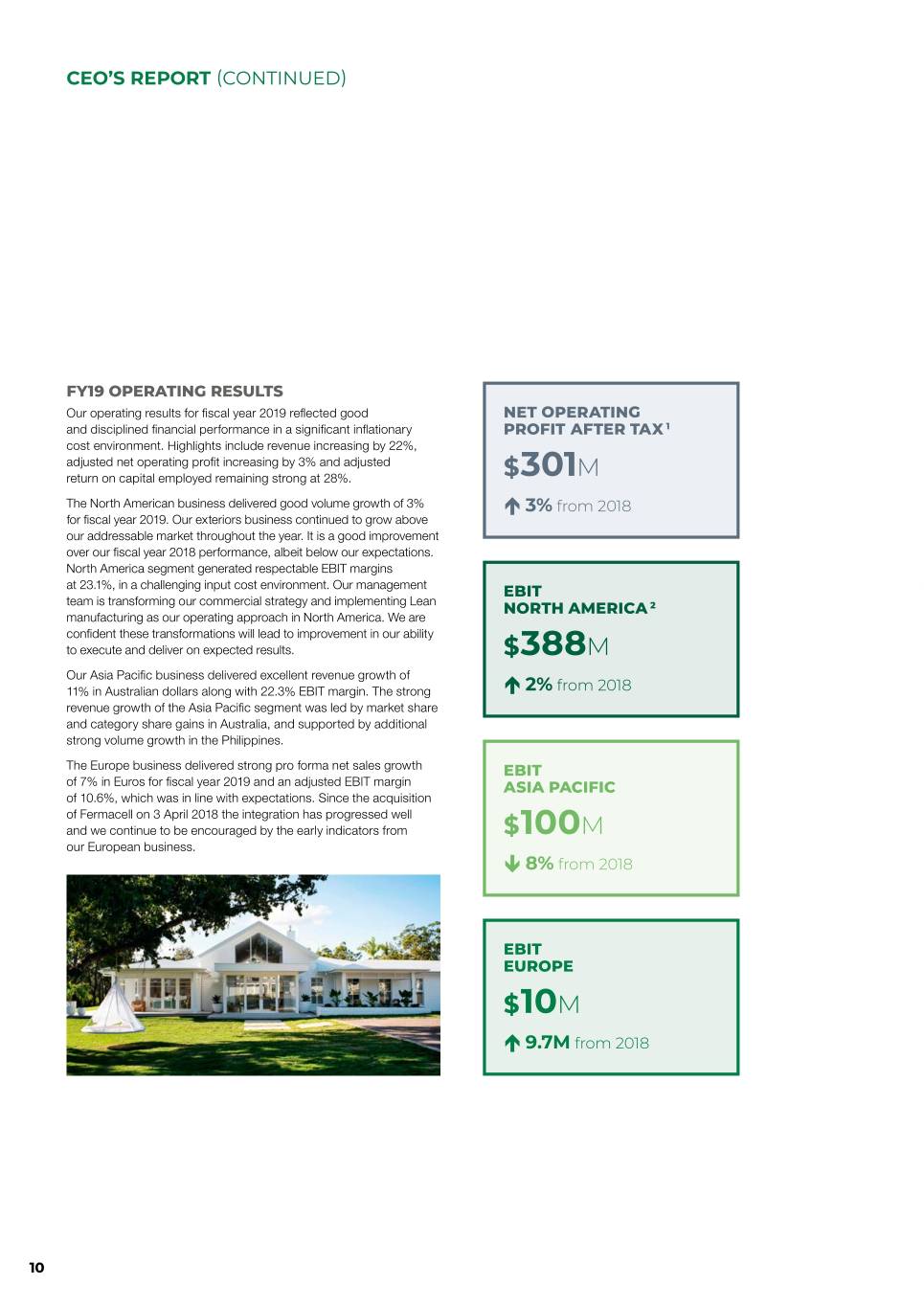
CEO’S REPORT (CONTINUED) FY19 OPERATING RESULTS Our operating results for fiscal year 2019 reflected good NET OPERATING and disciplined financial performance in a significant inflationary PROFIT AFTER TAX 1 cost environment. Highlights include revenue increasing by 22%, adjusted net operating profit increasing by 3% and adjusted return on capital employed remaining strong at 28%. $301M The North American business delivered good volume growth of 3% 3% from 2018 for fiscal year 2019. Our exteriors business continued to grow above our addressable market throughout the year. It is a good improvement over our fiscal year 2018 performance, albeit below our expectations. North America segment generated respectable EBIT margins at 23.1%, in a challenging input cost environment. Our management EBIT team is transforming our commercial strategy and implementing Lean NORTH AMERICA 2 manufacturing as our operating approach in North America. We are confident these transformations will lead to improvement in our ability to execute and deliver on expected results. $388M Our Asia Pacific business delivered excellent revenue growth of 11% in Australian dollars along with 22.3% EBIT margin. The strong 2% from 2018 revenue growth of the Asia Pacific segment was led by market share and category share gains in Australia, and supported by additional strong volume growth in the Philippines. The Europe business delivered strong pro forma net sales growth EBIT of 7% in Euros for fiscal year 2019 and an adjusted EBIT margin ASIA PACIFIC of 10.6%, which was in line with expectations. Since the acquisition of Fermacell on 3 April 2018 the integration has progressed well and we continue to be encouraged by the early indicators from $100M our European business. 8% from 2018 EBIT EUROPE $10M 9.7M from 2018 10
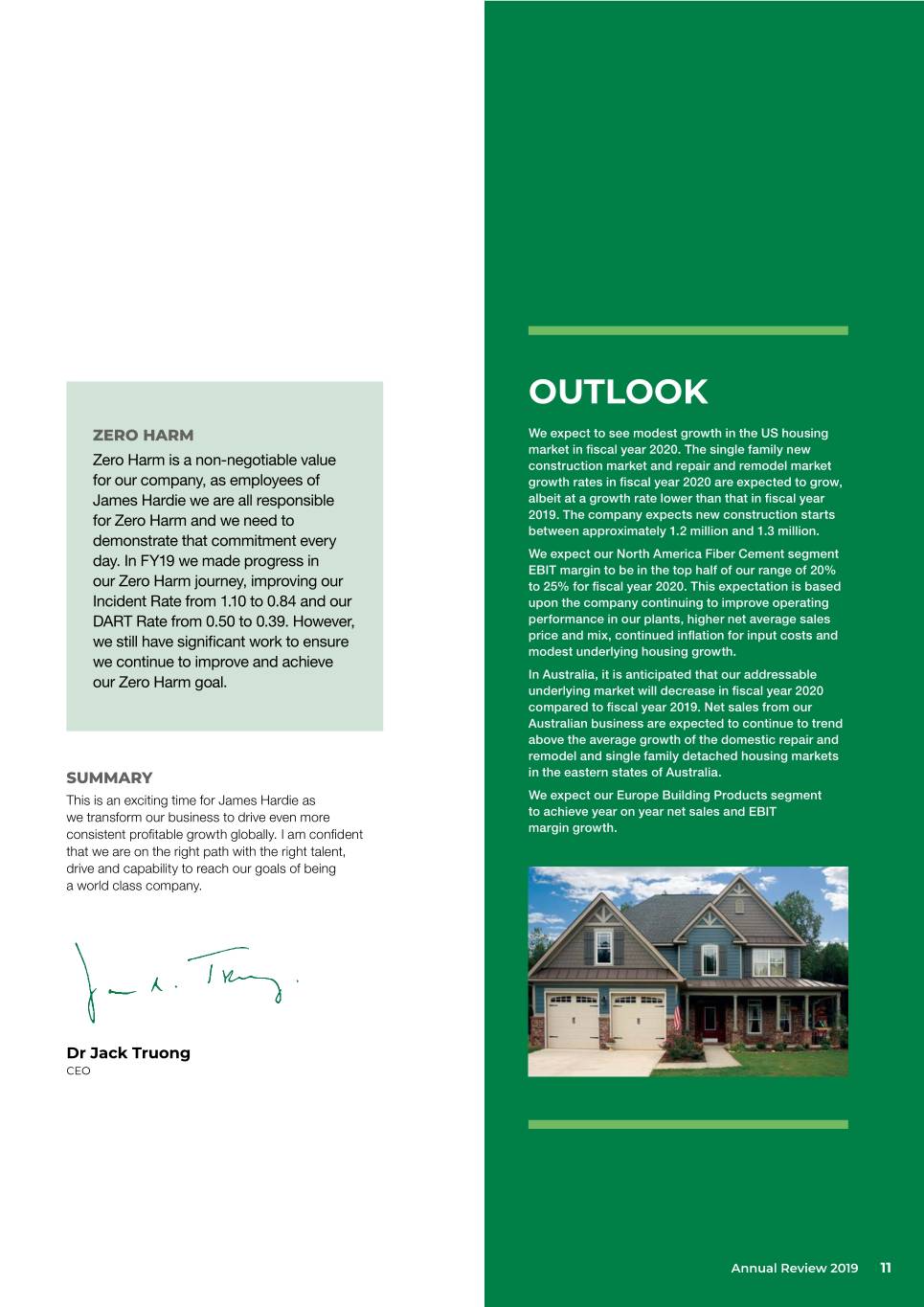
OUTLOOK ZERO HARM We expect to see modest growth in the US housing market in fiscal year 2020. The single family new Zero Harm is a non-negotiable value construction market and repair and remodel market for our company, as employees of growth rates in fiscal year 2020 are expected to grow, James Hardie we are all responsible albeit at a growth rate lower than that in fiscal year for Zero Harm and we need to 2019. The company expects new construction starts between approximately 1.2 million and 1.3 million. demonstrate that commitment every day. In FY19 we made progress in We expect our North America Fiber Cement segment EBIT margin to be in the top half of our range of 20% our Zero Harm journey, improving our to 25% for fiscal year 2020. This expectation is based Incident Rate from 1.10 to 0.84 and our upon the company continuing to improve operating DART Rate from 0.50 to 0.39. However, performance in our plants, higher net average sales we still have significant work to ensure price and mix, continued inflation for input costs and modest underlying housing growth. we continue to improve and achieve our Zero Harm goal. In Australia, it is anticipated that our addressable underlying market will decrease in fiscal year 2020 compared to fiscal year 2019. Net sales from our Australian business are expected to continue to trend above the average growth of the domestic repair and remodel and single family detached housing markets SUMMARY in the eastern states of Australia. This is an exciting time for James Hardie as We expect our Europe Building Products segment we transform our business to drive even more to achieve year on year net sales and EBIT consistent profitable growth globally. I am confident margin growth. that we are on the right path with the right talent, drive and capability to reach our goals of being a world class company. Dr Jack Truong CEO Annual Review 2019 11
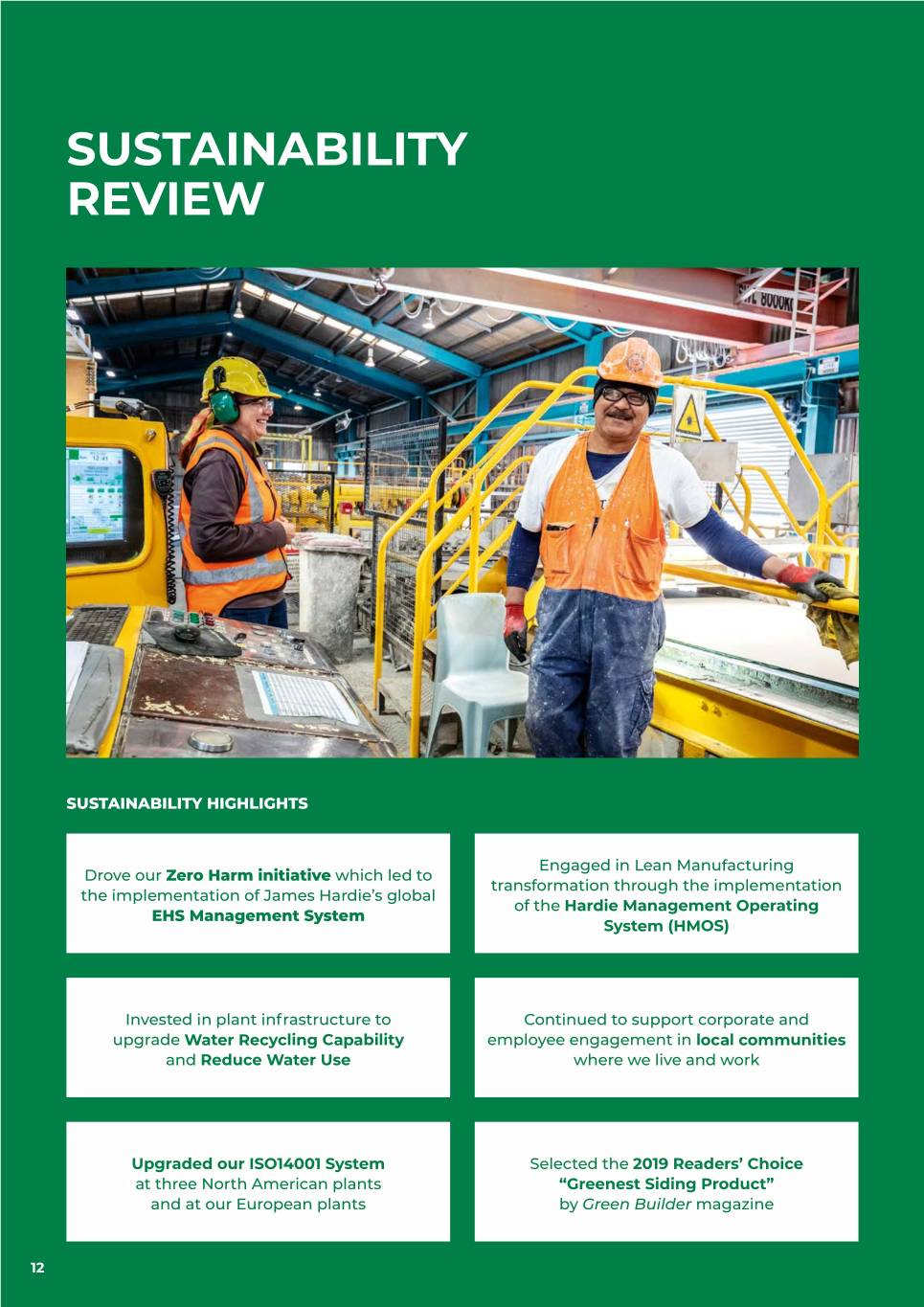
SUSTAINABILITY REVIEW SUSTAINABILITY HIGHLIGHTS Engaged in Lean Manufacturing Drove our Zero Harm initiative which led to transformation through the implementation the implementation of James Hardie’s global of the Hardie Management Operating EHS Management System System (HMOS) Invested in plant infrastructure to Continued to support corporate and upgrade Water Recycling Capability employee engagement in local communities and Reduce Water Use where we live and work Upgraded our ISO14001 System Selected the 2019 Readers’ Choice at three North American plants “Greenest Siding Product” and at our European plants by Green Builder magazine 12
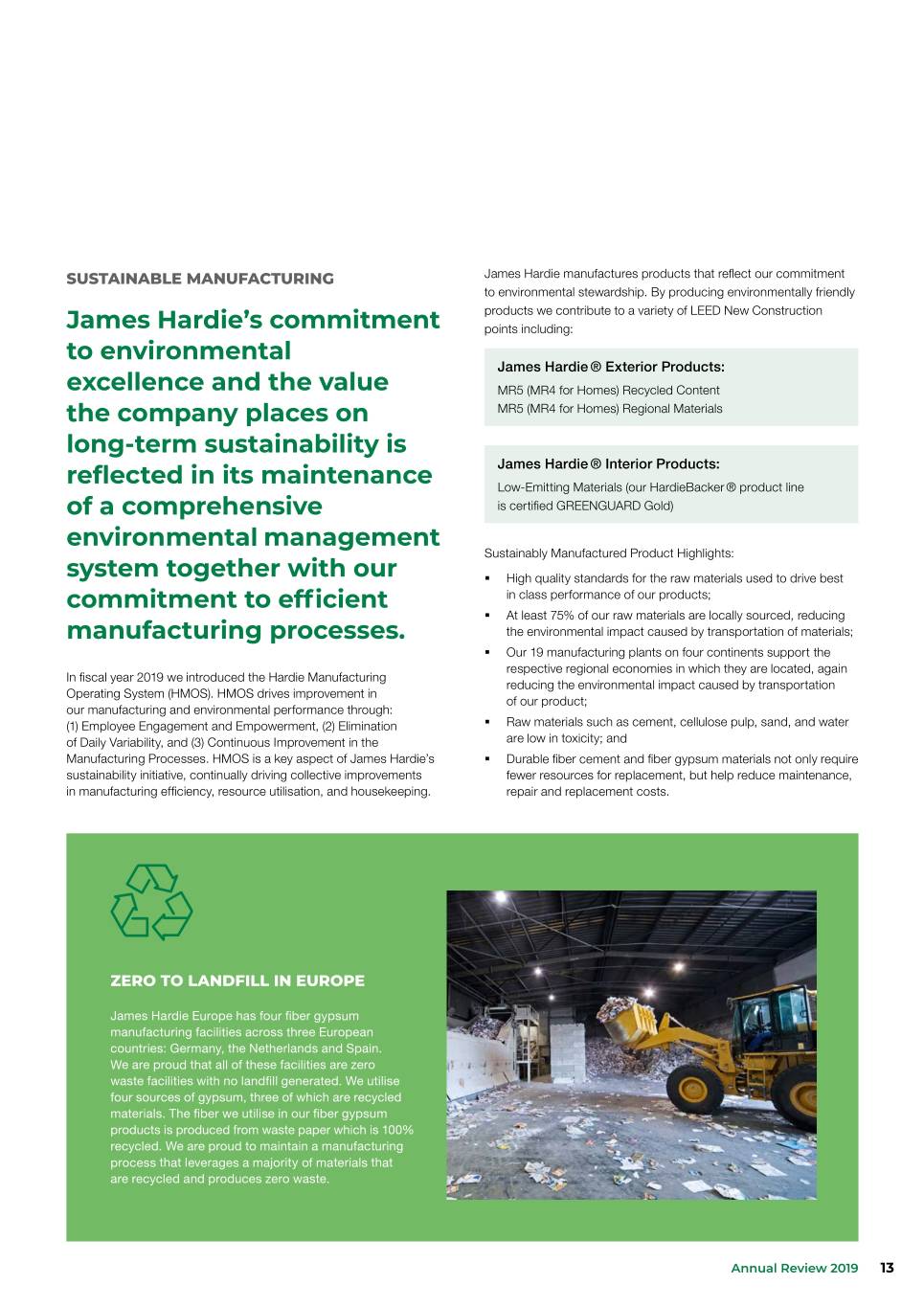
SUSTAINABLE MANUFACTURING James Hardie manufactures products that reflect our commitment to environmental stewardship. By producing environmentally friendly products we contribute to a variety of LEED New Construction James Hardie’s commitment points including: to environmental James Hardie ® Exterior Products: excellence and the value MR5 (MR4 for Homes) Recycled Content the company places on MR5 (MR4 for Homes) Regional Materials long‑term sustainability is James Hardie ® Interior Products: reflected in its maintenance Low-Emitting Materials (our HardieBacker ® product line of a comprehensive is certified GREENGUARD Gold) environmental management Sustainably Manufactured Product Highlights: system together with our §§ High quality standards for the raw materials used to drive best commitment to efficient in class performance of our products; §§ At least 75% of our raw materials are locally sourced, reducing manufacturing processes. the environmental impact caused by transportation of materials; §§ Our 19 manufacturing plants on four continents support the respective regional economies in which they are located, again In fiscal year 2019 we introduced the Hardie Manufacturing reducing the environmental impact caused by transportation Operating System (HMOS). HMOS drives improvement in of our product; our manufacturing and environmental performance through: (1) Employee Engagement and Empowerment, (2) Elimination §§ Raw materials such as cement, cellulose pulp, sand, and water of Daily Variability, and (3) Continuous Improvement in the are low in toxicity; and Manufacturing Processes. HMOS is a key aspect of James Hardie’s §§ Durable fiber cement and fiber gypsum materials not only require sustainability initiative, continually driving collective improvements fewer resources for replacement, but help reduce maintenance, in manufacturing efficiency, resource utilisation, and housekeeping. repair and replacement costs. ZERO TO LANDFILL IN EUROPE James Hardie Europe has four fiber gypsum manufacturing facilities across three European countries: Germany, the Netherlands and Spain. We are proud that all of these facilities are zero waste facilities with no landfill generated. We utilise four sources of gypsum, three of which are recycled materials. The fiber we utilise in our fiber gypsum products is produced from waste paper which is 100% recycled. We are proud to maintain a manufacturing process that leverages a majority of materials that are recycled and produces zero waste. Annual Review 2019 13
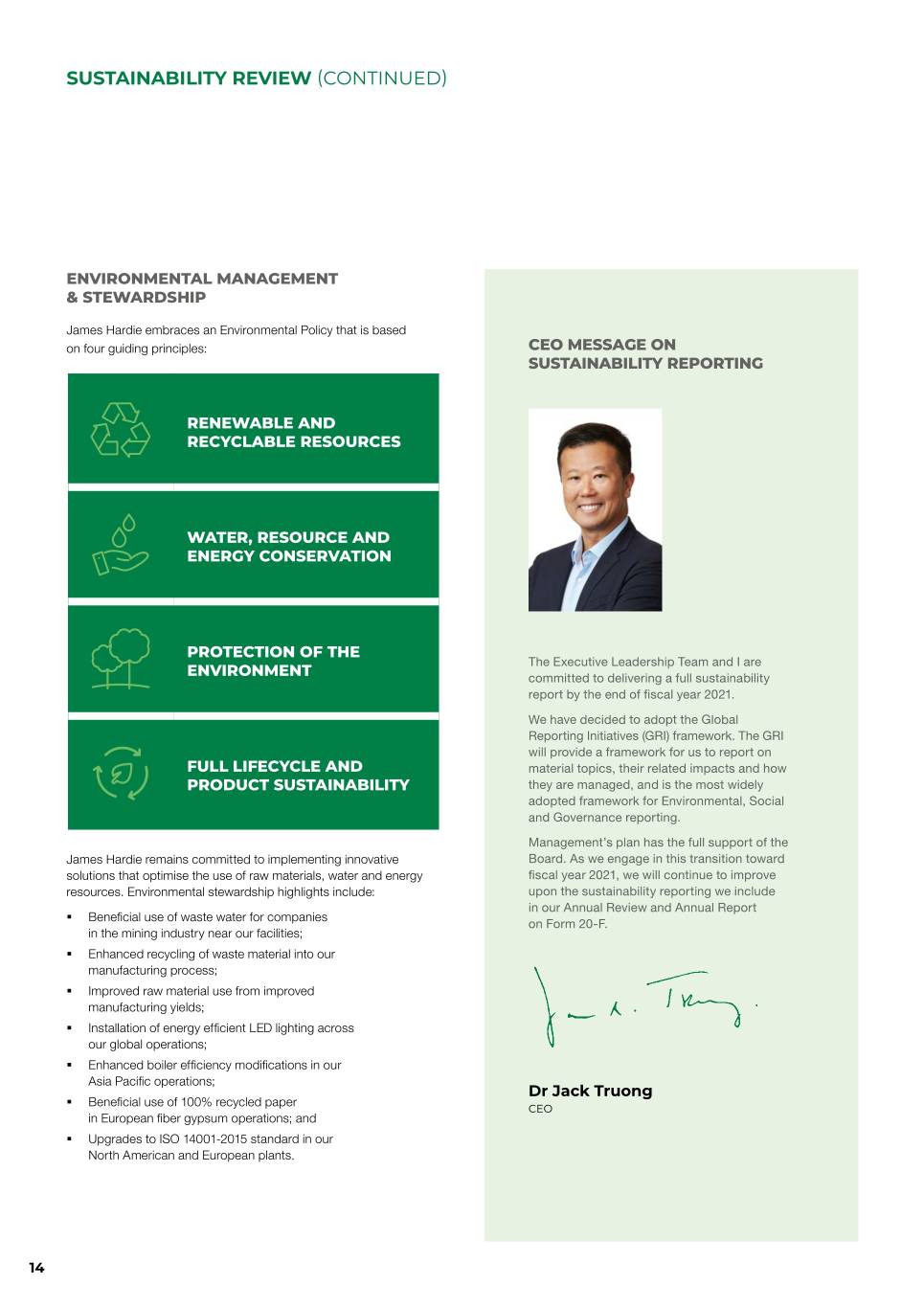
SUSTAINABILITY REVIEW (CONTINUED) ENVIRONMENTAL MANAGEMENT & STEWARDSHIP James Hardie embraces an Environmental Policy that is based on four guiding principles: CEO MESSAGE ON SUSTAINABILITY REPORTING RENEWABLE AND RECYCLABLE RESOURCES WATER, RESOURCE AND ENERGY CONSERVATION PROTECTION OF THE The Executive Leadership Team and I are ENVIRONMENT committed to delivering a full sustainability report by the end of fiscal year 2021. We have decided to adopt the Global Reporting Initiatives (GRI) framework. The GRI will provide a framework for us to report on FULL LIFECYCLE AND material topics, their related impacts and how PRODUCT SUSTAINABILITY they are managed, and is the most widely adopted framework for Environmental, Social and Governance reporting. Management’s plan has the full support of the James Hardie remains committed to implementing innovative Board. As we engage in this transition toward solutions that optimise the use of raw materials, water and energy fiscal year 2021, we will continue to improve resources. Environmental stewardship highlights include: upon the sustainability reporting we include in our Annual Review and Annual Report §§ Beneficial use of waste water for companies on Form 20-F. in the mining industry near our facilities; §§ Enhanced recycling of waste material into our manufacturing process; §§ Improved raw material use from improved manufacturing yields; §§ Installation of energy efficient LED lighting across our global operations; §§ Enhanced boiler efficiency modifications in our Asia Pacific operations; Dr Jack Truong §§ Beneficial use of 100% recycled paper CEO in European fiber gypsum operations; and §§ Upgrades to ISO 14001-2015 standard in our North American and European plants. 14
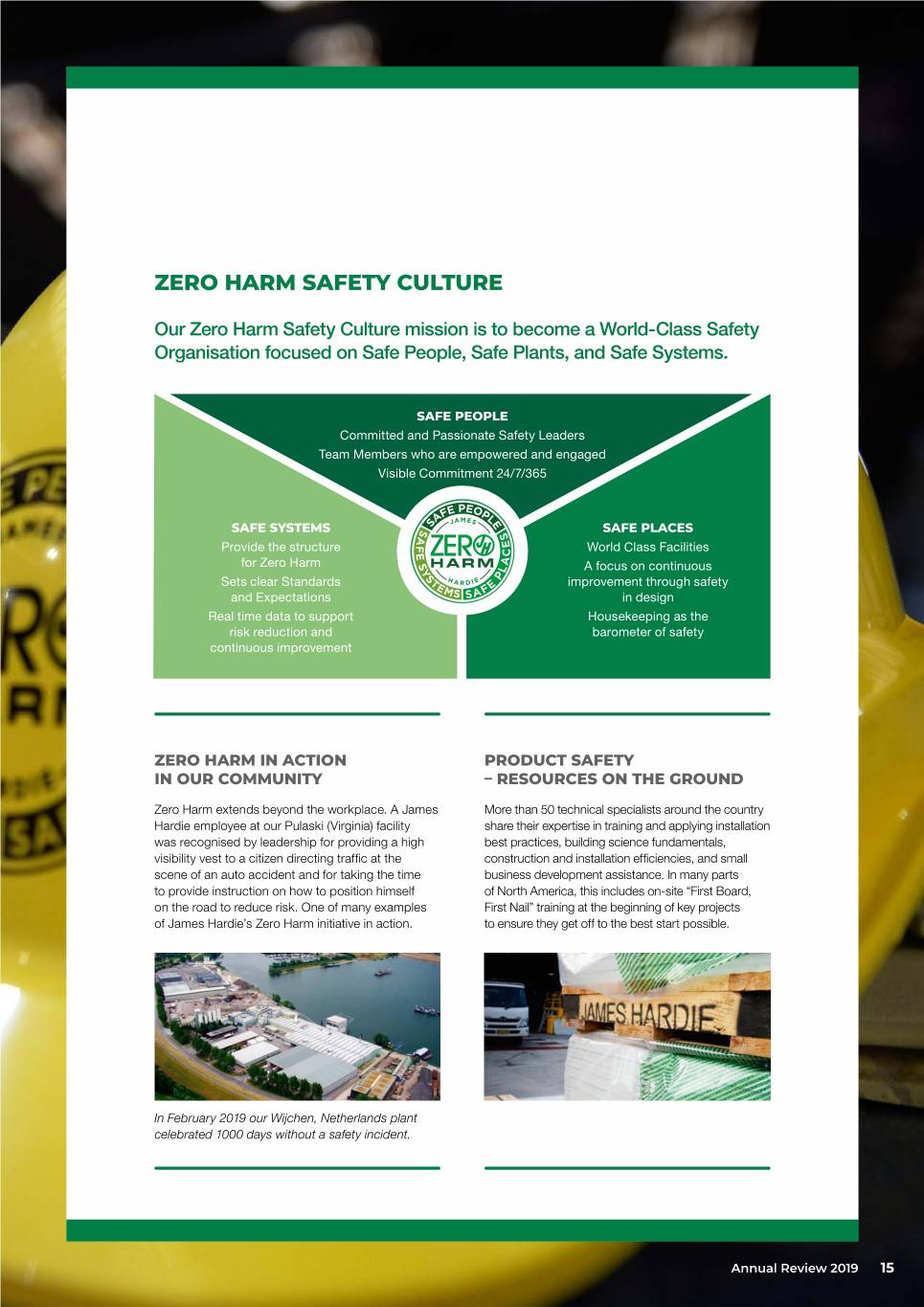
ZERO HARM SAFETY CULTURE Our Zero Harm Safety Culture mission is to become a World‑Class Safety Organisation focused on Safe People, Safe Plants, and Safe Systems. SAFE PEOPLE Committed and Passionate Safety Leaders Team Members who are empowered and engaged Visible Commitment 24/7/365 SAFE SYSTEMS SAFE PLACES Provide the structure World Class Facilities for Zero Harm A focus on continuous Sets clear Standards improvement through safety and Expectations in design Real time data to support Housekeeping as the risk reduction and barometer of safety continuous improvement ZERO HARM IN ACTION PRODUCT SAFETY IN OUR COMMUNITY – RESOURCES ON THE GROUND Zero Harm extends beyond the workplace. A James More than 50 technical specialists around the country Hardie employee at our Pulaski (Virginia) facility share their expertise in training and applying installation was recognised by leadership for providing a high best practices, building science fundamentals, visibility vest to a citizen directing traffic at the construction and installation efficiencies, and small scene of an auto accident and for taking the time business development assistance. In many parts to provide instruction on how to position himself of North America, this includes on-site “First Board, on the road to reduce risk. One of many examples First Nail” training at the beginning of key projects of James Hardie’s Zero Harm initiative in action. to ensure they get off to the best start possible. In February 2019 our Wijchen, Netherlands plant celebrated 1000 days without a safety incident. Annual Review 2019 15
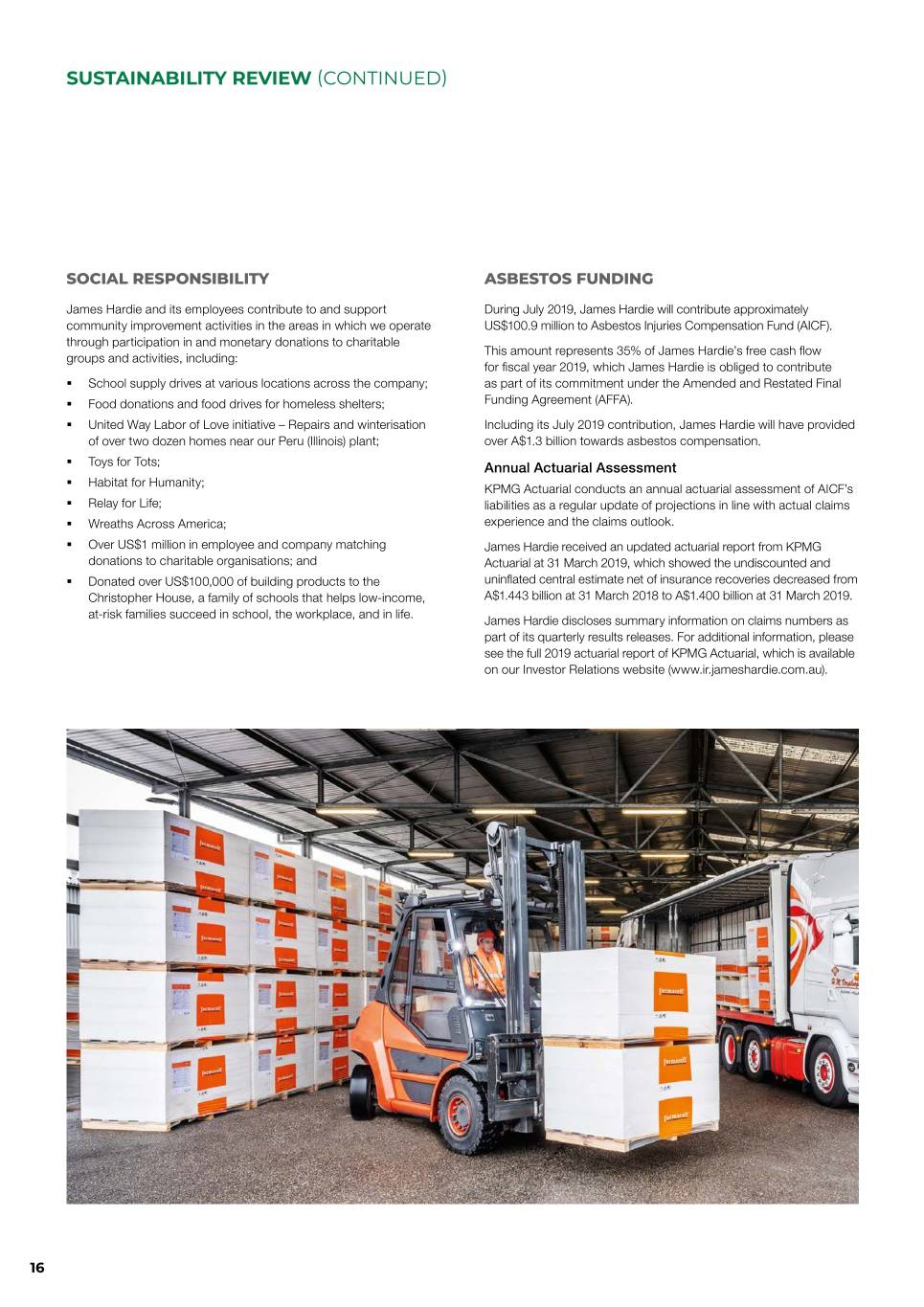
SUSTAINABILITY REVIEW (CONTINUED) SOCIAL RESPONSIBILITY ASBESTOS FUNDING James Hardie and its employees contribute to and support During July 2019, James Hardie will contribute approximately community improvement activities in the areas in which we operate US$100.9 million to Asbestos Injuries Compensation Fund (AICF). through participation in and monetary donations to charitable This amount represents 35% of James Hardie’s free cash flow groups and activities, including: for fiscal year 2019, which James Hardie is obliged to contribute §§ School supply drives at various locations across the company; as part of its commitment under the Amended and Restated Final §§ Food donations and food drives for homeless shelters; Funding Agreement (AFFA). §§ United Way Labor of Love initiative – Repairs and winterisation Including its July 2019 contribution, James Hardie will have provided of over two dozen homes near our Peru (Illinois) plant; over A$1.3 billion towards asbestos compensation. §§ Toys for Tots; Annual Actuarial Assessment §§ Habitat for Humanity; KPMG Actuarial conducts an annual actuarial assessment of AICF’s §§ Relay for Life; liabilities as a regular update of projections in line with actual claims §§ Wreaths Across America; experience and the claims outlook. §§ Over US$1 million in employee and company matching James Hardie received an updated actuarial report from KPMG donations to charitable organisations; and Actuarial at 31 March 2019, which showed the undiscounted and §§ Donated over US$100,000 of building products to the uninflated central estimate net of insurance recoveries decreased from Christopher House, a family of schools that helps low-income, A$1.443 billion at 31 March 2018 to A$1.400 billion at 31 March 2019. at-risk families succeed in school, the workplace, and in life. James Hardie discloses summary information on claims numbers as part of its quarterly results releases. For additional information, please see the full 2019 actuarial report of KPMG Actuarial, which is available on our Investor Relations website (www.ir.jameshardie.com.au). 16
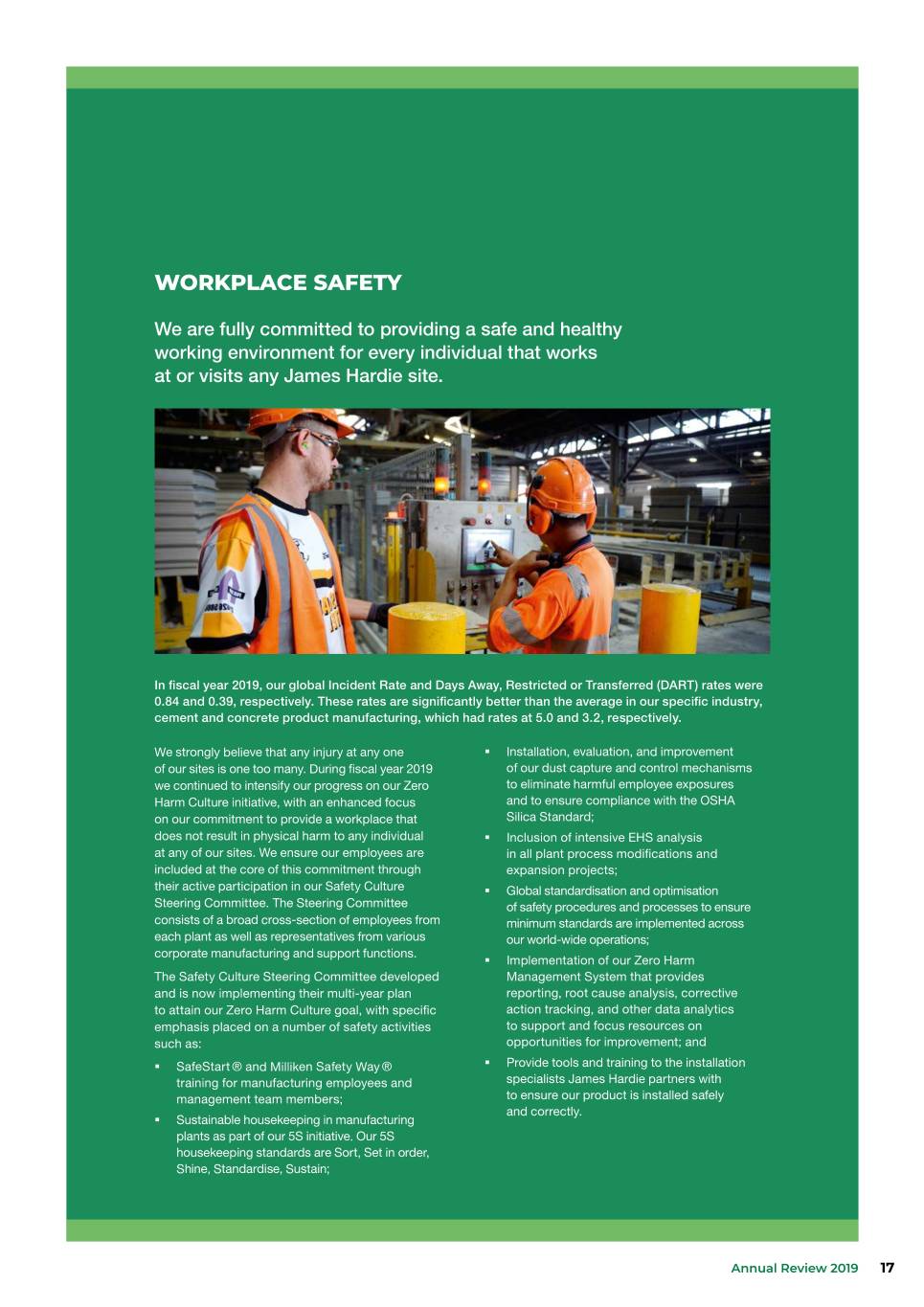
WORKPLACE SAFETY We are fully committed to providing a safe and healthy working environment for every individual that works at or visits any James Hardie site. In fiscal year 2019, our global Incident Rate and Days Away, Restricted or Transferred (DART) rates were 0.84 and 0.39, respectively. These rates are significantly better than the average in our specific industry, cement and concrete product manufacturing, which had rates at 5.0 and 3.2, respectively. We strongly believe that any injury at any one §§ Installation, evaluation, and improvement of our sites is one too many. During fiscal year 2019 of our dust capture and control mechanisms we continued to intensify our progress on our Zero to eliminate harmful employee exposures Harm Culture initiative, with an enhanced focus and to ensure compliance with the OSHA on our commitment to provide a workplace that Silica Standard; does not result in physical harm to any individual §§ Inclusion of intensive EHS analysis at any of our sites. We ensure our employees are in all plant process modifications and included at the core of this commitment through expansion projects; their active participation in our Safety Culture §§ Global standardisation and optimisation Steering Committee. The Steering Committee of safety procedures and processes to ensure consists of a broad cross-section of employees from minimum standards are implemented across each plant as well as representatives from various our world‑wide operations; corporate manufacturing and support functions. §§ Implementation of our Zero Harm The Safety Culture Steering Committee developed Management System that provides and is now implementing their multi-year plan reporting, root cause analysis, corrective to attain our Zero Harm Culture goal, with specific action tracking, and other data analytics emphasis placed on a number of safety activities to support and focus resources on such as: opportunities for improvement; and §§ SafeStart ® and Milliken Safety Way ® §§ Provide tools and training to the installation training for manufacturing employees and specialists James Hardie partners with management team members; to ensure our product is installed safely and correctly. §§ Sustainable housekeeping in manufacturing plants as part of our 5S initiative. Our 5S housekeeping standards are Sort, Set in order, Shine, Standardise, Sustain; Annual Review 2019 17
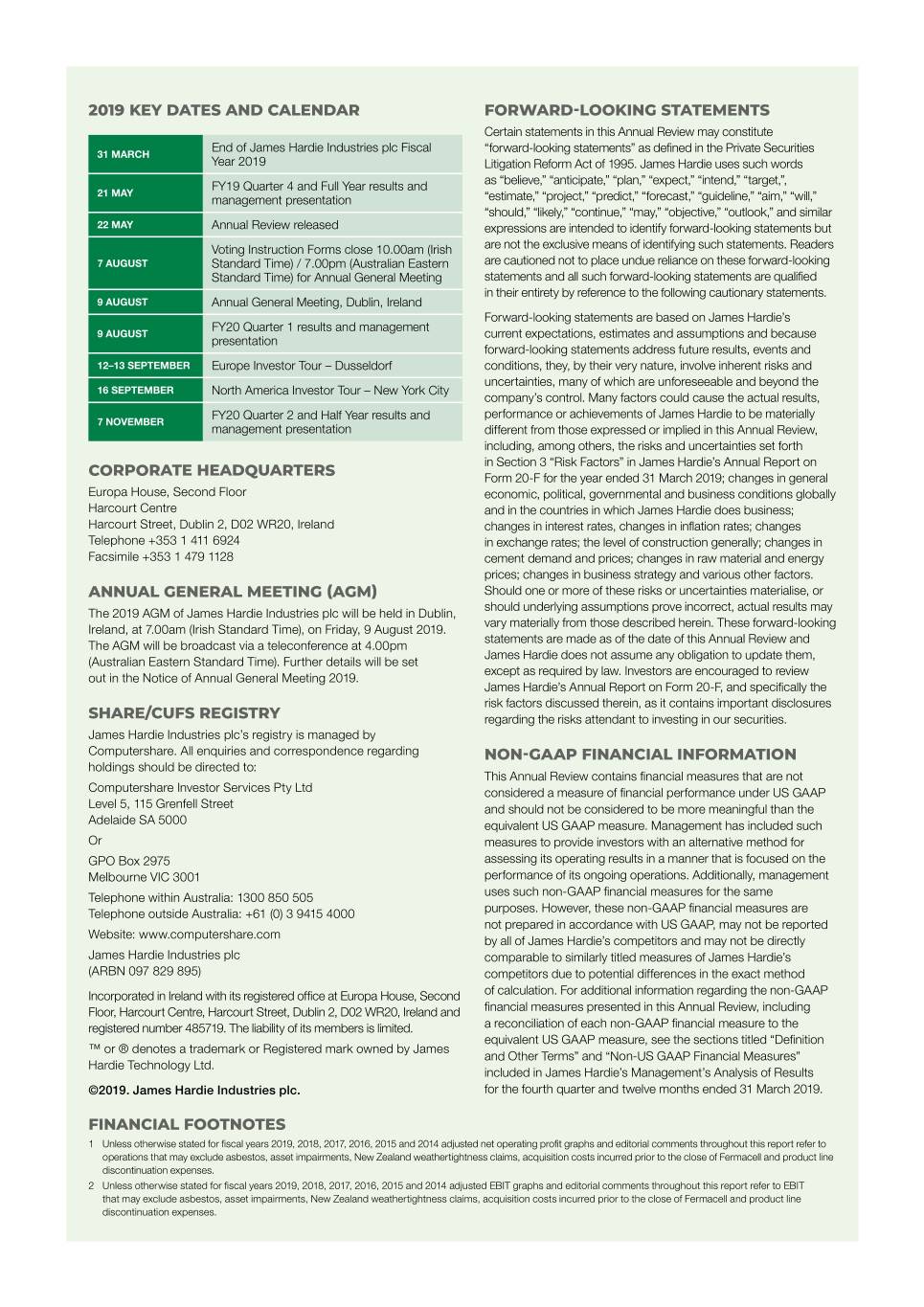
2019 KEY DATES AND CALENDAR FORWARD-LOOKING STATEMENTS Certain statements in this Annual Review may constitute End of James Hardie Industries plc Fiscal “forward‑looking statements” as defined in the Private Securities 31 MARCH Year 2019 Litigation Reform Act of 1995. James Hardie uses such words FY19 Quarter 4 and Full Year results and as “believe,” “anticipate,” “plan,” “expect,” “intend,” “target,”, 21 MAY management presentation “estimate,” “project,” “predict,” “forecast,” “guideline,” “aim,” “will,” “should,” “likely,” “continue,” “may,” “objective,” “outlook,” and similar 22 MAY Annual Review released expressions are intended to identify forward-looking statements but Voting Instruction Forms close 10.00am (Irish are not the exclusive means of identifying such statements. Readers 7 AUGUST Standard Time) / 7.00pm (Australian Eastern are cautioned not to place undue reliance on these forward-looking Standard Time) for Annual General Meeting statements and all such forward-looking statements are qualified in their entirety by reference to the following cautionary statements. 9 AUGUST Annual General Meeting, Dublin, Ireland Forward-looking statements are based on James Hardie’s FY20 Quarter 1 results and management 9 AUGUST current expectations, estimates and assumptions and because presentation forward‑looking statements address future results, events and 12–13 SEPTEMBER Europe Investor Tour – Dusseldorf conditions, they, by their very nature, involve inherent risks and uncertainties, many of which are unforeseeable and beyond the 16 SEPTEMBER North America Investor Tour – New York City company’s control. Many factors could cause the actual results, FY20 Quarter 2 and Half Year results and performance or achievements of James Hardie to be materially 7 NOVEMBER management presentation different from those expressed or implied in this Annual Review, including, among others, the risks and uncertainties set forth in Section 3 “Risk Factors” in James Hardie’s Annual Report on CORPORATE HEADQUARTERS Form 20-F for the year ended 31 March 2019; changes in general Europa House, Second Floor economic, political, governmental and business conditions globally Harcourt Centre and in the countries in which James Hardie does business; Harcourt Street, Dublin 2, D02 WR20, Ireland changes in interest rates, changes in inflation rates; changes Telephone +353 1 411 6924 in exchange rates; the level of construction generally; changes in Facsimile +353 1 479 1128 cement demand and prices; changes in raw material and energy prices; changes in business strategy and various other factors. ANNUAL GENERAL MEETING (AGM) Should one or more of these risks or uncertainties materialise, or should underlying assumptions prove incorrect, actual results may The 2019 AGM of James Hardie Industries plc will be held in Dublin, vary materially from those described herein. These forward-looking Ireland, at 7.00am (Irish Standard Time), on Friday, 9 August 2019. statements are made as of the date of this Annual Review and The AGM will be broadcast via a teleconference at 4.00pm James Hardie does not assume any obligation to update them, (Australian Eastern Standard Time). Further details will be set except as required by law. Investors are encouraged to review out in the Notice of Annual General Meeting 2019. James Hardie’s Annual Report on Form 20-F, and specifically the risk factors discussed therein, as it contains important disclosures SHARE/CUFS REGISTRY regarding the risks attendant to investing in our securities. James Hardie Industries plc’s registry is managed by Computershare. All enquiries and correspondence regarding NON-GAAP FINANCIAL INFORMATION holdings should be directed to: This Annual Review contains financial measures that are not Computershare Investor Services Pty Ltd considered a measure of financial performance under US GAAP Level 5, 115 Grenfell Street and should not be considered to be more meaningful than the Adelaide SA 5000 equivalent US GAAP measure. Management has included such Or measures to provide investors with an alternative method for GPO Box 2975 assessing its operating results in a manner that is focused on the Melbourne VIC 3001 performance of its ongoing operations. Additionally, management Telephone within Australia: 1300 850 505 uses such non‑GAAP financial measures for the same Telephone outside Australia: +61 (0) 3 9415 4000 purposes. However, these non-GAAP financial measures are not prepared in accordance with US GAAP, may not be reported Website: www.computershare.com by all of James Hardie’s competitors and may not be directly James Hardie Industries plc comparable to similarly titled measures of James Hardie’s (ARBN 097 829 895) competitors due to potential differences in the exact method Incorporated in Ireland with its registered office at Europa House, Second of calculation. For additional information regarding the non-GAAP Floor, Harcourt Centre, Harcourt Street, Dublin 2, D02 WR20, Ireland and financial measures presented in this Annual Review, including registered number 485719. The liability of its members is limited. a reconciliation of each non-GAAP financial measure to the equivalent US GAAP measure, see the sections titled “Definition ™ or ® denotes a trademark or Registered mark owned by James and Other Terms” and “Non-US GAAP Financial Measures” Hardie Technology Ltd. included in James Hardie’s Management’s Analysis of Results ©2019. James Hardie Industries plc. for the fourth quarter and twelve months ended 31 March 2019. FINANCIAL FOOTNOTES 1 Unless otherwise stated for fiscal years 2019, 2018, 2017, 2016, 2015 and 2014 adjusted net operating profit graphs and editorial comments throughout this report refer to operations that may exclude asbestos, asset impairments, New Zealand weathertightness claims, acquisition costs incurred prior to the close of Fermacell and product line discontinuation expenses. 2 Unless otherwise stated for fiscal years 2019, 2018, 2017, 2016, 2015 and 2014 adjusted EBIT graphs and editorial comments throughout this report refer to EBIT that may exclude asbestos, asset impairments, New Zealand weathertightness claims, acquisition costs incurred prior to the close of Fermacell and product line discontinuation expenses.